Exhibit 99.1
 |  |
| Effective Date: | 13 January 2015 | Document No: | 0465-RPT-014 Rev 0 |
Norra Kärr Project PFS
Gränna, Sweden
Prefeasibility Study - NI 43-101 -
Technical report for the Norra Kärr
Rare Earth Element Deposit
Prepared For:
Tasman Metals Ltd
QUALIFIED PERSONS:
Michael Short, BE (Civil), CEng FIMMM, FAusIMM(CP), FIEAust CPEng - Process
Greg Moseley, BSc, MSc, CEng, MIMM, FRGS, Associate, Qualified Person – Geology and Mineral
Resources
Mark Mounde, BEng, CEng, MIMMM, Technical Director, Qualified Person – Mining and Mineral
Reserves
Gareth Digges La Touche (BSc, MSc, FGS, CGeol, EurGeol)
CONTRIBUTING Consultants:
GBM Minerals Engineering Consultants Limited
Wardell Armstrong International Limited
Golder Associates Limited
Compiled By:

GBM Project Number: 0465
 | Page i |
 |  |
| | Prefeasibility Study - NI 43-101 - Technical report for the Norra Kärr
Rare Earth Element Deposit - 0465-RPT-014 Rev 0 |
Document Approval
| Role | | Name |
| Prepared by Project Engineer | | Tom Davidson |
| Checked by Project Controls Manager | | Jo Thompson |
| Approved by Qualified Person | | Michael Short |
| Approved by Qualified Person | | Greg Moseley |
| Approved by Qualified Person | | Mark Mounde |
| Approved by Qualified Person | | Gareth Digges La Touche |
Revision History
| Date | | Rev | | Reason | | Prepared | | Checked | | Approved |
| 16/12/2014 | | A | | Initial Draft | | TD | | JFT | | TD |
| 20/02/2015 | | 0 | | Issued as Final | | TD | | JFT | | MS / GM / MM /
GDLT |
IMPORTANT NOTE:
This report was prepared as a National Instrument 43-101 Technical Report, in accordance with Form 43-101F1, for Tasman Metals Ltd by GBM Minerals Engineering Consultants Limited. The quality of information, conclusions, and estimates contained herein is consistent with the level of effort involved in GBM’s services, based on: i) information available at the time of preparation, ii) data supplied by outside sources, and iii) the assumptions, conditions, and qualifications set forth in this report. This report is intended to be filed as a Technical Report with Canadian securities regulatory authorities pursuant to National Instrument 43-101, Standards of Disclosure for Mineral Projects. Except for the purposes legislated under provincial securities law, any other use of this report by any third party is at that party’s sole risk.
 |  |
| | Prefeasibility Study - NI 43-101 - Technical report for the Norra Kärr
Rare Earth Element Deposit - 0465-RPT-014 Rev 0 |
TABLE OF CONTENTS
| SECTION 1 | | SUMMARY | 20 |
| | | | |
| 1.1 | | Introduction | 20 |
| | | | |
| 1.2 | | Background | 20 |
| | | | |
| 1.3 | | Norra Kärr Geology | 20 |
| | | | |
| 1.4 | | Metallurgical Testwork and Process Design | 21 |
| | | | |
| 1.5 | | Mineral Resource Estimates | 21 |
| | | | |
| 1.6 | | Mineral Reserve Estimates | 25 |
| | | | |
| 1.7 | | Mineral Extraction Methods | 25 |
| | | | |
| 1.8 | | Tailings storage Facility | 25 |
| | | | |
| 1.9 | | Environmental Studies, Permitting and Social or Community Impact | 26 |
| | | | |
| 1.10 | | Conclusions and Recommendations | 28 |
| | | | |
| SECTION 2 | | INTRODUCTION | 31 |
| | | | |
| 2.1 | | General | 31 |
| | | | |
| 2.2 | | Financial Interest Disclaimer | 31 |
| | | | |
| 2.3 | | Sources of Information | 31 |
| | | | |
| 2.4 | | Qualified Persons | 31 |
| | | | |
| 2.5 | | Qualified Person Site Visit | 32 |
| | | | |
| 2.6 | | Qualified Person Sectional Responsibility | 32 |
| | | | |
| 2.7 | | Units and Currency | 34 |
| | | | |
| SECTION 3 | | RELIANCE ON OTHER EXPERTS | 35 |
| | | | |
| SECTION 4 | | PROPERTY DESCRIPTION AND LOCATION | 36 |
| | | | |
| 4.1 | | Location | 36 |
| | | | |
| 4.2 | | Mineral Title | 37 |
| | | | |
| 4.3 | | Environmental Liabilities | 39 |
| | | | |
| 4.4 | | Permits | 39 |
 |  |
| | Prefeasibility Study - NI 43-101 - Technical report for the Norra Kärr
Rare Earth Element Deposit - 0465-RPT-014 Rev 0 |
| SECTION 5 | | ACCESSIBILITY, CLIMATE, LOCAL RESOURCES, INFRASTRUCTURE AND PHYSIOGRAPHY | 40 |
| | | | |
| 5.1 | | Access | 40 |
| | | | |
| 5.2 | | Climate and Length of Operating Season | 40 |
| | | | |
| 5.3 | | Proximity to Population Centre and Transport | 41 |
| | | | |
| 5.4 | | Surface Rights, Land Availability, Infrastructure, and Local Resources | 42 |
| | | | |
| 5.5 | | Topography, Elevation, and Vegetation | 43 |
| | | | |
| SECTION 6 | | HISTORY | 45 |
| | | | |
| 6.1 | | Summary of Regional Exploration and Mining History | 45 |
| | | | |
| 6.2 | | Historical Resource Estimates | 47 |
| | | | |
| SECTION 7 | | GEOLOGICAL SETTING AND MINERALISATION | 50 |
| | | | |
| 7.1 | | Regional Geology | 50 |
| | | | |
| 7.2 | | District Geology | 53 |
| | | | |
| 7.3 | | Property Geology | 53 |
| | | | |
| 7.4 | | Norra Kärr Geology and Mineralisation | 55 |
| | | | |
| SECTION 8 | | DEPOSIT TYPES | 64 |
| | | | |
| 8.1 | | General | 64 |
| | | | |
| 8.2 | | REE Deposits – Discussion | 67 |
| | | | |
| SECTION 9 | | EXPLORATION | 70 |
| | | | |
| 9.1 | | Initial Works | 70 |
| | | | |
| 9.2 | | Topographic Mapping | 71 |
| | | | |
| 9.3 | | Geological Mapping | 74 |
| | | | |
| SECTION 10 | | DRILLING | 86 |
| | | | |
| SECTION 11 | | SAMPLE PREPARATION, ANALYSES, AND SECURITY | 89 |
| | | | |
| 11.1 | | Core Cutting | 89 |
| | | | |
| 11.2 | | Sample Preparation | 89 |
| | | | |
| 11.3 | | Analyses | 90 |
| | | | |
| 11.4 | | QA/QC | 92 |
 |  |
| | Prefeasibility Study - NI 43-101 - Technical report for the Norra Kärr
Rare Earth Element Deposit - 0465-RPT-014 Rev 0 |
| 11.5 | | Density Determination | 113 |
| | | | |
| SECTION 12 | | DATA VERIFICATION | 114 |
| | | | |
| 12.1 | | Field Verification | 114 |
| | | | |
| 12.2 | | Sampling Verification | 120 |
| | | | |
| SECTION 13 | | MINERAL PROCESSING AND METALLURGICAL TESTING | 121 |
| | | | |
| 13.1 | | Historical Testing | 121 |
| | | | |
| 13.2 | | Current Testing | 121 |
| | | | |
| 13.3 | | Material Issues and Deleterious Elements | 138 |
| | | | |
| 13.4 | | Summary | 138 |
| | | | |
| SECTION 14 | | MINERAL RESOURCE ESTIMATES | 139 |
| | | | |
| 14.1 | | Current Estimate WAI (2014) | 139 |
| | | | |
| 14.2 | | Topography | 139 |
| | | | |
| 14.3 | | Database Compilation | 140 |
| | | | |
| 14.4 | | Geological Interpretation-Wireframe Modelling | 141 |
| | | | |
| 14.5 | | Sample Data Processing | 145 |
| | | | |
| 14.6 | | Variography | 151 |
| | | | |
| 14.7 | | Volumetric Modelling | 160 |
| | | | |
| 14.8 | | Density | 163 |
| | | | |
| 14.9 | | Grade Estimation | 163 |
| | | | |
| 14.10 | | Validation | 169 |
| | | | |
| 14.11 | | Depletion | 180 |
| | | | |
| 14.12 | | Mineral Resource Classification | 180 |
| | | | |
| SECTION 15 | | MINERAL RESERVE ESTIMATES | 186 |
| | | | |
| 15.1 | | Current Estimate | 186 |
| | | | |
| 15.2 | | Open Pit Mine Planning | 186 |
| | | | |
| 15.3 | | Economic Cut-Off Grades | 191 |
| | | | |
| 15.4 | | Pit Shell Selection | 191 |
| | | | |
| SECTION 16 | | MINING METHODS | 194 |
 |  |
| | Prefeasibility Study - NI 43-101 - Technical report for the Norra Kärr
Rare Earth Element Deposit - 0465-RPT-014 Rev 0 |
| 16.1 | | Mining Operations and Equipment | 194 |
| | | | |
| 16.2 | | Equipment Fleet Summary | 198 |
| | | | |
| 16.3 | | Mining Operations | 199 |
| | | | |
| 16.4 | | Mine Manpower Requirements | 201 |
| | | | |
| 16.5 | | Mine Production Schedule | 203 |
| | | | |
| 16.6 | | Geotechnical Parameters | 208 |
| | | | |
| 16.7 | | Open Pit Pumping Requirements | 213 |
| | | | |
| 16.8 | | Waste Rock Dumps | 214 |
| | | | |
| SECTION 17 | | RECOVERY METHODS | 216 |
| | | | |
| 17.1 | | PROCESS DESCRIPTION | 216 |
| | | | |
| 17.2 | | Process Plant Infrastructure and Reagents | 220 |
| | | | |
| SECTION 18 | | PROJECT INFRASTRUCTURE | 222 |
| | | | |
| 18.1 | | Facility Layout | 222 |
| | | | |
| 18.2 | | Access | 222 |
| | | | |
| 18.3 | | Buildings and Structure | 222 |
| | | | |
| 18.4 | | Transportation of Goods and Services | 226 |
| | | | |
| 18.5 | | Power | 226 |
| | | | |
| 18.6 | | Water | 227 |
| | | | |
| 18.7 | | Tailings Facility | 227 |
| | | | |
| SECTION 19 | | MARKET STUDIES AND CONTRACTS | 240 |
| | | | |
| 19.1 | | Overview of Rare Earth Elements and Products | 240 |
| | | | |
| 19.2 | | Rare Earth ELEMENT Production and Supply Forecast | 240 |
| | | | |
| 19.3 | | Rare Earth ELEMENT Consumption and Demand Forecast | 243 |
| | | | |
| 19.4 | | REE Supply/Demand Balance | 248 |
| | | | |
| 19.5 | | REE Pricing and Forecast | 248 |
| | | | |
| 19.6 | | Potential Customers | 251 |
| | | | |
| 19.7 | | Potential Upside From Co-Products | 253 |
 |  |
| | Prefeasibility Study - NI 43-101 - Technical report for the Norra Kärr
Rare Earth Element Deposit - 0465-RPT-014 Rev 0 |
| SECTION 20 | | ENVIRONMENTAL STUDIES, PERMITTING, AND SOCIAL OR COMMUNITY IMPACT | 254 |
| | | | |
| 20.1 | | Environmental Summary | 254 |
| | | | |
| 20.2 | | Expected Material Environmental Issues | 279 |
| | | | |
| 20.3 | | Waste and Tailings Disposal | 293 |
| | | | |
| 20.4 | | Site Monitoring | 295 |
| | | | |
| 20.5 | | Water Management | 296 |
| | | | |
| 20.6 | | Permitting | 309 |
| | | | |
| 20.7 | | Social and Community Requirements | 322 |
| | | | |
| 20.8 | | Project Closure | 327 |
| | | | |
| 20.9 | | Health and Safety Issues | 330 |
| | | | |
| SECTION 21 | | CAPITAL AND OPERATING COSTS | 333 |
| | | | |
| 21.1 | | Capital Cost Estimates | 333 |
| | | | |
| 21.2 | | Operating Cost Estimates | 339 |
| | | | |
| SECTION 22 | | ECONOMIC ANALYSIS | 344 |
| | | | |
| SECTION 23 | | ADJACENT PROPERTIES | 349 |
| | | | |
| SECTION 24 | | OTHER RELEVANT DATA AND INFORMATION | 350 |
| | | | |
| 24.1 | | Discounted Cash Flow Model | 350 |
| | | | |
| 24.2 | | Project Execution Plan | 352 |
| | | | |
| SECTION 25 | | INTERPRETATION AND CONCLUSIONS | 353 |
| | | | |
| 25.1 | | Mineral Resources | 353 |
| | | | |
| 25.2 | | Mineral Reserves | 354 |
| | | | |
| 25.3 | | Environmental and Community | 355 |
| | | | |
| SECTION 26 | | RECOMMENDATIONS | 357 |
| | | | |
| 26.1 | | Mineral Reserves | 357 |
| | | | |
| 26.2 | | Tailings Storage Facility | 358 |
| | | | |
| 26.3 | | Metallurgy and Process | 358 |
| | | | |
| 26.4 | | Environmental and Community | 359 |
 |  |
| | Prefeasibility Study - NI 43-101 - Technical report for the Norra Kärr
Rare Earth Element Deposit - 0465-RPT-014 Rev 0 |
| SECTION 27 | | REFERENCES | 365 |
| | | | |
| APPENDIX A. | | QUALIFIED PERSONS CERTIFICATES | 370 |
| | | | |
| APPENDIX B. | | WAI TAILINGS DRAWINGS | 371 |
| | | | |
| B.1 | | ZL611067-101-Layout | 371 |
| | | | |
| B.2 | | ZL611067-102-Layout | 371 |
| | | | |
| B.3 | | ZL611067-108-Layout | 371 |
| | | | |
| APPENDIX C. | | GBM LAYOUT DRAWINGS | 372 |
| | | | |
| C.1 | | 0465-000-G-001_Rev0 | 372 |
| | | | |
| C.2 | | 0465-000-G-003_Rev0 | 372 |
| | | | |
| C.3 | | 0465-000-G-004_Rev0 | 372 |
 |  |
| | Prefeasibility Study - NI 43-101 - Technical report for the Norra Kärr
Rare Earth Element Deposit - 0465-RPT-014 Rev 0 |
LIST OF TABLES
| Table 1-1: Norra Kärr Mineral Resource Estimate (4) | 24 |
| | |
| Table 1-2: Total Project Initial Capital Expenditure | 28 |
| | |
| Table 1-3 Operating Expenditure over Life of Mine | 28 |
| | |
| Table 2-1: Responsible Qualified Persons | 33 |
| | |
| Table 4-1:Tasman Norra Kärr Licence Details | 38 |
| | |
| Table 6-1: Boliden 1974 North Trench Results (PAH, 2012) | 47 |
| | |
| Table 6-2: Boliden 1974 South Trench Results (PAH, 2012) | 47 |
| | |
| Table 6-3: RPM Mineral Resource Statement (March 2012) | 49 |
| | |
| Table 8-1: Primary REE Deposit Types (14) | 64 |
| | |
| Table 9-1: Comparison of Tasman Grab Samples vs Boliden Composite Trench Samples | 70 |
| | |
| Table 9-2: Example of Detailed Drill Hole Log (Hole NKA10014) | 81 |
| | |
| Table 10-1: Summary of Tasman Exploration Drilling Activity | 86 |
| | |
| Table 11-1: ALS Chemex ME-MS81 Detection Limits | 91 |
| | |
| Table 11-2: CRM Sample Summary | 102 |
| | |
| Table 11-3: WAI 2014 Duplicate Sample Summary | 109 |
| | |
| Table 11-4: Risk Matrix: QA/QC Sample Auditing | 110 |
| | |
| Table 13-1: RESCOMP Modal Mineralogy | 125 |
| | |
| Table 13-2: Crushing Work Index | 126 |
| | |
| Table 13-3: Bond Mill Work Index | 126 |
| | |
| Table 13-4: Abrasion Index | 126 |
| | |
| Table 13-5: Selected Results for Batch | 132 |
| | |
| Table 13-6: Batch 1 Size-By-Size Yttrium Recovery | 132 |
| | |
| Table 13-7 REE oxalate concentrate chemical analyses | 137 |
| | |
| Table 14-1: Sample Data Summary | 140 |
| | |
| Table 14-2: Selected Sample Summary by LTYPE | 145 |
| | |
| Table 14-3: Decile Analysis – Sm LTYPE 4 | 149 |
| | |
 |  |
| | Prefeasibility Study - NI 43-101 - Technical report for the Norra Kärr
Rare Earth Element Deposit - 0465-RPT-014 Rev 0 |
| Table 14-4: Norra Kärr Top-Cut Summary | 150 |
| | |
| Table 14-5: Summary of Variogram Models | 155 |
| | |
| Table 14-6: Summary of Block Model Parameters | 160 |
| | |
| Table 14-7: Estimation Parameters for Dip and Dip Direction | 161 |
| | |
| Table 14-8: Density Values Applied by Zone | 163 |
| | |
| Table 14-9: Grade Estimation Parameters | 168 |
| | |
| Table 14-10: Initial Search Ellipse Sizes for Grade Estimation | 168 |
| | |
| Table 14-11: Validation Stats - Composite Grades vs Block Grades | 172 |
| | |
| Table 14-12: Norra Kärr Mineral Resource Estimate Pit Optimisation Parameters (WAI, 2014) | 183 |
| | |
| Table 14-13: Rare Earth Oxide Conversion Factors (PAH, 2011) (4) | 184 |
| | |
| Table 14-14: Norra Kärr Mineral Resource Estimate (WAI, 2014) | 185 |
| | |
| Table 15-1: Norra Kärr Pit Optimisation Parameters | 189 |
| | |
| Table 15-2: Economic Cut-Off Grades (PGT & GTM) | 191 |
| | |
| Table 15-3: Norra Kärr Mineral Reserve Estimate (WAI, November 2014) | 193 |
| | |
| Table 16-1: Loading Parameters | 197 |
| | |
| Table 16-2: Truck Loading and Dumping Parameters | 197 |
| | |
| Table 16-3: Mining Equipment Fleet | 198 |
| | |
| Table 16-4: Haul Road Design Parameters | 200 |
| | |
| Table 16-5: Salary Structure | 201 |
| | |
| Table 16-6: Mining Personnel Requirements | 202 |
| | |
| Table 16-7: Mining Production Schedule | 204 |
| | |
| Table 16-8: Sector Stereographic Analysis | 208 |
| | |
| Table 16-9: Sector Slope Angles | 209 |
| | |
| Table 16-10: Predicted inflow rates | 213 |
| | |
| Table 16-11: Pump Specifications | 214 |
| | |
| Table 17-1 Process design criteria | 216 |
| | |
| Table 17-2 REE Overall Recovery | 217 |
| | |
| Table 18-1 Building and Structure Details of Nora Kärr process plant | 223 |
| | |
 |  |
| | Prefeasibility Study - NI 43-101 - Technical report for the Norra Kärr
Rare Earth Element Deposit - 0465-RPT-014 Rev 0 |
| Table 18-2: Assumed Waste Stream Parameters | 234 |
| | |
| Table 18-3: Approximate earthworks quantities for TSF construction | 236 |
| | |
| Table 18-4: Principal TSF dimensions | 237 |
| | |
| Table 19-1: Global Rare Earth Production by Country (t) | 241 |
| | |
| Table 19-2: 2013 REE Production | 241 |
| | |
| Table 19-3: Demand Summary | 245 |
| | |
| Table 19-4 REO Price Deck | 250 |
| | |
| Table 19-5 Estimated REO Demand | 252 |
| | |
| Table 20-1: Baseline studies prepared by other experts | 255 |
| | |
| Table 20-2: Key source documents | 256 |
| | |
| Table 20-3: Baseline Studies Relating to Surface Water | 264 |
| | |
| Table 20-4: Ecology baseline studies | 270 |
| | |
| Table 20-5: Archaeological baseline study | 273 |
| | |
| Table 20-6: Cultural heritage objects | 274 |
| | |
| Table 20-7: Input Meteorological Data and WAI snowmelt adjustment | 299 |
| | |
| Table 20-8: Percentile Annual Precipitation Depths | 299 |
| | |
| Table 20-9: Haul and Access road areas | 302 |
| | |
| Table 20-10: Objectives and area of application of the Environmental Code | 309 |
| | |
| Table 20-11: Required permits | 320 |
| | |
| Table 20-12: Activities Subject to the Permitting Process of Environmental Code | 321 |
| | |
| Table 20-13: Responses, September 2014 telephone survey (Skop / Kristdemokraterna) | 326 |
| | |
| Table 20-14: Responses, August 2014 web panel survey (Novus / P4 radio) | 326 |
| | |
| Table 20-15: Most Relevant Swedish H&S Regulations | 331 |
| | |
| Table 21-1 Total capital cost estimate | 335 |
| | |
| Table 21-2: Mining CAPEX Summary | 336 |
| | |
| Table 21-3 Process Capital estimate summary | 337 |
| | |
| Table 21-4: TSF Budget Cost Summary | 338 |
| | |
| Table 21-5 Operating Summary | 339 |
| | |
 |  |
| | Prefeasibility Study - NI 43-101 - Technical report for the Norra Kärr
Rare Earth Element Deposit - 0465-RPT-014 Rev 0 |
| Table 21-6: Mining Operating Costs | 342 |
| | |
| Table 21-7: Bill of Rates – Labour | 343 |
| | |
| Table 22-1 Key input parameters | 344 |
| | |
| Table 22-2 REO Prices used in Financial model | 345 |
| | |
| Table 22-3 DCF results for Norra Kärr in USD | 346 |
LIST OF FIGURES
| Figure 4-1: Location of the Norra Kärr Project, Sweden | 36 |
| | |
| Figure 4-2: Relative Position of the Norra Kärr Licences (s.l.) | 37 |
| | |
| Figure 6-1: Location of the Boliden 1974 Trenches | 46 |
| | |
| Figure 7-1: Litho-Tectonic and Shear Zone Map of the Sveco-Norwegian Orogen, South-Western Scandinavia | 50 |
| | |
| Figure 7-2: Generalised Geological Map of the Fennoscandian Shield Showing the TIB | 51 |
| | |
| Figure 7-3: Aeromagnetic Anomaly Map of Southern Sweden | 52 |
| | |
| Figure 7-4: Simplified Geological Outline of the Svecconorwegian Orogeny | 53 |
| | |
| Figure 7-5: Possible Shearing Movement for the Norra Kärr Intrusive | 55 |
| | |
| Figure 7-6 Geological Map of the Norra Kärr Intrusive | 57 |
| | |
| Figure 7-7: Norra Kärr Intrusive Body Litho Types | 58 |
| | |
| Figure 7-8: Foliated Kaxtorpite | 59 |
| | |
| Figure 7-9: GTM - “Migmatitic” Grennaite Medium Grained | 59 |
| | |
| Figure 7-10: PGT-Pegmatitic Schlieren/Veining in Grennaite, with Elongated Crystals of Catapleiite and Crystals of Eudyalite | 60 |
| | |
| Figure 7-11: GTC-Fine Grained Grennaite with Bluish-White Elongated Catapleiite Crystals | 61 |
| | |
| Figure 7-12: Norra Kärr REE Distribution | 62 |
| | |
| Figure 7-13: Norra Kärr REO Distribution by Major Ore Types | 62 |
| | |
| Figure 7-14: Norra Kärr REO Distribution by Rock Domain (Chondrite Normalised) | 63 |
| | |
| Figure 8-1: Periodic Table Showing LREO/HERO “Split” | 66 |
| | |
| Figure 8-2: REE Criticality Matrices (14) | 66 |
| | |
 |  |
| | Prefeasibility Study - NI 43-101 - Technical report for the Norra Kärr
Rare Earth Element Deposit - 0465-RPT-014 Rev 0 |
| Figure 8-3: Selection of REE-bearing Mineral (14) | 67 |
| | |
| Figure 8-4: Possible Mode of Formation of the IIimaussaq Intrusion | 69 |
| | |
| Figure 9-1: Swedish Survey 1:50 000 Topographic Sheet (56375 DinKarta) | 72 |
| | |
| Figure 9-2: Orthophoto of the Norra Kärr Licence | 72 |
| | |
| Figure 9-3: Colour Coded DEM of Norra Kärr | 73 |
| | |
| Figure 9-4: Contour Plan of Norra Kärr at 1 m Intervals | 73 |
| | |
| Figure 9-5: Geological Plan Showing Observation Points and the Old Boliden Pits | 75 |
| | |
| Figure 9-6 Geological Map of the Norra Kärr Intrusive Showing Drill Hole Traces | 77 |
| | |
| Figure 9-7: Geological Plan of Norra Kärr Showing Foliation Trends | 79 |
| | |
| Figure 9-8: “Typical” Geological Section of Norra Kärr Showing Foliation Trends | 79 |
| | |
| Figure 9-9: Core Photography and Corresponding Strip Log | 80 |
| | |
| Figure 9-10: Legend for Geological Sections (Section A | 82 |
| | |
| Figure 9-11: Section A, Geological Cross Section | 82 |
| | |
| Figure 9-12: Section B, Geological Cross Section | 83 |
| | |
| Figure 9-13: Section C, Geological Cross Section | 84 |
| | |
| Figure 9-14: Section D, Geological Cross Section | 85 |
| | |
| Figure 10-1: Core Logging Facility | 88 |
| | |
| Figure 11-1: ALS Chemex Sample Preparation Facility Piteå | 90 |
| | |
| Figure 11-2: Dy Field Duplicate QA/QC Results | 93 |
| | |
| Figure 11-3: Y Field Duplicate QA/QC Results | 94 |
| | |
| Figure 11-4: Nd Field Duplicate QA/QC Results | 95 |
| | |
| Figure 11-5: Dy Laboratory Duplicate QA/QC Results | 97 |
| | |
| Figure 11-6: Y Laboratory Duplicate QA/QC Results | 98 |
| | |
| Figure 11-7: Nd Laboratory Duplicate QA/QC Results | 99 |
| | |
| Figure 11-8: Dy Blank Sample Results | 100 |
| | |
| Figure 11-9: Y Blank Sample Results | 101 |
| | |
| Figure 11-10: Nd Blank Sample Results | 101 |
| | |
| Figure 11-11: CRM OREAS 100a Dy Results | 105 |
| | |
 |  |
| | Prefeasibility Study - NI 43-101 - Technical report for the Norra Kärr
Rare Earth Element Deposit - 0465-RPT-014 Rev 0 |
| Figure 11-12: CRM OREAS 100a Nd Results | 105 |
| | |
| Figure 11-13: CRM OREAS 104 Eu Results | 106 |
| | |
| Figure 11-14: CRM OREAS 45p Y Results | 106 |
| | |
| Figure 11-15: CRM OREAS 45c Dy Results | 107 |
| | |
| Figure 11-16: CRM NKA01 Dy Results | 107 |
| | |
| Figure 11-17: CRM NKA02 Gd Results | 108 |
| | |
| Figure 11-18: Dy ACTLABS External Duplicates | 112 |
| | |
| Figure 12-1: Tasman Geologists at a Typical Norra Kärr Outcrop | 115 |
| | |
| Figure 12-2: Site of Former Boliden Excavation | 115 |
| | |
| Figure 12-3: Pegmatitic Grennaite (PGT Domain) | 116 |
| | |
| Figure 12-4: The “Discovery” Outcrop Showing Pink Eudyalite | 116 |
| | |
| Figure 12-5: Plan Showing Drill Hole Collar Positions and the WAI Site Visit Trajectory | 118 |
| | |
| Figure 12-6: Enlarged Image Showing Drill Hole Sites and WAI Site Visit Trajectory | 119 |
| | |
| Figure 12-7: Drill Hole Collar Marked by Casing | 119 |
| | |
| Figure 13-1: ANZAPLAN composite locations | 123 |
| | |
| Figure 13-2: Norra Kärr Surface Resource Map with Borehole Locations | 124 |
| | |
| Figure 13-3: ANZAPLAN Modal Mineralogy | 127 |
| | |
| Figure 13-4: Comparison of mineral liberation for samples GTM, PGT, SPGT, CPGT, NPGT and GTC in fraction 0.1 mm to 0.5 mm | 128 |
| | |
| Figure 13-5: Comparison of mineral liberation for samples GTM, PGT, SPGT, CPGT, NPGT and GTC in fraction 0.02 mm to 0.1 mm | 128 |
| | |
| Figure 13-6: Comparison of mineral liberation for samples GTM, PGT, SPGT, CPGT, NPGT and GTC in fraction <0 02 mm | 129 |
| | |
| Figure 13-7: Aluminium Grade and Recovery Versus Magnetic Mass Fraction | 130 |
| | |
| Figure 13-8: Yttrium Grade and Recovery Versus Magnetic Mass Fraction | 131 |
| | |
| Figure 13-9 Acid consumption | 134 |
| | |
| Figure 13-10 Acid consumption | 134 |
| | |
| Figure 13-11 Cerium equilibrium loading isotherm | 136 |
| | |
 |  |
| | Prefeasibility Study - NI 43-101 - Technical report for the Norra Kärr
Rare Earth Element Deposit - 0465-RPT-014 Rev 0 |
| Figure 13-12 Yttrium equilibrium loading isotherm | 136 |
| | |
| Figure 14-1: Drill Hole Layout and Topographic Plan (WAI, 2014) | 139 |
| | |
| Figure 14-2: Long Section of Norra Kärr Drill Holes, Easting Line 474398.65 | 141 |
| | |
| Figure 14-3: Tasman Geological Interpretation Cross Section – Northing 6440409.46 | 143 |
| | |
| Figure 14-4: WAI Mineralised Wireframe Cross Section – Northing 6440409.46 (SWEREF99TM) | 144 |
| | |
| Figure 14-5: WAI Mineralisation Wireframes Longsection – Looking West | 145 |
| | |
| Figure 14-6: Dy Histogram Plots for LTYPES 2 to 5 | 147 |
| | |
| Figure 14-7: Y Histogram Plots for LTYPES 2 to 5 | 148 |
| | |
| Figure 14-8: Average Sample Length Histogram | 151 |
| | |
| Figure 14-9: Continuity Maps of Dy for the Porphyritic Grennaite (LTYPE=4). Horizontal Continuity (Top) and Dip Plane Continuity (Bottom) | 153 |
| | |
| Figure 14-10: Variogram Models for Dy – Porphyritic Grennaite (LTYPE=4) | 154 |
| | |
| Figure 14-11: Ellipse Representing Variogram Ranges and GTM Wireframe | 159 |
| | |
| Figure 14-12: Ellipse Representing Variogram Ranges and Grennaite with Pegmatitic Zones Wireframe | 159 |
| | |
| Figure 14-13: Ellipse Representing Variogram Ranges with Porphyritic Grennaite Wireframe | 160 |
| | |
| Figure 14-14: Vertical Section Showing Estimated Dip and Dip Direction at Y=6,440,015 | 162 |
| | |
| Figure 14-15: Vertical Section Showing Estimated Dip and Dip Direction at Y=6,440,115 | 162 |
| | |
| Figure 14-16: KNA Results for Block Size Using Dy in Grennaite with Pegamatitic Zones | 164 |
| | |
| Figure 14-17: KNA Results for Varying Number of Samples Used During Estimation Using Dy in Grennaite with Pegmatitic Zones | 165 |
| | |
| Figure 14-18: KNA Results for Varying Search Ellipse Sizes Using Dy in Grennaite with Pegmatitic Zones | 166 |
| | |
| Figure 14-19: KNA Results for Varying Block Discretisation Using Dy in Grennaite with Pegmatitic Zones | 167 |
| | |
| Figure 14-20: Example East-West Vertical Section Showing Composite and Estimated Grades at Northing=6439915 | 170 |
| | |
| Figure 14-21: Example East-West Vertical Section Showing Composite and Estimated Grades at Northing=6440115 | 170 |
| | |
 |  |
| | Prefeasibility Study - NI 43-101 - Technical report for the Norra Kärr
Rare Earth Element Deposit - 0465-RPT-014 Rev 0 |
| Figure 14-22: Example East-West Vertical Section Showing Composite and Estimated Grades at Northing=6440215 | 171 |
| | |
| Figure 14-23: Example East-West Vertical Section Showing Composite and Estimated Grades at Northing=6440315 | 171 |
| | |
| Figure 14-24: Grade Profile Plots for Dy | 177 |
| | |
| Figure 14-25: Grade Profile Plots for Dy in Grennaite with Pegmatitic Zones | 178 |
| | |
| Figure 14-26: Grade Profile Plots for Dy in Porphyritic Grennaite | 179 |
| | |
| Figure 15-1: Norra Kärr – Cut away view – Pit Design and Block Model | 188 |
| | |
| Figure 15-2: Norra Kärr – Optimised Ultimate Pit and Design Pit Shell | 188 |
| | |
| Figure 15-3 Norra Kärr – Plan of Final Pit Design | 192 |
| | |
| Figure 16-1: Example Blast Pattern | 195 |
| | |
| Figure 16-2: LOM Equipment Profile | 198 |
| | |
| Figure 16-3: Site Plan, Main Haul Roads | 200 |
| | |
| Figure 16-4: Typical Haul Road Construction (CAT Publication) (14) | 201 |
| | |
| Figure 16-5: Mining Schedule Summary | 203 |
| | |
| Figure 16-6 Norra Kärr – Pushbacks and Final Designs | 206 |
| | |
| Figure 16-7 Norra Kärr – Final Design with Topography and E4 Highway | 207 |
| | |
| Figure 16-8: Phase2 Models of Total Displacement of South East Fault Design 1 and 2 | 210 |
| | |
| Figure 16-9: Phase2 Models of Maximum Shear Strain of SE Fault Design 1 and 2, | 211 |
| | |
| Figure 16-10: Optimised Pit Shell with Interpolated RQD on Shell Surface | 212 |
| | |
| Figure 16-11: Proposed Mine Waste Dump Site | 215 |
| | |
| Figure 17-1 Comminution and Beneficiation Block Flow Diagram | 218 |
| | |
| Figure 17-2: Hydrometallurgical Extraction and Recovery Block Flow Diagram | 220 |
| | |
| Figure 18-1 Plant and Infrastructure layout | 222 |
| | |
| Figure 18-2: Localisation Study TSF option sites | 228 |
| | |
| Figure 18-3: Proposed Layout of TSF | 230 |
| | |
| Figure 18-4: Geology of TSF site | 231 |
| | |
| Figure 19-1: Estimated Global REO Supply (by Element) | 243 |
| | |
 |  |
| | Prefeasibility Study - NI 43-101 - Technical report for the Norra Kärr
Rare Earth Element Deposit - 0465-RPT-014 Rev 0 |
| Figure 19-2: Breakdown of Rare Earth Usage by Element 2013 | 244 |
| | |
| Figure 19-3: Identification of Critical Rare Earth Elements - Percentage Over/Under Supply | 248 |
| | |
| Figure 20-1: Environmental context | 258 |
| | |
| Figure 20-2: Environment within and near the Project site is characterised by an interaction of human and natural factors. Typical landscape includes agricultural land and deciduous trees | 259 |
| | |
| Figure 20-3: Lush vegetation at Natura 2000 site Narbäck | 261 |
| | |
| Figure 20-4: Adelövån stream at Häggebäcken (between Gransjön and Hultsjön) | 266 |
| | |
| Figure 20-5: Lake Gyllingesjön | 267 |
| | |
| Figure 20-6: A mosaic of environments typical of the project area and environs | 269 |
| | |
| Figure 20-7: Great ash trees in the exploitation concession area, near the outcrop | 272 |
| | |
| Figure 20-8: Areas covered by terrestrial baseline studies | 275 |
| | |
| Figure 20-9: Sampling Point Locations | 277 |
| | |
| Figure 20-10: This pond within the concession area is home to great crested newt | 288 |
| | |
| Figure 20-11: Conceptual Water Balance flow diagram | 303 |
| | |
| Figure 20-12: Indicated required additional storage volumes (all climatic scenarios) | 305 |
| | |
| Figure 20-13: Total discharge to Adelövån (Extreme Wet scenario) | 306 |
| | |
| Figure 20-14: Swedish mining permitting process. Permits needed to open a mine in Sweden | 313 |
| | |
| Figure 20-15: Permitting process according to Environmental Code | 314 |
| | |
| Figure 21-1 Total project operating costs breakdown | 340 |
| | |
| Figure 21-2 Reagent cost breakdown | 341 |
| | |
| Figure 22-1 Percent of Design Capacity versus Months since Commissioning | 345 |
| | |
| Figure 22-2 Norra Kärr at 10 % discount rate | 346 |
| | |
| Figure 22-3 Norra Kärr Project at 10 % discount rate | 347 |
| | |
| Figure 22-4 Norra Kärr Project at 10 % discount rate | 348 |
| | |
| Figure 24-1 Norra Kärr Implementation schedule | 352 |
 |  |
| | Prefeasibility Study - NI 43-101 - Technical report for the Norra Kärr
Rare Earth Element Deposit - 0465-RPT-014 Rev 0 |
Standard Terms and Nomenclature
The following abbreviations are used throughout this report:
| Abbreviation | | Description |
| 5DP | | Studio 5D Planner® |
| AMSL | | Above mean sea level |
| BFA | | Bench Face Angle |
| BGS | | British Geological Survey |
| CAPEX | | Capital Expenditure |
| CRM | | Certified Reference Materials |
| DCF | | Discounted Cash Flow |
| EIA | | Environmental Impact Assessment |
| EPCM | | Engineering Procurement Construction Management |
| EQS | | Environmental Quality Standards |
| EU | | European Union |
| Ga | | Gigaannum (one billion years) |
| GBM | | GBM Minerals Engineering Consultants Limited |
| Golder | | Golder Associates |
| HGMS | | High Grade Material Separation |
| HREE | | Heavy Rare Earth Elements |
| HREO | | Heavy Rare Earth Oxides |
| ICP | | Inductively Coupled Plasma |
| ICP-AES | | Inductively Coupled Plasma – Atomic Emission Spectrometry |
| ICP-MS | | Inductively Coupled Plasma – Mass Spectrometry |
| IDW2 | | Inverse Power of Distance Squared |
| IRA | | Inter-ramp Angle |
| IRR | | Internal Rate of Return |
| IUCN | | International Union for Conservation of Nature and Natural Resources |
| KNA | | Kriging Neighbourhood Analysis |
| LOM | | Life of Mine |
| LREE | | Light Rare Earth Elements |
| LREO | | Light Rare Earth Oxides |
| MLA | | Mineral Liberation Analysis |
| MMCRM | | Matrix-matched Certified Reference Material |
| MREE | | Medium Rare Earth Elements |
| n/a | | Not applicable |
| NN | | Nearest Neighbour |
 |  |
| | Prefeasibility Study - NI 43-101 - Technical report for the Norra Kärr
Rare Earth Element Deposit - 0465-RPT-014 Rev 0 |
| Abbreviation | | Description |
| NPV | | Net Present Value |
| NPVS | | NPV Scheduler® |
| NSD | | North Scandinavian Drilling |
| OEM | | Original Equipment Manufacturers |
| OK | | Ordinary Kriging |
| Olstam BT | | Olstam Borrteknik AB |
| OPEX | | Operating Expenditure |
| OREAS | | Ore Research and Exploration Pty Ltd |
| PEA | | Preliminary Economic Assessment |
| PFS | | Pre-Feasibility Study |
| PLS | | Pregnant Leach Solution |
| QA/QC | | Quality Assurance/Quality Control |
| REE | | Rare Earth Elements |
| REO | | Rare Earth Oxides |
| RL | | Relative Level |
| RO | | Reverse Osmosis |
| ROM | | Run of Mine |
| RPM | | Runge Pincock Minarco |
| RQD | | Rock Quality Designation |
| SGU | | Swedish Geological Survey |
| SWWB | | Site Wide Water Balance |
| TIB | | Trans Scandinavian Igneous Belt |
| TREE | | Total Rare Earth Elements |
| TREO | | Total Rare Earth Element Oxides |
| USA | | United States of America |
| USD | | United States Dollar |
| WAI | | Wardell Armstrong International |
| SRF (FoS) | | Strength Reduction Factor (Factor of Safety) |
The following terms and definitions are used throughout this report:
| Term | | Description |
| | | |
| Effective Date (1) | | The date of the most recent scientific or technical information, included in the Technical Report. |
 |  |
| | Prefeasibility Study - NI 43-101 - Technical report for the Norra Kärr
Rare Earth Element Deposit - 0465-RPT-014 Rev 0 |
| Term | | Description |
| | | |
| Feasibility Study (FS) (2) | | A Feasibility Study is a comprehensive technical and economic study of the selected development option for a mineral project, that includes appropriately detailed assessments of realistically assumed mining, processing, metallurgical, economic, marketing, legal, environmental, social and governmental considerations, together with any other relevant operational factors and detailed financial analysis, that are necessary to demonstrate at the time of reporting that extraction is reasonably justified (economically mineable). The results of the study may reasonably serve as the basis for a final decision by a proponent or financial institution to proceed with, or finance, the development of the project. The confidence level of the study will be higher than that of a Pre-Feasibility Study. |
| | | |
| Inferred Mineral Resources (2) | | An Inferred Mineral Resource is that part of a Mineral Resource for which quantity and grade or quality can be estimated on the basis of geological evidence and limited sampling and reasonably assumed, but not verified, geological and grade continuity. The estimate is based on limited information and sampling gathered through appropriate techniques from locations such as outcrops, trenches, pits, workings and drillholes. |
| | | |
| Indicated Mineral Resources (2) | | An Indicated Mineral Resource is that part of a Mineral Resource for which quantity, grade or quality, densities, shape and physical characteristics, can be estimated with a level of confidence sufficient to allow the appropriate application of technical and economic parameters, to support mine planning and evaluation of the economic viability of the deposit. The estimate is based on detailed and reliable exploration and testing information gathered through appropriate techniques from locations such as outcrops, trenches, pits, workings and drillholes that are spaced closely enough for geological and grade continuity to be reasonably assumed. |
| | | |
| Measured Mineral Resources (2) | | A Measured Mineral Resource is that part of a Mineral Resource for which quantity, grade or quality, densities, shape, and physical characteristics are so well established that they can be estimated with confidence sufficient to allow the appropriate application of technical and economic parameters, to support production planning and evaluation of the economic viability of the deposit. The estimate is based on detailed and reliable exploration, sampling and testing information gathered through appropriate techniques from locations such as outcrops, trenches, pits, workings and drillholes that are spaced closely enough to confirm both geological and grade continuity. |
| | | |
| Mineral Reserves (2) | | A Mineral Reserve is the economically mineable part of a Measured or Indicated Mineral Resource demonstrated by at least a Preliminary Feasibility Study. This Study must include adequate information on mining, processing, metallurgical, economic, and other relevant factors that demonstrate, at the time of reporting, that economic extraction can be justified. A Mineral Reserve includes diluting materials and allowances for losses that may occur when the material is mined. |
| | | |
| Mineral Resources (2) | | A Mineral Resource is a concentration or occurrence of diamonds, natural solid inorganic material, or natural solid fossilised organic material including base or precious metals, coal and industrial minerals in or on the Earth’s crust in such form and quantity and of such a grade or quality that it has reasonable prospects for economic extraction. The location, quantity, grade, geological characteristics and continuity of a Mineral Resource are known, estimated or interpreted from specific geological evidence and knowledge. |
| | | |
| Ore | | A naturally occurring solid material from which a metal or valuable mineral can be extracted profitably. Ore implies technical feasibility and economic viability that should only be attributed to Mineral Reserves. |
| | | |
 |  |
| | Prefeasibility Study - NI 43-101 - Technical report for the Norra Kärr
Rare Earth Element Deposit - 0465-RPT-014 Rev 0 |
| Term | | Description |
| | | |
| Preliminary Feasibility Study or Pre-Feasibility Study (PFS) (2) | | A Preliminary Feasibility Study is a comprehensive study of a range of options for the technical and economic viability of a mineral project that has advanced to a stage where a preferred mining method, in the case of underground mining, or the pit configuration, in the case of an open pit, is established and an effective method of mineral processing is determined. It includes a financial analysis based on reasonable assumptions on mining, processing, metallurgical, economic, marketing, legal, environmental, social and governmental considerations and the evaluation of any other relevant factors which are sufficient for a Qualified Person, acting reasonably, to determine if all or part of the Mineral Resource may be classified as a Mineral Reserve. |
| | | |
| Preliminary Economic Assessment (PEA) (2) | | Means a study, other than a Pre-Feasibility Study or Feasibility Study, that includes economic analysis of the potential viability of mineral resources. |
| | | |
| Probable Mineral Reserve (2) | | A Probable Mineral Reserve is the economically mineable part of an Indicated and, in some circumstances, a Measured Mineral Resource demonstrated by at least a Preliminary Feasibility Study. This Study must include adequate information on mining, processing, metallurgical, economic, and other relevant factors that demonstrate, at the time of reporting, that economic extraction can be justified. |
| | | |
| Proven Mineral Reserve (2) | | A Proven Mineral Reserve is the economically mineable part of a Measured Mineral Resource demonstrated by at least a Preliminary Feasibility Study. This Study must include adequate information on mining, processing, metallurgical, economic, and other relevant factors that demonstrate, at the time of reporting, that economic extraction is justified. |
| | | |
| Qualified Person (2) | | A Qualified Person means an individual who is an engineer or geoscientist with at least five years of experience in mineral exploration, mine development or operation or mineral project assessment, or any combination of these; has experience relevant to the subject matter of the mineral project and the Technical Report; and is a member or licensee in good standing of an approved professional association. |
| | | |
| Technical Report (2) | | Means a report prepared and filed in accordance with National Instrument 43-101 and includes, in summary form, all material scientific and technical information in respect of the subject property as of the effective date of the technical report. |
 |  |
| | Prefeasibility Study - NI 43-101 - Technical report for the Norra Kärr
Rare Earth Element Deposit - 0465-RPT-014 Rev 0 |
Section 1 Summary
This technical report has been prepared by GBM Minerals Engineering Consultants Limited (GBM), Wardell Armstrong International Limited (WAI) and Golder Associates (Golder) on behalf of Tasman Metals Limited (Tasman), who engaged them to prepare a Technical Report in compliance with Canadian Securities Administrators’ National Instrument 43-101 on the Preliminary Feasibility of the Norra Kärr Alkaline Complex Rare Earth Element Deposit (the Norra Kärr project), which is located in Gränna, Sweden.
Located in south-central Sweden, approximately 300 km south-west of Stockholm the project is positioned approximately 15 km north-east of the small town of Gränna in a rural agrarian setting. The Norra Kärr project consists of four claims, Norra Kärr No. 1, Norra Kärr No. 2, Norra Kärr No. 3 and Norra Kärr No. 4, comprising approximately 5 079 hectares.
The project occurs along the border of two counties (Län), the Jönköpings Län in the south and the Östergötlans Läns in the north. The Norra Kärr property is an intermediate stage exploration project whose surface has been disturbed only by exploration drilling, trenching and sampling.
Tasman holds its mineral properties indirectly through its 100 percent owned subsidiary, Tasman Metals AB. holds a 100 percent interest in the four exploration claims, with Claim 1 holding an exploitation concession, that together form the Norra Kärr project.
The Norra Kärr complex is a zoned agpaitic, peralkaline, nepheline syenite - similar in many respects to other well-known peralkaline complexes, e.g. Ilimaussaq in Greenland and Lovozero on the Kola Peninsula of Russia. Norra Kärr has been emplaced in a rift setting (Lake Vättern, 2 km to the west of Norra Kärr) within the Trans Scandinavian Igneous Belt (TIB). The TIB comprises a giant elongated array of batholiths extending c. 1 400 km across the Scandinavian Peninsula from south eastern most Sweden to north western Norway. The Norra Kärr complex is intruded into rocks of the TIB – specifically the Växjö Granite of the Småland-Värmland belt and is developed as an ovoid mass with an areal extent of some 1.3 km by 450 m.
The Norra Kärr intrusive exhibits a clear concentric layering. It is not clear if this is primary igneous layering or not and in this respect there are again similarities with the type localities of Ilimaussaq and Lovozero. By analogy, it is probable that there is at least a degree of igneous differentiation but the
 |  |
| | Prefeasibility Study - NI 43-101 - Technical report for the Norra Kärr
Rare Earth Element Deposit - 0465-RPT-014 Rev 0 |
mechanics of this are not yet understood. Layering at Norra Kärr from the centre to the flanks comprises:
| · | A central (but off-set) core of kaxtorpite (KAX) surrounded by; |
| · | A migmatitic grennaite zone (GTM); |
| · | A “pegmatitic” grennatite (GPG or PGT) ± lakarpite (LAK); |
| · | Fine-grained grennaite containing catapleiite (GTC); and |
| · | Various other relatively minor alkaline rocks and mafic intrusives. |
Approximately 75 % of the intrusive consists of varieties of “grennaite” (the name is taken from the nearby town of Gränna), an aegirine-rich nepheline syenite carrying the rare, zircono-silicate minerals, eudialyte and catapleiite. Nearly all of the rare earth element (REE) mineralisation is to be found in the complex zircono-silicate mineral eudialyte with lesser amounts of REE occuring as Ca-LREE-F-silicate (britholite) and trace mosandrite. The eudialyte at Norra Kärr is, relatively rich in REE compared to most other similar deposits and also contains a very high proportion of heavy rare earth oxides (HREO).
| 1.4 | Metallurgical Testwork and Process Design |
The mineral processing and hydrometallurgical plant design was prepared based on information generated by the testwork conducted by WAI, JKTech, Geological Survey of Finland, Dorfner ANZAPLAN and ANSTO Minerals as well as design experience provided by GBM. The process design is preliminary in nature and subject to change based on ongoing and future testwork programmes. The design philosophy for the process plant is a zero liquid discharge policy which ensures the risk to the environment by means of water contamination is mitigated.
The process plant and associated infrastructure have been designed to Swedish and International standards and for the full duration of the project. The process plant where possible will be inside of buildings where dust and noise can be contained.
The reagents consumed at the process plant will be received from both international and domestic suppliers, and will be received at the Tranas rail siding and directly by truck to the plant site.
| 1.5 | Mineral Resource Estimates |
The Mineral Resource estimate for the Nora Kärr project has been carried out following the guidelines of the CIM Code (3). The Mineral Resource estimation was completed using a 3D block modelling approach utilising CAE Mining Studio 3® software. Mineral Resource estimate is dated 30 June 2014.
 |  |
| | Prefeasibility Study - NI 43-101 - Technical report for the Norra Kärr
Rare Earth Element Deposit - 0465-RPT-014 Rev 0 |
WAI was supplied with a geological database in Microsoft Access® format dated 06 May 2014 which comprised geological and geotechnical logging as well as assay results. The database comprises sample data from surface diamond drilling containing a total of 119 holes (20 420.33 m) from which 9 986 samples have been assayed.
Wireframes to represent the Norra Kärr alkaline igneous intrusive body and associated REE mineralisation have been constructed based on the geological logging carried out by Tasman. WAI was provided with geological cross sections and plans by Tasman showing the interpreted structure based on the detailed lithology logs, geochemical assay results and the foliation measurements. In total six key lithologies were modelled:
| · | LTYPE 1 (KAX) – Kaxtorpite (Microcline-Pectolite-Amphibole-Aegerine-Nepheline Syenite); |
| · | LTYPE 2 (GTM) – Grennaite (Recrystallised to in part migmatitic); |
| · | LTYPE 3 (PGT/GT) – Grennaite with pegmatititc zones and Grennaite (Fine grained aegerine rich nepheline syenite); |
| · | LTYPE 4 (GTC) – Grennaite (Catapleiite porphyritic – low grade TREO); |
| · | LTYPE 5 (ELAK) – Lakarpite with eudialyte; and |
| · | LTYPE 6 (MAF) – Mafic dyke material. |
Based on the mineralisation wireframes sample data was selected and coded according to the host lithology and reviewed statistically. Very few outlier grades were identified that could present an issue during the variography or grade estimation stages, those that presented a problem have been top-cut.
To ensure all samples in the variography and grade estimation stages have equal support the sample data was composited to 2 m corresponding to the median sample length. Semi-variogram analysis was undertaken for 20 elements in each of the six mineralised domains using the 2 m composited samples contained within the mineralised domain wireframes.
Based on the semi-variograms produced by WAI, Qualitative Kriging Neighbourhood Analysis (QKNA) was undertaken to ascertain the optimum block sizes, minimum and maximum numbers of samples, optimum search ellipse size and optimum block discretisation.
A non-rotated block model with a parent cell size of 25 m x 25 m x 5 m (northing x easting x vertical) was selected for the Mineral Resource estimation. Key fields were established within the block model to identify and separate the individual mineralised zones for control on grade estimation. A minimum subcell size of 5 m x 5 m x 1 m was allowed to get a close fit to the wireframe surfaces.
To enable the grade estimation search ellipse to honour the mineralisation WAI utilised dynamic anisotropy whereby each block in the model contained dip and dip orientation angles. Dip and dip directions were estimated in to the volumetric block model using Inverse Power of Distance Cubed
 |  |
| | Prefeasibility Study - NI 43-101 - Technical report for the Norra Kärr
Rare Earth Element Deposit - 0465-RPT-014 Rev 0 |
(IDW3) and the foliation information supplied by Tasman which was converted to point sample locations with consistent lengths of 0.02 m.
A total of 1 692 bulk density tests have been carried out by Tasman with the resultant database supplied to WAI. WAI has coded the density samples according to their corresponding lithological unit and applied the mean density value for each of the six modelled lithologies to the relevant block model lithology.
Grade estimation has been carried out using Ordinary Kriging (OK) as the principle interpolation method with Inverse Power of Distance Squared (IDW2) and Nearest Neighbour (NN) also used for comparative purposes for each element. Following the grade estimation process, statistical and visual model validation assessments were undertaken. Globally no indications of significant over or under estimation are apparent in the model nor were any obvious interpolation issues identified. In terms of conformance to the drill hole composite data, WAI considers the OK interpolation method to most closely represent the drill hole data.
The Mineral Resource classification for the Norra Kärr REE deposit is in accordance with the guidelines of the CIM Definition Standards for Mineral Resources and Mineral Reserves [CIM (2010) (3)]. Criteria for defining Mineral Resource categories are based on geostatistical studies, QA/QC data review and the overall degree of confidence in the geological and grade continuity exhibited at the deposit.
WAI has classified the Norra Kärr deposit as Indicated.
In order to report a Mineral Resource in accordance with CIM for disclosure in an NI 43-101 report, there needs to be the reasonable prospect for eventual economic extraction. To ensure that the Norra Kärr Mineral Resource reported by WAI has reasonable prospects of economic extraction the mineral inventory has been constrained by a pit optimisation and only mineralisation falling within the open pit has been disclosed as a Mineral Resource as shown in Table 1-1.
 |  |
| | Prefeasibility Study - NI 43-101 - Technical report for the Norra Kärr
Rare Earth Element Deposit - 0465-RPT-014 Rev 0 |
Table 1-1: Norra Kärr Mineral Resource Estimate (4)
| Classification | | TREO % Cut-
Off Grade | | | Tonnes (kt) | | | Density (t/m3) | | | TREO (%) | | | % HREO in
TREO | | | Dy2O3(%) | | | Y2O3(%) | | | Eu2O3(%) | | | La2O3(%) | | | Nd2O3(%) | | | Ce2O3(%) | | | Gd2O3(%) | | | Tb2O3(%) | | | Pr2O3(%) | | | Sm2O3(%) | | | Lu2O3(%) | |
| Indicated | | | 0.2 | | | | 36 821.60 | | | | 2.71 | | | | 0.55 | | | | 53.18 | | | | 0.02532 | | | | 0.20053 | | | | 0.00203 | | | | 0.05190 | | | | 0.06025 | | | | 0.11560 | | | | 0.01825 | | | | 0.00371 | | | | 0.01504 | | | | 0.01647 | | | | 0.00227 | |
| | | | 0.4 | | | | 31 109.16 | | | | 2.70 | | | | 0.61 | | | | 52.60 | | | | 0.02729 | | | | 0.21775 | | | | 0.00222 | | | | 0.05729 | | | | 0.06680 | | | | 0.12823 | | | | 0.01997 | | | | 0.00403 | | | | 0.01668 | | | | 0.01815 | | | | 0.00238 | |
| | | | 0.6 | | | | 17 124.71 | | | | 2.72 | | | | 0.68 | | | | 52.23 | | | | 0.02994 | | | | 0.24290 | | | | 0.00253 | | | | 0.06214 | | | | 0.07686 | | | | 0.14413 | | | | 0.02260 | | | | 0.00447 | | | | 0.01896 | | | | 0.02083 | | | | 0.00251 | |
Notes:
| 1. | Mineral Resources are not reserves until they have demonstrated economic viability based on a Feasibility Study or Pre-feasibility study. |
| 2. | Mineral Resources are reported inclusive of any reserves. |
| 3. | The Mineral Resources reported have been constrained on the basis of a 20 year pit. |
| 4. | Mineral Resources are reported for the combined GTM, PGT, GTC and ELAK mineralisation only. |
| 5. | The Mineral Resources reported represent estimated contained metal in the ground and has not been adjusted for metallurgical recovery. |
| 6. | Total Rare Earth Oxides (TREO) includes: La2O3, Ce2O3, Pr2O3, Nd2O3, Sm2O3, Eu2O3, Gd2O3, Tb2O3, Dy2O3, Ho2O3, Er2O3, Tm2O3, Yb2O3, Lu2O3, Y2O3. |
| 7. | Heavy Rare Earth Oxides (HREO) includes: Eu2O3, Gd2O3, Tb2O3, Dy2O3, Ho2O3, Er2O3, Tm2O3, Yb2O3, Lu2O3, Y2O3. |
| 8. | Preferred Base Case Mineral Resources are reported at a TREO % cut-off grade of 0.4 % TREO. |
 |  |
| | Prefeasibility Study - NI 43-101 - Technical report for the Norra Kärr
Rare Earth Element Deposit - 0465-RPT-014 Rev 0 |
| 1.6 | Mineral Reserve Estimates |
WAI has undertaken an open pit design based on the Mineral Resource block model of Norra Kärr. Datamine NPV Scheduler software was used to generate an optimised design; economic parameters have been supplied from Tasman, GBM, and WAI calculations. Taking account of modifying factors (loss/dilution, geotechnics) an open pit mine design was based on the optimised design to provide an estimate of Mineral Reserves. OnlyProbable Mineral Reserves are reported at this stage due to the confidence of Mineral Resources.
Probable Mineral Reserves total over 23.5 Mt of ore material at 0.59 % TREO. Mined waste totals 17.3 Mt for total rock movement of 40.8 Mt and LOM stripping ratio (tw:to) of 0.73. Mineral Reserve estimates have been based on a targeted 20 year mine life, the unconstrained mine life, at current economic parameters, is in excess of 60 years. Mineral Reserve estimates have been based on GTM and PGT ore types only.
| 1.7 | Mineral Extraction Methods |
Mineral extraction methods have taken account of two constraints, blasting fragmentation and a nearby highway. Fragmentation has been required to meet a maximum size of 600 mm and in conjunction, planned blasting has been designed within a safety envelope for a nearby highway to the west of the project site.
Open pit mining operations consist of conventional hydraulic shovel and rigid body trucks, a support loader for clean-ups, oversize transport, and muck pile construction. Open pit mine design has targeted the pit ramp entrance on the southern end of the pit, directly towards the processing facilities. Ore will be hauled from within the pit directly to the ROM, where a wheel loader will load material into a primary jaw crusher and into the processing circuit.
| 1.8 | Tailings storage Facility |
The tailings comprise waste from the beneficiation and leach residue processing stages, combined with gypsum sludge waste generated by the neutralisation process following solvent extraction. Brine (sodium sulfate) produced by water treatment will be sent off site for disposal at an appropriate landfill. The combined tailings waste stream will be stored as a thickened slurry in a single cell located about 3 km to the north-east of the process plant in an area identified as suitable for tailings storage by a preliminary localisation study.
The storage facility has been designed to accommodate tailings generated during the 20 year mine life. The tailings throughput is 155 tpd, resulting in about 24.8 Mt tailings. In calculating volumetric storage requirements, an allowance has been made for parameter uncertainty at this preliminary
 |  |
| | Prefeasibility Study - NI 43-101 - Technical report for the Norra Kärr
Rare Earth Element Deposit - 0465-RPT-014 Rev 0 |
stage. The facility is designed to store about 22 Mm3 of tailings, and the design could be extended if needed to accommodate additional tonnages.
The storage facility comprises a main containment embankment designed to allow tailings discharge to take place from multiple spigots located around the northern part of the embankment crest. The embankment will be constructed initially from an internal borrow pit, and then be raised in stages during the operational life using mine waste. A downstream raise strategy has been adopted for this stage of design.
The facility is designed to accept thickened slurry deposited in a sub-aerial manner so that the pond water is kept largely separate to the tailings solids. Sub-aerial deposition offers the advantage of minimising the water contained in the facility, which reduces the seepage risk and the risk of leaching elements from the tailings mass. It is desirable from a dam safety and operational perspective to minimise the amount of water held within the storage basin. Water in the impoundment area will be directed southwards from the points of discharge and stored in a series of ponds before being decanted to the environment.
The facility is designed so that all water discharged from the system is decanted into the Baltic rather than the Lake Vättern catchment via a series of ponds designed to allow water clarification and to accommodate high flows due to flood events. This is not so much a technical consideration, but more a recommendation to reduce local concerns over potential pollution of the waters at Lake Vättern.
A dry closure strategy will be adopted, using mine waste, as well as till and topsoil sourced at the TSF from site clearance operations to cover the tailings and to generate the closure landform. The water dams will be removed at closure, and water courses rehabilitated to accept flows off the rehabilitated landform.
| 1.9 | Environmental Studies, Permitting and Social or Community Impact |
In addition to the exploitation concession, an environmental permit must be granted to the project pursuant to the provisions of the Swedish Environmental Code (1998:808). The permit application must include an Environmental Impact Assessment.
Baseline studies have been undertaken encompassing the area around the exploitation concession. However further studies are expected to be needed for environmental permitting. The entire Project area as well as the surrounding area are considered to represent an anthropogenic environment. Certain nature values have been identified on site, however these are not expected to present major obstacles to project development. Furthermore it is considered unlikely that nature values of such character or magnitude as to stop project from progressing would be found in any further studies. However various mitigation measures may be required to be undertaken in order to secure the required permits.
 |  |
| | Prefeasibility Study - NI 43-101 - Technical report for the Norra Kärr
Rare Earth Element Deposit - 0465-RPT-014 Rev 0 |
A preliminary water management strategy has been developed and a Site Wide Water Balance modelling undertaken. The plan is to collect all water coming into contact with any activities of the mining operation, including surface runoff on site roads, roof areas etc. into the TSF pond system. Water will be discharged into the environment only from the TSF ponds. Current process design incorporates a water recycling plant, resulting in a considerable reduction of both make up water intake and the discharge water flow rate. No discharge of liquid water from the process is planned; water leaves the process only as the moisture content of the tailings
All discharge will be directed away from the catchment area of the nearby Lake Vättern. The receiving watercourse, a smallish stream named Adelövån, flows southward of the site area towards smaller lakes and eventually into the Baltic Sea. The predicted discharge from the mine is very high compared to natural flow rates in the stream and would represent a significant portion of the entire streamflow. This is expected to result in strict control of discharge water quality. A detailed water management plan should be developed in later stages of project development. The water management plan should be based on further information about quality as well as quantity of the water discharge. Potential need for treatment of the discharge will be investigated in the detailed water management plan.
A conceptual level closure plan has been prepared for the project. The closure plan should be further defined in the design stage and during operations. The environmental permit will set conditions related to closure planning. Initially the closure targets are set so as to ensure safety and no significant off-site impact.
Biodiversity values likely to be affected by the project include the great crested newt as well as features related to long agricultural land use in the area. It is expected that a compensation programme for the great crested newt is likely to be required. It could also be possible to preserve and/or compensate some of the values related to the agricultural environment for a very minor cost, if the issue was taken into consideration from early on in the project design. There are also some cultural heritage targets within the area warranting closer study before works disturbing the remains are started.
Social and community issues relevant to the project have been identified to include employment and economic benefits, resettlement and stakeholders. Some houses will need to be purchased by Tasman Metals or the owners compensated as per Swedish practice. There has been some vocal opposition towards the project in the local area. The opposition is being led by a small number of anti-mining activists. Based on experience from many other projects, and supported by surveys undertaken in the area, it is expected that the general public’s attitudes towards the project are much more positive than the activist-led discussion would at first glance indicate. The support of the state of Sweden was demonstrated by the fact that Tasman Metals was granted the exploitation concession in January 2014.
 |  |
| | Prefeasibility Study - NI 43-101 - Technical report for the Norra Kärr
Rare Earth Element Deposit - 0465-RPT-014 Rev 0 |
| 1.10 | Conclusions and Recommendations |
| 1.10.1 | Capital and Operating Estimate |
The total capital expenditure for the Norra Kärr project is USD 423 M, a summary of initial capital investment which is to be spent over a two year design and construction phase is shown in Table 1-2. All estimates have been reported in US dollars.
Table 1-2: Total Project Initial Capital Expenditure
| Initial Capital Expenditure | | | Value (USD) | |
| Total Capital Investment | | | 378 276 359 | |
| FIXED CAPITAL TOTAL | | | 352 963 553 | |
| DIRECT TOTAL | | | 231 319 303 | |
| General | | | 7 563 513 | |
| Mining | | | 21 894 872 | |
| Process | | | 169 467 528 | |
| Waste Management | | | 14 300 000 | |
| Product Handling | | | - | |
| Infrastructure and Utilities | | | 18 093 388 | |
| INDIRECT TOTAL | | | 121 644 250 | |
| EPCM | | | 36 165 294 | |
| Field Indirect | | | 45 295 295 | |
| Contingency | | | 40 183 660 | |
| WORKING CAPITAL TOTAL | | | 25 312 805 | |
The operating costs over the 20 year life of mine are summarised in Table 1-3.
Table 1-3 Operating Expenditure over Life of Mine
| Area | | | | Total Cost per
annum | | | USD/t ROM
Ave | | | USD/kg
REO Ave | | | % | |
| 000 GENERAL | | General and Admin | | | 5,079,832.07 | | | | 4.53 | | | | 1.04 | | | | 5.04 | |
| | | | | | - | | | | - | | | | - | | | | 0.0 | |
| 100 Mining | | Ore mining cost | | | 3,849,852.58 | | | | 3.43 | | | | 0.79 | | | | 3.82 | |
| 100 Mining | | Waste mining cost | | | 2,724,248.43 | | | | 2.43 | | | | 0.56 | | | | 2.7 | |
| 100 Mining | | Overhead mining cost | | | - | | | | - | | | | - | | | | 0.0 | |
| 100 Mining | | | | | - | | | | - | | | | - | | | | 0.0 | |
| | | | | | | | | | | | | | | | | | | |
| 200 PROCESSING | | Maintenance & Operating Spares | | | 6,233,849.12 | | | | 5.55 | | | | 1.28 | | | | 6.18 | |
 |  |
| | Prefeasibility Study - NI 43-101 - Technical report for the Norra Kärr
Rare Earth Element Deposit - 0465-RPT-014 Rev 0 |
| Area | | | | Total Cost per
annum | | | USD/t ROM
Ave | | | USD/kg
REO Ave | | | % | |
| 200 PROCESSING | | Consumable - Grinding media and liners | | | 1,660,921.74 | | | | 1.48 | | | | 0.34 | | | | 1.65 | |
| 200 PROCESSING | | Labour | | | 8,347,749.52 | | | | 7.44 | | | | 1.71 | | | | 8.28 | |
| 200 PROCESSING | | Reagents | | | 35,699,032.18 | | | | 31.81 | | | | 7.32 | | | | 35.39 | |
| 200 PROCESSING | | Utilities - Disel | | | 6,427,982.83 | | | | 5.73 | | | | 1.32 | | | | 6.37 | |
| 200 PROCESSING | | Consumable – Electricity | | | 6,449,553.24 | | | | 5.75 | | | | 1.32 | | | | 6.39 | |
| 280WATER TREATMENT | | Water treatment | | | 21,311,567.24 | | | | 18.99 | | | | 4.37 | | | | 21.13 | |
| | | | | | | | | | | | | | | | | | | |
| 300 WASTE MANAGEMENT | | Waste Management | | | 3,084,568.94 | | | | 2.75 | | | | 0.63 | | | | 3.06 | |
| Grand Total | | | | | 100,870,000 | | | | 89.97 | | | | 20.69 | | | | 100 | |
The economic analysis conducted for the Norra Kärr project was undertaken utilising the discounted cash flow methodology (DCF) at various discount rates. A 10 % discount rate yielded a post-tax net present value of USD 312.7 M and an internal rate of return of 20 %.
The Norra Kärr project has accounted for a conservative ramp up period. The process plant has been scheduled to reach full production by Year 4, and this has been reflected in the DCF model.
The REO prices are applied individually per kilogram of REO recovered, rather than applying a discounted basket price. The overall basket price of saleable REOs is 64.46 USD/kg which excludes Ho, Er, Tm and Yb.
| 1.10.3 | Rare earth pricing and Forecasting |
Rare earth pricing is more complex than for commodities and is definitely more opaque. Historically, there has been no open market for rare earths (which are primarily ‘traded’ individually – all 17 of them) and most of the sales up to this point have been in the form of long term supply agreements, which are subject to a number of variables including volume discounts, cost structure of the buyer, potential cost subsidies, and effect of co-products at the producing mine. Furthermore, there is a range of rare earth products sold, which has an impact on price. In this report the focus is on REOs (typically 99.9 %), which is the common product reported.
There are a few agencies/companies reporting rare earth pricing (Metal Pages, Asian Metal, Industrial Minerals) although not all contracts are reported and volumes are unclear. As a result, there is typically a variance around pricing although directional movements are believed accurate.
 |  |
| | Prefeasibility Study - NI 43-101 - Technical report for the Norra Kärr
Rare Earth Element Deposit - 0465-RPT-014 Rev 0 |
Rare earth pricing is impacted by more than just supply and demand. Prices have been volatile for the last decade as China introduced export quotas in 2005 and significantly reduced them in 2010, which sent some rare earth prices up over ten times. Prices in 2011 were at unprecedented highs, which resulted in stockpiling, recycling and ‘thrifting’ in applications. Currently, prices are depressed as demand growth has slowed and inventory (including illegal product) continues to work through the system.
The long term price forecast is lower than the trailing 3-year average for all elements (except Pr) but above current prices for some elements today (Nd, Tb, Dy and Y). Higher prices are primarily supported by demand growth for permanent magnets and the slower ramp up of heavy rare earth mines outside of China.
GBM considers that the Norra Kärr project to have fulfilled its purpose of demonstrating to a satisfactory degree of confidence, the potential to cost effectively and profitably mine and process the REE deposit.
The metallurgical testwork conducted to-date has identified a processing route which enables the extraction and recovery of REE from the Norra Kärr deposit to an average efficiency of 76.4 %. On the basis of the commissioned testwork a process flowsheet was developed with associated mass and energy balances. The process flowsheet employs equipment routinely available from equipment manufacturers and operates at both low temperatures and pressures, reducing the technological risk of the project. These were then used to prepare capital and operating expenditure estimates.
No fatal flaws at this stage of project development have been identified, in terms of mineral resource, process, waste management, logistics and environmental impact, however further testwork is required to confirm the projects full feasibility.
The DCF model yielded economic indicators including, a post-tax NPV of USD 312.7 M (10 % discount rate) and an IRR of 20 % which demonstrate the project to be both technically and economically feasible. On this basis it is recommended Tasman pursue a programme of further investment and development to confirm the preliminary results present.
 |  |
| | Prefeasibility Study - NI 43-101 - Technical report for the Norra Kärr
Rare Earth Element Deposit - 0465-RPT-014 Rev 0 |
Section 2 Introduction
GBM Minerals Engineering Consultants Limited (GBM) is an independent firm of engineering consultants specialising in the development, design and construction of mining projects. GBM was commissioned by Tasman Metals Limited (Tasman) to carry out a Pre-Feasibility Study (PFS) to determine the REE recovery process and to design and cost a process facility to produce a saleable concentrate for the Norra Kärr project. This included the development of the process flowsheet, the processing and infrastructure engineering design, the capital and operating cost estimates to an accuracy of +25 % to -25 %, and the compilation of this PFS report.
Wardell Armstrong International (WAI) is a leading multidisciplinary consultancy whose Mining, Quarrying and Minerals Division has derived a Mineral Reserve and cost estimates for the mining for the project.
Golder Associates (Golder) are a leading multidisciplinary consultancy whose Environmental Division has been responsible for environmental studies and social impact assessment on the project. Golder has also provided information in regards to undertaking the permitting process.
| 2.2 | Financial Interest Disclaimer |
Neither GBM, WAI, Golder nor any of their consultants employed in the preparation of this report, have any beneficial interest in the assets of Tasman.
GBM, WAI and Golder have been paid fees and will continue to be paid fees for this work in accordance with normal professional consulting practices.
| 2.3 | Sources of Information |
Information used to support this PFS was provided by GBM, WAI, Golder and Tasman internal experts, previous reports on the property and from the reports listed in the references section of this technical report.
The GBM Qualified Person is Michael Short BE (Civil), CEng FIMMM, FAusIMM(CP), FIEAust CPEng.
 |  |
| | Prefeasibility Study - NI 43-101 - Technical report for the Norra Kärr
Rare Earth Element Deposit - 0465-RPT-014 Rev 0 |
The WAI Qualified Persons are:
| - | Greg Moseley, BSc, MSc, CEng, MIMM, FRGS, Associate, Qualified Person – Geology and Mineral Resources |
| - | Mark Mounde, BEng, CEng, MIMMM,Technical Director, Qualified Person – Mining and Mineral Reserves |
The Golder Qualified Personis Gareth Digges La Touche (BSc, MSc, FGS, CGeol, EurGeol).
| 2.5 | Qualified Person Site Visit |
A number of visits by various Qualified Persons and other parties have been carried out to inspect the project site and verify its characteristics. The following site visits directly applicable to this PFS have been carried out by GBM, WAI and Golder representatives:
| · | Greg Moseley (WAI) visited the site in April 2014; |
| · | Janna Riikonen (Golder), Marion Thomas (Golder) and Erik Karlsson (Golder) visited the site in May 2014; |
| · | Michael Bateson (GBM), Thomas Davidson (GBM), Kurt Forrester (GBM), Mark Mounde (WAI) and Nick Watson (WAI) visited the site in June 2014; and |
| · | Janna Riikonen (Golder) and Gareth Digges La Touche (Golder) visited the site in September 2014. |
The following Tasman personnel were available during the site visits:
| · | Jim Powell – Vice President (Tasman AB); |
| · | Johan Berg – Geologist (Tasman AB); |
| · | Magnus Leijd – Senior Geologist (Tasman AB); |
| · | Henning Holmstrom - Managing Director (Tasman AB); and |
| · | Olof Ekstrand – Senior Advisor (Tasman AB). |
| 2.6 | Qualified Person Sectional Responsibility |
This PFS was prepared by or under the supervision of the Qualified Person(s) identified in Table 2-1 against the respective sections of this report.
 |  |
| | Prefeasibility Study - NI 43-101 - Technical report for the Norra Kärr
Rare Earth Element Deposit - 0465-RPT-014 Rev 0 |
Table 2-1: Responsible Qualified Persons
| Section | | Section Title | | Qualified Person(s) |
| 1 | | Summary | | GBM (Michael Short) |
| 2 | | Introduction | | GBM (Michael Short) |
| 3 | | Reliance On Other Experts | | GBM (Michael Short) |
| 4 | | Property Description And Location | | GBM (Michael Short) |
| 5 | | Accessibility, Climate, Local Resources, Infrastructure And Physiography | | Golder (Gareth Digges La Touche) |
| 6 | | History | | GBM (Michael Short) |
| 7 | | Geological Setting And Mineralisation | | WAI (Greg Moseley) |
| 8 | | Deposit Types | | WAI (Greg Moseley) |
| 9 | | Exploration | | WAI (Greg Moseley) |
| 10 | | Drilling | | WAI (Greg Moseley) |
| 11 | | Sample Preparation, Analyses, And Security | | WAI (Greg Moseley) |
| 12 | | Data Verification | | WAI (Greg Moseley) |
| 13 | | Mineral Processing And Metallurgical Testing | | GBM (Michael Short) |
| 14 | | Mineral Resource Estimates | | WAI (Greg Moseley) |
| 15 | | Mineral Reserve Estimates | | WAI (Mark Mounde) |
| 16 | | Mining Methods | | WAI (Mark Mounde) |
| 17 | | Recovery Methods | | GBM (Michael Short) |
| 18 | | Project Infrastructure | | GBM (Michael Short) |
| 19 | | Market Studies And Contracts | | GBM (Michael Short) |
| 20 | | Environmental Studies, Permitting, And Social Or Community Impact | | Golder (Gareth Digges La Touche) |
| 21 | | Capital And Operating Costs | | GBM (Michael Short) |
| 22 | | Economic Analysis | | GBM (Michael Short) |
| 23 | | Adjacent Properties | | GBM (Michael Short) |
| 24 | | Other Relevant Data And Information | | GBM (Michael Short) |
| 25 | | Interpretation And Conclusions | | GBM (Michael Short) |
| 26 | | Recommendations | | GBM (Michael Short) |
| 27 | | References | | GBM (Michael Short) |
 |  |
| | Prefeasibility Study - NI 43-101 - Technical report for the Norra Kärr
Rare Earth Element Deposit - 0465-RPT-014 Rev 0 |
All units of measurement used in this report are metric unless otherwise stated. Tonnages are reported as metric tonnes (t), rare earth elements and precious metal values in parts per million (ppm) or grams per metric tonne (g/t), base metal values are reported in weight percentage (%).
Unless otherwise stated, all references to currency or USD are to United States Dollars.
 |  |
| | Prefeasibility Study - NI 43-101 - Technical report for the Norra Kärr
Rare Earth Element Deposit - 0465-RPT-014 Rev 0 |
Section 3 Reliance on Other Experts
The Qualified Persons have relied on expert opinions and information provided by Tasman pertaining to environmental considerations, taxation matters and legal matters including mineral tenure, surface rights and material contracts.
For the purposes of Section 4 (Property Description and Location) and Section 23 (Adjacent Properties) of this report the Qualified Person has relied on property ownership data provided by Tasman and other sources as referenced within the sections. This information is believed to be essentially complete and correct to the best of the Qualified Person’s knowledge and no information has been intentionally withheld that would affect the conclusions made herein. The Qualified Person has not researched the property title or mineral rights for the project and expresses no legal opinion as to the ownership status of the property.
For the purposes of Section 18 (Project Infrastructure) of this report the Qualified Person has relied on information pertaining to the tailings storage facility provided by WAI and other sources as referenced within the section. The Qualified Person has reviewed the information provided by WAI and believes this information to be correct and adequate for use in this report.
For the purposes of Section 19 (Market Studies and Contracts) of this report the Qualified Person has relied on information pertaining to market studies provided by Denco Strategic Research & Consulting Inc. (Denco) and other sources as referenced within the section. The Qualified Person has reviewed the information provided by Denco and believes this information to be correct and adequate for use in this report.
For the purposes of Section 20 (Environmental) in conducting this assessment, Golder has relied on information provided by other experts as well as Tasman. The baselines and other documents used have been prepared by consultants specialising in their respective fields. Any statements and opinions expressed in this document are given in good faith and in the belief that such statements and opinions are not false and misleading as of the effective date of this report.
For the purposes of Section 22 (Economic Analysis) of this report the Qualified Person has relied on information provided by Tasman and other sources as referenced within the section, pertaining to taxation. The Qualified Person has reviewed the taxation information provided and believes it to be correct and adequate for use in this report.
 |  |
| | Prefeasibility Study - NI 43-101 - Technical report for the Norra Kärr
Rare Earth Element Deposit - 0465-RPT-014 Rev 0 |
Section 4 Property Description and Location
The Norra Kärr project is located close to the eastern shore of Lake Vättern - one of the largest lakes in Sweden - some 45 km to the north-north-east of the city of Jönkoping. The project site is approximately 240 km south-east of Stockholm and 160 km east-north-east of Göteborg. Figure 4-1 below shows the Norra Kärr location.
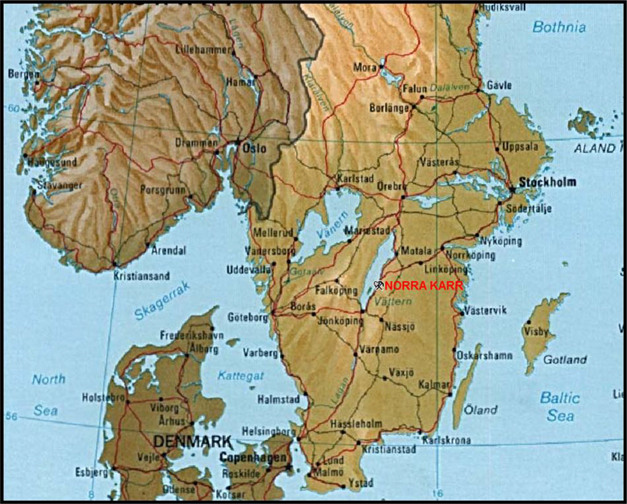
Figure 4-1: Location of the Norra Kärr Project, Sweden
The project is located approximately 10 km north-east of the small town of Gränna and is centred at coordinate 474428 E by 6440268 N (approximately) by the SWEREF99TM coordinate system. This approximates to 58° 6’10’’ north and 14° 33’ 58’’ east based on the WGS 84 datum.
 |  |
| | Prefeasibility Study - NI 43-101 - Technical report for the Norra Kärr
Rare Earth Element Deposit - 0465-RPT-014 Rev 0 |
The Norra Kärr project consists of four claims, Norra Kärr No. 1, Norra Kärr No. 2, Norra Kärr No. 3 and Norra Kärr No. 4,together covering just in excess of 5 079 hectares (50.79 km2). A map of the four exploration claims is shown in Figure 4-2 whilst the coordinates of the respective claim vertices are summarized in Table 4-1.
Norra Kärr No. 1 (see Figure 4-2) is the area of interest as it contains the REE mineral resource that is the subject of this report. A 25 year exploitation concession for Norra Kärr was granted to Tasman in 2013.
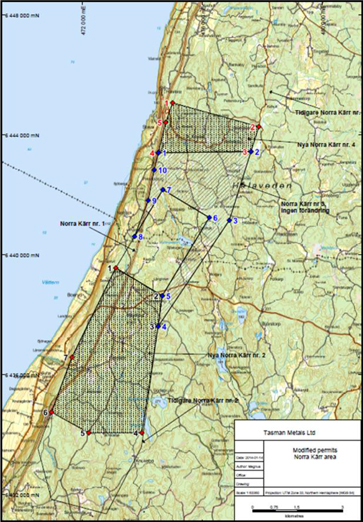
Figure 4-2: Relative Position of the Norra Kärr Licences (s.l.)
 |  |
| | Prefeasibility Study - NI 43-101 - Technical report for the Norra Kärr
Rare Earth Element Deposit - 0465-RPT-014 Rev 0 |
Table 4-1:Tasman Norra Kärr Licence Details
| | SWEREF99TM | | | | | | | | | | | |
Point
No | | Northing | | | Easting | | | Licence
Number | | Area | | Licence
Issue Date | | Licence
Renewal
Date | | Licence
Expiry Date |
| 1 | | | 6442166.16 | | | | 474689.99 | | | Norra Kärr | | 550 ha | | 31/08/2009 | | 31/08/2011 | | 31/08/2015 |
| 2 | | | 6441236.00 | | | | 476235.51 | | | No.1 | | | | | | | | |
| 3 | | | 6438628.27 | | | | 474667.29 | | | | | | | | | | | |
| 4 | | | 6439557.43 | | | | 473121.79 | | | | | | | | | | | |
| | | | | | | | | | | | | | | | | | | |
| 1 | | | 6439557.43 | | | | 473121.79 | | | | | | | | | | | |
| 2 | | | 6438628.27 | | | | 474667.29 | | | | | | | | | | | |
| 3 | | | 6437610.00 | | | | 474527.00 | | | | | | | | | | | |
| 4 | | | 6434060.00 | | | | 474039.44 | | | Norra Kärr | | 1 287 ha | | 11/01/2011 | | 11/01/2014 | | 11/01/2015 |
| 5 | | | 6434060.00 | | | | 472220.00 | | | No.2 | | | | | | | | |
| 6 | | | 6434750.00 | | | | 470980.00 | | | | | | | | | | | |
| 7 | | | 6436578.14 | | | | 471659.98 | | | | | | | | | | | |
| | | | | | | | | | | | | | | | | | | |
| 1 | | | 6443397.87 | | | | 474539.33 | | | | | | | | | | | |
| 2 | | | 6443434.75 | | | | 477624.68 | | | | | | | | | | | |
| 3 | | | 6441144.02 | | | | 476903.35 | | | | | | | | | | | |
| 4 | | | 6437607.05 | | | | 474531.55 | | | | | | | | | | | |
| 5 | | | 6438628.27 | | | | 474667.29 | | | Norra Kärr | | 753 ha | | 07/03/2011 | | 07/03/2014 | | 07/03/2017 |
| 6 | | | 6441236.00 | | | | 476235.51 | | | No.3 | | | | | | | | |
| 7 | | | 6442166.16 | | | | 474689.99 | | | | | | | | | | | |
| 8 | | | 6440606.48 | | | | 473746.01 | | | | | | | | | | | |
| 9 | | | 6441806.46 | | | | 474201.49 | | | | | | | | | | | |
| 10 | | | 6442823.42 | | | | 474399.25 | | | | | | | | | | | |
| | | | | | | | | | | | | | | | | | | |
| 1 | | | 6445060.00 | | | | 475015.00 | | | | | | | | | | | |
| 2 | | | 6444265.00 | | | | 477885.00 | | | | | | | | | | | |
| 3 | | | 6443434.75 | | | | 477624.68 | | | Norra Kärr | | 389 ha | | 28/01/2011 | | 28/01/2014 | | 28/01/2017 |
| 4 | | | 6443397.87 | | | | 474539.33 | | | No.4 | | | | | | | | |
| 5 | | | 6444407.42 | | | | 474785.16 | | | | | | | | | | | |
 |  |
| | Prefeasibility Study - NI 43-101 - Technical report for the Norra Kärr
Rare Earth Element Deposit - 0465-RPT-014 Rev 0 |
| 4.3 | Environmental Liabilities |
No significant environmental liabilities or legacy environmental contamination has been identified within the exploitation concession area. The site has historically been in agricultural (grazing land) and forestry use.
Tasman holds an exploitation concession for the area around the Norra Kärr deposit. The concession became valid in 2013 and, following an initial appeal during which the Government ruled in Tasman Metals AB favour, is in force until 2038. To operate the mine the company will also need to acquire an environmental permit, and construction permits for buildings etc.
The exploitation concession grants the right to exploit the mineral deposit and relates to the specific area marked in the concession decision. The initial validity period of 25 years may be extended by the mining authority. The concession as well as exploration permits pay be transferred to another holder, after approval from the Mining Inspector.
The exploitation concession also the grants right to use land within the concession. For the activities outside of the concession area, the company will need to secure access to the required land areas. This can be done by a land designation, granted by the Chief Mining Inspector. The company will seek to purchase the land or otherwise secure access (e.g. land lease) but it is possible to get a designation of land also for such land that is not owned by the company. In that case the designation will be accompanied by a security for compensation. The designation of land procedure is normally undertaken after the environmental permit has been granted.
It should be noted that Tasman also has a permit for test mining in order to conduct pilot beneficiation studies, which was granted in March 2014.
 |  |
| | Prefeasibility Study - NI 43-101 - Technical report for the Norra Kärr
Rare Earth Element Deposit - 0465-RPT-014 Rev 0 |
| Section 5 | Accessibility, Climate, Local Resources, Infrastructure and Physiography |
The Norra Kärr site is located in Southern Sweden, approximately 10 km north-east of the town of Gränna and approximately 300 km southwest of the capital Stockholm. The property is accessible by road from Stockholm on highway E4 to the town of Gränna which lies on the eastern shore of Lake Vättern. From Gränna a secondary road heads north and then east under the E4, linking it with a gravel road that accesses the centre of the property. A new access road to the project site will be required when the project progresses.
Current site access is from the smaller roads (Gränna – Tranås highway); the nearest interchanges from the E4 are at Stava to the north (approximately 4 km) and Gränna to the south-west (approximately 11 km). A gravel road leads from the highway to the Norra Kärr property. The road is narrow but in good to moderate condition. There are also other gravel roads that lead to various parts of the property.
| 5.2 | Climate and Length of Operating Season |
The region has a cold temperate continental climate with warm summers. Winters are variable in southern Sweden with the amount of snowfall varying each year.
Scandinavia, like the rest of north-western Europe, is influenced by the Gulf Stream which moderates the climate so that the winters in central and southern Sweden are milder than in many parts of Canada at similar latitude. The work at the project site could be carried out on a year-round basis.
The mean wind speed measured at the 8405-Visingsö A station, located approximately 9 km west of Norra Kärr, during the years 1961-1990 (the standard normal period) was 5.4 m/s. The measuring station is located lower than the site on the island of Visingsö in the Lake Vättern. The area around the site and south of it has high wind speeds and has been determined an area potentially suitable for wind energy production.
The maximum precipitation is in April and July with an average of 517 mm per year (measuring station Högemålen 1961-2014).
Temperature measurements in the area have been carried out at Tranås, Visingsö A and Visingsö measuring stations. The mean annual recorded temperature for the three stations varied between 6.2 °C and 6.6 °C during the years 1961-1990.
 |  |
| | Prefeasibility Study - NI 43-101 - Technical report for the Norra Kärr
Rare Earth Element Deposit - 0465-RPT-014 Rev 0 |
| 5.3 | Proximity to Population Centre and Transport |
Norra Kärr is located in the Municipality of Jönköping just south of the border between the County of Jönköping and the County of Östergötland. The nearest town is Gränna, approximately 10 km south-west from the project site. Gränna and the surrounding countryside villages have approximately 4 000 residents. Tourism has a significant economic importance in Gränna during the summer months.
The city of Jönköping lies about 30 km south of Gränna and has a population in excess of 84 000. The city is accessible by either highway, rail or through the local airport. The Municipality of Jönköping has a population of over 131 000 and it is expansive with an increasing number of residents. The County of Jönköping (Jönköpings län) has a population of 341 000. A number of stately offices and departments are based in the urban area of Jönköping and it has a university for 11 000 students.
The neighbouring municipalities Ödeshög (immediately to the north) and Tranås (about 25 km to the east) are smallish, largely rural communities. Tranås municipality has about 18 000 inhabitants, most of whom (14 000) live in the central town, also called Tranås. The municipality’s population has stayed fairly steady at a little under 20 000 people since the 1970s. The population of Ödeshög municipality is only about 5 300 and has been steadily declining since 1980. About 2 500 people live in the central town Ödeshög. Tranås is part of the County of Jönköping while Ödeshög is part of the County of Östergötland (Östergötlands län).
Northeast of Gränna, about 90 km along highway E4, lies the city of Linköping with a population of around 148 000. This city dates back 700 years and is known for its university and high-technology industries, including the SAAB aircraft plant. Both Jönköping and Linköping have hospitals.
The project site is located some 300 m (minimum distance) east of the highway E4 which runs between Helsingborg in the south of Sweden and Torneå in Finland. It is the mainline road used by most vehicle traffic, both personal cars and freight trailers, and it passes in the vicinity of the largest cities in Sweden and through the capital Stockholm. The E4 is a primary road selection for dangerous goods transportation through or within the county of Jönköping.
Approximately 20 km east of Norra Kärr runs the southern major railroad through Sweden connecting Stockholm and Malmö. The closest railway stations to the site are located 20-25 km east in Tranås and Boxholm. A minor road going in an east-westerly direction connects Norra Kärr and Tranås. The southern railway line is used for the transport of goods, regional trains and long distance trains and it is considered to be the most important railway line in Sweden. The railway line is heavily used since it connects the two major cities in Sweden and the northern Scandinavia with the European continent.
 |  |
| | Prefeasibility Study - NI 43-101 - Technical report for the Norra Kärr
Rare Earth Element Deposit - 0465-RPT-014 Rev 0 |
| 5.4 | Surface Rights, Land Availability, Infrastructure, and Local Resources |
Tasman Metals holds the exploitation concession that grants the rights to the mineral deposit. The exploitation concession grants the right to exploit the mineral deposit to the concession holder. In addition to the mineral rights, the company must acquire an environmental permit before mine construction or operations can be initiated. Further information about permitting requirements is given in Section 20.
During the PFS preparation, investigations and localization studies were undertaken to identify suitable locations for the process plant, waste rock and tailings management facilities. Potential locations corresponding to anticipated space requirements for the planned 20 year mine life have been established. These facilities are described in more detail in the following sections.
Currently the land around the deposit and the areas for the facilities are held by a number of landowners. Surface rights and rights of access to the property and other required land must be purchased or leased. The company intends to purchase required land by means of negotiating with the landowners. All purchases of land need to be registered with the Swedish Land Survey authority to register the title to the property.
Alternatively it is possible to get a designation of land decision from the Chief Mining Inspector granting access to land needed for outside of the exploitation concession area. If landowners refuse to sell the land, the designation may still be granted and the landowners must be compensated as per Swedish practice.
Prior to submission of the application for the Environmental Permit, the water rights necessary to supply the mining operation and water rights in areas impacted by the drawdown of surface or ground waters as a result of the operation must be obtained.
The make-up water for the process will be extracted from Lake Vättern and a pipeline for the purpose will be constructed. The required quantities are available in the Lake, but a permit for the extraction activity will need to be acquired as part of the overall environmental permit for the operation.
There is no municipal water or sewer system within the area of Norra Kärr. All residential properties and buildings in the nearby area have private septic tanks and dug or drilled wells for drinking water. The nearest municipal water and sewerage network is located in Uppgränna approximately 6 km southeast of Norra Kärr. Some of the dwellings also have geothermal wells.
There are both above and below ground cables for 10 kV electricity in the immediate vicinity of Norra Kärr, according to Jönköping Energi AB. New high voltage connection to the site will be developed by the state owned power company Vattenfall, if the Norra Kärr project proceeds. Discussions with the power company
 |  |
| | Prefeasibility Study - NI 43-101 - Technical report for the Norra Kärr
Rare Earth Element Deposit - 0465-RPT-014 Rev 0 |
have been initiated. As part of the PFS design, on-site generation of steam and heat for the process plant has been studied.
The availability of skilled workforce around the project area is good thanks to proximity to major cities and universities. Sweden has a long mining history and required expertise is expected to be available in-country. However as the mining industry in Sweden is mostly concentrated in the northern part of the country, experts with certain specific skills may need to be hired from elsewhere in Sweden or abroad. The central location in Southern Sweden makes the project area attractive as a living environment and problems with recruiting personnel are not anticipated.
| 5.5 | Topography, Elevation, and Vegetation |
Norra Kärr is located in an undulating terrain with small hills and an average elevation of approximately 200 m above sea level. The hills are mainly covered by forest (clear-cut in places) on glacial moraine soils, with agricultural land (fields, grazing land and hay meadows) among the forests. In Norra Kärr thin till cover is mixed with varied rock outcrops with elements of peat and the depth of the soil cover varies between 0 – 11 m. The countryside around Norra Kärr is characterized by narrow fault controlled valleys which cut through the landscape east of Lake Vättern with faults parallel to the Lake Vättern basin.
The area is located in the boreo-nemoral zone, with elements of habitats reflecting the southern deciduous broadleaf forest region and the northern coniferous forest region. Vegetation consists of a mixture of conifers (dominantly spruce) and deciduous trees like ash, elm, birch, alder and oak. Many of the old ash trees in the area are pollarded and provide habitat for varied species of lichens. The sparse outcroppings are partly covered by rich moss flora.
The main feature of the area is Lake Vättern, located approximately 1.5 km west from Norra Kärr, and the plain on its eastern shore. Lake Vättern is the second largest lake in Sweden with an area of 1 940 km². Steep slopes mark the transition from the lake to the higher ground where the project site is located. Lake Vättern is an important source for drinking water for over 250 000 people in the region and it is considered that its role as a water source will increase in the future. The escarpment area between the lower-lying Lake Vättern (elevation about 88 m AMSL) and the site is considered to have a high biodiversity value.
The project area is characterized by an alternating agricultural landscape comprising of increasingly overgrown grass meadows, broadleaved trees, and forest in forestry use (predominantly spruce). The rural area around Norra Kärr is used for active farming with grazing animals. Much of the farming land which was used for grazing has been planted with spruce intended for forestry use. Some of the forested areas have recently been clear-cut (some during 2014) while many are seeding stands and young growth but there are also more mature areas. A large proportion of the PFS nominated project
 |  |
| | Prefeasibility Study - NI 43-101 - Technical report for the Norra Kärr
Rare Earth Element Deposit - 0465-RPT-014 Rev 0 |
footprint is seasonally used for recreational hunting. There are small watercourses located partially within the project footprint: small lake named Gyllingesjön is located approximately 600 m east from the concession area, and two small streams that flow into Lake Vättern. The easternmost part of the Project area area drains naturally away from the Vättern via the stream Adelövån which flows towards the south.
Current land use in the area of the Norra Kärr property is mixed forestry and recreational hunting. There are old agricultural lands, spruce plantations and some wetland areas and small ponds, which have been dug to attract waterfowl for hunters. A species-rich meadow flora still exists in some old pasture lands despite being un-cultivated.
There are several protected areas with high natural value in the vicinity of the project site.
These areas include:
| · | National Interest for nature value; |
| · | UNESCO East Vättern Scarp landscape - biosphere reserve (not to be confused with a nature reserve as not a restrictive protection area); |
| · | Natura 2000-areas and nature reserves (not overlapping with the Project area); and |
| · | Lake Vättern water protection area. |
Further information about the project area environment is included in Section 20.
 |  |
| | Prefeasibility Study - NI 43-101 - Technical report for the Norra Kärr
Rare Earth Element Deposit - 0465-RPT-014 Rev 0 |
Section 6 History
| 6.1 | Summary of Regional Exploration and Mining History |
Norra Kärr was initially discovered in 1906 by the Swedish Geological Survey (SGU) who identified the Norra Kärr alkaline igneous complex during regional geological mapping. Following the geological mapping, mineralogical studies were carried out by Professor A Törnebohm on a green fine grained rock obtained from Norra Kärr. The principal constituents of this rock were ascertained to be nepheline with lesser amounts of zirconosilicates, eudialyte, and catapleiite. Professor Törnebohm named the rock type as “catapleiite-syenite���, however, the name was revised by later workers to “grennaite” in reference to the nearby town of Gränna.
In the 1940s extensive scientific investigations of the Norra Kärr complex were undertaken by O.J. Adamsson with works including detailed petrographical descriptions of the various rock types as well as additional geochemical data.
In the mid to latter parts of the 1940s during and post-World War II the Norra Kärr complex was investigated by the Swedish company Boliden AB. Prior to Boliden the Norra Kärr complex had little in the way of intrusive investigations through trenching or drilling. In 1948 an agreement regarding mining rights between Boliden and the landowners was secured and in 1949 Boliden commenced some bulk sampling and concentration testwork. Boliden reported difficulties in separating the nepheline and feldspar from the pyroxene aegerine resulting in elevated iron levels in the final concentrate. The works carried out by Boliden ceased as prices for zirconium dropped due to increased global supply from placer mineral sand deposits.
Exploration activity at Norra Kärr resumed in 1974 with Boliden carrying out two large east-west trenches (as shown in Figure 6-1) with the aim of delineating nepheline mineralisation for potential economic extraction. The northern most trench was split into eight geological intervals with between 4-30 samples taken in each interval with a total of 151 samples taken with a combined total length of 398 m. The southern trench was also split into eight intervals with the number of samples per interval between 8-34, and totalling 169 samples with a combined length of 382 m.
 |  |
| | Prefeasibility Study - NI 43-101 - Technical report for the Norra Kärr
Rare Earth Element Deposit - 0465-RPT-014 Rev 0 |
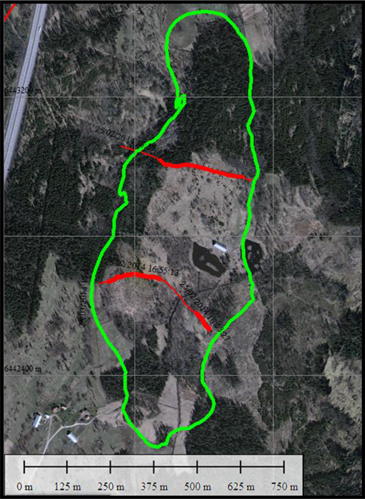
Figure 6-1: Location of the Boliden 1974 Trenches
Green track – outline of Norra Kärr intrusive complex
Red tracks – Boliden (1947) trenches. [Heavier tracks are the higher grade REE zones.]
A calculation of the composited Boliden samples (3) yielded the following weighted averages:
| · | North Trench: 244 m @ 1.92 % zirconium oxide, 0.37 % Total Rare Earth Element Oxides (TREO); and |
| · | South Trench: 149 m @ 1.51 % zirconium oxide, 0.50 % TREO, and 52 m @ 1.47 % zirconium oxide, 0.44 % TREO. |
Whilst Boliden reported TREO grades, six of the Heavy Rare Earth Element Oxides (HREO) were not assayed. Table 6-1 and Table 6-2 below summarise the results of the Boliden trenching testwork.
 |  |
| | Prefeasibility Study - NI 43-101 - Technical report for the Norra Kärr
Rare Earth Element Deposit - 0465-RPT-014 Rev 0 |
Table 6-1: Boliden 1974 North Trench Results (PAH, 2012)
| Interval | | | IB | | | | II | | | | III | | | | IV | | | | V | | | | VI | | | | VII | | | | VIII | |
| No. Samples | | | 4 | | | | 8 | | | | 16 | | | | 30 | | | | 30 | | | | 30 | | | | 28 | | | | 5 | |
| Length (m) | | | 47 | | | | 22 | | | | 53 | | | | 67.5 | | | | 60.5 | | | | 60 | | | | 56 | | | | 32 | |
| ZrO2 (%) | | | 0.17 | | | | 0.59 | | | | 0.48 | | | | 2.15 | | | | 2.00 | | | | 1.94 | | | | 1.52 | | | | 0.55 | |
| Hf (%) | | | 0.004 | | | | 0.014 | | | | 0.010 | | | | 0.040 | | | | 0.043 | | | | 0.049 | | | | 0.031 | | | | 0.009 | |
| TREO (%) | | | 0.06 | | | | 0.13 | | | | 0.16 | | | | 0.35 | | | | 0.40 | | | | 0.45 | | | | 0.28 | | | | 0.10 | |
Table 6-2: Boliden 1974 South Trench Results (PAH, 2012)
| Interval | | | IX | | | | X | | | | XI | | | | XII | | | | XIII | | | | XIV | | | | XV | | | | XVI | |
| No. Samples | | | 11 | | | | 10 | | | | 29 | | | | 28 | | | | 33 | | | | 34 | | | | 8 | | | | 16 | |
| Length (m) | | | 25.0 | | | | 21.5 | | | | 63.5 | | | | 64.0 | | | | 66.0 | | | | 90.0 | | | | 17.0 | | | | 35.0 | |
| ZrO2 (%) | | | 0.90 | | | | 1.40 | | | | 1.66 | | | | 1.40 | | | | 0.47 | | | | 0.35 | | | | 1.47 | | | | 1.47 | |
| Hf (%) | | | 0.017 | | | | 0.026 | | | | 0.028 | | | | 0.020 | | | | 0.008 | | | | 0.006 | | | | 0.020 | | | | 0.027 | |
| TREO (%) | | | 0.07 | | | | 0.22 | | | | 0.42 | | | | 0.67 | | | | 0.38 | | | | 0.24 | | | | 0.71 | | | | 0.31 | |
More recently, several interesting academic studies have been undertaken by various workers – mainly at the University of Gothenburg (6) (7) (8). These studies have addressed various facets of the Norra Kärr complex including:
| · | Mineralogy – mainly of the three eudialyte types present; |
| · | Fenitisation of the contact zone; and |
| · | Various geological excursion guides. |
| 6.2 | Historical Resource Estimates |
A Mineral Resource estimate valid as of March 2012 was produced by Runge Pincock Minarco (RPM) as part of a Preliminary Economic Assessment (PEA), also produced by RPM which was issued in July 2013.
The Mineral Resource estimate was based on diamond drilling from the 2009-2011 exploration programmes with the drill hole database being complete as of 19 August 2011. A total of 49 drill holes totalling 7 375.14 m was supplied in the database.
Modelling works were carried out using Gemcom Surpac® software. Geological cross sections were produced along 10 drill hole section lines spaced approximately 100 m apart. At the southern end of the deposit the geological wireframes were extended 100 m to the south whilst at the northern end the
 |  |
| | Prefeasibility Study - NI 43-101 - Technical report for the Norra Kärr
Rare Earth Element Deposit - 0465-RPT-014 Rev 0 |
geological wireframes were extended 250 m past the last drill hole profile to reflect the surface geological interpretation.
The estimation of grades into the Mineral Resource block model was carried out using inverse power distance. A density of 2.70 t/m3 was applied to the block model based on 579 density measurements and taking the average. For the purpose of reporting Mineral Resources the block model was constrained by a conceptual Whittle® open pit. The pit optimisation was based on a basket price for TREO of 51.00 USD/kg which was discounted by 38 % to 31.60 USD/kg TREO to reflect the proposed concentrate to be produced.
Classification of the Mineral Resources by RPM was carried out in accordance with the CIM. Only mineralisation falling within the conceptual open pit were classified as Mineral Resources with the classifications based on elevation. Mineralisation from surface to a depth of 80 m RL was assigned a classification ofIndicated whist any mineralisation between 80 m RL and 0 m RL was classified asInferred.
A copy of the RPM Mineral Resource summary included as part of the Norra Kärr July 2013 PEA is shown below in Table 6-3.
 |  |
| | Prefeasibility Study - NI 43-101 - Technical report for the Norra Kärr
Rare Earth Element Deposit - 0465-RPT-014 Rev 0 |
Table 6-3: RPM Mineral Resource Statement (March 2012)
| | | Light Rare Earth Oxides (LREO) | | | Heavy Rare Earth Oxide (HREO) | |
Resource
Classification | | Tonnage | | | TREO | | | LREO | | | HREO | | | HREO
/TREO | | | ZrO2 | | | Contained TREO | | | La2O3 | | | Ce2O3 | | | Pr2O3 | | | Nd2O3 | | | Sm2O3 | | | Eu2O3 | | | Gd2O3 | | | Tb2O3 | | | Dy2O3 | | | Ho2O3 | | | Er2O3 | | | Tm2O3 | | | Yb2O3 | | | Lu2O3 | | | Y2O3 | |
| | | (Mt) | | | % | | | % | | | % | | | % | | | % | | | (t) | | | % | | | % | | | % | | | % | | | % | | | % | | | % | | | % | | | % | | | % | | | % | | | % | | | % | | | % | | | % | |
| Indicated | | 41.6 | | | 0.57 | | | 0.28 | | | 0.29 | | | 0.51 | | | 1.71 | | | 237 120 | | | 0.0567 | | | 0.126 | | | 0.0160 | | | 0.0632 | | | 0.0167 | | | 0.00213 | | | 0.0180 | | | 0.00366 | | | 0.0249 | | | 0.00550 | | | 0.0170 | | | 0.00263 | | | 0.0162 | | | 0.00220 | | | 0.197 | |
| Inferred | | 16.5 | | | 0.64 | | | 0.33 | | | 0.31 | | | 0.49 | | | 1.70 | | | 105 600 | | | 0.0644 | | | 0.148 | | | 0.0189 | | | 0.0750 | | | 0.0195 | | | 0.00231 | | | 0.0200 | | | 0.00392 | | | 0.0252 | | | 0.00548 | | | 0.0165 | | | 0.00260 | | | 0.0158 | | | 0.00217 | | | 0.218 | |
| | | | | | | | | | | | | | | | | | | | | | | | | | | | | | | | | | | | | | | | | | | | | | | | | | | | | | | | | | | | | | | | | | | | | | | | | | | | | | | | | | | | | | | | | |
 |  |
| | Prefeasibility Study - NI 43-101 - Technical report for the Norra Kärr
Rare Earth Element Deposit - 0465-RPT-014 Rev 0 |
Section 7 Geological Setting and Mineralisation
While the regional setting within Scandinavia is not a critical factor in the exploration process, it is considered that there several significant features that are worth considering.
The Sveconorwegian orogen in southern Scandinavia is the result of a collision between Fennoscandia (the south-western continental segment of Baltica) and another continent in late Mesoproterozoic time (see Figure 7-1). The orogenic province is composed of five distinct Proterozoic gneiss segments that were displaced and reworked during a succession of compressional (and extensional) orogenic phases at between 1.14-0.96 Ga.

Figure 7-1: Litho-Tectonic and Shear Zone Map of the Sveco-Norwegian Orogen, South-Western Scandinavia
The Norra Kärr complex has been emplaced in a rift setting (Lake Vättern) within the Trans Scandinavian Igneous Belt (TIB) (Figure 7-2).
The TIB comprises a giant elongated array of batholiths extending c. 1 400 km across the Scandinavian Peninsula from south-easternmost Sweden to north-western Norway. The TIB is traditionally divided into four main units based on tectonic and lithological criteria:
 |  |
| | Prefeasibility Study - NI 43-101 - Technical report for the Norra Kärr
Rare Earth Element Deposit - 0465-RPT-014 Rev 0 |
| i. | The Småland-Värmland belt in the south and west (the host region of the Norra Kärr complex); |
| iii. | The Rätan Batholith in the centre; and |
| iv. | The Revsundgranitoid suite in the north. |
The rocks of the TIB dominantly consist of coarse (porphyritic) monzodiorites to granites of alkali-calcic chemistry, with transitions to calc-alkaline or alkaline rocks.
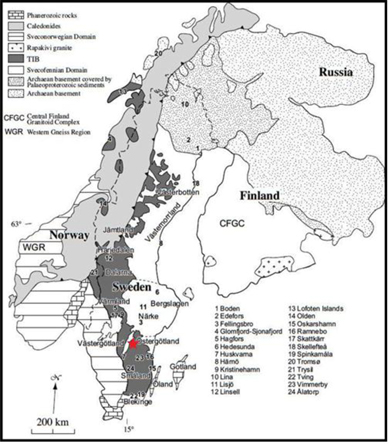
Figure 7-2: Generalised Geological Map of the Fennoscandian Shield Showing the TIB
(Norra Kärr indicated by the red star)
It is apparent that the positioning of the Norra Kärr complex is at least partially controlled by the shearing separating the Fennoscandia Foreland from the eastern segment of the Proterozoic gneiss sequences to the east. This shearing known variously as the Sveconorwegian Frontal Deformation Zone to the north of Lake Vättern and the Protogine Zone to the south has been intensively studied over the years (5) . This is also well shown in the regional aeromagnetics (see Figure 7-3 below).
 |  |
| | Prefeasibility Study - NI 43-101 - Technical report for the Norra Kärr
Rare Earth Element Deposit - 0465-RPT-014 Rev 0 |
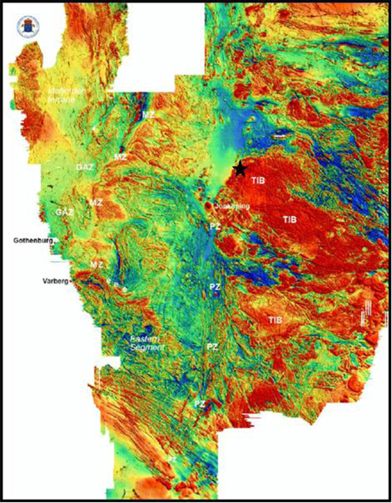
Figure 7-3: Aeromagnetic Anomaly Map of Southern Sweden
Abbreviations: PZ = Protogine Zone, MZ = Mylonite Zone, GÄZ = GötaÄlv Zone, TIB= Transscandinavian Igneous Belt
Norra Kärr indicated by the black star.
A further regional-scale factor worth considering is the parallelism of the Lake Vättern rift and the Oslo rift to the west. This can be seen in Figure 7-4.
The significance of this is illustrated by reference to the work of Sørensen (2003) (6) in which he notes the occurrences of nepheline syenite in the Gardar and Oslo rift systems in south Greenland and south-east Norway. The comparison with Norra Kärr and the Vättern rift is compelling.
 |  |
| | Prefeasibility Study - NI 43-101 - Technical report for the Norra Kärr
Rare Earth Element Deposit - 0465-RPT-014 Rev 0 |
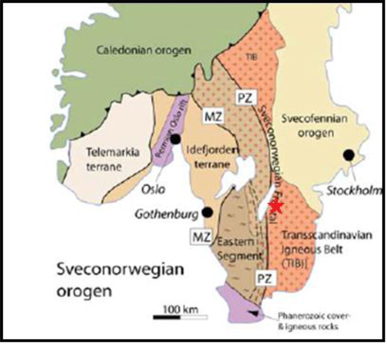
Figure 7-4: Simplified Geological Outline of the Svecconorwegian Orogeny
Norra Kärr indicated by the red star
The Norra Kärr intrusive is located close (2 km) to the eastern shore of Lake Vättern, a large rift-controlled lake. Following the Tasman exploration efforts, the Norra Kärr complex is known to be an ovoid mass with an areal extent of some 1.3 km by 450 m.
The Norra Kärr complex is intruded into rocks of the TIB – specifically the Växjö Granite of the Småland-Värmland belt (see Section 7.1 above). This has been dated at ~1 800 Ma while the fenitisation flanking the western side of the Norra Kärr complex has been dated at 1 489 ± 8 Ma (Sjöqvist et al, 2013 (6); Christensen, 2013 (7)) thus establishing a reliable age for this intrusive body. It does however, beg the question as to the “provenance” of the Norra Kärr rocks.
Geologically, the Norra Kärr complex is best defined as a zoned agpaitic, peralkaline, nepheline syenite - similar in many respects to other well-known peralkaline complexes, e.g. Ilimaussaq in Greenland and Lovozero on the Kola Peninsula of Russia.
 |  |
| | Prefeasibility Study - NI 43-101 - Technical report for the Norra Kärr
Rare Earth Element Deposit - 0465-RPT-014 Rev 0 |
The term “agpaitic” is restricted to peralkaline nepheline syenites containing minerals such as eudialyte and rinkite, that is complex silicates of zirconium, titanium, the rare earth elements, and fluorine and other volatiles.
Agpaitic nepheline syenites per definition do not contain simple Zr minerals like zircon and baddeleyite, despite generally high Zr contents (up to 1–2 wt.% ZrO2). Instead, Zr is mainly hosted in rock-forming complex Na-Ca-Zr silicate minerals such as members of the catapleiite, eudialyte, rosenbuschite, and wöhlerite groups.
There has historically been considerable discussion about whether or not the Norra Kärr complex has been deformed and metamorphosed. New Ar-Ar step heating ages on sodic amphibole from Norra Kärr and muscovite and biotite from the country rocks give plateau ages at 1.1 Ga and 0.94 Ga, which correspond to ages derived for Sveconorwegian shear zones in the area (Sjöqvistet al, 2013 (4)). Together with textural and crystal chemical evidence, these ages make a compelling argument for some form of Sveconorwegian overprint of the Norra Kärr alkaline complex. This is borne out both by a report on the structural geology of the complex (Rankin, 2011 (8)) and by observations by the Tasman geologists in the field. Rankin states that:
“Gross magmatic layering and orientation of early deformation fabrics suggest the body was emplaced as a sill (possibly lopolithic) within Palaeoproterozoic granite / gneissic basement of the Fennoscandian Shield.
The intrusive underwent 3 significant phases of deformation:
a) D1 – N-S to NE-SW compression with development of subhorizontal to shallow-dipping foliation (variable intensity). S1 is sub-parallel to So magmatic layering. Folding appears restricted to small-scale intrafolial folds.
b) D2 – E-W compression with development of a regional N-S F2 synform. The synform dips moderately to the west and plunges shallow to moderate to the SW. The Norra Kaar intrusive is preserved in the synformal keel. A variable intensity F2 foliation overprints S1. This is generally a flattening fabric, but is locally associated with reverse – thrust mylonite development on the overturned western limb (along the intrusive contact).
c) D3 – N-S compression with development of E-W and minor conjugate NE- / NW- trending kink folds across the intrusive. The kink folding produces localised complexities in the orientation of the dominant S0 / S1 fabric.”
While WAI cannot confirm Rankin’s detailed observations and conclusions, there is no doubt that there has been a degree of deformation.
 |  |
| | Prefeasibility Study - NI 43-101 - Technical report for the Norra Kärr
Rare Earth Element Deposit - 0465-RPT-014 Rev 0 |
| 7.4 | Norra Kärr Geology and Mineralisation |
The basic geology of Norra Kärr is relatively straightforward within the undoubted complexities of the alkaline intrusive environment as noted above.
The size and shape of the Norra Kärr intrusive complex is now well established from the exploratory drilling carried out by Tasman in their evaluation of the body. The intrusive is elongated in a north-north-east – south-south-west direction and is approximately 1 300 metres long by 450 metres wide.
As noted, it is intruded into rocks of the TIB – specifically the Växjö Granite of the Småland-Värmland belt. There is however, some evidence that the Norra Kärr intrusive suffered some deformation during the Sveconorwegian shearing episode(s) as there is evidence of cataclasis on the western side of the intrusive. This is backed up by an interpretation of the (recently obtained) ground magnetic data which suggests that some rotation, suggestive of a dextral shearing movement, has affected the intrusive body. It is possible that it acted as a “kernel” and was rotated clockwise slightly as a result of the shearing couple oriented north-east – south-west evident from the ground magnetic data (see Figure 7-5).
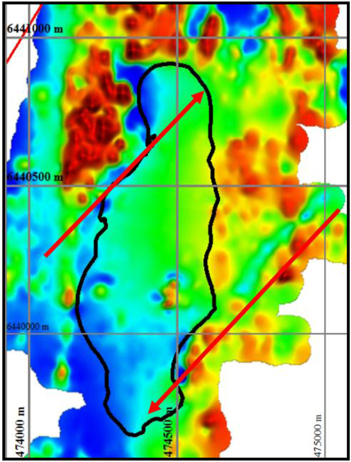
Figure 7-5: Possible Shearing Movement for the Norra Kärr Intrusive
 |  |
| | Prefeasibility Study - NI 43-101 - Technical report for the Norra Kärr
Rare Earth Element Deposit - 0465-RPT-014 Rev 0 |
This interpretation would go some way towards explaining the structural complexities evident in the southern portion of the intrusive body where the faulting has been observed and interpreted. The intrusive body typically dips to the west at angles between 35° and 40°, however, in the southern part of the intrusive the angle can be greater than 40°
Lithologically, the Norra Kärr intrusive demonstrates the same complexity of rock types as other similar agpaitic nepheline syenite intrusives, e.g. Ilimaussaq, Lovozero, with a number of more or less unique lithologies being present. Due to the age of some of the work - the workers were without other similar bodies to use as a comparison – “local” rock names were applied. They are mostly variations on a theme so the lithological complexity originally – and understandably – interpreted by the Tasman geologists, while somewhat confusing at first sight, is actually relatively easy to understand. More recently, the Tasman geologists have simplified the “stratigraphy” and WAI have used this simpler approach in the Mineral Resourceestimation (see Section 14). However, the full lithological table as compiled by the Tasman geological team is provided in order to illustrate both the complexity and the well-thought out approach by Tasman.
The Norra Kärr intrusive exhibits a clear “layering”. It is not clear if this is primary igneous layering or not and in this respect there again similarities with the type localities of Ilimaussaq and Lovozero. By analogy, it is probable that there is at least a degree of igneous differentiation but the mechanics of this are not yet understood. Notably, if the original intrusion had a lopolithic shape then the later deformation has played a significant role. Some 75 % of the intrusive consists of varieties of “grennaite”, an aegirine-rich nepheline syenite carrying the rare, zircono-silicate minerals, eudialyte and catapleiite. In some respects they resemble the lujavrites present at other agpaitic syenites, e.g. Ilimaussaq and Lovozero.
Regardless of the mechanism, the Norra Kärr intrusive exhibits a roughly concentric layering (Figure 7-6) with the following pattern being evident. From the centre to the flanks, the main zonal lithotypes are:
| · | A central (but off-set) core of kaxtorpite (KAX) surrounded by; |
| · | A migmatitic grennaite zone (GTM); |
| · | A “pegmatitic” grennatite (GPG or PGT) ± lakarpite (LAK); |
| · | Fine-grained grennaite containing catapleiite (GTC); and |
| · | Various other relatively minor alkaline rocks and mafic intrusives. |
 |  |
| | Prefeasibility Study - NI 43-101 - Technical report for the Norra Kärr
Rare Earth Element Deposit - 0465-RPT-014 Rev 0 |
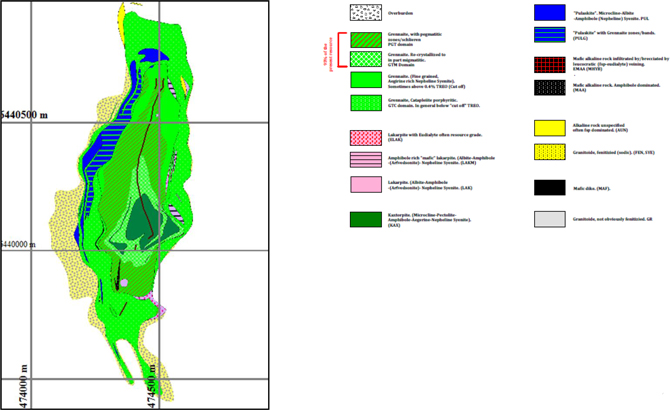
Figure 7-6 Geological Map of the Norra Kärr Intrusive
 |  |
| | Prefeasibility Study - NI 43-101 - Technical report for the Norra Kärr
Rare Earth Element Deposit - 0465-RPT-014 Rev 0 |
A brief description of the various rock types (and their sub-types) is given in Figure 7-7.
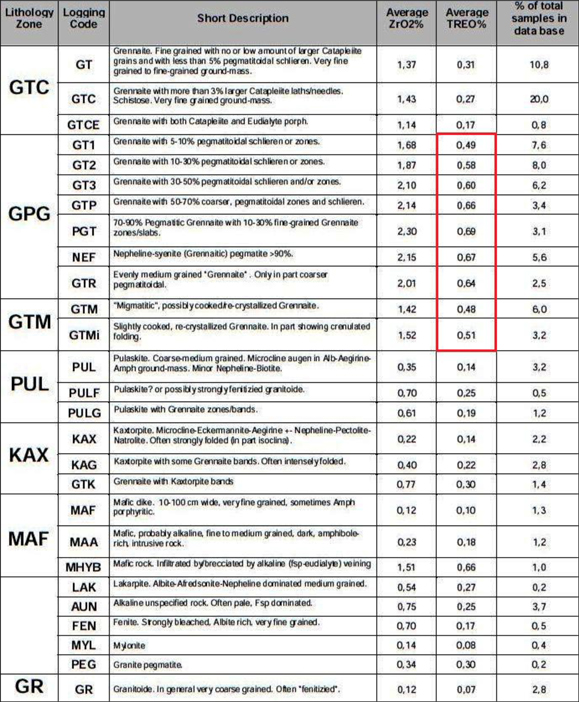
Figure 7-7: Norra Kärr Intrusive Body Litho Types
[Red outline = principal ore zones.]
The key points on the distribution within the Norra Kärr complex of the main lithotypes shown above and on the geological map (Figure 7-56) are the lithologies are described below:
 |  |
| | Prefeasibility Study - NI 43-101 - Technical report for the Norra Kärr
Rare Earth Element Deposit - 0465-RPT-014 Rev 0 |
The main (200 m by 110 m) body of the kaxtorpite is in the (off-set) central core of the intrusive. It is a zirconium poor, coarse grained, often foliated, sheared, mafic alkaline rock commonly with larger microcline augen in a groundmass of dark alkali-amphibole, aegirine, pectolite and nepheline as shown in Figure 7-8. It is relatively barren of REE mineralisation in comparison with the grennaite varieties discussed below.
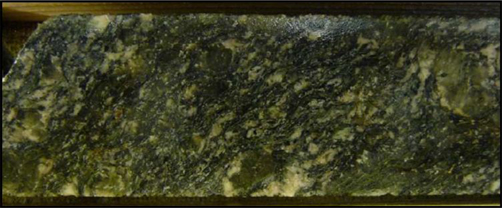
Figure 7-8: Foliated Kaxtorpite
| 7.4.1.2 | Migmatitic grennaite zone (GTM) |
Surrounds the kaxtorpite and as the name suggests has a somewhat migmatitic texture with some kink folding evident (see Figure 7-9) – possibly due to the structural features noted above. This zone is well mineralised – probably due to the presence of pegmatitic schlieren hosting eudialyte. The contact with the enclosing pegmatitic grennaite is not sharp and interpretation of this contact depends to an extent on the percentage pegmatitic schlieren.
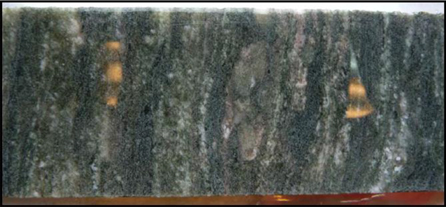
Figure 7-9: GTM - “Migmatitic” Grennaite Medium Grained
 |  |
| | Prefeasibility Study - NI 43-101 - Technical report for the Norra Kärr
Rare Earth Element Deposit - 0465-RPT-014 Rev 0 |
| 7.4.1.3 | Pegmatitic grennaite zone (PGT or GPG) |
While not pegmatite, there are visual elements that give this impression (see Figure 7-10). Notably the quantity and appearance of the eudialyte-bearing schlieren allow for this descriptive term to be used. The PGT zone is somewhat inhomogeneous and the various subdivisions (GT1, GT2, etc.) are quite justified. However, it is also fully justified to take the PGT zone as a single unit based on the criteria utilised by the Tasman technical team. The transition between the GTM and PGT domain is gradational. The eastern contact between the PGT and GTC domain is however often quite sharp.
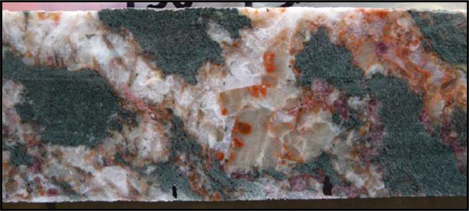
Figure 7-10: PGT-Pegmatitic Schlieren/Veining in Grennaite, with Elongated Crystals of Catapleiite and Crystals of Eudyalite
The pegmatitic schlieren and zones generally contain the same main minerals as the fine grained grennaite but in different proportions. There is also a large variation in mineral composition and grain size between different pegmatitic schlieren and zones within the complex. Most commonly, the zones are dominated by microcline-albite and nepheline though darker aegirine rich varieties locally have been observed.
The distribution of eudialyte and catapleiite are variable but geochemical analyses as well as visual observations suggest that both minerals are more abundant in the pegmatitic facies than elsewhere. The amount of eudialyte is seldom greater than ten volume percent though short intervals can be richer. Eudialyte occurs as rounded to subhedral up to 2 cm in size. Grains are quite variable in colour from relatively dark brown-red to over clear red to pale pink. In places the eudialyte is pink reddish, semi-translucent in bands, veins or patches.
| 7.4.1.4 | Catapleiite Porphyritic Grennaite (GTC) |
The catapleiite porphyritic variety of the grennaite occupies a large volume surrounding the PGT Zone. The colour varies between greyish green to light green or medium grey (as shown in Figure 7-11). The lighter variations are often found towards the granite contacts. The green colour arises from the presence of the sodium rich pyroxene aegerine in the groundmass.
 |  |
| | Prefeasibility Study - NI 43-101 - Technical report for the Norra Kärr
Rare Earth Element Deposit - 0465-RPT-014 Rev 0 |
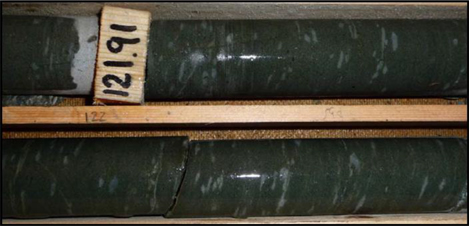
Figure 7-11: GTC-Fine Grained Grennaite with Bluish-White Elongated Catapleiite Crystals
While all the major rock units at Norra Kärr are REE-mineralised to a greater or lesser degree, it is clear from the work that Tasman has undertaken that the pegmatitic and migmatitic varieties of the grennaite are the main targets.
The mineralisation at Norra Kärr is at once both simple and complex. Simple in mineralogical terms in that nearly all the REE mineralisation is hosted in the complex zircono-silicate mineral eudialyte. There are minor amounts of the (probably) secondary Ca-LREE-F-silicate (britholite) and trace mosandrite. The eudialyte at Norra Kärr is, relatively rich in REE compared to most other similar deposits and also contains a very high proportion of HREO.
Various studies (e.g. Sjöqvistet al, 2013 (4)), have shown that within the resource, the TREO content of the eudialyte varies between 6 and 10 %. The percentage of HREO also varies from about 30 % in the more central GTM zone to above 70 % in more distal GTC zone. The total content and distribution of the REEs within the eudialyte also varies throughout the deposit. Sjöqvistet al (4) defined three compositional varieties of eudialyte group minerals at Norra Kärr:
| · | Fe-rich, REE-poor, classical pink eudialyte; |
| · | Fe-Mn-bisected, HREE-rich eudialyte from “pegmatitic” grennaite; and |
| · | Mn-rich, LREE-rich eudialyte from “migmatitic” grennaite. |
This study supports the field and analytical evidence that there are varying types of eudialyte which can, to an extent, be differentiated by colour with the more vibrant pink variety being poor in REOs and the duller, brownish-red varieties containing higher values of REOs.
The overall distribution of the REOs within the deposit is illustrated in Figure 7-12, Figure 7-13, and Figure 7-14.
 |  |
| | Prefeasibility Study - NI 43-101 - Technical report for the Norra Kärr
Rare Earth Element Deposit - 0465-RPT-014 Rev 0 |
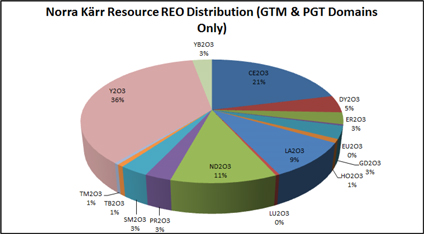
Figure 7-12: Norra Kärr REE Distribution
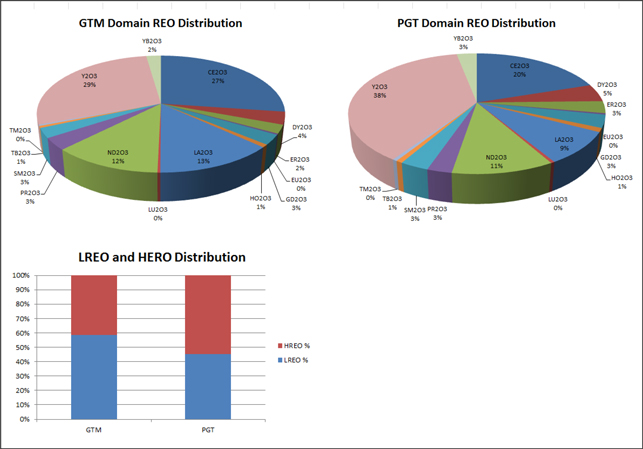
Figure 7-13: Norra Kärr REO Distribution by Major Ore Types
 |  |
| | Prefeasibility Study - NI 43-101 - Technical report for the Norra Kärr
Rare Earth Element Deposit - 0465-RPT-014 Rev 0 |
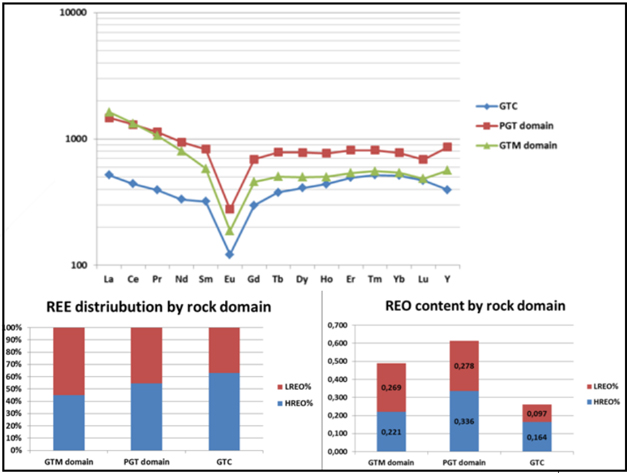
Figure 7-14: Norra Kärr REO Distribution by Rock Domain (Chondrite Normalised)
Equally, it may be shown that ~60 % of the zirconium is hosted by eudialyte with the remaining 40 % hosted by the catapleiite (Ca/Na2ZrSi3O9•2H2O).
Consequently, whilst the GTC domain contains LREO/HREO and in particular zirconium, the greater concentrations of LREO and HREO found in GTM and PGT domains, coupled with limited metalurgical testwork for the GTC domain makes the GTM and PGT the main economic targets at Norra Karr.
 |  |
| | Prefeasibility Study - NI 43-101 - Technical report for the Norra Kärr
Rare Earth Element Deposit - 0465-RPT-014 Rev 0 |
Section 8 Deposit Types
There are a number of different types of REE mineralisation that are of varying importance due to a number of factors – including some which are not geological. A key factor affecting the importance of REE is the strategic nature of the minerals and the current dominance in supply from Chinese REE.
Of the “primary” deposits, i.e.not including the highly important ion adsorption clay deposits of China, the British Geological Survey (BGS) has produced the classification shown in Table 8-1.
Table 8-1: Primary REE Deposit Types (14)
[Norra Kärr-type shown in grey]
| Deposit Type | Brief Description | *Number Documented | Typical Grades and Tonnage | Major Examples |
| Primary Deposits | | | | |
| Carbonatite-associated | Deposits associated with carbonate-rich igneous rocks associated with alkaline igneous provinces and zones of major faulting. | 107 | A few 10s thousands of tonnes to several hundred million tonnes, 0.1-10% REO e.g. Bayan Obo: 750 million tonnes at 4.1% REO. | Mountain Pass, USA; Bayan, Obo, China, Okorusu, Namibia, Amba Dongar, India; Barra do Itapirapua, Brazil; Iron Hill, USA. |
| Associated with alkaline igneous rocks | Deposits associated with igneous rocks characterized by abundant alkali mikerals and enrichment in HFSE. | 122 | Typically <100 million tonnes (Lovozero >1000 million tonnes), grade variable, typically <5% REO e.g. Thor Lake: 64.2 million tonnes at 1.96% REO. | Ilimaussaq, Greenland; Khibina and Lovozero, Russia; Thor Lake and Strange Lake, Canada; Weishan, China; Brockman, Australia, Pajarito Mountain, USA. |
| Iron-REE deposits (iron-oxide-copper-gold deposits) | Copper-gold deposits rich in iron oxide and diverse in character and form. | 4 | e.g. Olympic Dam: 2000 million tonnes at 0.3295% REO (Orris and Grauch, 2002) | Olympic Dam, Australia; PEA Ridge, USA. |
| Hydrothermal deposits (unrelated to alkaline igneous rocks) | Typically quartz, flourite, polymetallic veins and pegmatites of diverse origin. | 63(a) | Typically <1 million tonnes rarely up to 50 million tonnes, grade variable, typically 0.5 – 4.0%, rarely up to 12% REO e.g. Lemhi Pass: 39 million tonnes at 0.51% REO (Orris and Grauch 2002) | Karonge, Burundi; Naboomspruit and Steenkampskraal, South Africa; Lemhi Pass and Snowbird and Bear Lodge, USA; Hoidas Lake, Canada. |
 |  |
| | Prefeasibility Study - NI 43-101 - Technical report for the Norra Kärr
Rare Earth Element Deposit - 0465-RPT-014 Rev 0 |
The other critical factor in assessing REE mineralisation is the “split” between the light rare earth oxides (LREO) and the heavy rare earth oxides (HREO) within the overall grade of the total rare earth oxides (TREO). This is critical as many of the HREO are considerably scarcer and attract higher prices than the LREO. The split of LREO/HREO is shown in Figure 8-1. It will be noted that scandium and yttrium – whilst not part of the lanthanide group from which the other 15 REE metals occur – are included in the HREO category as they are often found together in ore deposits. At Norra Kärr the scandium content is very low and as such has not been assayed by the methods emplyed by Tasman, therefore scandium is excluded from the calculation of HREO.
The lighter REE are more incompatible – due to their larger ionic radius – and are consequently more strongly concentrated in the continental crust than the HREE. They are thus more commonly available, e.g. in monazite, a common mineral in heavy mineral sand deposits. However, monazite is also heavily enriched in thorium, a (radioactive) deleterious component.
The BGS also make the mineralogical distinction:
“The vast majority of resources are associated with just three minerals, bastnäsite, monazite and xenotime. In some REE minerals the LREE are particularly enriched relative to the HREE, whilst in others the opposite is the case. Bastnäsite and monasite are the primary source of the LREE, mainly Ce, La and Nd. Monazite has a different balance as it contains less La and more Nd and HREE. It is also significant to note that monazite contains the radioactive element thorium. Xenotime is dominated by the heavier REE including Y, Dy, Er, Yb and Ho (Harben, 2002)”
However, it is important to note that the mineralisation in the agpaitic syenite complexes (Figure 8-1) are often dominated by eudialyte group minerals which are particularly favourable for their HREO content. This is particularly the case at Norra Kärr.
 |  |
| | Prefeasibility Study - NI 43-101 - Technical report for the Norra Kärr
Rare Earth Element Deposit - 0465-RPT-014 Rev 0 |
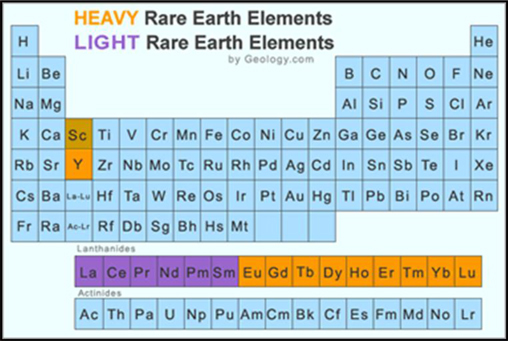
Figure 8-1: Periodic Table Showing LREO/HERO “Split”
Another important feature is the “criticality” matrix. This is based on thecurrently perceived availability both now and in the foreseeable future.
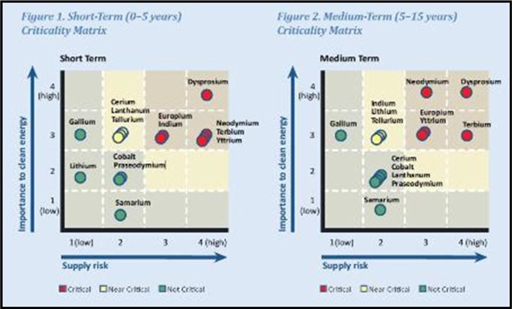
Figure 8-2: REE Criticality Matrices (14)
From Figure 8-2 it is clear that the HREO are the currently preferred target for exploration companies.
 |  |
| | Prefeasibility Study - NI 43-101 - Technical report for the Norra Kärr
Rare Earth Element Deposit - 0465-RPT-014 Rev 0 |
There are a very large number of REE minerals which further complicate the exploration/evaluation process when considering the economics of REE deposits. A selection of “common” REE-bearing minerals is shown in Figure 8-3.
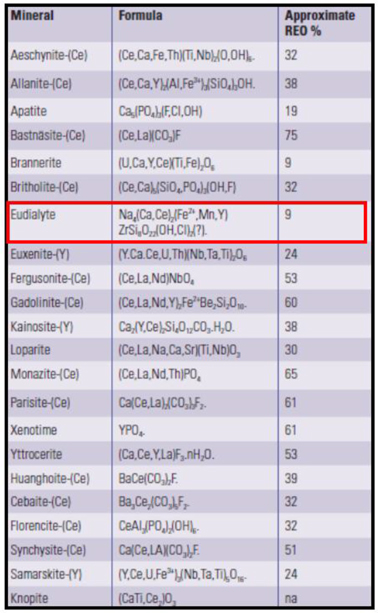
Figure 8-3: Selection of REE-bearing Mineral (14)
[Main ore mineral at Norra Kärr outlined in red]
| 8.2 | REE Deposits – Discussion |
There are a number of more or less welll known REE deposits including the better known Llimaussaq deposit in Greenland and the Lovozero deposit on the Kola Peninsula, Russia.
 |  |
| | Prefeasibility Study - NI 43-101 - Technical report for the Norra Kärr
Rare Earth Element Deposit - 0465-RPT-014 Rev 0 |
Ilimaussaq is the type locality for the agpaitic nepheline syenite deposits as well as several mineral species, including eudialyte, and has been extensively described in the literature – partly due to its excellent exposures in a glacially smoothed environment. It consists of a large, at least pseudo-layered, intrusion of a variety of rock types. Of particular significance with respect to the REO are the kakortotites which consist of a layered sequence at the base of the complex, it consists of separate layers of feldspar (white), arfvedsonite (black) and eudialyte (red). There are over 29 such horizons known over the outcropping thickness of approximately 400 m. This forms the main bulk of the REO mineralisation at llimaussaq. However, the ratio HREO/TREO is only about 0.15 lowering the value of the deposit, by contrast the Tanbreez deposit has a ratio cloaser to 0.3.
The Lovezero Complex (together with the related Khibina Complex) on the Khola Peninsula of Russia form the largest agpaitic massif in the world. The Lozovero Complex totals some 650 km² and has the following characteristics (15):
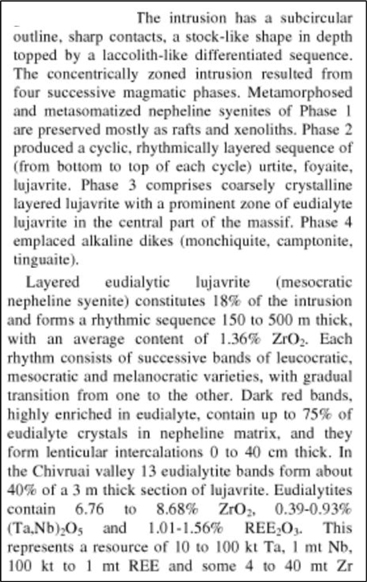
 |  |
| | Prefeasibility Study - NI 43-101 - Technical report for the Norra Kärr
Rare Earth Element Deposit - 0465-RPT-014 Rev 0 |
Both the Ilimaussaq and the Lozovero are interpreted as having had (originally, at least) a lopolithic or laccolithic shape (Figure 8-4) and it is hypothesised that this is possibly the case at Norra Kärr.
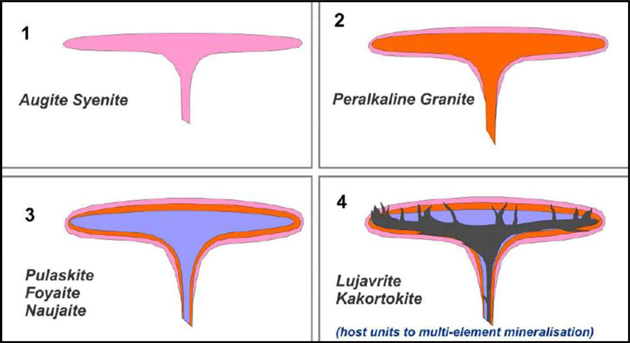
Figure 8-4: Possible Mode of Formation of the IIimaussaq Intrusion
 |  |
| | Prefeasibility Study - NI 43-101 - Technical report for the Norra Kärr
Rare Earth Element Deposit - 0465-RPT-014 Rev 0 |
Section 9 Exploration
Tasman initiated their exploration of Norra Kärr by investigating Boliden’s historical work noted in Section 6 above. The Boliden trench samples were archived at the Swedish Geological Survey and were made available to Tasman. Tasman was able to select and assay rocks that were representative of various lithological units along the two trenches that were excavated (see Section 6) and sampled by Boliden. While the samples were only grab samples meant to be representative of each of the lithotypes sampled by Boliden, they served to give a very good indication of the REO potential of the Norra Kärr intrusive complex. With the Boliden results for the trench composites available a comparison showed that there was considerable potential for a significant REO deposit. This is shown in Table 9-1.
Table 9-1: Comparison of Tasman Grab Samples vs Boliden Composite Trench Samples
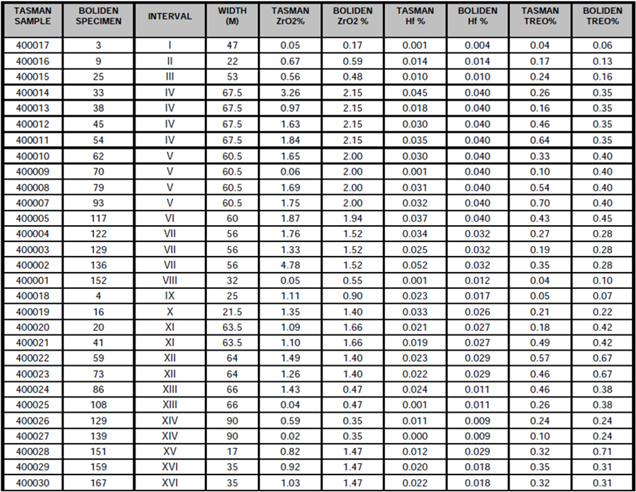
 |  |
| | Prefeasibility Study - NI 43-101 - Technical report for the Norra Kärr
Rare Earth Element Deposit - 0465-RPT-014 Rev 0 |
In 2009, Tasman also submitted five rock specimens for petrographic analysis. The findings supported the observations made by all previous workers at Norra Kärr in that as a whole, the rocks could be classified as peralkaline nepheline syenites. Small amounts of eudialyte, catapleiite or rosenbuschite, fluorite and apatite were also noted. Foliation, defined by aligned mineral grains, is attributed to either regional deformation or as a primary magmatic flow texture (Ashley, 2009 (10)).
“Also in 2009 Tasman contracted Mr John Nebocat of Pacific Geological Services to prepare an NI43-101 technical report. This report summarised the pre-drilling history of the property, recommended further exploration, and encouraged Tasman to continue advancement of the Project.”
(PAH NI43-101 Report 2011 (3))
In keeping with the recommendations of Mr Nebocat, Tasman initiated drilling of the Norra Kärr project during winter 2009 continuing until spring 2010. Tasman drilled 26 diamond drill holes totalling 3 275.74 m in five east-west orientated profiles across the Norra Kärr intrusion.
Various techniques have been applied when considering the geological mapping of the Norra Kärr igneous body. These include:
| · | Topographic mapping (including orthophotography and a laser survey); |
| · | Geological mapping (including structural mapping); and |
Various topographic maps of the area are readily available:
| · | Standard Swedish survey maps - at various scales, e.g. 1:50 000 sheet 56375 DinKarta (Figure 9-1); |
| · | Orthophotography (Figure 9-2); |
| · | DEM – Figure 9-3 shows a colour-enhance DEM of the Norra Kärr intrusive. It is interesting to note that it occupies a topographic low to a large extent; and |
| · | 1 metre contours – a topographic map with 1 m contours has also been produced by Tasman – this will be of considerable use going forward (see Figure 9-4). |
Note: On these figures the Norra Kärr licence is the red outline, the Norra Kärr intrusive is the black outline and WAI’s visit trajectory is shown in red.
 |  |
| | Prefeasibility Study - NI 43-101 - Technical report for the Norra Kärr
Rare Earth Element Deposit - 0465-RPT-014 Rev 0 |
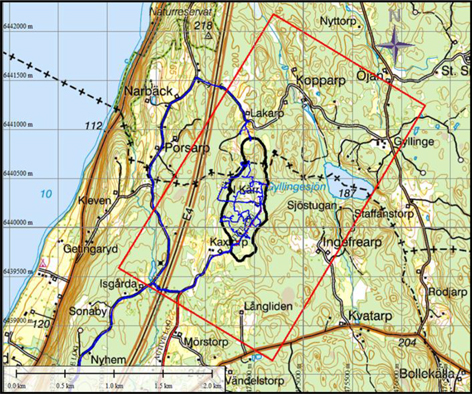
Figure 9-1: Swedish Survey 1:50 000 Topographic Sheet (56375 DinKarta)
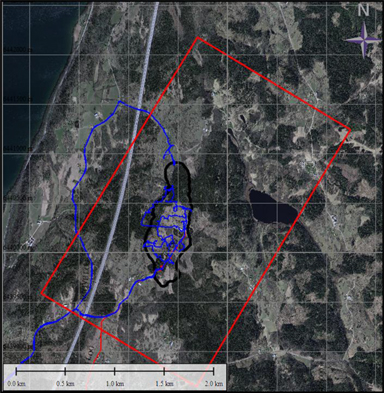
Figure 9-2: Orthophoto of the Norra Kärr Licence
 |  |
| | Prefeasibility Study - NI 43-101 - Technical report for the Norra Kärr
Rare Earth Element Deposit - 0465-RPT-014 Rev 0 |
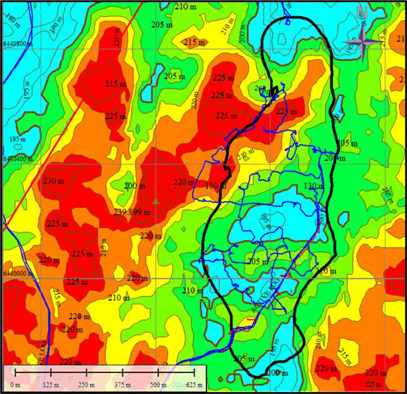
Figure 9-3: Colour Coded DEM of Norra Kärr
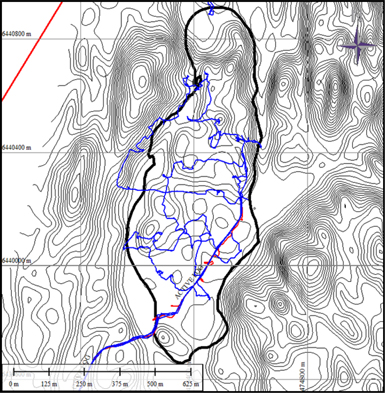
Figure 9-4: Contour Plan of Norra Kärr at 1 m Intervals
 |  |
| | Prefeasibility Study - NI 43-101 - Technical report for the Norra Kärr Rare Earth Element Deposit - 0465-RPT-014 Rev 0 |
The geological mapping of the Norra Kärr complex has been an iterative process as many elements of the work have been utilised to produce the current geological map which is almost certainly reasonably definitive. It incorporates:
| · | Surface geological mapping; |
| · | Detailed structural mapping; and |
| · | Projection of the drill holes to surface which has confirmed the geology. |
| 9.3.1 | Surface Geological Mapping |
While there is not a large amount of outcrop, there is sufficient to be able to produce an outcrop map which confirms the lithotypes - better identified in drill core - and certainly to confirm the overall lithostructure of the intrusive. Figure 9-5 shows the approximate outline of the Norra Kärr complex with the surface, geological “observation” points showing the dip and strike and the Tasman coding of the outcrops. It is apparent that there is some considerable outcrop in the north of the intrusive but it is somewhat sparser in the south where it is relatively marshy – as indicated by the topography.
The structure of the Norra Kärr complex is well indicated by the dip and strike observations with the overall westerly dip being apparent. This is better shown in the geological sections which are included in Section 9.3.3 below.
The trajectory of WAI’s field inspection(s) is also shown on Figure 9-5 and it may be seen that a considerable number of the outcrops were visited and the Tasman mapping confirmed. Several of the outcrops were also the loci of the Boliden test pits (believed to be bulk sample sites) from the 1970s. These are also indicated on Figure 9-5.
These observations immediately give a very reasonable impression of the geology of the Norra Kärr intrusion and the layering/zonation of the complex. This is further enhanced by the other techniques that Tasman has applied.
 |  |
| | Prefeasibility Study - NI 43-101 - Technical report for the Norra Kärr Rare Earth Element Deposit - 0465-RPT-014 Rev 0 |
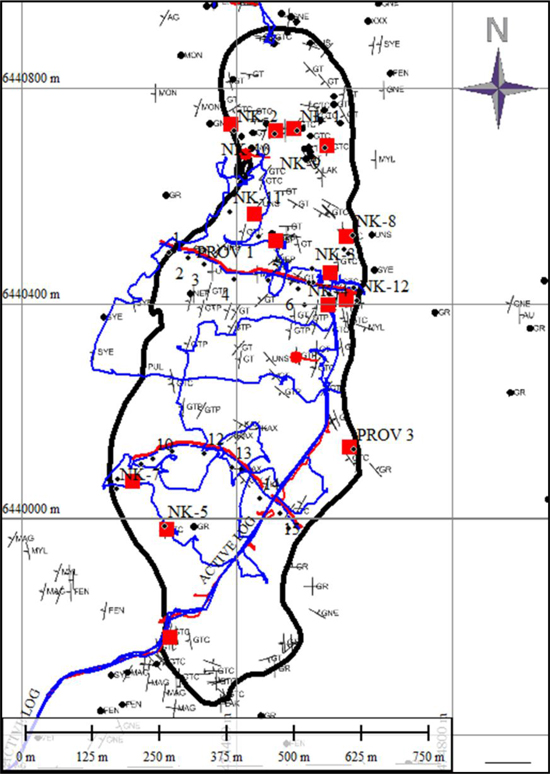
Figure 9-5: Geological Plan Showing Observation Points and the Old Boliden Pits
Black = outline of Norra Kärr Complex.
Blue = trajectory of WAI visit.
Litho-coding and dip & strike shown at outcrop points.
Red = Boliden pits/trenches
 |  |
| | Prefeasibility Study - NI 43-101 - Technical report for the Norra Kärr Rare Earth Element Deposit - 0465-RPT-014 Rev 0 |
While the ground magnetometry has been the most useful tool in elucidating the tectonics that have affected Norra Kärr, the regional airborne data has also been applied. This has allowed for a better understanding of the overall tectonic setting that was discussed in Section 7.4.
The ground magnetometry was discussed and illustrated in Section 7.4 which highlighted the interpretation of the structural geology. In terms of lithotypes, one other point to note is that the relatively mafic (and barren of mineralisation) kaxtorpite forming the (offset) centre of the complex shows up very well as a positive magnetic feature – as is to be expected (see Figure 7-5).
| 9.3.3 | Detailed Structural Mapping |
Tasman commissioned an experienced structural geologist to undertake a study of the intrusive and its surrounds (Rankin, 2011 (8)) which was discussed in Section 7.4. Rankin concluded that:
“Emplacement and distribution of REE mineralisation is dominantly controlled by early pegmatite (comagmatic?), with some pre- to syn-D1 partial melt remobilisation possible.
The intrusive was emplaced along a regional, structurally-anomalous N- to NNE- trending fault/shear corridor within a Palaeoproterozoic granite/gneiss terrane dominated by a strong WNW- to NEW-trending structural grain. The emplacement locus may be coincident with an intersecting deep-crustal WNW-trending fault corridor.”
WAI broadly agrees with these statements with some relatively minor differences concerning the overall tectonics (see Section 7.4 particularly).
In total 119 drill holes have been drilled and this has been the main tool in elucidating the geology of Norra Kärr as well as providing an excellent database for the estimation of a Mineral Resource (Section 14).
Nearly all the holes are angle holes drilled in an easterly direction at 50° to allow for the overall structure of the intrusion as illustrated in Figure 9-6. The drill hole positions are shown as blue dots and the traces as the black lines.
 |  |
| | Prefeasibility Study - NI 43-101 - Technical report for the Norra Kärr Rare Earth Element Deposit - 0465-RPT-014 Rev 0 |
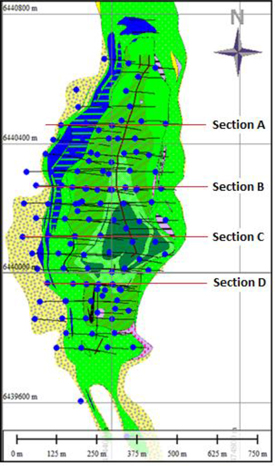

Figure 9-6 Geological Map of the Norra Kärr Intrusive Showing Drill Hole Traces
 |  |
| | Prefeasibility Study - NI 43-101 - Technical report for the Norra Kärr Rare Earth Element Deposit - 0465-RPT-014 Rev 0 |
The Norra Kärr intrusive is a keel-shaped, synformal body, possibly a folded lopolithic intrusion, more or less layered and subsequently deformed. The geological interpretation is presented as a geological map (Figure 9-6) and as various sections across the intrusive (Section A
to Figure 9-14). This interpretation holds together well when rigorously interrogated and thus forms a robust model for the resource calculations and mine planning which are presented in later Sections of this document.
There are various observations from the geological map and sections that are worth noting as they both strongly confirm the geological interpretation and the quality of the drilling database:
| · | Axial plane mafic dyke – this dyke is a consistent feature both in (limited) outcrop and in many of the drill holes and appears to have been intruded (prior to or more probably during the major deformation episode) in the axial plane of the intrusive. It forms a good “marker horizon” and also shows up the strong deformation towards the southern end of the complex (previously noted) where it is strongly folded and somewhat broken up – probably by the late rotational (dextral) shearing. |
| · | “Foliation” – this feature has been noted previously (see Section 9.3.1 and Figure 9-5, Figure 9-8) and is clearly demonstrated on several “levels”, i.e. plan slices through the intrusive constructed from the sections. Two illustrations of this are given as Figure 9-8 and Figure 9-7. |
| · | Zonation – the obvious zonation of the differing grennaite types is clear. This aids considerably in the economic assessment of the REO mineralisation of Norra Kärr. |
| · | Drilling density – the drilling density (±40 metres) allows for the construction of quite accurate geological sections and consequently, an accurate map both surface and sub-surface. |
All of these features are well noted and described in the Tasman work as well as verified by WAI (Section 7).
 |  |
| | Prefeasibility Study - NI 43-101 - Technical report for the Norra Kärr Rare Earth Element Deposit - 0465-RPT-014 Rev 0 |
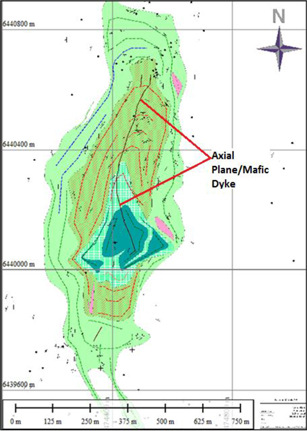
Figure 9-7: Geological Plan of Norra Kärr Showing Foliation Trends
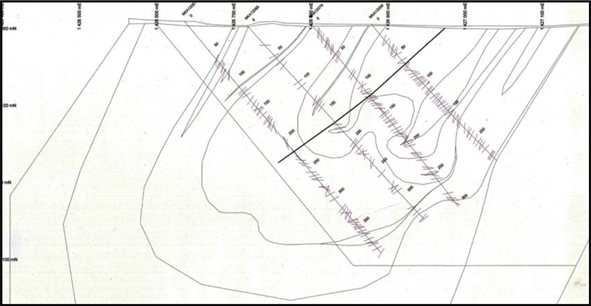
Figure 9-8: “Typical” Geological Section of Norra Kärr Showing Foliation Trends
 |  |
| | Prefeasibility Study - NI 43-101 - Technical report for the Norra Kärr Rare Earth Element Deposit - 0465-RPT-014 Rev 0 |
Obviously, as a consequence of the drilling and to provide the data necessary to inform the resource calculations, geological sections have been constructed and a selection of these are presented as Section A
to Figure 9-14.
The geology of the representative sections presented here (and others) was confirmed during the site visit with the WAI geologist inspecting the core and accompanying the logging with the Tasman geologists. As well as the sections, the detailed logs, the strip logs and the core photography created by the Tasman staff also provide valuable tools.
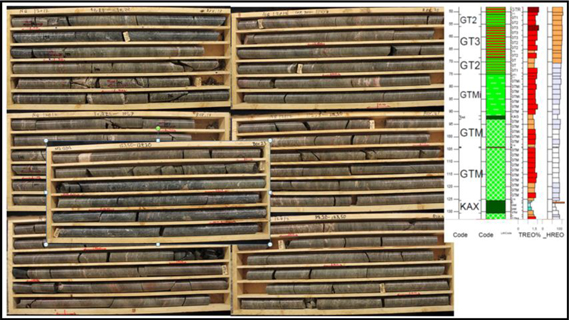
Figure 9-9: Core Photography and Corresponding Strip Log
The strip logs also include the assay values. The example shown in Figure 9-9 the TREO and the HREO. The full strip logs show all the REO assays by individual element.
 |  |
| | Prefeasibility Study - NI 43-101 - Technical report for the Norra Kärr Rare Earth Element Deposit - 0465-RPT-014 Rev 0 |
Table 9-2: Example of Detailed Drill Hole Log (Hole NKA10014)
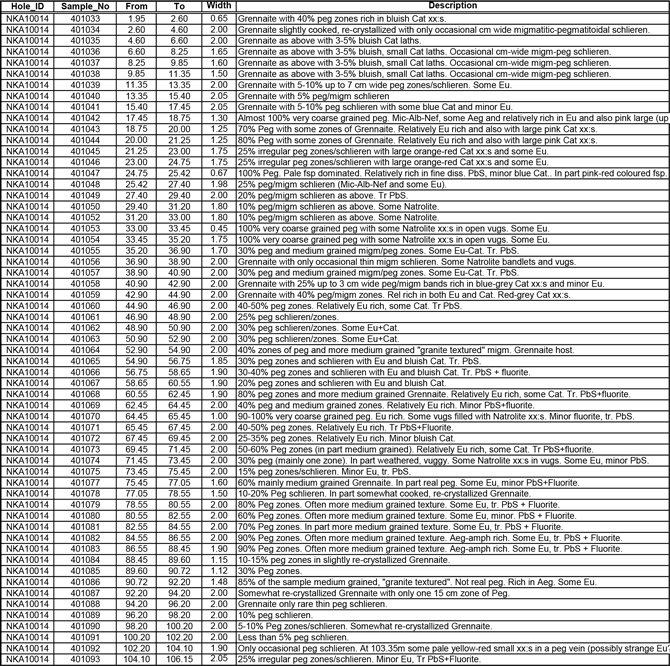
All of the features mentioned in the descriptions above have been checked and WAI is satisfied that the Tasman staff exercised considerable diligence in their logging and that the sections produced – see below – are both accurate and well recorded.
The complete suite of geological sections were utilised in producing the 3D geological wireframes and the Mineral Resource estimate presented in Section 14 below.
The Legend for the geological sections is also reproduced here as Figure 9-10.
 |  |
| | Prefeasibility Study - NI 43-101 - Technical report for the Norra Kärr Rare Earth Element Deposit - 0465-RPT-014 Rev 0 |
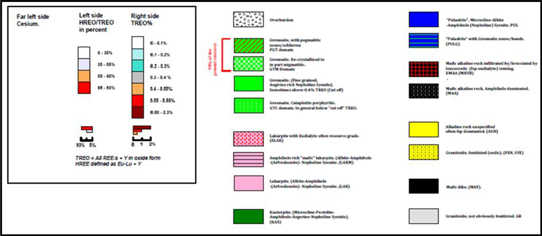
Figure 9-10: Legend for Geological Sections (Section A
- Section D)
Section A has been constructed from six drill holes drilled at the “standard” angle of ~50°. Careful logging has enabled the discrimination of the main lithotypes across the 400 metres of the section line and this is clearly seen on the section together with the TREO values and the percentage HREO. The individual REO values are included in the database and on the strip logs (illustrated above – see Figure 9-9 for an example).
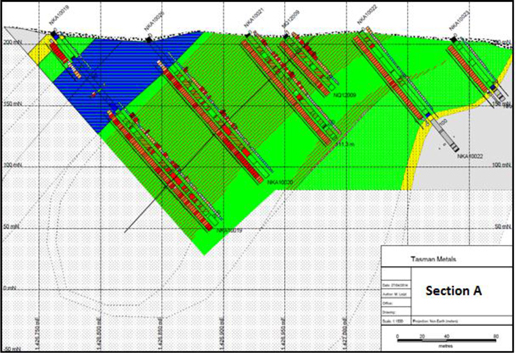
Figure 9-11: Section A, Geological Cross Section
 |  |
| | Prefeasibility Study - NI 43-101 - Technical report for the Norra Kärr Rare Earth Element Deposit - 0465-RPT-014 Rev 0 |
Section B has been constructed from 12 drill holes drilled at the “standard” angle of ~50°. Again the lithotypes are clear to see – this includes the axial plane mafic dyke on this section together with the first indications of the kaxtorpite “core” of the intrusive. The main ore types – the PGT and GTM domains – are also clearly evident flanked by the GTC grennaite. During the site visit, these domains were clearly differentiated and confirmed by WAI.
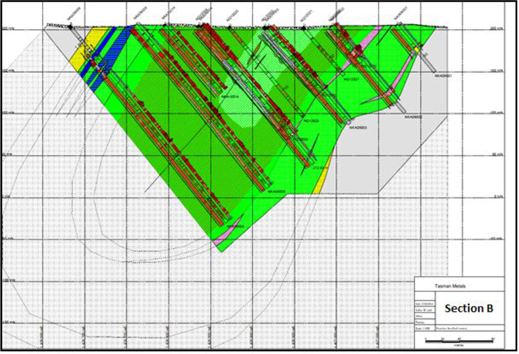
Figure 9-12: Section B, Geological Cross Section
Section C has been constructed from six drill holes drilled at the “standard” angle of ~50°. On this section to the south of Section B, the kaxtorpite has developed further and clearly forms the core of the intrusive complex. The axial plane mafic dyke is clearly seen together with the two main ore domains. The Växjö Granite “host” rocks are also evident flanking the Norra Kärr alkaline body showing a degree of the fenitisation which was the subject of an academic work previously referenced (Christensson, 2013 (7)).
 |  |
| | Prefeasibility Study - NI 43-101 - Technical report for the Norra Kärr Rare Earth Element Deposit - 0465-RPT-014 Rev 0 |
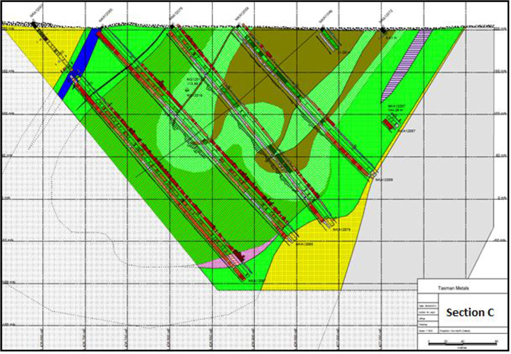
Figure 9-13: Section C, Geological Cross Section
Section D has been constructed from nine drill holes drilled at the “standard” angle of ~50°. At the southern end of the Norra Kärr body, the kaxtorpite core pinches out and this is well shown on this section. The GTM domain here forms two “tongues” included in the massive PGT domain. The high values in the PGT are clearly shown. At the base of the section in drill holes NKA11038 and NKA11033 a tongue of the ELAK domain is to be seen. This is the eudialyte-bearing lakarpite previously described.
 |  |
| | Prefeasibility Study - NI 43-101 - Technical report for the Norra Kärr Rare Earth Element Deposit - 0465-RPT-014 Rev 0 |
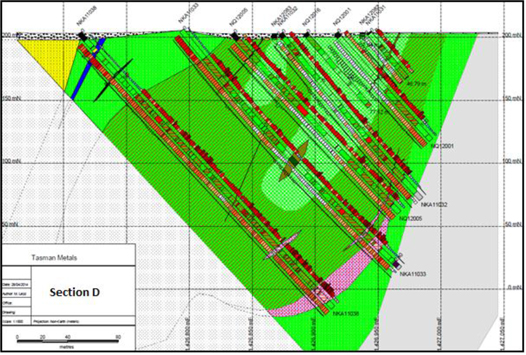
Figure 9-14: Section D, Geological Cross Section
| 9.3.4 | Surface Exploration Summary |
Study of all the available data clearly shows the relatively simple structure and zonation of the Norra Kärr intrusive. The elongated, ovoid shape is well defined by the magnetometry, the surface mapping and the drill sections. The foliation indicates that the intrusive body may well “close off” at depth forming a synformal structure but this is not yet certain. A deep drill hole to test this was proposed by Rankin (2011) (8) but this is considered by WAI as a “nice to know” at this stage as it has no impact on the initial 20 year mine life.
 |  |
| | Prefeasibility Study - NI 43-101 - Technical report for the Norra Kärr Rare Earth Element Deposit - 0465-RPT-014 Rev 0 |
Tasman commenced drilling in December 2009 and as of the end of 2012 had completed a total of 124 holes totalling 21,171m, of which 5 holes were geotechnical totalling 751m. Drilling has been carried out on east-west section lines with drilling inclined to the east at approximately 50°. Section lines are spaced approximately 50 m apart with drill holes spaced along the sections lines at 60-80 m. Hole depths range from 30.5 m to 395.59 m with an average depth of 172 m.
All drilling has been carried out using diamond core drilling, in total three drilling contractors have been used as summarised in Table 10-1. The initial phase of drilling comprising 11 drill holes in 2009-2010 was conducted by North Scandinavian Drilling (NSD) who used a Diamec U6 (Atlas Copco) drill rig producing a core diameter of 42 mm (BGM). In February 2010 after NSD had drilled 11 holes drilling was taken over by Geo-Grupen AB based in Göteborg who drilled 76 holes between February 2010 and May 2012 producing core with a diameter of 40.7 mm (BQ-TK).
The most recent drilling contractor employed is Olstam Borrteknik AB (Olstam BT) using Sandvik drill rigs the company drilled 32 holes in 2012 with nine of the holes yielding 39 mm (WL56) core diameter and 23 holes producing larger diameter 50.7 mm (NQ2) diameter core.
Table 10-1: Summary of Tasman Exploration Drilling Activity
| Drill Operator | | No. Holes | | | Total Length
(m) | | | Core Diameter | | Drill Period | | Orientated
Core |
| NSD | | 11 | | | 1 792.58 | | | BGM | | 2009-Jan 2010 | | Only for 3 Holes |
| Geo-Grupen | | 76 | | | 13 418.73 | | | BQ-TK | | Feb 2010-2012 | | 47 holes |
| Olstam BT | | 32 | | | 5 209.02 | | | WL56 (9 holes);
NQ2 (23 holes) | | 2012 | | 4 Holes |
| Total | | 119 | | | 20 420.33 | | | - | | - | | 54 |
| | | | | | | | | | | | | | | |
As part of the drilling and core logging works Tasman has recorded core recovery based on length drilled versus the length recovered. The Tasman drill hole database provided to WAI contains recovery details for 104 drill holes and comprises 11 295 core recovery records ranging from zero for 6 intervals through to >90% recovery for 99 % of the sample database, core recovery averages 99.7 %.
The geological database provided to WAI also recorded Rock Quality Designation (RQD) for 103 drill holes and comprised 11 274 records with an average RQD of 86 %.
 |  |
| | Prefeasibility Study - NI 43-101 - Technical report for the Norra Kärr Rare Earth Element Deposit - 0465-RPT-014 Rev 0 |
As part of the WAI May 2014 site visit drill core was visually reviewed and demonstrated excellent recovery. Overall WAI is of the opinion that the Norra Kärr mineralisation is highly competent and that no material losses of core have occurred. Further the high level of recovery and the assay results obtained preclude any preferential bias due to core loss.
Drill hole locations are initially laid out using a GPS based on the Tasman geologists exploration plan. A final pick up of the drill hole collar co-ordinates is carried out post drilling by Metria AB, an independent Swedish land survey company. The collar surveys are carried out using a Differential Global Positioning System with an accuracy of 0.01 m in the horizontal and 0.2 m in the vertical.
Downhole surveys have been carried out for all drill holes using one of two different downhole survey instruments:
The DeviTool™ PeeWee is a downhole multishot magnetic survey instrument with an azimuth accuracy of ±0.5° and an inclination accuracy of ±0.1°. This particular downhole instrument was used for the initial phase of drill holes between 2009 and 2011.
In the later part of the exploration programme in 2001 and 2012 a Reflex EZ-Trac multishot magnetic downhole instrument was used with an azimuth accuracy of ±0.35° and an inclination accuracy of ±0.25°.
Overall WAI is of the opinion that the survey works carried out by Tasman are robust and accurate.
| 10.1.3 | Core Logging, Sampling and Storage |
Tasman has taken a diligent approach to the core logging resulting in a detailed geological database containing driller information, survey data, detailed geological descriptions including lithological codes and geotechnical data comprising RQD results and foliation orientations.
With the considerable drill programme carried out by Tasman, there was a need to streamline the drill core preparation and sample handling capability over that which was initially instituted (see PAH NI43-101, 2011 (3)). Consequently, Tasman has installed what might be termed a “state of the art” facility in the nearby Town of Gränna.
A large warehouse (with a nearby office) was rented and drill core storage and preparation facilities installed. The logging tables are almost the complete length of the warehouse and, as a consequence, all but the longest drill holes can be laid out in consecutive order thereby eliminating the need to constantly be shuffling core trays around to obtain an integrated picture of any particular drill hole (Figure 10-1). A hand operated fork lift assists in the moving of core trays.
 |  |
| | Prefeasibility Study - NI 43-101 - Technical report for the Norra Kärr Rare Earth Element Deposit - 0465-RPT-014 Rev 0 |
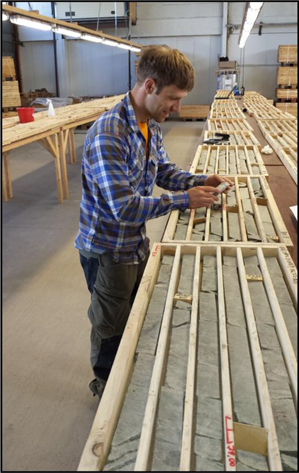
Figure 10-1: Core Logging Facility
WAI was able to verify the quality of geological and sampling information. The underlying data supporting the Mineral Resource estimate are considered by the authors to be generated and inputted into the corresponding resource model in a satisfactory manner.
 |  |
| | Prefeasibility Study - NI 43-101 - Technical report for the Norra Kärr Rare Earth Element Deposit - 0465-RPT-014 Rev 0 |
| Section 11 | Sample Preparation, Analyses, and Security |
At the Tasman core facility in Gränna there is a “built in” core sawing shack which has an automated core saw to ensure accurate splitting of the core. The core was cut taking into consideration the main foliation/banding of the rock. When it was possible to reassemble the core, the same half of the core was submitted for assay. One half of the core was placed in a numbered plastic bag together with the corresponding sample ticket and the other half was left in the core tray.
Prior to the establishment of the Tasman facility at Gränna, core was cut at the SGU facilities in Malå by Tasman perssonel. To speed up the core cutting process a limited amount of core was also sent to the ALS sample preperation facility at Öjebyn in 2011. Details of the sample intervals were provided by Tasman to the contractor ensuing that lithological boundaries were honoured. The core was then cut perpendicular to the foliation and banding of the rock using a diamond saw. The half cores for assay were placed into plastic bags with a sample ticket recording the individual sample numbers. Retained half core was returned to the core trays and stored at the SGU archive in Malå.
Samples have been prepared at the ALS Chemex facility at Piteå in northern Sweden. ALS Chemex is an ISO accredited (ISO/IEC 17025) laboratory and the sample preparation facility is part of the main ALS laboratory set up.
Samples arriving at the ALS Chemex facility in Piteå are initially checked against the corresponding sample submission documents submitted by Tasman’s geological staff. Samples are then dried and weighed and recorded on the ALS Chemex database. Samples are dried at 110-120°C and then crushed with either an oscillating jaw crusher or a roll crusher.
The crushed sample, typically 250 g to 1 kg, is sub-sampled by use of a riffle splitter. A 250 g sub-sample is taken for further pulverising whilst the remaining crushed material is bagged up and returned to Tasman. The 250 g sub-sample is then pulverized using a ring mill till >85 % passes 75 µm (200 mesh screen).
For assay a sub-sample of the pulverised material of approximately 10-15 g is taken and shipped to the ALS Chemex assay laboratory in Vancouver, Canada for analysis. The remainder of the crush reject and pulp are stored at ALS Chemex in Piteå prior to being returned to Tasman.
Figure 11-1 shows the ALS Chemex facility in Piteå.
 |  |
| | Prefeasibility Study - NI 43-101 - Technical report for the Norra Kärr Rare Earth Element Deposit - 0465-RPT-014 Rev 0 |
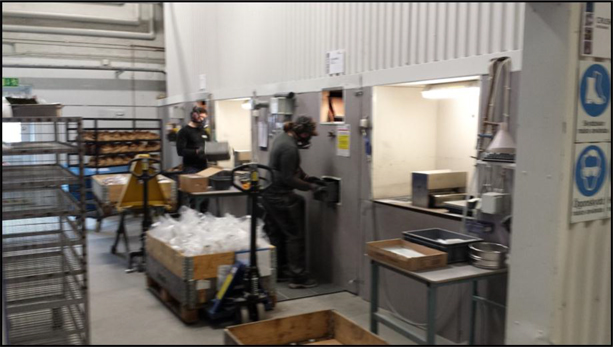
Figure 11-1: ALS Chemex Sample Preparation Facility Piteå
Tasman has submitted all samples for assay at the ALS Chemex laboratory in Vancouver, Canada. ALS Chemex has analysed the samples using the analytical method ME-MS81, an inductively coupled plasma (ICP) mass spectrometry technique. In instances where samples returned assays with zirconium grades >10 000 ppm then samples were also analysed using the ME-XRF10 method.
The analytical specification used by ALS Chemex for the ME-MS81 method is:
“A prepared sample (0.200g) is added to lithium metaborate flux (0.90g), mixed well and fused in a furnace at 1000°C. The resulting melt is then cooled and dissolved in 100mL of 4% HNO3 / 2% HCl solution. This solution is then analysed by inductively coupled plasma (ICP) mass spectrometry.”
Details of the detection limits for analytical method ME-MS81 are provided in Table 11-1 below:
 |  |
| | Prefeasibility Study - NI 43-101 - Technical report for the Norra KärrRare
Earth Element Deposit - 0465-RPT-014 Rev 0 |
Table 11-1: ALS Chemex ME-MS81 Detection Limits
| | Detection Range
(ppm) | | | | Detection Range
(ppm) | | | | Detection Range (ppm)
Total Length (m) | | | | Detection Range (ppm) |
| Element | | Min | | Max | | Element | | Min | | Max | | Element | | Min | | Max | | Element
BGM | | Min | | Max |
| Ag | | 1 | | 1 000 | | Ga | | 0.1 | | 1 000 | | Pb | | 5 | | 10 000 | | Tm | | 0.01 | | 1 000 |
| Ba | | 0.5 | | 10 000 | | Gd | | 0.05 | | 1 000 | | Pr | | 0.03 | | 1 000 | | U | | 0.05 | | 1 000 |
| Ce | | 0.5 | | 10 000 | | Hf | | 0.2 | | 10 000 | | Rb | | 0.2 | | 10 000 | | V | | 5 | | 10 000 |
| Co | | 0.5 | | 10 000 | | Ho | | 0.01 | | 1 000 | | Sm | | 0.03 | | 1 000 | | W | | 1 | | 10 000 |
| Cr | | 10 | | 10 000 | | La | | 0.5 | | 10 000 | | Sn | | 1 | | 10 000 | | Y | | 0.5 | | 10 000 |
| Cs | | 0.01 | | 10 000 | | Lu | | 0.01 | | 1 000 | | Sr | | 0.1 | | 10 000 | | Yb | | 0.03 | | 1 000 |
| Cu | | 5 | | 10 000 | | Mo | | 2 | | 10 000 | | Ta | | 0.1 | | 10 000 | | Zn | | 5 | | 10 000 |
| Dy | | 0.05 | | 1 000 | | Nb | | 0.2 | | 10 000 | | Tb | | 0.01 | | 1 000 | | Zr | | 2 | | 10 000 |
| Er | | 0.03 | | 1 000 | | Nd | | 0.1 | | 10 000 | | Th | | 0.05 | | 1 000 | | | | | | |
| Eu | | 0.03 | | 1 000 | | Ni | | 5 | | 10 000 | | TI | | 0.5 | | 1 000 | | | | | | |
 |  |
| | Prefeasibility Study - NI 43-101 - Technical report for the Norra Kärr Rare
Earth Element Deposit - 0465-RPT-014 Rev 0 |
WAI is fully satisfied that the analyses have been carried out to the highest standards and that the results may be used in a preparing a Mineral Resource in accordance with the CIM Definition Standards for Mineral Resources and Mineral Reserves.
As part of the Tasman exploration works a Quality Assurance/Quality Control (QA/QC) programme has been implemented to provide support and credence to the sample assay data. The QA/QC programme has been applied to the drill core samples and comprises the submission of field duplicates, laboratory duplicates, external lab duplicates, blanks and certified reference materials (CRMs) including submission of CRMs to externals labs (ACME 2010-2011 and ACTLABS 2012).. QA/QC samples use the same numbering sequence as standard samples; so as to ensure the samples are submitted blind to the laboratory and that no specialist treatment of the samples is carried out.
WAI was provided with the results of the field duplicates, laboratory duplicates, external laboratory duplicates, blanks and CRMs in Excel format.
A total of 426 field duplicate results have been provided to WAI. The field duplicate samples were quarter core which was submitted to the sample preparation facility prior to being sent to the laboratory. In sending quarter core field duplicates the results allow Tasman to ascertain the potential sum analytical, sub sampling and sampling error. Any issues associated with the representivity of the sampling methods, errors occurring due to the sample preparation methods or problems relating to analytical precision will most likely show up in the field duplicate results.
If an error is identified then further QA/QC procedures such as the use of crushed and pulverised duplicates, blanks and CRMs are required to better delineate the source of the error.
Figure 11-2, Figure 11-3 and Figure 11-4 show the field duplicate results for Dy, Y and Nd respectively. As can be seen these show an excellent level of repeatability and therefore precision. High levels of precision was also exhibited for the other REEs.
Prefeasibility Study - NI 43-101 - Technical report for the Norra Kärr Rare Earth Element Deposit - 0465-RPT-014 Rev 0
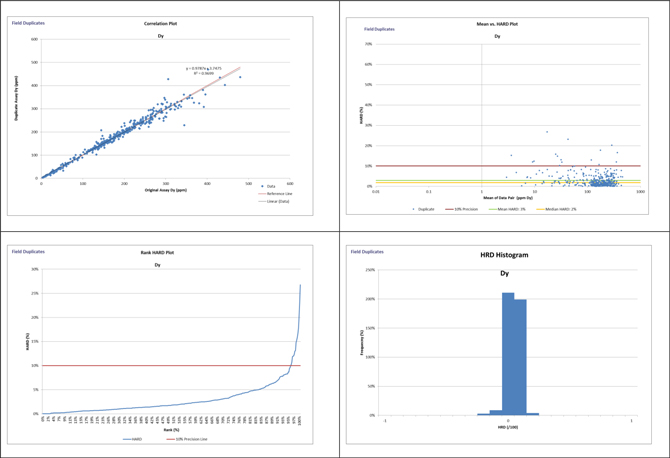
Figure 11-2: Dy Field Duplicate QA/QC Results
Prefeasibility Study - NI 43-101 - Technical report for the Norra Kärr Rare Earth Element Deposit - 0465-RPT-014 Rev 0
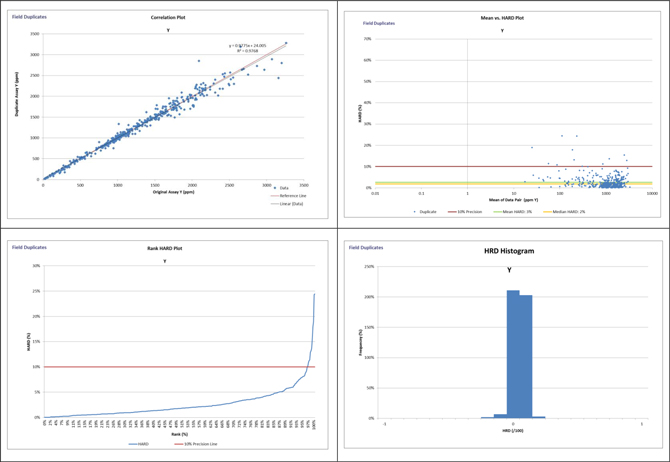
Figure 11-3: Y Field Duplicate QA/QC Results
Prefeasibility Study - NI 43-101 - Technical report for the Norra Kärr Rare Earth Element Deposit - 0465-RPT-014 Rev 0
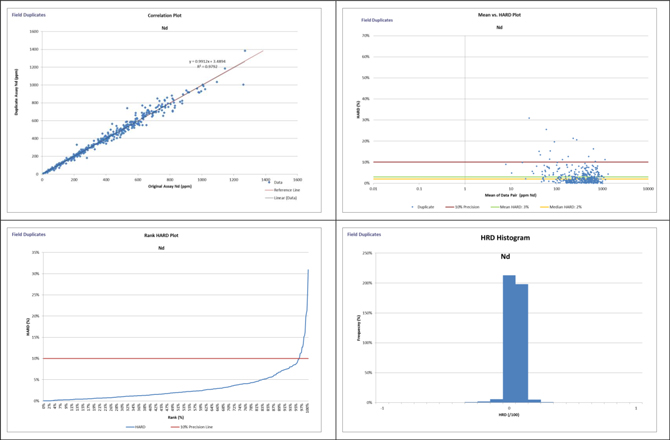
Figure 11-4: Nd Field Duplicate QA/QC Results
 |  |
| | Prefeasibility Study - NI 43-101 - Technical report for the Norra Kärr Rare
Earth Element Deposit - 0465-RPT-014 Rev 0 |
| 11.4.2 | Laboratory Duplicates |
To test the analytical precision of the laboratory Tasman has submitted duplicate pulp samples. A total of 601 pulp duplicate sample results have been provided to WAI. Examples of the results are shown below in Figure 11-5, Figure 11-6 and Figure 11-7 for Dy, Y and Nd respectively.
The results of the Tasman laboratory duplicate samples show excellent levels of repeatability and thus demonstrate the laboratory is operating with a high level of analytical precision and that the sample post pulverising, is homogenous and representative.
Prefeasibility Study - NI 43-101 - Technical report for the Norra Kärr Rare Earth Element Deposit - 0465-RPT-014 Rev 0
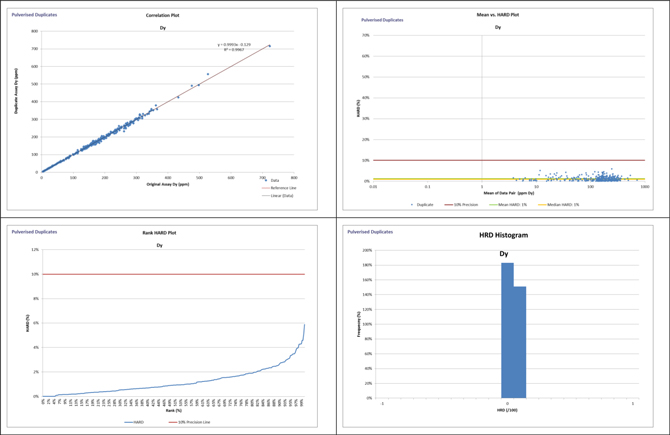
Figure 11-5: Dy Laboratory Duplicate QA/QC Results
Prefeasibility Study - NI 43-101 - Technical report for the Norra Kärr Rare Earth Element Deposit - 0465-RPT-014 Rev 0
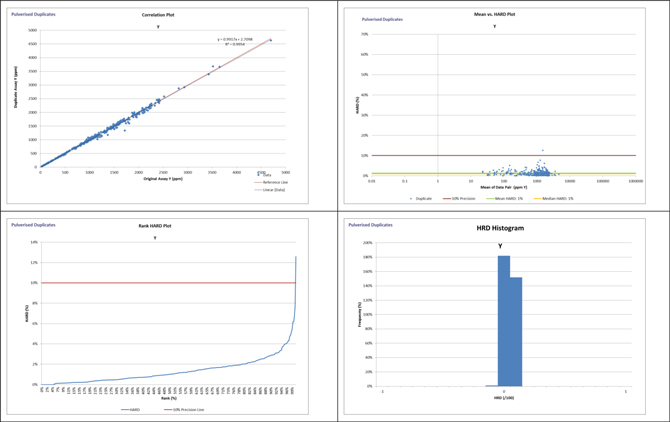
Figure 11-6: Y Laboratory Duplicate QA/QC Results
Prefeasibility Study - NI 43-101 - Technical report for the Norra Kärr Rare Earth Element Deposit - 0465-RPT-014 Rev 0
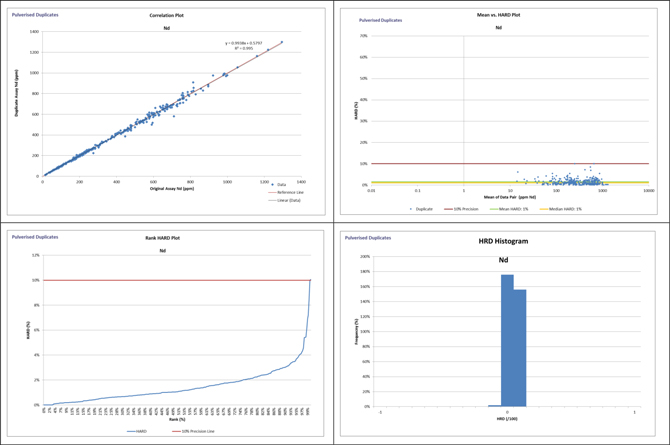
Figure 11-7: Nd Laboratory Duplicate QA/QC Results
Prefeasibility Study - NI 43-101 - Technical report for the Norra Kärr RareEarth Element Deposit - 0465-RPT-014 Rev 0
As part of the QA/QC procedures adopted by Tasman blank samples were submitted to the sample preparation facility/laboratory to test for sample contamination during the preparation process or the analytical stages. To comply with Swedish requirements which precludes the use of quartz rock or quartz sand due to the risk of silicosis, Tasman has submitted a granite blank material.
A total of 234 blank sample results have been provided to WAI. The results of the blank samples have been graphically plotted and examples can be seen in Figure 11-8, Figure 11-9 and Figure 11-10. The blank samples do display grades above the detection limit of 0.05 ppm Dy, 0.5 ppm Y, and 0.1 ppm Nd that the laboratory test method is capable of producing. The blank samples show elevated grades across the suite of elements tested. In using a granite as a blank sample there will inherently be elevated levels of rare earth elements as granites are typically more enriched in these elements than most other rock types.
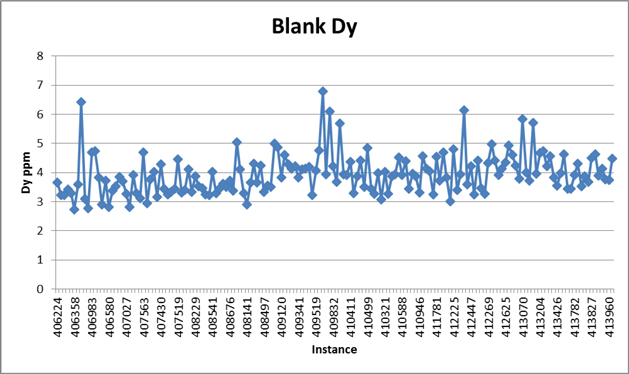
Figure 11-8: Dy Blank Sample Results
 |  |
| | Prefeasibility Study - NI 43-101 - Technical report for the Norra Kärr Rare
Earth Element Deposit - 0465-RPT-014 Rev 0 |
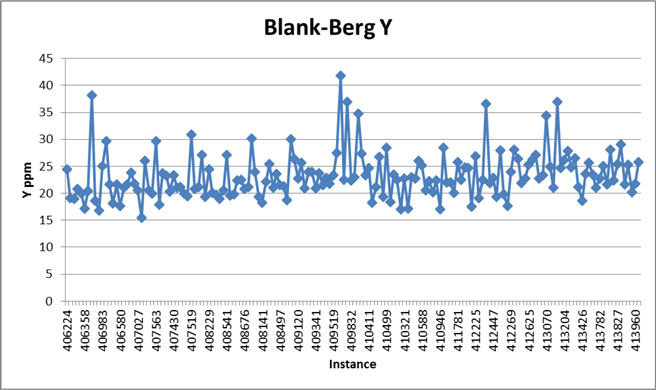
Figure 11-9: Y Blank Sample Results
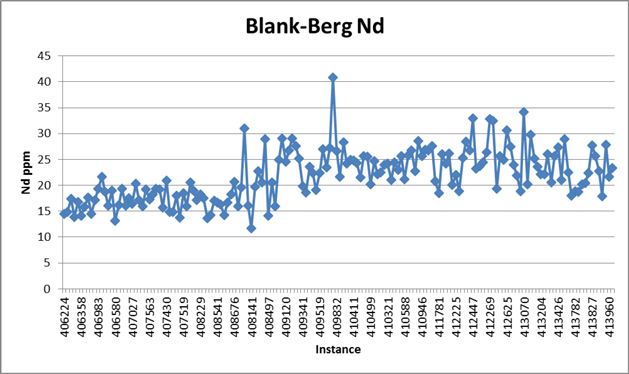
Figure 11-10: Nd Blank Sample Results
 |  |
| | Prefeasibility Study - NI 43-101 - Technical report for the Norra Kärr Rare
Earth Element Deposit - 0465-RPT-014 Rev 0 |
Whilst it is noted that the blank samples do contain mineralisation WAI is of the opinion that this is due to the function of using a granite as a blank material and is not a function of contamination issues at the sample preparation stage. The grades exhibited are minor, typically <3 % of the mean grade of the overall Norra Kärr intrusive ore body grades, and if contamination issues were significant then the error would likely show up in the field duplicate results.
| 11.4.4 | Certified Reference Material |
Tasman has carried out extensive checks with regards to the accuracy of the analytical methods used on the Norra Kärr samples through the use of CRMs. CRM samples have been supplied by Ore Research and Exploration Pty Ltd (OREAS). A few other purchased CRMs have been submitted but only in very low numbers. A summary of the certified values for the relevant CRMs as well as the calculated standard deviations is reported in Table 11-2.
As well as using pre-made CRM samples Tasman have produced two of their own CRMs; NKA01 and NKA02 both of which have been certified by OREAS as matrix-matched certified reference material (MMCRM). The two MMCRMs represent different TREO concentrations with NKA01 having a TREO grade of 0.4 % and NKA02 having a grade of 0.6 %. Both MMCRMs were produced from crushed reject material from the sample preparation stage of the original core samples. To certify the samples 10 commercial laboratories took part in a round robin of lithium borate fusion ICP-MS test work with five 20 g samples being submitted to each laboratory per MMCRM. The certified values and the calculated standard deviations for each tested element are shown in Table 11-2.
Table 11-2: CRM Sample Summary
| CRM ID | | Element | | Target
CRM
Grade | | | ±1
SD | | | ±2 SD | | | Number
of CRM
Submitted | | | Mean
Assay
Grade | | | % of Assay
Results within ±2
SD of Target CRM
Grade | |
| | | Dy | | | 23.2 | | | | 0.9 | | | | 0.18 | | | | | | | | 23.04 | | | | 92 | |
| | | Y | | | 142 | | | | 6 | | | | 12 | | | | | | | | 134.24 | | | | 78 | |
| | | Eu | | | 3.71 | | | | 0.36 | | | | 0.72 | | | | | | | | 3.88 | | | | 100 | |
| | | La | | | 260 | | | | 13 | | | | 26 | | | | | | | | 255.64 | | | | 100 | |
| OREAS100a | | Nd | | | 152 | | | | 14 | | | | 28 | | | | | | | | 149.81 | | | | 100 | |
| | | Ce | | | 463 | | | | 29 | | | | 58 | | | | 36 | | | | 453.92 | | | | 100 | |
| | | Gd | | | 23.6 | | | | 2.2 | | | | 4.4 | | | | | | | | 24.96 | | | | 100 | |
| | | Tb | | | 3.80 | | | | 0.34 | | | | 0.68 | | | | | | | | 3.83 | | | | 100 | |
| | | Pr | | | 47.1 | | | | 4.0 | | | | 8.0 | | | | | | | | 47.03 | | | | 100 | |
| | | Sm | | | 23.6 | | | | 0.7 | | | | 1.4 | | | | | | | | 23.86 | | | | 83 | |
| | | Dy | | | 18.1 | | | | 1.0 | | | | 2.0 | | | | | | | | 17.46 | | | | 92 | |
| OREAS102a | | Y | | | 105 | | | | 5 | | | | 10 | | | | 50 | | | | 101.31 | | | | 84 | |
| | | Eu | | | 3.89 | | | | 0.35 | | | | 0.7 | | | | | | | | 3.97 | | | | 100 | |
 |  |
| | Prefeasibility Study - NI 43-101 - Technical report for the Norra Kärr Rare
Earth Element Deposit - 0465-RPT-014 Rev 0 |
| CRM ID | | Element | | Target
CRM
Grade | | | ±1
SD | | | ±2 SD | | | Number
of CRM
Submitted | | | Mean
Assay
Grade | | | % of Assay
Results within ±2
SD of Target CRM
Grade | |
| | | La | | | 323 | | | | 16 | | | | 32 | | | | | | | | 315.10 | | | | 92 | |
| | | Nd | | | 180 | | | | 16 | | | | 32 | | | | | | | | 177.45 | | | | 100 | |
| | | Ce | | | 587 | | | | 48 | | | | 96 | | | | | | | | 563.86 | | | | 98 | |
| | | Gd | | | 20.9 | | | | 1.6 | | | | 3.2 | | | | | | | | 22.50 | | | | 40 | |
| | | Tb | | | 3.05 | | | | 0.23 | | | | 0.46 | | | | | | | | 3.13 | | | | 96 | |
| | | Pr | | | 58 | | | | 4 | | | | 8 | | | | | | | | 56.67 | | | | 100 | |
| | | Sm | | | 24.7 | | | | 1.3 | | | | 2.6 | | | | | | | | 24.65 | | | | 100 | |
| | | Dy | | | 7.11 | | | | 0.14 | | | | 0.28 | | | | | | | | 7.31 | | | | 58 | |
| | | Eu | | | 1.29 | | | | 0.08 | | | | 0.16 | | | | | | | | 1.30 | | | | 100 | |
| | | La | | | 48.8 | | | | 2.7 | | | | 5.4 | | | | | | | | 48.38 | | | | 100 | |
| | | Nd | | | 49.5 | | | | 1.4 | | | | 2.8 | | | | | | | | 50.16 | | | | 87 | |
| OREAS104 | | Ce | | | 102 | | | | 7 | | | | 14 | | | | 85 | | | | 102.80 | | | | 100 | |
| | | Gd | | | 9.4 | | | | 0.9 | | | | 1.8 | | | | | | | | 9.09 | | | | 100 | |
| | | Tb | | | 1.39 | | | | 0.14 | | | | 0.28 | | | | | | | | 1.33 | | | | 100 | |
| | | Pr | | | 12.8 | | | | 0.7 | | | | 1.4 | | | | | | | | 12.89 | | | | 100 | |
| | | Sm | | | 10.5 | | | | 0.7 | | | | 1.4 | | | | | | | | 10.82 | | | | 100 | |
| | | Dy | | | 224 | | | | 16 | | | | 32 | | | | | | | | 220.29 | | | | 97 | |
| | | Y | | | 905 | | | | 53 | | | | 106 | | | | | | | | 922.32 | | | | 98 | |
| | | Eu | | | 127 | | | | 9 | | | | 18 | | | | | | | | 129.28 | | | | 96 | |
| | | La | | | 2513 | | | | 185 | | | | 370 | | | | | | | | 2527.15 | | | | 98 | |
| OREAS146 | | Nd | | | 2182 | | | | 192 | | | | 384 | | | | 360 | | | | 2183.37 | | | | 98 | |
| | | Ce | | | 4691 | | | | 360 | | | | 720 | | | | | | | | 4758.69 | | | | 99 | |
| | | Gd | | | 359 | | | | 23 | | | | 46 | | | | | | | | 339.96 | | | | 92 | |
| | | Tb | | | 47.2 | | | | 3.4 | | | | 6.8 | | | | | | | | 45.21 | | | | 98 | |
| | | Pr | | | 548 | | | | 36 | | | | 72 | | | | | | | | 555.31 | | | | 99 | |
| | | Sm | | | 441 | | | | 36 | | | | 72 | | | | | | | | 449.92 | | | | 99 | |
| | | Dy | | | 175 | | | | 9.7 | | | | 19.4 | | | | | | | | 168.13 | | | | 95 | |
| | | Y | | | 1131 | | | | 62.2 | | | | 124.4 | | | | | | | | 1136.02 | | | | 99 | |
| | | Eu | | | 10.8 | | | | 0.49 | | | | 0.98 | | | | | | | | 10.93 | | | | 95 | |
| | | La | | | 313 | | | | 24.6 | | | | 49.2 | | | | | | | | 315.84 | | | | 99 | |
| NKA01 | | Nd | | | 307 | | | | 18.6 | | | | 37.2 | | | | 161 | | | | 309.73 | | | | 99 | |
| | | Ce | | | 626 | | | | 58.2 | | | | 116.4 | | | | | | | | 634.76 | | | | 100 | |
| | | Gd | | | 111 | | | | 7.7 | | | | 15.4 | | | | | | | | 107.46 | | | | 98 | |
| | | Tb | | | 24 | | | | 1.68 | | | | 3.36 | | | | | | | | 23.48 | | | | 100 | |
| | | Pr | | | 79 | | | | 3.1 | | | | 6.2 | | | | | | | | 79.14 | | | | 92 | |
 |  |
| | Prefeasibility Study - NI 43-101 - Technical report for the Norra Kärr Rare
Earth Element Deposit - 0465-RPT-014 Rev 0 |
| CRM ID | | Element | | Target
CRM
Grade | | | ±1
SD | | | ±2 SD | | | Number
of CRM
Submitted | | | Mean
Assay
Grade | | | % of Assay
Results within ±2
SD of Target CRM
Grade | |
| | | Sm | | | 88 | | | | 2.3 | | | | 4.6 | | | | | | | | 87.57 | | | | 81 | |
| | | Dy | | | 241 | | | | 11.9 | | | | 23.8 | | | | | | | | 228.19 | | | | 85 | |
| | | Y | | | 1569 | | | | 94.7 | | | | 189.4 | | | | | | | | 1659.26 | | | | 90 | |
| | | Eu | | | 18.2 | | | | 0.63 | | | | 1.26 | | | | | | | | 18.09 | | | | 83 | |
| | | La | | | 520 | | | | 28.2 | | | | 56.4 | | | | | | | | 517.96 | | | | 99 | |
| NKA02 | | Nd | | | 576 | | | | 22 | | | | 44 | | | | 162 | | | | 575.31 | | | | 89 | |
| | | Ce | | | 1120 | | | | 81.2 | | | | 162.4 | | | | | | | | 1135.18 | | | | 100 | |
| | | Gd | | | 176 | | | | 12.4 | | | | 24.8 | | | | | | | | 169.17 | | | | 99 | |
| | | Tb | | | 34.8 | | | | 2.12 | | | | 4.24 | | | | | | | | 33.81 | | | | 98 | |
| | | Pr | | | 143 | | | | 6 | | | | 12 | | | | | | | | 145.75 | | | | 88 | |
| | | Sm | | | 152 | | | | 3.8 | | | | 7.6 | | | | | | | | 153.65 | | | | 73 | |
| | | Dy | | | 4.1 | | | | 0.2 | | | | 0.4 | | | | | | | | 3.94 | | | | 86 | |
| | | Y | | | 18 | | | | 1.4 | | | | 2.8 | | | | | | | | 17.31 | | | | 100 | |
| | | Eu | | | 1.2 | | | | 0.1 | | | | 0.2 | | | | | | | | 1.17 | | | | 82 | |
| | | La | | | 24.8 | | | | 1 | | | | 2 | | | | | | | | 24.31 | | | | 89 | |
| OREAS 45P | | Nd | | | 21 | | | | 0.6 | | | | 1.2 | | | | 28 | | | | 20.75 | | | | 71 | |
| | | Ce | | | 48.9 | | | | 1.6 | | | | 3.2 | | | | | | | | 47.69 | | | | 71 | |
| | | Gd | | | 4.0 | | | | 0.2 | | | | 0.4 | | | | | | | | 4.29 | | | | 75 | |
| | | Tb | | | 0.69 | | | | 0.04 | | | | 0.08 | | | | | | | | 0.69 | | | | 100 | |
| | | Pr | | | 5.42 | | | | 2.1 | | | | 4.2 | | | | | | | | 5.61 | | | | 100 | |
| | | Sm | | | 4.51 | | | | 0.14 | | | | 0.28 | | | | | | | | 4.37 | | | | 57 | |
| | | Dy | | | 4.0 | | | | 0.1 | | | | 0.2 | | | | | | | | 4.03 | | | | 61 | |
| | | Y | | | 18.1 | | | | 1.4 | | | | 2.8 | | | | | | | | 18.77 | | | | 100 | |
| | | Eu | | | 1.18 | | | | 0.08 | | | | 0.16 | | | | | | | | 1.19 | | | | 99 | |
| | | La | | | 26.2 | | | | 1.1 | | | | 2.2 | | | | | | | | 26.35 | | | | 89 | |
| OREAS 45C | | Nd | | | 22.8 | | | | 1.7 | | | | 3.4 | | | | 74 | | | | 22.14 | | | | 97 | |
| | | Ce | | | 50.2 | | | | 1.3 | | | | 2.6 | | | | | | | | 50.92 | | | | 65 | |
| | | Gd | | | 4.2 | | | | 0.2 | | | | 0.4 | | | | | | | | 4.09 | | | | 81 | |
| | | Tb | | | 0.70 | | | | 0.04 | | | | 0.08 | | | | | | | | 0.66 | | | | 95 | |
| | | Pr | | | 5.61 | | | | 0.12 | | | | 0.24 | | | | | | | | 5.89 | | | | 30 | |
| | | Sm | | | 4.7 | | | | 0.1 | | | | 0.2 | | | | | | | | 4.74 | | | | 54 | |
Example results for a number of the CRMs are shown in Figure 11-11 to Figure 11-17. The CRM results show a good level of accuracy with the majority of results for both the OREAS CRMs and the NKA01 and NKA02 CRMs falling within ±2 standard deviations. In the case of CRM OREAS 45c the
 |  |
| | Prefeasibility Study - NI 43-101 - Technical report for the Norra Kärr Rare
Earth Element Deposit - 0465-RPT-014 Rev 0 |
results for dysprosium show a lower level of accuracy. Given the low Dy grade in CRM OREAS 45c WAI is of the opinion that the OREAS 45c Dy CRM results are reasonable.
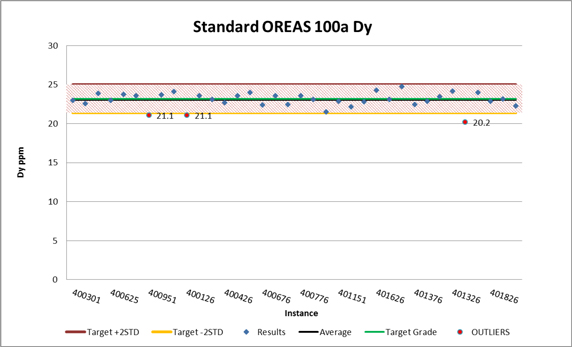
Figure 11-11: CRM OREAS 100a Dy Results
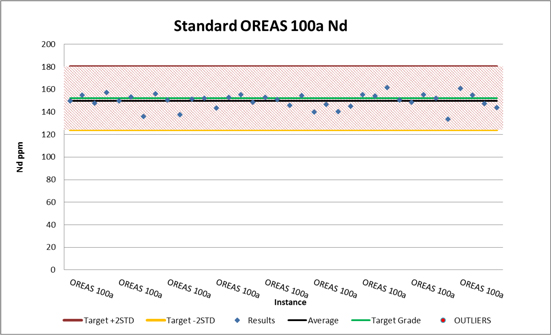
Figure 11-12: CRM OREAS 100a Nd Results
 |  |
| | Prefeasibility Study - NI 43-101 - Technical report for the Norra Kärr Rare
Earth Element Deposit - 0465-RPT-014 Rev 0 |
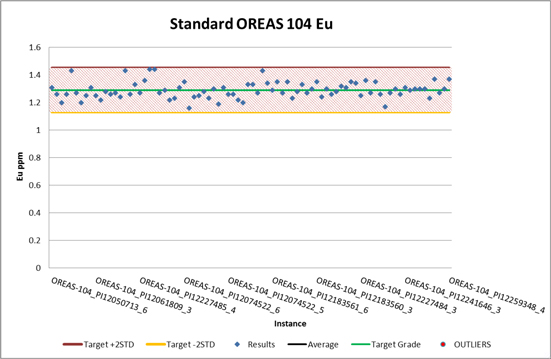
Figure 11-13: CRM OREAS 104 Eu Results
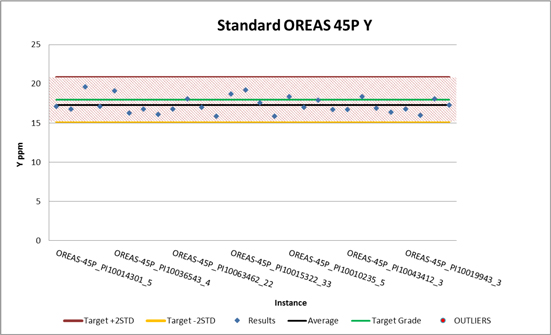
Figure 11-14: CRM OREAS 45p Y Results
 |  |
| | Prefeasibility Study - NI 43-101 - Technical report for the Norra Kärr Rare
Earth Element Deposit - 0465-RPT-014 Rev 0 |
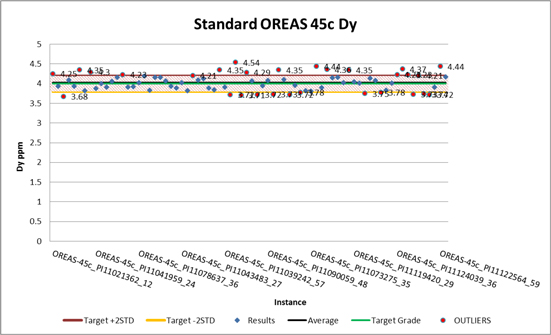
Figure 11-15: CRM OREAS 45c Dy Results
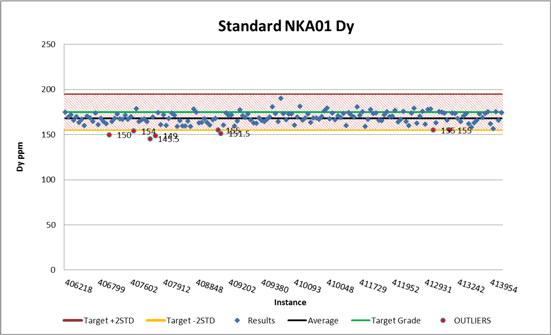
Figure 11-16: CRM NKA01 Dy Results
 |  |
| | Prefeasibility Study - NI 43-101 - Technical report for the Norra Kärr Rare
Earth Element Deposit - 0465-RPT-014 Rev 0 |
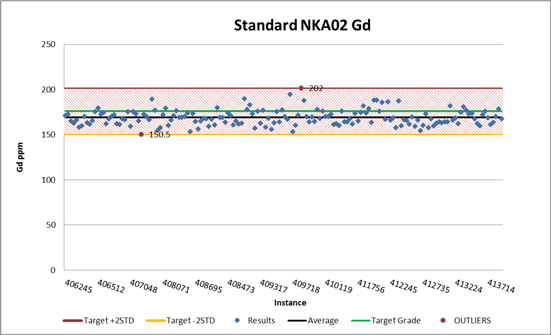
Figure 11-17: CRM NKA02 Gd Results
| 11.4.5 | WAI Duplicate Assays |
As part of the WAI due diligence processes a total of 14 samples were selected by Greg Moseley (Qualified Person) during the May 2014 site visit, of these samples eight samples were duplicate core samples, four samples were pulverised duplicates, one sample was CRM NKA02 and one sample was a blank. A summary of the results is provided in Table 11-3.
A good correlation is exhibited between the original assays and the core and pulverised duplicates particularly with regards to the core duplicates. Pulverised duplicates show lower levels of precision for some elements but this may be related to the sample not being fully homogenised using the cone and quarter method prior to submission to the laboratory.
 |  |
| | Prefeasibility Study - NI 43-101 - Technical report for the Norra Kärr Rare
Earth Element Deposit - 0465-RPT-014 Rev 0 |
Table 11-3: WAI 2014 Duplicate Sample Summary
| | | | | | | | | | | Original Grade | | | Duplicate Grade | |
| TYPE | | BHID | | From
(m) | | | To (m) | | | Dy
ppm | | | Y
ppm | | | Eu
ppm | | | Nd
ppm | | | Tb
ppm | | | Dy
ppm | | | Dy %
Diff | | | Y
ppm | | | Y %
Diff | | | Eu
ppm | | | Eu %
Diff | | | Nd
ppm | | | Nd %
Diff | | | Tb
ppm | | | Tb %
Diff | |
| | NKA11053 | | 179.4 | | | 181.0 | | | 145.5 | | | 1 015 | | | 9.43 | | | 238 | | | 21.4 | | | 156 | | | +7 | | | 1 030 | | | +1 | | | 9.66 | | | +2 | | | 249 | | | +5 | | | 21.9 | | | +2 | |
| | | NKA12062 | | 192.7 | | | 194.7 | | | 299 | | | 1 985 | | | 23.5 | | | 616 | | | 41.5 | | | 294 | | | -2 | | | 2 050 | | | +3 | | | 21.9 | | | -7 | | | 605 | | | -2 | | | 44.1 | | | +6 | |
| | | NKA12090 | | 80.15 | | | 82.55 | | | 217 | | | 1 505 | | | 20.6 | | | 745 | | | 33.4 | | | 205 | | | -6 | | | 1 505 | | | 0 | | | 18.55 | | | -10 | | | 672 | | | -10 | | | 31.2 | | | -7 | |
| Core | | NKA12090 | | 219.0 | | | 221.0 | | | 160 | | | 946 | | | 10.5 | | | 245 | | | 20.9 | | | 151.5 | | | -5 | | | 981 | | | +4 | | | 9.35 | | | -11 | | | 253 | | | +3 | | | 21.2 | | | +1 | |
| | | NKA12064 | | 176.92 | | | 178.46 | | | 7.02 | | | 42.6 | | | 1.89 | | | 61.6 | | | 1.19 | | | 6.97 | | | -1 | | | 38.5 | | | -10 | | | 1.93 | | | +2 | | | 63.5 | | | +3 | | | 1.2 | | | 0 | |
| | | NKA12076 | | 114.0 | | | | | | | 41.3 | | | 271 | | | 5.06 | | | 168 | | | 6.34 | | | 42.90 | | | +4 | | | 294 | | | +8 | | | 4.93 | | | -3 | | | 197 | | | +17 | | | 6.71 | | | +6 | |
| | | NKA12807 | | 223.05 | | | 224.55 | | | 248 | | | 1 910 | | | 27.1 | | | 1 020 | | | 40.2 | | | 234 | | | -6 | | | 1 870 | | | -2 | | | 25.8 | | | -5 | | | 990 | | | -3 | | | 37.8 | | | -6 | |
| | | NKA12085 | | 148.87 | | | 150.78 | | | 141 | | | 1 055 | | | 10.3 | | | 384 | | | 19.6 | | | 137.5 | | | -2 | | | 994 | | | -6 | | | 9.88 | | | -4 | | | 395 | | | +3 | | | 19.95 | | | +2 | |
| | Pulp Dup of Sample 402479 | | | | | 9.09 | | | 49.3 | | | 1.89 | | | 52.8 | | | 1.48 | | | 9.14 | | | +1 | | | 55.9 | | | +13 | | | 1.83 | | | -3 | | | 53.9 | | | +2 | | | 1.5 | | | +1 | |
| Pulp | | Pulp Dup of Sample 400636 | | | | | | 163 | | | 1 010 | | | 10.9 | | | 249 | | | 22.7 | | | 161.00 | | | -1 | | | 1 010 | | | 0 | | | 8.83 | | | -19 | | | 232 | | | -7 | | | 21.8 | | | -4 | |
| | | Pulp Dup of Sample 401379 | | | | | | 334 | | | 2 070 | | | 24.8 | | | 546 | | | 48.9 | | | 353.00 | | | +6 | | | 2 280 | | | +10 | | | 21.9 | | | -12 | | | 566 | | | +4 | | | 50.6 | | | +3 | |
| | | Pulp Dup of Sample 402695 | | | | | | 136.5 | | | 939 | | | 9.79 | | | 192 | | | 19.25 | | | 152.00 | | | +11 | | | 942 | | | 0 | | | 8.91 | | | -9 | | | 195.5 | | | +2 | | | 20.9 | | | +9 | |
| Blank | | Blank | | | | | | | | | | <0.05 | | | <0.5 | | | <0.03 | | | <0.1 | | | <0.01 | | | 3.42 | | | +6 840 | | | 20 | | | +4 000 | | | 0.44 | | | +1 467 | | | 21.2 | | | +21 200 | | | 0.64 | | | +6 400 | |
| CRM | | NKA02 | | | | | | | | | | 241 | | | 1 569 | | | 18.2 | | | 576 | | | 34.8 | | | 229.00 | | | -5 | | | 1 625 | | | +4 | | | 17.2 | | | -5 | | | 559 | | | -3 | | | 34 | | | -2 | |
| | | | | | | | | | | | | | | | | | | | | | | | | | | | | | | | | | | | | | | | | | | | | | | | | | | | | | | | | | | | | | | | | | | | | | | |
 |  |
| | Prefeasibility Study - NI 43-101 - Technical report for the Norra Kärr Rare
Earth Element Deposit - 0465-RPT-014 Rev 0 |
The WAI audit of the QA/QC data has identified a number of risks within the sample data. These risks are summarised in Table 11-4. It should be noted that Table 11-4 does not provide a quantitative risk assessment, but gives an indication as to where WAI considers the risks lie within the sampling data.
A six-score classification has been employed where:
| · | 1-2 (‘low’ risk): Little or no perceived risk, or low uncertainty; |
| · | 3-4 (‘moderate’ or ‘medium’ risk): Risk present which could lead to small material error in the resource model; and |
| · | 5-6 (‘high’ risk): This feature could lead to material error in the resource model (high uncertainty). |
Table 11-4: Risk Matrix: QA/QC Sample Auditing
QA/QC
Sampling | | Risk | | Comments |
| | | | | |
| Field Duplicates | | 1 | | The field duplicates display an excellent correlation and level of repeatability. Such results show that the combined sampling, sample preparation and analytical errors are minor and do not materially impact the precision of the samples. |
| | | | | |
| Lab Duplicates | | 1 | | As with the field duplicates the laboratory pulverised duplicates display an excellent level of precision showing that the sample material following pulverisation is homogenous and that the laboratories analytical systems are precise. |
| | | | | |
| Blanks | | 3 | | Tasman has used a granite blank for their QA/QC procedures due to state requirements. The results of the analysis of the blanks show that there are low grades of mineralisation above the analytical detection limit. Whilst the blank material has displayed mineralisation WAI believes this is due to natural levels of mineralisation within the granite rock rather than a contamination issue at the sample preparation facility. The blank sample results show a fairly uniform trend, if there was a contamination issue WAI would expect to see a more erratic distribution of results. If there were contamination issues at the sample preparation stage such errors would be exhibited in the field duplicate samples as the field duplicate results are a sum of the sampling, sample preparation and analytical errors. The high level of correlation in the field duplicates therefore supports the view that the grades in the blank samples are natural grades within the granite. |
| | | | | |
| Certified Reference Materials | | 2 | | Tasman has submitted a number of CRMs included CRM samples bought from OREAS as well as CRM NKA02 which Tasman has developed from crushed sample material from Norra Kärr which has been subject to round robin testing and has subsequently been certified by OREAS. The CRM results for a range of elements and at a range of grades show a good level of analytical accuracy at the laboratory. |
 |  |
| | Prefeasibility Study - NI 43-101 - Technical report for the Norra Kärr Rare
Earth Element Deposit - 0465-RPT-014 Rev 0 |
QA/QC
Sampling | | Risk | | Comments |
| WAI Check Assays | | 2 | | WAI has chosen 14 duplicate samples during the May 2014 site visit by Greg Moseley (Qualified Person) for submission to the ALS Chemex laboratory for verification purposes. From these samples a total of eight core duplicates were submitted showing a reasonable level of repeatability to the original assays. A further four pulverized duplicates were submitted and showed a lower level of precision although this may be attributable to the cone and quarter method of mixing the pulverized sample not adequately homogenizing the samples. Whilst the samples show some deviation WAI does not consider it material and is of the opinion that the Tasman assays display both precision and accuracy. |
| | | | | |
| External Duplicates | | 3 | | A total of 525 samples have been submitted to external laboratories ACME and ACTLABS. WAI has been provided with results for 500 of the external duplicates with 194 provided for the ACME laboratory and 316 for the ACTLABS laboratory. The results display a high level of repeatability of the samples support a good level of precision in the assaying. |
| | | | | |
| Overall Rating | | 2 | | Low Risk |
WAI considers the Quality Assurance and Quality Control risk for the Norra Kärr project to be “Low” and that the sample preparation procedures and analytical methods are suitable.
| 11.4.7 | External Duplicate Assays |
To check the precision of the primary laboratories duplicate samples and some CRM samples were submitted to external laboratories for verification. In total 525 pulverised duplicate samples have been submitted to external laboratories, the results of 500 duplicate samples have been provided to WAI. From the 500 external duplicates supplied to WAI a total of 194 samples were submitted to the ACME laboratory and 316 samples were submitted to ACTLABS.
WAI has reviewed the results with high levels of repeatability and precision exhibited by both laboratories as demonstrated in Figure 11-18.
 |  |
| | Prefeasibility Study - NI 43-101 - Technical report for the Norra Kärr Rare
Earth Element Deposit - 0465-RPT-014 Rev 0 |
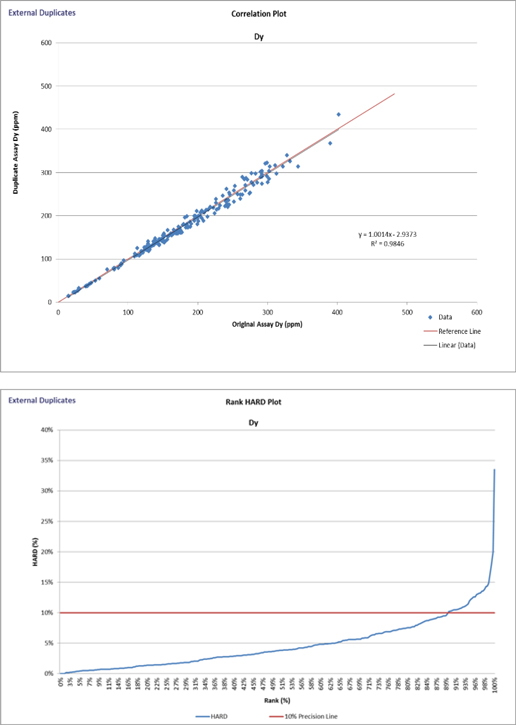
Figure 11-18: Dy ACTLABS External Duplicates
 |  |
| | Prefeasibility Study - NI 43-101 - Technical report for the Norra Kärr Rare
Earth Element Deposit - 0465-RPT-014 Rev 0 |
| 11.5 | Density Determination |
A total of 1 513 bulk density tests have been carried out by Tasman with the resultant database supplied to WAI. The database contains the recorded drill hole ID, depth from and to, dry and wet weights as well recording the lithological rock type. Density values range between 2.22 t/m3 and 3.445 t/m3 and average 2.71 t/m3.
 |  |
| | Prefeasibility Study - NI 43-101 - Technical report for the Norra Kärr Rare
Earth Element Deposit - 0465-RPT-014 Rev 0 |
Section 12 Data Verification
WAI visited the Norra Kärr project in May and June 2014, including the logging facilities, drill core, surface exposures, the ALS Chemex sample preparation facility in Piteå, Sweden, as well as reviewing and discussing the geology, exploration works, testwork and QA/QC procedures with Tasman and ALS Chemex personnel. The following aspects were inspected during the visits:
| · | The geological and geographical setting of the Norra Kärr alkaline intrusive complex; |
| · | The extent of the exploration work completed to date; |
| · | Inspection of the core logging, sampling and storage facilities; |
| · | Inspection of the core and a review of the logging procedures; |
| · | Review of the sampling and sample preparation procedures; |
| · | Discussions with the geological staff regarding geological interpretation; and |
| · | A visit to the ALS Chemex sample preparation facility in Piteå, Sweden, to review the facilities as well as discuss the methods and procedures employed. |
WAI has undertaken a number of steps to verify the quality and robustness of the sample data. The data verification is split into three sections:
Some aspects of the field verification, e.g. surface geological mapping, are covered in Section 9.3.1, where the location of outcrops and old Boliden excavations was noted and the trajectory of WAI’s site visit illustrated. WAI visited a considerable number of the important outcrops and photographs of these some of the sites are shown in Figure 12-1 to Figure 12-4.
 |  |
| | Prefeasibility Study - NI 43-101 - Technical report for the Norra Kärr Rare
Earth Element Deposit - 0465-RPT-014 Rev 0 |
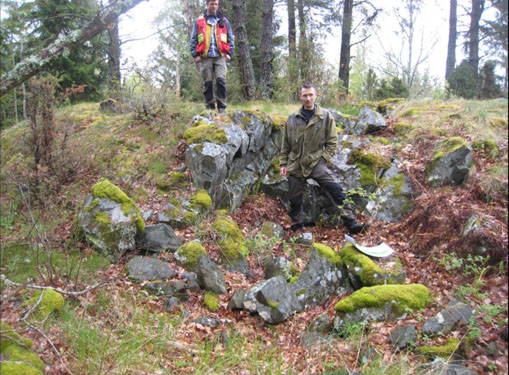
Figure 12-1: Tasman Geologists at a Typical Norra Kärr Outcrop

Figure 12-2: Site of Former Boliden Excavation
 |  |
| | Prefeasibility Study - NI 43-101 - Technical report for the Norra Kärr Rare
Earth Element Deposit - 0465-RPT-014 Rev 0 |
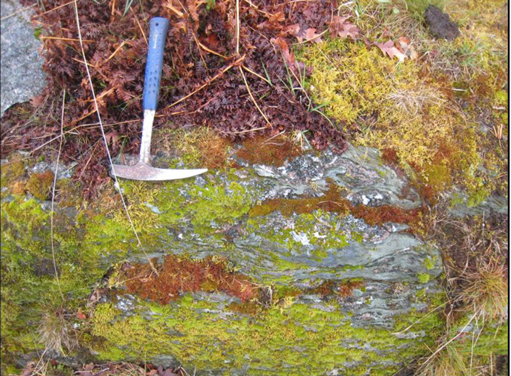
Figure 12-3: Pegmatitic Grennaite (PGT Domain)
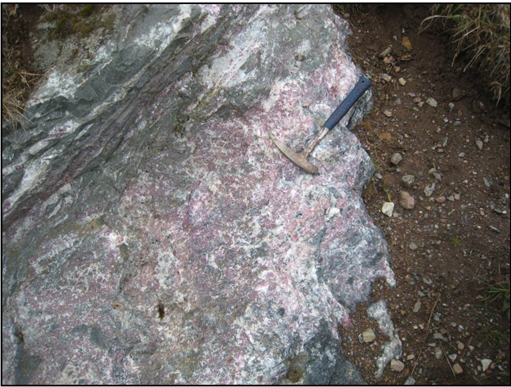
Figure 12-4: The “Discovery” Outcrop Showing Pink Eudyalite
 |  |
| | Prefeasibility Study - NI 43-101 - Technical report for the Norra Kärr Rare
Earth Element Deposit - 0465-RPT-014 Rev 0 |
During the May 2014 site visit WAI undertook a review of drill hole collar positions. This was achieved during the various traverses undertaken as part of the surface mapping discussed previously. Approximately 65 % of the more than 100 drill hole sites were visited and their positions confirmed by GPS.
While there is a consistent small error – in general less than five metres – this can be put down to “experimental error” and the conversion used from the GPS reading to the SWEREF99TM projection via the Global Mapper (V15.2) software utilised by WAI. This error is not considered significant and the collar positions are accepted by WAI as being accurate for all practical purposes.
Figure 12-5 and Figure 12-6 show the Tasman drill hole positions and the trajectory and positions as measured by WAI in the field. Positions of the drill holes at site were denoted by drill hole casing as shown in Figure 12-7.
 |  |
| | Prefeasibility Study - NI 43-101 - Technical report for the Norra Kärr Rare
Earth Element Deposit - 0465-RPT-014 Rev 0 |
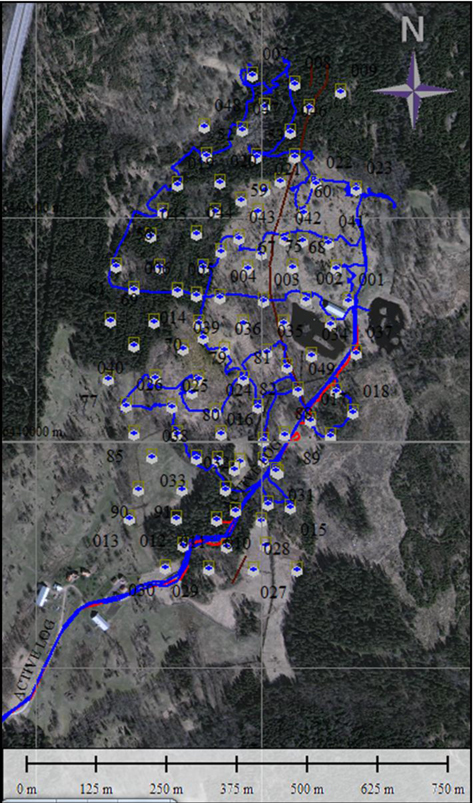
Figure 12-5: Plan Showing Drill Hole Collar Positions and the WAI Site Visit Trajectory
 |  |
| | Prefeasibility Study - NI 43-101 - Technical report for the Norra Kärr Rare
Earth Element Deposit - 0465-RPT-014 Rev 0 |
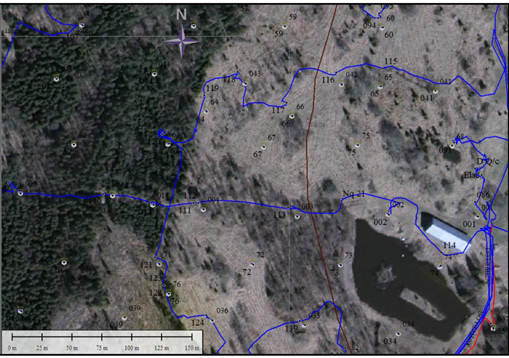
Figure 12-6: Enlarged Image Showing Drill Hole Sites and WAI Site Visit Trajectory
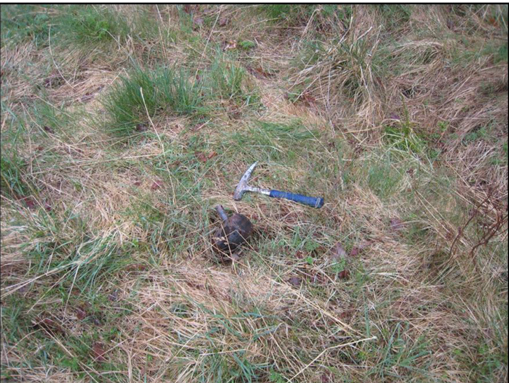
Figure 12-7: Drill Hole Collar Marked by Casing
 |  |
| | Prefeasibility Study - NI 43-101 - Technical report for the Norra Kärr Rare
Earth Element Deposit - 0465-RPT-014 Rev 0 |
| 12.2 | Sampling Verification |
WAI considers the sampling and assay information to be reliable. WAI chose eight core sample duplicates and four pulverised sample duplicates for assay (see Section 11.4.5). The results of the WAI duplicate samples shows support for the robustness of the sample data on which the Mineral Resource estimate reported in Section 14 is based.
The plastic bags containing the samples were then packed in cardboard boxes and sent by bus to the ALS Chemex preparation laboratory in Piteå in the north of Sweden prior to being sent to the ALS Chemex laboratory in Vancouver.
The sample quality is considered to be adequate in all respects – from the logging of the core to the core splitting and sample despatch to the ALS Chemex facility in Piteå. The handling of the core and the treatment and despatch of the samples by Tasman has fully conformed to industry “best practice” and WAI is satisfied with all of these aspects.
WAI discussed core and sample handling procedures with Tasman’s key geological and technical personnel. On the basis of these discussions, WAI believes that all split core was well and securely packed and stored prior to transportation to the laboratory for processing. As a result WAI considers sample security to be adequate.
WAI also understands that other than the core splitting procedure at no time was an officer, director or associate of Tasman involved in the sample preparation or analytical work and an independent laboratory was employed for sample preparation and analysis. It is therefore WAI’s belief that it is highly unlikely that an officer, director or associate would have had the opportunity to contaminate the sample data.
 |  |
| | Prefeasibility Study - NI 43-101 - Technical report for the Norra Kärr Rare
Earth Element Deposit - 0465-RPT-014 Rev 0 |
Section 13 Mineral Processing and Metallurgical Testing
Historical quantitative mineralogy, beneficiation and hydrometallurgical testing programmes have been conducted by various agents since Tasman acquired control of the Norra Kärr deposit. Relevant technical material generated as part of historical programmes has previously been reported in the Preliminary Economic Assessment (PEA) prepared by Pincock Allen & Holt (May 2012; restated April 2013 (4)). A summary of the relevant results are presented here for convenience however the reader is referred to the original report for the complete appraisal. SGS Lakefield conducted limited testing on whole ore employing sulfuric acid. The tests demonstrated the efficacy of the method however the acid consumption was uneconomic. Beneficiation work was subsequently undertaken by GTK employing both negative flotation and magnetic separation either separately or in combination. The programme confirmed that the eudialyte could be beneficiated by means of magnetic separation. The flotation work demonstrated that aegirine could be also separated from the eudialyte, subject to sufficient liberation, by means of negative flotation whereby aegirine was selectively floated from the remaining mineral mass. Finally, hydrometallurgical testing was undertaken by John Litz and Associates where tests employed both sulfuric and hydrochloric acid leaching on mineral concentrate prepared by GTK where a majority of acid consuming gangue minerals were rejected. This further confirmed the efficacy of sulfuric acid leaching and demonstrated an improved acid consumption profile compared with the whole ore treatment.
Testing completed since the PEA published in 2012 covers quantitative mineralogical characterisation, beneficiation and hydrometallurgical campaigns. Two primary material composites were prepared to undertake various aspects of the testing programmes. The first composite was prepared in April 2012 to facilitate investigative testing of various beneficiation methods at the research facilities of Dorfner ANZAPLAN (ANZAPLAN, Germany). The second composite was prepared in November 2012 to facilitate a broader testing campaign developing from the ANZAPLAN work and for the preparation of mineral concentrate for further hydrometallurgical testing.
| 13.2.1 | Composite Description, Sample Preparation and Analysis |
All composites used in the test programmes were prepared under the guidance of Tasman’s Chief Geologist, Magnus Leijd. The selection criteria for the sourced material was to select material which
 |  |
| | Prefeasibility Study - NI 43-101 - Technical report for the Norra Kärr Rare
Earth Element Deposit - 0465-RPT-014 Rev 0 |
as a whole represented, on a weighted basis, the geological and chemical variability within the defined resource.
| 13.2.1.1 | ANZAPLAN composites |
A total of five different samples from the Norra Kärr deposit were sent to ANZAPLAN for beneficiation testing. The samples will be composed of half or in some case quarter drill core with a diameter of approximately 41 mm (BQ). Four of the samples weighed approximately 300 kg each (AZ NPGT, AZ AZ CPGT, AZ SPGT, AZ GTM) and the fifth sample between 100 kg to 200 kg (AZ GTC). The samples were chosen to represent different areas or domains within the deposit. Three of the samples labelled AZ SPGT, AZ NPGT and AZ CPGT were composed of intermittently pegmatitic grennaite (PGT domain) from different parts of the deposit. The sample AZ GTM was taken from the “migmatitic” grennaite (GTM domain) which occurs around the central “Kaxtorpite”. A fifth sample taken from the GTC domain.
The three pegmatitic samples were quite similar in mineralogy, chemistry and texture but represent different spatial areas within the deposit. The sample AZ SPGT was taken from drill core in the southern part of the intrusive south of the central Kaxtorpite. AZ CPGT was composed of drill core from the area west and just north-west of the Kaxtorpite and sample AZ NPGT from pegmatitic material in the northern part of the present resource.
A further composite was prepared by combining equal parts of AZ NPGT, AZ CPGT, AZ SPGT and AZ GTM which was subjected to the range of beneficiation tests (ANZCOMP).
Figure 13-1 shows the locations within the deposit where the samples were taken.
 |  |
| | Prefeasibility Study - NI 43-101 - Technical report for the Norra Kärr Rare
Earth Element Deposit - 0465-RPT-014 Rev 0 |
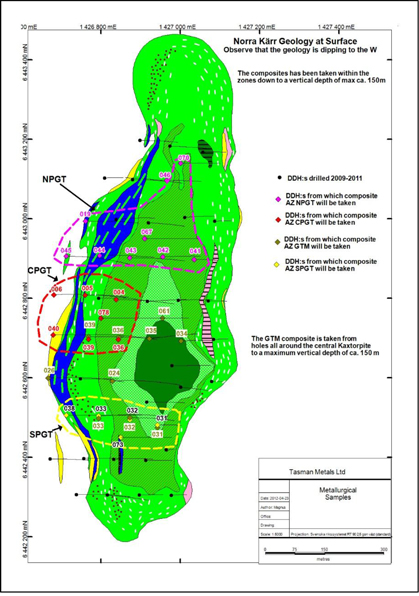
Figure 13-1: ANZAPLAN composite locations
| 13.2.1.2 | Resource composite |
A metallurgical composite, referred to as RESCOMP, weighing 6.87 tonnes was prepared from drill core. This composite was prepared to represent the resource as defined in the PEA. The composite, on a mass weighted basis, represented the mineralogical, chemical and textural variability recorded within the deposit. A total of 13 drill holes, measuring in excess of 1 300 m, were selected from suitable locations based on the resource database. The location of the selected composite drill holes are shown in Figure 13-2. The drill holes recovered material from the two main rock domains;
 |  |
| | Prefeasibility Study - NI 43-101 - Technical report for the Norra Kärr Rare
Earth Element Deposit - 0465-RPT-014 Rev 0 |
pegmatitic grennaite (PGT) and migmatic grennaite (GTM), which define the resource in an approximate ratio of 3:1 with minor contributions from the surrounding domains.
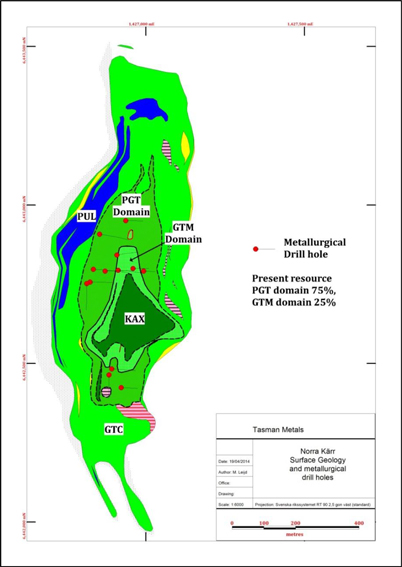
Figure 13-2: Norra Kärr Surface Resource Map with Borehole Locations
 |  |
| | Prefeasibility Study - NI 43-101 - Technical report for the Norra Kärr Rare
Earth Element Deposit - 0465-RPT-014 Rev 0 |
Table 13-1: RESCOMP Modal Mineralogy
| Mineral | | Mass [/%] | |
| Albite | | | 23.46 | |
| Aegirine | | | 19.64 | |
| Orthoclase | | | 16.35 | |
| Natrolite | | | 12.79 | |
| Nepheline | | | 11.35 | |
| Eudialyte | | | 6.72 | |
| Catapleiite | | | 2.74 | |
| Eckermannite-(Fe) | | | 2.04 | |
| Muscovite | | | 1.08 | |
| Other (defined) | | | 3.83 | |
The RESCOMP drill core was dispatched to Loesche (Loesche GmbH, Germany) for comminution to the desired passing particle sizes (80 % passing, 60 µm, 80 µm, and 100 µm). Drill core was manually blended at the approximate ratio of three parts PGT to one part GTM then crushed to 10 mm in a jaw crusher before dry grinding in a vertical roller mill. A subset of the composite was submitted to both WAI and JKTech for comminution testing.
A sample of the ANZCOMP 60 µm ground composite was submitted for mineralogical characterization at GTK, employing mineral liberation analysis (MLA) technology. The MLA equipment consists of the standard scanning electron microscopy (FEI Quanta 600) with an energy dispersive X-ray analyser (EDAX Genesis with two detectors) and the accompanying software package developed originally by JKTech (Australia). Modal mineralogy was estimated using the XMOD-STD method and is presented in Table 13-1. The mineralogical composition of the sample is dominated by albite, aegirine, orthoclase, natrolite and nepheline. The REE are almost exclusively hosted in eudialyte which represents 6.72 % of the sample mass. Another potentially economic mineral present is catapleiite which is a zirconium rich silicate.
| 13.2.1.3 | ANALYTICAL METHOD |
All of the geochemical data presented within this report, unless otherwise noted, was analysed by ALS Minerals ultra-trace level method ME-MS81. In this procedure 0.2 g of sample was decomposed with 0.9 g lithium metaborate flux in an oven at 1 000 °C. The fused sample was then dissolved in 100 mL solution of 4 % HNO₃ and 2 % HCl and analysed by ICP-MS. With respect to whole-rock major element analyses, these were also undertaken by ALS Minerals using method ME-MS81d, which includes the above methods, complemented by Al2O3, BaO, CaO, Cr2O3, Fe2O3, MgO, MnO, P2O5, K2O, SiO2, Na2O, SrO, and TiO2by ICP-AES.
 |  |
| | Prefeasibility Study - NI 43-101 - Technical report for the Norra Kärr Rare
Earth Element Deposit - 0465-RPT-014 Rev 0 |
| 13.2.1.4 | SAMPLE REPRESENTATIVITY |
The composites prepared from primary material derived from the Norra Kärr deposit (ANZCOMP and RESCOMP) are considered to be representative of the underlying mineralogy and geochemistry of the deposit. Additionally, intermediate concentrates prepared during the execution of the testwork programmes are deemed satisfactory for the preliminary definition of the downstream extraction and treatment processes.
WAI conducted the comminution tests using standard Bond procedure and apparatus and reported the results in January 2013 . Bond Crushing, Rod and Ball Mill Work Indexes were estimated on composite material from material considered representative of the deposit (derived from the RESCOMP composite). Comminution test results are shown in Table 13-2 to Table 13-4.
Table 13-2: Crushing Work Index
| Variable | | Value | | | Unit |
| Specific Gravity | | 2.65 | | | t/t [g/cm³] |
| Work Index | | 12.64 | | | kW h/t |
| | | | | | | |
Table 13-3: Bond Mill Work Index
| Variable | | Value | | | Unit |
| Rod Mill WI [1 180 µm] | | 14.90 | | | kW h/t |
| Ball Mill WI [150 µm] | | 12.85 | | | kW h/t |
| Ball Mill WI [106 µm] | | 14.30 | | | kW h/t |
| Ball Mill WI [90 µm] | | 15.21 | | | kW h/t |
| | | | | | | |
Table 13-4: Abrasion Index
| Variable | | Value | | Units |
| Abrasion Index | | | | 0.3050 | | - |
| Wet Rod Mills | | Rod media | | 1.235×10-4 | | t/(kW h) |
| | | Steel liners | | 1.095×10-5 | | t/(kW h) |
| Wet Ball Mills | | Ball media | | 1.055×10-4 | | t/(kW h) |
| | | Steel liners | | 8.135×10-6 | | t/(kW h) |
| Dry Ball Mills | | Ball media | | 1.253×10-5 | | t/(kW h) |
| | | Steel liners | | 1.253×10-6 | | t/(kW h) |
| Crushers | | Liners | | 2.165×10-5 | | t/(kW h) |
 |  |
| | Prefeasibility Study - NI 43-101 - Technical report for the Norra Kärr Rare
Earth Element Deposit - 0465-RPT-014 Rev 0 |
Additionally, a sample from the same composite with submitted to JKTech (JKTech, Australia) and subjected to the SMC Test procedure. The results from the SMC Test indicate the Norra Kärr material is moderately hard when compared with the JKTech database. The JKTech result is consistent with those generated from the conventional Bond series of tests.
ANZAPLAN conducted mineralogical characterisation and testing on domain specific composites from several discrete regions of the deposit on the potentially economic rock domains described previously, PGT, GTM and GTC. The NPGT, CPGT and SPGT are spatially distinct domains of the PGT rock type whereas the GTM and GTC domains are morphologically distinct from each other and the PGT domain. A sample from each domain was crushed and ground before being subjected to quantitative mineralogical characterisation employing the MLA technology. The mineralogical characterisation determined that the constituent mineralogy was indistinct between the domains and displayed only minor variability in their relative representation (modal mineralogy) (see Figure 13-3). The minor variation in the modal mineralogy translated into similarly minor differences in geochemistry. Further to the modal mineralogical measurements liberation studies were conducted on some of the key minerals which indicated liberations was satisfactory in the particle size fraction of +20 µm to -100 µm (see Figure 13-4, Figure 13-5 and Figure 13-6). A more detailed interrogation of the data indicated particle liberation was largely achieved between 60 µm to 80 µm.
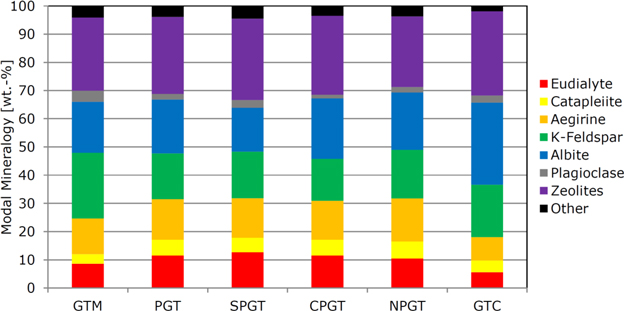
Figure 13-3: ANZAPLAN Modal Mineralogy
 |  |
| | Prefeasibility Study - NI 43-101 - Technical report for the Norra Kärr Rare
Earth Element Deposit - 0465-RPT-014 Rev 0 |
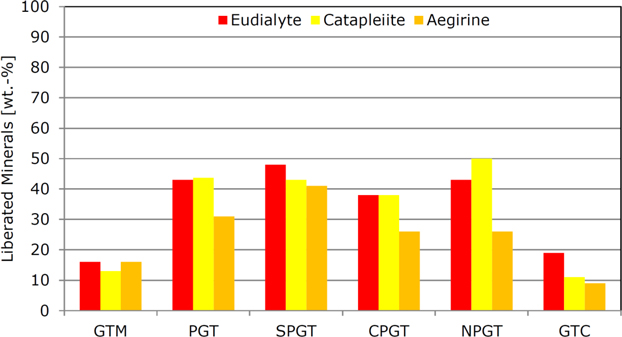
Figure 13-4: Comparison of mineral liberation for samples GTM, PGT, SPGT, CPGT, NPGT and GTC in fraction 0.1 mm to 0.5 mm
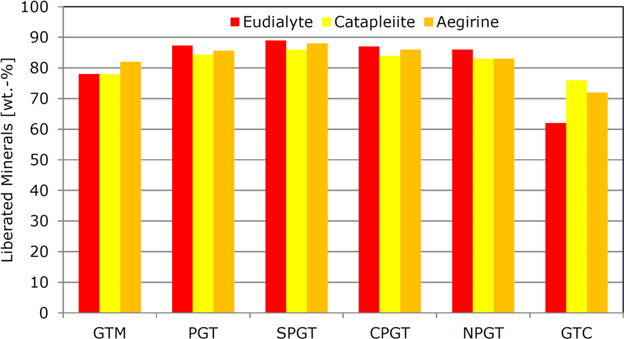
Figure 13-5: Comparison of mineral liberation for samples GTM, PGT, SPGT, CPGT, NPGT and GTC in fraction 0.02 mm to 0.1 mm
 |  |
| | Prefeasibility Study - NI 43-101 - Technical report for the Norra Kärr Rare
Earth Element Deposit - 0465-RPT-014 Rev 0 |
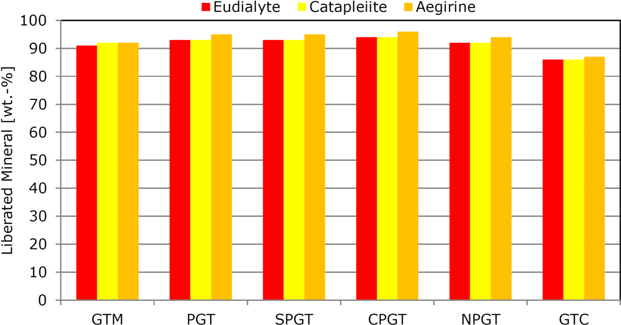
Figure 13-6: Comparison of mineral liberation for samples GTM, PGT, SPGT, CPGT, NPGT and GTC in fraction <0 02 mm
Based on the mineralogical characterisation it was mutually decided that a resource composite would be prepared from each of the potentially economic contributing domains (NPGT, CPGT, SPGT and GTM) on an equal mass basis which would then be subjected to further beneficiation characterisation testwork.
ANZAPLAN investigated several beneficiation methodologies to upgrade the eudialyte including negative flotation of aegirine, magnetic separation, electrostatic separation and gravity separation. The principal outcome of the work identified that magnetic separation alone was sufficient to beneficiate eudialyte and reject much of the acid consuming gangue. A mineral concentrate (ANZCON) was subsequently generated by ANZAPLAN, employing magnetic separation, specifically for use in the development of the hydrometallurgical processes. The exact methodology employed in the preparation of this concentrate deviates from current practice resulting in a concentrate which contained a significant amount of misdeported acid soluble gangue minerals and a characteristically fine particle size. The concentrate was however deemed suitable to begin the leach characterisation testing programme.
At the conclusion of the investigative testing campaign conducted by ANZAPLAN a focussed campaign of testing was initiated with three major original equipment manufacturers (OEM) to conduct machine specific magnetic beneficiation testing with the aim of maximising the recovery of eudialyte whilst rejecting acid consuming gangue. Ground composites were prepared by Loesche at particle sizes within the expected liberation range of 60 µm, 80 µm, and 100 µm. Testing was conducted by
 |  |
| | Prefeasibility Study - NI 43-101 - Technical report for the Norra Kärr Rare
Earth Element Deposit - 0465-RPT-014 Rev 0 |
each of the OEM in-house technical staff in line with their standard operating procedures. This phase of testing clearly identified the Metso high grade material separation (HGMS) as the superior technology to recover eudialyte from Norra Kärr material with respect to gangue rejection and REE recovery (see Figure 13-7 and Figure 13-8 respectively) using a single stage magnetic separation.
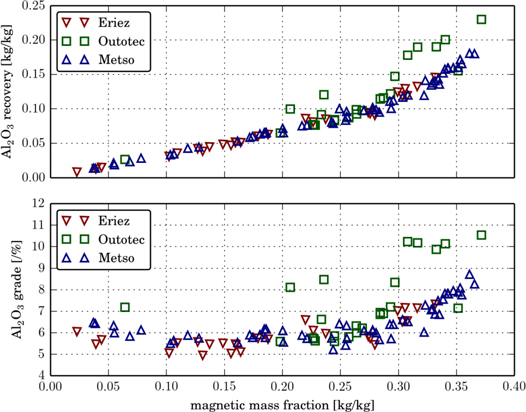
Figure 13-7: Aluminium Grade and Recovery Versus Magnetic Mass Fraction
 |  |
| | Prefeasibility Study - NI 43-101 - Technical report for the Norra Kärr Rare
Earth Element Deposit - 0465-RPT-014 Rev 0 |
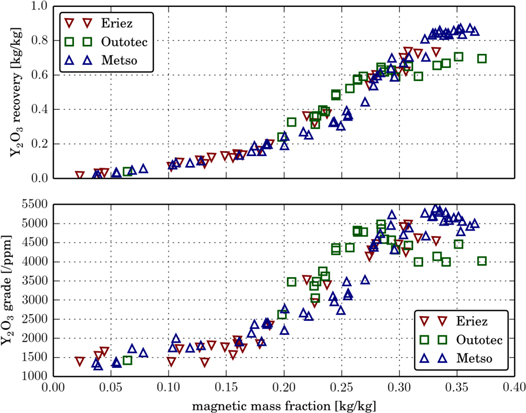
Figure 13-8: Yttrium Grade and Recovery Versus Magnetic Mass Fraction
Additional testing was conducted by GTK, under the supervision of Metso, with GTK’s in-house Metso HGMS machine as part of a repeatability and reproducibility testing campaign. The work conducted by GTK confirmed the results produced by Metso and further confirmed the repeatability of the testing apparatus when separating these weakly magnetic minerals.
In order to supply additional mineral concentrate to hydrometallurgical testwork laboratories GTK were commissioned to conduct several batch-continuous magnetic separation campaigns to generate representative concentrate. The full-scale Metso HGMS has near continuous flexibility when it comes to setting and varying the machines operating parameters including magnetic field intensity, linear flow velocity and matrix load density. However, in the laboratory machine the linear flow velocity can only be set to discrete values limiting the ability to test the optimal set of conditions. The batch-continuous test campaign successfully generated approximately 30 kg of magnetic mineral concentrate, confirmed the batch testing results attained by both Metso and GTK (see Table 13-5) as well as further validating the predictive capability of the mathematical model describing the separation process. Additional analyses of the products identified where recoverable losses were occurring (see Table 13-6). It is apparent that the most significant size fraction reporting losses is in the -20 µm
 |  |
| | Prefeasibility Study - NI 43-101 - Technical report for the Norra Kärr Rare
Earth Element Deposit - 0465-RPT-014 Rev 0 |
fraction. Therefore minimising the production of fine material has become the future objective of the comminution circuit optimisation.
Table 13-5: Selected Results for Batch
| | | Yttrium | | | Yttrium recovery | | | Magnetic mass recovery | |
| Sample ID | | Head grade | | | Measured | | | Predicted | | | Measured | | | Predicted | |
| 11 | | 1 694 | | | 84.7 % | | | 85.4 % | | | 34.2 % | | | 34.5 % | |
| 12 | | 1 691 | | | 84.3 % | | | 85.3 % | | | 33.8 % | | | 34.5 % | |
| 13 | | 1 673 | | | 84.6 % | | | 84.8 % | | | 33.7 % | | | 34.3 % | |
| 14 | | 1 647 | | | 84.7 % | | | 84.1 % | | | 34.7 % | | | 34.0 % | |
| 15 | | 1 663 | | | 83.6 % | | | 84.6 % | | | 33.8 % | | | 34.2 % | |
| Mean | | 1 674 | | | 84.4 % | | | 84.9 % | | | 34.0 % | | | 34.3 % | |
| | | | | | | | | | | | | | | | | | | | | |
Table 13-6: Batch 1 Size-By-Size Yttrium Recovery
| Sample | | Particle size fraction | |
| | | +36 µm | | | +20-36 µm | | | -20 µm | |
| 11 | | 95.6 % | | | 92.5 % | | | 59.2 % | |
| 12 | | 95.4 % | | | 93.8 % | | | 59.0 % | |
| 13 | | 95.4 % | | | 94.1 % | | | 59.8 % | |
| 14 | | 94.9 % | | | 92.8 % | | | 57.6 % | |
| 15 | | 94.7 % | | | 93.7 % | | | 54.6 % | |
| Mean | | 95.2 % | | | 93.4 % | | | 58.1 % | |
| | | | | | | | | | | | | |
ANSTO Minerals (ANSTO Minerals, Australia) were engaged to undertake process testwork to define both the mineral dissolution and solvent extraction process to produce a bulk REE concentrate. ANSTO have proceeded to define the extractive metallurgical process from magnetic concentrate to bulk REE concentrate. The first phase of this definition work was conducted with the ANZCON mineral concentrate generated by ANZAPLAN. As noted this mineral concentrate had a large mass contribution of acid soluble gangue and a smaller particle size relative to the current concentrate preparation. However it is deemed suitable to begin the process of defining suitable leach operating conditions.
The testwork programme implemented by ANSTO was a systematic appraisal of mineral solubility, silica solubility and silica stability as well as monitoring the concentration of deleterious elements in
 |  |
| | Prefeasibility Study - NI 43-101 - Technical report for the Norra Kärr Rare
Earth Element Deposit - 0465-RPT-014 Rev 0 |
preparation of a pregnant leach solution (PLS) to be used for the recovery of REE. This appraisal process explored the solution acidity, leach temperature, and pulp density.
All analytical chemical analyses were conducted by ANSTO for the leach and solvent extraction programmes. The techniques included analysis by X-ray fluorescence (XRF), fusion/digest followed by ICP (-OES and -MS), delayed neutron and neutron activation analysis (DNA and NAA, respectively) all within their facilities in Sydney.
Diagnostic leach tests were conducted to determine the minimum acid activity required to dissolve eudialyte. It was determined that a relatively mild acidic environment, around pH 1, was required to dissolve the eudialyte whilst leaving intact the majority of the accompanying minerals. Additionally, tests were conducted at various temperatures to determine the impact on leaching kinetics and pulp handleability. The results of which indicated that a leach temperature of 30 °C is sufficient to maintain satisfactory leach kinetics and pulp condition. Follow-up tests further examined the mineral solubilities at constant acidities, around the determined range, at various pulp densities to determine the operating limits for silica in solution. When operating at higher pulp densities a threshold limit was exceeded whereby the silica would precipitate from solution causing the pulp to gel. The threshold limit of silica in solution was quantified resulting in an optimal pulp density being determined as approximately 14 % solids on a weight basis. A sub-set of the leaching results are shown in Figure 13-9 and Figure 13-10 which show the leach acid consumption at various pH values and initial pulp densities. It is also evident that a majority of the acid consumption occurs in the first two hours of the leaching process. This correlates strongly with the leach extraction of REE into solution where extraction efficiencies were routinely in excess of 90 %.
Further leaching with concentrate produced by GTK using an optimised beneficiation method focused on the rejection of gangue resulting in the acid consumption decreasing to approximately 250 kg/t (per tonne concentrate). Although the concentrate was prepared from the improved method further mineralogical analyses indicate further improvements in gangue deportment are possible with improvements in the particle size control, in particular the removal of particles greater than 100 µm as these contribute the majority of gangue minerals. This work will form part of ongoing process optimisation testing being planned and conducted by Tasman.
 |  |
| | Prefeasibility Study - NI 43-101 - Technical report for the Norra Kärr Rare
Earth Element Deposit - 0465-RPT-014 Rev 0 |
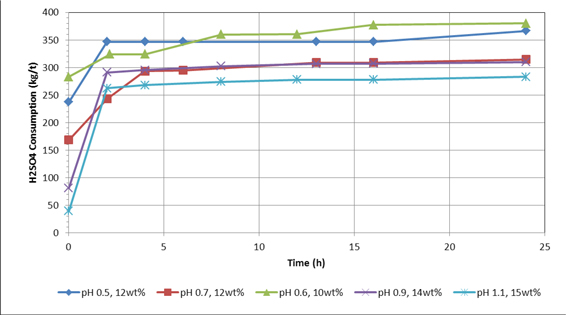
Figure 13-9 Acid consumption
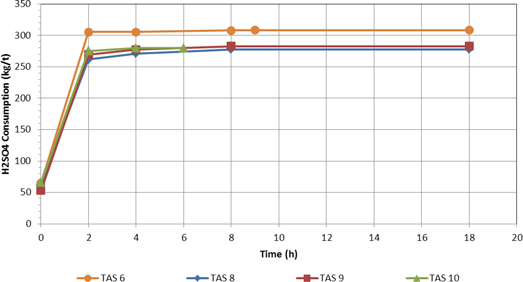
Figure 13-10 Acid consumption
The PLS generated by the sulfuric acid dissolution of the mineral concentrate has a characteristically high silica concentration which is unacceptable for metal recovery by solvent extraction. To remove the silica the pH is increased from the leach condition to a value in excess of pH 3 to destabilise the silica causing it to precipitate. This neutralisation can be conducted by the addition of calcium
 |  |
| | Prefeasibility Study - NI 43-101 - Technical report for the Norra Kärr Rare
Earth Element Deposit - 0465-RPT-014 Rev 0 |
hydroxide or magnesium oxide. Limited testing has been conducted in this area to ensure ease of handling of the residue from the leaching and neutralisation however observations indicated its feasibility. The neutralisation residue, comprised largely of silica and minor contributions of zirconium and aluminium, is then separated from the PLS and washed to recover the entrained solution. The testing to date has reproducibly demonstrated that the neutralisation process is capable of producing a clarified liquor suitable for solvent extraction. Further definition work is planned with ANSTO for the continuous demonstration of the leaching and neutralisation circuits to confirm the handleability and water balance for the circuit. This will involve the further examination of the costs and benefits of using lime, magnesia or the possibility of employing dolomite as the neutralisation agent.
The principal method tested to recover the rare earth elements from the PLS was by means of solvent extraction. ANSTO Minerals conducted the preliminary definition work using a mix of pregnant leach solutions generated as part of the leaching and neutralisation definition programmes. This feed stock was deemed satisfactory for determination of operating conditions and equilibrium and initial engineering of the solvent extraction plant. The programme sought to undertake studies to determine the kinetic and equilibrium phenomenon prevalent in the system. Phase disengagement studies determined that an elevated operating temperature was required to ensure satisfactory phase disengagement behaviour within the system. Kinetic loading studies were also conducted which determined the rate in which equilibrium was attainment was faster than the phase separation kinetics therefore the system design will be dependent upon phase separation kinetics.
Equilibrium loading isotherms were generation by ANSTO utilising a primary amine solvent in order to determine its loading capacity and the likely number of equilibrium stages required to extract the REE’s from the aqueous PLS into the organic solvent. The solvent preferentially loaded the light REE’s relative to the heavy REE’s where yttrium had the lowest affinity (see Figure 13-11 and Figure 13-12). The equilibrium loading work was successful in enabling the determination of the organic to aqueous ratio as well as the number of stages to effect an acceptable level of extraction.
 |  |
| | Prefeasibility Study - NI 43-101 - Technical report for the Norra Kärr Rare
Earth Element Deposit - 0465-RPT-014 Rev 0 |
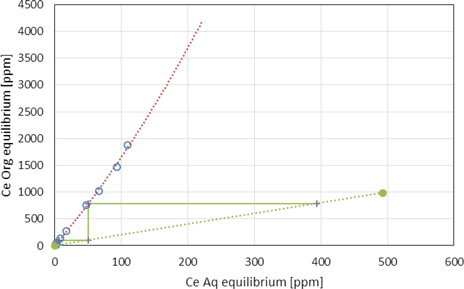
Figure 13-11 Cerium equilibrium loading isotherm
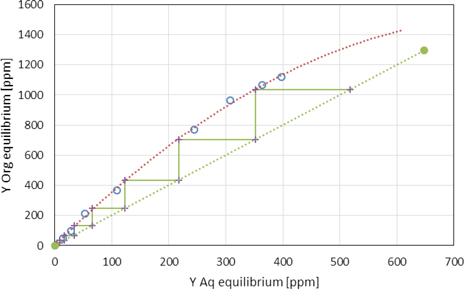
Figure 13-12 Yttrium equilibrium loading isotherm
Finally, the REEs were stripped from the loaded solvent with various concentrated strong acid solutions however the REEs were very strongly complexed with the solvent and resulted in excessive acid requirements in order to achieve satisfactory stripping efficiency. An alternative reactive stripping process was then assessed whereby oxalic acid was contacted with the loaded organic causing the
 |  |
| | Prefeasibility Study - NI 43-101 - Technical report for the Norra Kärr Rare
Earth Element Deposit - 0465-RPT-014 Rev 0 |
formation of a rare earth oxalate precipitate at the interface of the two phases. The resulting precipitate was then separated from the two phases by centrifugation producing a mixed oxalate concentrate. The resulting concentrate was subjected to chemical analyses and the results presented in Table 13-7. The concentrate has a very high REE concentrate with low impurity content. The balance of the assay mass is the oxalate anion and hydration water from the oxalate salts.
Table 13-7 REE oxalate concentrate chemical analyses
| Element | | Weight [/%] | |
| La | | 4.935 | |
| Ce | | 10.750 | |
| Pr | | 1.458 | |
| Nd | | 6.763 | |
| Sm | | 1.650 | |
| Eu | | 0.269 | |
| Gd | | 1.657 | |
| Tb | | 0.351 | |
| Dy | | 2.191 | |
| Ho | | 0.491 | |
| Er | | 1.288 | |
| Tm | | 0.182 | |
| Yb | | 1.138 | |
| Lu | | 0.149 | |
| Y | | 12.210 | |
| Impurity | | 0.171 | |
| TREE | | 45.48 | |
| LREE | | 23.91 | |
| MREE | | 3.58 | |
| HREE | | 18.00 | |
| | | | | |
No testing has been conducted with commercial toll refiners to assess the suitability of the mixed REE concentrate from the current process flowsheet. Close collaboration with the selected toll refining entity is required in further process development activities to ensure the suitability of the process design and confirm the necessary product qualities determined by the refiner.
 |  |
| �� | Prefeasibility Study - NI 43-101 - Technical report for the Norra Kärr Rare
Earth Element Deposit - 0465-RPT-014 Rev 0 |
| 13.3 | Material Issues and Deleterious Elements |
The proposed product from the Norra Kärr project is a mixed rare earth oxide and as such is not subjected to a defined product specification. The product specification is typically defined by the refinery tasked with the separation of the intermediate mixed oxide product from Norra Kärr into the individual metal oxides. Tasman are actively engaged in discussions with several potential refining partners with the aim of establishing a commercial and technical arrangement whereby a product specification will form the basis of any such agreement. Until such time that a specification becomes available general comments regarding the likely deleterious elements is deemed sufficient.
Although the Norra Kärr deposit is characteristically low in both uranium and thorium a full radionuclide deportment study on optimised concentrate has not been undertaken. As part of future testwork campaigns a radionuclide deportment study should form part of the programme in order to define where the parent and daughter nuclides deport to within the process to ensure there are no extraordinary control measures required. Additionally, particular attention is required to assess the deportment of lead within the process as this is likely to be the subject of environmental controls.
Comminution with conventional crushing and grinding techniques will be suitable for the process. Further testing on domain specific material should be undertaken to determine the variability, if any, of the resource as defined by this PFS. Extensive analysis and modelling of the magnetic beneficiation process has indicated the importance of minimising the production of fine material less than 20 µm as recovery performance deteriorates significantly. Equally important is the reduction of particles larger than 100 µm as these particles carry much of the acid consuming gangue into the mineral concentrate. It is therefore recommended that a wet screening process be employed in the grinding circuit to minimise over grinding and eliminate large particles.
Continuous piloting of the hydrometallurgical processes (leach, neutralisation, solvent extraction and precipitation) are required to fully determine the product quality, deportment of radionuclides and improve the accuracy of the utility demand and reagent consumptions. The implementation of the continuous testing will also provide an opportunity to optimise the process with respect to the items above. The focus of future testing should address handleability of pulp, liquors and residues as well as the potential substitution of various reagents to the process economics.
Finally, to date no integrated testing has been performed on the raffinate management system. This system requires further testing and engineering for inclusion into any future feasibility study to confirm its feasibility as well as accurately estimate utility and reagent costs.
 |  |
| | Prefeasibility Study - NI 43-101 - Technical report for the Norra Kärr Rare
Earth Element Deposit - 0465-RPT-014 Rev 0 |
| Section 14 | Mineral Resource Estimates |
| 14.1 | Current Estimate WAI (2014) |
This section describes the Mineral Resource estimation methodology used by WAI for the Mineral Resource estimate of the Norra Kärr deposit. The effective date of the Mineral Resource estimate is 30 June 2014.
WAI were commissioned to produce a Mineral Resource estimate for the Nora Kärr project. The Mineral Resource estimate for the Norra Kärr project has been carried out following the guidelines of the CIM Code. The Mineral Resource estimation was completed using a 3D block modelling approach utilising CAE Mining Studio 3® software.
A high resolution LIDAR topographic survey was provided to WAI in AutoCAD dwg format. WAI has trimmed the topographic data to cover only the area of interest so as to make the topographic data file easier to manage. The Norra Kärr project is a greenfield site and as such there are no operating pits in the area and the topography is valid as of 30 June 2014. Figure 14-1 shows the topographic contours for the project area as well as the distribution of exploration drill holes.
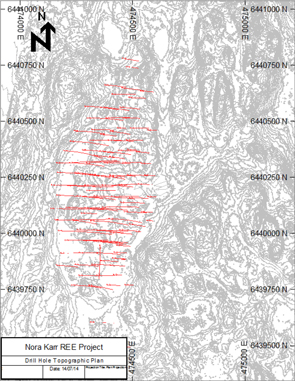
Figure 14-1: Drill Hole Layout and Topographic Plan (WAI, 2014)
 |  |
| | Prefeasibility Study - NI 43-101 - Technical report for the Norra Kärr Rare
Earth Element Deposit - 0465-RPT-014 Rev 0 |
WAI was supplied with a geological database (Tasman_WAI.mdb) in Microsoft Access® format with an effective date of 6 May 2014. The database comprises:
| · | Diamond drill hole collar surveys in both RT90 and SWEREF99TM co-ordinate systems; |
| · | Density testwork results by drill hole interval and lithology; and |
A summary of the sample data provided in the database and subsequently used in the Mineral Resource estimate is shown below in Table 14-1.
Table 14-1: Sample Data Summary
| Sample Type | | No. Holes | | | No. of Samples | | | Total Length (m) | |
| Diamond Drill Holes | | 119 | | | 9 986 | | | 20 420.33 | |
| | | | | | | | | | | | | |
Drilling to date extends over a strike length of approximately 1 280 m with drill hole section lines orientated east-west on typically 50 m spacing. The distribution of drill holes along the section lines is typically 80 m with drill holes drilled inclined to the east (with the exception of five drill holes; NQ12019, NQ12015, NKA12083, NKA12082, and NKA074-GT1) with an average inclination of 48°. A plan showing the spatial distribution of the diamond drill holes is shown in Figure 14-1, a long section of the drill hole distribution looking towards the west is provided in Figure 14-2.
 |  |
| | Prefeasibility Study - NI 43-101 - Technical report for the Norra Kärr Rare
Earth Element Deposit - 0465-RPT-014 Rev 0 |
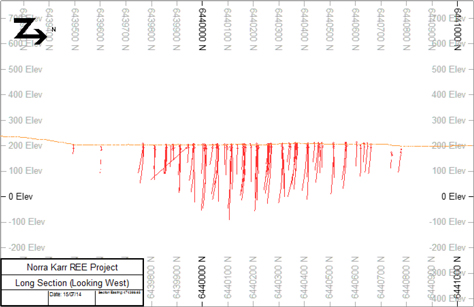
Figure 14-2: Long Section of Norra Kärr Drill Holes, Easting Line 474398.65
| 14.4 | Geological Interpretation-Wireframe Modelling |
Wireframes to represent the Norra Kärr alkaline igneous intrusive body and associated REE mineralisation was constructed by WAI based on the geological logging carried out by Tasman. WAI was provided with geological cross sections and plans by Tasman showing the interpreted structure based on the detailed lithology logs, geochemical assay results and the foliation measurements.
In total WAI has defined six key lithologies for wireframing and subsequent modelling, these being:
| · | LTYPE 1 (KAX) – Kaxtorpite (Microcline-Pectolite-Amphibole-Aegerine-Nepheline Syenite); |
| · | LTYPE 2 (GTM) – Migmatitic Grennaite (Recrystallised to in part migmatitic); |
| · | LTYPE 3 (PGT/GT) – Grennaite with pegmatititc zones and Grennaite (fine-grained aegerine rich nepheline syenite); |
| · | LTYPE 4 (GTC) – Grennaite (Catapleiite porphyritic – low grade TREO); |
| · | LTYPE 5 (ELAK) – Lakarpite with eudialyte; and |
| · | LTYPE 6 (MAF) – Mafic dyke material. |
The lithology units LTYPES 2 to 4 do not reflect distinct individual units but observe more diffuse boundaries. Where there is uncertainty in the recording of a lithological unit Tasman has reviewed the geochemical assay results to ascertain where the transition occurs.
Within the geological database provided to WAI there are sub-divisions of the six main lithology groups. Due to the diffuse nature of LTYPES 2 to 4 and the complexity of the geology it was decided
 |  |
| | Prefeasibility Study - NI 43-101 - Technical report for the Norra Kärr Rare
Earth Element Deposit - 0465-RPT-014 Rev 0 |
by Tasman and WAI that the level of detail in the six lithology divisions was sufficient for a Mineral Resource model, and that there is little benefit in modelling in greater detail.
As well as the six main lithologies Tasman has also logged additional units at the periphery of the mineralisation which are not of economic interest, these units comprising:
| · | Pulaskite (Microcline-Albite-Amphibole Nepheline Syenite); |
| · | Pulaskite (with Grennaite zones/bands); |
| · | Alkaline rock (Unspecified); and |
| · | Granitoide (fenitisied). |
These additional lithological units are not of economic interest and as such for the purpose of the Mineral Resource estimate have not been modelled.
Upon completion of a preliminary set of mineralisation wireframes, WAI submitted the wireframes to Tasman geologists for review. Following the review WAI and Tasman geologists worked through the wireframes and geological sections adjusting the wireframes where necessary to ensure they honoured the geology. Figure 14-3 shows the Tasman interpreted geological cross section along northing line 6440409.46 showing the various lithology units. A corresponding geological section from the WAI mineralisation wireframes is shown in Figure 14-4.
 |  |
| | Prefeasibility Study - NI 43-101 - Technical report for the Norra Kärr Rare
Earth Element Deposit - 0465-RPT-014 Rev 0 |
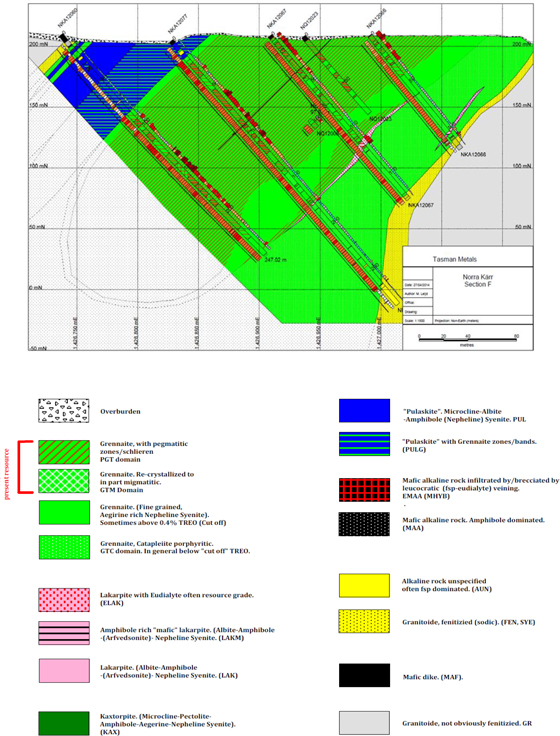
Figure 14-3: Tasman Geological Interpretation Cross Section – Northing 6440409.46
 |  |
| | Prefeasibility Study - NI 43-101 - Technical report for the Norra Kärr Rare
Earth Element Deposit - 0465-RPT-014 Rev 0 |
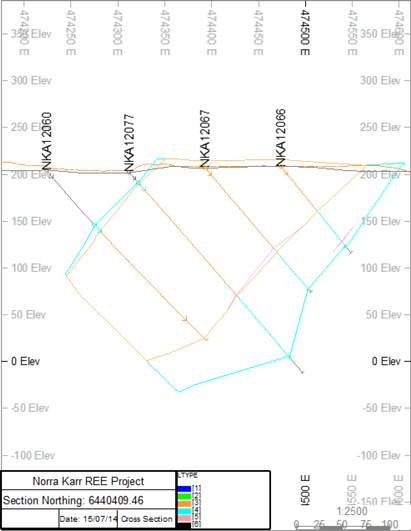
Figure 14-4: WAI Mineralised Wireframe Cross Section – Northing 6440409.46 (SWEREF99TM)
The geological database provided to WAI includes a record of the depth of overburden. WAI has created a digital terrain model surface of the base of overburden and used this to constrain mineralisation. A long section of the WAI mineralisation wireframes is shown in Figure 14-5.
 |  |
| | Prefeasibility Study - NI 43-101 - Technical report for the Norra Kärr Rare
Earth Element Deposit - 0465-RPT-014 Rev 0 |

Figure 14-5: WAI Mineralisation Wireframes Longsection – Looking West
| 14.5 | Sample Data Processing |
The geological wireframes were used to select the drill hole sample data. The selected sample data was coded according to lithology to correspond with the wireframe envelope LTYPE codes (see Section 14.4). A summary of the selected sample data by LTYPE is shown in Table 14-2.
Table 14-2: Selected Sample Summary by LTYPE
| LTYPE | | No. of holes | | No. of samples | | | Total length (m) | |
| 1 | | 22 | | | 461 | | | | 803.59 | |
| 2 | | 42 | | | 1340 | | | | 2 422.53 | |
| 3 | | 85 | | | 4895 | | | | 8 498.79 | |
| 4 | | 95 | | | 2134 | | | | 3 808.425 | |
| 5 | | 42 | | | 266 | | | | 414.74 | |
| 6 | | 4 | | | 31 | | | | 40.35 | |
 |  |
| | Prefeasibility Study - NI 43-101 - Technical report for the Norra Kärr Rare
Earth Element Deposit - 0465-RPT-014 Rev 0 |
WAI has undertaken a graphical review of the sample data for all elements including the 11 main payable elements:
The graphical review was to ascertain the grade populations of each lithology and ascertain the need for additional domaining and the potential for top-cutting of the sample dataset. Figure 14-6 and Figure 14-7 show the variogram grade distributions for Dy and Y in LTYPES 2 to 5. Overall LTYPES 2, 3, and 4 show normal distributions with some positive skew suggesting that additional domaining is not required but there may be a requirement for top-cutting to prevent high grade outlier bias.
LTYPES 5 and 6 show more log normal grade distributions with possible sub populations necessitating domaining. However, in the case of LTYPE 5 the variable grade population is reflective of the different lenses of ELAK material through the deposit. During the course of the estimation works these ELAK zones are treated separately of each other effectively sub-domaining the LTYPE 5 (ELAK) material. The very low number of samples in LTYPE 6 (MAF) means that it is impossible to discern sub-populations, and as such no additional domaining of this material has been carried out.
LTYPE 1 displays a log normal trend for the sample data with a slight negative skew. In reviewing the data WAI determined that no additional domaining was required.
 |  |
| | Prefeasibility Study - NI 43-101 - Technical report for the Norra Kärr Rare
Earth Element Deposit - 0465-RPT-014 Rev 0 |
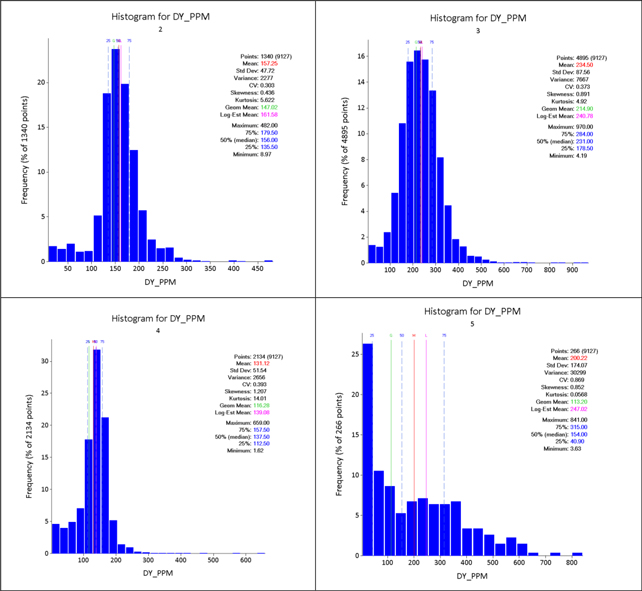
Figure 14-6: Dy Histogram Plots for LTYPES 2 to 5
 |  |
| | Prefeasibility Study - NI 43-101 - Technical report for the Norra Kärr Rare
Earth Element Deposit - 0465-RPT-014 Rev 0 |
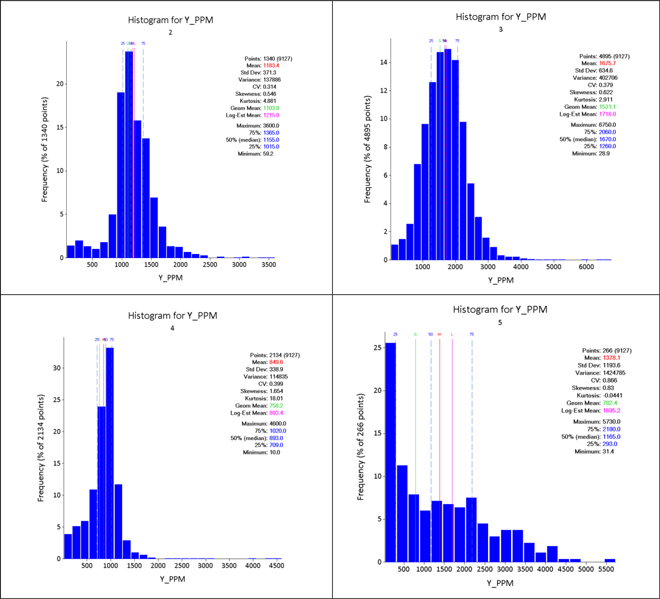
Figure 14-7: Y Histogram Plots for LTYPES 2 to 5
The presence of high grade outliers in a sample dataset can exert a bias on a grade estimation leading to overestimation of grades in the block model. To help ascertain the presence of high grade outliers in the selected Norra Kärr sample database WAI undertook a decile analysis and compared the results to the grade distribution plots as shown in Figure 14-6 and Figure 14-7. An example table of results for a decile analysis is shown in Table 14-3.
 |  |
| | Prefeasibility Study - NI 43-101 - Technical report for the Norra Kärr Rare
Earth Element Deposit - 0465-RPT-014 Rev 0 |
Table 14-3: Decile Analysis – Sm LTYPE 4
Quantile %
FROM | | | Quantile %
TO | | | No of
Samples | | | MEAN
(ppm) | | | MIN (ppm) | | | MAX (ppm) | | | METAL | | | METAL% | |
| | 0 | | | | 10 | | | | 213 | | | | 14.31 | | | | 1.66 | | | | 26.4 | | | | 3 048.82 | | | | 2.26 | |
| | 10 | | | | 20 | | | | 213 | | | | 36.76 | | | | 26.6 | | | | 46.4 | | | | 7 830.5 | | | | 5.79 | |
| | 20 | | | | 30 | | | | 214 | | | | 51.12 | | | | 46.4 | | | | 55.2 | | | | 10 938.8 | | | | 8.09 | |
| | 30 | | | | 40 | | | | 213 | | | | 58.41 | | | | 55.2 | | | | 61.4 | | | | 12 441 | | | | 9.21 | |
| | 40 | | | | 50 | | | | 214 | | | | 63.85 | | | | 61.4 | | | | 65.8 | | | | 13 664 | | | | 10.11 | |
| | 50 | | | | 60 | | | | 213 | | | | 68.40 | | | | 65.8 | | | | 70.7 | | | | 14 568.3 | | | | 10.78 | |
| | 60 | | | | 70 | | | | 213 | | | | 72.75 | | | | 70.7 | | | | 74.7 | | | | 15 495.6 | | | | 11.47 | |
| | 70 | | | | 80 | | | | 214 | | | | 76.78 | | | | 74.7 | | | | 79.1 | | | | 16 430 | | | | 12.16 | |
| | 80 | | | | 90 | | | | 213 | | | | 82.48 | | | | 79.2 | | | | 86.6 | | | | 17 567.5 | | | | 13.00 | |
| | 90 | | | | 100 | | | | 214 | | | | 108.26 | | | | 86.8 | | | | 335 | | | | 23 168.1 | | | | 17.14 | |
| | 90 | | | | 91 | | | | 21 | | | | 87.45 | | | | 86.8 | | | | 88.1 | | | | 1 836.5 | | | | 1.36 | |
| | 91 | | | | 92 | | | | 21 | | | | 88.48 | | | | 88.1 | | | | 89 | | | | 1 858.1 | | | | 1.37 | |
| | 92 | | | | 93 | | | | 22 | | | | 89.79 | | | | 89.1 | | | | 90.4 | | | | 1 975.3 | | | | 1.46 | |
| | 93 | | | | 94 | | | | 21 | | | | 91.11 | | | | 90.4 | | | | 91.8 | | | | 1 913.3 | | | | 1.42 | |
| | 94 | | | | 95 | | | | 22 | | | | 92.89 | | | | 91.9 | | | | 94.2 | | | | 2 043.6 | | | | 1.51 | |
| | 95 | | | | 96 | | | | 21 | | | | 95.59 | | | | 94.4 | | | | 97.7 | | | | 2 007.4 | | | | 1.49 | |
| | 96 | | | | 97 | | | | 21 | | | | 100.19 | | | | 97.8 | | | | 104 | | | | 2 103.9 | | | | 1.56 | |
| | 97 | | | | 98 | | | | 22 | | | | 110.43 | | | | 104.5 | | | | 117 | | | | 2 429.5 | | | | 1.80 | |
| | 98 | | | | 99 | | | | 21 | | | | 128.38 | | | | 119 | | | | 142 | | | | 2 696 | | | | 1.99 | |
| | 99 | | | | 100 | | | | 22 | | | | 195.66 | | | | 142 | | | | 335 | | | | 4 304.5 | | | | 3.18 | |
| | 0 | | | | 100 | | | | 2 134 | | | | 63.33 | | | | 1.66 | | | | 335 | | | | 135 152.6 | | | | 100 | |
In reviewing the decile analysis WAI assess whether there is a jump in the proportion of contained metal in the top 1 % (Quantile 99 % - 100 %) of the sample data, such jumps in the grade distribution are also often visible in the grade distribution histograms and probability plots. Such inflections signify possible high grade outliers that may bias the grade estimation.
In general there are very few outlier grades that may present an issue during the variography or grade estimation stages, those that presented a problem have been top-cut and a summary of these is shown in Table 14-4.
 |  |
| | Prefeasibility Study - NI 43-101 - Technical report for the Norra Kärr Rare
Earth Element Deposit - 0465-RPT-014 Rev 0 |
Table 14-4: Norra Kärr Top-Cut Summary
| LTYPE | | | Element | | Top-Cut (ppm) | |
| 4 | | | Eu | | 27.5 | |
| 2 | | | Gd | | 288.0 | |
| 3 | | | Gd | | 472.0 | |
| 4 | | | Gd | | 282.0 | |
| 4 | | | Ho | | 112.0 | |
| 5 | | | Lu | | 66.4 | |
| 4 | | | Sm | | 222.0 | |
| 3 | | | Sm | | 481.0 | |
| 4 | | | Tb | | 63.1 | |
| 5 | | | Tm | | 67.3 | |
| 4 | | | Yb | | 341.0 | |
| 5 | | | Yb | | 495.0 | |
| | | | | | | | | |
Any absent assay values within the sample database have been assigned grades of half the analytical detection limit.
To ensure all samples in the variography and grade estimation stages have equal support the sample data was composited. The sample dataset was reviewed for sample length to ascertain the optimum sample composite interval. An average composite length of 2 m was applied to sample data for all lithologies (LTYPE) corresponding with the median sample length. Figure 14-8 shows the sample length distribution.
 |  |
| | Prefeasibility Study - NI 43-101 - Technical report for the Norra Kärr Rare
Earth Element Deposit - 0465-RPT-014 Rev 0 |
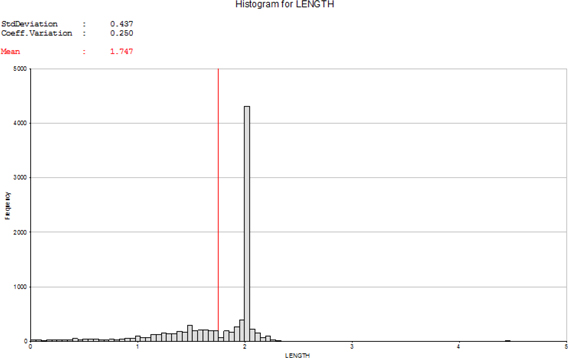
Figure 14-8: Average Sample Length Histogram
Variography was undertaken:
| · | To determine the presence of any anisotropy in the deposit; |
| · | To derive the spatial continuity of mineralisation along the principal main anisotropic orientations; |
| · | To produce suitable variogram model parameters for use in geostatistical grade interpolation; and |
| · | To assist in selection of suitable search parameters upon which to base the resource estimation. |
Variographic analysis was performed using Supervisor v8.2 software. Semi-variogram analysis was attempted for each variable in each domain.
 |  |
| | Prefeasibility Study - NI 43-101 - Technical report for the Norra Kärr Rare
Earth Element Deposit - 0465-RPT-014 Rev 0 |
Semi-variogram analysis was attempted for 20 components in each of the six mineralised domains using the 2 m composited samples contained within the mineralised domain wireframes.
The methodology for producing experimental variograms and variogram models was as follows:
| · | Experimental variograms with small lag distances were generated downhole to aid in estimation of nugget effect. Nugget effect is the variance between sample pairs at the same direction containing components of inherent variability, sampling error and analytical error; |
| · | Omni-directional variograms were generated to assist with determining optimal lag distances; |
| · | Variogram maps were generated in 18 directions in the horizontal plane, across strike and in the dip plane at each stage selecting the direction of greatest continuity; and |
| · | Experimental variograms were generated and variogram models fitted using the spherical scheme for three orthogonal directions defining the principal directions of anisotropy; the major, semi-major and minor axis. |
| 14.6.3 | Variogram Interpretation |
During this process it was found that the Kaxtorpite (LTYPE 1) and Lakarpite (LTYPE 5) did not contain enough sample pairs to calculate robust directional experimental variograms and so for these zones only omni-directional variogram models were fitted. For the mafic dykes (LTYPE 6) not enough sample pairs were present for any meaningful experimental variograms to be interpreted. For all other zones; Grennaite (LTYPE 2), Grennaite with pegamtitic zones (LTYPE 3) and porphyritic Grennaite (LTYPE 4) enough sample pairs were present to generate robust directional experimental variograms for which models were fitted. It was found that as a result of the good positive correlation between most components that experimental variograms were quite similar for a lot of the individual components. Regardless of this individual variogram models were completed for each component in each zone.
An example of the process is shown for Dy in the porphyritic Grennaite (LTYPE 4) in Figure 14-9, which shows the initial continuity map analysis for the horizontal plane and the down dip plane. On these continuity maps, the lower the value, the greater the continuity with values >1 indicating no continuity. Variogram maps were constructed measuring continuity in 18 directions for the horizontal plane, across strike and down dip planes. At each stage lag distances were varied and experimental variograms were assessed in each direction to determine the directions of greatest continuity.
 |  |
| | Prefeasibility Study - NI 43-101 - Technical report for the Norra Kärr Rare
Earth Element Deposit - 0465-RPT-014 Rev 0 |
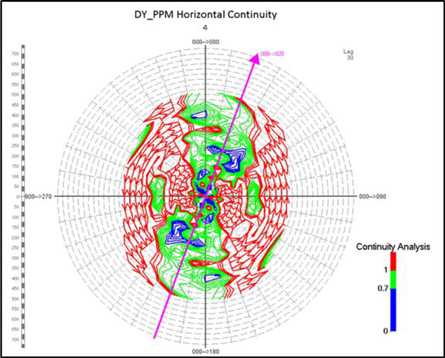
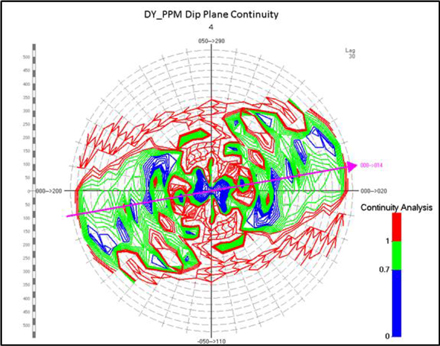
Figure 14-9: Continuity Maps of Dy for the Porphyritic Grennaite (LTYPE=4). Horizontal Continuity (Top) and Dip Plane Continuity (Bottom)
 |  |
| | Prefeasibility Study - NI 43-101 - Technical report for the Norra Kärr Rare
Earth Element Deposit - 0465-RPT-014 Rev 0 |
Figure 14-10 shows the variogram models for Dy for the porphyritic Grennaite (LTYPE 4). When calculating the experimental variograms variable lag distances were used to reflect the varying drillhole spacing in different orientations for the different domains. For downhole variograms a lag distance of 2 m was used, equal to composite length.
Directional anisotropy is seen in all cases where robust experimental variograms can be calculated. Zonal anisotropy is seen for some elements and the models are fitted appropriately. The experimental variograms are, in general, reasonably well structured with large ranges along strike. The nugget values are generally seen to be low reflecting that, at short ranges, little variation is seen.
The spherical model scheme was used for all variables. Variogram models were created for each variable for each domain. A summary of the variogram models is shown in Table 14-5.
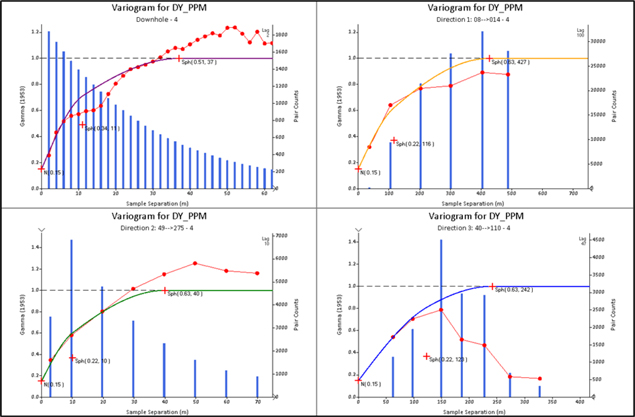
Figure 14-10: Variogram Models for Dy – Porphyritic Grennaite (LTYPE=4)
 |  |
| | Prefeasibility Study - NI 43-101 - Technical report for the Norra Kärr Rare
Earth Element Deposit - 0465-RPT-014 Rev 0 |
Table 14-5: Summary of Variogram Models
| Domain | | Element | | Rotation Angles
(Z,X,Z) | | Nugget | | | Range
1 | | | Range
2 | | | Range
3 | | | C1§ | | | Range
1 | | | Range
2 | | | Range
3 | | | C2§ | | | Range
1 | | | Range
2 | | | Range
3 | | | C3§ | |
| 1 | | DY | | Omni-directional | | | 0.06 | | | | 6 | | | | 6 | | | | 6 | | | | 0.47 | | | | 35 | | | | 35 | | | | 35 | | | | 0.47 | | | | - | | | | - | | | | - | | | | - | |
| 1 | | Y | | Omni-directional | | | 0.09 | | | | 10 | | | | 10 | | | | 10 | | | | 0.51 | | | | 37 | | | | 37 | | | | 37 | | | | 0.4 | | | | - | | | | - | | | | - | | | | - | |
| 1 | | EU | | Omni-directional | | | 0.08 | | | | 9 | | | | 9 | | | | 9 | | | | 0.46 | | | | 40 | | | | 40 | | | | 40 | | | | 0.46 | | | | - | | | | - | | | | - | | | | - | |
| 1 | | LA | | Omni-directional | | | 0.09 | | | | 8 | | | | 8 | | | | 8 | | | | 0.27 | | | | 39 | | | | 39 | | | | 39 | | | | 0.4 | | | | 65 | | | | 65 | | | | 65 | | | | 0.24 | |
| 1 | | ND | | Omni-directional | | | 0.07 | | | | 8 | | | | 8 | | | | 8 | | | | 0.33 | | | | 35 | | | | 35 | | | | 35 | | | | 0.6 | | | | - | | | | - | | | | - | | | | - | |
| 1 | | CE | | Omni-directional | | | 0.09 | | | | 9 | | | | 9 | | | | 9 | | | | 0.31 | | | | 37 | | | | 37 | | | | 37 | | | | 0.39 | | | | 90 | | | | 90 | | | | 90 | | | | 0.21 | |
| 1 | | ER | | Omni-directional | | | 0.09 | | | | 10 | | | | 10 | | | | 10 | | | | 0.49 | | | | 38 | | | | 38 | | | | 38 | | | | 0.42 | | | | - | | | | - | | | | - | | | | - | |
| 1 | | GD | | Omni-directional | | | 0.1 | | | | 9 | | | | 9 | | | | 9 | | | | 0.43 | | | | 37 | | | | 37 | | | | 37 | | | | 0.47 | | | | - | | | | - | | | | - | | | | - | |
| 1 | | HO | | Omni-directional | | | 0.09 | | | | 9 | | | | 9 | | | | 9 | | | | 0.46 | | | | 37 | | | | 37 | | | | 37 | | | | 0.45 | | | | - | | | | - | | | | - | | | | - | |
| 1 | | LU | | Omni-directional | | | 0.08 | | | | 10 | | | | 10 | | | | 10 | | | | 0.51 | | | | 39 | | | | 39 | | | | 39 | | | | 0.41 | | | | - | | | | - | | | | - | | | | - | |
| 1 | | PR | | Omni-directional | | | 0.17 | | | | 9 | | | | 9 | | | | 9 | | | | 0.31 | | | | 44 | | | | 44 | | | | 44 | | | | 0.26 | | | | 80 | | | | 80 | | | | 80 | | | | 0.26 | |
| 1 | | SM | | Omni-directional | | | 0.08 | | | | 9 | | | | 9 | | | | 9 | | | | 0.43 | | | | 38 | | | | 38 | | | | 38 | | | | 0.49 | | | | - | | | | - | | | | - | | | | - | |
| 1 | | TB | | Omni-directional | | | 0.08 | | | | 9 | | | | 9 | | | | 9 | | | | 0.48 | | | | 40 | | | | 40 | | | | 40 | | | | 0.44 | | | | - | | | | - | | | | - | | | | - | |
| 1 | | TM | | Omni-directional | | | 0.08 | | | | 10 | | | | 10 | | | | 10 | | | | 0.48 | | | | 44 | | | | 44 | | | | 44 | | | | 0.37 | | | | - | | | | - | | | | - | | | | - | |
| 1 | | YB | | Omni-directional | | | 0.09 | | | | 10 | | | | 10 | | | | 10 | | | | 0.52 | | | | 40 | | | | 40 | | | | 40 | | | | 0.39 | | | | - | | | | - | | | | - | | | | - | |
| 2 | | DY | | -70,60,10 | | | 0.11 | | | | 73 | | | | 105 | | | | 8 | | | | 0.21 | | | | 221 | | | | 135 | | | | 65 | | | | 0.37 | | | | 240 | | | | 172 | | | | 9 999 | | | | 0.31 | |
| 2 | | Y | | -70,60,10 | | | 0.11 | | | | 215 | | | | 114 | | | | 18 | | | | 0.3 | | | | 219 | | | | 148 | | | | 120 | | | | 0.37 | | | | 222 | | | | 161 | | | | 9 999 | | | | 0.22 | |
| 2 | | EU | | -70,60,10 | | | 0.07 | | | | 76 | | | | 119 | | | | 22 | | | | 0.24 | | | | 229 | | | | 120 | | | | 100 | | | | 0.39 | | | | 234 | | | | 120 | | | | 9 999 | | | | 0.3 | |
| 2 | | LA | | -70,60,10 | | | 0.17 | | | | 122 | | | | 60 | | | | 8 | | | | 0.38 | | | | 164 | | | | 119 | | | | 50 | | | | 0.45 | | | | - | | | | - | | | | - | | | | - | |
| 2 | | ND | | -70,60,10 | | | 0.08 | | | | 78 | | | | 97 | | | | 14 | | | | 0.29 | | | | 174 | | | | 98 | | | | 95 | | | | 0.46 | | | | 185 | | | | 109 | | | | 9 999 | | | | 0.17 | |
 |  |
| | Prefeasibility Study - NI 43-101 - Technical report for the Norra Kärr Rare
Earth Element Deposit - 0465-RPT-014 Rev 0 |
| Domain | | Element | | Rotation Angles
(Z,X,Z) | | Nugget | | | Range
1 | | | Range
2 | | | Range
3 | | | C1§ | | | Range
1 | | | Range
2 | | | Range
3 | | | C2§ | | | Range
1 | | | Range
2 | | | Range
3 | | | C3§ | |
| 2 | | CE | | -70,60,10 | | | 0.11 | | | | 192 | | | | 44 | | | | 13 | | | | 0.4 | | | | 200 | | | | 100 | | | | 100 | | | | 0.49 | | | | - | | | | - | | | | - | | | | - | |
| 2 | | ER | | -70,60,10 | | | 0.11 | | | | 74 | | | | 99 | | | | 10 | | | | 0.29 | | | | 153 | | | | 104 | | | | 50 | | | | 0.38 | | | | 200 | | | | 120 | | | | 9 999 | | | | 0.22 | |
| 2 | | GD | | -70,60,10 | | | 0.06 | | | | 165 | | | | 63 | | | | 17 | | | | 0.38 | | | | 173 | | | | 110 | | | | 100 | | | | 0.3 | | | | 179 | | | | 111 | | | | 9 999 | | | | 0.26 | |
| 2 | | HO | | -70,60,10 | | | 0.13 | | | | 115 | | | | 112 | | | | 11 | | | | 0.26 | | | | 166 | | | | 113 | | | | 40 | | | | 0.32 | | | | 179 | | | | 130 | | | | 9 999 | | | | 0.29 | |
| 2 | | LU | | -70,60,10 | | | 0.14 | | | | 115 | | | | 55 | | | | 5 | | | | 0.27 | | | | 131 | | | | 102 | | | | 41 | | | | 0.59 | | | | - | | | | - | | | | - | | | | - | |
| 2 | | PR | | -70,60,10 | | | 0.1 | | | | 85 | | | | 97 | | | | 14 | | | | 0.28 | | | | 200 | | | | 115 | | | | 100 | | | | 0.62 | | | | - | | | | - | | | | - | | | | - | |
| 2 | | SM | | -70,60,10 | | | 0.1 | | | | 179 | | | | 90 | | | | 21 | | | | 0.24 | | | | 226 | | | | 104 | | | | 100 | | | | 0.41 | | | | 235 | | | | 110 | | | | 9 999 | | | | 0.25 | |
| 2 | | TB | | -70,60,10 | | | 0.1 | | | | 180 | | | | 30 | | | | 9 | | | | 0.11 | | | | 215 | | | | 83 | | | | 45 | | | | 0.41 | | | | 221 | | | | 106 | | | | 9 999 | | | | 0.38 | |
| 2 | | TM | | -70,60,10 | | | 0.14 | | | | 92 | | | | 30 | | | | 9 | | | | 0.26 | | | | 168 | | | | 91 | | | | 40 | | | | 0.42 | | | | 194 | | | | 97 | | | | 9 999 | | | | 0.18 | |
| 2 | | YB | | -70,60,10 | | | 0.14 | | | | 92 | | | | 30 | | | | 9 | | | | 0.26 | | | | 168 | | | | 105 | | | | 40 | | | | 0.42 | | | | 194 | | | | 107 | | | | 9 999 | | | | 0.18 | |
| 3 | | DY | | 90,50,0 | | | 0.14 | | | | 90 | | | | 8 | | | | 93 | | | | 0.21 | | | | 185 | | | | 50 | | | | 94 | | | | 0.37 | | | | 450 | | | | 9 999 | | | | 9 999 | | | | 0.28 | |
| 3 | | Y | | 90,50,0 | | | 0.12 | | | | 58 | | | | 14 | | | | 93 | | | | 0.27 | | | | 348 | | | | 75 | | | | 100 | | | | 0.35 | | | | 350 | | | | 9 999 | | | | 9 999 | | | | 0.26 | |
| 3 | | EU | | 90,50,0 | | | 0.1 | | | | 118 | | | | 11 | | | | 82 | | | | 0.23 | | | | 237 | | | | 82 | | | | 96 | | | | 0.37 | | | | 261 | | | | 9 999 | | | | 9 999 | | | | 0.3 | |
| 3 | | LA | | 90,50,0 | | | 0.06 | | | | 77 | | | | 8 | | | | 33 | | | | 0.11 | | | | 227 | | | | 54 | | | | 62 | | | | 0.36 | | | | 228 | | | | 9 999 | | | | 9 999 | | | | 0.47 | |
| 3 | | ND | | 90,50,0 | | | 0.07 | | | | 90 | | | | 6 | | | | 52 | | | | 0.15 | | | | 212 | | | | 97 | | | | 169 | | | | 0.43 | | | | 263 | | | | 9 999 | | | | 9 999 | | | | 0.35 | |
| 3 | | CE | | 90,50,0 | | | 0.08 | | | | 90 | | | | 12 | | | | 23 | | | | 0.12 | | | | 218 | | | | 78 | | | | 178 | | | | 0.45 | | | | 219 | | | | 9 999 | | | | 9 999 | | | | 0.35 | |
| 3 | | ER | | 90,50,0 | | | 0.14 | | | | 90 | | | | 8 | | | | 89 | | | | 0.21 | | | | 145 | | | | 55 | | | | 110 | | | | 0.44 | | | | 335 | | | | 9 999 | | | | 9 999 | | | | 0.21 | |
| 3 | | GD | | 90,50,0 | | | 0.1 | | | | 90 | | | | 11 | | | | 96 | | | | 0.22 | | | | 280 | | | | 76 | | | | 117 | | | | 0.38 | | | | 348 | | | | 9 999 | | | | 9 999 | | | | 0.3 | |
| 3 | | HO | | 90,50,0 | | | 0.14 | | | | 51 | | | | 8 | | | | 93 | | | | 0.21 | | | | 170 | | | | 48 | | | | 94 | | | | 0.37 | | | | 402 | | | | 9 999 | | | | 9 999 | | | | 0.28 | |
| 3 | | LU | | 90,50,0 | | | 0.11 | | | | 57 | | | | 8 | | | | 93 | | | | 0.24 | | | | 170 | | | | 50 | | | | 120 | | | | 0.46 | | | | 324 | | | | 9 999 | | | | 9 999 | | | | 0.19 | |
| 3 | | PR | | 90,50,0 | | | 0.07 | | | | 90 | | | | 11 | | | | 76 | | | | 0.17 | | | | 215 | | | | 92 | | | | 168 | | | | 0.4 | | | | 257 | | | | 9 999 | | | | 9 999 | | | | 0.36 | |
| 3 | | SM | | 90,50,0 | | | 0.1 | | | | 164 | | | | 10 | | | | 26 | | | | 0.19 | | | | 256 | | | | 84 | | | | 256 | | | | 0.37 | | | | 257 | | | | 9 999 | | | | 9 999 | | | | 0.34 | |
 |  |
| | Prefeasibility Study - NI 43-101 - Technical report for the Norra Kärr Rare
Earth Element Deposit - 0465-RPT-014 Rev 0 |
| Domain | | Element | | Rotation Angles
(Z,X,Z) | | Nugget | | | Range
1 | | | Range
2 | | | Range
3 | | | C1§ | | | Range
1 | | | Range
2 | | | Range
3 | | | C2§ | | | Range
1 | | | Range
2 | | | Range
3 | | | C3§ | |
| 3 | | TB | | 90,50,0 | | | 0.14 | | | | 82 | | | | 10 | | | | 85 | | | | 0.2 | | | | 219 | | | | 53 | | | | 91 | | | | 0.35 | | | | 457 | | | | 9 999 | | | | 9 999 | | | | 0.31 | |
| 3 | | TM | | 90,50,0 | | | 0.14 | | | | 90 | | | | 8 | | | | 87 | | | | 0.21 | | | | 164 | | | | 52 | | | | 119 | | | | 0.45 | | | | 387 | | | | 9 999 | | | | 9 999 | | | | 0.2 | |
| 3 | | YB | | 90,50,0 | | | 0.14 | | | | 144 | | | | 8 | | | | 93 | | | | 0.21 | | | | 160 | | | | 54 | | | | 120 | | | | 0.46 | | | | 367 | | | | 9 999 | | | | 9 999 | | | | 0.19 | |
| 4 | | DY | | 110,50,170 | | | 0.15 | | | | 116 | | | | 10 | | | | 123 | | | | 0.22 | | | | 427 | | | | 40 | | | | 242 | | | | 0.63 | | | | - | | | | - | | | | - | | | | - | |
| 4 | | Y | | 110,50,170 | | | 0.13 | | | | 63 | | | | 6 | | | | 189 | | | | 0.17 | | | | 391 | | | | 40 | | | | 199 | | | | 0.7 | | | | - | | | | - | | | | - | | | | - | |
| 4 | | EU | | 110,50,170 | | | 0.11 | | | | 34 | | | | 12 | | | | 92 | | | | 0.29 | | | | 480 | | | | 47 | | | | 263 | | | | 0.6 | | | | - | | | | - | | | | - | | | | - | |
| 4 | | LA | | 110,50,170 | | | 0.15 | | | | 75 | | | | 9 | | | | 278 | | | | 0.26 | | | | 359 | | | | 45 | | | | 336 | | | | 0.59 | | | | - | | | | - | | | | - | | | | - | |
| 4 | | ND | | 110,50,170 | | | 0.1 | | | | 62 | | | | 6 | | | | 164 | | | | 0.21 | | | | 372 | | | | 43 | | | | 300 | | | | 0.69 | | | | - | | | | - | | | | - | | | | - | |
| 4 | | CE | | 110,50,170 | | | 0.11 | | | | 65 | | | | 6 | | | | 180 | | | | 0.23 | | | | 369 | | | | 45 | | | | 273 | | | | 0.66 | | | | - | | | | - | | | | - | | | | - | |
| 4 | | ER | | 110,50,170 | | | 0.1 | | | | 77 | | | | 8 | | | | 81 | | | | 0.27 | | | | 403 | | | | 40 | | | | 274 | | | | 0.63 | | | | - | | | | - | | | | - | | | | - | |
| 4 | | GD | | 110,50,170 | | | 0.1 | | | | 62 | | | | 7 | | | | 115 | | | | 0.2 | | | | 434 | | | | 40 | | | | 242 | | | | 0.7 | | | | - | | | | - | | | | - | | | | - | |
| 4 | | HO | | 110,50,170 | | | 0.13 | | | | 116 | | | | 9 | | | | 87 | | | | 0.24 | | | | 427 | | | | 42 | | | | 242 | | | | 0.63 | | | | - | | | | - | | | | - | | | | - | |
| 4 | | LU | | 110,50,170 | | | 0.1 | | | | 85 | | | | 8 | | | | 91 | | | | 0.27 | | | | 398 | | | | 37 | | | | 252 | | | | 0.63 | | | | - | | | | - | | | | - | | | | - | |
| 4 | | PR | | 110,50,170 | | | 0.13 | | | | 62 | | | | 10 | | | | 228 | | | | 0.24 | | | | 389 | | | | 46 | | | | 292 | | | | 0.63 | | | | - | | | | - | | | | - | | | | - | |
| 4 | | SM | | 110,50,170 | | | 0.1 | | | | 26 | | | | 5 | | | | 123 | | | | 0.17 | | | | 427 | | | | 40 | | | | 256 | | | | 0.73 | | | | - | | | | - | | | | - | | | | - | |
| 4 | | TB | | 110,50,170 | | | 0.12 | | | | 103 | | | | 9 | | | | 91 | | | | 0.25 | | | | 476 | | | | 42 | | | | 242 | | | | 0.63 | | | | - | | | | - | | | | - | | | | - | |
| 4 | | TM | | 110,50,170 | | | 0.11 | | | | 68 | | | | 9 | | | | 74 | | | | 0.26 | | | | 394 | | | | 34 | | | | 268 | | | | 0.63 | | | | - | | | | - | | | | - | | | | - | |
| 4 | | YB | | 110,50,170 | | | 0.15 | | | | 96 | | | | 9 | | | | 63 | | | | 0.2 | | | | 429 | | | | 38 | | | | 218 | | | | 0.65 | | | | - | | | | - | | | | - | | | | - | |
| 5 | | DY | | Omni-directional | | | 0.05 | | | | 17 | | | | 17 | | | | 17 | | | | 0.12 | | | | 150 | | | | 150 | | | | 150 | | | | 0.83 | | | | - | | | | - | | | | - | | | | - | |
| 5 | | Y | | Omni-directional | | | 0.09 | | | | 34 | | | | 34 | | | | 34 | | | | 0.1 | | | | 150 | | | | 150 | | | | 150 | | | | 0.81 | | | | - | | | | - | | | | - | | | | - | |
| 5 | | EU | | Omni-directional | | | 0.13 | | | | 27 | | | | 27 | | | | 27 | | | | 0.04 | | | | 150 | | | | 150 | | | | 150 | | | | 0.83 | | | | - | | | | - | | | | - | | | | - | |
| 5 | | LA | | Omni-directional | | | 0.2 | | | | 30 | | | | 30 | | | | 30 | | | | 0.14 | | | | 105 | | | | 105 | | | | 105 | | | | 0.66 | | | | - | | | | - | | | | - | | | | - | |
 |  |
| | Prefeasibility Study - NI 43-101 - Technical report for the Norra Kärr Rare
Earth Element Deposit - 0465-RPT-014 Rev 0 |
| Domain | | Element | | Rotation Angles
(Z,X,Z) | | Nugget | | | Range
1 | | | Range
2 | | | Range
3 | | | C1§ | | | Range
1 | | | Range
2 | | | Range
3 | | | C2§ | | | Range
1 | | | Range
2 | | | Range
3 | | | C3§ | |
| 5 | | ND | | Omni-directional | | | 0.2 | | | | 34 | | | | 34 | | | | 34 | | | | 0.01 | | | | 125 | | | | 125 | | | | 125 | | | | 0.78 | | | | - | | | | - | | | | - | | | | - | |
| 5 | | CE | | Omni-directional | | | 0.23 | | | | 51 | | | | 51 | | | | 51 | | | | 0.18 | | | | 110 | | | | 110 | | | | 110 | | | | 0.59 | | | | - | | | | - | | | | - | | | | - | |
| 5 | | ER | | Omni-directional | | | 0.08 | | | | 32 | | | | 32 | | | | 32 | | | | 0.05 | | | | 145 | | | | 145 | | | | 145 | | | | 0.87 | | | | - | | | | - | | | | - | | | | - | |
| 5 | | GD | | Omni-directional | | | 0.12 | | | | 86 | | | | 86 | | | | 86 | | | | 0.11 | | | | 145 | | | | 145 | | | | 145 | | | | 0.77 | | | | - | | | | - | | | | - | | | | - | |
| 5 | | HO | | Omni-directional | | | 0.11 | | | | 18 | | | | 18 | | | | 18 | | | | 0.03 | | | | 145 | | | | 145 | | | | 145 | | | | 0.86 | | | | - | | | | - | | | | - | | | | - | |
| 5 | | LU | | Omni-directional | | | 0.13 | | | | 15 | | | | 15 | | | | 15 | | | | 0.02 | | | | 140 | | | | 140 | | | | 140 | | | | 0.85 | | | | - | | | | - | | | | - | | | | - | |
| 5 | | PR | | Omni-directional | | | 0.21 | | | | 107 | | | | 107 | | | | 107 | | | | 0.5 | | | | 115 | | | | 115 | | | | 115 | | | | 0.29 | | | | - | | | | - | | | | - | | | | - | |
| 5 | | SM | | Omni-directional | | | 0.15 | | | | 32 | | | | 32 | | | | 32 | | | | 0.04 | | | | 150 | | | | 150 | | | | 150 | | | | 0.81 | | | | - | | | | - | | | | - | | | | - | |
| 5 | | TB | | Omni-directional | | | 0.15 | | | | 18 | | | | 18 | | | | 18 | | | | 0.01 | | | | 150 | | | | 150 | | | | 150 | | | | 0.86 | | | | - | | | | - | | | | - | | | | - | |
| 5 | | TM | | Omni-directional | | | 0.19 | | | | 145 | | | | 145 | | | | 145 | | | | 0.81 | | | | - | | | | - | | | | - | | | | - | | | | - | | | | - | | | | - | | | | - | |
| 5 | | YB | | Omni-directional | | | 0.12 | | | | 36 | | | | 36 | | | | 36 | | | | 0.01 | | | | 150 | | | | 150 | | | | 150 | | | | 0.87 | | | | - | | | | - | | | | - | | | | - | |
Note: Variances have been normalised to one, ranges for major, semi-major and minor axis respectively, structures modelled with spherical model
 |  |
| | Prefeasibility Study - NI 43-101 - Technical report for the Norra Kärr Rare
Earth Element Deposit - 0465-RPT-014 Rev 0 |
Ellipses orientated and sized to represent the variogram model ranges were created and compared to the mineralised zone wireframes to ensure that the variogram models reflected the geological interpretation. These ellipses are shown below in Figure 14-11 to Figure 14-13 for the three largest domains at Nora Kärr.
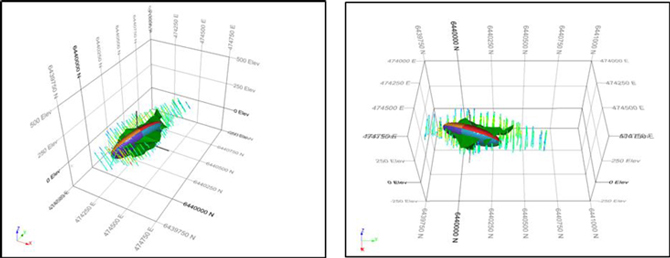
Figure 14-11: Ellipse Representing Variogram Ranges and GTM Wireframe

Figure 14-12: Ellipse Representing Variogram Ranges and Grennaite with Pegmatitic Zones Wireframe
 |  |
| | Prefeasibility Study - NI 43-101 - Technical report for the Norra Kärr Rare
Earth Element Deposit - 0465-RPT-014 Rev 0 |
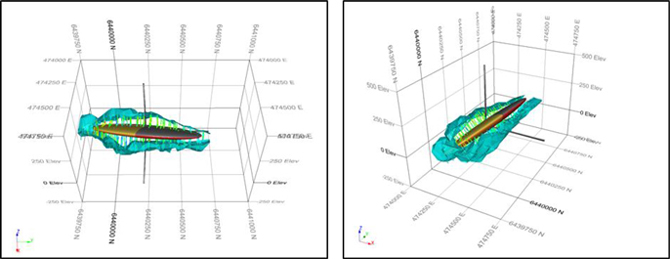
Figure 14-13: Ellipse Representing Variogram Ranges with Porphyritic Grennaite Wireframe
| 14.7.1 | Block Model Parameters |
An initial empty block model was created inside the mineralised zone wireframes. A summary of the block model parameters is listed in Table 14-6. A parent cell size of 25 m x 25 m x 5 m (northing x easting x vertical) was selected. Key fields were established within the block model to identify and separate the individual mineralised zones for control on grade estimation as described below. The model was not rotated. A minimum subcell size of 5 m x 5 m x 1 m was allowed to get a close fit to the wireframe surfaces.
Table 14-6: Summary of Block Model Parameters
| Property | | Direction | | | Metres (m) | |
| | | X | | | 473 600 | |
| Model Origin | | Y | | | 6 439 300 | |
| | | Z | | | -134 | |
| | | X | | | 25 | |
| Parent Cell Size | | Y | | | 25 | |
| | | Z | | | 5 | |
| | | X | | | 62 | |
| No. of Cells | | Y | | | 72 | |
| | | Z | | | 79 | |
 |  |
| | Prefeasibility Study - NI 43-101 - Technical report for the Norra Kärr Rare
Earth Element Deposit - 0465-RPT-014 Rev 0 |
Dynamic anisotropy is the process of reflecting small changes in dip and dip direction of a deposit during grade estimation by slightly altering the orientations of search ellipses used to select samples. At Nora Kärr a significant database of foliation directions measured from drill core were used to interpret these subtle changes in orientation. Dip and dip directions were estimated into the volumetric block model using IDW3and the foliation information supplied by Tasman which was converted to point ‘sample’ locations with consistent lengths of 0.02 m.
Estimation of dip and dip direction was carried out using a single pass estimation run, i.e. a single non-expanding ellipse was used in order to achieve a block model that had no ‘steps’ in results.
Estimation was carried out using the mineralised domains as key fields, i.e. estimation of dip and dip direction in a domain only used samples within that domain for the estimation. The size and orientations of the search ellipses used were based on the variogram models interpreted for Dy grades as these roughly followed the orientation of the interpreted fold axis.
The size of the final search ellipses used were calculated based on normalising the longest range of these variograms to 100 m and determining the size of the other axis as a factor based on the anisotropy. The estimation was then carried out as an iterative process with the search ellipse sizes being increased for each zone until all blocks in that zone were estimated in a single pass.
A minimum of four samples was specified in order to ‘average out’ any inconsistent dip and dip directions recorded in the database.
The parameters used for the estimation of dip and dip direction are listed in Table 14-7.
Table 14-7: Estimation Parameters for Dip and Dip Direction
Estimation Method: Inverse Distance Weighting Cubed
| Parameter | | | Domain 1 | | | | Domain 2 | | | | Domain 3 | | | | Domain 4 | | | | Domain 5 | | | | Domain 6 | |
| Search Radii 1 (m) | | | 200 | | | | 300 | | | | 800 | | | | 900 | | | | 400 | | | | 200 | |
| Search Radii 2 (m) | | | 200 | | | | 210 | | | | 80 | | | | 90 | | | | 400 | | | | 200 | |
| Search Radii 3 (m) | | | 200 | | | | 75 | | | | 160 | | | | 495 | | | | 400 | | | | 200 | |
| Rotation (Z,X,Z) | | | 0,0,0 | | | | -70,60,10 | | | | 90,50,0 | | | | 110,50,170 | | | | 0,0,0 | | | | 0,0,0 | |
| Minimum Composites | | | 4 | | | | 4 | | | | 4 | | | | 4 | | | | 4 | | | | 4 | |
| Maximum Composites | | | 16 | | | | 16 | | | | 16 | | | | 16 | | | | 16 | | | | 16 | |
| Minimum Drill Holes | | | 2 | | | | 2 | | | | 2 | | | | 2 | | | | 2 | | | | 2 | |
 |  |
| | Prefeasibility Study - NI 43-101 - Technical report for the Norra Kärr Rare
Earth Element Deposit - 0465-RPT-014 Rev 0 |
The estimated dip and dip directions were validated visually against the input data. Two example sections are shown in Figure 14-14 and Figure 14-15 of the results of the estimation.
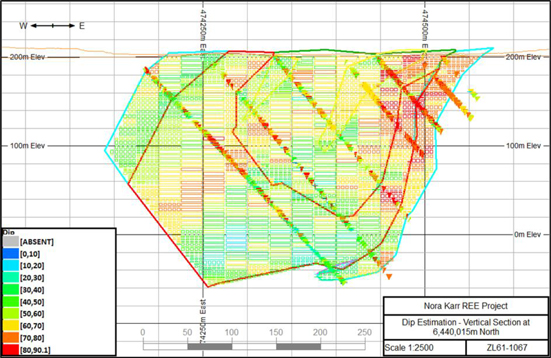
Figure 14-14: Vertical Section Showing Estimated Dip and Dip Direction at Y=6,440,015
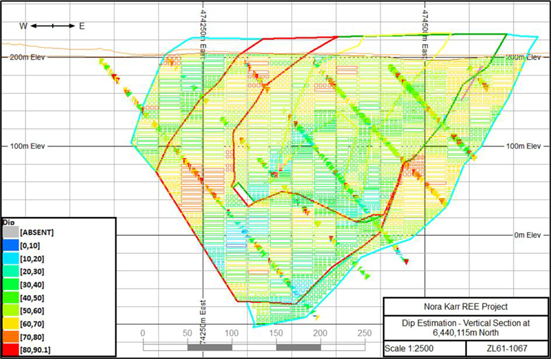
Figure 14-15: Vertical Section Showing Estimated Dip and Dip Direction at Y=6,440,115
 |  |
| | Prefeasibility Study - NI 43-101 - Technical report for the Norra Kärr Rare
Earth Element Deposit - 0465-RPT-014 Rev 0 |
A total of 1 692 bulk density tests have been carried out by Tasman with the resultant database supplied to WAI. To facilitate assigning densities by lithology types WAI has incorporated the density data into the drill hole file and then extracted the density records by the wireframe lithology (LTYPE). The average density values shown in Table14-8 by LTYPE have been calculated and subsequently assigned to the block model.
Table 14-8: Density Values Applied by Zone
| LTYPE | | Rock Type | | | Density (t/m3) | |
| 0 | | Granite | | | 2.69 | |
| 1 | | Kaxtorpite | | | 2.74 | |
| 2 | | Migmatitic Grennaite | | | 2.67 | |
| 3 | | Grennaite with pegmatitic zones | | | 2.72 | |
| 4 | | Porphyritic grennaite | | | 2.71 | |
| 5 | | Lakarpite | | | 2.74 | |
| 6 | | Mafic dykes | | | 2.74 | |
| 14.9.1 | Kriging Neighbourhood Analysis (KNA) |
Kriging Neighbourhood Analysis (KNA) is a method used for optimising block sizes and search parameters used during grade estimation.
For Nora Kärr the KNA was carried out using Supervisor v8.2 software which enables a series of tasks to be carried out in turn to determine:
| · | The optimum block sizes; |
| · | The minimum and maximum samples to be used during estimation; |
| · | The optimum search ellipse size; and |
| · | The optimum block discretisation. |
For each of these tasks a series of estimation runs are carried out using the variogram parameters calculated as shown above on a block centre location selected for its representivity of the deposit. Due to the strong positive correlation between many of the variables under examination the KNA was run on Dy as being representative of mineralisation across the deposit. KNA studies were carried out on the two largest domains; the grennaite with pegmatitic zones and the porphyritic grennaite, these
 |  |
| | Prefeasibility Study - NI 43-101 - Technical report for the Norra Kärr Rare
Earth Element Deposit - 0465-RPT-014 Rev 0 |
lithotypes provided the greatest coverage of sample data required to generate robust QKNA results. Similar results were obtained for both of these zones. The example shown below (Figure 14-16) is Dy in the largest of the zones, grennaite with pegmatitic zones (LTYPE 3).
Each estimation run is used to calculate a slope of regression and Kriging Efficiency, the comparison of which allows the optimum scenario to be selected.
A series of block sizes were tested with variation in the X, Y and Z directions. As expected, an improvement in Kriging Efficiency was seen with increasing block size with the increase in improvement in results tailing off after 25 m x 25 m x 5 m. Results for all block sizes tested were above 80 % for Kriging Efficiency and 0.95 for slope of regression.
A block size of 25 m x 25 m x 5 m was chosen for modelling. This block size was a compromise between gaining acceptable statistical results in this test and the block being small enough for pit optimisation to be carried out at an adequate resolution. The results for the KNA block size tests can be seen in Figure 14-16.
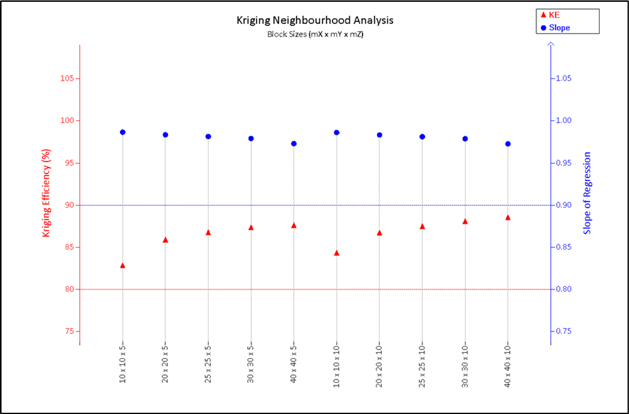
Figure 14-16: KNA Results for Block Size Using Dy in Grennaite with Pegamatitic Zones
 |  |
| | Prefeasibility Study - NI 43-101 - Technical report for the Norra Kärr Rare
Earth Element Deposit - 0465-RPT-014 Rev 0 |
| 14.9.1.3 | Minimum and Maximum Samples |
A series of tests were carried out at the selected block size of 25 m x 25 m x 5 m to determine the optimum minimum and maximum samples to be used during the estimation process. As expected increasing, up to a point, the numbers of samples used during the estimation improved the Kriging Efficiency and slope of regression of the resulting estimate. Using a minimum of 20 samples produced acceptable results for these parameters but increasing the samples used above 26 produced very little marked improvement. For further KNA tests a minimum of 20 and a maximum of 40 samples were used. The results for this analysis are shown in Figure 14-17.
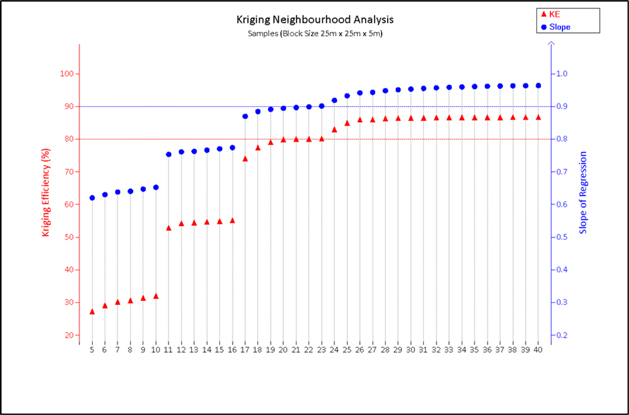
Figure 14-17: KNA Results for Varying Number of Samples Used During Estimation Using Dy in Grennaite with Pegmatitic Zones
| 14.9.1.4 | Search Ellipse Size |
A series of tests were carried out to determine the optimum search ellipse size using the selected block size of 25 m x 25 m x 5 m and using a minimum of 20 samples and a maximum of 40 samples. Various search ellipse sizes were tested at differing ratios of the variogram model ranges. Very little change was seen in Kriging Efficiency or slope of regression with increasing search ellipse sizes. This is probably due to meeting the maximum sample criteria at this size. The results of this test are
 |  |
| | Prefeasibility Study - NI 43-101 - Technical report for the Norra Kärr Rare
Earth Element Deposit - 0465-RPT-014 Rev 0 |
shown in Figure 14-18. The search ellipses used during grade estimation are detailed in Section 14.9.2. For further KNA test work a search ellipse equal to variogram range was used.
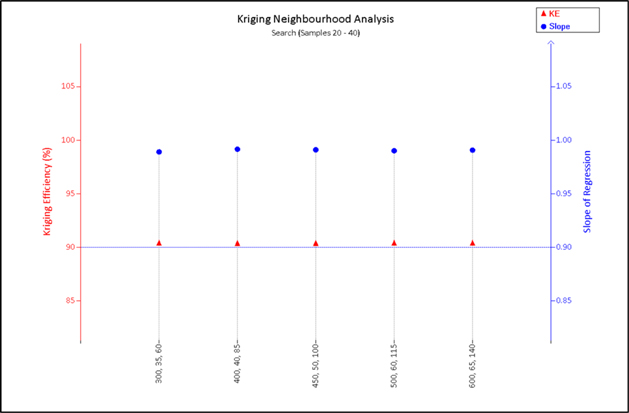
Figure 14-18: KNA Results for Varying Search Ellipse Sizes Using Dy in Grennaite with Pegmatitic Zones
| 14.9.1.5 | Block Discretisation |
Using a block size of 25 m x 25 m x 5 m, a minimum number of 20 samples and a maximum number of 40 samples with a search ellipse roughly equal to variogram range, a series of estimation runs were carried out to determine the optimum block discretisation parameters. With increasing block discretisation there was an improvement in both Kriging Efficiency and slope of regression from point Kriging (1 m x 1 m x 1 m discretisation) up to block discretisation of 3 m x 3 m x 2 m. Past this point there was little gain in the results of either parameter but a block discretisation of 5 m x 5 m x 2 m was chosen for estimation to give a small spacing of discretisation points across a parent cell. The results of the block discretisation analysis are shown in Figure 14-19.
 |  |
| | Prefeasibility Study - NI 43-101 - Technical report for the Norra Kärr Rare
Earth Element Deposit - 0465-RPT-014 Rev 0 |
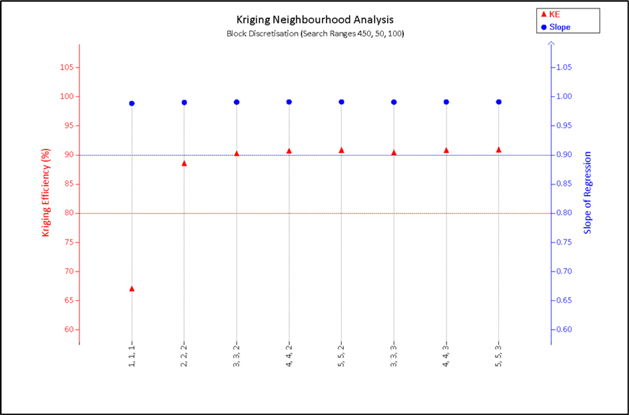
Figure 14-19: KNA Results for Varying Block Discretisation Using Dy in Grennaite with Pegmatitic Zones
Grade estimation was carried out using Ordinary Kriging (OK) as the principle interpolation method. Inverse Power of Distance Squared (IDW2) and Nearest Neighbour (NN) were also used for comparative purposes for each element. For the mafic dykes only IDW2 and NN were used due to a lack of robust variogram models in this zone. The OK method used estimation parameters defined by the variography and refined after KNA studies as described above. The estimation was performed on mineralised material domains defined during the domaining process described above and only drillhole composites contained within a domain were used in the grade estimation of that domain.
For the mineralised zones the OK estimation was run in a three pass estimation plan, the second and third passes using progressively larger search radii to enable the estimation of blocks not estimated on the previous pass. The search ellipse sizes and orientations were derived from the variographic analysis, with the first search distances corresponding to the distance at roughly two thirds of the variogram range value and the second search distance approximating the variogram range and the third search ellipse approximating twice the variogram range. Search ellipses were orientated to fit the directions of continuity as defined by the variography study. The directional control settings defining
 |  |
| | Prefeasibility Study - NI 43-101 - Technical report for the Norra Kärr Rare
Earth Element Deposit - 0465-RPT-014 Rev 0 |
the local variation in the strike and dip of the mineralised zones that were defined during the block model creation process were used during estimation. The dip and dip directions were used as vectors to interpolate dip directions and dip values into the block model. These orientations were subsequently used during grade estimation to orient the search ellipses independently for each block. This dynamic anisotropy procedure gives a more realistic reflection of the local variations in the strike and dip of the deposit.
Sample weighting during estimation was determined by variogram model parameters for the OK method. Block discretisation was set to 5 m x 5 m x 2 m points to estimate block grades. Sub cells received the same estimate as the parent cell. A summary of the estimation parameters are shown in Table 14-9 and summary of the search ellipse sizes is shown inTable 14-10.
Table 14-9: Grade Estimation Parameters
| | | Search Ellipse | |
| Grade Estimation Parameters | | 1 | | | 2 | | | 3 | |
| Search Ellipse Size Increase of ellipse #1 | | | x 1 | | | | x 1.5 | | | | x 3 | |
| Minimum Composites | | | 20 | | | | 15 | | | | 8 | |
| Maximum Composites | | | 40 | | | | 40 | | | | 16 | |
| Minimum Octants | | | 4 | | | | 4 | | | | - | |
| Min Composite per Octant | | | 1 | | | | 1 | | | | - | |
| Max Composite per Octant | | | 5 | | | | 5 | | | | - | |
| Minimum Drill Holes | | | 3 | | | | 3 | | | | 2 | |
Table 14-10:Initial Search Ellipse Sizes for Grade Estimation
| | | | | | Domain 1 | | | | Domain 2 | | | | Domain 3 | | | | Domain 4 | | | | Domain 5 | | | | Domain 6 | |
| Dy | | Size (m) of Axis 1,2,3 | | | 25,25,25 | | | | 160,115,45 | | | | 300,60,35 | | | | 280,160,25 | | | | 100,100,100 | | | | 100,100,100 | |
| Y | | Size (m) of Axis 1,2,3 | | | 25,25,25 | | | | 145,115,45 | | | | 230,65,50 | | | | 260,130,25 | | | | 100,100,100 | | | | 100,100,100 | |
| Eu | | Size (m) of Axis 1,2,3 | | | 25,25,25 | | | | 155,80,65 | | | | 170,65,55 | | | | 315,175,30 | | | | 100,100,100 | | | | 100,100,100 | |
| La | | Size (m) of Axis 1,2,3 | | | 45,45,45 | | | | 110,80,35 | | | | 150,40,35 | | | | 235,220,30 | | | | 70,70,70 | | | | 100,100,100 | |
| Nd | | Size (m) of Axis 1,2,3 | | | 25,25,25 | | | | 120,70,60 | | | | 175,110,65 | | | | 245,200,30 | | | | 80,80,80 | | | | 100,100,100 | |
| Ce | | Size (m) of Axis 1,2,3 | | | 60,60,60 | | | | 130,65,65 | | | | 145,155,50 | | | | 245,180,30 | | | | 70,70,70 | | | | 100,100,100 | |
| Er | | Size (m) of Axis 1,2,3 | | | 25,25,25 | | | | 130,80,35 | | | | 220,70,35 | | | | 265,180,25 | | | | 95,95,95 | | | | 100,100,100 | |
| Gd | | Size (m) of Axis 1,2,3 | | | 25,25,25 | | | | 120,75,65 | | | | 230,75,50 | | | | 285,160,25 | | | | 95,95,95 | | | | 100,100,100 | |
| Ho | | Size (m) of Axis 1,2,3 | | | 25,25,25 | | | | 120,85,25 | | | | 265,60,30 | | | | 280,160,30 | | | | 95,95,95 | | | | 100,100,100 | |
| Lu | | Size (m) of Axis 1,2,3 | | | 25,25,25 | | | | 85,65,25 | | | | 215,80,35 | | | | 260,165,25 | | | | 90,90,90 | | | | 100,100,100 | |
| Pr | | Size (m) of Axis 1,2,3 | | | 55,55,55 | | | | 130,75,65 | | | | 170,110,65 | | | | 255,195,30 | | | | 75,75,75 | | | | 100,100,100 | |
| Sm | | Size (m) of Axis 1,2,3 | | | 25,25,25 | | | | 155,75,65 | | | | 170,170,55 | | | | 280,170,25 | | | | 100,100,100 | | | | 100,100,100 | |
 |  |
| | Prefeasibility Study - NI 43-101 - Technical report for the Norra Kärr Rare
Earth Element Deposit - 0465-RPT-014 Rev 0 |
| | | | | | Domain 1 | | | | Domain 2 | | | | Domain 3 | | | | Domain 4 | | | | Domain 5 | | | | Domain 6 | |
| Tb | | Size (m) of Axis 1,2,3 | | | 25,25,25 | | | | 145,70,30 | | | | 300,60,35 | | | | 315,160,30 | | | | 100,100,100 | | | | 100,100,100 | |
| Tm | | Size (m) of Axis 1,2,3 | | | 30,30,30 | | | | 130,65,25 | | | | 255,80,35 | | | | 260,175,20 | | | | 95,95,95 | | | | 100,100,100 | |
| Yb | | Size (m) of Axis 1,2,3 | | | 25,25,25 | | | | 130,70,25 | | | | 240,80,35 | | | | 285,145,25 | | | | 100,100,100 | | | | 100,100,100 | |
| Zr | | Size (m) of Axis 1,2,3 | | | 25,25,25 | | | | 80,45,20 | | | | 100,45,45 | | | | 60,60,60 | | | | 90,90,90 | | | | 100,100,100 | |
| U | | Size (m) of Axis 1,2,3 | | | 25,25,25 | | | | 90,65,25 | | | | 80,65,35 | | | | 75,75,75 | | | | 35,35,35 | | | | 100,100,100 | |
| Th | | Size (m) of Axis 1,2,3 | | | 15,15,15 | | | | 30,30,30 | | | | 170,40,35 | | | | 25,25,25 | | | | 40,40,40 | | | | 100,100,100 | |
| Hf | | Size (m) of Axis 1,2,3 | | | 25,25,25 | | | | 80,35,20 | | | | 130,65,40 | | | | 60,60,60 | | | | 90,90,90 | | | | 100,100,100 | |
| Nb | | Size (m) of Axis 1,2,3 | | | 25,25,25 | | | | 150,115,75 | | | | 265,50,15 | | | | 60,60,60 | | | | 95,95,95 | | | | 100,100,100 | |
Following grade estimation a statistical and visual assessment of the block model was undertaken to:
| · | assess successful application of the estimation passes; |
| · | to ensure that as far as the data allowed, all blocks within mineralisation domains were estimated; and |
| · | the model estimates performed as expected. |
The model validation methods carried out included:
| · | A visual assessment of grade; |
| · | Global statistical grade validation; and |
A visual comparison of composite sample grade and block grade was conducted in cross section and in plan, as shown in the example sections in Figure 14-20 to Figure 14-23. Visually the model was generally considered to reflect the composite grades and the domain boundaries are honoured.
 |  |
| | Prefeasibility Study - NI 43-101 - Technical report for the Norra Kärr Rare
Earth Element Deposit - 0465-RPT-014 Rev 0 |
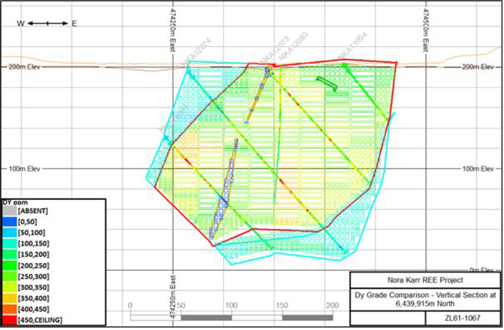
Figure 14-20: Example East-West Vertical Section Showing Composite and Estimated Grades at Northing=6439915
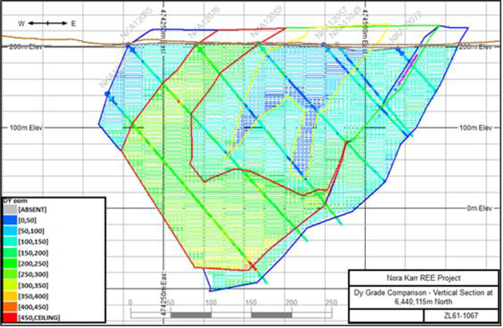
Figure 14-21: Example East-West Vertical Section Showing Composite and Estimated Grades at Northing=6440115
 |  |
| | Prefeasibility Study - NI 43-101 - Technical report for the Norra Kärr Rare
Earth Element Deposit - 0465-RPT-014 Rev 0 |
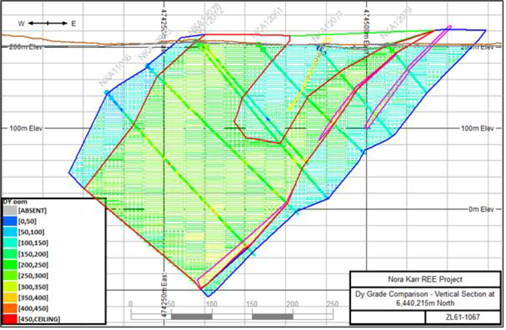
Figure 14-22: Example East-West Vertical Section Showing Composite and Estimated Grades at Northing=6440215
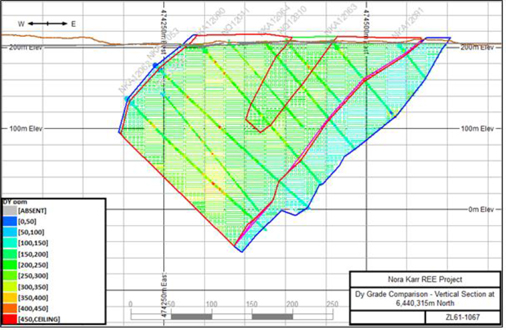
Figure 14-23: Example East-West Vertical Section Showing Composite and Estimated Grades at Northing=6440315
 |  |
| | Prefeasibility Study - NI 43-101 - Technical report for the Norra Kärr Rare
Earth Element Deposit - 0465-RPT-014 Rev 0 |
| 14.10.2 | Global Grade Comparison |
Statistical analysis of the block model was carried out for comparison against the composited drill hole data. This analysis provides a check on the reproduction of the mean grade of the composite data against the model over the global domain. Typically the mean grade of the block model should not be significantly greater than that of the samples from which it has been derived. The mean block model grade for each ore zone and its corresponding mean composite grades are shown in Table 14-11. A good match is seen between input sample/composite grades and the estimated block grades for each domain.
Table 14-11: Validation Stats - Composite Grades vs Block Grades
| Zone | | Element | | Composite
Grades | | | OK | | | IDW2 | | | NN | |
| 1 | | DY_PPM | | | 57.55 | | | | 56.64 | | | | 56.08 | | | | 55.07 | |
| 1 | | Y_PPM | | | 402.58 | | | | 398.90 | | | | 392.71 | | | | 386.76 | |
| 1 | | EU_PPM | | | 5.79 | | | | 5.70 | | | | 5.65 | | | | 5.56 | |
| 1 | | LA_PPM | | | 335.21 | | | | 333.50 | | | | 326.14 | | | | 327.51 | |
| 1 | | ND_PPM | | | 212.43 | | | | 212.88 | | | | 206.99 | | | | 205.07 | |
| 1 | | CE_PPM | | | 545.66 | | | | 550.23 | | | | 530.76 | | | | 532.96 | |
| 1 | | ER_PPM | | | 40.15 | | | | 39.60 | | | | 39.16 | | | | 38.40 | |
| 1 | | GD_PPM | | | 46.65 | | | | 45.85 | | | | 45.21 | | | | 44.52 | |
| 1 | | HO_PPM | | | 12.76 | | | | 12.59 | | | | 12.47 | | | | 12.21 | |
| 1 | | LU_PPM | | | 5.29 | | | | 5.25 | | | | 5.18 | | | | 5.07 | |
| 1 | | PR_PPM | | | 61.23 | | | | 60.70 | | | | 59.22 | | | | 59.28 | |
| 1 | | SM_PPM | | | 44.84 | | | | 44.42 | | | | 43.58 | | | | 43.03 | |
| 1 | | TB_PPM | | | 8.72 | | | | 8.57 | | | | 8.47 | | | | 8.31 | |
| 1 | | TM_PPM | | | 6.11 | | | | 6.00 | | | | 5.87 | | | | 5.79 | |
| 1 | | YB_PPM | | | 37.62 | | | | 37.36 | | | | 36.88 | | | | 36.22 | |
| 1 | | ZR_PPM | | | 3 347.61 | | | | 3 378.30 | | | | 3 282.66 | | | | 3 237.60 | |
| 1 | | U_PPM | | | 24.65 | | | | 24.23 | | | | 23.76 | | | | 23.51 | |
| 1 | | TH_PPM | | | 65.28 | | | | 57.20 | | | | 56.73 | | | | 55.16 | |
| 1 | | HF_PPM | | | 76.55 | | | | 77.11 | | | | 75.14 | | | | 74.01 | |
| 1 | | NB_PPM | | | 138.64 | | | | 138.62 | | | | 136.20 | | | | 133.65 | |
| 2 | | DY_PPM | | | 159.64 | | | | 162.47 | | | | 162.08 | | | | 161.88 | |
| 2 | | Y_PPM | | | 1 200.29 | | | | 1 229.49 | | | | 1 229.24 | | | | 1 219.68 | |
| 2 | | EU_PPM | | | 14.11 | | | | 14.63 | | | | 14.54 | | | | 14.53 | |
| 2 | | LA_PPM | | | 621.68 | | | | 618.51 | | | | 622.11 | | | | 612.75 | |
| 2 | | ND_PPM | | | 554.72 | | | | 569.22 | | | | 568.71 | | | | 569.06 | |
| 2 | | CE_PPM | | | 1 269.10 | | | | 1 285.04 | | | | 1 288.58 | | | | 1 276.07 | |
 |  |
| | Prefeasibility Study - NI 43-101 - Technical report for the Norra Kärr Rare
Earth Element Deposit - 0465-RPT-014 Rev 0 |
| Zone | | Element | | Composite
Grades | | | OK | | | IDW2 | | | NN | |
| 2 | | ER_PPM | | | 110.35 | | | | 111.26 | | | | 111.37 | | | | 110.96 | |
| 2 | | GD_PPM | | | 124.91 | | | | 128.09 | | | | 128.00 | | | | 128.14 | |
| 2 | | HO_PPM | | | 35.44 | | | | 35.97 | | | | 35.81 | | | | 35.79 | |
| 2 | | LU_PPM | | | 14.75 | | | | 14.79 | | | | 14.82 | | | | 14.74 | |
| 2 | | PR_PPM | | | 152.06 | | | | 155.28 | | | | 155.35 | | | | 154.46 | |
| 2 | | SM_PPM | | | 123.74 | | | | 128.06 | | | | 127.55 | | | | 127.65 | |
| 2 | | TB_PPM | | | 23.90 | | | | 24.50 | | | | 24.37 | | | | 24.45 | |
| 2 | | TM_PPM | | | 17.08 | | | | 17.22 | | | | 17.20 | | | | 17.16 | |
| 2 | | YB_PPM | | | 106.89 | | | | 107.52 | | | | 107.43 | | | | 106.76 | |
| 2 | | ZR_PPM | | | 10 535.37 | | | | 10 578.95 | | | | 10 602.98 | | | | 10 533.77 | |
| 2 | | U_PPM | | | 21.09 | | | | 20.66 | | | | 20.83 | | | | 20.40 | |
| 2 | | TH_PPM | | | 11.25 | | | | 11.77 | | | | 11.65 | | | | 12.23 | |
| 2 | | HF_PPM | | | 231.05 | | | | 230.38 | | | | 231.12 | | | | 230.76 | |
| 2 | | NB_PPM | | | 291.78 | | | | 300.30 | | | | 298.41 | | | | 303.77 | |
| 3 | | DY_PPM | | | 233.74 | | | | 228.05 | | | | 231.70 | | | | 228.39 | |
| 3 | | Y_PPM | | | 1 669.67 | | | | 1 636.00 | | | | 1 665.43 | | | | 1 640.28 | |
| 3 | | EU_PPM | | | 18.14 | | | | 17.88 | | | | 18.12 | | | | 17.82 | |
| 3 | | LA_PPM | | | 414.06 | | | | 426.65 | | | | 428.97 | | | | 427.80 | |
| 3 | | ND_PPM | | | 514.84 | | | | 520.96 | | | | 527.03 | | | | 525.99 | |
| 3 | | CE_PPM | | | 948.60 | | | | 968.29 | | | | 977.26 | | | | 986.37 | |
| 3 | | ER_PPM | | | 161.99 | | | | 158.48 | | | | 160.16 | | | | 158.88 | |
| 3 | | GD_PPM | | | 166.35 | | | | 163.87 | | | | 166.68 | | | | 164.86 | |
| 3 | | HO_PPM | | | 52.47 | | | | 51.29 | | | | 51.91 | | | | 51.50 | |
| 3 | | LU_PPM | | | 21.20 | | | | 20.86 | | | | 20.98 | | | | 20.79 | |
| 3 | | PR_PPM | | | 125.41 | | | | 127.88 | | | | 129.07 | | | | 129.79 | |
| 3 | | SM_PPM | | | 147.51 | | | | 146.99 | | | | 148.97 | | | | 146.93 | |
| 3 | | TB_PPM | | | 34.20 | | | | 33.62 | | | | 34.17 | | | | 33.66 | |
| 3 | | TM_PPM | | | 24.95 | | | | 24.47 | | | | 24.67 | | | | 24.36 | |
| 3 | | YB_PPM | | | 153.85 | | | | 150.74 | | | | 151.87 | | | | 150.45 | |
| 3 | | ZR_PPM | | | 14 534.21 | | | | 14 344.60 | | | | 14 351.50 | | | | 14 245.45 | |
| 3 | | U_PPM | | | 11.42 | | | | 11.87 | | | | 11.81 | | | | 12.01 | |
| 3 | | TH_PPM | | | 5.58 | | | | 6.10 | | | | 5.97 | | | | 6.25 | |
| 3 | | HF_PPM | | | 312.72 | | | | 309.62 | | | | 308.90 | | | | 306.97 | |
| 3 | | NB_PPM | | | 414.73 | | | | 418.16 | | | | 418.78 | | | | 415.17 | |
| 4 | | DY_PPM | | | 132.73 | | | | 134.19 | | | | 132.72 | | | | 132.85 | |
| 4 | | Y_PPM | | | 860.12 | | | | 874.68 | | | | 865.53 | | | | 867.23 | |
 |  |
| | Prefeasibility Study - NI 43-101 - Technical report for the Norra Kärr Rare
Earth Element Deposit - 0465-RPT-014 Rev 0 |
| Zone | | Element | | Composite
Grades | | | OK | | | IDW2 | | | NN | |
| 4 | | EU_PPM | | | 8.66 | | | | 8.74 | | | | 8.63 | | | | 8.61 | |
| 4 | | LA_PPM | | | 168.49 | | | | 172.68 | | | | 169.69 | | | | 172.65 | |
| 4 | | ND_PPM | | | 207.23 | | | | 211.61 | | | | 208.91 | | | | 211.14 | |
| 4 | | CE_PPM | | | 374.47 | | | | 384.27 | | | | 378.15 | | | | 383.92 | |
| 4 | | ER_PPM | | | 104.39 | | | | 105.25 | | | | 104.44 | | | | 104.80 | |
| 4 | | GD_PPM | | | 80.18 | | | | 81.17 | | | | 80.38 | | | | 80.64 | |
| 4 | | HO_PPM | | | 31.64 | | | | 31.94 | | | | 31.70 | | | | 31.75 | |
| 4 | | LU_PPM | | | 15.21 | | | | 15.36 | | | | 15.22 | | | | 15.29 | |
| 4 | | PR_PPM | | | 50.12 | | | | 51.31 | | | | 50.56 | | | | 51.26 | |
| 4 | | SM_PPM | | | 63.86 | | | | 64.82 | | | | 64.13 | | | | 64.47 | |
| 4 | | TB_PPM | | | 18.07 | | | | 18.31 | | | | 18.13 | | | | 18.10 | |
| 4 | | TM_PPM | | | 16.84 | | | | 16.93 | | | | 16.81 | | | | 16.84 | |
| 4 | | YB_PPM | | | 106.57 | | | | 107.28 | | | | 106.46 | | | | 106.51 | |
| 4 | | ZR_PPM | | | 9 874.85 | | | | 10 118.01 | | | | 10 031.02 | | | | 10 250.96 | |
| 4 | | U_PPM | | | 4.81 | | | | 5.12 | | | | 5.09 | | | | 5.26 | |
| 4 | | TH_PPM | | | 5.50 | | | | 5.70 | | | | 5.76 | | | | 5.88 | |
| 4 | | HF_PPM | | | 244.12 | | | | 248.23 | | | | 246.88 | | | | 250.86 | |
| 4 | | NB_PPM | | | 187.40 | | | | 192.96 | | | | 191.18 | | | | 201.05 | |
| 5 | | DY_PPM | | | 201.49 | | | | 203.81 | | | | 197.97 | | | | 199.99 | |
| 5 | | Y_PPM | | | 1 385.51 | | | | 1 407.70 | | | | 1 363.42 | | | | 1 375.91 | |
| 5 | | EU_PPM | | | 15.42 | | | | 15.40 | | | | 15.17 | | | | 15.04 | |
| 5 | | LA_PPM | | | 405.98 | | | | 408.14 | | | | 399.18 | | | | 400.47 | |
| 5 | | ND_PPM | | | 445.60 | | | | 443.96 | | | | 440.90 | | | | 440.81 | |
| 5 | | CE_PPM | | | 886.38 | | | | 886.12 | | | | 869.72 | | | | 871.99 | |
| 5 | | ER_PPM | | | 141.33 | | | | 143.69 | | | | 139.15 | | | | 142.35 | |
| 5 | | GD_PPM | | | 138.10 | | | | 138.39 | | | | 135.83 | | | | 135.91 | |
| 5 | | HO_PPM | | | 45.60 | | | | 46.11 | | | | 44.85 | | | | 45.86 | |
| 5 | | LU_PPM | | | 18.57 | | | | 18.91 | | | | 18.42 | | | | 19.17 | |
| 5 | | PR_PPM | | | 112.25 | | | | 111.65 | | | | 112.24 | | | | 112.12 | |
| 5 | | SM_PPM | | | 121.29 | | | | 122.04 | | | | 119.76 | | | | 119.46 | |
| 5 | | TB_PPM | | | 28.88 | | | | 28.88 | | | | 28.31 | | | | 28.47 | |
| 5 | | TM_PPM | | | 21.61 | | | | 21.79 | | | | 21.23 | | | | 21.92 | |
| 5 | | YB_PPM | | | 133.63 | | | | 135.77 | | | | 131.27 | | | | 135.41 | |
| 5 | | ZR_PPM | | | 8 647.09 | | | | 8 942.74 | | | | 8 522.50 | | | | 9 008.96 | |
| 5 | | U_PPM | | | 10.27 | | | | 10.47 | | | | 10.59 | | | | 9.56 | |
| 5 | | TH_PPM | | | 21.11 | | | | 21.69 | | | | 22.05 | | | | 20.87 | |
 |  |
| | Prefeasibility Study - NI 43-101 - Technical report for the Norra Kärr Rare
Earth Element Deposit - 0465-RPT-014 Rev 0 |
| Zone | | Element | | Composite
Grades | | | OK | | | IDW2 | | | NN | |
| 5 | | HF_PPM | | | 194.25 | | | | 201.90 | | | | 191.80 | | | | 206.22 | |
| 5 | | NB_PPM | | | 405.11 | | | | 402.84 | | | | 398.55 | | | | 398.95 | |
| 6 | | DY_PPM | | | 48.44 | | | | | | | | 50.54 | | | | 81.16 | |
| 6 | | Y_PPM | | | 339.00 | | | | | | | | 353.25 | | | | 562.82 | |
| 6 | | EU_PPM | | | 5.41 | | | | | | | | 5.64 | | | | 8.46 | |
| 6 | | LA_PPM | | | 199.40 | | | | | | | | 207.49 | | | | 315.04 | |
| 6 | | ND_PPM | | | 174.15 | | | | | | | | 181.95 | | | | 277.13 | |
| 6 | | CE_PPM | | | 393.46 | | | | | | | | 411.34 | | | | 629.66 | |
| 6 | | ER_PPM | | | 32.46 | | | | | | | | 33.95 | | | | 54.30 | |
| 6 | | GD_PPM | | | 39.42 | | | | | | | | 41.65 | | | | 65.38 | |
| 6 | | HO_PPM | | | 10.64 | | | | | | | | 11.08 | | | | 17.78 | |
| 6 | | LU_PPM | | | 4.22 | | | | | | | | 4.40 | | | | 6.78 | |
| 6 | | PR_PPM | | | 48.58 | | | | | | | | 51.11 | | | | 78.54 | |
| 6 | | SM_PPM | | | 38.04 | | | | | | | | 39.66 | | | | 61.06 | |
| 6 | | TB_PPM | | | 7.26 | | | | | | | | 7.59 | | | | 12.02 | |
| 6 | | TM_PPM | | | 4.87 | | | | | | | | 5.08 | | | | 8.05 | |
| 6 | | YB_PPM | | | 30.64 | | | | | | | | 31.99 | | | | 50.10 | |
| 6 | | ZR_PPM | | | 2 515.63 | | | | | | | | 2 668.08 | | | | 2 751.74 | |
| 6 | | U_PPM | | | 10.73 | | | | | | | | 11.09 | | | | 14.10 | |
| 6 | | TH_PPM | | | 30.04 | | | | | | | | 29.81 | | | | 39.25 | |
| 6 | | HF_PPM | | | 55.35 | | | | | | | | 58.92 | | | | 59.52 | |
| 6 | | NB_PPM | | | 91.61 | | | | | | | | 94.12 | | | | 152.44 | |
NB:
No cut-off grade applied
Grades in ppm
Composites sample grades are length weighted
OK=Ordinary Kriging IDW2=Inverse Distance Weighting Squared NN=Nearest Neighbour
| 14.10.3 | Local Grade Profile Comparisons |
Grade profile plots are a graphical display of the grade distribution derived from a series of bands, or swaths, generated in several directions through the deposit. The plot compares the grade within these bands of the composite samples and the block estimated grades for the different methodologies used. Where the composite grades and the estimated grades show a good correlation, greater confidence can be placed on the estimate.
 |  |
| | Prefeasibility Study - NI 43-101 - Technical report for the Norra Kärr Rare
Earth Element Deposit - 0465-RPT-014 Rev 0 |
These plots were generated in three directions, by easting, northing and vertically to fit with the general form of the mineralised zones. Comparison of the grade was made against the composited grades with block grades estimated by OK, IDW2 and NN methods. The swath plots were generated by averaging the blocks and composites using 25 m bands in easting and northing and 5 m bands by elevation. Grade profile plots were generated for the OK, IDW2 and NN estimation methods and should exhibit a close relationship to the composite data upon which the estimation is based.
A generally close relationship was observed between composite and block grade across the model for all variables. Some deviations between the composite and estimated block grade occur at the edges of the deposit where reduced tonnages or wide sample spacing accentuate the differences in grade.
Examples of grade profile plots are shown in Figure 14-24 to Figure 14-26 for Dy in domains LTYPE 2 to 4; Migmatitic Grennaite, Grennaite with pegmatitic zones and Porphyritic Grennaite respectively. Overall the plots illustrate a good correlation between the composites and the block grades.
 |  |
| | Prefeasibility Study - NI 43-101 - Technical report for the Norra Kärr Rare
Earth Element Deposit - 0465-RPT-014 Rev 0 |
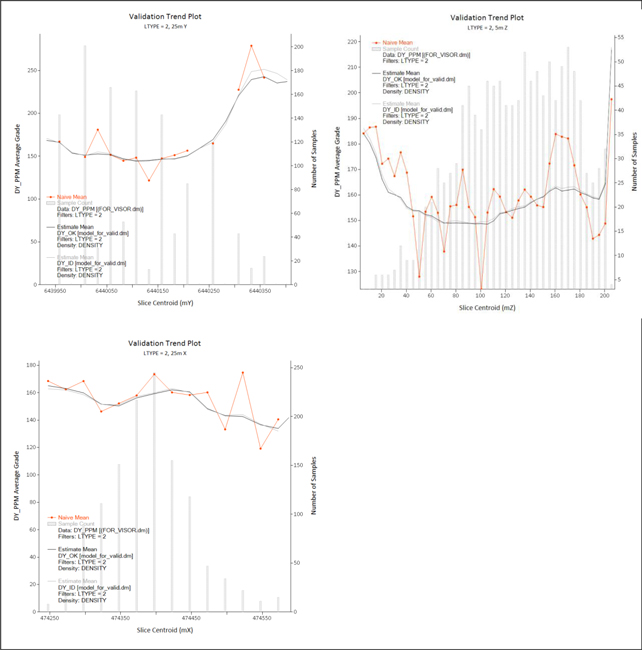
Figure 14-24: Grade Profile Plots for Dy
 |  |
| | Prefeasibility Study - NI 43-101 - Technical report for the Norra Kärr Rare
Earth Element Deposit - 0465-RPT-014 Rev 0 |
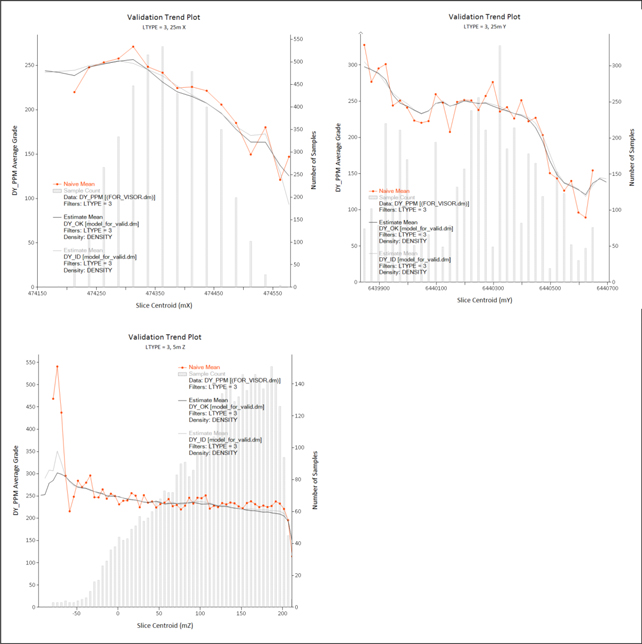
Figure 14-25: Grade Profile Plots for Dy in Grennaite with Pegmatitic Zones
 |  |
| | Prefeasibility Study - NI 43-101 - Technical report for the Norra Kärr Rare
Earth Element Deposit - 0465-RPT-014 Rev 0 |
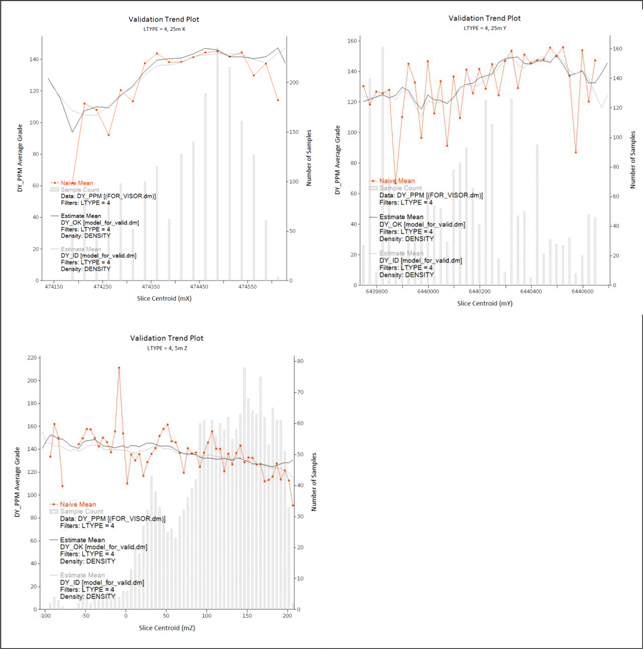
Figure 14-26: Grade Profile Plots for Dy in Porphyritic Grennaite
| 14.10.4 | Model Reconciliation |
The Nora Kärr project is a greenfield site and, as such, no reconciliation studies have been carried out.
 |  |
| | Prefeasibility Study - NI 43-101 - Technical report for the Norra Kärr Rare
Earth Element Deposit - 0465-RPT-014 Rev 0 |
| 14.10.5 | Validation Summary |
Globally no indications of significant over or under estimation are apparent in the model nor were any obvious interpolation issues identified. From the perspective of conformance of the average model grade to the input data, WAI considers the model to be a satisfactory representation of the sample data used and an indication that the grade interpolation has performed as expected. In terms of conformance to the drill hole composite data WAI considers the OK interpolation method to most closely represent the drill hole data. The Mineral Resource estimate is therefore based upon the OK grade estimation.
The Nora Kärr project is a greenfield site and, as such, no depletion of the Mineral Resource has been carried out.
| 14.12 | Mineral Resource Classification |
| 14.12.1 | CIM Definition Standards |
Under the CIM definition standards for Mineral Resources and Mineral Reserves a Mineral Resource is a concentration or occurrence of solid material of economic interest in or on the Earth’s crust in such form, grade or quality and quantity that there are reasonable prospects for eventual economic extraction. The location, quantity, grade or quality, continuity and other geological characteristics of a Mineral Resource are known, estimated or interpreted from specific geological evidence and knowledge including sampling.
A ‘Measured Mineral Resource’ is that part of a Mineral Resource for which quantity, grade or quality, densities, shape, and physical characteristics are estimated with confidence sufficient to allow the application of Modifying Factors to support detailed mine planning and final evaluation of the economic viability of the deposit. Geological evidence is derived from detailed and reliable exploration, sampling and testing and is sufficient to confirm geological and grade or quality continuity between points of observation.
An ‘Indicated Mineral Resource’ is that part of a Mineral Resource for which quantity, grade or quality, densities, shape and physical characteristics are estimated with sufficient confidence to allow the application of Modifying Factors in sufficient detail to support mine planning and evaluation of the economic viability of the deposit. Geological evidence is derived from adequately detailed and reliable exploration, sampling and testing and is sufficient to assume geological and grade or quality continuity between points of observation.
 |  |
| | Prefeasibility Study - NI 43-101 - Technical report for the Norra Kärr Rare
Earth Element Deposit - 0465-RPT-014 Rev 0 |
An ‘Inferred Mineral Resource’ is that part of a Mineral Resource for which quantity and grade are estimated on the basis of limited geological evidence and sampling. Geological evidence is sufficient to imply but not verify geological and grade or quality continuity. AnInferredMineral Resource has a lower level of confidence than that applying to an Indicated Mineral Resource and must not be converted to a Mineral Reserve. It is reasonably expected that the majority ofInferred Mineral Resources could be upgraded toIndicated Mineral Resources with continued exploration.
| 14.12.2 | Considerations for the Norra Kärr REE Resource Classification |
To classify the Nora Kärr deposit WAI have taken into account the following indicators:
| · | Geological Continuity and Complexity; |
| · | QA/QC Results - Quality of Data; |
| · | Spatial Grade Continuity - Results of Geostatistical Analysis; |
| · | Quality of Block Model; and |
| · | Expectations of Economic Extraction. |
| 14.12.2.1 | Geological Continuity and Complexity |
The level of geological exploration undertaken by Tasman and the quality of work is to a high standard and has allowed for detailed modelling of the Norra Kärr geological structure. The drill hole spacing is sufficient to define the extents of the alkaline intrusive body which hosts the REEs. Detailed geological logging including textural details has allowed Tasman to refine the broad geological interpretation further to include transitions between various textural and lithological zones of the mineralised body. To assist in define the textural sub-divisions of the mineralisation Tasman has also used geochemical assay results for various REE elements to denote the transition.
The Norra Kärr alkaline intrusive REE body has undergone compressive deformation with folding exhibited within the core. Tasman has recorded foliation orientation within the drill hole database. In developing a geological interpretation and model Tasman has used the foliation data to understand how the intrusive body has been folded.
During the Mineral Resource estimation WAI has used dynamic anisotropy to reflect the changes in the dip and dip direction of the geological structure. To facilitate the dynamic anisotropy the recorded foliation data was utilised, this data was used to estimate dip and dip directions into the block model. The dynamic anisotropy has enabled the grade estimation process to better honour the deposit geological continuity.
Overall WAI is of the opinion that the Norra Kärr geological structure is well understood and is well represented by the Mineral Resource block model and estimate.
 |  |
| | Prefeasibility Study - NI 43-101 - Technical report for the Norra Kärr Rare
Earth Element Deposit - 0465-RPT-014 Rev 0 |
Any Mineral Resource estimate is totally reliant on the quality of the sample data on which it is based. To ensure a high quality robust sample dataset Tasman has implemented a QA/QC programme which has included the submission of field quarter core duplicates, pulverised laboratory duplicates, external duplicates, CRMs and blanks.
WAI has reviewed the QA/QC results supplied by Tasman as well as independently submitting eight core samples and four pulverised duplicate samples for re-assay. The QA/QC results show an excellent level of precision and a good level of accuracy. The blank samples did display low grade mineralisation but WAI is of the opinion that this is a function of the use of granite as the blank material rather than a sample contamination issue. The sample data appears to be of a good standard suitable for use in a Mineral Resource estimate.
| 14.12.2.3 | Spatial Grade Continuity |
An assessment of spatial grade continuity is important when assigning resource classification. The confidence that can be placed in the variogram parameters is a major consideration when assessing classification. The data used in geostatistical analysis resulted in reasonably robust along strike and down dip variogram structures for all elements allowing the determination of appropriate search parameters through the KNA process.
| 14.12.2.4 | Quality of Block Model |
Validation of the block model has shown the estimated grades to be a good reflection of the input composite grades. Visual and statistical checks reveal no evidence of major under or over estimation.
| 14.12.2.5 | Expectations of Economic Extraction |
In order to report a Mineral Resource in accordance with CIM for disclosure in an NI 43-101 report, there needs to be the reasonable prospect for eventual economic extraction. To ensure that the Norra Kärr Mineral Resource reported by WAI has reasonable prospects of economic extraction the mineral inventory has been constrained by a pit optimisation and only mineralisation falling within the open pit is disclosed as a Mineral Resource.
The pit optimisation parameters used by WAI to constrain the Mineral Resource are shown in Table 14-12 below:
 |  |
| | Prefeasibility Study - NI 43-101 - Technical report for the Norra Kärr Rare
Earth Element Deposit - 0465-RPT-014 Rev 0 |
Table 14-12: Norra Kärr Mineral Resource Estimate Pit Optimisation Parameters (WAI, 2014)
| Description | | Unit | | Amount | | Source |
| Metal Price | | | | | | |
| Cerium Oxide | | USD/g | | 0.005 | | Rev C - Carolyn Dennis |
| Dysprosium Oxide | | USD/g | | 0.470 | | Rev C - Carolyn Dennis |
| Erbium Oxide | | USD/g | | 0.000 | | Rev C - Carolyn Dennis |
| Europium Oxide | | USD/g | | 0.700 | | Rev C - Carolyn Dennis |
| Gadolinium Oxide | | USD/g | | 0.020 | | Rev C - Carolyn Dennis |
| Holmium Oxide | | USD/g | | 0.000 | | Rev C - Carolyn Dennis |
| Lanthanum Oxide | | USD/g | | 0.007 | | Rev C - Carolyn Dennis |
| Lutetium Oxide | | USD/g | | 1.300 | | Rev C - Carolyn Dennis |
| Neodymium Oxide | | USD/g | | 0.105 | | Rev C - Carolyn Dennis |
| Praseodymium Oxide | | USD/g | | 0.075 | | Rev C - Carolyn Dennis |
| Samarium Oxide | | USD/g | | 0.007 | | Rev C - Carolyn Dennis |
| Terbium Oxide | | USD/g | | 0.725 | | Rev C - Carolyn Dennis |
| Thulium Oxide | | USD/g | | 0.000 | | Rev C - Carolyn Dennis |
| Yttrium Oxide | | USD/g | | 0.015 | | Rev C - Carolyn Dennis |
| Ytterbium Oxide | | USD/g | | 0.000 | | Rev C - Carolyn Dennis |
| | | | | | | |
| Mining Costs | | | | | | |
| Mining cost | | USD/t | | 3.66 | | |
| Waste mining cost | | USD/t | | - | | |
| Ore mining cost | | USD/t | | - | | |
| Difference | | USD/t | | 0 | | |
| | | | | | | |
| TREO Processing Costs | | | | | | |
| Processing (Inc G&A) | | USD/t Ore | | 48.32 | | GBM OPEX 0465-CAL-013_RevB |
| Tailings Management | | USD/t Ore | | 3.28 | | GBM OPEX 0465-CAL-013_RevB |
| Combined Ore Cost | | USD/t Ore | | 51.60 | | |
| | | | | | | |
| Metallurgical Recovery | | | | | | |
| TREO | | % | | 72 | | |
| | | | | | | |
| Selling Cost | | | | | | |
| Refining | | USD/g Product | | 0.022 | | Tasman Quote |
| Royalty | | % | | 0.20 | | Swedish Minerals Act |
| Product Dependant Reagent | | USD/g Product | | 0.00083 | | OPEX 0465-CAL-013_RevB (Oxalic Acid) |
 |  |
| | Prefeasibility Study - NI 43-101 - Technical report for the Norra Kärr Rare
Earth Element Deposit - 0465-RPT-014 Rev 0 |
| Description | | Unit | | Amount | | Source |
Transport (Norra Kärr – La Rochelle) | | USD/g Product | | 0.00013 | | OPEX 0465-CAL-013_RevB |
| 14.12.3 | Norra Kärr Classification |
The Mineral Resource classification for the Norra Kärr REE deposit is in accordance with the guidelines of the CIM Definition Standards for Mineral Resources and Mineral Reserves (CIM (2010) (3)).
Criteria for defining Mineral Resource categories are based on the factors highlighted previously in Section 14.12.2 covering geostatistical studies, QA/QC data review and the overall degree of confidence in the geological and grade continuity exhibited at the deposit.
WAI has classified the Norra Kärr deposit asIndicated.Allocation of the Indicatedclassification reflects the robust nature of the sample data on which the estimation is based and the detailed geological work undertaken by Tasman. The exploration works to date have demonstrated geological continuity both along strike and down dip. Although grade continuity has been demonstrated along strike through variography, the current drill hole spacing down dip is only sufficient to assume grade continuity with drill hole spacing corresponding to the upper variogram range.
For the purpose of reporting WAI has converted the REE (individual element grades) to REO (oxide) grades based on the conversion factors shown in Table 14-13 below
Table 14-13: Rare Earth Oxide Conversion Factors (PAH, 2011)(4)
| Element | | Conversion | | Oxide | | Element | | Conversion | | Oxide |
| Ce | | 1.171 | | Ce2O3 | | Nd | | 1.166 | | Nd2O3 |
| Dy | | 1.147 | | Dy2O3 | | Pr | | 1.17 | | Pr2O3 |
| Er | | 1.143 | | Er2O3 | | Sm | | 1.159 | | Sm2O3 |
| Eu | | 1.157 | | Eu2O3 | | Tb | | 1.151 | | Tb2O3 |
| Gd | | 1.152 | | Gd2O3 | | Tm | | 1.142 | | Tm2O3 |
| Ho | | 1.145 | | Ho2O3 | | Y | | 1.269 | | Y2O3 |
| La | | 1.172 | | La2O3 | | Yb | | 1.138 | | Yb2O3 |
| Lu | | 1.137 | | Lu2O3 | | | | | | |
Table 14-14 shows the Norra Kärr Mineral Resource estimate in accordance with the CIM Code as constrained by the pit optimisation using the parameters in Table 14-12.
 |  |
| | Prefeasibility Study - NI 43-101 - Technical report for the Norra Kärr Rare
Earth Element Deposit - 0465-RPT-014 Rev 0 |
Table 14-14: Norra Kärr Mineral Resource Estimate (WAI, 2014)
| Classification | | TREO %
Cut-Off
Grade | | | Tonnes (kt) | | | Density
(t/m3) | | | TREO (%) | | | % HREO in
TREO | | | Dy2O3 (%) | | | Y2O3 (%) | | | Eu2O3 (%) | | | La2O3 (%) | | | Nd2O3 (%) | | | Ce2O3 (%) | | | Gd2O3 (%) | | | Tb2O3 (%) | | | Pr2O3 (%) | | | Sm2O3 (%) | | | Lu2O3 (%) | |
| Indicated | | | 0.2 | | | | 36 821.60 | | | | 2.71 | | | | 0.55 | | | | 53.18 | | | | 0.02532 | | | | 0.20053 | | | | 0.00203 | | | | 0.05190 | | | | 0.06025 | | | | 0.11560 | | | | 0.01825 | | | | 0.00371 | | | | 0.01504 | | | | 0.01647 | | | | 0.00227 | |
| | | | 0.4 | | | | 31 109.16 | | | | 2.70 | | | | 0.61 | | | | 52.60 | | | | 0.02729 | | | | 0.21775 | | | | 0.00222 | | | | 0.05729 | | | | 0.06680 | | | | 0.12823 | | | | 0.01997 | | | | 0.00403 | | | | 0.01668 | | | | 0.01815 | | | | 0.00238 | |
| | | | 0.6 | | | | 17 124.71 | | | | 2.72 | | | | 0.68 | | | | 52.23 | | | | 0.02994 | | | | 0.24290 | | | | 0.00253 | | | | 0.06214 | | | | 0.07686 | | | | 0.14413 | | | | 0.02260 | | | | 0.00447 | | | | 0.01896 | | | | 0.02083 | | | | 0.00251 | |
Notes:
| 1. | Mineral Resources are not reserves until they have demonstrated economic viability based on a Feasibility Study or Pre-feasibility study. |
| 2. | Mineral Resources are reported inclusive of any reserves. |
| 3. | The Mineral Resources reported have been constrained on the basis of a 20 yr pit. |
| 4. | Mineral Resources are reported for the combined GTM, PGT, GTC and ELAK mineralisation only. |
| 5. | The Mineral Resources reported represent estimated contained metal in the ground and has not been adjusted for metallurgical recovery. |
| 6. | Total Rare Earth Oxides (TREO) includes: La2O3, Ce2O3, Pr2O3, Nd2O3, Sm2O3, Eu2O3, Gd2O3, Tb2O3, Dy2O3, Ho2O3, Er2O3, Tm2O3, Yb2O3, Lu2O3, Y2O3. |
| 7. | Heavy Rare Earth Oxides (HREO) includes: Eu2O3, Gd2O3, Tb2O3, Dy2O3, Ho2O3, Er2O3, Tm2O3, Yb2O3, Lu2O3, Y2O3. |
| 8. | Preferred Base Case Mineral Resources are reported at a TREO % cut-off grade of 0.4 % TREO. |
 |  |
| | Prefeasibility Study - NI 43-101 - Technical report for the Norra Kärr Rare Earth Element Deposit - 0465-RPT-014 Rev 0 |
Section 15 Mineral Reserve Estimates
The following section describes the Mineral Reserve estimation methodology used by WAI for the Norra Kärr deposit. The effective date of the Mineral Reserve estimate is 1 November 2014.
Mineral Reserves are reported by order of increasing confidence, eitherProbable Mineral Reserves orProven Mineral Reserves. Mineral Resources reported in this study are at theIndicated Mineral Resources confidence level only, therefore onlyProbable Mineral Reservesmay be reported, based on consideration of mining, metallurgical, economic, and other modifying factors. The statement will include allowances for diluting material and losses based on calculated factors.
WAI was commissioned to produce a Mineral Reserve estimate for the Nora Kärr project. The Mineral Reserve estimate has been carried out following the guidelines of the CIM Definition Standards for Mineral Reserves (3).
The reference point for the Mineral Reserves reporting is defined at the final refining point for the product; in this case, the final destination is mainland Europe. Transport costs, product handling, and refining costs have been included in the optimised parameters.
The Mineral Reserve estimation was completed using industry standard practices for open pits using Datamine software: Studio 5D Planner® (5DP) and NPV Scheduler® (NPVS). The software was used to generate optimal pit envelopes using NPVS and subsequent mine design using 5DP, before final scheduling was completed on the mine design in NPVS.
| 15.2 | Open Pit Mine Planning |
The methodology for mine planning comprised of the following steps:
| · | Preparation of block model for use in open pit optimisation. |
| · | Pit optimisation – production of series of optimal pit shells for scenarios and parameters. |
| · | Selection of the most appropriate ultimate pit shell for subsequent pit design. A 20 year open pit life has been selected due to forecasting and appropriate time scales. |
| · | Pit design, followed by evaluation to produce a Mineral Reserve estimate for the open pit. |
| · | Final scheduling based on the final pit design. |
The economic parameters have been supplied from Tasman, GBM and WAI, based on market studies, quotations from suppliers, as well as reasonable projections or estimates. A summary of the current open pit parameters is shown in Table 15-1. Mining losses and dilution were estimated by
 |  |
| | Prefeasibility Study - NI 43-101 - Technical report for the Norra Kärr Rare
Earth Element Deposit - 0465-RPT-014 Rev 0 |
WAI based on mining operations and geology through a number of sections of the ore body taking account of minimum mining selective width, this is within the Dilution Study (12).
Pit slope parameters were derived from geotechnical investigations, undertaken by WAI in 2014. The investigation concluded an inter-ramp angle (IRA) of 53° in most areas, whilst an IRA of 56° was recommended in the eastern sector due to favourable geology and an IRA of 51° due to wedge formation in the southeast sector. The overall pit slope angles used are sector dependent but range from 51° to 56°. The geotechnical study designed 20 m final bench heights mined in two lifts of 10 m. A berm width of 8.5 m has been designed every 20 m and a haul ramp of 17.8 m width has also been designed which additionally acts as a safety berm. Due to pit configuration and design a smaller, 8.5 m width haul ramp, has been designed in the lowest bench, of the north and south pits.
Examples of the final designs for the Norra Kärr deposit are shown in Figure 15-1 and Figure 15-2.
 |  |
| | Prefeasibility Study - NI 43-101 - Technical report for the Norra Kärr Rare
Earth Element Deposit - 0465-RPT-014 Rev 0 |
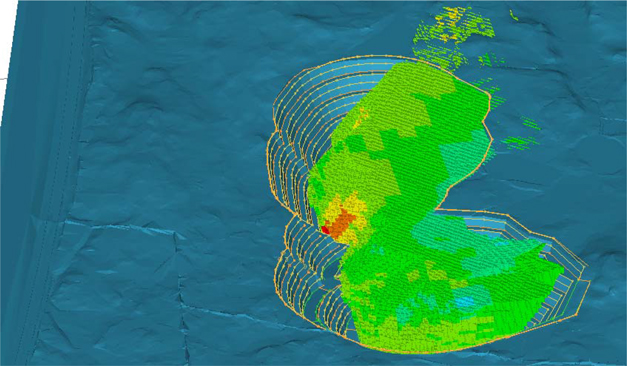 tpg190a
tpg190a
Figure 15-1: Norra Kärr – Cut away view – Pit Design and Block Model
(Showing Ore Blocks)
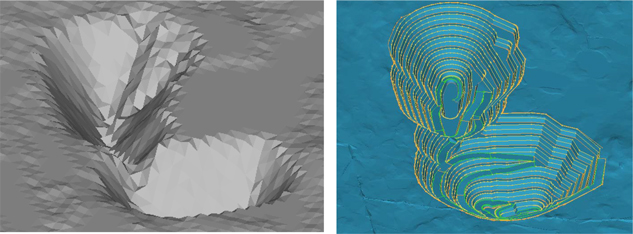
Figure 15-2: Norra Kärr – Optimised Ultimate Pit and Design Pit Shell
 |  |
| | Prefeasibility Study - NI 43-101 - Technical report for the Norra Kärr Rare
Earth Element Deposit - 0465-RPT-014 Rev 0 |
Table 15-1: Norra Kärr Pit Optimisation Parameters
| Description | | Unit | | Amount | | Source |
| Metal Price | | | | | | |
| Cerium Oxide | | USD/g | | 0.005 | | Rev D - Carolyn Dennis |
| Dysprosium Oxide | | USD/g | | 0.575 | | Rev D - Carolyn Dennis |
| Erbium Oxide | | USD/g | | 0.000 | | Rev D - Carolyn Dennis |
| Europium Oxide | | USD/g | | 0.700 | | Rev D - Carolyn Dennis |
| Gadolinium Oxide | | USD/g | | 0.040 | | Rev D - Carolyn Dennis |
| Holmium Oxide | | USD/g | | 0.000 | | Rev D - Carolyn Dennis |
| Lanthanum Oxide | | USD/g | | 0.007 | | Rev D - Carolyn Dennis |
| Lutetium Oxide | | USD/g | | 0.900 | | Rev D - Carolyn Dennis |
| Neodymium Oxide | | USD/g | | 0.080 | | Rev D - Carolyn Dennis |
| Praseodymium Oxide | | USD/g | | 0.115 | | Rev D - Carolyn Dennis |
| Samarium Oxide | | USD/g | | 0.008 | | Rev D - Carolyn Dennis |
| Terbium Oxide | | USD/g | | 0.950 | | Rev D - Carolyn Dennis |
| Thulium Oxide | | USD/g | | 0.000 | | Rev D - Carolyn Dennis |
| Yttrium Oxide | | USD/g | | 0.025 | | Rev D - Carolyn Dennis |
| Ytterbium Oxide | | USD/g | | 0.000 | | Rev D - Carolyn Dennis |
| | | | | | | |
| Mining Costs | | | | | | |
| Mining cost | | USD/t | | 3.47 | | WAI OPEX Calculation (30/10/14) |
| | | | | | | |
| TREO Processing Costs | | | | | | |
| Processing (Inc G&A) | | USD/t Ore | | 88.04 | | GBM 0465-CAL-013 |
| Treatment & Refining | | USD/g Product | | 0.019 | | Tasman Quote – Confirmed (28/10/14) |
| | | | | | | |
| Metallurgical Recovery | | | | | | |
| Cerium Oxide | | % | | 78.0 | | GBM CAL 0464-CAL-002 Rev A |
| Dysprosium Oxide | | % | | 78.8 | | GBM CAL 0464-CAL-002 Rev A |
| Erbium Oxide | | % | | 77.4 | | GBM CAL 0464-CAL-002 Rev A |
| Europium Oxide | | % | | 79.4 | | GBM CAL 0464-CAL-002 Rev A |
| Gadolinium Oxide | | % | | 79.3 | | GBM CAL 0464-CAL-002 Rev A |
| Holmium Oxide | | % | | 78.0 | | GBM CAL 0464-CAL-002 Rev A |
| Lanthanum Oxide | | % | | 77.8 | | GBM CAL 0464-CAL-002 Rev A |
| Lutetium Oxide | | % | | 75.5 | | GBM CAL 0464-CAL-002 Rev A |
| Neodymium Oxide | | % | | 79.0 | | GBM CAL 0464-CAL-002 Rev A |
| Praseodymium Oxide | | % | | 78.8 | | GBM CAL 0464-CAL-002 Rev A |
 |  |
| | Prefeasibility Study - NI 43-101 - Technical report for the Norra Kärr Rare
Earth Element Deposit - 0465-RPT-014 Rev 0 |
| Samarium Oxide | | % | | 79.4 | | GBM CAL 0464-CAL-002 Rev A |
| Terbium Oxide | | % | | 79.1 | | GBM CAL 0464-CAL-002 Rev A |
| Thulium Oxide | | % | | 76.9 | | GBM CAL 0464-CAL-002 Rev A |
| Yttrium Oxide | | % | | 72.9 | | GBM CAL 0464-CAL-002 Rev A |
| Ytterbium Oxide | | % | | 76.1 | | GBM CAL 0464-CAL-002 Rev A |
| | | | | | | |
| Selling Cost | | | | | | |
| Royalty (% Metal Price) | | % | | 0.20 | | Swedish Minerals Act |
| | | | | | | |
| Other | | | | | | |
| Mining Dilution | | % | | 3.50 | | WAI Dilution Study |
| Mining Loss | | % | | 5.01 | | WAI Dilution Study |
| Production rate | | Mtpa | | 1.15 | | GBM Processing OPEX 0465-CAL-013_RevA |
| Discount Factor | | % | | 10 | | WAI Standard Rate |
| Cut-Off Grade | | g/t | | x | | Economic Cut-off Grade (NPVS) |
| Reporting | | | | | | Report ZrO2 |
| | | | | | | |
| Slope Angle (IRA) | | | | | | |
| Azi 000 | | (°) | | 53 | | WAI Geotechnical Report |
| Azi 045 | | (°) | | 53 | | WAI Geotechnical Report |
| Azi 090 | | (°) | | 56 | | WAI Geotechnical Report |
| Azi 135 | | (°) | | 51 | | WAI Geotechnical Report |
| Azi 180 | | (°) | | 53 | | WAI Geotechnical Report |
| Azi 225 | | (°) | | 53 | | WAI Geotechnical Report |
| Azi 270 | | (°) | | 53 | | WAI Geotechnical Report |
| Azi 315 | | (°) | | 53 | | WAI Geotechnical Report |
The parameters in Table 15-1 have been used for pit optimisation. REE prices have been based on a market study using current market prices and projections. For the purpose of mine planning and due to the complexity of modelling multi-metals deposits, NPVS was used to determine economic blocks to be mined based on a combined metal ore parcel value. This, in essence, means that while economic cut-off grades for individual metals are reported, due to the combination of multiple metals within a single block of differing grade and value this will often mean that the block is economic to be extracted, even if individual grades are below the cut-off grades.
 |  |
| | Prefeasibility Study - NI 43-101 - Technical report for the Norra Kärr Rare
Earth Element Deposit - 0465-RPT-014 Rev 0 |
| 15.3 | Economic Cut-Off Grades |
The economic cut-off grade is defined as the point where revenue per mass unit is equal to the processing cost per mass unit. The processing cost includes the effect of dilution and the selling cost; the selling cost includes refining and royalty. It is important to note that the economic cut-off grade does take account of the mining cost; the economic cut-off grade is used as an ore test for material, ergo if the revenue exceeds processing costs then the block is considered for mining depending on its position and time dependency.
The break-even economic cut-off grades are shown in Table 15-2.
Table 15-2: Economic Cut-Off Grades (PGT & GTM)
| Metal Oxide | | Cut-Off Grade | | Metal Oxide | | Cut-Off Grade |
| Ce2O3 | | Infinite | | Nd2O3 | | 2 002.2 |
| Dy2O3 | | 210.9 | | Pr2O3 | | 1 251.9 |
| Er2O3 | | Infinite | | Sm2O3 | | Infinite |
| Eu2O3 | | 170.7 | | Tb2O3 | | 125.3 |
| Gd2O3 | | 6 427.2 | | Tm2O3 | | Infinite |
| Ho2O3 | | Infinite | | Y2O3 | | 47 949.0 |
| La2O3 | | Infinite | | Yb2O3 | | Infinite |
| Lu2O3 | | 138.7 | | | | |
N.B.WhereInfinite is shown, the metal oxide is uneconomic to mine at the given parameters.
The project has been constrained on the following criteria:
| · | Mine life limited to 20 years. |
| · | Maintaining a safe blast exclusion zone from the E4 Highway to the east (260 m). |
| · | Consider PGT and GTM as ore units only. |
Pit shell selection was based a series of Lerch-Grosman phase pits which were run at incremental commodity price factors, producing a series of nested shells. The unconstrained pit shell would correspond to a mine life in excess of 70 years at a production rate of 1.15 Mtpa of ore. With the target production rate of 1.15 Mtpa ore for 20 years, a Lerch-Grosman phase shell was selected with contained ore in the region of 23 Mt. The Lerch-Grosman phase shell is the optimised shell shape for the corresponding commodity price. This shell was used as a basis for the final pit design, which is shown in Figure 15-3 in plan view.
 |  |
| | Prefeasibility Study - NI 43-101 - Technical report for the Norra Kärr Rare
Earth Element Deposit - 0465-RPT-014 Rev 0 |
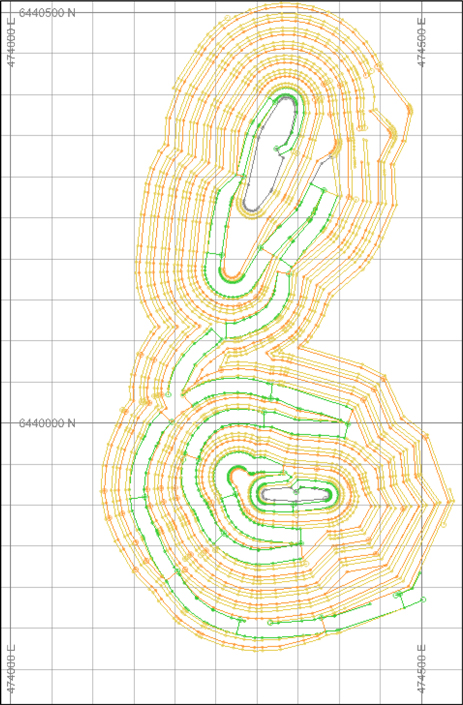
Figure 15-3 Norra Kärr – Plan of Final Pit Design
Table 15-3 details the Nora Kärr Mineral Reserve estimate.
 |  |
| | Prefeasibility Study - NI 43-101 - Technical report for the Norra Kärr Rare
Earth Element Deposit - 0465-RPT-014 Rev 0 |
Table 15-3: Norra Kärr Mineral Reserve Estimate (WAI, November 2014)
| Classification | | Ore Tonnes
(kt) | | | TREO
(%) | | | HREO
(%) | | | % HREO
in TREO | | | Ce2O3
(%) | | | Dy2O3
(%) | | | Er2O3
(%) | | | Eu2O3
(%) | | | Gd2O3
(%) | | | Ho2O3
(%) | | | La2O3
(%) | | | Lu2O3
(%) | |
| Proved | | - | | | - | | | - | | | - | | | - | | | - | | | - | | | - | | | - | | | - | | | - | | | - | |
| Probable | | 23 571 | | | 0.592 | | | 0.314 | | | 0.531 | | | 0.124 | | | 0.0269 | | | 0.0184 | | | 0.00218 | | | 0.0196 | | | 0.00593 | | | 0.0551 | | | 0.00234 | |
| TOTAL | | 23 571 | | | 0.592 | | | 0.314 | | | 0.531 | | | 0.124 | | | 0.0269 | | | 0.0184 | | | 0.00218 | | | 0.0196 | | | 0.00593 | | | 0.0551 | | | 0.00234 | |
| | | | | | | | | | | | | | | | | | | | | | | | | | | | | | | | | | | | | | | | | | | | | | | | | |
| Classification | | Ore Tonnes
(kt) | | | Nd2O3
(%) | | | Pr2O3
(%) | | | Sm2O3
(%) | | | Tb2O3
(%) | | | Tm2O3
(%) | | | Y2O3
(%) | | | Yb2O3
(%) | | | Zr
(%) | | | U
(%) | | | Th
(%) | | | Hf
(%) | |
| Proved | | - | | | - | | | - | | | - | | | - | | | - | | | - | | | - | | | - | | | - | | | - | | | - | |
| Probable | | 23 571 | | | 0.0648 | | | 0.0161 | | | 0.0178 | | | 0.00396 | | | 0.00280 | | | 0.215 | | | 0.0172 | | | 1.36 | | | 0.00131 | | | 0.000663 | | | 0.0286 | |
| TOTAL | | 23 571 | | | 0.0648 | | | 0.0161 | | | 0.0178 | | | 0.00396 | | | 0.00280 | | | 0.215 | | | 0.0172 | | | 1.36 | | | 0.00131 | | | 0.000663 | | | 0.0286 | |
| | | | | | | | | | | | | | | | | | | | | | | | | | | | | | | | | | | | | | | | | | | | | | | | | |
Notes:
| 1) | Mineral Reserves are reported based on material contained within the Design Final Pit Shell. |
| 2) | Mineral Reserves are constrained a designed 20yr mine life. |
| 3) | Mineral Reserves are reported for combined GTM and PGT mineralisation only. |
| 4) | Mineral Reserves reported have been adjusted for Mining factors, at 3.5 % Dilution and 5.0 % Loss. |
| 5) | Mineral Reserves are reported to 3 S.F. |
| 6) | Total Rare Earth Oxides (TREO) includes: La2O3, Ce2O3, Pr2O3, Nd2O3, Sm2O3, Eu2O3, Gd2O3, Tb2O3, Dy2O3, Ho2O3, Er2O3, Tm2O3, Yb2O3, Lu2O3, Y2O3. |
| 7) | Heavy Rare Earth Oxides (HREO) includes: Eu2O3, Gd2O3, Tb2O3, Dy2O3, Ho2O3, Er2O3, Tm2O3, Yb2O3, Lu2O3, Y2O3. |
 |  |
| | Prefeasibility Study - NI 43-101 - Technical report for the Norra Kärr Rare
Earth Element Deposit - 0465-RPT-014 Rev 0 |
Section 16 Mining Methods
Open pit operations are planned to be conventional diesel hydraulic shovel and truck extraction, with drill and blasting of final benches at 20 m height. The mine life has been designed at 20 years. There is pre-stripping required of 600 kt waste and 60 days have been allocated for this task. The life of mine (LOM) mining rate averages 1.15 Mt/a ore and 0.84 Mt/a waste.
The mine plan has been developed using owner-operated equipment in all aspects of mining. Hauling is scheduled to operate on a single eight hour shift per day, five days a week. This equates to 241 operating calendar days, less five days for weather delays. Blast hole drilling operates on two eight hour shifts at the same operating days due to drilling requirements. It has been assumed there will be 85 % operating availability of equipment.
| 16.1 | Mining Operations and Equipment |
Blast fragmentation was required to meet a maximum of 600 mm for a planned crusher and the blast design was made to ensure fly rock does not affect the E4 highway located to the west.
| 16.1.1 | Blast hole Drilling |
Blast hole drilling will be completed with a track mounted blast hole drill, such as an Atlas Copco Flex Roc D60. Final bench heights will be 20 m, fired in two lifts. Owing to the bulk nature and similarity of ore and waste, a blasting pattern has been designed for use in all materials. Vertical 110 mm (4.3”) diameter holes at a 2.75 m x 3.25 m staggered pattern are planned with 0.37 m sub-drill and 2.75 m stemming.
The overall blast design has a tight pattern with relatively small hole diameters and increased stemming, this is due to the fragmentation and fly rock constraints, whilst meeting targeted powder factors for the rock mass.
 |  |
| | Prefeasibility Study - NI 43-101 - Technical report for the Norra Kärr Rare
Earth Element Deposit - 0465-RPT-014 Rev 0 |
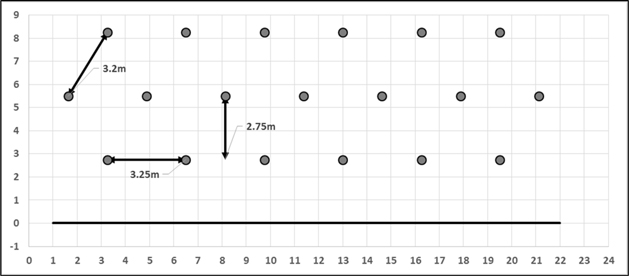
Figure 16-1: Example Blast Pattern
Fly rock is a major controllable feature of the blast design and has influenced the drill and blast design. Face surveying prior to drilling is required to ensure correct burden spacing, as this is a primary cause of fly rock. Equally, sub drill depth has been minimised to avoid damage to the top of the bench and thus the effect of crater fly rock. In initial blasting in upper benches located closest to the highway blast matting and management practices will be required to reduce the fly rock risk.
Trial blasting away from the highway must be practiced to check the design, and allow back analysis and case history to be recorded.
Fly rock estimation has been based on the effect of bench-top and vertical face fly rock, the American model by Roth (1979) (13) has been used for estimation. In calculating the estimate, the rock type is assumed to be a granite and an addition has been added for using emulsion rather than ANFO. The model uses nonographs to calculate the ranges, the nonographs are based on work by Gurney which calculates the initial velocity of rock fragments propelled by an explosive, then based on ballistic trajectory formula for a single drill hole:
Face Flyrock: 67.5 m
Bench Top Flyrock: 160 m
The pit rim of the design open pit is 260m away from the E4 highway, based on the calculated flyrock projection of 160m, the blast design is within this distance and therefore WAI has selected this blast design.
 |  |
| | Prefeasibility Study - NI 43-101 - Technical report for the Norra Kärr Rare
Earth Element Deposit - 0465-RPT-014 Rev 0 |
The loading sequence will start by lowering a 454 g (1 lb) booster down the hole. The booster will be attached with two non-electric detonators. It is anticipated that the mine will have damp holes, and owing to the fragmentation requirements, 100 % emulsion will be used as the primary blasting agent. Bulk emulsion will be mixed on site prior to loading into holes. A loading truck will transport the mixed emulsion to the holes and pour a measured load into the holes. The remaining holes will be filled with crushed rock, acting as stemming, this will control the blast energy and minimise fly rock, (10 mm angular chippings are recommended).
Once holes are loaded, the lead lines to the blasting caps will be tied together with a series of downhole and surface delays to control the blast. There is provision for use of blasting mats where required to prevent surface crater fly rock; typically heavy conveyor belts, bolted into sheets is sufficient. To minimise operating delays, blasting will occur at the end of shifts.
An example of the blast pattern is shown in Figure 16-1. An average annual blasted volume of 426 000 m3 will be required, which will equate to controlled indicative blast volumes of 2 130 m3, or 5 750 bcm every two to three days. Initially powder factor (kilogram of explosive per tonne of rock) has been designed at 0.27 kg/t, once in production with site experience and analysis, the design will be optimised for safety, fragmentation, fly rock, and cost.
Blasting design fragmentation has been analysed using the KUZ-RAM fragmentation analysis, oversize criteria has been set at 600 mm, with the current blast design oversize material is estimated at 3.5 %. Secondary blasting will be conducted on oversize blocks at the same time as primary blasting. Once sufficient oversize material is collected, secondary blasting will use smaller diameter holes and pre-packaged explosives to split or crack the oversize material into manageable pieces.
Loading will be undertaken using a hydraulic shovel and large wheel loader as a back-up. The primary excavator will be a 100 tonne class unit with a 6.7 m3 bucket, such as the Komatsu PC1250-8. The shovel has been planned in a face shovel configuration as this will allow good operator visibility, selectivity, and allow the unit to scale loose blocks either reaching upwards or downwards on the 20 m bench.
The wheel loader is planned for auxiliary tasks such as muck pile loading and bench clean ups, as well as acting as another loading unit in case of mechanical down time on the primary hydraulic excavator. The wheel loader will have a 6.9 m3 bucket, such as a Volvo L250G, this is sized to match 55 tonne payload trucks.
Loading was estimated using a 0.95 % fill factor and a swell factor of 1.55. The loading parameters are shown in Table 16-1.
 |  |
| | Prefeasibility Study - NI 43-101 - Technical report for the Norra Kärr Rare
Earth Element Deposit - 0465-RPT-014 Rev 0 |
Table 16-1: Loading Parameters
| Unit | | Capacity
(m3) | | | Bank
Density
(t/m3) | | Swell
Factor | | | Fill
Factor (%) | | | Bucket
Capacity (t) | | | Cycle
Time (s) | |
| PC 1250-7 | | | | | | | | | | | | | | | | | | | | | | |
| Ore | | | 6.7 | | | 2.70 (Av.) | | | 1.55 | | | | 95 | | | | 10.7 | | | | 100 | |
| Waste | | | 6.7 | | | 2.72 (Av.) | | | 1.55 | | | | 95 | | | | 11.1 | | | | 100 | |
Haulage will be done using 55 tonne class haul trucks. CAT 773G (55.3 t, 35.8 m3 capacity) rigid body haul trucks were planned with the excavating units and for haulage profiles. Oversize or unmanageable blocks will be separated by the hydraulic excavator then transported using the wheel loader to a separate area.
Mining haul ramps are designed at 10 % gradient and at 18 m width, a rolling resistance of 2 % has been assumed (2 % is equivalent to a hard, smooth surface stabilised surface, watered and maintained). Although the haul trucks are capable of descending at over 50 km/h, a site speed limit for heavy plant of 30 km/h on ramps and 40 km/h on the flat is recommended. The mine model has set the haul truck descending speed to match the inclined speed to ensure a constant cycle, thus avoiding trucks waiting to be loaded.
Table 16-2 shows the fixed haulage times assumed for the loading, spotting, and dumping.
Table 16-2: Truck Loading and Dumping Parameters
| CAT 773G | | | Capacity (t) | | | | Loaded (t) | | | | Load Time
(min) | | | | Spot Time
(min) | | | | Dump Time
(min) | |
| Ore | | | 55.3 | | | | 54.8 | | | | 0.9 | | | | 0.1 | | | | 0.03 | |
| Waste | | | 55.3 | | | | 55.6 | | | | 0.9 | | | | 0.1 | | | | 0.03 | |
 |  |
| | Prefeasibility Study - NI 43-101 - Technical report for the Norra Kärr Rare
Earth Element Deposit - 0465-RPT-014 Rev 0 |
| 16.2 | Equipment Fleet Summary |
The primary mine equipment fleet support mine equipment is summarized in Table 16-3.
Table 16-3: Mining Equipment Fleet
| Equipment Model | | Description | | Information | | Max. Number Required |
| AC FlexROC D60 | | Production Drill | | 110-170 mm dia. holes, 54 m max. depth | | 2 |
| Komatsu PC1250-7 | | Hydraulic Excavator | | 6.7 m3 bucket capacity | | 2 |
| Volvo L250G | | Front End Loader | | 6.9 m3 bucket capacity | | 1 |
| CAT 773G | | Rigid-Body Haul Truck | | 55.3 t Payload | | 7 |
| Volvo G990 | | Motor Grader | | 4.3 m blade width | | 1 |
| Volvo FM84 | | Water Tanker | | 30 000 l tank | | 1 |
| Volvo FM66 | | Fuel Tanker | | 12 000 l tank | | 1 |
| 16.2.1 | Major Support Equipment |
Support equipment comprises of a grader, a water truck, and light plants to facilitate mining operations. Ore will be hauled to a ROM pad, where it will be crushed and fed into processing operations.
The equipment profiles of major mining equipment are shown graphically in Figure 16-2.
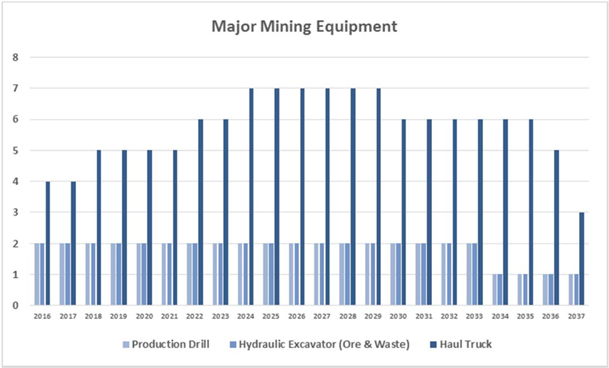
Figure 16-2: LOM Equipment Profile
 |  |
| | Prefeasibility Study - NI 43-101 - Technical report for the Norra Kärr Rare
Earth Element Deposit - 0465-RPT-014 Rev 0 |
The mine site and dumps are located on generally flat terrain with top soil or transitional material making the immediate material. Where top soil can be recovered, it will be collected into stockpiles where it can be sourced for future rehabilitation.
The mine design consists of an open pit, 870 m long, 370 m wide, and 150 m deep, with a volume of 22.6 Mm3. The open pit has a low strip ratio (S.R. = 0.73:1, waste to ore) and is located on a relatively level area. The pit has two main pushbacks before reaching final limits and has been designed with 17.8 m wide haul ramps with an in pit gradient of 10 %. The pit entrance/exit points have been designed to exit at the southern extent of the pit.
In the south east of the deposit, a known fault zone exists which has been intercepted by drilling. In recovered core, it is shown as a highly broken zone two to five metres wide. A standoff distance to the fault of 20 m from the pit has been designed to ensure that it does not act as a major release plane. Pushbacks and final designs are shown in Figure 16-6.
Haul ramps within the pit have been designed to avoid the south east fault area and the western area as the geotechnical assessment show some potential poor ground areas in the drill results.
Haul roads have been indicatively planned from the entrance/exit of the open pit directly to the ROM pad to the south. A spur has been included in the design for access to the mine waste dumps, Figure 16-3 shows the planned layout.
 |  |
| | Prefeasibility Study - NI 43-101 - Technical report for the Norra Kärr Rare
Earth Element Deposit - 0465-RPT-014 Rev 0 |
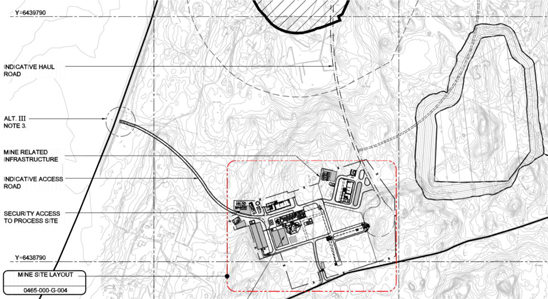
Figure 16-3: Site Plan, Main Haul Roads
Haul road design has used the parameters detailed in Table 16-4.
Table 16-4: Haul Road Design Parameters
| Parameter | | Value |
| Total Distance | | 1 120 m |
| Two –Way Traffic | | 3 x Truck Width |
| Truck Width (CAT 773G) | | 4.9 m |
| Ditching (1 m Depth) * 1:1 | | 2.0 m |
| Total Width | | 17.8 m ≈ 20 m |
The final costing for the haul roads is based on a semi-permanent haul road, as the layouts are not going to change significantly over the mine life. Semi-permanent haul roads also give optimum rolling resistance characteristics. The construction of haul roads have been typically costed and designed as illustrated in Figure 16-4.
 |  |
| | Prefeasibility Study - NI 43-101 - Technical report for the Norra Kärr Rare
Earth Element Deposit - 0465-RPT-014 Rev 0 |
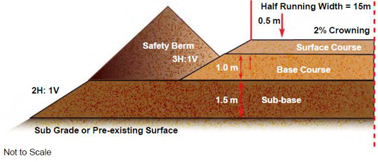
Figure 16-4: Typical Haul Road Construction (CAT Publication) (14)
An allowance has been made for clearance of the haul road area, and base course (typically crushed rock) will be sourced from the open pit. Costs have been applied for the sub-base (sand) and final surface material (crushed gravel).
| 16.4 | Mine Manpower Requirements |
It is anticipated that the mine will be owner-operated, employing full-time management and operations personnel. Salaried personnel wages will be based upon the structure detailed in Table 16-5.
Table 16-5: Salary Structure
| Grade | | Description | | Salary (USD/annum) |
| A | | General Manager | | 191 156 |
| B | | Senior Management/Chief Super | | 109 233 |
| D | | Supervisor - Mine | | 95 579 |
| E | | Engineer | | 81 925 |
| F | | Process Operator/Technician/Officer | | 82 611 |
| G | | Driver / Operator | | 75 693 |
| H | | Artisan/Mechanic/Electrician | | 74 837 |
| I | | Labour/Cleric Day Shift | | 60 272 |
Table 16-6 summarises the total personnel required for mining operations on the project. It should be noted that no provision has been made for a site general manager or technical services manager as these roles are included within the overall project cost centre. Furthermore, as blasting operations are to be carried out by contractor, the personnel schedule includes only for a blasting superintendent to oversee these works.
 |  |
| | Prefeasibility Study - NI 43-101 - Technical report for the Norra Kärr Rare
Earth Element Deposit - 0465-RPT-014 Rev 0 |
Table 16-6: Mining Personnel Requirements
| Position | | Grade | | Maximum Number Required |
| Management & Operations | | | | |
| Mine Manager | | B | | 1 |
| Foreman | | C | | 1 |
| Mine Shift Supervisor | | D | | 1 |
| Excavator Operator | | G | | 2 |
| Production Truck Driver | | G | | 7 |
| Drill Operator | | G | | 6 |
| Grader/Water/Telehandler Operator | | G | | 1 |
| Blast Team Supervisor | | D | | 1 |
| FEL Operator at ROM pad | | H | | 1 |
| Technical Services | | | | |
| Chief Mining Engineer | | D | | 1 |
| Senior Mining Engineer | | E | | 1 |
| Chief Geologist | | D | | 1 |
| Senior Geologist | | E | | 1 |
| Geologist’s Assistant | | I | | 1 |
| Chief Surveyor | | D | | 1 |
| Surveyor | | F | | 1 |
| Surveyor’s Assistant | | I | | 1 |
| Maintenance & Administration | | | | |
| Maintenance Superintendent | | B | | 1 |
| Maintenance Supervisor | | D | | 1 |
| Maintenance Planner | | E | | 1 |
| Maintenance Fitter | | G | | 2 |
| Electrician | | I | | 1 |
| Secretary/Clerk | | G | | 1 |
No allocation has been made for absenteeism within this estimate given the location of the project in Western Europe.
 |  |
| | Prefeasibility Study - NI 43-101 - Technical report for the Norra Kärr Rare
Earth Element Deposit - 0465-RPT-014 Rev 0 |
| 16.5 | Mine Production Schedule |
The final design was imported into NPVS and, with the pushback files, used to generate a mining schedule. Constraints for the schedule were a 1.15 Mtpa ore feed to the plant with a target of a constant stripping ratio where achievable. The mining schedule, which covers a period of 20.5 years, is summarised in Figure 16-5 and shown in detail in Table 16-7.
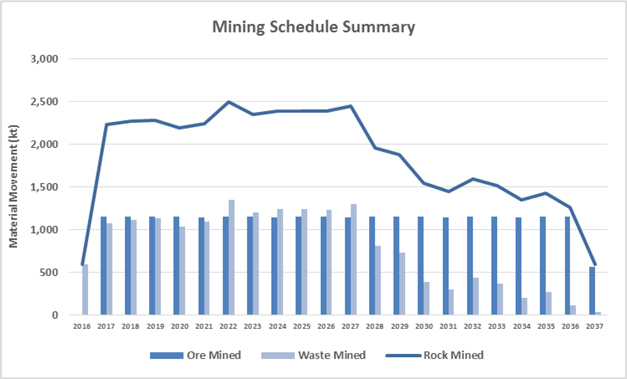
Figure 16-5: Mining Schedule Summary
| Prefeasibility Study - NI 43-101 - Technical report for the Norra Kärr Rare Earth Element Deposit - 0465-RPT-014 Rev 0 |
Table 16-7: Mining Production Schedule
| | | ORE MINED (Tonnes) | | TOTAL
ROCK | | Ce2O3 Grade (g/t) | | Dy2O3 Grade
(g/t) | | Er2O3 Grade
(g/t) | | Eu2O3 Grade
(g/t) | | Gd2O3 Grade
(g/t) | | Ho2O3 Grade
(g/t) | | La2O3 Grade
(g/t) | | Lu2O3 Grade
(g/t) | | Nd2O3 Grade
(g/t) | | Pr2O3 Grade
(g/t) | | Sm2O3 Grade
(g/t) |
| Year | | PGT Ore | | GTM Ore | | TOTAL
ORE | | MINED
(Tonnes) | | PGT
Feed | | GTM
Feed | | PGT
Feed | | GTM
Feed | | PGT
Feed | | GTM
Feed | | PGT
Feed | | GTM
Feed | | PGT
Feed | | GTM
Feed | | PGT
Feed | | GTM
Feed | | PGT
Feed | | GTM
Feed | | PGT
Feed | | GTM
Feed | | PGT
Feed | | GTM
Feed | | PGT
Feed | | GTM
Feed | | PGT
Feed | | GTM
Feed |
| 0 | | - | | - | | - | | 600 000 | | - | | - | | - | | - | | - | | - | | - | | - | | - | | - | | - | | - | | - | | - | | - | | - | | - | | - | | - | | - | | - | | - |
| 1 | | 934 284 | | 219 778 | | 1 154 063 | | 2 829 934 | | 1 198.1 | | 1 528.5 | | 269.6 | | 192.8 | | 180.4 | | 128.8 | | 22.1 | | 17.6 | | 200.6 | | 152.5 | | 59.8 | | 42.5 | | 508.4 | | 725.2 | | 23.1 | | 17.1 | | 646.7 | | 677.8 | | 158.9 | | 183.4 | | 184.4 | | 155.9 |
| 2 | | 905 069 | | 244 650 | | 1 149 719 | | 2 266 412 | | 1 177.8 | | 1 554.6 | | 264.5 | | 206.7 | | 180.4 | | 136.9 | | 21.8 | | 19.5 | | 193.9 | | 168.8 | | 59.4 | | 45.3 | | 497.0 | | 732.2 | | 23.4 | | 17.7 | | 635.8 | | 732.5 | | 156.7 | | 194.8 | | 175.5 | | 167.0 |
| 3 | | 916 367 | | 233 888 | | 1 150 255 | | 2 280 660 | | 1 204.8 | | 1 491.8 | | 270.3 | | 189.0 | | 180.9 | | 127.5 | | 22.3 | | 17.0 | | 199.9 | | 149.7 | | 59.8 | | 41.6 | | 516.2 | | 716.6 | | 23.1 | | 16.8 | | 649.6 | | 661.2 | | 160.4 | | 180.8 | | 183.3 | | 148.1 |
| 4 | | 874 584 | | 278 119 | | 1 152 703 | | 2 189 268 | | 1 250.2 | | 1 435.7 | | 275.0 | | 187.4 | | 183.7 | | 128.5 | | 22.8 | | 16.6 | | 202.8 | | 146.3 | | 60.6 | | 41.4 | | 540.8 | | 709.7 | | 23.5 | | 17.0 | | 673.2 | | 632.4 | | 165.8 | | 173.9 | | 187.4 | | 143.0 |
| 5 | | 820 031 | | 326 354 | | 1 146 384 | | 2 237 388 | | 1 280.2 | | 1 561.4 | | 273.2 | | 205.2 | | 180.2 | | 136.9 | | 23.0 | | 18.9 | | 203.8 | | 164.8 | | 60.1 | | 44.7 | | 543.3 | | 742.9 | | 22.9 | | 17.8 | | 693.5 | | 715.6 | | 169.9 | | 195.3 | | 189.3 | | 164.9 |
| 6 | | 771 495 | | 378 459 | | 1 149 954 | | 2 497 211 | | 1 318.8 | | 1 603.9 | | 267.4 | | 213.2 | | 175.0 | | 141.8 | | 22.8 | | 20.1 | | 202.8 | | 173.2 | | 58.8 | | 46.9 | | 554.3 | | 760.8 | | 22.0 | | 18.1 | | 709.9 | | 754.1 | | 175.1 | | 205.0 | | 190.9 | | 174.1 |
| 7 | | 901 392 | | 249 638 | | 1 151 030 | | 2 350 457 | | 1 153.6 | | 1 440.6 | | 291.0 | | 181.8 | | 199.0 | | 124.6 | | 22.5 | | 16.3 | | 205.3 | | 142.4 | | 64.7 | | 40.2 | | 521.1 | | 687.1 | | 25.4 | | 16.8 | | 627.8 | | 633.3 | | 153.9 | | 170.9 | | 182.2 | | 144.0 |
| 8 | | 913 426 | | 235 200 | | 1 148 626 | | 2 392 760 | | 1 134.3 | | 1 415.5 | | 287.9 | | 183.6 | | 198.2 | | 125.4 | | 22.1 | | 17.0 | | 203.7 | | 147.9 | | 64.1 | | 40.1 | | 507.9 | | 685.8 | | 25.4 | | 16.9 | | 617.2 | | 641.4 | | 151.3 | | 170.6 | | 179.4 | | 146.0 |
| 9 | | 911 888 | | 239 072 | | 1 150 960 | | 2 392 538 | | 1 131.4 | | 1 372.9 | | 285.5 | | 174.6 | | 197.6 | | 121.1 | | 22.0 | | 15.2 | | 202.6 | | 134.9 | | 63.5 | | 39.3 | | 503.2 | | 681.6 | | 25.3 | | 16.4 | | 619.1 | | 593.3 | | 151.1 | | 163.8 | | 180.0 | | 131.0 |
| 10 | | 930 005 | | 222 600 | | 1 152 606 | | 2 385 230 | | 1 122.7 | | 1 341.1 | | 286.9 | | 175.0 | | 197.7 | | 123.0 | | 22.1 | | 15.1 | | 203.2 | | 133.5 | | 63.3 | | 39.0 | | 497.7 | | 668.0 | | 25.2 | | 16.5 | | 615.1 | | 570.5 | | 150.1 | | 157.8 | | 177.7 | | 128.2 |
| 11 | | 924 991 | | 219 778 | | 1 144 770 | | 2 444 055 | | 1 091.8 | | 1 379.7 | | 277.0 | | 171.6 | | 189.9 | | 120.2 | | 21.9 | | 15.0 | | 196.4 | | 131.7 | | 61.4 | | 38.0 | | 480.0 | | 685.6 | | 24.2 | | 16.0 | | 605.8 | | 582.9 | | 147.5 | | 162.3 | | 172.9 | | 128.8 |
| 12 | | 863 619 | | 289 013 | | 1 152 632 | | 1 961 698 | | 1 069.6 | | 1 381.6 | | 272.5 | | 180.7 | | 187.0 | | 125.9 | | 21.3 | | 15.7 | | 192.5 | | 137.7 | | 60.2 | | 39.8 | | 468.7 | | 684.7 | | 23.7 | | 16.6 | | 590.6 | | 599.3 | | 144.0 | | 165.8 | | 170.7 | | 133.8 |
| 13 | | 985 294 | | 164 718 | | 1 150 012 | | 1 878 749 | | 1 104.3 | | 1 454.1 | | 279.2 | | 188.2 | | 191.0 | | 130.2 | | 22.2 | | 17.1 | | 199.2 | | 146.5 | | 61.5 | | 41.7 | | 486.4 | | 691.2 | | 24.1 | | 16.8 | | 612.9 | | 646.5 | | 148.9 | | 177.4 | | 175.1 | | 147.3 |
| 14 | | 852 722 | | 301 088 | | 1 153 810 | | 1 547 575 | | 1 152.7 | | 1 409.7 | | 276.1 | | 182.9 | | 188.1 | | 127.8 | | 22.5 | | 16.1 | | 202.4 | | 140.6 | | 60.3 | | 40.4 | | 501.4 | | 689.2 | | 23.7 | | 16.5 | | 634.9 | | 611.8 | | 154.3 | | 168.7 | | 179.2 | | 137.5 |
| 15 | | 1 082 432 | | 64 838 | | 1 147 270 | | 1 450 479 | | 1 145.9 | | 1 678.3 | | 294.4 | | 216.4 | | 204.7 | | 141.6 | | 22.5 | | 21.1 | | 208.2 | | 179.8 | | 64.9 | | 46.0 | | 505.3 | | 769.8 | | 25.8 | | 17.9 | | 626.5 | | 802.0 | | 151.8 | | 215.9 | | 181.5 | | 183.9 |
| 16 | | 907 342 | | 242 091 | | 1 149 433 | | 1 590 690 | | 1 233.8 | | 1 477.3 | | 282.8 | | 185.7 | | 193.5 | | 128.2 | | 23.6 | | 17.0 | | 209.9 | | 147.2 | | 61.8 | | 40.7 | | 533.5 | | 703.9 | | 24.2 | | 16.5 | | 676.4 | | 651.2 | | 164.4 | | 177.4 | | 191.2 | | 147.3 |
| 17 | | 1 041 384 | | 110 513 | | 1 151 897 | | 1 517 339 | | 1 214.5 | | 1 556.5 | | 291.4 | | 197.4 | | 200.2 | | 133.7 | | 23.7 | | 18.8 | | 211.8 | | 161.3 | | 63.7 | | 42.8 | | 528.9 | | 738.3 | | 25.1 | | 16.8 | | 661.4 | | 719.7 | | 160.5 | | 193.7 | | 188.8 | | 163.3 |
| 18 | | 1 092 728 | | 51 319 | | 1 144 047 | | 1 349 541 | | 1 201.9 | | 1 655.1 | | 295.8 | | 208.1 | | 205.6 | | 138.0 | | 23.6 | | 20.0 | | 214.8 | | 173.1 | | 65.0 | | 44.7 | | 523.5 | | 781.0 | | 25.9 | | 17.0 | | 649.2 | | 768.0 | | 157.5 | | 206.5 | | 187.5 | | 172.4 |
| 19 | | 1119 135 | | 33 534 | | 1 152 669 | | 1 426 368 | | 1 266.7 | | 1 761.4 | | 308.0 | | 153.4 | | 213.9 | | 98.5 | | 24.7 | | 16.3 | | 225.8 | | 140.1 | | 67.8 | | 32.0 | | 555.8 | | 838.3 | | 26.8 | | 12.9 | | 692.2 | | 719.6 | | 166.6 | | 198.6 | | 196.7 | | 146.1 |
| 20 | | 1 151 894 | | 3 216 | | 1 155 110 | | 1 266 247 | | 1 239.6 | | - | | 310.7 | | 116.4 | | 217.5 | | 77.7 | | 24.0 | | 13.6 | | 222.0 | | 108.6 | | 68.9 | | 23.8 | | 546.0 | | 895.6 | | 27.6 | | 9.6 | | 671.4 | | 647.9 | | 161.7 | | 183.1 | | 195.4 | | 110.8 |
| 21 | | 562 576 | | - | | 562 576 | | 595 001 | | 1 209.7 | | - | | 324.9 | | - | | 228.6 | | - | | 23.8 | | - | | 225.6 | | - | | 73.1 | | - | | 544.2 | | - | | 29.2 | | - | | 663.8 | | - | | 157.9 | | - | | 193.2 | | - |
| TOTAL | | 19 462 659 | | 4 107 864 | | 23 570 523 | | 40 849 599 | | 1 185.51 | | 1 474.40 | | 285 | | 190 | | 195 | | 129 | | 23 | | 17 | | 206 | | 150 | | 63 | | 42 | | 517 | | 711 | | 25 | | 17 | | 646 | | 658 | | 157 | | 179 | | 184 | | 149 |
| Prefeasibility Study - NI 43-101 - Technical report for the Norra Kärr Rare Earth Element Deposit - 0465-RPT-014 Rev 0 |
Tb2O3 Grade
(g/t) | | Tm2O3
Grade (g/t) | | Y2O3Grade (g/t) | | Yb2O3Grade
(g/t) | | Zr Grade (g/t) | | U Grade
(g/t) | | Th (g/t) | | Hf (g/t) | | TREO (%) | | HREO (%) | | WASTE MINED (Tonnes) |
PGT Feed | | GTM Feed | | PGT Feed | | GTM Feed | | PGT Feed | | GTM Feed | | PGT Feed | | GTM Feed | | PGT Feed | | GTM Feed | | PGT Feed | | GTM Feed | | PGT Feed | | GTM Feed | | PGT Feed | | GTM Feed | | PGT Feed | | GTM Feed | | PGT Feed | | GTM Feed | | GTC (w) | | PGT (w) | | GTM (w) | | ELAK (w) | | GNT | | MAF | | KAX | | TOTAL WASTE |
| - | | - | | - | | - | | - | | - | | - | | - | | - | | - | | - | | - | | - | | - | | - | | - | | - | | - | | - | | - | | - | | - | | - | | - | | 600 000 | | - | | - | | 600 000 |
| 40.2 | | 29.5 | | 27.4 | | 20.2 | | 2 151.7 | | 1 590.3 | | 168.6 | | 125.0 | | 13 390.3 | | 10 501.4 | | 11.8 | | 20.0 | | 6.3 | | 10.6 | | 40.2 | | 29.5 | | 27.4 | | 20.2 | | 2 151.7 | | 1 590.3 | | 433 736 | | 16 016 | | 3 768 | | 81 035 | | 533 029 | | 4 658 | | 3 630 | | 1 075 871 |
| 39.0 | | 31.5 | | 27.6 | | 20.9 | | 2 100.5 | | 1 716.9 | | 168.3 | | 129.6 | | 14 208.7 | | 10 887.0 | | 12.9 | | 19.1 | | 5.4 | | 9.6 | | 39.0 | | 31.5 | | 27.6 | | 20.9 | | 2 100.5 | | 1 716.9 | | 140 581 | | 15 515 | | 4 194 | | - | | 943 114 | | - | | 13 289 | | 1 116 693 |
| 40.2 | | 28.6 | | 27.6 | | 19.7 | | 2 158.5 | | 1 565.2 | | 169.1 | | 123.2 | | 13 442.5 | | 10 301.4 | | 11.7 | | 19.8 | | 6.2 | | 10.1 | | 40.2 | | 28.6 | | 27.6 | | 19.7 | | 2 158.5 | | 1 565.2 | | 409 346 | | 15 709 | | 4 009 | | 65 349 | | 617 086 | | 4 452 | | 14 454 | | 1 130 405 |
| 40.9 | | 28.0 | | 28.2 | | 19.7 | | 2 192.3 | | 1 530.4 | | 172.3 | | 123.5 | | 13 501.4 | | 10 350.7 | | 12.2 | | 21.1 | | 6.2 | | 11.9 | | 40.9 | | 28.0 | | 28.2 | | 19.7 | | 2 192.3 | | 1 530.4 | | 365 376 | | 14 992 | | 4 768 | | 23 358 | | 560 461 | | 3 973 | | 63 636 | | 1 036 564 |
| 40.8 | | 31.3 | | 27.4 | | 20.7 | | 2 178.7 | | 1 693.7 | | 167.5 | | 129.0 | | 13 837.7 | | 11 035.7 | | 13.1 | | 19.9 | | 5.5 | | 11.0 | | 40.8 | | 31.3 | | 27.4 | | 20.7 | | 2 178.7 | | 1 693.7 | | 240 445 | | 14 057 | | 5 594 | | - | | 762 749 | | - | | 68 157 | | 1 091 003 |
| 40.2 | | 32.6 | | 26.6 | | 21.4 | | 2 125.6 | | 1 758.5 | | 162.7 | | 133.7 | | 13 494.7 | | 11 608.7 | | 13.7 | | 19.9 | | 6.2 | | 9.8 | | 40.2 | | 32.6 | | 26.6 | | 21.4 | | 2 125.6 | | 1 758.5 | | 318 899 | | 13 225 | | 6 755 | | 5 001 | | 962 482 | | 1 027 | | 39 867 | | 1 347 256 |
| 42.5 | | 27.3 | | 30.3 | | 19.4 | | 2 303.4 | | 1 517.9 | | 187.4 | | 120.5 | | 13 670.5 | | 10 308.2 | | 10.5 | | 21.1 | | 7.5 | | 10.1 | | 42.5 | | 27.3 | | 30.3 | | 19.4 | | 2 303.4 | | 1 517.9 | | 548 030 | | 15 452 | | 4 279 | | 35 552 | | 562 345 | | 14 248 | | 19 522 | | 1 199 428 |
| 42.0 | | 27.6 | | 30.3 | | 19.5 | | 2 266.7 | | 1 540.1 | | 186.6 | | 121.3 | | 13 705.3 | | 10 393.2 | | 10.9 | | 23.1 | | 7.0 | | 10.5 | | 42.0 | | 27.6 | | 30.3 | | 19.5 | | 2 266.7 | | 1 540.1 | | 503 112 | | 15 658 | | 4 032 | | 25 893 | | 632 419 | | 18 975 | | 44 045 | | 1 244 134 |
| 41.8 | | 25.8 | | 30.3 | | 18.7 | | 2 254.1 | | 1 415.5 | | 186.0 | | 117.0 | | 14 083.1 | | 9 918.8 | | 11.1 | | 21.0 | | 5.9 | | 11.6 | | 41.8 | | 25.8 | | 30.3 | | 18.7 | | 2 254.1 | | 1 415.5 | | 460 226 | | 15 632 | | 4 098 | | 24 454 | | 664 968 | | 17 536 | | 54 663 | | 1 241 577 |
| 42.1 | | 25.5 | | 30.3 | | 18.8 | | 2 261.8 | | 1 394.2 | | 185.4 | | 118.2 | | 14 419.3 | | 9 960.4 | | 11.2 | | 21.5 | | 5.7 | | 12.9 | | 42.1 | | 25.5 | | 30.3 | | 18.8 | | 2 261.8 | | 1 394.2 | | 536 987 | | 15 943 | | 3 816 | | 20 139 | | 568 061 | | 17 399 | | 70 281 | | 1 232 625 |
| 40.7 | | 25.3 | | 29.0 | | 18.3 | | 2 189.4 | | 1 374.9 | | 178.2 | | 115.2 | | 14 586.5 | | 9 909.2 | | 11.6 | | 21.0 | | 5.1 | | 11.6 | | 40.7 | | 25.3 | | 29.0 | | 18.3 | | 2 189.4 | | 1 374.9 | | 593 355 | | 15 857 | | 3 768 | | 15 413 | | 600 408 | | 10 275 | | 60 211 | | 1 299 286 |
| 39.9 | | 26.5 | | 28.6 | | 19.0 | | 2 167.1 | | 1 431.9 | | 175.6 | | 119.4 | | 14 543.0 | | 10 272.5 | | 11.9 | | 20.9 | | 5.0 | | 11.2 | | 39.9 | | 26.5 | | 28.6 | | 19.0 | | 2 167.1 | | 1 431.9 | | 363 547 | | 14 805 | | 4 954 | | 890 | | 355 685 | | - | | 69 185 | | 809 066 |
| 41.0 | | 28.0 | | 29.2 | | 19.7 | | 2 215.5 | | 1 531.4 | | 178.7 | | 123.2 | | 14 800.0 | | 10 768.1 | | 12.0 | | 20.4 | | 5.2 | | 9.9 | | 41.0 | | 28.0 | | 29.2 | | 19.7 | | 2 215.5 | | 1 531.4 | | 333 262 | | 16 890 | | 2 824 | | 1 096 | | 359 115 | | - | | 15 549 | | 728 736 |
| 40.7 | | 26.9 | | 28.7 | | 19.3 | | 2 230.9 | | 1 453.1 | | 175.6 | | 121.3 | | 14 523.7 | | 10 546.9 | | 12.0 | | 21.0 | | 5.3 | | 10.1 | | 40.7 | | 26.9 | | 28.7 | | 19.3 | | 2 230.9 | | 1 453.1 | | 202 437 | | 14 618 | | 5 161 | | - | | 146 067 | | - | | 25 482 | | 393 765 |
| 43.0 | | 33.3 | | 31.2 | | 21.8 | | 2 346.9 | | 1 806.8 | | 191.2 | | 135.5 | | 14 570.0 | | 11 695.7 | | 11.1 | | 18.8 | | 5.5 | | 8.5 | | 43.0 | | 33.3 | | 31.2 | | 21.8 | | 2 346.9 | | 1 806.8 | | 146 611 | | 18 556 | | 1 111 | | 2 055 | | 121 655 | | 13 221 | | - | | 303 209 |
| 41.9 | | 27.9 | | 29.4 | | 19.5 | | 2 304.3 | | 1 513.0 | | 178.7 | | 121.3 | | 14 175.8 | | 10 602.9 | | 12.0 | | 20.4 | | 5.3 | | 10.5 | | 41.9 | | 27.9 | | 29.4 | | 19.5 | | 2 304.3 | | 1 513.0 | | 240 445 | | 15 554 | | 4 150 | | 2 398 | | 169 806 | | - | | 8 905 | | 441 258 |
| 42.9 | | 29.9 | | 30.4 | | 20.3 | | 2 341.1 | | 1 637.7 | | 184.7 | | 126.7 | | 14 321.7 | | 10 788.4 | | 11.6 | | 19.6 | | 5.3 | | 11.2 | | 42.9 | | 29.9 | | 30.4 | | 20.3 | | 2 341.1 | | 1 637.7 | | 216 258 | | 17 852 | | 1 894 | | 3 356 | | 119 369 | | 6 713 | | - | | 365 442 |
| 43.2 | | 31.8 | | 31.3 | | 20.8 | | 2 392.3 | | 1 694.7 | | 190.3 | | 129.8 | | 14 564.3 | | 11 067.6 | | 11.2 | | 19.5 | | 5.1 | | 12.9 | | 43.2 | | 31.8 | | 31.3 | | 20.8 | | 2 392.3 | | 1 694.7 | | 100 744 | | 18 732 | | 880 | | 2 740 | | 66 712 | | 15 686 | | - | | 205 494 |
| 45.3 | | 24.4 | | 32.4 | | 15.9 | | 2 503.4 | | 1 342.0 | | 196.5 | | 100.2 | | 14 503.4 | | 8 756.5 | | 10.8 | | 23.5 | | 5.4 | | 32.6 | | 45.3 | | 24.4 | | 32.4 | | 15.9 | | 2 503.4 | | 1 342.0 | | 177 437 | | 19 185 | | 575 | | 68 | | 48 622 | | 27 811 | | - | | 273 698 |
| 45.5 | | 18.1 | | 33.0 | | 11.5 | | 2 467.6 | | 1 047.3 | | 200.6 | | 73.0 | | 14 625.1 | | 7 063.8 | | 10.5 | | 30.0 | | 5.6 | | 49.1 | | 45.5 | | 18.1 | | 33.0 | | 11.5 | | 2 467.6 | | 1 047.3 | | 49 796 | | 19 746 | | 55 | | - | | 16 880 | | 24 660 | | - | | 111 137 |
| 47.4 | | - | | 35.0 | | - | | 2 558.5 | | - | | 212.4 | | - | | 14 578.7 | | - | | 9.9 | | - | | 6.3 | | - | | 47.4 | | - | | 35.0 | | - | | 2 558.5 | | - | | 10 840 | | 9 644 | | - | | - | | 2 488 | | 9 453 | | - | | 32 425 |
| 42 | | 28 | | 30 | | 20 | | 2 275 | | 1 552 | | 182 | | 123 | | 14 186 | | 10 556 | | 11.6 | | 20.6 | | 5.7 | | 10.9 | | 42 | | 28 | | 30 | | 20 | | 2 275 | | 1 552 | | 6 391 470 | | 333 637 | | 70 686 | | 308 798 | | 9 413 522 | | 190 088 | | 570 879 | | 17 279 080 |
 |  |
| | Prefeasibility Study - NI 43-101 - Technical report for the Norra Kärr Rare
Earth Element Deposit - 0465-RPT-014 Rev 0 |
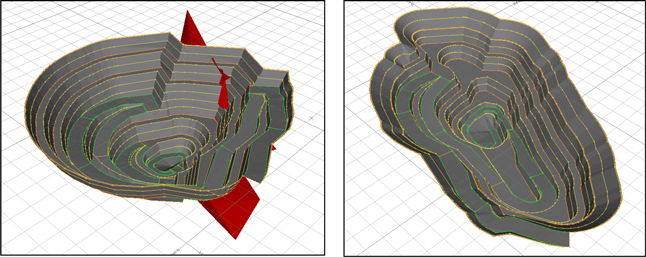
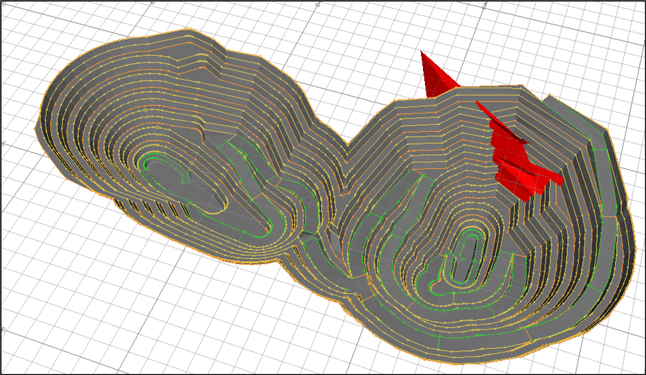
Figure 16-6 Norra Kärr – Pushbacks and Final Designs
Top Left – Pushback 1 (South Pit) and Fault zone, Top Right – Pushback 2 (North Pit) Bottom - Final pit limits and fault zone.
 |  |
| | Prefeasibility Study - NI 43-101 - Technical report for the Norra Kärr Rare
Earth Element Deposit - 0465-RPT-014 Rev 0 |
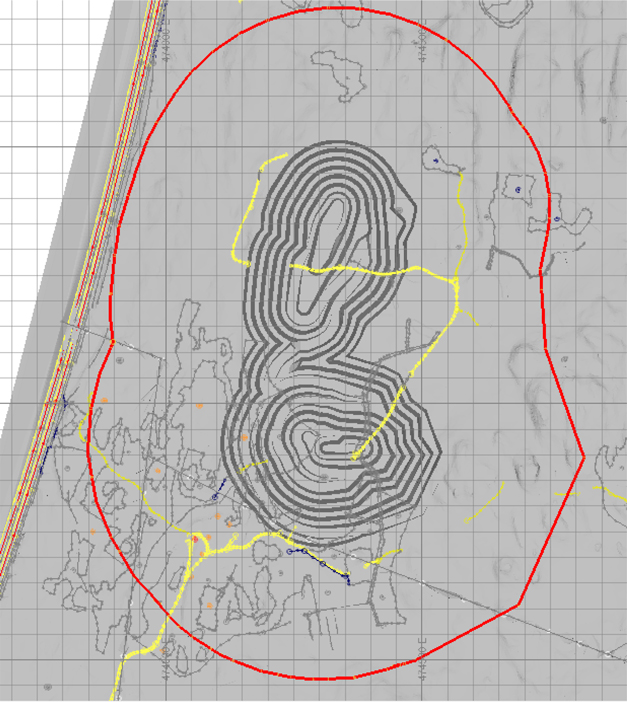
Figure 16-7 Norra Kärr – Final Design with Topography and E4 Highway
260m Blast Exclusion Zone shown around pit (Red), E4 Highway located to West of Pit.
 |  |
| | Prefeasibility Study - NI 43-101 - Technical report for the Norra Kärr Rare
Earth Element Deposit - 0465-RPT-014 Rev 0 |
| 16.6 | Geotechnical Parameters |
Key findings of the geotechnical assessment are summarised below. During operations, feedback from trial slopes, and routine monitoring and mapping should be incorporated into design reviews to assess whether the design matches predictions of geotechnical conditions on a bench or domain scale. Modifications of slope geometry modification, or the provision of additional support or drainage measures may be required to cater for the conditions encountered on site.
| 16.6.1 | Stereographic Analysis |
The program Dips (version 6.0) was used for the analysis (Rocscience Inc.), the data analysed for each design sector includes six orientated geotechnical holes completed in 2014, structural logging from exploration holes, and surface mapping undertaken during the site visit. The logging data was filtered for joints meeting a high level of confidence and open joints. The foliation has been noted as a preferred weakness orientation; however, owing to the high strength ground mass the structure is rarely open. All data was corrected using a Terzaghi weighting to account for the effects of drill hole and mapping orientation bias.
The stereographic analysis (Table 16-8) checked for the nature of joint sets by lithology and found that the structural discontinuities are persuasive through all units encountered, so will therefore be used for the assessment, joint sets can be summarised below:
| Joint Sets: | Set 1 – Steep North (67°/355°) |
Set 2 – Flat Set (08°/271°)
Set 3 – Shallow West (71°/282°)
Table 16-8: Sector Stereographic Analysis
| Slope Sector (Azimuth) | | Planar Failure | | Wedge Failure | | Toppling Failure |
| North (000°) | | None | | None | | Yes (Set 1) |
| North-East (045°) | | None | | None | | None |
| East (090°) | | Yes (Set 3) | | None | | Risk (Set 3) |
| South-East (135°) | | None | | Yes (Set 1 + 3) | | None |
| South (180°) | | Yes (Set 1) | | Risk (Set 1 + 3) | | None |
| South-West (225°) | | None | | None | | None |
| West (270°) | | None | | None | | Yes (Set 3) |
| North-West (315°) | | None | | None | | Yes (Intersection Set 1+3) |
 |  |
| | Prefeasibility Study - NI 43-101 - Technical report for the Norra Kärr Rare
Earth Element Deposit - 0465-RPT-014 Rev 0 |
| 16.6.2 | Slope Angle Configuration Summary |
Based on the kinematic analysis the configurations detailed in Table 16-9 are shown by pit sector and bench height, IRA assumes a resulting bench stack.
Table 16-9: Sector Slope Angles
| Slope Sector | | Bench Height (m) | | BFA (°) | | IRA (°) | | Bench Height
(m) | | BFA (°) | | IRA (°) | |
| North (000°) | | | | 67 | | | | | | 67 | | | |
| North-East(045°) | | | | *67 | | 50 | | | | *67 | | 53 | |
| East (090°) | | | | 71 | | 53 | | | | 71 | | 56 | |
| South-East (135°) | | 15 | | 65 | | 49 | | 20 | | 65 | | 51 | |
| South (180°) | | | | 67 | | | | | | 67 | | | |
| South-West(225°) | | | | *67 | | 50 | | | | *67 | | 53 | |
| West (270°) | | | | 67 | | | | | | 67 | | | |
| North-West(315°) | | | | 67 | | | | | | 67 | | | |
*Indicates no specific failure mechanism, therefore 67° has been used.
The kinematic analysis indicates that benches maybe influenced locally by planar, wedge, and toppling instability along open joint sets, the foliation set has not been included. The berm widths have been sized to accommodate localised failures on underlying benches. Large scale multiple bench instabilities are not indicated, however this has been drawn on limited exposures from site geotechnical mapping.
Bench configurations have been designed against mean dip and directions of joint sets, and have been designed so that potential planar slabs or wedges are not formed. This means that local variation to the dip of the structures must be followed with the bench face angle (BFA) to avoid undercutting or wedge formation.
Toppling failure is shown to be potentially difficult to manage; the risk of toppling cannot be alleviated by geometry alone, therefore careful management, good low damage blasting technique, scaling, and regular monitoring should be practiced in toppling risk areas.
| 16.6.3 | Finite Element Modelling of South East Fault Zone |
The South East Fault pit slopes are expected to undergo damage, the damage is limited to areas within the faulted area, interpreted to cause small localised failure of the immediate upper bench.
 |  |
| | Prefeasibility Study - NI 43-101 - Technical report for the Norra Kärr Rare
Earth Element Deposit - 0465-RPT-014 Rev 0 |
A total displacement model shows the Granniate suite and Granitoid as stable, but large displacements (250 mm) occurring within the faulted zone to a depth of 45 m. Owing to the unknown nature of the fault and influence of the faulted zone on the pit wall stability, two revised designs were considered. The design revisions consisted of de-coupling the slope by removing either one or two benches and subsequent faulted material, thus reducing the impact of the fault material on the overall slope.
Reviewing the results of the two designs, Design Two has increased SRF (FoS), minimal total displacement and minimal depth of yielding within the fault system, making it a safer design option. Figure 16-8 is a total displacement model of the two designs and Figure 16-9 models shear strain.
Critically, in Design Two total displacement and shear strain within the fault system is significantly reduced, indicating that the system is far less stressed. It is important to note that the rock properties are interpreted to be best estimates of the material rock mass properties and conclusions are drawn from those properties. In light of the design results, Design Two is favourable owing to the minimised stress that occurs around the fault zone and particularly around upper benches where the proximity to the fault is much closer.
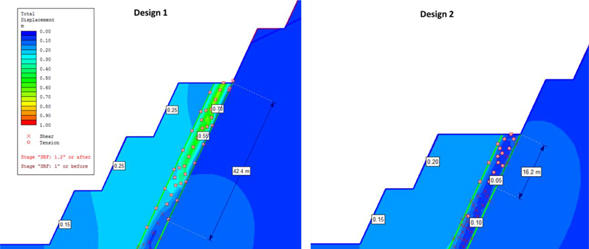
Figure 16-8: Phase2 Models of Total Displacement of South East Fault Design 1 and 2
Designs shown at SRF 1.4, Yielded Elements (Symbols) shown with fixed displacement contour legends. Total displacement highlighted at bench mid-heights and within the fault.
 |  |
| | Prefeasibility Study - NI 43-101 - Technical report for the Norra Kärr Rare
Earth Element Deposit - 0465-RPT-014 Rev 0 |
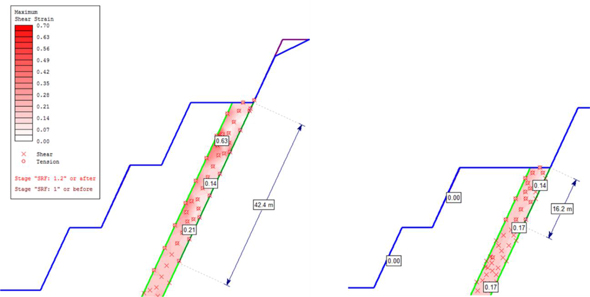
Figure 16-9: Phase2 Models of Maximum Shear Strain of SE Fault Design 1 and 2,
Designs shown at SRF 1.4, Yielded Elements (Symbols) shown with fixed displacement contour legends. Maximum Shear Strain highlighted within modelled fault
| 16.6.4 | Rock Quality Designation (RQD) Model of Optimised Design |
Using the results of the drilling programs, the optimised pit shell was coloured by RQD. The majority of the pit shows excellent to very good conditions, there are isolated areas to the south-east, (South East Fault) and west (Altered Zone) that reduce in rock quality from average to poor.
 |  |
| | Prefeasibility Study - NI 43-101 - Technical report for the Norra Kärr Rare
Earth Element Deposit - 0465-RPT-014 Rev 0 |
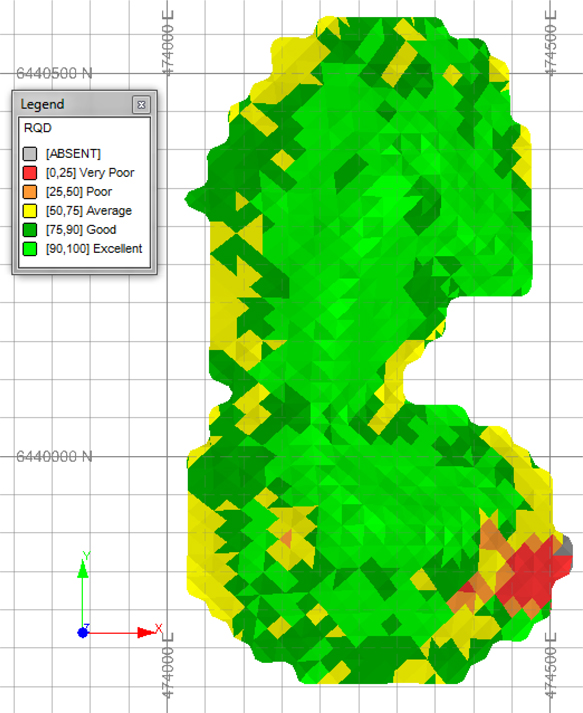
Figure 16-10: Optimised Pit Shell with Interpolated RQD on Shell Surface
| 16.6.5 | Surficial Geotechnics |
The investigations have concentrated on identifying the geotechnical properties of the solid strata. There are localised pond features on site and it is conceivable that deep deposits of saturated peat and organic soils are present within the pond footprint. Dewatering and excavation of these deposits
 |  |
| | Prefeasibility Study - NI 43-101 - Technical report for the Norra Kärr Rare
Earth Element Deposit - 0465-RPT-014 Rev 0 |
may require special measures for stability. Should such deposits extend across the pit slope, and be exposed in a bench face, additional permanent measures – such as buttressing and drainage - may be needed for stability during operation. Further investigations are needed to evaluate the implications on slope design of the superficial deposits.
| 16.7 | Open Pit Pumping Requirements |
A steady-state numerical groundwater model was constructed to estimate groundwater inflow to the proposed open pit using the optimised design shells. Inflows were estimate for each of the designed pushback years (10, 13, 15, 18, and 20), and for years 1, 5, and 8.
The model was constructed using data from Tasman, mine planning data from the WAI team, information from the PEA hydrogeological study (20), and findings from the recent hydrogeological investigation.
Inflows were predicted as detailed in Table 16-10.
Table 16-10: Predicted inflow rates
| Year | | Inflow (m3/day) | | | Inflow (L/s) | |
| 1 | | | 329.7 | | | | 3.8 | |
| 5 | | | 1 521.8 | | | | 17.6 | |
| 8 | | | 2 643.0 | | | | 30.6 | |
| 10 | | | 3 529.1 | | | | 40.8 | |
| 13 | | | 3 528.4 | | | | 40.8 | |
| 15 | | | 3 596.5 | | | | 41.6 | |
| 18 | | | 3 841.8 | | | | 44.5 | |
| 20 | | | 4 335.9 | | | | 50.2 | |
The water table will be intersected at approximately 200 m above ordnance datum. Inflows will be managed using a pair of pumps located in sumps. One sump will be constructed in each of the northern and southern pits.
The type of pump will be determined according to water management practices and sediment load. For the purposes of calculating CAPEX and OPEX, it is assumed that there will be one standby and one operational pump in each sump and that sediment loads are minimal. A total of four pumps will be required. The pump specification is shown in Table 16-11.
 |  |
| | Prefeasibility Study - NI 43-101 - Technical report for the Norra Kärr Rare
Earth Element Deposit - 0465-RPT-014 Rev 0 |
Table 16-11: Pump Specifications
| Pump | | Capacity | | Cost (USD) | | Power Requirement (kWh) | |
| Grundfos SP30 - 20 | | 25 L/s at 180 m head | | 7 840 | | | 18.5 | |
Water will be removed from two sumps, one in each of the pits, via a floating submersible pump connected to 200 mm heavy duty water hose. Hoses are anticipated to weigh approximately 30 kg/m and connect to permanent fixed surface pipe-work located within 250 m of the pit sump. The location of the sumps will change with time and the hose and pumps will have to be relocated using cranes. Water will be delivered to surface with a maximum flow velocity of 1 m/s.
The total mine waste produced during the life of mine is approximately 17.3 Mt. Assuming the material achieves a bulk density of 1.9 t/m3 when placed in the waste dump or when used for other engineering purposes, this tonnage equates to a volume of 9.1 Mm3. Mine waste will be used for construction of embankments at the tailings facility, ROM pad and haul roads around the mine site. A mine waste storage facility will be required to store the remainder of the materials. Currently the tailings embankment fill volume requirement for the life of mine is about 5.6 Mm3 additional to the initial quantities needed for start-up (to be supplied by excavation within the tailings footprint area). The volumetric storage requirement for the waste dump is therefore assumed to be in the region of 3 – 4 Mm3.
The selected location for mine waste storage is to the south-east of the orebody, as shown in Figure 16-11. The proposed layout adopts stand offs from the process plant site, main road, small stream route, and open pit shell, and makes best use of the area in-between to accommodate mine waste. The waste dump footprint does not overlap future potential extensions to the open pit shell.
The material generated during pre-stripping operations is likely to comprise a mixture of superficial materials and weathered rock. Suitable pre-strip materials will be used to form access roads, the ROM pad, and the initial waste dump toe berm and ditch and formation drains. Topsoil materials, including other organic soils such as peat that may be encountered, will be stockpiled for future restoration purposes.
 |  |
| | Prefeasibility Study - NI 43-101 - Technical report for the Norra Kärr Rare
Earth Element Deposit - 0465-RPT-014 Rev 0 |
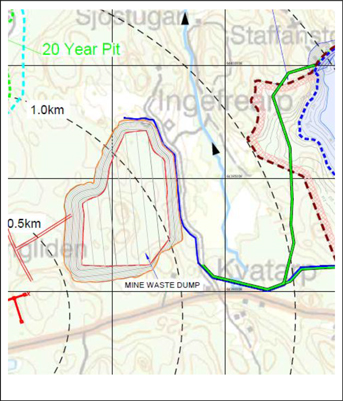
Figure 16-11: Proposed Mine Waste Dump Site
The layout attempts to minimise the number of properties affected by the facility and minimise the visual impact.
Following removal of vegetation and any deleterious materials, and the installation of formation drainage measures to cater for springs or drainage features, the waste dump will be filled from the base upwards by end tipping in lifts. It is envisaged that mine waste for embankment building at the tailings facility will be stockpiled on the waste dump, crushed and screened as required, and then selected material will be transported separately to the tailings facility. A haul road will be constructed between the mine waste dump and tailings storage area for this purpose. Surface run off from the waste dump will be collected in a ditch and directed alongside the haul road to the storm water collection pond. There will be a need for additional drainage measures during operation to manage run off, and only the ditch arrangement on the eastern side of the waste dump footprint is shown.
The capacity of the waste dump is approximately 4 Mm3. The maximum height of the waste dump is 27 m, and the surface footprint is about 29 ha. It is possible to raise the dump further to accommodate more material. Side slopes are shown at a gradient of 1(v) to 3(h), or equivalent to a nominal restoration slope, but closure details have not yet been determined. A benched profile or simple slope may be adopted at closure, with appropriate vegetation and drainage measures.
 |  |
| | Prefeasibility Study - NI 43-101 - Technical report for the Norra Kärr Rare
Earth Element Deposit - 0465-RPT-014 Rev 0 |
Section 17 Recovery Methods
The mineral processing and hydrometallurgical plant design was prepared based on the information generated by the testwork conducted by WAI, JKTech, Geological Survey of Finland, Dorfner ANZAPLAN and ANSTO Minerals as well as design experience provided by GBM. The process design is preliminary in nature and subject to change based on ongoing and future testwork programmes. The design philosophy for the process plant is a zero-liquid-discharge policy which ensures the risk to the environment by means of water contamination is mitigated.
The process design criteria in Table 17-1 and Table 17-2 formed the operational basis for the process flowsheet design.
Table 17-1 Process design criteria
| Description | | | Magnitude | | | Unit | |
| Process plant throughput - ore | | | 1 150 | | | kt/a | |
| ROM TREO equivalent grade | | | 0.6 | | | % | |
| Contained TREO | | | 6 910 | | | t/a | |
| Recovered TREO | | | 5 280 | | | t/a | |
| Process plant operation | | | 24/7/365 | | | - | |
| Crushing mechanical availability | | | 75 | | | % | |
| Grinding and beneficiation availability | | | 91 | | | % | |
| Hydrometallurgy plant availability | | | 91 | | | % | |
 |  |
| | Prefeasibility Study - NI 43-101 - Technical report for the Norra Kärr Rare
Earth Element Deposit - 0465-RPT-014 Rev 0 |
Table 17-2 REE Overall Recovery
| Element | | | Magnitude | | | | Unit | |
| Y | | | 72.92 | | | | % | |
| La | | | 77.84 | | | | % | |
| Ce | | | 78.02 | | | | % | |
| Pr | | | 78.82 | | | | % | |
| Nd | | | 79.01 | | | | % | |
| Sm | | | 79.42 | | | | % | |
| Eu | | | 79.44 | | | | % | |
| Gd | | | 79.32 | | | | % | |
| Tb | | | 79.13 | | | | % | |
| Dy | | | 78.78 | | | | % | |
| Ho | | | 78.00 | | | | % | |
| Er | | | 77.40 | | | | % | |
| Tm | | | 76.89 | | | | % | |
| Yb | | | 76.10 | | | | % | |
| Lu | | | 75.48 | | | | % | |
| 17.1.1 | Comminution and mineral beneficiation |
The beneficiation process is shown schematically in Figure 17-1. An apron feeder will reclaim Run of Mine (ROM) material from the ROM bin onto a vibrating grizzly screen. Oversize material reports to a jaw crusher where the material is comminuted before recombining with the grizzly screen undersize and fed to the secondary crushing screen. Similarly, oversize from the secondary crushing screen will report to the secondary cone crusher where the material will be comminuted before reporting to the tertiary crushing screen. Screen undersize from the secondary and tertiary screens will then be transferred to the fine ore bin. Oversize material from the tertiary crushing screen will report to a tertiary crusher where it will be comminuted before being recycled to the tertiary crushing screen for classification. All material transfers between process units will be by conveyors.
Discharge from the fine ore bin will be delivered for primary grinding, via a conveyor, to an open circuit rod mill. Rod mill discharge will be screened with the oversize reporting to a tower mill for secondary grinding. Tower mill discharge is combined with rod mill discharge and classified over the same screen in a closed circuit.
Undersize from the mill screen will be fed to a low intensity magnetic separator to remove any residual grinding media, before reporting to a wet high gradient magnetic separator. The magnetic separator will produce two product streams:
 |  |
| | Prefeasibility Study - NI 43-101 - Technical report for the Norra Kärr Rare
Earth Element Deposit - 0465-RPT-014 Rev 0 |
| · | the magnetic concentrate enriched in aegirine and eudialyte; and |
| · | the non-magnetic concentrate depleted of iron bearing minerals. |
Each concentrate will report to their respective thickeners to recover water. Thickener underflow from the non-magnetic thickener reports to the tailings discharge tank for disposal and thickener overflow returns to the process water tank. Thickener underflow from the magnetic concentrate reports to the leach conditioning tank and the thickener overflow is returned to the magnetic separator.
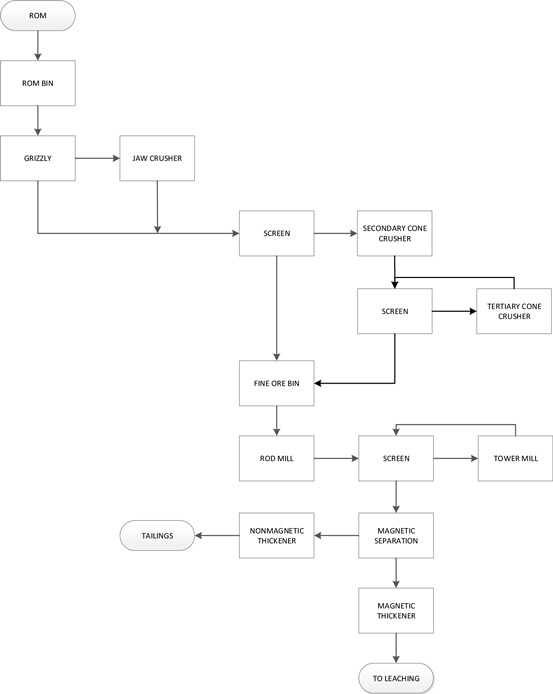
Figure 17-1 Comminution and Beneficiation Block Flow Diagram
 |  |
| | Prefeasibility Study - NI 43-101 - Technical report for the Norra Kärr Rare
Earth Element Deposit - 0465-RPT-014 Rev 0 |
| 17.1.2 | Hydrometallurgical extraction and recovery |
The leaching process is shown schematically in Figure 17-2. Fresh sulfuric acid will be added to the slurry in the leach conditioning tank. Additional sulfuric acid will be recycled from the solvent extraction plant. In order to maintain the pH set-point sulfuric acid will be added in each of the leach tanks.
After leaching, the pH of the solution will be raised through the addition of magnesium oxide. A pH value is established in order to reject various impurities, which will be precipitated, allowing their removal from the solution via thickening and filtration (filter cake reports to tailings tank). Following impurity removal the temperature of the pregnant leach solution (PLS) is raised and the pH reduced, using sulfuric acid, to enhance solvent extraction characteristics.
PLS will report to solvent extraction to recover the REE. Solution will be contacted with a suitable solvent, into which the rare earths will preferentially exchange. The loaded organic solvent will then be scrubbed with dilute sulfuric acid to remove most of the loaded impurities. The REE will be stripped from the pregnant solvent using oxalic acid. The precipitate will then be removed by a combination of centrifugation and filtration of the insoluble rare earth oxalates.
The REE oxalate filtercake is then dried and calcined in a calciner to produce a REE rich mixed oxide. The oxide will then be cooled and packed in preparation for dispatch to a refinery for metals separation.
Raffinate from solvent extraction will contain various dissolved metals, the concentration of which will build up in the system when recycled. Ultimately, these dissolved species will interfere with the recovery of rare earths if their concentration gets too high. As such, a portion of the waste water will be sent for treatment, involving the addition of lime, nanofiltration, reverse osmosis (RO) and brine evaporation. The gypsum sludge resulting from the addition of lime reports to the tailings discharge tank for disposal. The neutralised effluent will then undergo a series of nanofiltration and reverse osmosis stages producing a permeate (water) and a brine. The RO water reports back to the raw water tank and the brine will then be further subjected to thermal evaporation to remove the contained water to produce a solid salt residue (predominately magnesium and sodium sulfates) and a water vapour condensate. The condensate reports back to the raw water tank and the salt is transported to a licenced storage facility for long term management.
 |  |
| | Prefeasibility Study - NI 43-101 - Technical report for the Norra Kärr Rare
Earth Element Deposit - 0465-RPT-014 Rev 0 |
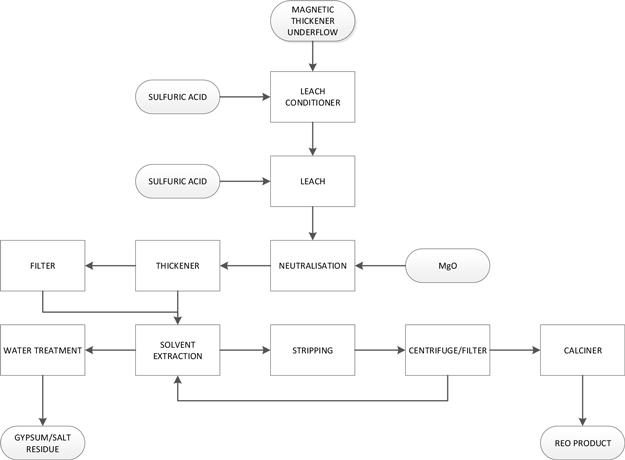
Figure 17-2: Hydrometallurgical Extraction and Recovery Block Flow Diagram
| 17.2 | Process Plant Infrastructure and Reagents |
The principal reagents required in the process are sulfuric acid, magnesium oxide, lime, oxalic acid, flocculant, primary amine solvent, iso-decanol (diluent) and Shellsol 2046.
Delivery of reagents will be every month for solids and every week for liquids. Sulfuric acid will be received twice a week. With varying ore body characteristics, the reagent consumption may change through the life of mine.
The three largest volumes of reagents consumed at the plant are sulfuric acid, magnesium oxide and lime. The sulfuric acid will be supplied domestically by rail to the Tranäs unloading facility at which point it will be transferred to trucks and driven approximately 30 km to the project site. The magnesium oxide will be supplied internationally from China and shipped to the Netherlands. From
 |  |
| | Prefeasibility Study - NI 43-101 - Technical report for the Norra Kärr Rare
Earth Element Deposit - 0465-RPT-014 Rev 0 |
the port the product will be transferred to rail and transported to the Tranäs unloading facility. Lime will be supplied domestically and trucked to the plant.
All reagents will be made-up with raw water when and where required.
| 17.2.2 | Services and Utilities |
Raw water will be sourced from nearby Lake Vättern. The raw water will provide make up water into the process; gland seal water, reagent make-up and potable water requirements.
Diesel fuel oil is to be stored on site in two separate facilities, one mine infrastructure facility which will service the mining fleet and mobile equipment, and one process plant facility which will service the boiler.
The site boiler plant will produce 10 bar steam and distribute at 2 bar for use in the process (solvent extraction) and brine evaporation. The steam boiler plant will be fired via the combustion of diesel fuel oil and the resulting condensate will returned to the boiler in a closed circuit.
 |  |
| | Prefeasibility Study - NI 43-101 - Technical report for the Norra Kärr Rare
Earth Element Deposit - 0465-RPT-014 Rev 0 |
Section 18 Project Infrastructure
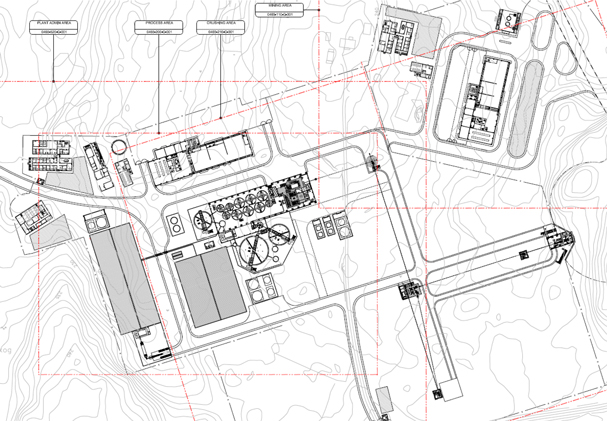
Figure 18-1 Plant and Infrastructure layout
The beneficiation and hydrometallurgy process site will be accessible from both the E4 and the Tranäs to Gränna road. Access to the site is by a bitumen road for some 3 km and 1 km respectively. Roads that are local to the site and link key operating facilities shall be gravel roads.
| 18.3 | Buildings and Structure |
The buildings and infrastructure of the Nora Kärr site are summarised in Table 18-1 and depicted in Figure 18-1.
 |  |
| | Prefeasibility Study - NI 43-101 - Technical report for the Norra Kärr Rare
Earth Element Deposit - 0465-RPT-014 Rev 0 |
Table 18-1 Building and Structure Details of Nora Kärr process plant
| PLANT INFRASTRUCTURE – BUILDINGS |
| Building | Footprint (m²) | Description |
| | | |
| Admin Building | 1 075.64 | Single storey, load bearing wall buildings with steel insulated sandwiched panel roofs and suspended ceiling, all necessary electrical, water supply sanitation facilities to suit for the purpose of the building, decorated with plaster and paints, ready to move. - H shaped, approximately 43.3 m x 12.7 m block connected with corridor to a next 13.7 m x 36.7 m block, 2.4 m minimum floor to ceiling height. |
| | | |
| Plant Mess Hall | 336.70 | Single storey, load bearing wall buildings with steel insulated sandwiched panel roofs and suspended ceiling, all necessary electrical, water supply sanitation facilities to suit for the purpose of the building, decorated with plaster and paints, ready to move. - Single L type building with maximum dimension 13 m x 25.9 m, 2.4 m minimum floor to ceiling height. |
| | | |
| Ablution Building | 55.46 | Single storey, load bearing wall buildings with steel insulated sandwiched panel roofs and suspended ceiling, all necessary electrical, water supply sanitation facilities to suit for the purpose of the building, all fixtures fixed, decorated with plaster and paints, ready to move. - Single block building with dimension 9.4 m x 5.9 m. |
| | | |
| Plant Workshop & Warehouse | 2 595.60 | Single storey, portal framed or beam - column - Truss structured buildings with steel insulated sandwiched panel roofs, all necessary electrical, water supply sanitation facilities to suit for the purpose of the building, all fixtures fixed, decorated with plaster and paints, ready to move. - Main block building with dimension 25.2 m x 103 m, 10 MT overhead crane arrangement throughout (excluding crane but including crane girders) at 10 m level, approximately 12 m truss height, at least 12 roller shutter doors, with additional personnel doors etc. all complete plus an additional lean to annex attached (9 m x 45.5 m, 6 m truss height, with at least 3 roller shutters) |
| | | |
| Security Office | 32.50 | Single storey, load bearing wall buildings with steel insulated sandwiched panel roofs and suspended ceiling, all necessary electrical, water supply sanitation facilities to suit for the purpose of the building, all fixtures fixed, decorated with plaster and paints, ready to move. - Single block building with dimension 5 m x 6.5 m. |
| | | |
| Emergency services | 656.19 | Single storey, load bearing wall buildings with steel insulated sandwiched panel roofs and suspended ceiling, all necessary electrical, water supply sanitation facilities to suit for the purpose of the building, all fixtures fixed, decorated with plaster and paints, ready to move. - Single block building with dimension 20.7 m x 31.2 m. |
| | | |
| Laboratory | 656.88 | Single storey, load bearing wall buildings with steel insulated sandwiched panel roofs and suspended ceiling, all necessary electrical, water supply sanitation facilities to suit for the purpose of the building, all fixtures fixed, decorated with plaster and paints, ready to move. - Single block building with dimension 13.6 m x 48.3 m. |
| | | |
| Solvent Extraction Plant Building | 4 410.00 | Single storey, portal framed or beam - column - Truss structured buildings with steel insulated sandwiched panel roofs, all necessary electrical, water supply sanitation facilities to suit for the purpose of the building, all fixtures fixed, decorated with plaster and paints, ready to move. - Building with dimension 42 m x 105 m (with central posts for crane and roof support), 10 MT overhead crane arrangement throughout (excluding crane but including crane girders) at 8 m level, approximately 10 m truss height, at least 10 roller shutter doors, with additional personnel doors etc. all complete. |
 |  |
| | Prefeasibility Study - NI 43-101 - Technical report for the Norra Kärr Rare
Earth Element Deposit - 0465-RPT-014 Rev 0 |
| PLANT INFRASTRUCTURE – BUILDINGS |
| Product Handling Building | 1 115.68 | Single storey, portal framed or beam - column - Truss structured buildings with single skin steel panel roofs, all necessary electrical, water supply sanitation facilities to suit for the purpose of the building, all fixtures fixed, decorated with plaster and paints, ready to move. - Building with dimension 30.4 m x 36.7 m, 5 MT overhead crane arrangement throughout (excluding crane but including crane girders) at 8 m level, approximately 10 m truss height, at least 2 roller shutter doors, with additional personnel doors etc. all complete. |
| | | |
| Oxalic Acid Building | 404.43 | Single storey, portal framed or beam - column - Truss structured buildings with single skin steel panel roofs, all necessary electrical, water supply sanitation facilities to suit for the purpose of the building, all fixtures fixed, decorated with plaster and paints, ready to move. - Building with dimension 22.1 m x 18.3 m, 5 MT overhead crane arrangement throughout (excluding crane but including crane girders) at 8 m level, approximately 10 m truss height, at least 2 roller shutter doors, with additional personnel doors etc. all complete. |
| | | |
| Boiler Building | 60.00 | Single storey, portal framed or beam - column - Truss structured buildings with steel insulated sandwiched panel roofs, all necessary electrical, water supply sanitation facilities to suit for the purpose of the building, all fixtures fixed, decorated with plaster and paints, ready to move. - Building with dimension 6 m x 10 m approximately 10 m truss height, at least 2 roller shutter doors, with additional personnel doors etc. all complete |
| | | |
| Sulphuric Acid Building | 145.92 | Single storey, portal framed or beam - column - Truss structured buildings with steel insulated sandwiched panel roofs, all necessary electrical, water supply sanitation facilities to suit for the purpose of the building, all fixtures fixed, decorated with plaster and paints, ready to move. - Building with dimension 7.6 m x 19.2 m approximately 10 m truss height, at least 2 roller shutter doors, with additional personnel doors etc. all complete. |
| | | |
| Magnesium Oxide Building | 348.46 | Single storey, portal framed or beam - column - Truss structured buildings with steel insulated sandwiched panel roofs, all necessary electrical, water supply sanitation facilities to suit for the purpose of the building, all fixtures fixed, decorated with plaster and paints, ready to move. - Building with dimension 13.1 m x 26.6 m approximately 10 m truss height, at least 2 roller shutter doors, with additional personnel doors etc. all complete. |
| | | |
| Milling & Process Building | 3 104.00 | Single storey, portal framed or beam - column - Truss structured buildings with steel insulated sandwiched panel roofs, all necessary electrical, water supply sanitation facilities to suit for the purpose of the building, all fixtures fixed, decorated with plaster and paints, ready to move. - Main block building with dimension 32 m x 97 m, 25 MT overhead crane arrangement throughout (excluding crane but including crane girders) at 24.5 m level, approximately 27.1 m truss height, at least 5 roller shutter doors, with additional personnel doors etc. all complete. |
| | | |
| Annex to Process Building | 490.00 | Single storey, portal framed or beam - column - Truss structured buildings with steel insulated sandwiched panel roofs, all necessary electrical, water supply sanitation facilities to suit for the purpose of the building, all fixtures fixed, decorated with plaster and paints, ready to move. - Annexed lean-to to Main Milling and Process building, with dimension 10 m x 49 m, approximately 13.1 m truss height, at least 2 roller shutter doors, with additional personnel doors etc. all complete. |
 |  |
| | Prefeasibility Study - NI 43-101 - Technical report for the Norra Kärr Rare
Earth Element Deposit - 0465-RPT-014 Rev 0 |
| PLANT INFRASTRUCTURE – BUILDINGS |
| Primary Crusher Building | 308.73 | Single storey, portal framed or beam - column - Truss structured buildings with steel insulated sandwiched panel roofs, all necessary electrical, water supply sanitation facilities to suit for the purpose of the building, all fixtures fixed, decorated with plaster and paints, ready to move. - Main Crusher building with dimension 12.3 m x 25.1 m, 15 MT overhead crane arrangement throughout (excluding crane but including crane girders) at 12 m level, approximately 14.5 m truss height, at least 2 roller shutter doors, with additional personnel doors etc. all complete |
| | | |
| Secondary Crusher Building | 250.04 | Single storey, portal framed or beam - column - Truss structured buildings with steel insulated sandwiched panel roofs, all necessary electrical, water supply sanitation facilities to suit for the purpose of the building, all fixtures fixed, decorated with plaster and paints, ready to move. - Secondary building with dimension 13.3 m x 18.8 m, approximately 19.5 m truss height, at least 2 roller shutter doors, with additional personnel doors etc. all complete. |
| | | |
| Transfer Tower 1 Building | 54.02 | Single storey, portal framed or beam - column - Truss structured buildings with steel insulated sandwiched panel roofs, all necessary electrical, water supply sanitation facilities to suit for the purpose of the building, all fixtures fixed, decorated with plaster and paints, ready to move. - Transfer Tower with dimension 7.4 m x 7.3 m, approximately 8.15 m truss height, at least 1 roller shutter door, with additional personnel doors etc. all complete. |
| | | |
| Transfer Tower 2 Building | 62.16 | Single storey, portal framed or beam - column - Truss structured buildings with steel insulated sandwiched panel roofs, all necessary electrical, water supply sanitation facilities to suit for the purpose of the building, all fixtures fixed, decorated with plaster and paints, ready to move. - Transfer Tower with dimension 7.4 m x 8.4 m, approximately 8.15 m truss height, at least 1 roller shutter door, with additional personnel doors etc. all complete. |
| | | |
| Silo Storage Building | 29.28 | Single storey, portal framed or beam - column - Truss structured buildings with steel insulated sandwiched panel roofs, all necessary electrical, water supply sanitation facilities to suit for the purpose of the building, all fixtures fixed, decorated with plaster and paints, ready to move. - Building sitting at the top of the Bin steelwork, with dimension 4.8 m x 6.1 m, approximately 4.6 m truss height, with personnel doors etc. all complete. |
| | | |
| Flocculant Building | 145.92 | Single storey, portal framed or beam - column - Truss structured buildings with steel insulated sandwiched panel roofs, all necessary electrical, water supply sanitation facilities to suit for the purpose of the building, all fixtures fixed, decorated with plaster and paints, ready to move. - Building with dimension 7.6 m x 19.2 m approximately 10 m truss height, at least 2 roller shutter doors, with additional personnel doors etc. all complete. |
| | | |
| Sewerage System & Treatment Plant - Plant Site | | A pre manufactured sewer treatment plant suitable for 150 people in an office environment fully fitted in an underground concrete basement (constructed separately), sewer being collected by sewer lines as described above, and with all necessary accessories required for the purpose, all complete. |
| | | |
| MINE INFRASTRUCTURE - BUILDINGS |
 |  |
| | Prefeasibility Study - NI 43-101 - Technical report for the Norra Kärr Rare
Earth Element Deposit - 0465-RPT-014 Rev 0 |
| PLANT INFRASTRUCTURE – BUILDINGS |
| Mine Workshop | 2 139.48 | Single storey, portal framed or beam - column - Truss structured buildings with steel insulated sandwiched panel roofs, all necessary electrical, water supply sanitation facilities to suit for the purpose of the building, all fixtures fixed, decorated with plaster and paints, ready to move. - Main block building with dimension 25.2 m x 84.9 m, 10 MT overhead crane arrangement throughout (excluding crane but including crane girders) at 10 m level, approximately 12 m truss height, at least 12 roller shutter doors, with additional personnel doors etc. all complete plus an additional lean to annex attached (9 m x 55.5 m, 6 m truss height, with at least 3 roller shutters). |
| | | |
| Fuel Farm | | Single storey, portal framed or beam - column - Truss structured buildings with steel single skin roof, typical for petrol pumps, all necessary electrical, water supply sanitation facilities to suit for the purpose of the building, all fixtures fixed, ready to use. |
| | | |
| Mine Office | 871.05 | Single storey, load bearing wall buildings with steel insulated sandwiched panel roofs and suspended ceiling, all necessary electrical, water supply sanitation facilities to suit for the purpose of the building, decorated with plaster and paints, ready to move. - H shaped, approximately 32.8 m x 12.7 m block connected with corridor to a next 13.7 m x 31.5 m block, 2.4 m minimum floor to ceiling height. |
| | | |
| Mine Mess Hall | 284.70 | Single storey, load bearing wall buildings with steel insulated sandwiched panel roofs and suspended ceiling, all necessary electrical, water supply sanitation facilities to suit for the purpose of the building, decorated with plaster and paints, ready to move. - Single L type building with maximum dimension 13 m x 21.9 m, 2.4 m minimum floor to ceiling height. |
| | | |
| Sewerage System & Treatment Plant - Mine Site | | A pre manufactured sewer treatment plant suitable for 250 people in an office environment fully fitted in an underground concrete basement (constructed separately), sewer being collected by sewer lines as described above, and with all necessary accessories required for the purpose, all complete. |
| 18.4 | Transportation of Goods and Services |
The Nora Kärr processing plant will consume a significant volume of reagents, and all will arrive by truck. It was established that approximately 202 000 tonnes per annum of combined reagents will be consumed, two thirds of which will arrive in the local area by rail. The unloading facility and rail modifications have been designed and estimated by in-country consultants.
The labour force for the process and mine operations will not require housing on-site, due to the close proximity of the local towns of Gränna, Tranäs and Ödeshög.
The total Nora Kärr facilities will require three connections into the existing power network. The three identifiable areas are:
| · | Raw water pump station located at the bank of Lake Vättern; |
 |  |
| | Prefeasibility Study - NI 43-101 - Technical report for the Norra Kärr Rare
Earth Element Deposit - 0465-RPT-014 Rev 0 |
| · | Rail unloading station located at the Tranäs industrial estate; and |
| · | Process plant and mining related infrastructure. |
The process plant and mining related infrastructure require approximately 10 MW, this could be sourced from the local wind farm, however due to peak load requirements during start-up this supply is not suitable nor reliable. Electricity is to be supplied from east of the plant from the regional 40 kV line that runs from north to south. The battery limit for the supply is at the transformer local to the process site. The capital costs for extension of overhead lines are built into the tariff costs per supply.
The power required at both the unloading facility and raw water pump station is minimal and limited power lines will be required.
Approximately 100 m³/h of raw water is required at the process plant to account for losses of moisture to product concentrate and tailings. The additional water will be sourced from Lake Vättern via a pumping station at the lake edge. The pumping station is 3.8 km directly west of the process plant and will operate continuously. The pipeline from the pumping station to the water storage tank at site is to be installed below ground level.
The location of the project 2 Km east of Lake Vättern in a moderately populated region makes tailings management an important and sensitive issue. In this area environmental and social considerations have a strong influence on the choice of technical solution for the disposal and storage of tailings generated by the project.
Initially for the PFS, fourteen potential sites for locating a tailings storage facility (TSF) were reviewed in a Localisation Study (14) undertaken by Golder. The suitability of the candidate sites was assessed utilising a series of evaluation criteria. Different sites within 10 km of the orebody were compared by this means and ranked in terms of suitability based on environmental, technical and cost considerations. Figure 18-2 shows the locations of the potential sites.
 |  |
| | Prefeasibility Study - NI 43-101 - Technical report for the Norra Kärr Rare
Earth Element Deposit - 0465-RPT-014 Rev 0 |
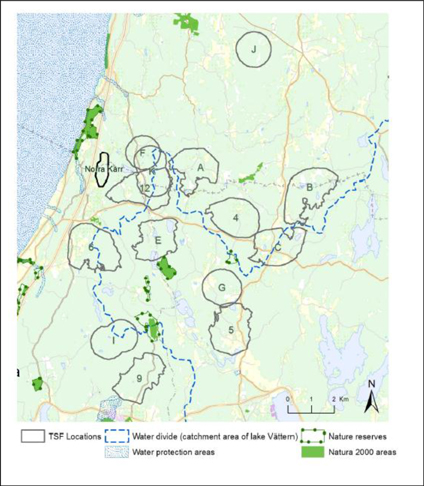
Figure 18-2:Localisation Study TSF option sites
There is no single TSF site that stands out as being the best from all viewpoints. All the sites assessed by the study are generally suitable, but the recommended sites that had the least number of unsuitable scores (based on environmental, technical and cost factors) are located close to the orebody. The siting study also considered three typical disposal methodologies, comprising slurry disposal, paste or thickened tailings and dry stack disposal of a filter cake, as part of the evaluation process. Of the recommended sites for slurry disposal, one incorporated a partial water cover and slurry disposal methods (Site 12), and two were sites suitable for paste or thickened tailings disposal in the form of sub-aerial deposition from a central location within the storage cell (Sites F and K).
The Localisation Study also contained the results of preliminary storage modelling (undertaken by Tailings Consultants Scandinavia AB TCS) of the TSF sites. TCS also summarised the current best practice for tailings disposal in Sweden.
Site selection is a fundamental starting point for the design of the TSF. The factors controlling the selection of the optimum scheme for tailings storage are complex, and not all information is available at this early stage in the project for informed judgement. The likely nature of the waste streams and
 |  |
| | Prefeasibility Study - NI 43-101 - Technical report for the Norra Kärr Rare
Earth Element Deposit - 0465-RPT-014 Rev 0 |
the waste handling and transport options were assessed in a preliminary design study by WAI (15), using the results and recommendations of the Localisation Study and information contained in the PEA report (16). Concept designs, based on available process design criteria and assuming a 20 year mine life, were prepared for slurry or paste or thickened tailings options.
The recommended approach to tailings disposal is to combine the solid waste streams generated at the process plant (beneficiation tailings, leach residue and gypsum sludge) into one tailings stream and dispose of the material using sub-aerial methods into a single storage cell, which corresponds in land take terms to part of Sites F and K identified by the Localisation Study.
The brine solution waste from reverse osmosis water treatment contained elevated sulfur, sulfate and aluminium (17), which should not be discharged into water courses (18). The brine will not be incorporated within the tailings stream because of the potential to cause environmental harm, and will be further treated to form a solid waste and then disposed of offsite to landfill.
This thickened (segregating or non-segregating) approach, following a sub-aerial deposition method, has the benefit of reducing the land take and minimising the risk of seepage. The construction costs are likely to be less than with slurry disposal behind water storage dams. Other options are however, still feasible and can be reviewed at a later stage with the benefit of further information, if necessary.
Risks associated with water management are considered to be most significant and the main aim of the design approach is to provide a stable containment structure with minimal impacts on the surrounding area.
The storage strategy is simple and aims to store supernatant water largely separately to tailings solids, to dispose of excess water to the environment, to minimise seepage, and to maximise the strength and density of the stored tailings solids for stability. The TSF comprises a single cell for the storage of tailings solids, and downstream ponds for water clarification and handling of flood waters
Figure 18-3 shows the general layout of the tailings storage area and the reservoirs for handling and storing excess water, which makes best use of the existing topography to minimise earthworks and construction activities, and to direct all decant water away from Lake Vättern.
 |  |
| | Prefeasibility Study - NI 43-101 - Technical report for the Norra Kärr Rare
Earth Element Deposit - 0465-RPT-014 Rev 0 |

Figure 18-3: Proposed Layout of TSF
Although the location selected for tailings storage will impact on existing properties the layout has been designed to minimise that impact and help manage risks such as dust blow. The facility has been designed to accommodate extreme meteorological events by designing for the probable maximum flood, which minimises the risks associated with overtopping.
The design of the storage facility and associated water dams utilises mine waste where possible as construction material. This approach not only minimises the size of waste dumps and the associated environmental and health and safety risks, but also is a sustainable approach that maximises recycling of waste for beneficial purposes and reduces the demand for local materials – with consequently reduced risks associated with importing materials to site.
Land in the vicinity of the orebody is used for forestry and hunting. The topography of the general area selected for tailings storage is undulating, and is dissected by small streams leading to small lakes. The area contains extensive tracts of forested land. Surface levels rise to about 225 m AMSL along a series of north-north-west trending ridges, falling to around 195 m AMSL in the intervening valley areas. The catchment boundary between Lake Vättern and the Baltic drainage courses lies across the area selected for tailings storage.
 |  |
| | Prefeasibility Study - NI 43-101 - Technical report for the Norra Kärr Rare
Earth Element Deposit - 0465-RPT-014 Rev 0 |
It was not possible to undertake site investigations at the TSF site for the PFS due to land ownership and access permission constraints. Information on the geology and ground conditions is inferred from published information and a site walk over visit in June 2014 (19).
The geology comprises mixed outcrops of granite or boulder fields, and glacial till and glaciofluvial deposits. There are localised peat deposits in the low lying areas, see Figure 18-4.
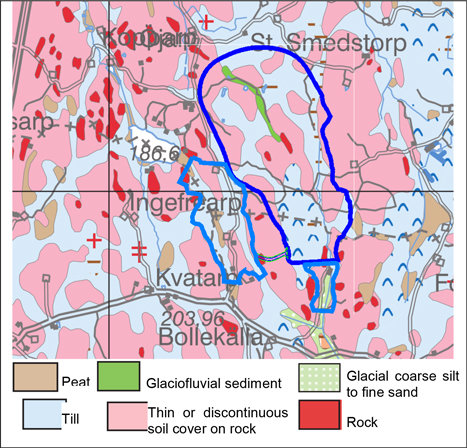
Figure 18-4:Geology of TSF site
The storage area contains outcrops of granite, or areas where granite lies close to surface beneath superficial deposits, including extensive boulder fields. The solid granite strata appear to be relatively fresh and unjointed at outcrop.
The glacial till is exposed in small excavations in this area, where it appears to comprise a silty or sandy material (with numerous large boulders). There is a localised linear glaciofluvial deposit in the northern part of the TSF, which is presumed to be an esker. Local exposures of laminated gravelly sand were visible at the location of this feature.
There are major north-north-west trending drainage features at the TSF site, which could represent zones of faulting or broken ground.
 |  |
| | Prefeasibility Study - NI 43-101 - Technical report for the Norra Kärr Rare
Earth Element Deposit - 0465-RPT-014 Rev 0 |
The project site is located on an old and stable region of the earth’s crust, and is a low seismicity area. Seismic activity in Sweden is not evenly distributed, and the south-east part of the country near the project site is relatively inactive. According to published seismic hazard maps, the site lies in an area where the Peak Ground Acceleration with a 10 % probability of exceedance in 50 years lies between 0.2 and 0.4 m/s2.
Climatic factors affecting the design of the TSF have been collated into a separate report (20). The TSF is located near the head of the local catchments, where flows into the storage area and associated pond areas are at a minimum.
| 18.7.4 | Tailings Properties |
The approach to tailings disposal is to combine the solid waste streams generated at the process plant (beneficiation tailings, leach residue and gypsum sludge) into one tailings stream and dispose of the material using sub-aerial methods into a single storage cell. It is considered, based on available information, that the geochemistry of the combined waste stream would not present an environmental hazard, although further testwork is needed to confirm this assumption and to identify the geochemical and geotechnical characteristics of the combined waste stream.
A small sample of beneficiation tailings was available for testing, but no samples of leach residue or gypsum sludge were available. It was decided to undertake limited geotechnical testwork on the sample of beneficiation tailings to add to the bank of knowledge. The geotechnical testing comprised the determination of specific gravity, plasticity, particle size distribution, and undertaking oedometer consolidation testing and multistage undrained triaxial testing with pore water pressure measurements.
The beneficiation tailings comprise the greatest proportion of the tailings waste stream. The effect of including leach residue and gypsum sludge materials on the geotechnical properties of the waste stream are speculative, but could result in an increase in the fines content, with consequential implications for consolidation, permeability and pore pressure response of the combined material under loading, in comparison to the test results.
The results of the geotechnical testing on the beneficiation tailings are summarised below, and compared with the results of metallurgical testwork on similar samples.
The specific gravity was determined following procedures set out in BS1377: Part 2: 1990 (21) and recorded a value of 2.02. However, previous metallurgical testing estimated a value of 2.56 for the beneficiation tailings. There is no obvious explanation for the difference in test results. The value proposed for the combined tailings waste stream is 2.65 (21), which has been adopted for the tailings design work.
The particle size distribution was determined and recorded a significantly coarser material than determined by previous metallurgical testing. There is no obvious explanation for the difference in
 |  |
| | Prefeasibility Study - NI 43-101 - Technical report for the Norra Kärr Rare
Earth Element Deposit - 0465-RPT-014 Rev 0 |
test results. The metallurgical testing results have been adopted for design; using the metallurgical test results the tailings would classify as a uniformly graded medium – coarse silt-size material (P80 is 60 micron, and P10 is 10 micron), rather than a gap graded sandy silt with a P80 of about 150 micron, and P10 of 3.5 micron. It is conceivable that the P10 size may be lower for the combined waste materials due to the gypsum precipitate.
The beneficiation tailings material is non plastic. This is considered unlikely to change for the combined waste stream.
Consolidation and undrained triaxial tests were undertaken on the beneficiation tailing sample at an initial voids ratio of about unity, and the results were interpreted using a specific gravity (SG) of 2.65. Testing identified that:
| · | the final dry density recorded by consolidation testing is 1.36 Mg/m3, which is assumed to be representative of the combined waste stream; |
| · | the permeability of the material (as determined from the consolidation test results) is low at 10-10 to 10-11 m/s – however, these values are inconsistent with the likely permeability estimated using Hazen’s rule and the particle size distribution, from which a permeability value of 10-7 m/s would be inferred; |
| · | the coefficient of volume compressibility is between 0.06 and 0.21 m2/MN under the anticipated loadings, which again is considered representative for the combined waste stream; and |
| · | effective stress parameters of c’ = 9 kPa and phi’ = 39oapply to the drained condition, which may be high for the combined waste stream when gypsum is introduced to the waste stream. |
Although the Tasman test results have been adopted for design purposes, the uncertainties regarding specific gravity have been catered for by including a contingency storage allowance, and the uncertainties in particle size distribution by adopting more conservative overall beach angles than initially envisaged for storage analysis.
The design parameters are based on the current mass and liquid balance and assume:
| · | production of a combined tailings solids throughput of 155 tph, or say 1.24 Mtpa at 7 972 h (annual operating hours); |
| · | tailings solids content of about 63 %; |
| o | tailings dry density = 1.36 t/m3 (weight of solids / total weight); and |
| · | 24.8 Mt = 18.0 Mm3 of tailings storage requirement. |
The waste stream parameters are summarised in Table 18-2.
 |  |
| | Prefeasibility Study - NI 43-101 - Technical report for the Norra Kärr Rare
Earth Element Deposit - 0465-RPT-014 Rev 0 |
Table 18-2: Assumed Waste Stream Parameters
Waste
Stream | | Production
Rate | | Condition | | Solids
Content | | | Specific
Gravity* | | | Comment |
| Beneficiation Tailings | | 92 t/h | | Slurried | | 59 % m/m | | | 2.6 | | | The condition of the stream may be modified |
| Leach Residue | | 43 t/h | | Filter Cake | | 75 % m/m | | | 3.5 | | | Assumed to have been pressure filtered |
| Gypsum Sludge | | 20 t/h | | Sludge | | 59 % m/m | | | 2.3 | | | Condition as released from RO process |
| * | | Assumed figures which require confirmation |
Using the dry density conversion factor, the design capacity to store tailings solids generated over the 20 year mine life is 18 Mm3. Storage calculations are based on 22 Mm3 storage to allow for parameter uncertainty. Regarding potential extensions beyond the 20 year mine life, the unconstrained pit has an approximate 67 year mine life, corresponding to 110.5 Mt production, and a tailings storage capacity requirement of 73 Mm3. Although additional embankment raises have not been assessed in detail, the storage facility is capable of extension to accommodate further tailings production beyond the 20 year mine life.
The combined footprint of the TSF, comprising a tailings storage cell bounded by a containment embankment, and associated ponds and water dams, occupies about 235 ha of land. The location of the TSF in relation to other components of the mine is shown in Drawings ZL611067-101 (B.1), and ZL611067-102 (B.2). The storage facility is defined by embankment structures which extend the existing watershed between the Lake Vättern and Baltic catchments further northwards of its current location (B.3). The storage of tailings and pond water, and the discharge of excess water off site, are all then contained within the redefined Baltic catchment.
Embankments will be raised in stages in a downstream direction. Material for the initial embankments will be derived from internal borrow pit areas within the storage facility. Mine waste will be used for embankment raises, and for capping at closure.
Tailings will be discharged from multiple spigots located at the northern end of the tailings storage area to build up a south-east sloping beach. Water will report to a storage pond at the southern end of the facility, from where it will be pumped via a settlement pond to the downstream environment during normal operating conditions. During flood events, water will discharge via a spillway to a flood balancing pond, before being discharged to the downstream water courses
The pond arrangements will change over the life of mine as the storage area is filled with tailings and the capacity for storing excess water progressively reduces. The flood balancing pond could then be developed to house the pond storage and sedimentation ponds, incorporating an allowance for flood
 |  |
| | Prefeasibility Study - NI 43-101 - Technical report for the Norra Kärr Rare
Earth Element Deposit - 0465-RPT-014 Rev 0 |
control. The water management arrangements are explained in more detail in later sections (18.7.10.1).
The embankment section for the tailings containment embankment comprises an upstream sloping core of glacial till separated from a downstream engineered rockfill shell by a filter layer. The upstream core is keyed into the natural formation for seepage control. Water dams will be constructed using engineered rockfill. Seepage control will be provided by a layer of asphaltic concrete placed over a filter layer on the upstream face, a grout curtain below the upstream toe, and a basal drainage layer across the downstream shell.
The embankment sections take into account the engineering functions of the structures, and the availability of materials on site – especially the lack of any clay materials identified on site as yet. The design is relatively simple to construct, with the only specialist input being the grouting and asphaltic concrete requirement.
Geotechnical and hydrogeological site investigations will be needed to confirm the design assumptions and further hydrological studies will be needed to confirm the spillway details.
| 18.7.7 | Construction Strategy |
Embankment construction will be undertaken in stages to suit the mine operation requirements. Waste material is not generated from the open pit during the development stage of the project, so material for construction will be derived from an internal borrow pit in the area of tailings storage. This allows for the storage area to be developed to suit storage of tailings, and in particular to develop a fall across the tailings storage area that suits the beaching characteristics of the tailings.
For preliminary design purposes, the overall tailings beach is assumed to be a gradient of 1:80 (V:H), and the storage formation has been graded to allow the tailings to beach and water to flow southwards to the pond storage area behind Dam 1. The tailings containment embankment, and Dams 1 and 2 will be constructed during the mine development stage.
It should be noted that the tailings containment embankment is not a water-retaining structure, and the crest falls away from a high point at the northern end of the facility. It is proposed to raise the tailings containment embankment in two main stages utilising downstream construction methods. In the second construction stage, Dams 3 to 5 will be constructed along with a new spillway structure. In the third stage, Dam 1 will be raised.
The approximate total earthworks quantities are summarised in Table 18-3. The earthworks quantities relate to all of the components of the TSF, including the containment embankment and the water dams.
 |  |
| | Prefeasibility Study - NI 43-101 - Technical report for the Norra Kärr Rare
Earth Element Deposit - 0465-RPT-014 Rev 0 |
Table 18-3: Approximate earthworks quantities for TSF construction
| Earthworks | | | Stage 1 (Mm3) | | | | Stage 2 (Mm3) | | | | Stage 3 (Mm3) | |
| Excavation | | | 0.84 | | | | 0.30 | | | | 0.19 | |
| Filling | | | 0.66 | | | | 1.59 | | | | 3.16 | |
Excess material generated in Stage 1 would be used in Stage 2 or would be stockpiled separately for final restoration.
It is conceivable that an upstream construction strategy could be adopted for the tailings containment embankment structure. The possibility of upstream embankment raising should be evaluated at subsequent design stages when more information is available.
| 18.7.8 | Principal TSF Storage Parameters |
The tailings storage area has been modelled using RiftTD, proprietary tailings design software, and storage elevation curves that characterise the facility have been generated. Variations in tailings beach gradient, as well as SG and densities, could result in significant changes to the storage characteristics of the TSF, but for this preliminary design a reasonably conservative beach gradient of 1 in 80 has been adopted. The beach gradient could potentially vary between about 1 in 50 and 1 in 150.
The principal dimensions of the TSF are summarised in Table 18-4.
 |  |
| | Prefeasibility Study - NI 43-101 - Technical report for the Norra Kärr Rare
Earth Element Deposit - 0465-RPT-014 Rev 0 |
Table 18-4: Principal TSF dimensions
| Component | | | Stage 1 | | | | Stage 2 | | | | Stage 3 | |
| Tailings storage area | | | | | | | | | | | | |
| Embankment crest elevation (max.) | | | 218.7 m | | | | 227 m | | | | 235.0 m | |
| Embankment height (max.) | | | 8.7 m | | | | 17.0 m | | | | 25.0 m | |
| Tailings storage internal area | | | 143 ha | | | | 153 ha | | | | 179 ha | |
| Storage volume | | | 3.12 Mm3 | | | | 9.91 Mm3 | | | | 23.83 Mm3 | |
| Operational life | | | 32 months | | | | 10.8 Years | | | | 22 years | |
| | | | | | | | | | | | | |
| Storage pond | | | | | | | | | | | | |
| Embankment crest elevation | | | 211.5 m | | | | 211.5 m | | | | 217 m | |
| Embankment height (max.) | | | 11.5 m | | | | 11.5 m | | | | 17.0 m | |
| Spillway elevation | | | 209.5 m | | | | 209.5 m | | | | 214.8 m | |
| Storage pond area | | | 36 ha | | | | 18 ha | | | | 0 | |
| Maximum storage volume | | | 1.95 Mm3 | | | | 0.33 Mm3 | | | | 0 | |
| | | | | | | | | | | | | |
| Sedimentation pond | | | | | | | | | | | | |
| Embankment crest elevation | | | 209 m | | | | 209 m | | | | 209 m | |
| Embankment height (max.) | | | 9.0 m | | | | 9.0 m | | | | 9.0 m | |
| Spillway elevation | | | 207 m | | | | 207 m | | | | 207 m | |
| Storage pond area | | | 11 ha | | | | 11 ha | | | | 11 ha | |
| Maximum storage volume | | | 0.52 Mm3 | | | | 0.52 Mm3 | | | | 0.52 Mm3 | |
| | | | | | | | | | | | | |
| Flood balancing pond | | | | | | | | | | | | |
| Embankment crest elevation | | | - | | | | 207 m | | | | 207 m | |
| Embankment height – northern (max.) | | | - | | | | 17.0 m | | | | 17.0 m | |
| Embankment height – southern (max.) | | | - | | | | 7.0 m | | | | 7.0 m | |
| Spillway elevation | | | - | | | | 205 m | | | | 205 m | |
| Storage pond area | | | - | | | | 51 ha | | | | 51 ha | |
| Maximum storage volume | | | - | | | | 3.71 Mm3 | | | | 3.71 Mm3 | |
The storage analysis demonstrates that the rate of rise of the tailings beach formed by this method reduces to below 2 m per year after the initial 12 months of operation, and less than 1m per year after eight years of operation, which should result in a dense and stable tailings mass. According to this preliminary analysis, the first raise should have been completed 32 months after the start of operations, and the second raise by Year 10.
 |  |
| | Prefeasibility Study - NI 43-101 - Technical report for the Norra Kärr Rare
Earth Element Deposit - 0465-RPT-014 Rev 0 |
| 18.7.9 | Tailings Deposition |
The tailings storage will be operated as asub-aerial storagefor the following reasons:
| · | To avoid storing water against the embankments and thereby simplify the embankment design. |
| · | To reduce the head of any leachate on the liner and minimise impact on the liner. |
| · | To maximise the strength and density of the tailings and reduce the risk of liquefaction, and increase storage. |
Tailings will be discharged as a slurry from the northern end of the facility. The delivery pipeline will be routed around the northern section of the embankment structure, and tailings discharged from multiple spigots so that the material can accumulate across the main storage area. Tailings discharge will be cycled to form a uniform beach falling generally southwards and allowing supernatant water to flow to Pond 1 away from the containment embankments.
The spigot offtakes on the distribution pipeline will be fitted with short lengths of flexible hose which will be used to lead the tailings slurry into lengths of drilled PVC which will take the slurry to the base of the embankments. The PVC pipes will be progressively buried by the slurry as the tailings beach level rises. Simple clamps will be used to open and close the spigot offtakes.
The tailings delivery will be alternated over the beach areas such that the level of the tailings adjacent to the embankments will be maintained approximately level. As each area of tailings beach is rested, the tailings will drain and subsequently air dry. The regular rotation of the tailings around the storage will ensure that the entire mass will attain the highest possible density.
The beaching of the tailings from the embankment will form a sloping surface. As the tailings solids settle out, the water that accompanies the tailings will flow towards Pond 1 (see Section 18.7.10). The embankment will be raised in stages to maintain a minimum of 500 mm operational freeboard over the deposited tailings.
| 18.7.10.1 | General arrangement |
Water management has been addressed in a separate report (20), which identifies the spillway design requirements for the TSF.
During the early years of operation, water accumulating in the tailings storage impoundment area will report to Pond 1. Flood waters will be directed via a spillway at Dam 1 to Pond 2. During normal operational conditions, water in Pond 1 will be pumped to Pond 2 for clarification before being discharged via a spillway in Dam 2 to the downstream environment. Only Dams 1 and 2 (as well as the main containment embankment) will have been built at start up. With time, tailings deposited into the TSF will encroach into Pond 1, and reduce its capacity. Pond 3 will be created before 32 months of operation by the construction.
 |  |
| | Prefeasibility Study - NI 43-101 - Technical report for the Norra Kärr Rare
Earth Element Deposit - 0465-RPT-014 Rev 0 |
With time, tailings deposited into the TSF will encroach into Pond 1 and reduce its capacity. Pond 3 will be created by the construction of Dams 3 to 5, and a spillway channel will be constructed to connect Pond 1 to Pond 3. Pond 3 operates as a flood water retention pond, leaving Pond 2 as the clarification water pond.
Dam 2 will be raised after about 10 years of operation to provide additional capacity for the tailings water storage basin. The spillway channel will be raised at the same time. Ultimately, Pond 3 will need to function as a tailings water storage basin as well as provide flood water retention capacity.
Surface water does not accumulate behind the main tailings containment embankment, and the embankment is not designed to store water over the long term. The purpose of the main containment’s embankment is to provide a platform for the discharge of tailings into the storage area and a stable, limiting buttress to the tailings materials.
| 18.7.11 | Decant of Excess Water |
Because the TSF will not be used for supply purposes the maintenance of water storage is not required. Also, it is desirable from a dam safety and operational perspective to minimise the amount of water held within the storage basin and tailings. Therefore, discharge of excess water will be required from the TSF to the downstream watercourse.
At this stage of the study specific environmental controls on the quantity of water that can be, and should be, released have not been established. Such controls will constrain the magnitude and possibly the frequency/seasonal pattern of flows to minimise impacts on downstream aquatic habitats, channel morphology and flood risk. These controls will also set a minimum release for the purposes of meeting in-stream flow requirements in compensation for the capture of upstream catchment runoff behind the storage embankment of the TSF.
A pragmatic approach to the specification of releases has been adopted for the time being. Based on the 1999 – 2012 meteorological record the seasonal flow variation in the catchment is variable and does not necessarily reflect a pattern of higher flows in the winter months and drier conditions during the summer. The restriction of releases to only the winter months of the year has been made on the basis of perceived environmental constraints.
The magnitude of release has been established by a desire to minimise uncontrolled overflows from the TSF to an annual frequency of less than 1 in 50 years. Should a requirement for all-year round releases be required, as may be necessary, this would increase the annual volume.
 |  |
| | Prefeasibility Study - NI 43-101 - Technical report for the Norra Kärr Rare
Earth Element Deposit - 0465-RPT-014 Rev 0 |
Section 19 Market Studies and Contracts
| 19.1 | Overview of Rare Earth Elements and Products |
Rare earth elements refer to the fifteen lanthanides (atomic numbers 57 to 71) plus scandium (21) and yttrium (39). They are typically classified into two groups, light (La - Sm) and heavy (Eu - Lu plus Y), although sometimes there is a medium group (Sm - Gd). However, because the elements are chemically similar, often occur together, and are found in a variety of mineralogies, the ability to economically mine, process and recover the elements is rare. For the past 25 years China has dominated the mining and processing of REEs.
Mineralogy is a key driver in determining the economics of rare earth deposits. Historically (and as a generalisation), REEs are found in carbonates (Bastnaesite, LREE), oxides (Loraprite and Fergusonite, both LREE and HREE), phosphates (Monazite/Apatite, LREE; Xenotime, HREE) and complex silicates (Eudialyte, Allanite, Britholite, both LREE and HREE).
REE products come in many formats, which depend on the original mineralogy and REO distribution, as well as the level of processing. Rare earths can be sold as mineral concentrates from the mine, mixed chemical concentrates (chlorides/carbonates), mixed oxides (didymium - Nd/Pr), separated oxides (in a range of purity levels), mischmetal, metal (in a range of purity levels), alloys and powders. REOs (typically 99.9 %) are the most common product reported.
| 19.2 | Rare Earth ELEMENT Production and Supply Forecast |
World production of total REOs in 2013 is estimated at approximately 119 000 t with China dominating global rare earth mining and upstream processing. Approximately 90 % of REEs are sourced (mined) in China; however, it is estimated that China produces ~90 % of the LREEs and ~99 % of the HREEs due to its domination in mid-stream processing (metals/alloys/powders). Light rare earth production outside of China is starting to increase, notably with the ramp up of Molycorp’s Mountain Pass and Lynas’ Mt. Weld facilities (USA and Australia). Table 19-1, Table 19-2 summarizes REE mining production by country over the past five years and breaks down 2013 global REO production by element. Note that separation of oxides does not always take place at the mine site or in the same country. Furthermore, Chinese production is difficult to estimate due to illegal activity.
 |  |
| | Prefeasibility Study - NI 43-101 - Technical report for the Norra Kärr Rare
Earth Element Deposit - 0465-RPT-014 Rev 0 |
Table 19-1: Global Rare Earth Production by Country (t)
| Country | | 2009 | | | 2010 | | | 2011 | | | 2012 | | | 2013 | |
| China | | | 129,000 | | | | 130,000 | | | | 120,000 | | | | 110,000 | | | | 107,000 | |
| United States | | | - | | | | - | | | | - | | | | 800 | | | | 4,000 | |
| India | | | 2,700 | | | | 2,800 | | | | 2,800 | | | | 2,900 | | | | 2,900 | |
| Russia | | | - | | | | - | | | | - | | | | 2,400 | | | | 2,400 | |
| Australia | | | - | | | | - | | | | 2,200 | | | | 3,200 | | | | 2,000 | |
| Vietnam | | | - | | | | - | | | | - | | | | 220 | | | | 220 | |
| Brazil | | | 550 | | | | 550 | | | | 250 | | | | 140 | | | | 140 | |
| Malaysia | | | 350 | | | | 30 | | | | 280 | | | | 100 | | | | 100 | |
| Total | | | 132,600 | | | | 133,380 | | | | 125,530 | | | | 119,760 | | | | 118,760 | |
Source: USGS, industry sources
Table 19-2: 2013 REE Production
| Element | | | 2013 Production % | |
| Ce | | | 43.35 | |
| La | | | 27.94 | |
| Nd | | | 15.30 | |
| Pr | | | 4.68 | |
| Sm | | | 1.63 | |
| Eu | | | 0.22 | |
| Gd | | | 1.15 | |
| Tb | | | 0.13 | |
| Dy | | | 0.62 | |
| Y | | | 4.15 | |
| Lu | | | 0.04 | |
| Other | | | 0.80 | |
Source: Journal of Rare Earths (January2011, Chen); IMCOA; Chinese Society of Rare Earths; Company Reports; USGS
China has imposed increasingly restrictive export quotas REE’s since 2005 in order to ensure that domestic demand is met internally and to facilitate the shift of downstream production into China. As a result, a two tiered pricing system exists for rare earth products (FOB and inside China). In the second half of 2010, the total export quota (for domestic and JV producers) was down 72 % year on year, which resulted in a 2010 export quota of 30 258 t (-40 % year on year). This significant reduction in Chinese exports (which consequently sent prices to unprecedented highs in 2011) was followed by an additional 35 % reduction in export quota in the first half of 2011. Since 2010, the
 |  |
| | Prefeasibility Study - NI 43-101 - Technical report for the Norra Kärr Rare
Earth Element Deposit - 0465-RPT-014 Rev 0 |
export quota has remained ~30 000 – 31 000 t. In 2014, the Chinese export quota has been set at 30 611 t. Given the recent WTO ruling against China, it is anticipated that the quotas will eventually be eliminated. The recent establishment of the Baotou Rare Earths Exchange and talk of rare earth futures on the Shanghai exchange also indicates an eventual move to one global pricing system.
China continues to consolidate and streamline its rare earth industry, which is divided into three regions:
| · | Northern District/Inner Mongolia (LREE, home to Bayan Obo); |
| · | Western District/Sichuan (LREE); and |
| · | Southern District/Guangdong, Jiangxi, Hunan, Yunnan, Guangxi and Fujian (HREE). |
Consolidation started in 2011 and in January 2014, (Ministry of Industry and Information Technology of the Chinese government) MIIT presented a plan for the formation of a rare earth ‘group’ that consisted of six companies who are responsible for 85 % of rare earth production in China. Companies include Baogang Group (Inner Mongolia and Gansu province), CHINALCO (Guangxi, Jianxu, Sichuan and Shandong), Xiamen Tungsten Group (Fuijan), Minmetals (Hunan, Fuijan, Guangdong, Yunnan, Jiangxi), Guangdong Rising Nonferrous Group (Guangdong), and Ganzhou Mining Group (Jiangxi). There are a number of initiatives in place that support this streamlining including increased monitoring of production quotas at mines and recycling facilities, as well as stockpiling initiatives.
China is expected to remain dominant in global rare earth production and supply. China’s mining production quota in 2014 is 105 000 t, which currently represents 84 % of estimated global supply and is expected to be at least maintained going forward. China is even more dominant in midstream processing (purification, metal and alloy processing, etc.), which has been developed and optimized over the past 35 years.
Global rare earth production is forecast to be 163 000 t in 2020, up from 119 000 t in 2013 (a seven year compound annual growth rate of 4.6 %).
 |  |
| | Prefeasibility Study - NI 43-101 - Technical report for the Norra Kärr Rare
Earth Element Deposit - 0465-RPT-014 Rev 0 |
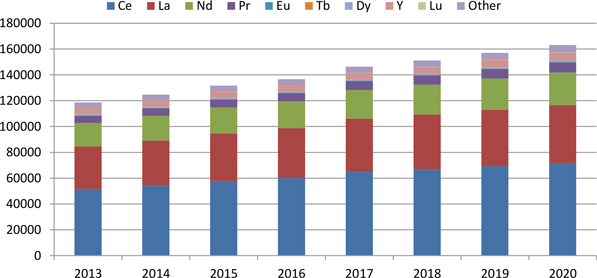
Figure 19-1: Estimated Global REO Supply (by Element)
| 19.3 | Rare Earth ELEMENT Consumption and Demand Forecast |
Global demand for REE’s in 2013 is estimated at ~121 000 t. Global demand has been negatively impacted by the unprecedented high prices in 2011. Since then, demand growth has tempered as the Chinese economy has softened and buyers have moved to just in time inventory management. A breakdown of Rare Earth usage in 2013 can be seen in Figure 19-2.
The majority of REE’s are currently consumed by the glass and magnet industries (each segment comprises 23 % of total consumption), followed by catalysts and alloys (19 % and 17 %, respectively).
Japan and the USA are the key importers of rare earths, each representing ~37 % of Chinese exports Year to date May 2014. Shipments for the first five months of the year to Japan and the USA were up 99 % and 57 %, respectively.
 |  |
| | Prefeasibility Study - NI 43-101 - Technical report for the Norra Kärr Rare
Earth Element Deposit - 0465-RPT-014 Rev 0 |
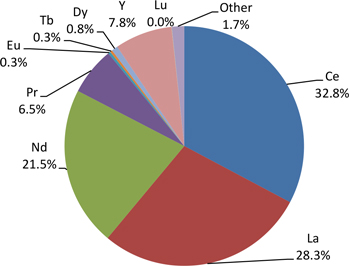
Source: industry sources
Figure 19-2: Breakdown of Rare Earth Usage by Element 2013
REO demand is forecast to grow to ~139 000 t in 2020 (a seven year compound annual growth rate of 2 %) driven by a number of end markets including industrial applications (auto and fluid cracking catalysts, glass additives and polishing powders, metal alloys) and technology-related applications (primarily permanent magnets). With respect to specific elements, demand for Dy and Nd is expected to grow at the highest rates (~4 % per year). Details of demand by segment are summarized in Table 19-3.
 |  |
| | Prefeasibility Study - NI 43-101 - Technical report for the Norra Kärr Rare
Earth Element Deposit - 0465-RPT-014 Rev 0 |
Table 19-3: Demand Summary
| | | | | | | Demand (t REO) | | | CAGR [%] | | | |
| Application | | Description | | REE | | 2013 | | | 2016 | | | 2020 | | | 2013-2016 | | | 2016-2020 | | | Key Drivers |
| Glass | | | | | | | 28 000 | | | | 30 000 | | | | 33 600 | | | | 2 | | | | 3 | | | |
| % of total | | | | | | | 23 | | | | 23 | | | | 24 | | | | | | | | | | | |
| Additive | | Ce - stabilizer in CRTs; UV blocker in auto glass
La - reduces dispersion in optical glass | | Ce, La
Some Nd, Pr, Er | | | 7 900 | | | | 8 900 | | | | 10 800 | | | | 3 | | | | 5 | | | Ce - CRT use; car manufacturing
La - digital cameras, binoculars, medical |
| Polishing Powder | | Polishing of semi conductor components | | Ce primarily, La, Nd, Y | | | 20 100 | | | | 21 100 | | | | 22 800 | | | | 1 | | | | 2 | | | Use of nano-particulate polishing powders |
| Magnets | | | | | | | 28 500 | | | | 32 800 | | | | 37 100 | | | | 4 | | | | 3 | | | |
| % of total | | | | | | | 23 | | | | 26 | | | | 27 | | | | | | | | | | | |
| | | Nd-Fe-B magnets - higher power with lower size/weight
SmCo | | Nd, Dy, Sm, Pr, Tb | | | | | | | | | | | | | | | | | | | | | | adoption of EV's; adoption of wind power; demand for HDD, mobile phones |
| Catalyst | | | | | | | 23 300 | | | | 25 200 | | | | 27 900 | | | | 2 | | | | 3 | | | |
| % of total | | | | | | | 19 | | | | 20 | | | | 20 | | | | | | | | | | | |
| Auto | | reduce pollutants, increase efficiency | | 40g REO/unit; Ce (some Pr, Nd, La) | | | 6 000 | | | | 6 800 | | | | 8 000 | | | | 3 | | | | 4 | | | stricter emission controls; GDP |
 |  |
| | Prefeasibility Study - NI 43-101 - Technical report for the Norra Kärr Rare
Earth Element Deposit - 0465-RPT-014 Rev 0 |
| | | | | | | Demand (t REO) | | | CAGR [%] | | | |
| Application | | Description | | REE | | 2013 | | | 2016 | | | 2020 | | | 2013-2016 | | | 2016-2020 | | | Key Drivers |
| FCC | | enhances gasoline yield in oil refining process | | 1%-5% REO by weight; 60%-99% La, remainder Ce | | | 17 300 | | | | 18 400 | | | | 19 900 | | | | 2 | | | | 2 | | | oil consumption (esp. oil sands); GDP |
| Alloy | | | | | | | 20 600 | | | | 18 400 | | | | 17 500 | | | | -3 | | | | -1 | | | |
| % of total | | | | | | | 17 | | | | 14 | | | | 13 | | | | | | | | | | | |
| Metal | | Added to aluminium, iron, steel | | Ce primarily, La, Nd, Pr | | | 11 700 | | | | 12 400 | | | | 14 000 | | | | 1 | | | | 3 | | | industrial use |
| Battery | | annode of NiMH battery rechargeable batteries and energy storage | | Mischmetal (La, Ce, Nd, Pr) | | | 8 900 | | | | 6 000 | | | | 3 500 | | | | -9 | | | | -13 | | | adoption of EV's; adoption of Li-ion batteries as a NiMH replacement |
| Ceramics | | | | | | | 6 800 | | | | 7 400 | | | | 8 100 | | | | 2 | | | | 2 | | | |
| % of total | | | | | | | 6 | | | | 6 | | | | 6 | | | | | | | | | | | |
| | | Stabilizer and sintering aid; colourant | | Y, La, Ce, Pr, Nd | | | | | | | | | | | | | | | | | | | | | | Demand for capacitors and semiconductors |
| Phosphor | | | | | | | 6 900 | | | | 6 100 | | | | 5 900 | | | | -3 | | | | -1 | | | |
| % of total | | | | | | | 6 | | | | 5 | | | | 4 | | | | | | | | | | | |
| | | Coating for flat screens; energy efficient lighting | | High purity required; 92%-96% Y, 4%-8% Eu for red phosphor; also use Ce, Tb, Gd, La | | | | | | | | | | | | | | | | | | | | | | growth of LCD and plasma displays; shift to efficient lighting |
| Other | | | | | | | 7 200 | | | | 8 000 | | | | 9 200 | | | | 3 | | | | 4 | | | |
| % of total | | | | | | | 6 | | | | 6 | | | | 7 | | | | | | | | | | | |
| | | | | | | Demand (t REO) | | | CAGR [%] | | | |
| Application | | Description | | REE | | 2013 | | | 2016 | | | 2020 | | | 2013-2016 | | | 2016-2020 | | | Key Drivers |
| | | Nuclear, military weapons, water treatment, fertilizers (China), laser, magnetic refrigeration, fuel cells | | Various | | | | | | | | | | | | | | | | | | | | | | Various |
| Total | | | | | | | 121 300 | | | | 127 900 | | | | 139 300 | | | | 1 | | | | 2 | | | |
Souce: Industry Sources
 |  |
| | Prefeasibility Study - NI 43-101 - Technical report for the Norra Kärr Rare
Earth Element Deposit - 0465-RPT-014 Rev 0 |
| 19.4 | REE Supply/Demand Balance |
The increasing availability of the lighter elements (especially Ce) suggests that these markets will be well supplied in the future. However, production of heavier elements outside of China is expected to take longer, primarily due to metallurgical and cost challenges. Elements expected to be in short supply (and therefore ‘critical’) by 2020 include Nd, Pr, Tb, Dy and Y as shown in Figure 19-3.
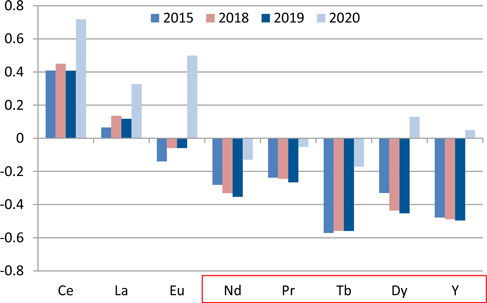
Source: industry sources
Figure 19-3: Identification of Critical Rare Earth Elements - Percentage Over/Under Supply
| 19.5 | REE Pricing and Forecast |
Rare earth pricing is more complex than for commodities and is definitely more opaque. Historically, there has been no open market for rare earths (which are primarily ‘traded’ individually – all 17 of them) and most of the sales up to this point have been in the form of long term supply agreements, which are subject to a number of variables including volume discounts, cost structure of the buyer, potential cost subsidies, and effect of co-products at the producing mine. Furthermore, there is a range of rare earth products sold, which has an impact on price. In this report the focus is on REOs (typically 99.9 %), which is the common product reported.
There are a few agencies/companies reporting rare earth pricing (Metal Pages, Asian Metal, Industrial Minerals) although not all contracts are reported and volumes are unclear. As a result, there is typically a variance around pricing although directional movements are accurate.
 |  |
| | Prefeasibility Study - NI 43-101 - Technical report for the Norra Kärr Rare
Earth Element Deposit - 0465-RPT-014 Rev 0 |
REE pricing is impacted by more than just supply and demand. Prices have been volatile for the last decade as China introduced export quotas in 2005 and significantly reduced them in 2010, which sent some rare earth prices up over ten times. Prices in 2011 were at unprecedented highs, which resulted in stockpiling, recycling and ‘thrifting’ in applications. Currently, prices are depressed as demand growth has slowed and inventory (including illegal product) continues to work through the system.
The long term price forecast is lower than the trailing 3-year average for all elements but above current prices for some elements today (Nd, Tb, Dy and Y). Higher prices are primarily supported by demand growth for permanent magnets and the slower ramp up of heavy rare earth mines outside of China.
 |  |
| | Prefeasibility Study - NI 43-101 - Technical report for the Norra Kärr Rare
Earth Element Deposit - 0465-RPT-014 Rev 0 |
Table 19-4 REO Price Deck
| REO Price Deck | | | | | | | | | | | | | | | | | | | | | | | | | | | | | | | | | |
| US$/kg | | | La | | | | Ce | | | | Pr | | | | Nd | | | | Sm | | | | Eu | | | | Gd | | | | Tb | | | | Dy | | | | Lu* | | | | Y | |
| | | | | | | | | | | | | | | | | | | | | | | | | | | | | | | | | | |
| TSM PFS | | | 7 | | | | 5 | | | | 115 | | | | 80 | | | | 8 | | | | 700 | | | | 40 | | | | 950 | | | | 575 | | | | 900 | | | | 25 | |
| | | | | | | | | | | | | | | | | | | | | | | | | | | | | | | | | | | | | | | | | | | | | |
| Comparisons: | | | | | | | | | | | | | | | | | | | | | | | | | | | | | | | | | | | | | | | | | | | | |
| L3Y avg. FOB | | | 16 | | | | 15 | | | | 115 | | | | 94 | | | | 33 | | | | 1661 | | | | 67 | | | | 1349 | | | | 747 | | | | 1422 | | | | 50 | |
| L3Y avg. China | | | 10 | | | | 10 | | | | 85 | | | | 78 | | | | 9 | | | | 1214 | | | | 27 | | | | 972 | | | | 576 | | | | 1138 | | | | 23 | |
| | | | | | | | | | | | | | | | | | | | | | | | | | | | | | | | | | | | | | | | | | | | | |
| TSM PEA (March 2012) | | | 10 | | | | 5 | | | | 75 | | | | 75 | | | | 10 | | | | 500 | | | | 40 | | | | 975 | | | | 520 | | | | n/a | | | | 20 | |
| | | | | | | | | | | | | | | | | | | | | | | | | | | | | | | | | | | | | | | | | | | | | |
| Current Price - FOB | | | 5 | | | | 5 | | | | 120 | | | | 60 | | | | 6 | | | | 725 | | | | 47 | | | | 615 | | | | 340 | | | | | | | | 13 | |
| Current Price - China | | | 2 | | | | 2 | | | | 78 | | | | 46 | | | | 3 | | | | 365 | | | | 15 | | | | 405 | | | | 224 | | | | 1510 | | | | 6 | |
Source: Industrial Minerals and Rocks, Metal Pages, Bloomberg, Company Reports
 |  |
| | Prefeasibility Study - NI 43-101 - Technical report for the Norra Kärr Rare
Earth Element Deposit - 0465-RPT-014 Rev 0 |
Finished rare earth products (99.9 % separated REO) from Norra Kärr can be marketed globally although the initial focus is Europe. REO demand in Europe is estimated at ~8 000 tpa REO (broken down as per Table 19-5). Norra Kärr’s expected annual output has been included to illustrate which local markets could potentially be satisfied by the new project. It appears that there is potential to sell a good portion of the Nd and Pr locally while Tb, Dy, Y, Eu and Lu will likely have to be marketed outside of the region. Tasman currently does not have any contracts in place.
 |  |
| | Prefeasibility Study - NI 43-101 - Technical report for the Norra Kärr Rare
Earth Element Deposit - 0465-RPT-014 Rev 0 |
Table 19-5 Estimated REO Demand
| Estimated REO Demand in Europe (tpa) | | | | | | | | | | | | | | | | | | | | |
| | | Total | | Estimated Breakdown by Element |
| End Market | | REO | | Ce | | La | | Nd | | Pr | | Sm | | Eu | | Gd | | Tb | | Dy | | Y | | Lu | | Other |
| Magnets | | 370 | | 0 | | 0 | | 280 | | 62 | | 8 | | 0 | | 6 | | 1 | | 13 | | 0 | | 0 | | 0 |
| Battery Alloy | | 0 | | 0 | | 0 | | 0 | | 0 | | 0 | | 0 | | 0 | | 0 | | 0 | | 0 | | 0 | | 0 |
| Metal Alloy | | 480 | | 250 | | 125 | | 79 | | 26 | | 0 | | 0 | | 0 | | 0 | | 0 | | 0 | | 0 | | 0 |
| Auto Catalyst | | 2,730 | | 2,457 | | 137 | | 82 | | 55 | | 0 | | 0 | | 0 | | 0 | | 0 | | 0 | | 0 | | 0 |
| FCC | | 1,610 | | 242 | | 1,369 | | 0 | | 0 | | 0 | | 0 | | 0 | | 0 | | 0 | | 0 | | 0 | | 0 |
| Glass Polishing | | 310 | | 202 | | 99 | | 0 | | 9 | | 0 | | 0 | | 0 | | 0 | | 0 | | 0 | | 0 | | 0 |
| Glass Adds | | 1,000 | | 660 | | 240 | | 30 | | 10 | | 0 | | 0 | | 0 | | 0 | | 0 | | 20 | | 0 | | 40 |
| Phosphor | | 250 | | 31 | | 36 | | 0 | | 0 | | 0 | | 11 | | 4 | | 12 | | 0 | | 157 | | 0 | | 0 |
| Ceramics | | 630 | | 76 | | 107 | | 76 | | 38 | | 0 | | 0 | | 0 | | 0 | | 0 | | 334 | | 0 | | 0 |
| Other | | 620 | | 242 | | 118 | | 90 | | 25 | | 12 | | 6 | | 6 | | 0 | | 3 | | 112 | | 3 | | 3 |
| Total | | 8,000 | | 4,158 | | 2,230 | | 637 | | 225 | | 20 | | 18 | | 16 | | 12 | | 16 | | 622 | | 3 | | 43 |
| % Breakdown | | 100.0% | | 52.0% | | 27.9% | | 8.0% | | 2.8% | | 0.3% | | 0.2% | | 0.2% | | 0.2% | | 0.2% | | 7.8% | | 0.0% | | 0.5% |
| Norra Kärr output | | 5,363 | | 1,150 | | 510 | | 613 | | 152 | | 168 | | 21 | | 185 | | 37 | | 250 | | 1,854 | | 21 | | 402 |
| Over/under | | | | -3,008 | | -1,720 | | -24 | | -73 | | 148 | | 3 | | 169 | | 25 | | 234 | | 1,232 | | 18 | | 359 |
Source: CHEN Zhanheng (2014), "Material Flow Analysis for Identifying Rare Earth Element Recycling Potentials in the EU-27" (2013), industry sources
 |  |
| | Prefeasibility Study - NI 43-101 - Technical report for the Norra Kärr Rare
Earth Element Deposit - 0465-RPT-014 Rev 0 |
Key end markets for Norra Kärr include magnets (Nd, Dy) and phosphors (Tb, Eu, Y). To a lesser extent, auto catalysts, ceramics and glass additives are also potential markets although these end markets also consume a significant amount of La and Ce, which are not key payables for Norra Kärr.
| 19.7 | Potential Upside From Co-Products |
The Norra Kärr project has the potential to produce nepheline syenite as a co-product, which could have a favourable impact on economics. Nepheline syenite is a type of igneous rock composed of sodium and potassium feldspars and nepheline and can only form in a geologic environment deficient in silica. Nepheline syenite is primarily used in manufacturing glass (acts as a source of alumina to achieve the lowest melting temperature) and ceramics (used as a flux and in glazes and coatings) but also as roofing granules, road materials, riprap, as well as asphalt and concrete aggregate (because of its weather-resistant properties and high strength). It adds durability to paint while reducing the use of volatile organic compounds and can be used as a whitener in ceramics (as opposed to zirconium silicate, which can contain radioactive elements).
Global production of nepheline syenite is currently dominated by Russia (UC Rusal), which primarily uses the product (100 % captive) in the production of aluminium (although concentrate produced by OJSC Apatit is used in glass and ceramics). The major company involved in production of nepheline syenite for use in glass and ceramics is Sibelco of Norway, which owns operations globally including Unimin Canada (operates two mines in Ontario) and Sibelco Nordic (operates a mine on the island of Stjernoy in Norway). Canada and Norway are currently the major producers of nepheline syenite for use in glass and ceramics at ~600 000 tpa and 300 000 tpa, respectively.
The major segment consuming nepheline syenite in Europe is the glass industry (~80 % of Norwegian production, or ~240 000 tpa) followed by ceramics (~15 %, or ~45 000 tpa) and the remainder as filler. Transport costs are significant for nepheline syenite and therefore markets tend to be regional. Growth is expected in the ceramics industry (China, Italy and Spain) while demand for glass production is challenged by increased recycling technologies and initiatives.
 |  |
| | Prefeasibility Study - NI 43-101 - Technical report for the Norra Kärr Rare
Earth Element Deposit - 0465-RPT-014 Rev 0 |
| Section 20 | Environmental Studies, Permitting, and Social or Community Impact |
| 20.1 | Environmental Summary |
| 20.1.1 | Basis of Assessment |
This section contains:
| · | Brief description of the project area (= the PFS nominated project footprint and environs) and the baseline environment; |
| · | Description of expected potentially material environmental issues; |
| · | Brief description of activities of particular importance to environmental impacts caused by the mining operation, i.e. waste management, water management and monitoring; |
| · | Description of the permitting process related to a mining project in Sweden; |
| · | Discussion of social and community issues; and |
| · | Brief commentary on health and safety aspects of the project. |
The baseline reports used in the preparation of this assessment are listed in Table 20-1.
 |  |
| | Prefeasibility Study - NI 43-101 - Technical report for the Norra Kärr Rare
Earth Element Deposit - 0465-RPT-014 Rev 0 |
Table 20-1: Baseline studies prepared by other experts
| Study Title | | Author/Source | | Date |
| Water | | | | |
| Norra Kärr Regional Environmental Assessment | | iO global Solutions Ic. | | 2012 |
| Miljötillstånd och naturvärden I Gyllingesjön, Stavabäcken och Narbäcken 2011-2013 | | Naturvatten | | 2013 |
| Ytvattenprovtagning för kemisk analys vid Norra Kärr (Results from surface water sampling) | | Sweco Environment AB | | 2014 |
| Swedish Water-Information system VISS | | http://www.viss.lansstyrelsen.se/ | | |
| Biodiversity | | | | |
| Naturvärdesinventering. Underlag inför ansökan om bearbetningskoncession för jordartsmetaller (Inventory of nature values) | | Pro Natura | | 2012 |
| Naturvärdesinventering och beskrivning av fem alternative sandmagasin vid Norra Kärr / Gränna, 2012 | | Pelagia Miljökonsult AB | | 2012 |
| Naturvärden vid Norra Kärr / Gränna med omnejd | | Pelagia Miljökonsult AB | | 2012 |
| Protection areas | | | | |
| Bevarandeplaner för Natura områden i Jönköpings län (Conservation plans for Natura 2000 areas in County of Jönköping) | | http://www.lansstyrelsen.se/jonkoping/Sv
/djur-och-natur/skyddad-natur/natura-
2000/Pages/bevarandeplaner.aspx | | |
| Bevarandeplaner för Natura 2000 områden i Östergötland (Conservation plans for Natura 2000 areas in County of Östergötland) | | http://www.lansstyrelsen.se/OSTERGOT
LAND/SV/DJUR-OCH-
NATUR/SKYDDAD-NATUR/NATURA-
2000/BEVARANDEPLANER-
KOMMUNVIS/Pages/bevarandeplaner.
aspx | | |
| Naturreservat i Jönköpings län (Nature reserve areas in County of Jönköping) | | http://www.lansstyrelsen.se/JONKOPING
/SV/DJUR-OCH-NATUR/SKYDDAD-
NATUR/NATURRESERVAT/Pages/default.
aspx | | |
| Biosfärområde Östra Vätterbranterna (Biosphere area) | | http://www.ostravatterbranterna.se/ | | |
| Geochemistry | | | | |
| Detaljerad beskrivning av de sällsynta jordartsmetallerna, Zn, Pb, U, Th, Y och Sc (Description of REEs) | | Golder Associates AB | | 2012 |
| Technical Note AM_TM_2014_27_03 Norra Kärr Project – Process Development and Radioactivity Deportment | | ANSTO Minerals | | 2014 |
| Cultural heritage | | | | |
| Arkeologisk utredning etapp 1 inför bearbetningskoncessionsansökan, Gränna och Ödeshög socken i Jönköping och Ödeshögs kommun, Jönköping och Östergötlands län (An archaeological survey) | | Jönköpings Läns Museum | | 2012 |
| Social and community | | | | |
 |  |
| | Prefeasibility Study - NI 43-101 - Technical report for the Norra Kärr Rare
Earth Element Deposit - 0465-RPT-014 Rev 0 |
| Study Title | | Author/Source | | Date |
Gruvdrift i Norra Kärr – Effekter på arbetsmarknad och näringsliv (Effects on labour market and economy) NU! Nordiska Undersökningsgruppen, 2013: Norra Kärr – Tasman Metals AB 2013 Rapport (Survey results) | | Tyréens AB NU! Nordiska
Undersökningsgruppen | | 2012 2013 |
| Land use | | | | |
Översiktsplan 2002 (Municipal Overview Plan 2002) | | http://www.jonkoping.se/byggabomiljo/
stadsplanering/oversiktligplanering/oversik
tsplan2002.4.14be7193136a0d804b726
89.html | | |
| Other subjects | | | | |
| Combiterminal Hubbarps industriområde Tranås (Transhipment Terminal for acid trains, Tranås), | | WSP Sverige AB | | 2014 |
| Utlåtande avseende jordskalv (Mine’s predicted impact on seismic risk), Norra Kärr | | ITASCA Consultants AB | | 2012 |
The assessment is based on the design information acquired from the design team during the PFS process. The design is described in the previous Sections of this report. The key documents used as the basis for the assessment work are listed in Table 20-2.
Table 20-2: Key source documents
| Document | | Source | | Date |
| Process package, including Process description, Process design criteria and Process flow diagrams | | GBM | | 2014-10-31 |
| Water treatment package | | Veolia | | 2014-09-30 |
| Site layout drawings | | GBM | | 2014-10-29 |
| Project Design Criteria | | GBM | | 2014-10-20 |
| Phase 1 Report on Tailings Storage Facility | | WAI | | 2014-09-22 |
| TSF preliminary design drawings and costings | | WAI | | 2014-10-29 |
| Proposed MWD layout memo | | WAI | | 2014-09-18 |
| Spillway Design – Hydrological Analysis Report | | WAI | | 2014-10-27 |
| Site Wide Water Balance Inputs for process (pdf memo and spreadsheets) | | GBM | | 2014-10-29 |
| Transient Water Balance for the Open Pit and Tailings Storage Facility Ponds memorandum | | WAI | | 2014-10-29 |
| Spreadsheets of water balance (transient WB results), updated | | WAI | | 2014-11-04 |
| Norra Kärr Preliminary Feasibility Hydrogeological Study | | WAI | | 2014-11-11 |
 |  |
| | Prefeasibility Study - NI 43-101 - Technical report for the Norra Kärr Rare
Earth Element Deposit - 0465-RPT-014 Rev 0 |
The Norra Kärr site and the surrounding area are characterised by alternating agricultural land and forests. The area is populated and the forests have been in commercial forestry use for generations. Significant areas within the project site and around it have been clear-cut recently and are either open or young-growth seedling stands. The entire environment is considered to be anthropogenic. There are a few small watercourses. Most of the project area naturally drains towards Lake Vättern via small streams, Narbäcken and Stavabäcken. The eastern part of the project area where the TSF is located drains southward via stream Adelövån, into the Motala Ström catchment away from Lake Vättern and further east into the Baltic Sea.
Figure 20-1 illustrates the environmental context of the project, i.e. the relationship of the project site with protection areas, watercourses and catchment areas. Baseline sampling locations in the vicinity of the site area also shown.
 |  |
| | Prefeasibility Study - NI 43-101 - Technical report for the Norra Kärr Rare
Earth Element Deposit - 0465-RPT-014 Rev 0 |
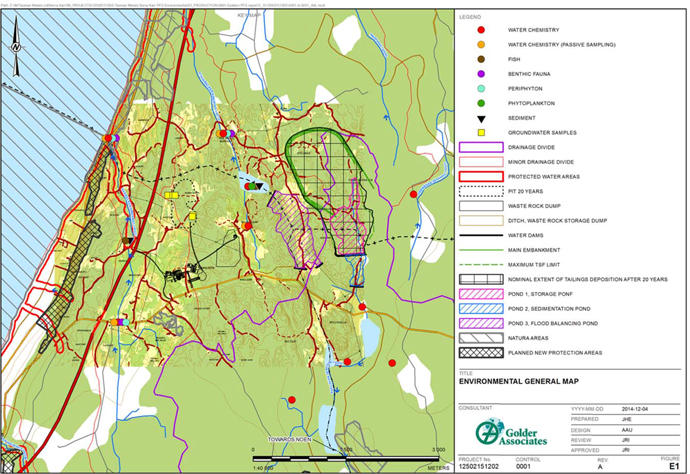
Figure 20-1: Environmental context
 |  |
| | Prefeasibility Study - NI 43-101 - Technical report for the Norra Kärr Rare
Earth Element Deposit - 0465-RPT-014 Rev 0 |
Several environmental baseline studies have been undertaken, concentrating particularly on the area of the Norra Kärr property and immediately around it, but partially also encompassing a wider area. Findings of key studies are summarised in the following sections.
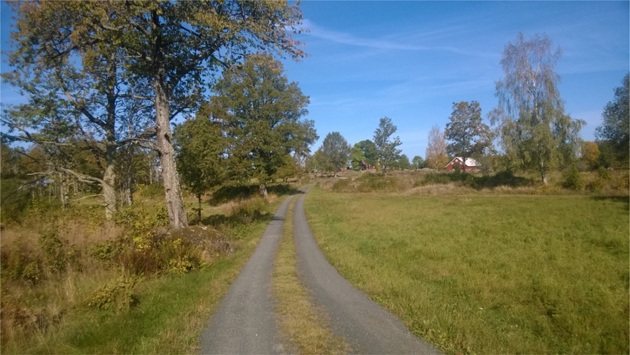
Figure 20-2: Environment within and near the Project site is characterised by an interaction of human and natural factors. Typical landscape includes agricultural land and deciduous trees
There are several various types of conservation areas near the project area. However, the project site does not overlap with any protection areas that in and of themselves would form a restriction to project development.
The most noteworthy areas are listed here. In addition there are a few areas of various national designations within 5 km radius of the project site.
| 20.1.3.1 | Natura 2000 sites |
Natura 2000 is a network of conservation areas within the European Union (EU), and is a key instrument in the EU’s commitment to halt loss of biodiversity. The network was established by the identification of Specially Protected Areas under the EU Birds Directive (79/409/EEC) and Special Areas of Conservation under the Habitats Directive (92/43/EEC). Approximately 2 000 species are protected under the system which encompasses some 26 000 protected areas Europe-wide covering a total area of more than 850 000 km2. This corresponds to approximately 18 % of the EU terrestrial
 |  |
| | Prefeasibility Study - NI 43-101 - Technical report for the Norra Kärr Rare
Earth Element Deposit - 0465-RPT-014 Rev 0 |
area. In Sweden, statutes related to the Natura 2000 network of sites are included in the Environmental Code (Miljöbalken, SFS 1998:808).
Any plan or project likely to have a significant effect on a Natura 2000 site, either individually or in combination with other plans or projects, shall undergo an Appropriate Assessment to determine its implications for the site. The competent authorities can only agree to the plan or project after having ascertained that it will not adversely affect the integrity of the site concerned (Chapter 7 of the Environmental Code and Article 6.3 of the Habitats Directive).
Natura 2000-areaVändelstorp och Målskog (SE0310725),which is designated under the Habitats Directive, is located about 500 m south of the process plant area on the other side of the road to Tranås. The area consists of grazed pastures near Vändelstorp with birches and oaks as dominant tree types. An area with old pollarded ashes, whitebeams and sweet cherries has a very high nature value. Nearly half of the Natura 2000 site area represents a priority grassland habitat type (habitat code *6270 in Annex I of the Habitats directive).
Natura 2000-areasNarbäck (SE0230184)located 1.3 km northwest of Norra Kärr (Figure 20-3), andHolkaberg(SE0230331) directly to the north of the Narbäck site, are part of theHolkaberg och Narbäcknature reserveareaandare designated under the Habitats Directive. The combined site stretches in and along the steep slopes of the eastern shores of Lake Vättern. These slopes have generally very high nature values. There are a lot of deciduous forests with a special climate, which forms a suitable habitat for number of rare lichens, mosses and other humid-dependent species. The Narbäck site includes a ravine with a small stream. The ravine forest has very high biological values. The most prominent habitat type in both sites is priority habitat type 9020 Fennoscandian old-growth deciduous forest. The small streams Narbäcken and Stavabäcken both flow from the project area into Lake Vättern through these Natura 2000 sites.
 |  |
| | Prefeasibility Study - NI 43-101 - Technical report for the Norra Kärr Rare
Earth Element Deposit - 0465-RPT-014 Rev 0 |
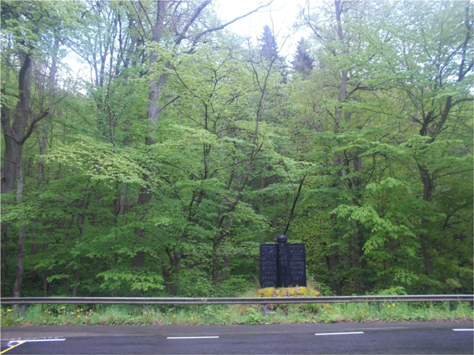
Figure 20-3: Lush vegetation at Natura 2000 site Narbäck
Several Natura 2000 sites cover the area of Lake Vättern, of whichVättern (södra)(SE0310432) andVättern (östra) (SE0230268) are the nearest to the project site at a distance of about 1.5 km. Both are designated under the Habitats Directive and the Vättern (östra) site also under the Birds Directive.
Natura 2000-area and nature reserve areaHuluskogen (SE0310225), designated under the Habitats Directive, lies 4.5 km south-east from Norra Kärr. The distance to the southern part of the TSF ponds is about 2 km. The area is hilly and comprises of an old coniferous forest with spruce and pine. More than half of the site is covered by priority habitat type 9010 western taiga.
Natura 2000-areaLilla Morlejan (SE0230320), designated under the Habitats Directive, lies about 3 km to the east of the TSF and is covered mostly by priority grassland habitat type 6270.
| 20.1.3.2 | New nature reserve areas |
The municipality of Jönköping is in the process of defining two new nature reserve areas along the Vättern eastern escarpment. The new nature reserves will form a southern extension of the current Narbäck-Holkaberg area on the Ödeshög side of the county border. These sites will be located at about 1.3 km to the west of the project area at the nearest point. A narrow gap of un-designated area is planned to be left between the two sites where there is currently a road.
Kleven(Klevenbranten) is a west facing scarp within the Vättern fault steep just south from Narbäck. This area extends from the Vättern shore to the top of the steep which is 190 m higher than the lake
 |  |
| | Prefeasibility Study - NI 43-101 - Technical report for the Norra Kärr Rare
Earth Element Deposit - 0465-RPT-014 Rev 0 |
surface. The nature reserve area comprises of an old broadleaved forest with humid microclimate and an old mixed forest with pines and oaks (five registered key habitats).
Boerydsberget is a narrow 2 km long broadleaved forest on Vättern fault steep south from Kleven. The nature reserve area comprises of an old broadleaved forest and an old mixed forest with pines and oaks (10 registered key habitats). There are plenty of deadwood and many trees worthy of protection. Different species of moss grow abundant on rock walls.
Biosphere reserve East Vättern Scarp Landscape Biosphere areas are part of UNESCOs scientific program “Man and the Biosphere”, whose purpose is to improve the relationship between people and the environment globally. The biosphere area is split into three types of zones: the central zone, buffer zones and development zones. The mine concession area lies completely within the biosphere development area. The biosphere designation does not cause any immediate, direct influence in environmental permitting of the mine, but it will be taken into consideration.
| 20.1.3.4 | Lake Vättern protection area |
Water protection zone: Lake Vättern is a very important water source. The protection zone comprises the Lake Vättern surface area, inflowing water courses (lower parts of the streams Narbäcken and Stavabäcken) and 50 m wide shorelines. There are some restrictions in the protection zone including that chemicals cannot be directly delivered on soil to prevent dusting, and storage and transport of hazardous chemicals in volumes over 250 litres is forbidden.
Shoreline protection area:There is a shoreline protection area around Lake Vättern. In the municipality of Jönköping (and Habo) the protection area is 300 m inland from the shoreline (at mean water level); As an average around the Lake the protection distance is 100 m.
The protection measures include a restriction on the storage of chemicals within the zone. The restriction does not apply to the project area. The project site does not overlap with these protection areas. However, since the natural flow of surface waters from most of the project is towards Lake Vättern, protection of the lake will be taken into account in the environmental permitting considerations.
| 20.1.4 | National Interest Areas |
The Swedish system of National Interest (Riksintresse) is created under Chapters 3 and 4 of the Environmental Code. It is a system of designating areas of importance for various issues of public interest. The designation as a National Interest area is not a complete restriction of other types of development and indeed there can be directly conflicting National Interest designations for the same area. However, the interests must always be taken into consideration in permitting. The county board has the responsibility to ensure national interests within its area are not significantly damaged.
 |  |
| | Prefeasibility Study - NI 43-101 - Technical report for the Norra Kärr Rare
Earth Element Deposit - 0465-RPT-014 Rev 0 |
In the Norra Kärr site there are four overlapping National Interest designations.
National Interest for nature value (Riksintresse naturvärde)Area immediately on top of the mineral deposit is declared of nature value because of the unusual rock type. The Vättern eastern escarpment area to the west of the site is also a National Interest for nature value because of its biodiversity value.
National Interest for valuable minerals and materials (Riksintresse värdefulla ämnen)This designation is due to the Norra Kärr deposit and its importance.
National Interest for wind power (Riksintresse vindbruk)overlaps the westernmost part of the project area (part of pit and plant areas). It is based upon modelling data which covers a very large area. The project site affects a very small part of that area and is therefore assessed not to compromise the region’s wind power development significantly.
National Interest for outdoor recreation (Riksintresse friluftsliv) overlaps only a small portion of the concession area on the western side. All other project site is outside of this National interest designation.
The nearest designatedNational Interest for heritage protection (Riksintresse kulturmiljövård) is situated about 1 km from the project area.
The conflict of various National Interests as concerns the concession area is dealt with by the Exploitation Concession; exploitation of the geological resource is allowable despite Nature Value designation. However, if significant effects on other National Interest nature value areas would be deemed to be caused by the project, the interest conflict would need to be considered between the interest of mining and the other interests.
In general, the current ecological status of watercourses within the project site and in the surrounding area is typically moderate to good. The watercourses have been impacted by agricultural land use (nutrients) and morphological modifications.
Locally watercourses are given two chemical quality classifications: one including mercury concentration and the other if mercury is not taken into account. This is because very many surface water courses in Sweden have such high mercury concentrations that the chemical quality status for most of the watercourses in the country would very commonly be low. Therefore in Sweden the chemical quality status taken into account is usually the one without mercury. The watercourses within the project area and nearby have high (best) or good chemical status notwithstanding mercury. Baseline data concerning the chemical and ecological quality of the watercourses in the surrounding area has been collected in various studies, see Table 20-3.
 |  |
| | Prefeasibility Study - NI 43-101 - Technical report for the Norra Kärr Rare
Earth Element Deposit - 0465-RPT-014 Rev 0 |
Table 20-3: Baseline Studies Relating to Surface Water
| Norra Kärr Regional Environmental Assessment (29) |
Chemical status of the region and the effect of land use and bedrock type on water chemistry were studied. The study included water, soil and vegetation samples. The analyses included physical and chemical properties of the water courses, metal and nutrient concentrations, alkalinity and pH. In addition, data from Swedish Geological Survey (SGU) was also collected from the same area and was used to study the soil chemistry. All lakes showed very good buffering capacity and almost neutral pH. However, there were signs for anthropogenic SO4 wet deposition. Nutrient levels were generally elevated, which is likely due to the prevalence of farming and agriculture in the area. Metal concentrations in lakes were low, although in many lakes As, Cu, Ni and Zn concentrations were above the background levels. In vegetation samples, metal concentrations were mostly low. In the few samples where elevated concentrations were found, these were due to Cd, Cu, Ni and Zn. |
| Miljötillstånd och naturvärden i Gyllingesjön, Stavabäcken och Narbäcken (30) |
Dynamics, quality and environmental status were described for Stavabäcken, Narbäcken and Gyllingesjön. If the discharge will affect other water courses, the environmental status of the receiving water bodies will need to be determined. Such information may also be available from water and environmental authorities. The study included water, sediment, diatom, benthic fauna and fish samples. Golder considers that the undertaken sampling is adequate for the purpose, but notes that only two sediment samples were taken. Both physical and chemical properties were analysed. Analyses included alkalinity, turbidity and TOC, nutrients, oxygen, chlorophyll, metals, SO4 and chloride. In this study alkalinity indicated good buffering capacity against acidification, nitrogen concentrations were elevated, and metal concentrations did not exceed the environmental quality standards (EQS). In these samples metal concentrations were comparable to values in reference waters. Uranium concentrations were found to be slightly elevated and mercury levels were high in pike flesh. Ecological status, chemical status and nature values were set for Gyllingesjön, Stavabäcken and Narbäcken. |
| Kemisk Vattenprovtagning vid Norra Kärr (31) |
In this study four lakes (Gyllingesjön, Lille Glan (part of Adelövån stream), Ören, Bunn) and twelve streams were investigated. There was also sampling points in Vättern and in Munksjön (lake on the southern side of Vättern). From the water samples, pH, alkalinity, turbidity, nutrients, TOC, metals, SO4, Cl and F were analysed. In addition, temperature, conductivity and oxygen were measured. In the summary tables, there are reference values, but the results that are exceeding the values are not marked. In general the values were low or similar to reference data. In most samples, turbidity and TOC were high. |
Most of the project site, including the Norra Kärr deposit itself, lies within the catchment area of Lake Vättern. Vättern, with its surface area of nearly 2 000 km2 is the second largest lake (by area) in Sweden and the sixth largest in Europe. Its mean surface elevation is +88 AMSL and average depth is 41 m. The level is regulated. In addition to being of natural, cultural and practical value, Vättern is a very important water source, currently 250 000 people get their drinking water from the lake.
Because of the good water quality, Lake Vättern is sensitive to pollution. The turnover time of the lake water is long (60 years) also increasing the sensitivity. Around the lake there are numerous industrial activities including paper manufacture and mining.
 |  |
| | Prefeasibility Study - NI 43-101 - Technical report for the Norra Kärr Rare
Earth Element Deposit - 0465-RPT-014 Rev 0 |
There is a water protection zone around Lake Vättern. The protection zone also includes the lower portions of the streams Narbäcken and Stavabäcken. The concession area lies outside the protected area.
The current strategy is to discharge all water from the process, TSF and any other facilities away from the Vättern catchment into Adelövån, which is a smallish stream flowing towards the south into Lake Noen and later into the Svartån river system, and eventually into the Motala Ström major river, via several lakes including Sommen. The Motala Ström will finally flow into the Baltic Sea.
Much of the course of the Adelövån stream is made up of a series of small lakes and ponds, which are all officially categorised as part of the Adelövån watercourse (ID SE643599-143039). The area around the planned discharge points and the two uppermost of these stream-lakes were visited by Golder team in September 2014. Based on the observations during this visit it is clear that the current channel upstream of Lake Gransjön is a modified, man-made ditch. The official watercourse Adelövån originates in the Gransjön, south of the road to Tranås. The stream passes under the Tranås road via a rectangular culvert. The channel is a couple of metres wide and partially overgrown. From Gransjön the watercourse appears upon brief inspection to more or less follow the natural channel; however, modifications have likely taken place. Altered stream morphology is the chief factor diminishing the ecological status of the entire stream. See Figure 20-4.
The first of the stream-lakes, Gransjön, is largely overgrown with reeds particularly in the northern end but there is also an open water area. The stream is small here in its upper reaches. Gransjön has a very low-lying western bank and would appear prone to flooding. The next one, Hultsjön also appears to have low-lying area in the northern end. In the later stages of project design the receiving watercourse should be investigated with more detail.
Adelövån stream is classified (in 2009) as having moderate (“måttlig”) ecological quality status (22). The factors currently diminishing the ecological quality status are related to stream morphology, which has been altered. As required by national legislation and the EU Water Framework Directive, the stream has been set a target to reach good ecological quality status by 2021. However, the current status and factors affecting it have been investigated as required by legislation and the hydromorphological changes have been deemed so high that the Swedish water authorities estimate that this target will not be technically achievable.
In terms of chemical quality status the stream is classified as high (best) chemical quality, which has the target of remaining at level high, when mercury is not taken into account. On the other hand, the mercury concentration in this stream, as well as most of the other watercourses in the area, is so high that in the latter classification (including mercury) the chemical quality status is low, and is expected to remain so in the future as well. The Adelövån has also been determined to be sensitive to nitrogen.
 |  |
| | Prefeasibility Study - NI 43-101 - Technical report for the Norra Kärr Rare
Earth Element Deposit - 0465-RPT-014 Rev 0 |
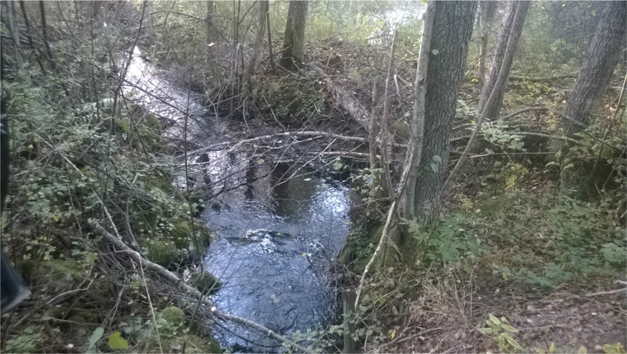
Figure 20-4: Adelövån stream at Häggebäcken (between Gransjön and Hultsjön)
The Adelövån (total length of stream 12.8 km) discharges into Lake Noen which is considered to have a very high nature value. Lake Noen also has ecological quality status moderate (target status: good) and chemical quality status high (notwithstanding mercury). The lake is described in the Vatteninformationssystem Sverige (VISS) as having very high biological function and high biodiversity value with otters, many species of fish, rich birdlife and as well as certain rare plant species present. Lake Noen is designated as a Nationally Valuable Water (nature value) (“Nationellt Särskilt Värdelful Vatten (Natur)”) as well as regionally valuable water (fishing) (22).
The flow rate in Adelövån varies greatly throughout the year. Currently there is no flow rate data available for the upper reaches of the Adelövån. Such data will be needed in the later stages of the project to ensure the capacity of the channel to take in all discharged water and for the design and permitting of potentially needed channel works. The Swedish Water Information System VISS includes modelled flow data for the entire sub-catchment (sub-catchment SE643599-143093 “Mynnar i Noen” i.e. “Flows into lake Noen”, which largely consists of the Adelövån itself). The modelled data has been provided by Swedish meteorology institute SMHI.
There are no regular periods of the year when there would always be very low or very high flow. Periods of low flow may occur at any time throughout the year, particularly later in the summer but also in autumn and winter in years of low rainfall and/or cold winters (when most precipitation arrives as snow and enters the stream only at snowmelt following spring). However, there are also warmer years when there is reasonably high flow throughout the winter, reflecting the fact that precipitation
 |  |
| | Prefeasibility Study - NI 43-101 - Technical report for the Norra Kärr Rare
Earth Element Deposit - 0465-RPT-014 Rev 0 |
comes as water or keeps melting even during the winter months. The highest monthly flow normally follows snowmelt in April but again after a warm winter there isn’t much snow to melt. Overall the yearly flow patterns are very varied.
The average flow rate for the catchment “Mynnar i Noen” is 0.37 m3/s or 1 332 m3/h (based on modelled data 2010-2012 by SMHI, downloaded from VISS).
| 20.1.5.3 | Other watercourses within and near project AREA |
The area around the Norra Kärr deposit, and most of the project site notwithstanding the TSF itself and two of the three planned ponds, drain naturally towards Lake Vättern via two small streams Narbäcken and Stavabäcken. There is a small lake Gyllingesjön located east of the deposit (between the planned pit and TSF) which collects water from most of the project area and drains via Stavabäcken stream (see Figure 20-5). No discharge of any contact water, including any storm water collected from project site or roads, is planned into any of these watercourses.
Aquatic ecology of these watercourses has been partially investigated during the baseline programme (Gyllingesjön and the streams towards Vättern i.e. Narbäcken and Stavabäcken). These watercourses are sensitive and relate to high nature value.
Lake Gyllingesjön (Figure 20-5) is not classified as a water source. The lake is already affected by over fertilization and organic matter load. The bottom layer of Lake Gyllingesjön is low in oxygen for most of the year.
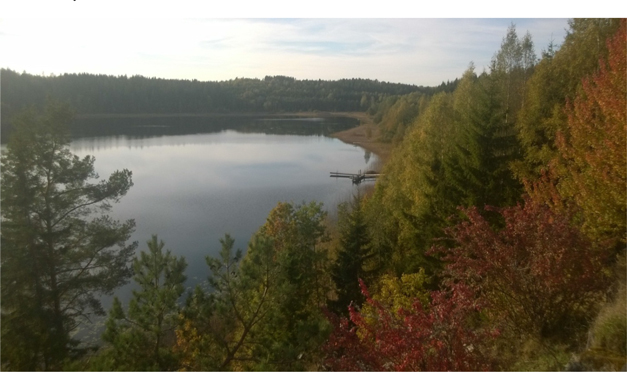
Figure 20-5: Lake Gyllingesjön
 |  |
| | Prefeasibility Study - NI 43-101 - Technical report for the Norra Kärr Rare
Earth Element Deposit - 0465-RPT-014 Rev 0 |
The Narbäcken and Stavabäcken streams flow into Lake Vättern through a Natura 2000 site. Water flow in the streams Stavabäcken and Narbäcken exhibit large annual variation. Any changes in flow conditions (increased or decreased) may affect the ecology downstream.
The current status of these small watercourses was determined in a baseline study (23). Stavabäcken was determined to have moderate ecological status in its mid-reaches and good in the lower portion. Narbäcken was similarly determined to have moderate ecological status in the higher reaches and good in the lower portion. Furthermore chemical status was determined for the higher reaches of Narbäcken and was found to be good (notwithstanding mercury). Lake Gyllingesjön’s ecological status is determined to be moderate, chemical good (notwithstanding mercury). All three watercourses were determined to have a moderate level of nature value (moderate level of being in natural condition, with no known rare species present).
Streams and Lake Gyllingesjön that are close to the site may also be affected by the project. There are several base line study points in these water bodies. Parameters studied from these water bodies include nutrients, metals and sulfate and are considered to be adequate for surface waters.
Sediments need to be investigated further in all possibly impacted water bodies.
The crystalline bedrock at the planned location of the open pit is covered by thin sandy-silty till and small peat areas and the bedrock is occasionally outcropping. The deepest observed soil depth at the site is 11 m.
The hydrogeological description of the Norra Kärr site has been developed in several stages involving both desktop studies and field investigations conducted by Golder and WAI in 2012 and 2014. Results indicate that groundwater is typically close to ground surface (approximately 200 masl), and flows towards the northeast.
There are several private wells located near the mining concession area, both water supply wells and geoenergy wells. The wells have been identified from official records in the area around the concession but not in the area of the TSF.
For hydrogeological purposes, five groundwater wells have been installed. Using these wells groundwater quality was studied (two sampling campaigns) to determine the baseline of groundwater quality for the site. Overall the results indicate normal quality of groundwater, however the sampling is not comprehensive and should be further supplemented. There is a risk of naturally high levels of fluoride in the groundwater in the bedrock in the whole area due to mineralogy of local rock.
 |  |
| | Prefeasibility Study - NI 43-101 - Technical report for the Norra Kärr Rare
Earth Element Deposit - 0465-RPT-014 Rev 0 |
| 20.1.7 | Ecological Baseline |
The area belongs to the boreo-nemoral vegetation zone, which means a mixture of deciduous and coniferous forests with no clear domination of either type. Typical broad-leaved trees include ash (Fraxinus), oak (Quercus), elm (Ulmus) and lime (Tilia) species, with conifers being dominated by spruce (Picea). In the area, deciduous forests tend to have more nature value than the coniferous forests, partially due to the tree species present and partially due to the fact that much of the spruce is planted for forestry purposes. There are a number of small watercourses, many of which are originally man-made ponds that add to the biodiversity features.
The project area and the area surrounding it are characterised by mixed agricultural and forestry use and have been inhabited for centuries. There are numerous dwellings and roads in the area. The entire environment in the area is considered to be anthropogenic. There are no pristine nature areas and no nature values related to purely natural development although certain areas are protected by, for example, varying topography have experienced less human influence and thus providing refuges for species and some valuable habitat. On the other hand, the very interaction of natural and human processes has resulted in a mosaic of varying environments (see Figure 20-6) that have certain nature values in their own right. Particularly areas where open land (grazing land and/or meadows) is interspersed with sparse trees or small copses tend to have high biodiversity, and when open water is also present, even more so.
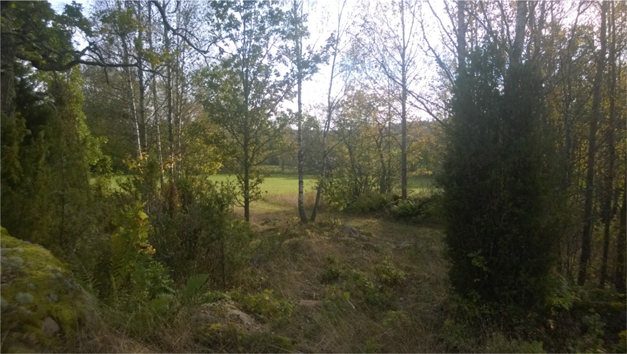
Figure 20-6: A mosaic of environments typical of the project area and environs
 |  |
| | Prefeasibility Study - NI 43-101 - Technical report for the Norra Kärr Rare
Earth Element Deposit - 0465-RPT-014 Rev 0 |
Thus some nature values of certain importance have been identified in the project area. These consist of areas of valuable habitats, occurrences of protected species and individual trees of high value. However, the identified nature values do not represent restrictive protection with the exception of certain protected species. Destroying individuals of protected species is prohibited, but it is possible to get an exemption from the prohibitions by application.
Parts of the impacted area have been recognised in various nature value inventories. For example some areas listed as “forest key biotopes” (skogliga nyckelbiotoper) or “valuable agricultural landscape” (värdeful natur i odlingsmark). These are limited in terms of area. These inventories are performed with the purpose of providing guidance to authorities in the field of biodiversity protection but are not restrictive protection designations.
Table 20-4: Ecology baseline studies
| Norra Kärr naturvärdesinventering. Underlag inför ansökan om bearbetningskoncession för jordartsmetaller (Pro Natura, 2012) |
Ecology consultancy firm Pro Natura was commissioned by Tasman to undertake an inventory including field studies at the Norra Kärr site and environs to recognize the scientific nature values in the planned mining area and make an impact assessment of these. An ecological survey was carried out in 2011 covering a study area of 2 km x 3 km around the Norra Kärr site that encompasses the mining concession, the industrial area and about half of the area of the mine waste dump. The TSF and the related ponds are however almost completely outside of the study area. |
| Naturvärden vid Norra Kärr / Gränna med omnejd (Pelagia Miljökonsult AB, 2012) |
| A desk top study of various protection areas, non-binding programmes and inventories of valuable areas (e.g. county-level inventories, forest authority’s inventory programme) inasmuch as they overlap with the 31 TSF location options that were being considered at the time. Among these options, areas A and 12 overlap with considerable portion of the PFS project area . |
In general, nature values in the area are tied to historical agricultural use and conditions have changed during the past few decades. Grazing grassland management has ceased and nowadays the focus is on spruce plantation for economic reasons. Many of the nature values related to past agricultural use are threatened by overgrowing. This progressive loss of value is also reflected in the results of the field inventory undertaken around the exploitation concession area (24). Of the total of 60 object areas of nature value identified within the 2 km by 3 km study area, only one was classified to represent the highest nature value, Class 1. A further 11 object areas were classified as Class 2 and all others having local value only in the Pro Natura study (24)..
One area immediately around an outcrop within the Norra Kärr site itself is classified as Class 1 based on historic mixed agricultural use. The remaining flora values in the pastures with underlying unique rock types give the object a highest nature value class. This value is also the basis for the National Interest Nature Protection (Riksintresse Naturvård) designation. The Class 2 objects consist mostly of valuable agricultural land but include also some deciduous forest and one object of
 |  |
| | Prefeasibility Study - NI 43-101 - Technical report for the Norra Kärr Rare
Earth Element Deposit - 0465-RPT-014 Rev 0 |
waterlogged forest (carr). None of the identified object areas within the study area are legally protected.
A brief field visit was undertaken by another ecology consultant Pelagia Miljökonsult AB in 2012 to areas being studied as options for the TSF. Two of these overlap with the current project area. Areas of valuable agricultural landscape as well as smallish areas of key forest biotope were identified during this visit around Kaxtorp-Mörstorp (western part of the project area), Staffanstorp and S Bråten (TSF area) as well as around Ingefrearp in an area that is located between the mine waste dump and the TSF.
| 20.1.7.1 | Endangered species and great crested newt |
IUCN (International Union for Conservation of Nature and Natural Resources) classifies species according to their level of being threatened by extinction. The classification ranges from LC (least concern) to EX (extinct). The classification NT (near threatened) means a species is not endangered, but is not doing very well either. Species that are classified as NT or below (VU, EN, CR) are red listed by the IUCN. In the studies undertaken, occurrences of red-listed species have been identified within the project area. These comprise species of lichen, fungi, vascular plants and insects, and one bird, the lesser spotted woodpecker (Dendrocopos minor) which is NT in Sweden although LC worldwide. All but one of these are species classified as NT, i.e. not exactly endangered, and one species of fungi classified as VU (vulnerable).
Great crested newt (Triturus cristatus) is present in several small ponds at the mine site and nearby. Although not endangered in Sweden or in the study area (IUCN listed LC, least concern), it is listed in Annex IV of the EU’s Habitats Directive. The species, along with its breeding grounds and other habitats used by it, are protected. If disturbance cannot be avoided, compensatory measures will need to be undertaken. A limited great crested newt inventory was carried out as part of the Pro Natura study (24) and established the presence of the species in several places within the project area (including the Norra Kärr site itself) and in the immediate environs.
| 20.1.7.2 | Trees with high nature value |
A particular biodiversity feature typical to the project area and its environs is the centuries-old tradition of pollarding trees. Pollarding means regular pruning of trees to produce continual new growth. In the area this has been practiced to produce animal fodder on various species of broadleaved trees, ash in particular. The pollarded trees can reach a very high age (several centuries) because the severe pruning keeps them in partially juvenile state. Many such old trees have high biodiversity value due to species, particularly lichens, living on the bark.
The Environmental Protection Agency approved, in 2004, a protection plan for trees in cultural landscapes in southern Sweden. Many endangered or threatened species are associated with these kinds of environments. The nature authorities have undertaken a tree survey in the area and a large
 |  |
| | Prefeasibility Study - NI 43-101 - Technical report for the Norra Kärr Rare
Earth Element Deposit - 0465-RPT-014 Rev 0 |
number of trees have been classified as “worth protection” (skyddsvärda träd). These are individual trees that have particular ecological value due to old age (>200 years of age at minimum, depending on species) and their large size (see Figure 20-7). Many of the listed trees are pollarded but some are listed on the basis of being old, hollow and/or very large. The classification is not a formal protection designation.
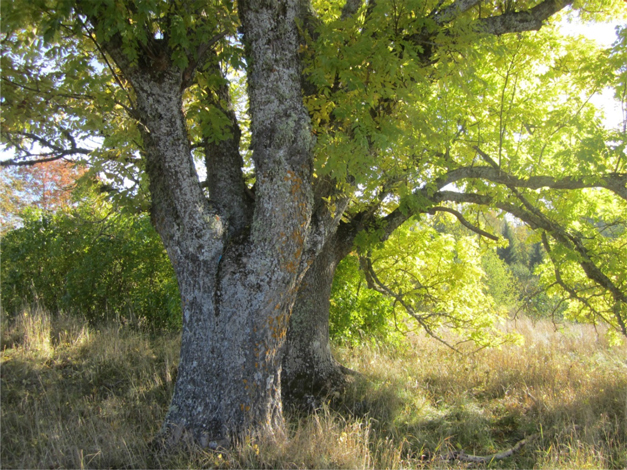
Figure 20-7: Great ash trees in the exploitation concession area, near the outcrop
There are a large number of such trees in the project area, around 100 in the Pro Natura study area alone and more in the surrounding areas. Particularly many listed trees grow around Ingefrearp, north and north-east of the mine waste dump but there are also several in Kaxtorp, Mörstorp, Långliden and Kvatarp. Clusters have been identified also within and near the TSF area.
Biosphere reserve East Vättern Scarp Landscape includes sub-areas where particular values are recognised. The western part of the project area is situated within sub-area H1 recognised for pollarded trees (dellandskap hamling). The importance of the sub-area recognition is to raise awareness of the value of the pollarded trees and it is not a formal protection designation.
 |  |
| | Prefeasibility Study - NI 43-101 - Technical report for the Norra Kärr Rare
Earth Element Deposit - 0465-RPT-014 Rev 0 |
Norra Kärr and its surroundings were largely colonized during the period 1550-1650 and the historical mapping shows that there were crofts and small holdings in the area. Furthermore there were old village plots together with now fossilized farming fields. Quite many of the fossilized fields can be seen on relatively recent maps from the 1950s. An archaeological baseline study has been undertaken for the area immediately surrounding the concession area but much of the project area remains un-investigated. More studies are required.
Table 20-5: Archaeological baseline study
| Arkeologisk utredning etapp 1 inför bearbetningskoncessionsansökan, Gränna och Ödeshög socken I Jönköping och Ödeshög kommun, Jönköping och Östergötlands län (35) |
An archaeological survey was carried out (Jönköpings County Museum, 2012) during the autumn of 2011 using the records held at the Jönköping County museum and a field study. The aim of the survey was to identify the known ancient and cultural relics, examine the previously not known areas and to create background information for the possible hidden ruins and relics. An area of approximately 100 hectares was surveyed around the mining concession area. An earlier archaeological survey (Jönköpings County Museum, 2010) in the area was carried out in connection with the planned wind turbines and is briefly referenced in the 2012 report. The surveyed area covers mainly the concession area and its vicinity. There is some information from the planned tailings facility south-east from the concession but quite a large part of the project’s total footprint area has limited data concerning the cultural environment. |
There are no national interest objects for cultural heritage environment protection in the surveyed area. Some archaeological finds are known but most the objects have been classified as “other cultural historical relics” which means that they are not fixed relics but still thought to have some antique value and should be brought to attention. These objects include old (fossil) fields, building foundations, apartment settlements, fences, a well/water source, a fracture/quarry and a linen pit.
There are a few objects classified as fixed relics (R,fast fornlämning). Some of these are designated “monitoring objects” which means they must always be investigated further prior to any ground works. Table 20-6 shows the monitoring objects identified in the area immediately surrounding Norra Kärr, together with an area with old field clearing stone piles which is classified as fixed relic.
 |  |
| | Prefeasibility Study - NI 43-101 - Technical report for the Norra Kärr Rare
Earth Element Deposit - 0465-RPT-014 Rev 0 |
Table 20-6: Cultural heritage objects
| | | | Cultural heritage objects identified in the archaeology studies (35) |
| | 25 | | | Apartment Settlements. Area with a number of remains; crofting remains, cellar, foundations, water well/spring, linen pit and stone wall. Within the area has also been a Grenadier cottage with evidence from the 1600s according to the historical mapping. Monitoring object. Suggested archaeological survey. |
| | RAÄ 369 | | | Apartment Settlements. Croft/cottage “Jeppahemmet” according to geometric surveying from 1718. No visible remains found in the field study. Fixed relic, monitoring object, archaeological survey suggested. |
| | RAÄ 374 | | | Village property/farming property. Norra Kärr farming property. Monitoring object. Fixed relic, suggested preliminary archaeological survey. |
| | RAÄ 373 | | | Old (fossil) fields. Area with old field clearing stone piles. Fixed relic, suggested preliminary archaeological survey. |
| | RAÄ 181, RAÄ 182 | | | Apartment Settlement in Ingefrearp east from Norra Kärr. |
As described in the previous sections, baseline studies relating to ecology and archaeology do not encompass the entire Project area. Conversely, some water sampling has been carried out in a wider area. Baseline data coverage in terms of project area is described in this section.
| 20.1.9.1 | Coverage of baseline studies (terrestrial) |
Parts of the nominated project area have not been subject to any field studies and therefore data gaps exist. Particularly the area proposed for the flood water retention pond (west of the water storage pond) and the northernmost part of the TSF are outside the study areas of any ecology field studies. Furthermore the TSF area along with some other parts of the project area, has only been subjected to a very brief field visit by ecology consultants Pelagia during their 2012 field visit. The more comprehensive ecology study carried out by Pro Natura in 2011 covers the area around the pit, most of the industrial area and western part of the mine waste dump. There will also be other infrastructure directly related to the project that has not been sited yet.
The archaeology study undertaken by the County Museum of County of Jönköping in 2012 covers only the area around the mining concession.
Figure 20-8 illustrates the study areas in relation to the Project area.
 |  |
| | Prefeasibility Study - NI 43-101 - Technical report for the Norra Kärr Rare
Earth Element Deposit - 0465-RPT-014 Rev 0 |
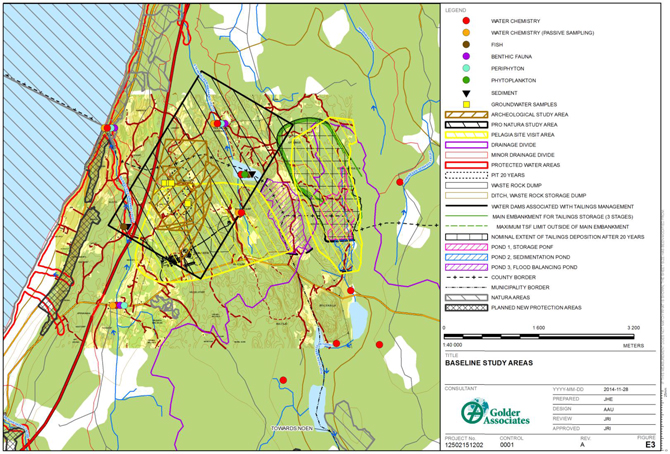
Figure 20-8: Areas covered by terrestrial baseline studies
 |  |
| | Prefeasibility Study - NI 43-101 - Technical report for the Norra Kärr Rare
Earth Element Deposit - 0465-RPT-014 Rev 0 |
| 20.1.9.2 | Sampling point locations (water) |
All water discharged from the project is in the current design directed towards the stream Adelövån flowing south. The chemical and ecological status of Adelövån has been determined by the authorities and is available in VISS (Swedish Water-Information system). Furthermore baseline sampling has been performed upstream of Gransjön (immediately downstream of the planned discharge point), downstream of Gransjön (between Gransjön and Hultsjön) and further down in the stream-lake Lille Glan. Samples were taken in 2012 (Oct), 2013 (Feb, May, Aug, Oct) and 2014 (Feb, May, Aug).
The study by IoGlobal Solutions Ic., Norra Kärr Regional Environmental Assessment (IoGlobal, 2012) presents an overall status of surrounding areas.
Water sampling for water chemistry has been undertaken over a wide area and it covers the affected watercourses quite well. However, sampling related to aquatic ecology (plankton, benthic fauna etc.) has only been carried out in some of the potential watercourses and may need to be supplemented. This is balanced by the fact that information related to ecological status of the Adelövån stream has been gathered by authorities and is available through VISS.
Sampling point locations around the exploitation concession and in the wider area are illustrated in . Figure 20-9.
It should be noted however that despite good coverage in terms of geographic area, some data concerning watercourses is also lacking. Quality data on sediments will likely need to be supplemented. Furthermore it is possible that when more information is available about expected quality of discharge water based on more comprehensive geochemistry testing, further sampling may be required to establish baseline levels for certain contaminants that may have not been included in the general baseline campaign.
It is considered likely that further information will be needed concerning water level and flow rates in the watercourses of the area, particularly the receiving stream.
 |  |
| | Prefeasibility Study - NI 43-101 - Technical report for the Norra Kärr Rare
Earth Element Deposit - 0465-RPT-014 Rev 0 |
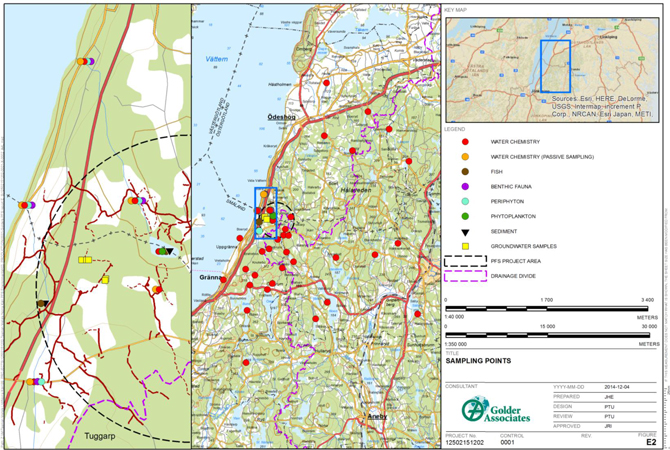
Figure 20-9: Sampling Point Locations
 |  |
| | Prefeasibility Study - NI 43-101 - Technical report for the Norra Kärr Rare
Earth Element Deposit - 0465-RPT-014 Rev 0 |
Most of the project-related infrastructure is planned to be located at the Norra Kärr project area, near the exploitation concession area as has been described above. In addition, there is a plan to construct a new loading and storage facility to be used for transhipment of sulfuric acid to the site. Industrial area Hubbarps on the southern edge of the town of Tranås has been identified as the best location for such a facility on the Swedish main trunk railroad line. A new side track would be connected to the transfer station “Tranås south” and the required infrastructure would be constructed next to it.
The municipality of Tranås has commissioned infrastructure consultants WSP Sverige AB to look at possibility of building a new combi terminal along the main railway track between the main railway line and Highway 32 south-south-west of Tranås centre, east of Trafikplats Tranås (the main exit from Highway 32 to Tranås). The initial report by WSP is from 2007. Tasman commissioned WSP to update the study to consider a transhipment facility in the same location. WSP considers (WSP 2014)the site to be well suited for such a facility considering space requirements, geotechnical conditions (based on WSP’s cursory inspection) and operability of the railroad line. There are currently no loading areas or facilities, but there is an existing pass-by rail which would make the construction of the new terminal easier and more feasible.
Currently the planned site is open ground. To the north is the industrial area, south of that there is open space that is located between the highway and the railroad. WSP considers the area to not be used much for recreation due to its unfavourable position between the railroad and the highway (WSP 2014).
There are some residential properties along the street which connects the area and Tranås centre, Katarpsvägen. WSP considers that a noise screen would be possible to be constructed if required. Current connection to the area is street Katarpsvägen , but according to the WSP preliminary plan, a new connecting road would likely be constructed. The WSP plan also indicates that a new industrial area is planned for the area between the railroad and Highway 32 (WSP, 2014). The existing industrial area, Hjälmaryd has industrial and warehousing properties. The companies in the area include metals industry, concrete manufacturing and scrap metal recycling. To the east of the industrial area there is a residential area about 1 km from the planned site of the transhipment terminal.
Currently the road access to the planned site is constrained and would be passing close to a Natura 2000 site and a residential area to reach the interchange to the Highway 32. However the municipality of Tranås has indicated an interest in developing a logistics area in the location and the road access may be improved in the future. In terms of railway traffic the suggested loading station has the benefit of being accessible directly from the main line both from north and south direction.
 |  |
| | Prefeasibility Study - NI 43-101 - Technical report for the Norra Kärr Rare
Earth Element Deposit - 0465-RPT-014 Rev 0 |
Close to the planned site there is also the river Svartån, flowing into Lake Sommen. The Svartån is one of the major rivers in the area. In the WSP preliminary plan certain objects of note are mentioned in the surrounding area, however in WSP’s opinion these are not expected to present obstacles to the development of the planned facility. These include trees classified as worthy of protection (skyddsvärda träd) in the southern part of the area as well as a cultural heritage monitoring object very near or within the planned construction site. WSP describes the area as culturally and historically interesting and suggests that a Phase 1 archaeology study is likely to be required (WSP, 2014). Considering there is a monitoring object known at the site it is also expected that a Phase 2 study will be required concerning the monitoring object before the remains can be disturbed.
| 20.2 | Expected Material Environmental Issues |
| 20.2.1 | Surface Water Quality |
| 20.2.1.1 | General: control of water discharges in Sweden |
The control of discharges into watercourses in Sweden, as well as many other European countries is based on the resulting ecological and environmental quality. This approach is pursuant to the EU Water Framework Directive. This means that no uniform, Europe wide, levels of allowable discharges are determined, because the resulting environmental quality is a factor of both the discharge and the receiving environment. No discharge must cause deterioration of the ecological status of the receiving watercourse. The Water Framework Directive calls for an improvement in the chemical as well as ecological status so that all surface waters should be to good chemical status and good ecological status by 2015.
In practice this means that the allowability of discharge into any given watercourse will need to be considered on a case by case basis. This consideration will in practice be performed by the environmental permitting authority when considering whether an environmental permit can be awarded to a given operation or activity. In Sweden this is the Land and Environmental Court (Mark- och Miljödomstolen).
For certain contaminants there are EQS. These are set either by the Dangerous Substances Directive 2006/11/EC or by national regulations. When the EQS is set, the approach is in principle the following:
Concentration in the watercourse after discharge ≤ environmental quality standard
As the concentration actually under scrutiny is the final concentration, the result of this calculation depends on the flow rates of the discharge and the receiving watercourse, as well as concentration in the discharge and the baseline concentration already present in the receiving watercourse.
 |  |
| | Prefeasibility Study - NI 43-101 - Technical report for the Norra Kärr Rare
Earth Element Deposit - 0465-RPT-014 Rev 0 |
Basically a larger stream with cleaner water could tolerate a higher discharge. However, if the receiving stream is already of a high ecological quality, then smaller changes in overall concentrations will result in deterioration of ecological status, which is prohibited under the Water Framework Directive and related national law.
EQS are only available for a limited suite of substances. For any other contaminants the consideration of whether the discharge would cause deterioration of the ecological status of the receiving watercourse will be made on a case by case basis. This will be based on combining information concerning the discharge, the contaminants in question and the baseline conditions at the receiving watercourse.
In addition to the resultant ecological status of the receiving watercourse, the environmental court will also take into account a number of other factors. The applicant will need to demonstrate that BAT (Best Available Technique) is utilised. Further factors that the court will consider include, for example, the presence of sensitive species in the watercourses, protected waters and other case-specific issues.
| 20.2.1.2 | Potential issues related to surface water quality |
Quality of water discharged from process: There will be no liquid water discharged from the process. The raffinate water in the process will be recycled in the water treatment plant, which incorporates RO treatment and nanofiltration. The concentrated reject solution (brine) will be evaporated on site and disposed of by trucking to off-site treatment or disposal.
The only water leaving the process is in the moisture content of the tailings streams (and, to a small extent, the product). All three tailings streams will be pumped into the TSF.
Pit water quality: based on current information about geochemistry, particularly the waste rock characterisation, it is expected that the local geology (waste rock) will not result in contamination of the pit water. However, the pit water may contain nitrous residues from the explosives. As the receiving watercourse Adelövån flows into Lake Noen, which is determined to be sensitive to nitrogen, it is possible that nitrogen removal may be required. Currently it is expected that the pit water is likely to be suitable for release into the environment via a sedimentation pond, with monitoring for nitrogen.
Quality of water discharge from TSF: early geochemical characterisation of one tailings stream is available. The nepheline/feldspar tailings are not expected to have a significant impact on water quality. However, the composition of the leached and neutralised residue (mostly made up of the mineral aegirine, a pyroxene) or gypsum from neutralisation is not known and thus water quality cannot be predicted. The actual waste water quality should be determined by testing incorporating representative amounts from each tailing stream.
 |  |
| | Prefeasibility Study - NI 43-101 - Technical report for the Norra Kärr Rare
Earth Element Deposit - 0465-RPT-014 Rev 0 |
Currently it is expected that excess water from the TSF can be discharged via a clarification pond to clarify solids. The need for further treatment such as removal of nitrogen or other contaminants remains unclear.
The discharges will be directed into the Adelövån which is a small stream. Contaminant loading via the Adelövån will end up in the small stream-lakes along the course of the stream and in Lake Noen.
Issues that will need to be taken into consideration in the future determination of possible treatment need, may be related to nitrogen loading (eutrophication), toxicological effects of various contaminants and other hydrodynamic and/or ecological effects caused by discharged waters. The discharge is different from the natural water in various aspects and the resulting consequences will need to be assessed. For example loading by salts at levels that have no toxicological effect could nevertheless strengthen stratification of the water layers of a lake or pond to such extent that harmful impacts to the pond/lake ecosystem could be caused. Very high salt loading may result in anoxic lower layers and sometimes formation of hydrogen sulphide.
Impacts on water quality in these lakes cannot be predicted with the current level of information and will need to be assessed later in the further stages of project development when more information is available. If significant negative impacts on water quality or the aquatic ecosystem were expected based on this assessment, suitable treatment of the discharge water is likely to be required.
Spills from TSF: The TSF area is located partially in an area that in natural conditions lies within the Vättern catchment. The embankment will form the new catchment boundary, however according to current TSF design surface water does not accumulate behind the main tailings containment embankment. The flood balancing pond is entirely situated within the current Vättern catchment. Discharges, including possible overflow, are diverted toward the Adelövån catchment, away from the Lake Vättern. Spills towards the Lake Vättern would be possible only in the unlikely event of dam failure. A risk assessment and a detailed risk management plan should be established for TSF failure risks.
Similarly to Lake Noen mentioned above, the Lake Gyllingesjön, while not considered sensitive, may be impacted if it receives water from the mining area, for example in the form of contaminated runoff.
| 20.2.2 | Surface Water Quantity |
Quantity of water discharged from the TSF: The receiving watercourse has average flow of 0.37 m3/s or 1 332 m3/h (average modelled flow 2010-2012) for the entire catchment areaMynnar i Noen, with considerably lower flows (~350 m3/h) occurring during dry months (modelled flow data by Swedish Meteorological Institute SMHI, loaded via VISS). Thus the discharge from the project even with water recycling is expected to be a significant portion of the entire stream flow. This may result in:
| · | Strict requirements for discharge water quality; |
 |  |
| | Prefeasibility Study - NI 43-101 - Technical report for the Norra Kärr Rare
Earth Element Deposit - 0465-RPT-014 Rev 0 |
| · | Streamflow effects: project may change seasonal flow patterns, although controlling the discharge pattern can be used to mitigate such change; and |
| · | Due to a notable increase in the stream flow over the year, it is possible that flood risks along the receiving stream may be aggravated. Flood risk assessment will likely be required. |
It appears that the Adelövån, including the uppermost small lakes, perhaps could not readily accommodate flows much higher than at present. On the other hand the watercourse is already heavily modified. Thus it is assumed likely that required dredging and other works in the channel could be permitted. The permit for such works would be part of the environmental permit for the mining operation itself. It appears likely that flood risk modelling and related design will be required in the future to establish conditions suitable for discharge.
The current process design incorporates a water recycling plant, resulting in a considerable reduction of both make up water intake and the discharge water flow rate.
Make up water: the amount of water to be extracted from Lake Vättern, 93.45 m³/h, is not likely to be significant in terms of physical or environmental impact. The flow is negligible in comparison to the size of the lake. The pumping by a conventional pipeline is not expected to cause risk of contamination. However, the water intake facility should be carefully designed to avoid any issues at the area of intake. The shape and design of the intake pipe, its exact location in relation to the local morphology at the lake and flow velocity at the point of intake all need careful consideration to avoid impacts. Due to the importance of the Lake, in order to receive a permit for extraction, it must be demonstrated that no significant harmful impacts will be caused.
Existing watercourses within project area: Currently there are two small watercourses, the streams Narbäcken and Stavabäcken located within the project area, and the small Lake Gyllingesjön through which Stavabäcken flows. In the current plan the channels are not intercepted, however the catchment areas of the watercourses are modified. These streams flow into Lake Vättern through the Natura 2000 area and nature reserveHolkaberg och Narbäck. These streams will need to be preserved and no significant deterioration in water quality or quantity is expected to be permittable.
The impact of pit drainage on Lake Gyllingesjön has not been implicitly assessed, but it is expected that the water level in the lake is directly dependent on groundwater level. Therefore if pit drainage results in a groundwater drawdown zone of influence that extends to the lake, the water level in the lake would be affected. The preliminary assessment suggests a drawdown radius of influence of approximately 500 m (drawdown in bedrock) (see Section 20.2.4). The shortest distance from the 20 year pit to the lake is about 700 m. Furthermore some of the precipitation currently flowing into the lake will be considered to be contact water and thus intercepted and led towards the Adelövån. Therefore the issue should be further investigated. The impact on the lake should be further assessed and monitored. Should further investigations indicate cause for concern, technical solutions are available to mitigate the effect and should be designed accordingly.
 |  |
| | Prefeasibility Study - NI 43-101 - Technical report for the Norra Kärr Rare
Earth Element Deposit - 0465-RPT-014 Rev 0 |
Management measures should be developed to avoid significant contamination of the water in the streams and to maintain flow rates at or near natural rates. Currently measures are planned to ensure all contact water will be diverted to the Adelövån catchment. When this approach is successfully implemented, risk of significant contamination at these two streams is considered low. On the other hand it must be simultaneously ensured that sufficient flow will be available in the streams.
| 20.2.3 | Further water management design needs |
Detailed water management plan:In the future stages of project development, a detailed water management plan should be developed. The plan should reconsider potential needs for further treatment of the water to be discharged into the environment. All mines in Sweden have in their environmental permits discharge limits for various substances in the water discharged into the environment. The substances controlled by the permits and the limit values vary depending on the expected waste waters and the receiving environment. The discharge limits that will be applied at Norra Kärr will be established during environmental permitting.
Particular note should be taken in the future water management plan to consider potential need for nitrogen removal (from pit outflow or environmental discharge). Several Swedish mines have discharge limits for nitrogen in waste water and the issue appears to be gaining importance.
If significant impacts on water quality are predicted in the future investigations, mitigation measures are expected to be required. Depending on the contaminants of concern and their concentrations, various types of treatment options exist for water discharges varying from simple after-treatment units to sophisticated treatment processes.
Furthermore the water management plan should concentrate on management of water quantity, considering both the need to avoid excessive discharge to the Adelövån (including consideration of flood risks) and maintain sufficient flow in the small streams within the project area. Issues relate to flow rates will also be established in environmental permitting.
Open pit mining will involve drainage of surface runoff and seeping groundwater. The lower benches of the pit may also have drain boreholes installed to decrease groundwater pressure in the slope walls for stability reasons (19). The predicted maximum groundwater inflow rate is about 50 L/s at the end of mining. The drainage will result in a local drawdown of the water table in the immediate surroundings of the open pit. The spreading of the drawdown will depend on the development depth of the pit, and the radius of influence has been estimated by both analytical calculations and by numerical groundwater modelling to extend approximately 500 m from the perimeter of the open pit at
 |  |
| | Prefeasibility Study - NI 43-101 - Technical report for the Norra Kärr Rare
Earth Element Deposit - 0465-RPT-014 Rev 0 |
full development depth. The westward radius of influence is estimated to be shortest due to the topographical water divide between the site and Lake Vättern.
Groundwater levels in both the bedrock and the soil may be impacted within the influence area of the open pit. However, the drawdown in the soil will be smaller than in the bedrock, the magnitude depending on the permeability of soil and bedrock, the soil depth and the recharge rate. In this case the permeability of the soil is estimated to be relatively low. The groundwater levels in the soil are therefore not expected to be affected more than marginally in most of the influence area. However, vegetation could be affected by groundwater drawdown close to the open pit perimeter.
The yield of wells in bedrock in the area has been estimated from regional hydrogeological information to 600–2000 l/h and smaller than 600 l/h in the area north-east of the site (Golder, 2012). There is a risk of naturally high levels of fluoride in the groundwater in the bedrock in the whole area due to mineralogy of local rock. There are 10 private wells within 1 km of the mining concession area registered in public records, both water supply wells and geoenergy wells. No water supply wells are identified close to the planned open pit; however, two geoenergy wells are located at Kaxtorp immediately to the south of the proposed pit area. About seven of these wells are estimated to be located within the area of influence of the open pit and the risk for drawdown of groundwater levels in wells decreases with the distance to the pit. The two (geoenergy) wells closest to the planned open pit belong to properties that probably will be acquired by the mine prior to start of mining operation. No protected areas are located within the estimated area of influence and are not expected to be affected by the groundwater drawdown.
The surface waters at the site, i.e. wetlands, streams, ponds and Lake Gyllingesjön, are believed to be dependent on groundwater level and groundwater drawdown may thus impact surface water levels and discharge.
| 20.2.4.2 | Tailings storage facility and sedimentation pond |
Water stored in the TSF and the sedimentation ponds will to some degree seep to the underlying groundwater in soil and rock. The seepage rates depend on the hydraulic properties of the basement geological materials, the design of the facilities and on the management and disposal practices of the facilities. The probable seepage rates have not been quantified at this stage (4). The potential impact on the groundwater includes raised groundwater levels in soil and rock in the vicinity of the facilities (lowered levels as a result of reduced infiltration due to low permeability of tailings is unlikely). The changed groundwater flow conditions may also affect nearby surface waters, wetlands and surface seeps. The potential impact on the groundwater at the proposed localisation of the tailings facility has not been investigated in detail (4). Furthermore, the occurrence of water supply wells in the surroundings of the proposed facility has not been investigated.
 |  |
| | Prefeasibility Study - NI 43-101 - Technical report for the Norra Kärr Rare
Earth Element Deposit - 0465-RPT-014 Rev 0 |
Potential changes in groundwater quality due to seepage from the tailings cannot be predicted based on current information because data is lacking concerning two of the three tailings streams. Quality of seepage water and its potential impacts should be investigated based on further information about tailings geochemistry.
Terrestrial biodiversity and ecology have been investigated in the field on most parts of the nominated project area. In these areas, certain nature values have been identified. Currently known values are of such character and significance that it is expected they will not present an obstacle for the project to go ahead; however, some management measures are expected to be required. At a minimum, a great crested newt management and compensation programme is expected to be needed.
Some parts of the project area have been surveyed very briefly, or not at all. There will also be other infrastructure directly related to the project that has not been sited yet such as the new power line. For the study areas please refer to Section 20.1.9.
However the entire environment is considered to be anthropogenic. Furthermore Swedish authorities are known to have environmental data of good quality and several county-level studies of nature values have been performed in the area. Based on these considerations Golder expects that the nature values related to the terrestrial ecology in the project’s impacted area are fairly well known. Comprehensive ecology field studies covering the entire project area and the ecological area of influence (including e.g. the power line) are expected to be required in the future to supplement current data and to determine, among other things, the presence or lack of populations of endangered species in more detail.
Based on currently available information, Golder considers it likely that there are no terrestrial nature values of such character that they would present an obstacle for the project to go ahead. Nor is it expected that such “showstopper" values will be identified in future studies. Certain mitigation or compensatory measures may be required, for example for endangered plant species found in the area it is possible that habitat compensation and translocation of the plants will need to be undertaken.
Aquatic ecology of the potentially impacted watercourses has been partially investigated during the baseline programme (Gyllingesjön and the streams towards Vättern i.e. Narbäcken and Stavabäcken). Furthermore data from the water and environmental authorities of Sweden has been collected concerning the planned receiving watercourse Adelövån. These watercourses are sensitive and relate to high nature value. The Narbäcken and Stavabäcken flow into Lake Vättern through a Natura 2000 site. The Adelövån flows away from Vättern, but the lakes downstream, including the nearest Lake Noen, have high nature value. Lake Noen is described in the Swedish’ water authorities’
 |  |
| | Prefeasibility Study - NI 43-101 - Technical report for the Norra Kärr Rare
Earth Element Deposit - 0465-RPT-014 Rev 0 |
information system VISS as having very high biological function and high biodiversity value with otters, many species of fish, rich birdlife and as well as certain rare plant species present. Lake Noen is designated as a Nationally Especially Valuable Water (nature value)(“Nationellt Särskilt Värdelful Vatten (Natur)”) as well as regionally valuable water (fishing) (VISS, 2014).
| 20.2.5.1 | Known nature values (terrestrial) |
Several parts of the project area have been identified to have regional-level value in environmental studies undertaken by the respective counties of Östergötland and Jönköpings län. There are areas defined to represent key biotopes by an inventory undertaken by the Swedish forest authority Skogssyrelsen. Furthermore trees defined as valuable for biodiversity, as well as some occurrences of endangered plant species are known to be present within the project footprint.
Ecology baseline studies have been undertaken over parts of the project area in 2011 and 2012 (Pro Natura, 2012; Pelagia Miljökonsult, 2012). In these inventories further valuable areas have been identified. Most of the areas with highest biodiversity value are old agricultural land where historical agricultural practices have resulted in a mosaic land use with high biodiversity value.
One such area of valuable agricultural landscape is the area around Kaxtorp and Mörstorp. While a large part of this area will be affected and outright destroyed by the project (pit in the northern part, plant area in the south-east), a significant portion will also be left outside of the project area. The agricultural landscape around Ingefrearp has similar values. This area lies north and east of the mine waste dump. With careful planning and carrying out of operations, most of these areas can likely be preserved.
Golder expects these identified values are not likely to become material issues in permitting. The designations and listings overlapping the project area are not restrictive as such (i.e. are not nature reserves with statutory limitations to development), with the exception of some protected species and the great crested newt. As concerns the protected species, the mining company will need to apply for exemptions from the prohibition regulations under the Species Protection Ordinance (2007:845) for each of the species in question. The exemption can be granted by the County Administrative Board or, normally, be included with the environmental permit application and decided by the Land and Environmental Court.
However, it is possible that some compensation measures may be required to be carried out to compensate for loss of some habitats or to translocate some occurrences of endangered species in addition to the great crested newt. The most important biodiversity values in the area are related to previous agricultural uses. Because of this compensation by arranging active management (such as use as pastureland or yearly mowing to simulate earlier practices of feed production) could possibly be relatively straightforward to arrange.
 |  |
| | Prefeasibility Study - NI 43-101 - Technical report for the Norra Kärr Rare
Earth Element Deposit - 0465-RPT-014 Rev 0 |
| 20.2.5.2 | Great Crested Newt |
Great crested newts (Triturus cristatus) are known to be present within the mining concession. In the 2011 ecology field study (Pro Natura) trapping was undertaken in several small ponds suitable for the species. The presence of newts was established in one small pond within the concession area (west of the two larger ponds at Norra Kärr and shown in Figure 20-10) as well as several other locations nearby. At least one of the established locations is very close to the planned TSF boundary and likely will be affected by the TSF. Furthermore the County of Östergötland has undertaken a newt study in 2006 and the species was identified at numerous places near the project site (Karlsson, 2006). There are several similar small ponds in various places in the project area. Golder expects that some of these ponds are likely to have great crested newt populations in addition to the minimum of two known locations to be affected.
The great crested newt, while not particularly rare in Southern Sweden (categorised as LC = Least Concern as of 2010), is strictly protected under the EU’s Habitats Directive. Therefore any activities that would cause deterioration of the populations or habitats will need to compensate for the losses caused in order to get a permit.
Prior to any construction work, a compensation programme for the great crested newt should be implemented. The programme will need to be approved by the supervising authority.
The newt management programme could include the following measures:
| · | Design a management program, including: |
| o | New habitat creation (recommended ratio 3:1 i.e. for each pond lost three new habitat ponds should be created); |
| o | Trapping and translocation; |
| o | Measures to prevent translocated newts from homing back into their previous area; and |
| o | Habitat improvement programmes at other off-site locations to create net benefit for species |
| · | Implement new habitat creation at compensation site(s) |
| · | Implement newt management for each pond affected |
The programme must be based on accurate data. Therefore a comprehensive newt survey encompassing all potentially suitable ponds in the entire project area should be carried out. The study should be carried out in springtime (usually May) when the populations can be detected with highest certainty.
 |  |
| | Prefeasibility Study - NI 43-101 - Technical report for the Norra Kärr Rare
Earth Element Deposit - 0465-RPT-014 Rev 0 |
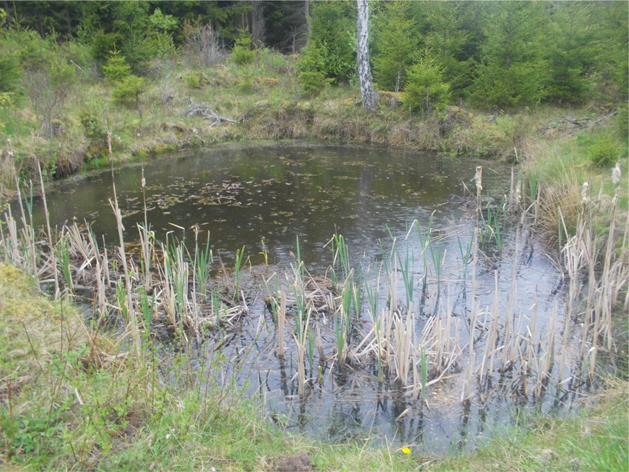
Figure 20-10: This pond within the concession area is home to great crested newt
Old pollarded trees are a distinctive biodiversity feature typical of the project area. There are many such trees, and a large number have been classified as “worthy of protection” (skyddsvärda träd) by the environmental authorities. Many such are located also directly within the project area, particularly around the process plant area.
While it is inevitable that a number of such valuable trees will be lost as a result of the project, it would be advisable to preserve any specimens where possible. The biodiversity value of these trees depends on the individual tree and thus preservation of each one has value. For example a cluster of such trees has been identified at Kaxtorp, close to the pit area but not within it. If care is taken in advance the trees or some of them could probably be preserved. Preservation measures would include identification of the important individuals in the field and reserving a small exclusion zone around them.
Furthermore as compensatory measure the company could well establish a restoration pollarding programme. The practical need for pollarding to produce animal fodder has ceased and thus it is to be
 |  |
| | Prefeasibility Study - NI 43-101 - Technical report for the Norra Kärr Rare
Earth Element Deposit - 0465-RPT-014 Rev 0 |
expected less and less such very old trees will be found in the coming decades and even centuries. The species residing on the bark of the current trees will be stressed for habitat. Establishing a number of young ash trees at a few suitable locations and management of those by pollarding every couple of years would give a good start for a future conservation programme and the cost would be insignificant.
There are no nature reserves, Natura 2000 sites, or other nature protection areas within the project area. However, there are several current and planned protected sites nearby. The area is also included in the East Vättern Scarp Landscape Biosphere reserve of the UNESCO (included in the buffer zone).
Based on current information about project design (i.e. all process equipment to be indoors and make up water pipe to be located in the gap between future Natura 2000 sites) it is expected that impacts caused to these sites are not likely to become obstacles to project development. However, further impact studies and Natura 2000 Appropriate Assessment (minimum of screening assessment but possibly also full assessment) will likely be required for environmental permitting.
Due to the closeness of the Lake Vättern protection zone, there may be limitations on the quantity of chemicals stored at the site. In addition, there may be need for additional safety measures for the case of spills. However, the protection zone does not extend into the project area.
The deposit and the mining concession are located within a National Interest for Nature Value area (Riksintresse naturvärde). The interest conflict between protection of this Nature Value and the interest to exploit the mineral resources was resolved when the mining concession was granted. In this case the exploitation interest was given precedence and the Nature Value interest of this particular designation was deemed secondary. Any other National Interest areas conflicting with the exploitation activities, should there be any, will need to be separately resolved in further decisions. The current project area does not intercept other National Interests for Nature Value.
Current information available about the project geochemistry is partially lacking. Waste rock characterisation is complete. The nephelite/feldspar tailings have been mostly characterised (a one year humidity cell testing is still undergoing). These two streams have been determined not to be problematic and the acid rock drainage potential is low. However, there is no data available for the leached and neutralised tailings and the gypsum from neutralisation. As there is no material available for testing, assumptions have been made concerning these streams and their suitability for disposal.
According to available information, the deposit has background levels of radioactivity. Testing of deportment of radionuclides was conducted by ANSTO Minerals in 2013-2014. While the testing
 |  |
| | Prefeasibility Study - NI 43-101 - Technical report for the Norra Kärr Rare
Earth Element Deposit - 0465-RPT-014 Rev 0 |
focused on product and was undertaken for the purposes of process development, the related memorandum (ANSTO, 2014) states also that the neutralised waste (corresponding to the leached and neutralised tailings) contains only very small amounts of U and Th, and is not radioactive as per the definition of a radioactive substance by the International Atomic Energy Agency.
Mining activities will result in certain noise, dust, vibration and visual impacts in the poject area and around it. On the other hand, the project area is close to the busy main motorway. Thus the difference in relation to existing baseline conditions will be less pronounced than in a more remote location. These impacts should be studied further in the later stages of project development. Dispersion modelling is likely to be required to be undertaken as part of the Environmental Impact Assessment (EIA) for environmental permitting.
A brief study about the mine’s predicted impact on seismic risk in the area has been undertaken by ITASCA Consultants AB (2012).. Vibrations caused by the operation are expected to be so small that they will not have an impact on seismic activity or occurrence of earthquakes (which are naturally very few and of unnoticeably low magnitude in this part of Sweden).
Considering that the dwellings most severely affected will be purchased by Tasman, these impacts are not expected to cause material obstacles to project development.
However, based on the results of the studies to be undertaken later, some mitigation measures may need to be undertaken. Potential mitigation measures could include the construction of a noise protection fence or bunds, visibility screening bunds, etc. These will be determined in environmental permitting.
An archaeology survey has been undertaken for the area of the mining concession. The survey only covers a portion (less than half) of the footprint. A field inventory encompassing the entire project area is likely to be required to be undertaken for environmental permitting. Any other cultural heritage values such as potential values related to existing buildings have not been investigated.
Based on current information, obstacles to project development are not expected. Some detailed inventory work of potential findings may need to be required to be undertaken before construction of facilities may proceed. The need for such measures will be established by the field survey and cannot be determined at this point.
Three of the targets identified in the study already undertaken are listed as requiring further inventory (Phase 2 study) before the target site can be disturbed. One of these targets is within the 20 year pit area and the other two very close to its planned borders.
 |  |
| | Prefeasibility Study - NI 43-101 - Technical report for the Norra Kärr Rare
Earth Element Deposit - 0465-RPT-014 Rev 0 |
The coastal plain of Lake Vättern within the municipality of Jönköping is designated as a Natural Interest Area for protection of cultural environment (Riksintresse för Kulturmiljövård). Due to the steep topography the project site is not expected to be visible to the Natural Interest Area and thus no impact is expected.
The energy demand of the project is significant. The power requirement has been estimated to be 10 MW of electrical power and 12-15 MW of thermal.
Electricity will be available from a range of suppliers, as the electricity markets in Sweden are deregulated. A new high voltage connection to the site will be developed if the project proceeds. Preliminary negotiations with power company Vattenfall have been initiated.
Although the proportion of electricity produced by renewable sources is comparable high in Sweden (48 %), the electricity available in the Swedish national grid represents the residual mix of production sources in the Nordic countries from which certified green energy purchases by users have been subtracted. For 2013 this residual mix has been calculated to contain 9.5 % renewable energy, 34.5 % from nuclear production and 55.5 % from fossil fuel production. However, it is possible to procure “green energy” by purchasing green energy certificates. By this system the electricity user is guaranteed access to electricity from renewable sources such as hydropower or certified wind. Green electricity comes with a premium.
The required heat has been determined to be produced on site by boiler using fuel oil as the base case for PFS design. The total consumption of fuel oil would be over 12 000 m3 a year (1 376.3 l/h) or approximately one fuel truck every day.
A preliminary survey of alternative sources of energy has been undertaken by Golder in connection with the PFS. The following options have been identified:
| · | Purchasing green energy certificates for a premium, to ensure part or all electricity used is produced by renewable sources (bio fuel, wind, solar and/or hydropower); |
| · | Procuring electricity from a local renewable producer, e.g. by acquiring shares of a wind power company situated nearby; |
| · | On-site low enthalpy geothermal energy; |
| · | Geothermal energy is often a very cost effective option in mining areas where there may be boreholes and other suitable infrastructure readily available: |
| o | The granite bedrock in the site area has good geothermal properties. Several of the nearby houses have (household-scale) geothermal wells in utilization; |
| o | Geothermal energy is well suited for heating of buildings and de-icing of roads, portals etc. in the temperature ranges typical of the Nordic environment. Geothermal |
 |  |
| | Prefeasibility Study - NI 43-101 - Technical report for the Norra Kärr Rare
Earth Element Deposit - 0465-RPT-014 Rev 0 |
energy is also suitable for pre-heating in the process plant. However, geothermal energy is not suitable for high-temperature applications such as evaporation;
| · | On-site boiler plant or CHP (combined heat and power) utilizing bio fuel such as wood chips or pellets, straw or biogas: |
| o | On-site bio fuel plant could be used to generate heat for evaporation, all heat demand or heat and some of the electricity (CHP). Equipment for installations from small (< 1 MW) to very large (> 300 MW) is available in the Nordic market; |
| o | Wood-based biofuels are the most widely utilised in Sweden. Wood chips are readily available and there are several suppliers in the area; |
| · | On-site solar production receives investment support from the state (up to 35 % of installation cost); or |
| · | Combination of the above: |
| o | For example a CHP of 20 MW capacity could produce 15 MW of heat and 5 MW of electrical power. Such a CHP plant could use wood chips and peat.; and |
| o | The remaining electrical power needed could be procured from a power company and supported by on-site solar. |
Further study to identify preferable options should be undertaken. The study should take into consideration operability, cost and environmental impact. As solid wood-based fuels are bulky and generate lots of transport requirements, it would be advisable not to make the boiler plan unnecessarily large. An optimal solution could include on-site generation of heat only (bio fuel boiler plant for steam, supplemented by geothermal for lower temperature range needs) with electricity supplied from a power company. However, all options including CHP should be considered in more detail in the further study.
An environmental permit is required:
| · | For boiler plant or CHP unit, if the power output is over 10 MW, when using fuel oil or gas only; |
| · | For boiler plant or CHP unit, if the power output is over 0.5 MW, when using other fuels such as biofuel; |
| · | If power output is over 20 MW (either case) and the plant is permitted separately, the permit application is submitted to the County Administrative Authority CAB, below 20 MW the permitting authority is the municipality environmental department; |
| · | If more than 10 MW of geothermal energy is utilised, the permitting authority is the municipality environmental department; |
| · | In any of the above cases, the environmental permit for the energy installation can be included with the mine’s overall environmental permit application and decided by the Land and Environment Court. |
 |  |
| | Prefeasibility Study - NI 43-101 - Technical report for the Norra Kärr Rare
Earth Element Deposit - 0465-RPT-014 Rev 0 |
| 20.3 | Waste and Tailings Disposal |
A mine waste dump of about 3-4 Mm3 capacity is being planned to be placed between the industrial area and the TSF and related ponds. Geochemical characterisation has been carried out for the waste rock (Golder, 2013).
Based on the characterisation results for the waste rock it is expected that the waste rock will be considered as inert waste and no requirement for containment structures is anticipated. Waste rock is expected to be usable for TSF construction, when available. The seepage water is expected to not be problematic based on current data available on waste rock quality.
Nevertheless, surface runoff at the mine waste dump area is planned to be collected in a ditch and led into a balancing pond, where it will be discharged into the Adelövån stream away from Lake Vättern.
Three types of solid tailings will be produced:
| · | Nepheline / feldspar tailings from magnetic separation; |
| · | Leached neutralised tailings from hydrometallurgy; and |
| · | Gypsum sludge from water treatment. |
In addition to the above streams, the water recycling system produces concentrated sulfate brine that will not report to the TSF.
A preliminary design for the TSF has been prepared for the PFS stage by WAI. The suggested approach is co-disposal of all three tailings streams. Co-disposal is often a good strategy as some contaminants would likely become immobilized by precipitation and sorption reactions, depending on the pH and redox conditions in the TSF. However, the resultant quality of any excess water from the TSF after these potentially stabilizing effects cannot be predicted, because no chemical characterization is available for two of the solid tailings streams (leached neutralised residue and gypsum).
On the other hand, co-disposal of gypsum may present a risk that in time it could start to dissolve, if the equilibrium conditions are not uniformly upheld. Co-disposal can have numerous benefits and help with stabilization of the wastes if it is done properly. However, this requires sufficient information about characteristics of all waste streams as well as other conditions, and careful design.
In practice, also in cases presented in the BAT document for the Extractive Waste Directive (2006/21/EC), co-disposal is in use at many mines across Europe and is reported to be acceptable. This is however only expected to be the case when it can be demonstrated that the streams
 |  |
| | Prefeasibility Study - NI 43-101 - Technical report for the Norra Kärr Rare
Earth Element Deposit - 0465-RPT-014 Rev 0 |
combined for co-disposal will not react or interact in ways that would increase potential negative impacts, or generate new harmful impacts.
Thus co-disposal of streams where one fraction helps stabilize contaminants in another fraction could be good practice, whereas increasing risk of environmental contamination by co-disposal would not be acceptable. More information as to the chemical characteristics of each of the solid tailings streams as well as all water streams intended for the co-disposal will be required before suitability can be established with certainty.
As there is insufficient data available on the chemistry of two of the three tailings streams, it is not certain whether the combined waste stream will be considered to be inert waste. If future testing of the combined stream or some of the components indicated that this material is not inert, the requirements for containment structures both at operational phase (bottom structures and liners) and at closure would be stricter and associated costs considerably higher. Should the waste stream be determined hazardous waste, the requirements and costs would be even higher again.
According to WAI’s preliminary design, a low permeability lining is recommended for the TSF dams, comprising of a single layer (60 mm) of asphalt cement. Wardell Armstrong estimates that the risk of pollution associated with the thickened and combined tailings is low (Wardell Armstrong, 2014). However, the test results are incomplete, the quality of the excess water discharged cannot be predicted, and consequently, its impacts on receiving water courses or ground water quality cannot be fully determined.
Process water is being recycled in a water treatment plant using RO technology. According to information received from process design, the RO plant produces sulfate brine (concentrated solution of salts) and water that is recycled back to the process. The sulfate brine will be evaporated on site to form dry salt residue. The salt residue will be a crystalline solid with less than 15 % moisture. Annually 18 333 t of the salt residue will be generated.
The salt residue is proposed to be transported off-site to an appropriate treatment facility that has environmental permit and suitable processing and/or disposal facilities available to dispose of such material in an environmentally safe way. The related cost has been included in the OPEX calculation.
| 20.3.4 | Other Waste Streams |
| 20.3.4.1 | Non-hazardous waste |
Conventional waste such as waste paper and cardboard, empty packages, trash from offices and personnel quarters, non-hazardous waste from maintenance etc. will be collected and sorted for recycling at the source. A waste management company/companies will collect the waste from the site and deliver it for proper treatment or disposal.
 |  |
| | Prefeasibility Study - NI 43-101 - Technical report for the Norra Kärr Rare
Earth Element Deposit - 0465-RPT-014 Rev 0 |
All hazardous wastes, which mainly consist of chemical waste and empty packages of some process chemicals, will be collected separately. The hazardous waste will be collected from the site by a professional company licensed to treat hazardous waste and delivered to a proper treatment or disposal facility.
| 20.3.4.3 | Sanitary and maintenance waste water |
Sanitary waste water will be collected into a closed tank system and transported off-site by pump-truck into an appropriate treatment facility (municipal waste water treatment plant or similar). There will be no environmental discharge of sanitary waste water from the site, whether purified or not.
Waste water from maintenance activities will similarly be collected into the closed tank system or otherwise managed according to Swedish regulations and practices. Oil traps will be installed in areas where there is a possibility of oil leaks from machinery.
Sanitary and maintenance waste water are not expected to pose a significant risk to soil, groundwater or surface water quality.
| 20.4.1 | BEFORE CONSTRUCTION |
A baseline surface water monitoring programme was performed in 2012 – 2013 by Sweco Environment AB. A few one-off groundwater samples have also been taken.
A regular monitoring programme should be commenced prior to the start of construction to establish a comprehensive baseline.
| 20.4.2 | Construction and operation Stage |
A stringent site monitoring programme will be carried out throughout the construction and operation stages of the mine project development. The monitoring requirements will be set in the environmental permit. It is expected that the monitoring programme will include, but may not be limited to, the following:
| · | Monitoring of operations and maintenance activities; |
| · | Surface water (quality and quantity): |
| o | Adelövån, Gyllingesjön, Stavabäcken, Narbäcken, TSF and other storage ponds; |
| · | Groundwater (quality and quantity): |
| o | from a number of existing drill holes; |
 |  |
| | Prefeasibility Study - NI 43-101 - Technical report for the Norra Kärr Rare
Earth Element Deposit - 0465-RPT-014 Rev 0 |
| o | additionally some new groundwater monitoring boreholes and wells are likely to be required; and |
| o | also monitoring of private wells in the vicinity; |
| · | Biodiversity (great crested newts, other species, bioindicators); |
| · | Vibration and structural effects on nearby houses; and |
| 20.4.3 | Closure and Post-Closure |
The monitoring requirements for the closure and post-closure stage will be outlined in the environmental permit and specified in the final closure plan. It is expected that monitoring will be required to be carried out for a period of time after closure activities have been finalised. Under current legislation the post-closure monitoring requirement is normally 30 years. Post-closure monitoring is expected to focus on monitoring of potential emissions, stability of remediated areas and structures, and quality of surface water and groundwater.
Potential environmental issues related to surface waters (quality and quantity) have been considered in Section 20.2.2. In the design phase, a detailed water management plan should be created based on further information about quality and quantity of various water streams.
This section outlines current water management design. Current process design incorporates a water recycling plant, resulting in a considerable reduction of both make up water intake and the discharge water flow rate.
Currently, the following water treatment and management has been proposed:
| · | Process water recycling: all raffinate water from the process is purified in the process water treatment plant (RO + nanofiltration) and reused in the process. In the current design there is no liquid water stream leaving the process. |
| · | Any storm water that might become contaminated with process liquids or chemicals in the process plant area will be collected into the process water recycling system. However, as all process equipment is to be housed inside buildings, no such contamination potential is expected. |
 |  |
| | Prefeasibility Study - NI 43-101 - Technical report for the Norra Kärr Rare
Earth Element Deposit - 0465-RPT-014 Rev 0 |
| · | Surface water runoff will be collected from all road areas and the industrial area (roof water and yard areas) and discharged towards the stream Adelövån. |
| · | Drainage water from the open mine pit will be diverted towards the stream Adelövån. |
| · | The waste rock dump will be equipped with seepage collecting ditches installed around its perimeter as well as a sedimentation pond and oil filters. Waste rock is also used in dam, road and other infrastructure construction. Surface runoff from the area of the mine waste dump will be collected and discharged towards the Adelövån. |
| · | Excess water from the TSF will be diverted to a sedimentation pond. |
| · | Sanitary waste water will be collected into a closed tank system. |
Consequently, waters discharged to the environment at the site will be:
| · | Excess water from the sedimentation pond (at TSF), discharged at Dam 2; and |
| · | Surface water runoff and pit drainage water, discharged to the direction of Adelövån. Point of discharge to be defined later but likely to be located at or close to Dam 2. |
In general, the impacts on receiving water courses are created via the quality and quantity of the effluents, as well as the sensitivity of the receiver.
| 20.5.2.1 | Waste rock and open pit |
Explosives (ammonium nitrate and fuel oil) produce nitrogen and oil hydrocarbons in the seepage water of the open pit and waste rock.
The waste rock material has been tested for acid formation and leaching potential. Testing is assumed to indicate also the quality of seepage water from the open pit. According to the test results, for the waste rock, acid rock drainage is not expected and metal leaching potential is considered very limited. Testing performed included screening testing, acid base accounting, shake flask and humidity cell testing for 20 weeks.
In general, from an environmental point of view, waste rock is likely to be suitable for construction of dams, roads and other infrastructure.
There is insufficient information about tailings geochemistry. Quality of seepage water cannot be determined. Wardell Armstrong (4) estimated that the risk of pollution associated with the thickened and combined tailings is low, however this assumption needs to be verified in the future when more information is available.
An assessment of the risks to the surface and groundwater environment from the TSF will be undertaken as part of the environmental permitting process.
 |  |
| | Prefeasibility Study - NI 43-101 - Technical report for the Norra Kärr Rare
Earth Element Deposit - 0465-RPT-014 Rev 0 |
| 20.5.3 | Site Wide Water Balance |
PFS-level water balances have been developed for the project. Water balances for the open pit and the TSF were drawn up by WAI and the process water balance by GBM. Golder has developed the Site Wide Water Balance (SWWB) using these components as inputs for pit, TSF and process. The water balances are modelled on a monthly time-step.
Furthermore the SWWB includes runoff from all other areas of the Project area. For the purposes of the PFS it is considered that no water coming into contact with the mining will be discharged towards the Lake Vättern. This applies also to all surface runoff from road areas etc.
| 20.5.3.1 | Meteorological data |
Precipitation records for the SWWB are adopted from the Högemålen Meteorological station, located about 5 km S/SE of the Norra Kärr site or about 3 km S of the southern end of the TSF ponds. A daily record of precipitation (rainfall and equivalent water in snow) was obtained for the period spanning from 1961 to 2014. A concurrent monthly average temperature record was obtained for the Ramsjöholm Meteorological station, also in relatively close proximity to the site for the same period.
In order to allow for the natural lag between snowfall and snow melt, the precipitation record was adjusted based on a snow melt threshold of -2.5 °C (WAI, 2014a). This effectively defers some of the precipitation (as runoff) from the winter months (November - April) to the warmer spring months (May onwards). Table provides summary statistics for the precipitation, temperature and snowmelt adjusted time series.
 |  |
| | Prefeasibility Study - NI 43-101 - Technical report for the Norra Kärr Rare
Earth Element Deposit - 0465-RPT-014 Rev 0 |
Table 20-7: Input Meteorological Data and WAI snowmelt adjustment
| Month | | | Average Monthly
Precipitation1
(mm) | | | | Average Monthly
Temperature2
(°C) | | | | Snowmelt adjusted
Precipitation
(mm) | |
| January | | | 41.9 | | | | -2.2 | | | | 20.6 | |
| February | | | 32.4 | | | | -2.4 | | | | 16.6 | |
| March | | | 32.3 | | | | 0.2 | | | | 35.6 | |
| April | | | 37.6 | | | | 5.5 | | | | 80.4 | |
| May | | | 44.0 | | | | 10.2 | | | | 59.7 | |
| June | | | 66.2 | | | | 13.5 | | | | 66.3 | |
| July | | | 77.9 | | | | 16.1 | | | | 77.9 | |
| August | | | 73.6 | | | | 15.3 | | | | 73.6 | |
| September | | | 61.1 | | | | 11.2 | | | | 61.1 | |
| October | | | 59.5 | | | | 6.4 | | | | 59.5 | |
| November | | | 55.6 | | | | 2.3 | | | | 52.4 | |
| December | | | 49.8 | | | | -1.2 | | | | 28.1 | |
| Annual | | | 632.0 | | | | 6.2 | | | | 631.8 | |
Notes:
1Data from Högemålen Meteorological Station
2 Data from Ramsjöholm Meteorological Station
Based on data given in Table , the percentile annual depths representative of a dry, median, wet and extreme wet year were estimated.
Table 20-8: Percentile Annual Precipitation Depths
| Climate Scenario | | | Annual Precipitation | |
| Dry Scenario (5th Percentile) | | | 483.6 | |
| Median Scenario (50th Percentile) | | | 622.4 | |
| Wet Scenario (95th Percentile) | | | 765.8 | |
| Extreme Wet Scenario (99th Percentile) | | | 864.9 | |
Using the percentage distribution of rainfall across each calendar month for the precipitation and snowmelt time series, these climate scenario annual depths were converted into equivalent monthly averages.
A synthetic 20 year record for each scenario was created by looping the individual climate scenario year 20 times to represent the proposed transient life of mine development. As mining operations are projected to commence in the month of May, month 1 is assumed to be May.
 |  |
| | Prefeasibility Study - NI 43-101 - Technical report for the Norra Kärr Rare
Earth Element Deposit - 0465-RPT-014 Rev 0 |
Evaporation data for the SWWB has been adopted from the potential evaporation data for Jönköping Meteorological station, adjusted for monthly mean temperature and total annual evaporation.
For areas of catchment contributing to the SWWB and not captured elsewhere in the component water balances, a Rational Method calculation has been applied to estimate losses to evaporation, infiltration and soil moisture deficit. The runoff coefficient allows estimation of the volume of incident rainfall which results in runoff. (The Rational Method is described by the equationQ = CiA where Q is estimated runoff, C is runoff coefficient and A is catchment area).
| 20.5.3.2 | Process Water Balance |
The process water balance assumes all raw water intake is supplied from Lake Vättern, the impounded excess water at the tailings facility being geochemically unsuited for use in the process plant. The water requirement for the process was defined under the process developments scope.
There is no outflow of liquid water from the process. Water entrained within the tailings stream is assumed to be captured in the tailings water balance and thus the process balance does not need to be independently represented in the SWWB.
| 20.5.3.3 | Pit Water Balance |
The WAI pit water balance was presented as a series of spreadsheet based pit inflows and pit outflows for each of the four climate scenarios provided by Golder. This water balance is dominated by groundwater inflow.
The extent of the pit area identified in WAI’s pit water balance is 17.9 hectares based on the economic pit extent rather than the total 20 year LOM pit extent of 25.2 hectares on design drawings. Golder has taken the WAI pit water balance as it is and thus runoff from this additional 7.3 hectares of catchment is not included as an additional inflow to the SWWB.
| 20.5.3.4 | TSF Water Balance |
The WAI TSF water balance is presented as a series of spreadsheet based TSF inflows and TSF outflows for each of the four climate scenarios provided by Golder. Wardell Armstrong’s report “Spillway Design - Hydrological Analysis”(20) presents the basis for the sizing of TSF ponds which in turn govern the TSF water balance.
The key constraint imposed in this water balance is in the temporal restriction of discharge to the Adelövån during the summer months. Decant pumping from TSF ponds is considered to be prohibited between May and September, inclusive, so that discharge to the Adelövån will coincide with elevated flows in receiving watercourses during the wetter winter and spring-melt months. Overflow through the spillways is permitted during this period during storm events, with only the extreme wet scenario producing such an overflow event during the summer months.
 |  |
| | Prefeasibility Study - NI 43-101 - Technical report for the Norra Kärr Rare
Earth Element Deposit - 0465-RPT-014 Rev 0 |
While the specific months to which restrictions apply may not reflect the real low flow months in a typical year (as in the site conditions this varies widely between years), this conceptual approach allows representation in the models of discharge thresholds and restrictions which will likely be in place. The thresholds which will likely be applied will result in periodic impoundment of excess water from the site and for PFS level studies the conceptual monthly restriction sufficiently represents this constraint.
The TSF outflow series indicate a large water surplus for this part of the site, representing a large proportion of the natural flow in the Adelövån watercourse.
| 20.5.3.5 | Areas captured in the SWWB |
The following were not captured by the component water balances and have been considered in the SWWB:
Mine Waste Dump: In the absence of a deposition plan the area of the mine waste dump was estimated based on yearly tonnage as estimated by Wardell Armstrong. The maximum area was estimated to be 275 243 m2 in Year 20.
No losses are assumed for the mine waste dump area, all runoff both direct and infiltrated being captured in a toe drainage and under-drainage system. While in reality there will be significant losses due to soil moisture deficit, surface evapotranspiration of remediated areas and direct evaporation/ablation of snow, for conservatism it is assumed that 100 % of these flows are captured and conveyed to the system. This modelling assumption is appropriate for a PFS level study, to be replaced with a more detailed model in later feasibility level studies.
Process plant area: Precipitation to the area of the process plant (runoff from yard areas and roofs) is not included in the process water balance and was thus estimated in the SWWB. The area of the process plant was estimated based on the drawings by GBM . The overall extent of the plant area is assumed to be 8.14 hectares based on currently available plans. This includes buildings, access roads, circulation areas and parking areas within the plant as well as the ROM pad.
All contaminated runoff within the plant area is recycled as part of the plant process. Runoff from roof areas and a proportion of the plant area access roads would in reality be considered to be uncontaminated. However for the purposes of the PFS, all water coming into contact with the mining operation is assumed to be diverted to the Adelövån catchment. Based on interrogation of the supplied design drawings, a nominal 40 % of the plant area is assumed to be diverted to the SWWB, the remainder being assumed to be recycled within the plant area processes or lost to the environment. The diverted runoff is assumed to be discharged from a balancing pond / storage basin towards the Adelövån.
Access and haul roads: Road areas taken from the design drawing files with the following surface area:
 |  |
| | Prefeasibility Study - NI 43-101 - Technical report for the Norra Kärr Rare
Earth Element Deposit - 0465-RPT-014 Rev 0 |
Table 20-9: Haul and Access road areas
| Description | | | Area (m²) | |
| TSF to Mine Waste Dump Haul Road | | | 15 666 | |
| Plant to Mine Waste Dump and Plant to Mine Waste Dump Haul Roads | | | 15 724 | |
| Plant Area to Western Access road | | | 10 702 | |
Two categories of dust suppression water supply are assumed to be required at the site:
| · | Crusher plant dust suppression; and |
| · | Access and haul road dust suppression. |
For the purposes of the PFS level SWWB, it is assumed that both of these dust suppression requirements can be made up from pit dewatering and mine runoff flows.
Crusher plant dust suppression requirements are based on the 1 150 000 tonnes per annum throughput equating to a 131 t/hr crushing rate and a total water demand of 42 m³ per day.
Based on accepted application rates for mine sites in similar climatological regions, a rate of 2 l/m²/hour is used for haul road dust suppression requirements. This is equivalent to 48 mm per day applied to haul road areas, assumed to be applied year round. Dust suppression demand for access roads and other areas of the site is assumed to be zero; as this site is in water surplus.
| 20.5.3.7 | Water balance model |
Figure 20-11 shows how the component water balances have been integrated and identifies the areas of the mine infrastructure solely considered under the SWWB.
The component water balances have been integrated together with additional runoff areas from areas solely considered in the SWWB based on the conceptual model set out in 20.5.3.5. Component water balance outputs are included as “black-box” sub-models, monthly outputs from the TSF and pit models presented as time series.
 |  |
| | Prefeasibility Study - NI 43-101 - Technical report for the Norra Kärr Rare
Earth Element Deposit - 0465-RPT-014 Rev 0 |
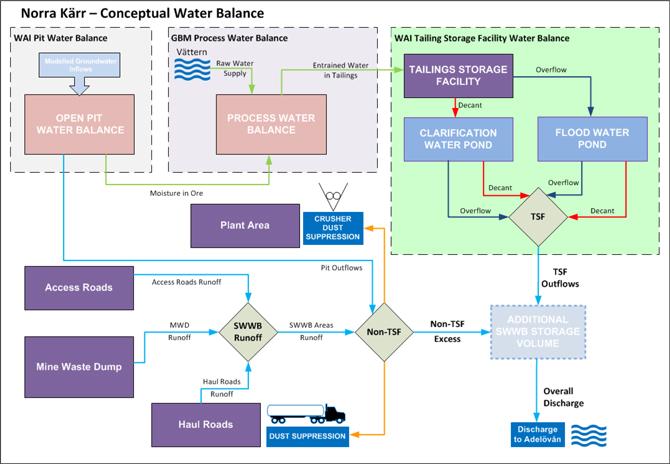
Figure 20-11: Conceptual Water Balance flow diagram
 |  |
| | Prefeasibility Study - NI 43-101 - Technical report for the Norra Kärr Rare
Earth Element Deposit - 0465-RPT-014 Rev 0 |
The SWWB has been implemented in the Goldsim 11.1.1 modelling platform, using a monthly reporting time-step.
In line with the conceptual model set out in 20.5.3.5, it is assumed that non TSF flows are combined in a nominal balancing pond in order to compute the supplementary volume required at the TSF. This balancing pond has not been designed at this stage and will be revisited in future design stages. It is possible that this balancing pond would form an additional volume within the TSF ponds. No evaporative losses or dimensions are assigned to the nominal pond in the model as it is assumed for the purposes of modelling that this volume would be contained within the TSF ponds and thus these losses are already accounted for in the TSF balance.
In order to interrogate the likely additional volume required, a range of allowable average monthly discharge rates from non-TSF sources to the balancing pond/additional storage is assumed: 75 L/s, 100 L/s and 150 L/s. These discharge rates were selected iteratively with a goal of limiting runaway volume generation in the nominal pond. At lower allowable rates of discharge, the required storage volume escalates to impractically high levels.
In additional to this rate limiting, the same temporal restriction as is employed in the TSF model is also applied here: discharge to the Adelövån is restricted to overflows only (i.e. no planned discharges or decant flows) from May to September inclusive.
The model also allows interrogation of flows at intermediate points within the model and the evaluation of the relative importance of each component balance and source of runoff within the overall SWWB.
 |  |
| | Prefeasibility Study - NI 43-101 - Technical report for the Norra Kärr Rare
Earth Element Deposit - 0465-RPT-014 Rev 0 |
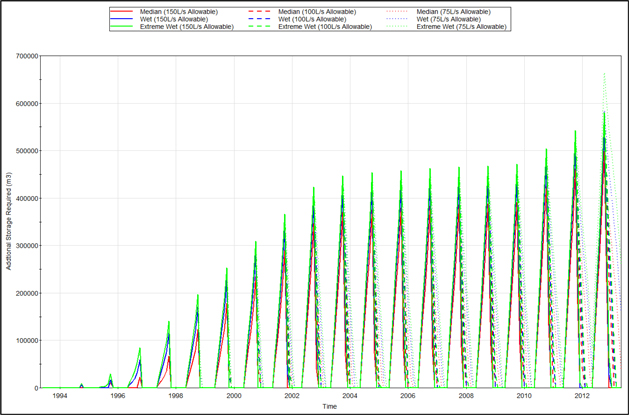
Figure 20-12: Indicated required additional storage volumes (all climatic scenarios)
The PFS level SWWB indicates that an additional volume of up to 650 000 m³ towards the end of the 20 year life of mine would be required to maintain the proposed temporal discharge restrictions; no additional volume is required in the earlier years of operation.
 |  |
| | Prefeasibility Study - NI 43-101 - Technical report for the Norra Kärr Rare
Earth Element Deposit - 0465-RPT-014 Rev 0 |
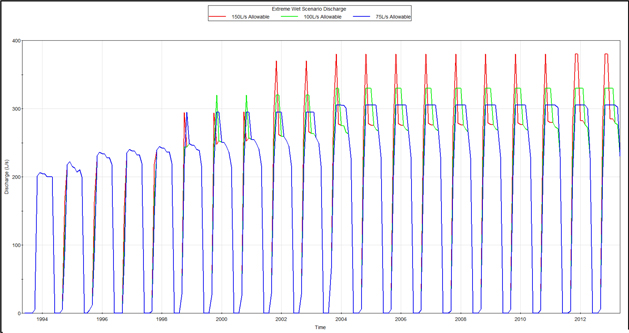
Figure 20-13: Total discharge to Adelövån (Extreme Wet scenario)
Figure 20-13 identifies the overall (total) discharge required when combined with outflows from the TSF model. Clearly the original TSF outflows still dominate the discharge regime with the additional discharge increasing the required rate to a peak of between 305 L/s and 380 L/s average monthly flow.
The SWWB indicates that a range of average allowable monthly additional discharges (between 75 L/s and 150 L/s) will allow excess volume generated from elements of the mine not modelled in the TSF balance to be retained on site. The SWWB indicates that an additional volume of up to 650 000 m³ will be required at the TSF to maintain the proposed temporal discharge restrictions. However, no additional volume is required in the earlier years of operation, minimising the capital cost of provision of this storage.
While this SWWB model predicts additional discharge and storage volume are required from the TSF to the Adelövån watercourse, the likely revisiting of the assumptions regarding disposition of discharge are likely to reduce the requirement for additional storage and discharge. Further to this, inclusion of refined models for mine waste dump, pit water management and TSF are likely to result in reduction in overall water storage requirements albeit the effect of short (daily/sub-daily) spikes in runoff need to be accounted for in the model.
| 20.5.3.9 | SWWB conclusions and Recommendations |
| · | Possibilities to limit the amount of water that will need to be routed towards the Adelövån should be explored. In the current model the operating assumption is discharging all water towards there. |
 |  |
| | Prefeasibility Study - NI 43-101 - Technical report for the Norra Kärr Rare
Earth Element Deposit - 0465-RPT-014 Rev 0 |
| · | The final design of the water management system has yet to be completed. A need for additional water storage capacity for water pumped from the pit has been identified and will be provided in the final design based on further information regarding realistic flow rates on site. The water management plan should include measures to separate potentially contaminated water from clean water to minimise the need for treatment prior to disposal and maximise the potential discharge options such that the impact on the surface water environment will be mitigated. |
| · | Plant water supply is entirely sourced from Vättern and does not vary. In reality it might be possible to use water on site during much of the year for wash-down of trucks, dust suppression, and other non-critical water needs. This is likely to decrease the requirement for pumping from the Vättern and result in lower discharges to receiving watercourses. |
| · | Sub-monthly rainfall and evaporation distribution is not included in the models. The potential evaporative losses and the effect of storm systems should be more accurately represented for feasibility level water balance modelling. |
| · | The additional volume retention requirements should be examined using a combined TSF pond and additional storage approach, rather than modelling as standalone storage. |
| 20.5.4 | Surface Water Runoff |
The quality of surface water runoff and particularly the outflow from the TSF cannot be estimated at this point due to lack of data on the geochemical characteristics of the tailings to be co-disposed in the TSF. In general, all surface water runoff is planned to be diverted to the direction of Adelövån. TSF water will be collected into the TSF ponds system and discharged into the environment in a single discharge point. Pit drainage water and surface runoff will also be diverted into the Adelövån, either at the same discharge point or near it.
The SWWB developed for the project predicts very high flows from the site compared to mean natural flow in the Adelövån stream. An overall discharge of 0.38 m3/s (380 L/s) at maximum is predicted.
Surface water runoff quality, quantity and treatment needs to be considered in the environmental impact assessment and environmental permitting. At this stage, surface water runoff is not considered to pose a major risk considering its expected quality or quantity
| 20.5.5 | Storm Water Management |
Storm water infrastructure will be designed in the later stages of the project development. In the PFS stage it has been determined that all surface water runoff will be collected from all areas of the project area including site roads, and led into a balancing pond from where it will be discharged into the environment with all other site water. The balancing pond and the TSF pond system discharge will be into the stream Adelövån, away from the Lake Vättern.
 |  |
| | Prefeasibility Study - NI 43-101 - Technical report for the Norra Kärr Rare
Earth Element Deposit - 0465-RPT-014 Rev 0 |
In recent years intense rainfall episodes appear to have become more severe, and this trend is expected to continue because of global climate change. Therefore sufficient storm water management infrastructure and auxiliary flood storage volume as well as contingency planning at the TSF to accommodate excess water are highly important.
| 20.5.6 | Effects in Receiving Watercourse Adelövån Stream |
Flow rate data for the Adelövån stream itself is not available. However modelled data is available from the Swedish Water Information System VISS. The modelled data is available for the entire catchment “Mynnar i Noen” which basically is made up of the Adelövån stream. The average flow rate for the catchment is 0.37 m3/s or 1 332 m2/h (2010-2012) and SWWB predicts for mining year 20 the average discharge rate to be nearly 0.2 m3/s (200 L/s), with flows as high as 0.38 m3/s (380 L/s) in the months of highest discharge (depending on the scenario). The highest discharge approximately corresponds to the average flow rate of the receiving stream. However it should be noted that the highest discharge from the TSF will be controlled to correspond with highest natural flow and thus the proportion of the flow originating from the project is not expected to be quite as high at any given time.
Nevertheless the discharge of excess water to Adelövån is expected to be a significant portion of the entire stream flow. This is expected to result in:
| · | Strict requirements for discharge water quality; |
| · | Streamflow effects: the project may change seasonal flow patterns, although controlling the discharge pattern can be used to mitigate such change; and |
| · | Due to a notable increase in the stream flow over the year, it is possible that flood risks along the receiving stream may be aggravated. Flood risk assessment will likely be required. |
| 20.5.7 | Potential Effects in Other Water Bodies |
Currently there are two small watercourses, the streams Narbäcken and Stavabäcken located within the project area. In the current plan the channels are not intercepted, however the catchment areas of the watercourses are modified. All waters are planned to be discharged away from the Vättern catchment, towards Adelövån. The streams Narbäcken and Stavabäcken will need to be preserved. It is expected that in environmental permitting it will be required to demonstrate there is no significant deterioration predicted in water quality or quantity. It must be ensured that sufficient flow will be available in the streams. In addition, management measures will need to be developed to avoid contamination of the water in the streams and to maintain flow rates at or near natural rates.
There is potential for seepage of tailings water to groundwater. The disposal method (subaerial disposal of thickened tailings) should create relatively dense and physically stable, low permeability material retaining quite a lot of the pore water in the tailings. Thus the groundwater table can be lowered due to the decreased infiltration, however this is considered unlikely. On the other hand, input of water in the TSF area can increase the infiltration. If the groundwater flow conditions change, this
 |  |
| | Prefeasibility Study - NI 43-101 - Technical report for the Norra Kärr Rare
Earth Element Deposit - 0465-RPT-014 Rev 0 |
can affect nearby lakes, springs, streams or surface seeps as the surface water bodies at the site are expected to be in continuity with groundwater table.
| 20.6.1 | Applicable Rules and Regulations (Environmental Code) |
Sweden’s environmental law comprises “The Environmental Code” which constitutes a modernised, broad and stringent legislation, aimed at promoting sustainable development. It came into force on 1 January 1999 and replaced fifteen previous environmental acts which were amalgamated into the Code.
The objectives and area of application of the Code are provided in Table 20-10.
Table 20-10: Objectives and area of application of the Environmental Code
The purpose of this Code is to promote sustainable development which will assure a healthy and sound environment for present and future generations. Such development will be based on recognition of the fact that nature is worthy of protection and that our right to modify and exploit nature carries with it a responsibility for wise management of natural resources.
The Environmental Code shall be applied in such a way as to ensure that:
| · | Human health and the environment are protected against damage and detriment, whether caused by pollutants or other impacts; |
| · | Valuable natural and cultural environments are protected and preserved; |
| · | Biological diversity is preserved; |
| · | The use of land, water and the physical environment in general is such as to secure a long term good management in ecological, social, cultural and economic terms; and |
| · | Reuse and recycling, as well as other management of materials, raw materials and energy are encouraged with a view to establishing and maintaining natural cycles. |
| 20.6.1.1 | The Environmental Code (application) |
An application under the Environmental Code (Miljöbalken) (SFS 1998:808) is required in order to conduct mining operations. For an application under the Environmental Code, a more extensive environmental impact assessment is needed compared to the application for the exploitation permit. The following chapters of the Code are the most relevant for the project:
| · | Chapter 2 ”Rules of consideration” states that the best possible techniques are to be used in relation to pollution prevention and control as per the EU Industrial Emissions Directive; |
| · | Chapter 3 regulates areas of national interest which, for example, include commercial fishing, areas for the purposes of nature conservation, conservation of the cultural environment or outdoor recreation, areas for wind farming and mineral deposits considered to be of national importance, and others; |
 |  |
| | Prefeasibility Study - NI 43-101 - Technical report for the Norra Kärr Rare
Earth Element Deposit - 0465-RPT-014 Rev 0 |
| · | Chapter 5 states that environmental quality standards may be issued for Sweden as a whole, for specific regions, or for certain types of region for given periods of time. The purpose of environmental quality standards is to satisfy the national environmental objectives, and to transpose EU quality standards into Swedish legislation; |
| · | Chapter 6 sets out general requirements of Environmental Impact Assessments (Swedish:Miljökonsekvensbeskrivning orMKB). More detailed provisions are provided in the various ordinances including the Ordinance on EIA (Förordning 1998:905 om Miljökonsekvensbeskrivningar); |
| · | Chapter 7 prohibits activities that could significantly affect the environment in protected areas without a license. Such areas are Natura 2000 sites, nature and cultural preserves, shoreline protection. If during the permitting process, the relevant authorities consider that the proposed activity can significantly affect the environment of a Natura 2000 site, they can request a specific Appropriate Assessment of the impacts of the project to the site. Alternatively an Appropriate Assessment can be appended to the permit application by the applicant to begin with; and |
| · | Chapter 11 covers operations in or involving water, including the construction and alteration of structures in water areas, the removal of water from or excavation in water areas, measures for which the purpose is to change the depth or position of the water; diversion and recharging of groundwater and measures undertaken to drain land. The Code stipulates that water operations may only be undertaken if the public and/or private benefits are greater than the associated costs and damage. Water operations must not be prejudicial to other activities which are likely to involve the same water source in the future and which serve important public or private purposes. A permit must usually be obtained for water operations, although permission would be granted for operations that have been examined and permitted elsewhere such as through granting of mining license. (Förordning (1998:1388) om vattenverksamhet m.m.). |
| 20.6.1.2 | Environmental Quality Standards |
Environmental Quality Standards (EQS) are legally binding instruments governed by Chapter 5 of the Swedish Environmental Code. They may be valid for the whole country or a particular geographical area. The main purpose of EQS is to deal with the environmental impact of diffuse pollution sources. Most EQS are based on the requirements of EU Directives. The regional authority County Administrative Board (CAB) is responsible for ensuring that the environmental quality standards are fulfilled in its county through permitting and monitoring.
The current EQS are specified in the Air Quality Regulation (Luftkvalitetsförordningen) (SFS 2010:477), Regulation on Environmental Quality Standards for Fish and Shellfish (Förordning om miljökvalitetsnormer för fisk- och musselvatten)(SFS 201:554), the EU Directive 2008/105/EC on
 |  |
| | Prefeasibility Study - NI 43-101 - Technical report for the Norra Kärr Rare
Earth Element Deposit - 0465-RPT-014 Rev 0 |
Environmental Quality Standards in the Field of Water Policy and Regulation on Environmental Noise (Miljökvalitetsnormer inom vattenpolitikens område and Förordning om omgivningsbuller (SFS 2004:675)). The target concession area is located in the South Baltic (Södra Östersjöns) water district for which EQS are established.
The Air Quality Regulation (SFS 2010:477) specifies EQS for several pollutants. There are threshold standards for particles <10μm/m3 (PM10), particulate matter <2.5μm/m3 (2.5), sulphur dioxide, carbon monoxide, benzene and nitrogen dioxide that will affect the operations of mining.
Within Sweden’s continual work to implement the EU Water Framework Directive, five regional water authorities were formed in order to define quality in terms of EQS for surface water, groundwater and protected areas within each district. The purpose of the standards is to prevent further deterioration of the state of our water and that all water must achieve a certain environmental quality. Information of the current status on water bodies and future goals can be obtained via the Swedish Water Information System (VISS). EQS for surface water quality are specified in Regulation of Fish and Bivalve Waters (2001:554). Chapter 4 of the regulation relates to the provisions applicable to the Swedish Agency for Marine and Water Management (Swedish:Hav och Vattenmyndigheten, HAV). The nearby Lake Vättern is defined as a Fish water (salmon) with EQS for water quality parameters.
The requirements of EU Directive (2008/105/EC) on EQS in the field of water policy, is incorporated into Swedish law by reference to water regulations and through a regulation issued by the Swedish Agency for Marine and Water Management (HVMFS 2013:19). The Directive and the pursuant regulation regulate the 33 priority substances and 8 other pollutants using class boundaries. Class boundaries are used by water authorities for classification and identification of quality requirements for the chemical status of surface water. With the exception of class limits for certain metals (cadmium, lead, mercury and nickel), the planned mining operation only has a limited connection to the substances mentioned in the directive.
| 20.6.1.3 | National and Regional Environmental Objectives |
The Swedish Environmental Code identifies 16 national non-legally binding environmental objectives for achieving an ecologically sustainable development of society which were passed by the Swedish parliament in 1999, and revised most recently in 2012. These objectives are to be met within one generation, i.e. by 2020 (2050 in the case of the climate objective).
The CAB (Swedish:Länsstyrelsen) in Jönköping is the competent environmental authority for the project. The CAB has the responsibility for adapting 15 of the 16 national environmental objectives identified in the Code to its county with the exception of Objective 12, Sustainable Forests, for which the Swedish Forest Agency (Swedish:Skogsstyrelsen) is responsible. The CAB in Jönköping approved regional environmental objectives and interim targets for Jönköping County in 2013.
 |  |
| | Prefeasibility Study - NI 43-101 - Technical report for the Norra Kärr Rare
Earth Element Deposit - 0465-RPT-014 Rev 0 |
In the EIA that will be required to be undertaken, the Applicant has to address how it contributes to the environmental objectives. All 16 might not be relevant for the Norra Kärr project, though for example No 1. Reduced climate impact, No 3. Natural acidification only, No 4. A non-toxic environment and No 9. Good quality groundwater, could have touching points with the project.
The business sector, in cooperation with other stakeholders, has a substantial role in achieving the environmental quality objectives. Today, many companies in Sweden are engaged in structured environmental work that has a major bearing on the environment.
| 20.6.1.4 | European Union legislation |
The Code also contains provisions concerning the consequences of the Treaty on European Union and other instruments and of the decisions of the European Communities.
The following EU Directives are applicable to the project. The Directives have been transposed into the Swedish Environmental Code as described above:
| · | Directive 79/409/EEC of 2 April 1979 on the conservation of wild birds, as last amended by Directive 2009/147/EC (the Birds Directive); |
| · | Directive 92/43/EEC of 21 May 1992 on the conservation of natural habitats and of wild fauna and flora, as last amended by EC Directive 2013/17/EU (the Habitats Directive); |
| · | Directive 2000/60/EC of 23 October 2000 establishing a framework for Community action in the field of water policy as amended by Decision 2455/2001/EC and Directives 2008/32/EC, 2008/105/EC and 2009/31/EC; |
| · | Directive 2003/35/EC of 26 May 2003 providing for public participation in respect of the drawing up of certain plans and programmes relating to the environment with regard to public participation and access to justice (incorporating requirements of Aarhus Convention); |
| · | The Seveso III Directive2012/18/EU entered into force on 13 August 2012 replacing Directive 2003/105/EC of 16 December 2003 amending Council Directive 96/82/EC on the control of major-accident hazards involving dangerous substances (Seveso II Directive); |
| · | Directive 2006/21/EC on the management of waste from extractive industries and amending Directive 2004/35/EC (Mining Waste Directive); |
| · | Directive 2010/75/EU on industrial emissions (integrated pollution prevention and control); and |
| · | The Environmental Impact Assessment (EIA) Directive (2014/52/EU) which is newly amended and entered into force on 15 May 2014 to simplify the rules for assessing the potential effects of projects on the environment. |
A number of the Directives incorporate international treaties into EU legislation, notably the Espoo Convention and Aarhus Convention.
 |  |
| | Prefeasibility Study - NI 43-101 - Technical report for the Norra Kärr Rare
Earth Element Deposit - 0465-RPT-014 Rev 0 |
The key piece of EU legislation with respect to water management is the Water Framework Directive (WFD) 2000/60/EC and two 'daughter’ directives, one aimed at protecting groundwater (2006/118/EC, adopted December 2006), the second (2008/105/EC, adopted December 2008) aimed at reducing pollution of surface water (rivers, lakes, estuaries and coastal waters) by pollutants on a list of priority substances. The Habitats Directive, together with the Birds Directive, establishes the Natura 2000 network of conservation sites as well as procedures related to the sites and protected species and habitats.
| 20.6.2 | Swedish Mine Permitting Process |
Rights to mineral deposits (exploration and exploitation) are governed under the Minerals Act (1991:45). The Mining Inspectorate of Sweden (Bergsstaten) is the agency responsible for decisions concerning permits for exploration and mining. In addition to the rights, the mining company needs permits under environmental legislation to open a mine. Permits for mining activities are issued by Land and Environmental courts. There are five such courts in Sweden that service different parts of the country and one Supreme Court, the Land and Environmental Court of Appeal. The permits needed to open a mine in Sweden are described in Figure 20-14.

Figure 20-14: Swedish mining permitting process. Permits needed to open a mine in Sweden
| 20.6.2.1 | Permitting process |
When permitting mining activities the rules of the Environmental Code (Miljöbalken (1998:808)) are applied. The Rules of Consideration in Chapter 2 of the Environmental Code are applied when deciding mitigation measures, restraints and other conditions applicable to the specific project.
The only differences compared to sectors other than mining is that land use issues according to Chapter 3 and 4 in the Environmental Code are not tried again in so far as the issues have been decided as part of the exploitation concession. However, facilities outside the concession area have to be considered regarding land use matters in the permitting process by the Land and Environmental Court. In respect of the Norra Kärr project this land use consideration applies to all facilities and
 |  |
| | Prefeasibility Study - NI 43-101 - Technical report for the Norra Kärr Rare
Earth Element Deposit - 0465-RPT-014 Rev 0 |
activities outside the 2014 exploitation concession (i.e. the process plant area, TSF, mine waste dump and related areas).
The steps of the permitting process are described in
Figure 20-15.
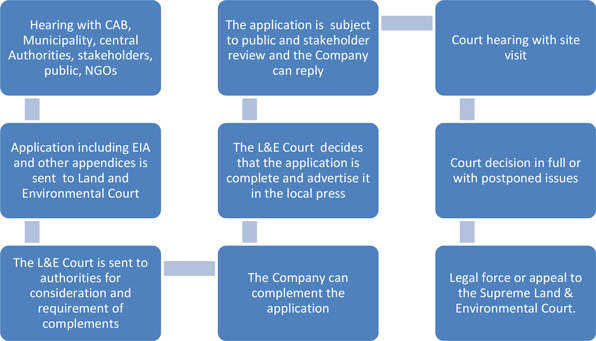
Figure 20-15: Permitting process according to Environmental Code
The steps in the Swedish mine permit process are governed by three pieces of legislation as described below: The Minerals Act, the Environmental Code and the Planning and Building Act.
| 20.6.3 | The Minerals Act (1991:45) |
The Minerals Act is applicable to the exploration and exploitation stages of mine development. The project proponent must gain first an exploration permit and later an exploitation concession that grants certain rights to the potential mineral deposit. In addition to the proceedings under the Minerals Act, the Environmental Code also needs to be followed.
An exploration permit is granted for a specific area, where there is some likelihood of a successful discovery being made, and does not require any specific environmental or social assessments. Tasman has the required exploration permits in force.
| 20.6.3.1 | Exploitation concession |
An exploitation concession is granted by the Mining Inspectorate if a mineral deposit has been found which can probably be exploited economically and the location and nature of the deposit does not
 |  |
| | Prefeasibility Study - NI 43-101 - Technical report for the Norra Kärr Rare
Earth Element Deposit - 0465-RPT-014 Rev 0 |
make it inappropriate that the applicant is granted a concession. The exploitation concession grants the right to exploit the mineral deposit to the concession holder.
In terms of environmental issues the exploitation concession application (ECA) must include an EIA (MKB) compliant with the Environmental Code, which is reviewed by CAB. The EIA reflects the project design at this early stage, and is developed in more detail at the environmental permitting phase. Tasman holds an exploitation concession for the area immediately surrounding the Norra Kärr deposit, granted in January 2014.
| 20.6.3.2 | Designation of land |
For exploitation and activities connected therewith that are undertaken at the surface, however, the concession holder may only make use of land that has been designated for that purpose. Land or other space outside the concession area may, as determined in the designation of land, be utilized for purposes other than exploration or exploitation.
Applications for designation of land shall be considered in a land designation proceeding in accordance with Minerals Act. The Chief Mining Inspector may permit land or other space to be utilized pending determination of the question of land designation. Such permission may only be granted if the concession holder furnishes security for compensation.
It is recommended to apply for designation of all land needed, even if the company plans to acquire the land necessary for the project. The reason for this is to avoid additional applications for different areas if some landowners refuse to sell the land. Specific impacts on landowners are expected to be compensated through individual negotiations in accordance with Swedish practices.
| 20.6.4 | The Environmental Code (1998:808) |
| 20.6.4.1 | EIA and public hearing |
The procedure and requirements for environmental impact assessments, plans and planning documents should follow Chapter 6, of the Swedish Environmental Code. The applicant is obliged to consult the CAB or the local Environmental and Public Health Committee before submitting an application for a permit and a public hearing is often held. This gives the authorities (including the Swedish Environmental Protection Agency SEPA) an opportunity to comment on the application. Swedish SEPA is consulted in the licensing procedure as an expert and should provide guidance (e.g. on BAT) to the permitting authorities. The SEPA is also active in some licensing cases, for example when legal principles are at stake or if the activity concerned could lead to major environmental impact.
 |  |
| | Prefeasibility Study - NI 43-101 - Technical report for the Norra Kärr Rare
Earth Element Deposit - 0465-RPT-014 Rev 0 |
| 20.6.4.2 | Environmental impact assessment |
The environmental impact assessment (EIA) must be submitted together with the permit application. A more comprehensive EIA has to be carried out compared to the EIA already made for the concession application. The purpose of the EIA is to describe the direct and indirect impact of the planned activity. The EIA must include a site description of the facilities or activities as well as descriptions of the technology that will be used. Different alternatives for both these aspects are compulsory. A localization study for the TSF, considering a wide array of alternatives, has been undertaken in 2014. This study satisfies the requirement to identify potential alternatives for TFS location, and as such is directly usable in permitting. Alternative locations for above ground facilities such as process plant and waste rock dump have to be considered in the EIA.
The EIA must also describe the impact on people, animals, plants, land, water, air, climate, landscape and the cultural environment. Furthermore, it should describe impacts on the management of land, water and the physical environment in general, as well as on the management of materials, raw materials and energy.
A developer must address social and economic issues under the Environmental Code. However, there are no specific requirements for a dedicated Social Impact Assessment (SIA) (Swedish:Social konsekvens-beskrivning). A competent authority when reviewing the EIA may request a SIA, whereas the Land and Environmental Court can require a developer to perform a dedicated SIA.
In the environmental permit process the Appropriate Assessment of Natura 2000 may need to be prepared and applied for.
The application must also include a demonstration that the applicant has the right to water (groundwater or surface water) that the applicant wants to use. Such rights are in place if the applicant owns the land or water body. If this is not the case, a written agreement (right of usage) with the subject property owners has to be presented as part of the application.
When it comes to land designation according to the Minerals Act, this is not necessary prior to submitting an application according to the Environmental Code. Land designation matters are dealt with after the decision from the Land and Environmental Court has been made.
The Mine Waste Regulation (SFS 2013:319) which transposes the EU Mining Waste Directive into Swedish legislation requires the developer to submit a preliminary closure plan for projects involving disposal of mining waste. The preliminary closure plan must describe how the operations will be closed and the disturbed areas remediated to fulfil the closure guidelines. Provisions for a bond should be set off. The bond must cover the costs for reclamation in the event that the developer, for any reason, is unable to fulfil its obligations. The bond is settled in the Land and Environmental Court and may comprise an initial amount to be paid when commencing the activities and a yearly sum to
 |  |
| | Prefeasibility Study - NI 43-101 - Technical report for the Norra Kärr Rare
Earth Element Deposit - 0465-RPT-014 Rev 0 |
be paid depending on the additional area affected per year during the life of the operations. A conceptual closure plan is being developed as part the PFS. This conceptual plan will need to be further supplemented to satisfy the requirements for permitting.
The Land and Environmental Court will review the application for completeness and then split the document to various Technical Advisory Committees (TACs). The TAC for the overall EIA is the CAB and in effect ultimately approves the EIA. CAB and the various TACs (HAV – Water management and fisheries;Skogsstyrelsen – forestry;Trafikverket – roads & transport; MSB – The Swedish Civil Contingencies Agency, emergency response and rescue, etc.) provide comments on the EIA to the Land and Environmental Court.
Should a permit be issued it is generally with conditions based on the comments received from the TACs. In Sweden Emission Limit Values are set for each individual project in the permit. These are based on BAT at the time the permit is granted and taking into account the local conditions.
| 20.6.5 | Planning and Building Act (Plan- och bygglagen (2010:900)) |
Once the Land and Environmental Court has granted permission to begin operations, a construction permit is required by the local municipality. A construction permit normally takes between four and eight weeks to process and covers buildings and other facilities that need to be constructed in connection with the mining project.
However, granting a construction permit is only possible if the municipality's Master and Detailed Plans (land use plans) have designated the land required for the project as being suitable for such activities.
A Detailed Plan is required if the planned building and activities connected to it may have a significant impact on the surroundings, such as landscape or traffic. This is normally considered to be the case for the industrial areas related to mines in Sweden. The land use is considered in the planning process to decide if the purpose is appropriate for the location.
Generally the municipality will prepare a Detailed Plan for industrial areas and will usually also carry the related costs; however, this can also be a cost for the developer if the plan is not considered to be of public interest. The developer has to ask the municipality to initiate detailed planning and at that point it will also be decided what costs it will entail for the company.
For this project it’s particularly important to note that the project area is situated within three municipalities. Therefore the building permits as well as the land use plans will need to be processed with several municipalities. Building permits and Detailed Plans will be required at minimum for the industrial area (process plant location) in Jönköping and the acid loading station in Tranås.
 |  |
| | Prefeasibility Study - NI 43-101 - Technical report for the Norra Kärr Rare
Earth Element Deposit - 0465-RPT-014 Rev 0 |
Currently there are no Detailed Plans in force in the project area and there are no related area regulations. Norra Kärr is included in Jönköping’s Municipal Overview Plan 2002 (Översiktsplan 2002Jönköpings Kommun), sub-area 8: Gränna-Visingsö. The project area is not reserved for any specific purpose in the Overview Plan. However, the area around the deposit, as well as the area to south and west, are listed as an area of important nature value, and the deposit area itself also as area of importance for mineral exploitation .The plan is being reviewed with a new Municipal Overview Plan expected in 2015.
Some authorities (including Swedish Environmental Protection Agency SEPA) can appeal against a permit decision. The right to appeal also includes the applicant, local trade union associations, people affected by the decision, and non-profit associations focused on promoting nature conservation or environmental protection interests.
The Land and Environmental Court decision can be appealed in the Supreme Land and Environmental Court.
The application, consideration and eventual granting of an environmental permit can often take several years in Sweden. According to a study commissioned by the Confederation of Swedish Enterprise (Svenskt Näringsliv) in 2012 (Ramböll Management Consulting, 2012), mining is the industry that takes most time for permitting. According to the study, the mean throughput time for the permitting process was about four years on average, from start of pre-studies to permit. When possible appeals (if any) were taken into consideration, the average time was five years in total.
According to the study, the average throughput times were as follows:
| · | Pre-studies (information gathering and preparation for public hearing) 1.5 years; |
| · | Public hearing (consultation) phase 0.5 years; |
| · | Preparation of permit application including EIA 1 year; |
| · | Consideration at the Land and Environmental Court 1 year; |
| · | Average time from start-up to having the permit 4 years; |
| · | When taking into account potential appeals, should there be any, the average throughput time was 5 years. |
It should be noted that the timeframe described here is an average for many projects and varies a lot. In the case of the Norra Kärr project, many preparatory studies have already been undertaken.
A Detailed Plan will usually take up to two years to process Some of this time is often parallel with the time for environmental permitting.
 |  |
| | Prefeasibility Study - NI 43-101 - Technical report for the Norra Kärr Rare
Earth Element Deposit - 0465-RPT-014 Rev 0 |
| 20.6.8 | Summary of Permitting Requirements |
A summary of permits required under Swedish law is described in Table 20-11. The Chief Mining Inspector handles permits for The Minerals Act and is applicable to the exploration and exploitation stages of mine development. Licensing authorities according to the Environmental Code are Land and Environmental Courts, Land and Environmental Court of Appeal, and the County Administrative Boards. The Environmental Courts handle activities with large environmental impact. For some minor environmentally hazardous activities, licensing is carried out at local level.
 |  |
| | Prefeasibility Study - NI 43-101 - Technical report for the Norra Kärr Rare
Earth Element Deposit - 0465-RPT-014 Rev 0 |
Table 20-11: Required permits
| Law or regulation | | Permit | | Authority | | Status |
| The Minerals Act (1991:45) | | Exploration permit Exploitation concession Designated Land decision | | The Chief Mining Inspector (Bergsstaten) | | Granted before 2014 Granted January 2014 Designated land application needed if necessary land cannot be acquired |
| | | | | | | |
| The Environmental Code (1998:808) | | Environmental permit for mining and storage of acid as well as other fuels, chemicals and explosives, chapter 9 Environmental permit for water use, chapter 11 Natura 2000, chapter 7 | | Land and Environmental Court (Mark- och Miljödomstolen) | | Application needed |
| The Species Protection Ordinance (2007:845) | | Exemption from the prohibitions, for all protected species affected | | County Administrative Board, CAB | | Application needed, can be included in application to Land and Environmental Court, see above |
| | | | | | | |
| Flammable and explosive goods Act (2010:1011) | | Safety Authorisation for Storage and handling of fuels, chemicals and explosives | | Local Fire and Rescue service | | Application needed |
| | | | | | | |
| Planning and Building Act (2010:900) | | Construction permit | | Local Municipality, building committee | | Applications needed Detailed Plan for the industrial area will be needed for buildings by the municipalities |
| | | | | | | |
| Electricity law (1997:857) | | Power Line concession | | Swedish Energy Markets Inspectorate | | The grid operator will apply |
A summary of the activities and the rules and regulations according to the Environmental Code (Miljöbalken) (SFS 1998:808) that apply are provided in Table 20-12. An application under the Environmental Code (Miljöbalken) (SFS 1998:808) is required in order to conduct mining operations. An extensive environmental impact assessment should be included in the application under the Environmental Code.
 |  |
| | Prefeasibility Study - NI 43-101 - Technical report for the Norra Kärr Rare
Earth Element Deposit - 0465-RPT-014 Rev 0 |
Table 20-12: Activities Subject to the Permitting Process of Environmental Code
| Activity | | Environmental
Code Chapter | | Laws and regulations |
| Mining operations on site, process facilities | | Chapter 6, 9 | | Environmental permitting (Miljöprövningsförordning (2013:251)) Chapter 4 §11 mining, §12 processing Environmental impact assessment (Förordning (1998:905) om miljökonsekvensbeskrivningar). |
| | | | | |
| Handling of mining waste | | Chapter 9, 11 | | Ordinance on exploitation waste (Förordning (2013:319) om utvinningsavfall) |
| | | | | |
| Handling, storage and transportation of Sulphuric acid | | Chapter 9 | | Environmental permitting (Miljöprövningsförordning (2013:251)) 20 kap 1§ 2. > 5000 ton on each occasion or > 50 000 ton per year < 5000 ton, required to notify local authority Transport of Dangerous Goods Act (SFS 2006:263) and the Transport of Dangerous Goods Ordinance (SFS 2006:311) |
| | | | | |
| Handling and storage of chemicals, explosives and fuel as well as storage and transportation of waste and wastewater treatment | | Chapter 9 | | Environmental permitting (Miljöprövningsförordning (2013:251)) Chemicals and fuels 20 kap 1§ 2. > 5000 ton on each occasion or > 50 000 ton per year 23 kap 2§ if >1000 fuel, required to notify local authority Chapter 28 waste water treatment, not process Chapter 29 storing of waste, not mining unless inert then §34, 2. Ordinance on waste handling Avfallsförordning (2011:927) |
| | | | | |
| Handling and storage of fuels and explosives, transportation of dangerous goods | | Chapter 9 | | Flammable and explosive goods Act (Lag (2010:1011) om brandfarliga och explosiva varor) Handling of flammable and explosive goods Ordinance (Förordning (2010:1075) om brandfarliga och explosiva varor) Transport of Dangerous Goods Act (SFS 2006:263) and the Transport of Dangerous Goods Ordinance (SFS 2006:311) |
| | | | | |
Land use Areas of national interest, Natura 2000, shoreline protection, cultural heritage | | Chapter 3,4,7 | | The Species Protection Ordinance (2007:845) incorporates EU directive (2009/147/EC) on conservation of Wild birds and Natural habitats and of Wild fauna and flora directive (92/43/EEC), Natura 2000 Cultural Heritage Management Act (Kulturmiljölagen (1988:950) ) |
| | | | | |
Drainage of groundwater from the open pit Water supply withdraw from Lake Vättern Discharge to the recipient Channel works and dredging of the Adelövån (recipient stream) | | Chapter 11 | | Ordinance on water activities (Förordning (1998:1388) om vattenverksamhet m.m.) |
 |  |
| | Prefeasibility Study - NI 43-101 - Technical report for the Norra Kärr Rare
Earth Element Deposit - 0465-RPT-014 Rev 0 |
| Activity | | Environmental
Code Chapter | | Laws and regulations |
| Roads and pipelines off site | | Chapter 12 | | The Species Protection Ordinance (2007:845) incorporates EU directive (2009/147/EC) on conservation of Wild birds and Natural habitats and of Wild fauna and flora directive (92/43/EEC), Natura 2000 |
| 20.7 | Social and Community Requirements |
The Norra Kärr project is to be located within a populated area and will thus bring both benefits and concerns to the communities nearby. Benefits are particularly related to employment opportunities created directly and indirectly as a result of the project. Potential negative effects mostly affect the nearby area within and near the project area. Environmental impacts that affect or may affect the nearby residents are discussed earlier in this section under environmental impacts. Social impacts will also result from the fact that some residents of houses within and around the project area will need to move. The mining company will purchase the houses or otherwise compensate the owners for the loss as per Swedish practice.
Furthermore, Tasman has been interacting with various stakeholders concerning the project. There has been a degree of public concern over the project, centred around the potential effects on the Lake Vättern. Stakeholder issues are discussed in Section 20.7.3.
There are no indigenous issues related to the project and while the indigenous Sami people do have areas in northern Sweden, the project is located not within Samiland either by currently designated area nor historical use.
The potential employment effects of the mine have been studied in 2012 by Tyréns AB (Tyréns, 2012). This study is the source for this section.
The study estimates about 2 000 full time new jobs could be created directly and indirectly as a result of the mining project, of these 75 % would be related to the investment phase and 25 % to the operating phase. The availability of a suitable workforce is estimated to be generally good. Although mining is currently not a big industry in the area, there may be some lack of employees with mining-specific skills locally. This is estimated to mean that at least some migration of professionals from other areas (mostly within Sweden) is expected. At the time of writing their study, Tyréns anticipated that there is fierce competition for the best mining professionals due to the ongoing mining boom in Sweden. However, since 2012 this situation has changed somewhat and the availability of mining professionals is likely to have increased.
 |  |
| | Prefeasibility Study - NI 43-101 - Technical report for the Norra Kärr Rare
Earth Element Deposit - 0465-RPT-014 Rev 0 |
A majority of the employees are expected to be residents of the three nearby municipalities of Jönköping, Ödeshög and Tranås. Inhabitants of each municipality who are employed pay municipality tax, which forms the basis of the municipal economy. Thus it would be locally important to ensure a significant proportion of the workforce lives in the area.
However, Tyréns points out that this is dependent on the housing market. In 2012 the housing prices particularly in the town of Gränna had spiked and Tyréns mentions concern over a lack of reasonably-priced housing available for the potential influx of workers to the Norra Kärr mine. Nevertheless it is expected that the staff and employees will be living in the nearby towns and villages of Gränna, Jönköping, Tranås, Ödeshög and possibly even Linköping so no accommodation is needed near the site.
The project location is central in Sweden (particularly in comparison with the more traditional mining areas mostly located in the north) and the area, particularly Gränna town and Jönköping municipality are attractive areas that would make it easier for potential employees moving into the area to come with their families, particularly in the operational phase of the mine.
The tax revenue and dynamic economic effects created by such employees, who with their families, settle in the area in a permanent fashion is greater than that of workers who only come to the area to work and go home to their families somewhere else, as is the case in many mining areas around the world. As Tyréns points out, the local municipalities hold the key to attracting the employees to settle permanently. The municipalities should in cooperation with the local businesses ensure suitable housing and private and public services (such as retail and day care) are available and of an attractive quality to potential movers.
Furthermore, Tyréns estimates it is possible that opening the Norra Kärr mine may lead to a development of an industrial cluster focusing around REEs and their utilisation. Any numerical estimates of economic or employment effects of such a development are however impossible to arrive to at this early stage.
There are several houses within the project area and its immediate vicinity. A total of seven houses (including year-round dwellings and summer houses) are located inside the project’s footprint, in the area of the TSF and the related ponds or in the industrial area. Furthermore a number are located so close that significant impacts are expected to be caused.
Tasman intends to purchase the houses where the impacts such as noise are assessed to be severe, unless the owner wishes to stay. A reasonable buffer zone will be established based on the environmental impacts, which will be determined in the later design stages of the project. In the case where the owner does not wish to sell the property, a land designation can be acquired from the
 |  |
| | Prefeasibility Study - NI 43-101 - Technical report for the Norra Kärr Rare
Earth Element Deposit - 0465-RPT-014 Rev 0 |
Mining Inspector granting access to required land. In such a case the owner will be compensated for any damages caused. Swedish practice on property acquisition and compensation will be followed.
In the PFS stage the impacts have not been assessed in sufficient detail to determine with certainty which houses exactly will be impacted by the project. For the purposes of the PFS economic calculations, an allocation for the land acquisition costs based on experience from other Swedish mines has been included.
Tasman has arranged meetings with the landowners and initial discussions related to acquisition of certain key areas have been initiated.
| 20.7.3.1 | Stakeholder engagement and communications |
Tasman is involved in an extensive stakeholder engagement process. Stakeholder meetings have been arranged in the form of public meetings as well as meetings with various stakeholder groups such as landowners, local organisations, and local, regional and national decision-makers. Overall, dozens of meetings have been conducted over the course of the project’s preliminary development phase.
Tasman has endeavoured to distribute information about the project to both local and national stakeholders. Locally, newsletters have been distributed to households in the project area. The newsletters have provided project information as well as interviews of experts in the field of mining concentrating on key themes related to the project. The company also has an internet site where project information is provided.
As a part of the permitting process for the exploitation concession, a public hearing process for the concession EIA was undertaken in 2012.
| 20.7.3.2 | Local opinions about the project |
Tasman has commissioned survey company Nu! (Nordiska Undersökningsgruppen AB) to undertake a survey of local opinions by telephone interviews in October 2013. Responses were gathered from two respondent groups: 763local residents (living in municipalities Jönköping, Ödeshög and Tranås), as well as 38close neighbours (living within 2-3 km of the exploitation concession area) were collected.
The overall attitude towards the project of thelocal residents varied widely with 17 % being positive or very positive, 28 % negative or very negative and 27 % neither. A further 28 % responded “I don’t know”.
Theclose neighbours were, perhaps unsurprisingly, more negativewith no positive responses, 64 % negative or very negative, 24 % neither negative nor positive and 12 % “I don’t know”. The attitude
 |  |
| | Prefeasibility Study - NI 43-101 - Technical report for the Norra Kärr Rare Earth Element Deposit - 0465-RPT-014 Rev 0 |
towards mining in Sweden in general was positive with 84 % oflocal residents and 72 % ofclose neighbours agreeing that Sweden should have mines.
The greatest concerns were related to Lake Vättern, 55 % (residents) and 80 % (close neighbours) think that Vättern will be negatively affected by the mining activity. A clear majority (57 %) ofresidentsand all of theclose neighbours also believe the mine would negatively affect living conditions for those living close to it. When asked to estimate how far from an operating mine its impacts would be noticeable, the most common estimate was 5-10 km (given by 19 % ofclose neighbours and 20 % ofresidents), however about half of both respondent groups responded they don’t know.
More recently, two more surveys have been undertaken. In both of these surveys the respondents have been markedly more positive. This is probably at least partially due to the fact that the Nu! study particularly sought opinions of people living near the site whereas the respondents in the other surveys are from a wider area.
In September 2014 slightly over 500 people were interviewed on the phone by survey company Skop upon assignment by one of the Swedish political parties, Christian Democrats (Kristdemokraterna).The survey was reported on 5 September 2014 by the local newspaper Jönköpings-Posten on their internet site (Jönköpings-Posten, 2014).
All respondents were inhabitants of the municipality of Jönköping. The survey had one question: “If mining can be undertaken in an environmentally safe way, are you in that case positive or negative towards a mine in Norra Kärr outside of Gränna?” (“Om brytningen kan ske på ett miljömässigt säkert sätt, är du då positiv eller negativ till en gruva i Norra Kärr utanför Gränna?”).A clear majority of the responses were positive as shown in Table 20-13.
 |  |
| | Prefeasibility Study - NI 43-101 - Technical report for the Norra Kärr Rare Earth Element Deposit - 0465-RPT-014 Rev 0 |
Table 20-13: Responses, September 2014 telephone survey (Skop / Kristdemokraterna)
Responses, September 2014 telephone survey (Skop / Kristdemokraterna)
504 inhabitants of Jönköping municipality
If mining can be undertaken in an environmentally safe way, are you in that case positive or negative towards a mine in Norra Kärr outside of Gränna?
| Very positive | | | 10% | |
| Quite positive | | | 48% | |
| Quite negative | | | 21% | |
| Very negative | | | 19% | |
| No answer | | | 2% | |
http://www.jonkopingsposten.se/artikel/31011/jonkopingsborna-vill-ha-gruva-i-norra-karr
In August 2014 the P4 Jönköping, the local channel of the Sveriges Radio, the public broadcasting company in Sweden, undertook a web panel study of 500 respondents in the community of Jönköping and the County of Jönköpings län (Sveriges Radio, 2014). The survey was carried out by Novus Group International AB and the responses can be seen in Table 20-14.
Table 20-14: Responses, August 2014 web panel survey (Novus / P4 radio)
Responses, August 2014 web panel survey (Novus / P4 radio)
Total of 500 inhabitants of Jönköping municipality and County of Jönköping
| Response | | Municipality of Jönköping | | | County of Jönköping | |
| Positive, independent of environmental impact | | 8% | | | 5% | |
| Positive, if there is no (negative) impact on environment | | 56% | | | 55% | |
| Neither | | 11% | | | 13% | |
| Negative, independent of environmental impact | | 16% | | | 15% | |
| Don’t know | | 9% | | | 12% | |
http://sverigesradio.se/sida/artikel.aspx?programid=91&artikel=5939917
| 20.7.3.3 | Concern and local opposition |
Certain stakeholders are concerned about the project. Much of the concern is centred on perceived threats to Lake Vättern. The concerned parties include both local residents and national activists, who are part of an emerging anti-mining movement in Sweden. The activists have organized some demonstrations in the local area. However it is not expected that the demonstrations would escalate into destructive rioting or violence.
According to information provided by Tasman concerning meetings and negotiations with local, regional and national level decision makers, there is less opposition towards the project among decision makers. This is estimated partially to be due to better access to project related information.
 |  |
| | Prefeasibility Study - NI 43-101 - Technical report for the Norra Kärr Rare Earth Element Deposit - 0465-RPT-014 Rev 0 |
At the national level, the granting of the exploitation concession demonstrates that the project has the support of the state of Sweden.
| 20.7.3.4 | Project in the news |
In the local press the project has generated much interest. Golder has briefly reviewed a sample of approximately 80 news articles from 2013 to 2014. Most of the articles were published in the internet sitesof the local newspapers such as Jönköpings-Posten (www.jonkopingsposten.se), Tranås Tidning (www.tranastidning.se), Östergöta Correspondenten (www.corren.se) but some also on other sources. A majority of the articles focused on environmental impact and/or the concerned stakeholders. The protest campaigns by activists, such as the demonstration on site during summer 2014, were covered in the news. As 2014 was an election year in Sweden this resulted in a number of articles briefly mentioning the mine as one of the local issues listed by a candidate.
Many of the articles appear to be slanted towards the view held by the activists and in many articles the activists state their claims with no commentary from either Tasman or any other party. This has unfortunately led to spreading of some incorrect information related to, for example, the likely magnitude of impacts on Lake Vättern. On the other hand news positive to the project such as the granting of the exploitation concession and the positive results of surveys were also published. Some articles also described the employment opportunities.
A conceptual-level closure plan has been developed for the project by Golder. The plan is preliminary and conceptual in nature based on available information at the time of writing. The plan will need to be refined further for environmental permitting. Requirements related to closure planning will be set in the environmental permit. Prior to closure an updated closure plan has to be approved by the authorities, normally at least one year prior to closure. The preliminary plan must be reviewed regularly (usually a minimum of once every three years) and modified where necessary to reflect changes in operations.
The conceptual closure plan and consequently the closure approach briefly described below are based on the assumption that the co-disposed tailings in the TSF will be considered inert waste.
| 20.8.1 | Closure Design Criteria |
The preliminary closure plan is based on general closure principles. The suggested purpose is that the solutions shall be presumed as “walk away solutions” and after completing reclamation the area should comply with the legislative demands and not pose a potential detrimental threat to the surroundings.
 |  |
| | Prefeasibility Study - NI 43-101 - Technical report for the Norra Kärr Rare Earth Element Deposit - 0465-RPT-014 Rev 0 |
However, part of the remedial design may encompass a possibility to re-open the mine in the future, if unmined mineralised zones should become economic after closure. It is therefore paramount that the open pit mine void should not be back-filled.
In the further stages of project development the closure targets and site specific closure design criteria are to be defined further. Potential post-closure land uses should be developed, where appropriate in cooperation with relevant stakeholders. The subsequent versions of the closure plan should reflect these targets and land uses.
A number of preliminary guiding closure principles have been worked out and are listed below:
| · | There will be no significant, physical off-site impacts. |
| · | Baseline surface water quality in recipients will be maintained (unless directly physically affected). |
| · | The established vegetative cover within the site area shall be self-sustaining and with time show progression towards the surrounding undisturbed vegetation in terms of species diversity and plant density. |
| · | The post-mining landforms will be stable and respond to erosive forces in a similar manner to equivalent landforms occurring naturally within the area (e.g. slopes, undulating hills). |
| · | No unsafe areas will remain where the public or wildlife can gain access either inadvertently or without exceptional effort. Fences will be used to prevent this access to unsafe areas. |
| · | Pit voids will be left and allowed to refill with seepage and rain water. Where necessary the slopes will be re-graded. |
| · | Final landform designs will be re-graded and landscapes to be similar to the existing regional landforms, within the constraints imposed by the physical nature of the materials and the additional cost necessary. |
As a required part of the closure plan a monitoring programme will be in place for a number of years after completed remediation to ensure that the closure complies with legislative demands (often up to 30 years).
| 20.8.2 | Planned Remediation Measures |
The open pit void (120 m depth) will be allowed to form a pit lake by ceasing pumping of water. Above the ground recharge surface level, slopes will be re-graded to 1V:3H by blasting and haulage. These slopes will be covered with topsoil and/or till to stabilize the pit slopes. A minimum of 0.3 m thickness shall be used, and where necessary, hydro-seeded to provide erosion control and slope stabilization. In addition, a 2 m high perimeter fence will be installed to reduce the incidence of wild animals and humans falling into the void.
 |  |
| | Prefeasibility Study - NI 43-101 - Technical report for the Norra Kärr Rare Earth Element Deposit - 0465-RPT-014 Rev 0 |
The mine waste dump is considered as inert waste with an option to quarry the material in the future. Because of this, the cover design will be minimal with the objective to aesthetically remediate the area, stabilize to prevent erosion, and landscape the deposit into the surrounding natural environment. The mine waste dump will be re-graded to an overall slope angle of 1V:3H. A 0.5 m till layer sourced from the overburden from the open pit mine will be applied and hydro-seeded with grass to stabilize the slopes. A storm water management system consisting of a ditch located to the east of the deposit with riprap (waste rock) will be constructed to prevent erosion and collect surface water runoff.
The TSF will be allowed to drain naturally.Pond 1 will be incorporated into the TSF during operation and if present, clarification pond sludge from Ponds 2-3 may be relocated into the TSF after operation, but before the remediation commences. Pond 1 will not be dismantled and will form the south-leading edge of the remedial design.
The TSF will be covered using a single layer dry protective cover consisting of till/topsoil cover applied to a depth of 0.3 m. Grass will be hydro-seeded, and in addition, small shrubs and trees will be planted (100 per hectare).
Ponds 2-3 related to the TSF will be drained. The dam embankments (2-5) will be breached. The clarification sludge if present is considered to be inert and will remain or alternatively be relocated into the TSF. The pre-existing soil horizons will be hydro-seeded with grass to enable erosion control, stabilization, and landscaping.
| 20.8.2.5 | INDUSTRIAL AREA, INFRASTRUCTURE AND ROADS |
An environmental due diligence audit will be carried out before any remediation is conducted. All equipment in the industrial buildings will be removed and sold where possible. All above ground structures will be knocked down and removed. The remaining land surface and peripheral industrial land will be remediated where directed by the environmental due diligence findings. Where applicable, contaminated soil will be remediated in-situ or removed. A thin layer of 0.2 m topsoil/till cover will be applied where pre-existing soil is thin. Where necessary, the land will be hydro-seeded with grass, re-graded, and landscaped into the natural surroundings.
Roads/car parks will be dismantled by cracking concrete and bulldozer removal of bitumen coatings. Gravel and earthen roads will be flattened. No protective cover or vegetation will be applied.
 |  |
| | Prefeasibility Study - NI 43-101 - Technical report for the Norra Kärr Rare Earth Element Deposit - 0465-RPT-014 Rev 0 |
Potential issues related to closure and post-closure may include
| · | Requirement for containment: The current conceptual closure plan is based on the assumption that the co-disposed tailings are considered to be inert waste. If, based on further testing, this turns out to not be the case, it is possible that further requirements for containment structures in the covering layers of the TSF will be set. |
| · | Post-closure land use(s): In the later stages of project design or potentially during operations, post-closure land uses should be developed, where appropriate in cooperation with relevant stakeholders. The closure plan will need to be modified to reflect these land uses and refined closure targets. |
| · | Potential for progressive closure: If possible, in terms of environmental impact it would be recommended to undertake progressive closure. Potential for this approach will be determined later based on more advanced design. |
| · | Dam safety post closure: Both the dam design and the closure approach must be designed to ensure no risk of dam failure post-closure.. It should also be noted that using a geomembrane in the construction of water-retaining dams, is not a structure that will last indefinitely (4). |
| · | Pit water / mine lake: The pit is located within the Vättern catchment and after it fills up to become a mine lake the water will eventually find its way to Vättern. Based on current knowledge of waste rock geochemistry, the pit water quality post closure is not expected to be problematic and no water treatment need is foreseen. However, as water issues and Lake Vättern are the key concerns, it is likely that the activists will take this issue up as a cause for concern. |
According to information received from Wardell Armstrong, borrow pits are expected to be created within the TSF footprint. According to current information no other borrow pits are expected to be required.
Topsoil management is currently not determined. Topsoil is needed for the eventual rehabilitation of the various facilities. It is currently unknown whether it would be possible to store original topsoil, or if not, where replacement topsoil for closure and rehabilitation can be obtained.
| 20.9 | Health and Safety Issues |
Tasman is committed to being an environmentally and socially responsible corporate citizen in how it conducts its exploration and development activities. Therefore the Tasman Safety and Environmental Policy shall be fully followed on the Norra Kärr project.
 |  |
| | Prefeasibility Study - NI 43-101 - Technical report for the Norra Kärr Rare Earth Element Deposit - 0465-RPT-014 Rev 0 |
Golder gathered information related to how health and safety has been taken into consideration in the PFS-level design from the designers involved with the various technical scopes (Mining, Process, Engineering, Tailings) with a questionnaire that covered following topics:
| · | Consideration of health and safety in design; |
| · | Requirements and regulations; |
| · | Identification of most relevant risks; and |
| · | Most significant risks identified. |
In addition to the questionnaire, key documents and plans were reviewed to identify potential concerns.
Based on the responses received from the design teams and the document review, health and safety is being taken into consideration in the design at a level commensurate with the preliminary nature of this study and the design stage of the project. Golder has not undertaken any health and safety design review or second opinion of any part of the design.
Considerable amounts of various chemicals are to be used in the processing, most notably solvent, oxalic acid and sulfuric acid, as well as very large amounts of diesel and fuel oil, which will be used and stored on site. Safe use and storage of all chemicals, including secondary containment of storage vessels, is vitally important for safety of both the environment and humans. All chemicals will be managed in accordance with Swedish legislation and current good practice.
The most relevant regulations at the current stage of this project (PFS), issued by the Swedish Work Environmental Authority are listed in Table 20-15.
Table 20-15: Most Relevant Swedish H&S Regulations
H&S regulations (Swedish Work Environmental Authority)
| · | AFS 2010:01 Rock works and mining |
| · | AFS 1999:03 Construction work |
| · | AFS 2011:19 Chemical safety risks |
| · | AFS 2011:18 Occupational exposure limits |
| · | AFS 2001:03 Use of personal protective equipment. |
PFS –stage risk identifications have showed that “Pit-scale Fault” (in the south-east of the proposed open pit) and “Fly rock onto highway” are the most significant health and safety risks that should be taken into deeper consideration in further design stages. Based on the designers’ answers, health and safety risks are considered to the extent which is adequate compared to current project, PFS, stage.
 |  |
| | Prefeasibility Study - NI 43-101 - Technical report for the Norra Kärr Rare Earth Element Deposit - 0465-RPT-014 Rev 0 |
However, prior to the start-up phase major health and safety risks that may disturb the continuity of production should be evaluated. Therefore a major risk assessment that is focused on fatal incidents and severe chemical spills that could affect Tasman personnel, contractor personnel or third parties should be carried out. Adequate risk elimination or reduction measures shall be taken into account at all product related (e.g. site plan, process and process equipment, chemical transportation and storing) planning.
Relevant health and safety measures must be at an adequate level compared to current facilities, activities and personnel on site. Risks include issues such as working with machinery, chemical safety and explosives. It is assumed all activities related to health and safety risks will be carried out compliant with Swedish legislation and international mine safety standards (e.g. IFC Environmental, Health and Safety Guidelines). To ensure this it is strongly recommended that a HSE professional is recruited prior to on start-up stage. All documents, procedures and measures should be updated and the need of supportive health and safety personnel should be evaluated in accordance with increasing activities on site.
 |  |
| | Prefeasibility Study - NI 43-101 - Technical report for the Norra Kärr Rare Earth Element Deposit - 0465-RPT-014 Rev 0 |
Section 21 Capital and Operating Costs
All capital and operating expenditure for the Norra Kärr project has been estimated by GBM, WAI and Golder. The capital estimate effective date is the report effective date. The currency used in the compilation of the estimate has been stated in United States dollars (USD)
| 21.1 | Capital Cost Estimates |
Initial and sustaining capital costs have been estimated and an explanation given for each major area of the site. The overall level of accuracy of the estimate is within the ±25 % range appropriate for a Pre-Feasibility study.
| · | Mechanical equipment costs |
| · | Process plant piping, platework, earthworks, civil, structural, control and instrumentation, electrical, installation and freight forwarding |
| · | Provision of utilities during construction, including water, fuel and electricity |
| · | Mine Operations infrastructure including workshops, fuel and lubricant facility, vehicle wash, administration and amenities |
| · | Process plant associated infrastructure; mill control room, laboratory, security, emergency services, mess hall, change rooms, car park and required storage for reagents and spare parts |
| · | Mobile equipment for the operation |
| · | Acid supply; Train unloading facility and additional rail infrastructure required. |
| · | EPCM cost for the delivery of the plant and infrastructure as per the battery limits. |
| · | All roads required at site; including haul roads, entrance/exit of E4 to site. |
| · | Rehabilitation and Closure. |
| · | Environmental Impact Assessment (Newt management) |
The following assumptions have been made during the preparation of this estimate:
| · | New equipment is used for the operation; |
| · | Equipment costs are based on GBM selected suppliers that may not be the finalequipment supplier for the project; |
| · | The construction is as detailed in the PFS; |
 |  |
| | Prefeasibility Study - NI 43-101 - Technical report for the Norra Kärr Rare Earth Element Deposit - 0465-RPT-014 Rev 0 |
| · | Costing is based on the current design; and |
| · | It is expected that the design will be refined but not altered significantly. |
No allowance has been made for:
| · | Container demurrage costs; |
| · | Any transportation or storage required of oxides after treatment at the La Rochelle facility; |
| · | Required permits, licences or legal and administrative costs associated with government mining and environmental regulations. This includes reporting requirements during operation and related administrative costs; |
| · | Transmission lines and main substations to connect the project to the national electricity grid; |
| · | Monitoring during operation and post closure; |
The total capital investment for the Norra Kärr project is USD 378.3 million. The contingency reported is for the process package only and was based on accessing each minor area of the process. The mining and waste management costs have accounted for contingency within the total, as supplied by sub-consultants.
 |  |
| | Prefeasibility Study - NI 43-101 - Technical report for the Norra Kärr Rare Earth Element Deposit - 0465-RPT-014 Rev 0 |
The total capital to be spent over the life of mine for the Norra Kärr project is reported in Table 21-1, the total expenditure shown accounts for sustaining capital planned to be spent over the 20 years of operation.
Table 21-1 Total capital cost estimate
| Total Capital Investment | | | 423 039 268 | |
| FIXED CAPITAL TOTAL | | | 397 726 462 | |
| DIRECT TOTAL | | | 266 524 303 | |
| General | | | 7 563 513 | |
| Mining | | | 26 899 872 | |
| Process | | | 169 467 528 | |
| Waste Management | | | 44 500 000 | |
| Product Handling | | | - | |
| Infrastructure and Utilities | | | 18 093 388 | |
| INDIRECT TOTAL | | | 131 202 159 | |
| EPCM | | | 36 165 294 | |
| Field Indirect | | | 54 853 204 | |
| Contingency | | | 40 183 660 | |
| WORKING CAPITAL TOTAL | | | 25 312 805 | |
The processing plant has been designed for the duration of the expected operating life and as such sustaining capital requirements shall be limited to the following items:
| · | The TSF has been designed such that the initial investment will be sufficient for the first two years of operations. Further expansions required at years 2 and 10 of operation. |
| · | The mining fleet and infrastructure has been designed such that 50 % of the initial investment will be replaced/overhauled in year 10 of operation. |
| · | Infrastructure, in areas where infrastructure is subjected to heavy traffic, such as roads and stockpiles, refurbishment and patchwork may have to be supplemented with the complete replacement of the asset, or part thereof. |
| 21.1.5 | Mining Capital Cost Estimates |
Capital cost estimates have been made from vendor quotes for major mining equipment where available at the time of writing. Quotes have been received for hydraulic excavators and haul trucks, a quote for the drilling rig has been scaled accordingly. Other capital costs have been referenced from Western Mine Cost Service, 2014 (36)
 |  |
| | Prefeasibility Study - NI 43-101 - Technical report for the Norra Kärr Rare Earth Element Deposit - 0465-RPT-014 Rev 0 |
LOM capital costs are shown in Table 21-2. The initial capital cost estimate is USD 16.1 million, of which USD 4.0 million is capitalised waste removal. An additional USD 5.0 million in sustaining capital will be required. Total LOM capital will therefore be USD 16.1 million.
Table 21-2: Mining CAPEX Summary
| Total | | | 21 107 000* | |
| Pre-Production | | | 16 101 000 | |
| Pre-strip | | | 4 012 000 | |
| Equipment | | | 10 775 000 | |
| First Fill | | | 215 000 | |
| Initial Spares | | | 539 000 | |
| ROM Pad | | | 80 000 | |
| Haul Road | | | 480 000 | |
| Post Production | | | 5 005 000 | |
| Equipment | | | 4 938 000 | |
| Additional Items | | | 2 685 000 | |
| Replacement items | | | - | |
| Overhaul | | | 2 253 000 | |
| Pumping | | | 67 000 | |
Note: 5.8 M USD for mine related infrastructure (buildings and fuel storage) not reported as outside of mining consultant scope, this has been captured in Process capital.
Mining will be performed using an owner operated fleet, therefore the bulk of the costs for mining CAPEX is in pre-production fleet purchase. Equipment has been estimated at USD 10.9 million being capitalised operating costs of pre-stripping, haul road development, and ROM pad clearing. Sustaining CAPEX consists of additional equipment purchase where scheduling requires and maintain overhauls at critical machine hours.
It is noted that replacement items are not required, due to low annual working hours of 1 687 hours. At the end of the 20 year production schedule the majority of machines are still within their operating life.
Sustaining overhaul costs have been estimated based on a major overhaul of 50 % of the capital cost, at the halfway point of the scheduled machine life. Overhaul costs would typically include major transmission components and major wear parts (tracks, tubs, etc).
| 21.1.6 | process plant & related infrastructure |
The costs for the process plant and related infrastructure are summarised in Table 21-3. To ensure the correct level of accuracy was achieved for the estimate, 79 % of mechanical equipment was
 |  |
| | Prefeasibility Study - NI 43-101 - Technical report for the Norra Kärr Rare Earth Element Deposit - 0465-RPT-014 Rev 0 |
based on budget quotes with the remaining 21 % calculated from first principles and factored estimates.
The direct capital costs include:
| · | All labour required for project construction and management activities (excluding EPCM cost); |
| · | All material and equipment required for construction; |
| · | Mechanical, electrical, control, instrumentation, civil works, earthworks and piping installation services; |
| · | Transport and freighting services; |
| · | Insurance and capital spares; and |
| · | Construction and installation |
Table 21-3 Process Capital estimate summary
| Total Capital Investment | | | 316 644 344 | |
| FIXED CAPITAL TOTAL | | | 291 331 539 | |
| DIRECT TOTAL | | | 200 918 303 | |
| Earthwork | | | 695 000 | |
| Civil | | | 45 223 125 | |
| Structural | | | 27 533 060 | |
| Mechanical | | | 103 213 844 | |
| Mobile Equipment | | | 734 947 | |
| Electrical | | | 8 084 424 | |
| Control and Instrumentation | | | 3 674 738 | |
| Piping | | | 5 144 633 | |
| Platework | | | 6 614 529 | |
| INDIRECT TOTAL | | | 90 413 236 | |
| EPCM | | | 36 165 294 | |
| Field Indirect | | | 14 064 281 | |
| Contingency | | | 40 183 660 | |
| WORKING CAPITAL TOTAL | | | 25 312 805 | |
| Cash Reserve | | | 25 312 805 | |
 |  |
| | Prefeasibility Study - NI 43-101 - Technical report for the Norra Kärr Rare Earth Element Deposit - 0465-RPT-014 Rev 0 |
| 21.1.7 | Tailings Storage Facility |
The capital costs for construction of the TSF and following expansions are summarised in Table 21-4. The quantities have been taken from engineering design drawings and rates prepared to suit the construction operations.
Table 21-4: TSF Budget Cost Summary
| Stage | | 1 | | 2 | | 3 | | Total |
| Construction | | Year 0 | | Year 1-2 | | Year 9-10 | | |
| Operation | | Year 1 – 2 | | Year 2 – 10 | | Year 10 – 20 | | 20 years |
| Construction cost (USD) | | 14 300 000 | | 11 200 000 | | 19 000 000 | | 44 500 000 |
 |  |
| | Prefeasibility Study - NI 43-101 - Technical report for the Norra Kärr Rare Earth Element Deposit - 0465-RPT-014 Rev 0 |
| 21.2 | Operating Cost Estimates |
The total operating costs for the Norra Kärr project is represented in Table 21-5. The operating costs are to the point of off-site treatment and refining.
Table 21-5 Operating Summary
| Area | | | | Total Cost per
annum | | | USD/t ROM
Ave | | | USD/kg
REO Ave | | | % | |
| 000 GENERAL | | General and Admin | | | 5,079,832.07 | | | | 4.53 | | | | 1.04 | | | | 5.04 | |
| | | | | | - | | | | - | | | | - | | | | 0.0 | |
| 100 Mining | | Ore mining cost | | | 3,849,852.58 | | | | 3.43 | | | | 0.79 | | | | 3.82 | |
| 100 Mining | | Waste mining cost | | | 2,724,248.43 | | | | 2.43 | | | | 0.56 | | | | 2.7 | |
| 100 Mining | | Overhead mining cost | | | - | | | | - | | | | - | | | | 0.0 | |
| 100 Mining | | | | | - | | | | - | | | | - | | | | 0.0 | |
| | | | | | | | | | | | | | | | | | | |
| 200 PROCESSING | | Maintenance & Operating Spares | | | 6,233,849.12 | | | | 5.55 | | | | 1.28 | | | | 6.18 | |
| 200 PROCESSING | | Consumable - Grinding media and liners | | | 1,660,921.74 | | | | 1.48 | | | | 0.34 | | | | 1.65 | |
| 200 PROCESSING | | Labour | | | 8,347,749.52 | | | | 7.44 | | | | 1.71 | | | | 8.28 | |
| 200 PROCESSING | | Reagents | | | 35,699,032.18 | | | | 31.81 | | | | 7.32 | | | | 35.39 | |
| 200 PROCESSING | | Utilities - Disel | | | 6,427,982.83 | | | | 5.73 | | | | 1.32 | | | | 6.37 | |
| 200 PROCESSING | | Consumable – Electricity | | | 6,449,553.24 | | | | 5.75 | | | | 1.32 | | | | 6.39 | |
| 280WATER TREATMENT | | Water treatment | | | 21,311,567.24 | | | | 18.99 | | | | 4.37 | | | | 21.13 | |
| | | | | | | | | | | | | | | | | | | |
| 300 WASTE MANAGEMENT | | Waste Management | | | 3,084,568.94 | | | | 2.75 | | | | 0.63 | | | | 3.06 | |
| Grand Total | | | | | 100,870,000 | | | | 89.97 | | | | 20.69 | | | | 100 | |
The total operating costs are visually demonstrated in Figure 21-1. The annual expenditure on reagents accounts for 50 % of total expenditure. Due to the importance and impact that the costing of reagents has on the overall financials, budget quotations were received the key reagents shown in Figure 21-2, sulphuric acid, magnesium oxide, lime, calcium chloride and solvent.
 |  |
| | Prefeasibility Study - NI 43-101 - Technical report for the Norra Kärr Rare Earth Element Deposit - 0465-RPT-014 Rev 0 |
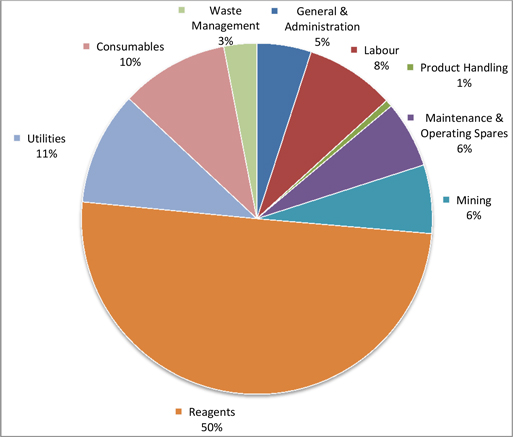
Figure 21-1 Total project operating costs breakdown
 |  |
| | Prefeasibility Study - NI 43-101 - Technical report for the Norra Kärr Rare Earth Element Deposit - 0465-RPT-014 Rev 0 |
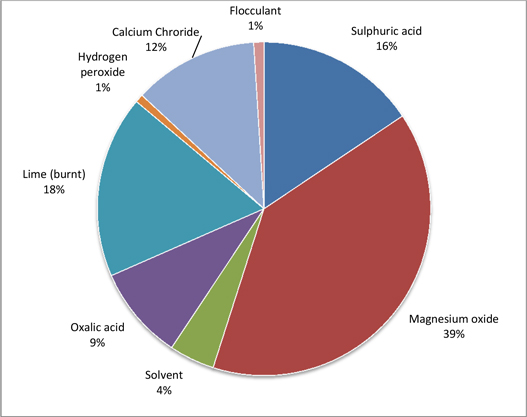
Figure 21-2 Reagent cost breakdown
| 21.2.1 | Mining Operating Cost Estimate |
Operating costs are based on mine design criteria and engineering, they have been derived from first principles and based on data from Western Mine Cost Service, 2014 (36). Mining operating cost will average 3.41 USD/t mined rock (5.90 USD/t mined ore). The breakdown of the mining OPEX is shown Table 21-6.
 |  |
| | Prefeasibility Study - NI 43-101 - Technical report for the Norra Kärr Rare Earth Element Deposit - 0465-RPT-014 Rev 0 |
Table 21-6: Mining Operating Costs
| Cost Centre | | USD/t – Rock Mined | | | LOM | |
| Drilling | | 0.56 | | | 22 898 000 | |
| Blasting | | 0.81 | | | 32 961 000 | |
| Grading | | 0.00 | | | 199 000 | |
| Loading & Stockpiling | | 0.44 | | | 17 988 000 | |
| Hauling | | 0.60 | | | 24 676 000 | |
| Engineering/Geology | | 0.42 | | | 17 108 000 | |
| General Mine Maintenance | | 0.36 | | | 14 601 000 | |
| Supervision | | 0.24 | | | 9 643 000 | |
| Pumping | | 0.56 | | | 0 | |
| Total | | 3.43 | | | 140 074 000 | |
The majority of costs are associated with drill and blasting, some 40 % of the OPEX cost. Other major contributors to the mining OPEX are loading and hauling, of which the primary cost will be diesel fuel for the equipment and labour costs.
| 21.2.2 | process Operating Cost Estimate |
The operating costs for the Norra Kärr process plant were based on annual tonnages treated and a LOM of 20 years. The operational cost estimates include the following:
| · | Reagents, costs include delivery to Norra Kärr process plant; |
| · | Consumables, grinding media, liners; |
| · | Maintenance and operating spares; |
| · | Utilities, power and diesel; |
| · | Labour, refer to Table 21-7 for the various rates; and |
| · | General and administration |
 |  |
| | Prefeasibility Study - NI 43-101 - Technical report for the Norra Kärr Rare Earth Element Deposit - 0465-RPT-014 Rev 0 |
Table 21-7: Bill of Rates – Labour
| Position | | Grade | | Monthly
Salary (SEK) | | | Basic Salary
(SEK/a) | | | Process
Allowance
(SEK/a) | | | Mining
Allowance
(SEK/a) | | | Fringe
Benefits
Allowance | | | Total Salary
(SEK) | | | Total Salary
(USD) | |
| General Manager | | A | | 70 000.00 | | | 840 000.00 | | | | | | | | | 1.5 | | | 1 260 000.00 | | | 191 158.18 | |
| Senior Management / Chief Superintendent | | B | | 40 000.00 | | | 480 000.00 | | | | | | | | | 1.5 | | | 720 000.00 | | | 109 233.24 | |
| Supervisors - Process plant | | C | | 35 000.00 | | | 420 000.00 | | | 96 000.00 | | | | | | 1.5 | | | 726 000.00 | | | 110 143.52 | |
| Supervisors - Mine | | D | | 35 000.00 | | | 420 000.00 | | | | | | 50 400.00 | | | 1.5 | | | 680 400.00 | | | 103 225.41 | |
| Engineers | | E | | 30 000.00 | | | 360 000.00 | | | | | | | | | 1.5 | | | 540 000.00 | | | 81 924.93 | |
| Process Operators / Technicians / Officers | | F | | 24 918.00 | | | 299 016.00 | | | 96 000.00 | | | | | | 1.5 | | | 544 524.00 | | | 82 611.28 | |
| Driver / Mine Operator | | G | | 24 918.00 | | | 299 016.00 | | | | | | 50 400.00 | | | 1.5 | | | 498 924.00 | | | 75 693.18 | |
| Artisan / Mechanic / Electrician | | H | | 22 071.00 | | | 264 852.00 | | | 96 000.00 | | | | | | 1.5 | | | 493 278.00 | | | 74 836.61 | |
| Clerical / Labour / Assistants - Day Shift | | I | | 22 071.00 | | | 264 852.00 | | | | | | | | | 1.5 | | | 397 278.00 | | | 60 272.17 | |
 |  |
| | Prefeasibility Study - NI 43-101 - Technical report for the Norra Kärr Rare Earth Element Deposit - 0465-RPT-014 Rev 0 |
| Section 22 | Economic Analysis |
A discounted cash flow model has been prepared by GBM and was based on the mine production schedule, capital and operational cost estimates for the mine, processing plant, and associated infrastructure as determined by all consultants involved.
The key economic inputs used are detailed in Table 22-1.
Table 22-1 Key input parameters
| Item | | Value | | Unit | | Notes |
| Depreciation Method | | Straight line | | - | | |
| Depreciation – Buildings | | 5 | | % | | |
| Depreciation – Plant equipment | | 10 | | % | | |
| Depreciation – Mobile Equipment | | 20 | | % | | |
| Salvage Value | | 0 | | USD | | |
| Royalty | | 0.2 | | % | | Royalty based on in situ oxide value rather than recoverable oxides |
| Treatment & Refining | | 19 | | USD/kg REO concentrate | | |
| Base discount rate | | 10 | | % | | |
The economic analysis will allow for a two year construction period, and which point the plant will be fully commissioned and handed to operations. The DCF also accounts for a ramp up period for the process plant throughput, the mining schedule at this stage of development account for full production however stockpiling and deferring of feed will occur and extend life of project.
The process plant has been scheduled to reach full production by Year 4, this has been reflected in the DCF model. This is a conservative approach and has a direct impact on the annual cashflows, however due to current industry knowledge and information available GBM and Tasman believe this to be required.
The plant ramp up has been based on Figure 22-1, series 3, with reference to paper; Plant Ramp-up profiles, an update with emphasis on process development, Terry McNulty. The series 3 graph reflects the years 1-3 operation of 60 %, 75 % and 85 % respectively.
 |  |
| | Prefeasibility Study - NI 43-101 - Technical report for the Norra Kärr Rare Earth Element Deposit - 0465-RPT-014 Rev 0 |
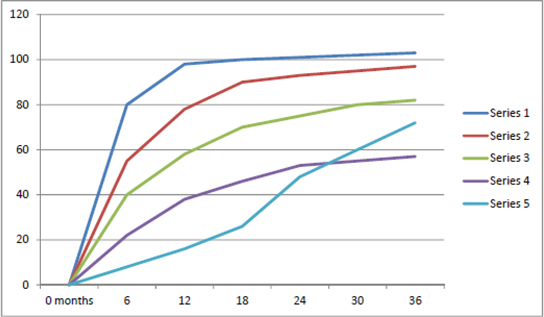
Figure 22-1 Percent of Design Capacity versus Months since Commissioning
The REO prices used in the financial model were sourced from Section 19. Prices have been based upon three year trailing average prices for both China (FOB) and domestic Europe markets.
The REO prices are applied individually per kilogram of REO recovered, rather than applying a discounted basket price. The pricing used in the DCF model is reported in Table 22-2. The overall basket price of saleable REO’s is 64.46 USD/kg which excludes Ho, Er, Tm and Yb.
Table 22-2 REO Prices used in Financial model
| REO | | UNIT | | PRICE (USD/kg) | |
| Ce2O3 | | USD/kg | | | 5.00 | |
| Dy2O3 | | USD/kg | | | 575.00 | |
| Er2O3 | | USD/kg | | | - | |
| Eu2O3 | | USD/kg | | | 700.00 | |
| Gd2O3 | | USD/kg | | | 40.00 | |
| Ho2O3 | | USD/kg | | | - | |
| La2O3 | | USD/kg | | | 7.00 | |
| Lu2O3 | | USD/kg | | | 900.00 | |
| Nd2O3 | | USD/kg | | | 80.00 | |
| Pr2O3 | | USD/kg | | | 115.00 | |
| Sm2O3 | | USD/kg | | | 8.00 | |
| Tb2O3 | | USD/kg | | | 950.00 | |
| Tm2O3 | | USD/kg | | | - | |
 |  |
| | Prefeasibility Study - NI 43-101 - Technical report for the Norra Kärr Rare Earth Element Deposit - 0465-RPT-014 Rev 0 |
| REO | | UNIT | | PRICE (USD/kg) | |
| Y2O3 | | USD/kg | | | 25.00 | |
| Yb2O3 | | USD/kg | | | - | |
The economic analysis was conducted over a range of discount rates and results have been presented in Table 22-3. Sensitivity analysis was conducted on the base case, which demonstrates the sensitivity to the NPV if an increase or decrease is seen in the operating income, operating expenditure, capital expenditure, recovery and basket price.
Table 22-3 DCF results for Norra Kärr in USD
| Discount Rate (%) | | NPV (Post Tax) | | | NPV (Pre Tax) | |
| 6 | | | 620 163 983 | | | | 837 098 796 | |
| 8 | | | 443 922 980 | | | | 619 112 592 | |
| 10 | | | 312 679 426 | | | | 456 175 601 | |
| 12 | | | 213 682 321 | | | | 332 761 664 | |
The full economic analysis conducted for the Norra Kärr project is presented in Section 24.1. The DCF model gave a robust result of, a post-tax NPV of USD 312.7 M and an IRR of 20 %. This result reflects a technically and economically feasible project, which should lead to further investment and development.
The annual cashflow and cumulative cashflow are reported in Figure 22-2 and Figure 22-3, this also shows that a pay back period of 4.8 years is shown.
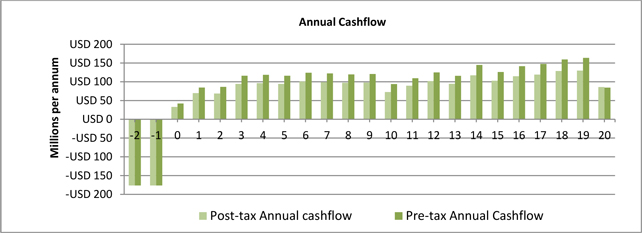
Figure 22-2 Norra Kärr at 10 % discount rate
 |  |
| | Prefeasibility Study - NI 43-101 - Technical report for the Norra Kärr Rare Earth Element Deposit - 0465-RPT-014 Rev 0 |
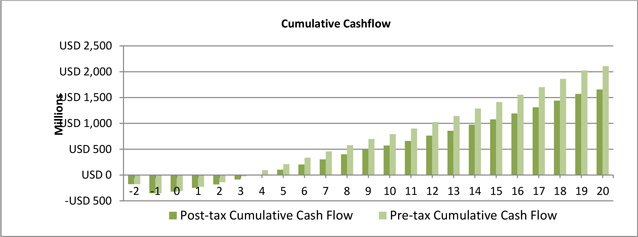
Figure 22-3 Norra Kärr Project at 10 % discount rate
The sensitivity analysis was conducted on the discount rate of 10 % used in the DCF. The analysis has shown in Figure 22-4 the importance to marketing and understanding the market to which the metals are sold into. The second most influential factor is the metallurgical recovery and with further optimisation this has potential to increase however sensitivity analysis was only conducted by ±2 % increments to ±6 %. The process operating costs have the greater potential to be reduced, through the reduction in reagent consumptions, and the recycling of reagents. As part of the operating costs is the treatment of all waste streams, once further characterisation is obtained there may be opportunity to change method and increase efficiency. The capital expenditure and mining costs have opportunity to reduce however the impact this will have on project financials is limited.
 |  |
| | Prefeasibility Study - NI 43-101 - Technical report for the Norra Kärr Rare Earth Element Deposit - 0465-RPT-014 Rev 0 |
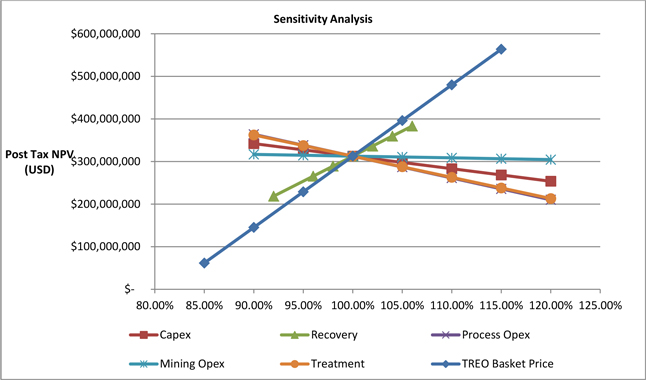
Figure 22-4 Norra Kärr Project at 10 % discount rate
 |  |
| | Prefeasibility Study - NI 43-101 - Technical report for the Norra Kärr Rare
Earth Element Deposit - 0465-RPT-014 Rev 0 |
| Section 23 | Adjacent Properties |
The only mineral properties in the immediate area are the exploration licences held by Tasman (see Figure 4-2). These cover the potential strike extent of the Norra Kärr intrusive body which is known to be completely encompassed within the mining licence. As such, the additional exploration licences are of limited intrinsic value and have no influence over the economic viability of the Norra Kärr project.
 |  |
| | Prefeasibility Study - NI 43-101 - Technical report for the Norra Kärr Rare
Earth Element Deposit - 0465-RPT-014 Rev 0 |
| Section 24 | Other Relevant Data and Information |
| 24.1 | Discounted Cash Flow Model |
 |  |
| Prefeasibility Study - NI 43-101 - Technical report for the Norra Kärr Rare Earth Element Deposit - 0465-RPT-014 Rev 0 |
Annual Calculations
| Production Schedule | | | LoM Total | | | | LoM Average | | | | -2 | | | | -1 | | | | 0 | | | | 1 | | | | 2 | | | | 3 | | | | 4 | | | | 5 | | | | 6 | | | | 7 | | | | 8 | | | | 9 | | | | 10 | | | | 11 | | | | 12 | | | | 13 | | | | 14 | | | | 15 | | | | 16 | | | | 17 | | | | 18 | | | | 19 | |
| Mining | | | | | | | | | | | | | | | | | | | | | | | | | | | | | | | | | | | | | | | | | | | | | | | | | | | | | | | | | | | | | | | | | | | | | | | | | | | | | | | | | | | | | | | | | | | | | | | | |
| Mining operations (proportion of year) | | | 20 | | | | - | | | | 0.0 | | | | 0.0 | | | | 1.0 | | | | 1.0 | | | | 1.0 | | | | 1.0 | | | | 1.0 | | | | 1.0 | | | | 1.0 | | | | 1.0 | | | | 1.0 | | | | 1.0 | | | | 1.0 | | | | 1.0 | | | | 1.0 | | | | 1.0 | | | | 1.0 | | | | 1.0 | | | | 1.0 | | | | 1.0 | | | | 1.0 | | | | 1.0 | |
| Total mineralised tonnes delivered (ROM) | | | 23,570,526 | | | | 1,122,406 | | | | | | | | | | | | 1,154,063 | | | | 1,149,719 | | | | 1,150,255 | | | | 1,152,703 | | | | 1,146,384 | | | | 1,149,954 | | | | 1,151,030 | | | | 1,148,626 | | | | 1,150,960 | | | | 1,152,606 | | | | 1,144,770 | | | | 1,152,632 | | | | 1,150,012 | | | | 1,153,810 | | | | 1,147,270 | | | | 1,149,433 | | | | 1,151,897 | | | | 1,144,047 | | | | 1,152,669 | | | | 1,155,110 | |
| Waste tonnes mined | | | 16,679,072 | | | | 794,242 | | | | | | | | | | | | 1,075,871 | | | | 1,116,693 | | | | 1,130,405 | | | | 1,036,564 | | | | 1,091,003 | | | | 1,347,256 | | | | 1,199,428 | | | | 1,244,134 | | | | 1,241,577 | | | | 1,232,625 | | | | 1,299,286 | | | | 809,066 | | | | 728,736 | | | | 393,765 | | | | 303,209 | | | | 441,258 | | | | 365,442 | | | | 205,494 | | | | 273,698 | | | | 111,137 | |
| Total tonnes mined | | | 40,249,598 | | | | 1,916,648 | | | | 0 | | �� | | 0 | | | | 2,229,934 | | | | 2,266,412 | | | | 2,280,660 | | | | 2,189,267 | | | | 2,237,387 | | | | 2,497,210 | | | | 2,350,458 | | | | 2,392,760 | | | | 2,392,537 | | | | 2,385,231 | | | | 2,444,056 | | | | 1,961,698 | | | | 1,878,748 | | | | 1,547,575 | | | | 1,450,479 | | | | 1,590,691 | | | | 1,517,339 | | | | 1,349,541 | | | | 1,426,367 | | | | 1,266,247 | |
| Waste : ROM ratio | | | | | | | 0.69 | | | | | | | | | | | | 0.93 | | | | 0.97 | | | | 0.98 | | | | 0.90 | | | | 0.95 | | | | 1.17 | | | | 1.04 | | | | 1.08 | | | | 1.08 | | | | 1.07 | | | | 1.13 | | | | 0.70 | | | | 0.63 | | | | 0.34 | | | | 0.26 | | | | 0.38 | | | | 0.32 | | | | 0.18 | | | | 0.24 | | | | 0.10 | |
| TREO grade (delivered) | | | | | | | 0.592 | % | | | | | | | | | | | 0.579 | % | | | 0.575 | % | | | 0.579 | % | | | 0.585 | % | | | 0.599 | % | | | 0.605 | % | | | 0.585 | % | | | 0.579 | % | | | 0.571 | % | | | 0.570 | % | | | 0.556 | % | | | 0.548 | % | | | 0.571 | % | | | 0.569 | % | | | 0.606 | % | | | 0.599 | % | | | 0.613 | % | | | 0.620 | % | | | 0.650 | % | | | 0.642 | % |
| Ce₂O₃ contained grams per tonne | | | 29,119,760 | | | | 1,235 | | | | | | | | | | | | 1,261 | | | | 1,258 | | | | 1,263 | | | | 1,295 | | | | 1,360 | | | | 1,413 | | | | 1,216 | | | | 1,192 | | | | 1,182 | | | | 1,165 | | | | 1,147 | | | | 1,148 | | | | 1,154 | | | | 1,220 | | | | 1,176 | | | | 1,285 | | | | 1,247 | | | | 1,222 | | | | 1,281 | | | | 1,236 | |
Dy₂O₃ contained grams per tonne | | | 6,330,929 | | | | 270 | | | | | | | | | | | | 254.96 | | | | 252 | | | | 254 | | | | 254 | | | | 254 | | | | 250 | | | | 267 | | | | 267 | | | | 262 | | | | 265 | | | | 257 | | | | 249 | | | | 266 | | | | 252 | | | | 290 | | | | 262 | | | | 282 | | | | 292 | | | | 303 | | | | 310 | |
| Er₂O₃ contained grams per tonne | | | 4,330,925 | | | | 185 | | | | | | | | | | | | 171 | | | | 171 | | | | 170 | | | | 170 | | | | 168 | | | | 164 | | | | 183 | | | | 183 | | | | 182 | | | | 183 | | | | 176 | | | | 172 | | | | 182 | | | | 172 | | | | 201 | | | | 180 | | | | 194 | | | | 203 | | | | 211 | | | | 217 | |
| Eu₂O₃ contained grams per tonne | | | 513,913 | | | | 22 | | | | | | | | | | | | 21 | | | | 21 | | | | 21 | | | | 21 | | | | 22 | | | | 22 | | | | 21 | | | | 21 | | | | 21 | | | | 21 | | | | 21 | | | | 20 | | | | 21 | | | | 21 | | | | 22 | | | | 22 | | | | 23 | | | | 23 | | | | 24 | | | | 24 | |
| Gd₂O₃ contained grams per tonne | | | 4,631,546 | | | | 197 | | | | | | | | | | | | 191 | | | | 189 | | | | 190 | | | | 189 | | | | 193 | | | | 193 | | | | 192 | | | | 192 | | | | 189 | | | | 190 | | | | 184 | | | | 179 | | | | 192 | | | | 186 | | | | 207 | | | | 197 | | | | 207 | | | | 213 | | | | 223 | | | | 222 | |
| Ho₂O₃ contained grams per tonne | | | 1,397,905 | | | | 60 | | | | | | | | | | | | 57 | | | | 56 | | | | 56 | | | | 56 | | | | 56 | | | | 55 | | | | 59 | | | | 59 | | | | 58 | | | | 59 | | | | 57 | | | | 55 | | | | 59 | | | | 55 | | | | 64 | | | | 57 | | | | 62 | | | | 64 | | | | 67 | | | | 69 | |
| La₂O₃ contained grams per tonne | | | 12,987,081 | | | | 551 | | | | | | | | | | | | 550 | | | | 547 | | | | 557 | | | | 582 | | | | 600 | | | | 622 | | | | 557 | | | | 544 | | | | 540 | | | | 531 | | | | 519 | | | | 523 | | | | 516 | | | | 550 | | | | 520 | | | | 569 | | | | 549 | | | | 535 | | | | 564 | | | | 547 | |
| Lu₂O₃ contained grams per tonne | | | 551,832 | | | | 24 | | | | | | | | | | | | 22 | | | | 22 | | | | 22 | | | | 22 | | | | 21 | | | | 21 | | | | 24 | | | | 24 | | | | 23 | | | | 24 | | | | 23 | | | | 22 | | | | 23 | | | | 22 | | | | 25 | | | | 23 | | | | 24 | | | | 26 | | | | 26 | | | | 28 | |
| Nd₂O₃ contained grams per tonne | | | 15,275,855 | | | | 648 | | | | | | | | | | | | 653 | | | | 656 | | | | 652 | | | | 663 | | | | 700 | | | | 724 | | | | 629 | | | | 622 | | | | 614 | | | | 607 | | | | 601 | | | | 593 | | | | 618 | | | | 629 | | | | 636 | | | | 671 | | | | 667 | | | | 655 | | | | 693 | | | | 671 | |
| Pr₂O₃ contained grams per tonne | | | 3,801,217 | | | | 161 | | | | | | | | | | | | 164 | | | | 165 | | | | 165 | | | | 168 | | | | 177 | | | | 185 | | | | 158 | | | | 155 | | | | 154 | | | | 152 | | | | 150 | | | | 149 | | | | 153 | | | | 158 | | | | 155 | | | | 167 | | | | 164 | | | | 160 | | | | 168 | | | | 162 | |
| Sm₂O₃ contained grams per tonne | | | 4,192,786 | | | | 178 | | | | | | | | | | | | 179 | | | | 174 | | | | 176 | | | | 177 | | | | 182 | | | | 185 | | | | 174 | | | | 173 | | | | 170 | | | | 168 | | | | 164 | | | | 161 | | | | 171 | | | | 168 | | | | 182 | | | | 182 | | | | 186 | | | | 187 | | | | 195 | | | | 195 | |
| Tb₂O₃ contained grams per tonne | | | 934,272 | | | | 40 | | | | | | | | | | | | 38 | | | | 37 | | | | 38 | | | | 38 | | | | 38 | | | | 38 | | | | 39 | | | | 39 | | | | 38 | | | | 39 | | | | 38 | | | | 37 | | | | 39 | | | | 37 | | | | 42 | | | | 39 | | | | 42 | | | | 43 | | | | 45 | | | | 45 | |
| Tm₂O₃ contained grams per tonne | | | 660,635 | | | | 28 | | | | | | | | | | | | 26 | | | | 26 | | | | 26 | | | | 26 | | | | 26 | | | | 25 | | | | 28 | | | | 28 | | | | 28 | | | | 28 | | | | 27 | | | | 26 | | | | 28 | | | | 26 | | | | 31 | | | | 27 | | | | 29 | | | | 31 | | | | 32 | | | | 33 | |
| Y₂O₃ contained grams per tonne | | | 50,662,410 | | | | 2,159 | | | | | | | | | | | | 2,045 | | | | 2,019 | | | | 2,038 | | | | 2,033 | | | | 2,041 | | | | 2,005 | | | | 2,133 | | | | 2,118 | | | | 2,080 | | | | 2,094 | | | | 2,033 | | | | 1,983 | | | | 2,117 | | | | 2,028 | | | | 2,316 | | | | 2,138 | | | | 2,274 | | | | 2,361 | | | | 2,470 | | | | 2,464 | |
| Yb₂O₃ contained grams per tonne | | | 4,048,986 | | | | 173 | | | | | | | | | | | | 160 | | | | 160 | | | | 160 | | | | 161 | | | | 157 | | | | 153 | | | | 173 | | | | 173 | | | | 172 | | | | 172 | | | | 166 | | | | 162 | | | | 171 | | | | 161 | | | | 188 | | | | 167 | | | | 179 | | | | 188 | | | | 194 | | | | 200 | |
| ZrO₂ contained grams per tonne | | | | | | | 13,579 | | | | | | | | | | | | 12,840 | | | | 13,502 | | | | 12,804 | | | | 12,741 | | | | 13,040 | | | | 12,874 | | | | 12,941 | | | | 13,027 | | | | 13,218 | | | | 13,558 | | | | 13,689 | | | | 13,472 | | | | 14,223 | | | | 13,486 | | | | 14,408 | | | | 13,423 | | | | 13,983 | | | | 14,407 | | | | 14,336 | | | | 14,604 | |
| HfO₂ contained grams per tonne | | | | | | | 287 | | | | | | | | | | | | 268 | | | | 285 | | | | 268 | | | | 268 | | | | 275 | | | | 270 | | | | 275 | | | | 279 | | | | 283 | | | | 290 | | | | 293 | | | | 288 | | | | 301 | | | | 283 | | | | 304 | | | | 283 | | | | 295 | | | | 303 | | | | 299 | | | | 306 | |
| | | | | | | | | | | | | | | | | | | | | | | | | | | | | | | | | | | | | | | | | | | | | | | | | | | | | | | | | | | | | | | | | | | | | | | | | | | | | | | | | | | | | | | | | | | | | | | | | |
| Plant | | | | | | | | | | | | | | | | | | | | | | | | | | | | | | | | | | | | | | | | | | | | | | | | | | | | | | | | | | | | | | | | | | | | | | | | | | | | | | | | | | | | | | | | | | | | | | | | |
| Plant operations (proportion of year) | | | 20 | | | | | | | | 0.0 | | | | 0.0 | | | | 0.60 | | | | 0.75 | | | | 0.85 | | | | 1.0 | | | | 1.0 | | | | 1.0 | | | | 1.0 | | | | 1.0 | | | | 1.0 | | | | 1.0 | | | | 1.0 | | | | 1.0 | | | | 1.0 | | | | 1.0 | | | | 1.0 | | | | 1.0 | | | | 1.0 | | | | 1.0 | | | | 1.0 | | | | 1.0 | |
| Plant feed tonnes | | | 22,648,933 | | | | 1,078,521 | | | | 0 | | | | 0 | | | | 692,438 | | | | 862,289 | | | | 977,717 | | | | 1,152,703 | | | | 1,146,384 | | | | 1,149,954 | | | | 1,151,030 | | | | 1,148,626 | | | | 1,150,960 | | | | 1,152,606 | | | | 1,144,770 | | | | 1,152,632 | | | | 1,150,012 | | | | 1,153,810 | | | | 1,147,270 | | | | 1,149,433 | | | | 1,151,897 | | | | 1,144,047 | | | | 1,152,669 | | | | 1,155,110 | |
| Total TREO recovered | | | 102,395 | | | | 4,876 | | | | | | | | | | | | 3,064 | | | | 3,792 | | | | 4,324 | | | | 5,158 | | | | 5,255 | | | | 5,328 | | | | 5,143 | | | | 5,077 | | | | 5,019 | | | | 5,011 | | | | 4,862 | | | | 4,821 | | | | 5,012 | | | | 5,012 | | | | 5,298 | | | | 5,256 | | | | 5,388 | | | | 5,410 | | | | 5,710 | | | | 5,657 | |
| Ce₂O₃ tonnes recovered | | | 21,807 | | | | 1,038 | | | | | | | | | | | | 681 | | | | 846 | | | | 963 | | | | 1,164 | | | | 1,216 | | | | 1,267 | | | | 1,092 | | | | 1,068 | | | | 1,061 | | | | 1,047 | | | | 1,024 | | | | 1,032 | | | | 1,036 | | | | 1,098 | | | | 1,052 | | | | 1,152 | | | | 1,121 | | | | 1,091 | | | | 1,152 | | | | 1,114 | |
| Dy₂O₃ tonnes recovered | | | 4,864 | | | | 232 | | | | | | | | | | | | 141 | | | | 173 | | | | 198 | | | | 233 | | | | 232 | | | | 229 | | | | 245 | | | | 244 | | | | 241 | | | | 244 | | | | 235 | | | | 229 | | | | 244 | | | | 232 | | | | 265 | | | | 241 | | | | 260 | | | | 266 | | | | 279 | | | | 286 | |
| Er₂O₃ tonnes recovered | | | 3,230 | | | | 154 | | | | | | | | | | | | 91 | | | | 114 | | | | 129 | | | | 152 | | | | 149 | | | | 146 | | | | 163 | | | | 163 | | | | 162 | | | | 163 | | | | 156 | | | | 153 | | | | 162 | | | | 154 | | | | 179 | | | | 160 | | | | 173 | | | | 179 | | | | 188 | | | | 194 | |
| Eu₂O₃ tonnes recovered | | | 393 | | | | 19 | | | | | | | | | | | | 12 | | | | 15 | | | | 17 | | | | 20 | | | | 20 | | | | 20 | | | | 19 | | | | 19 | | | | 19 | | | | 19 | | | | 19 | | | | 18 | | | | 20 | | | | 19 | | | | 20 | | | | 20 | | | | 21 | | | | 21 | | | | 22 | | | | 22 | |
| Gd₂O₃ tonnes recovered | | | 3,535 | | | | 168 | | | | | | | | | | | | 105 | | | | 129 | | | | 147 | | | | 173 | | | | 175 | | | | 176 | | | | 175 | | | | 175 | | | | 172 | | | | 173 | | | | 167 | | | | 163 | | | | 175 | | | | 170 | | | | 188 | | | | 179 | | | | 189 | | | | 193 | | | | 204 | | | | 203 | |
| Ho₂O₃ tonnes recovered | | | 1,050 | | | | 50 | | | | | | | | | | | | 31 | | | | 38 | | | | 43 | | | | 50 | | | | 50 | | | | 49 | | | | 53 | | | | 53 | | | | 52 | | | | 53 | | | | 51 | | | | 50 | | | | 53 | | | | 50 | | | | 57 | | | | 51 | | | | 55 | | | | 57 | | | | 60 | | | | 62 | |
| La₂O₃ tonnes recovered | | | 9,709 | | | | 462 | | | | | | | | | | | | 296 | | | | 367 | | | | 424 | | | | 522 | | | | 535 | | | | 557 | | | | 499 | | | | 486 | | | | 484 | | | | 476 | | | | 463 | | | | 469 | | | | 461 | | | | 494 | | | | 464 | | | | 509 | | | | 492 | | | | 476 | | | | 506 | | | | 492 | |
| Lu₂O₃ tonnes recovered | | | 401 | | | | 19 | | | | | | | | | | | | 11 | | | | 14 | | | | 16 | | | | 19 | | | | 19 | | | | 18 | | | | 20 | | | | 21 | | | | 20 | | | | 20 | | | | 20 | | | | 19 | | | | 20 | | | | 19 | | | | 22 | | | | 20 | | | | 21 | | | | 22 | | | | 23 | | | | 24 | |
| Nd₂O₃ tonnes recovered | | | 11,593 | | | | 552 | | | | | | | | | | | | 357 | | | | 447 | | | | 504 | | | | 604 | | | | 634 | | | | 658 | | | | 572 | | | | 565 | | | | 558 | | | | 552 | | | | 544 | | | | 540 | | | | 561 | | | | 573 | | | | 577 | | | | 609 | | | | 607 | | | | 592 | | | | 631 | | | | 613 | |
| Pr₂O₃ tonnes recovered | | | 2,876 | | | | 137 | | | | | | | | | | | | 89 | | | | 112 | | | | 127 | | | | 152 | | | | 160 | | | | 168 | | | | 143 | | | | 141 | | | | 139 | | | | 138 | | | | 136 | | | | 136 | | | | 139 | | | | 144 | | | | 141 | | | | 151 | | | | 149 | | | | 144 | | | | 152 | | | | 147 | |
| Sm₂O₃ tonnes recovered | | | 3,201 | | | | 152 | | | | | | | | | | | | 98 | | | | 119 | | | | 137 | | | | 162 | | | | 166 | | | | 169 | | | | 159 | | | | 157 | | | | 155 | | | | 154 | | | | 149 | | | | 148 | | | | 156 | | | | 154 | | | | 166 | | | | 166 | | | | 170 | | | | 170 | | | | 179 | | | | 179 | |
| Tb₂O₃ tonnes recovered | | | 712 | | | | 34 | | | | | | | | | | | | 21 | | | | 26 | | | | 29 | | | | 34 | | | | 35 | | | | 34 | | | | 36 | | | | 36 | | | | 35 | | | | 35 | | | | 34 | | �� | | 33 | | | | 36 | | | | 34 | | | | 39 | | | | 35 | | | | 38 | | | | 39 | | | | 41 | | | | 41 | |
| Tm₂O₃ tonnes recovered | | | 489 | | | | 23 | | | | | | | | | | | | 14 | | | | 17 | | | | 20 | | | | 23 | | | | 23 | | | | 22 | | | | 25 | | | | 25 | | | | 25 | | | | 25 | | | | 24 | | | | 23 | | | | 25 | | | | 23 | | | | 27 | | | | 24 | | | | 26 | | | | 27 | | | | 28 | | | | 29 | |
| Y₂O₃ tonnes recovered | | | 35,565 | | | | 1,694 | | | | | | | | | | | | 1,032 | | | | 1,269 | | | | 1,452 | | | | 1,708 | | | | 1,705 | | | | 1,681 | | | | 1,790 | | | | 1,773 | | | | 1,745 | | | | 1,760 | | | | 1,697 | | | | 1,666 | | | | 1,775 | | | | 1,706 | | | | 1,937 | | | | 1,791 | | | | 1,909 | | | | 1,969 | | | | 2,075 | | | | 2,075 | |
| Yb₂O₃ tonnes recovered | | | 2,969 | | | | 141 | | | | | | | | | | | | 84 | | | | 105 | | | | 119 | | | | 141 | | | | 137 | | | | 134 | | | | 151 | | | | 151 | | | | 150 | | | | 151 | | | | 145 | | | | 142 | | | | 149 | | | | 142 | | | | 164 | | | | 146 | | | | 157 | | | | 163 | | | | 170 | | | | 176 | |
| ZrO₂ tonnes recovered | | | 20 | | | | 0 | | | | | | | | | | | | 0 | | | | 0 | | | | 0 | | | | 0 | | | | 0 | | | | 0 | | | | 0 | | | | 0 | | | | 0 | | | | 0 | | | | 0 | | | | 0 | | | | 0 | | | | 0 | | | | 0 | | | | 0 | | | | 0 | | | | 0 | | | | 0 | | | | 0 | |
| HfO₂ tonnes recovered | | | 0 | | | | 0 | | | | | | | | | | | | 0 | | | | 0 | | | | 0 | | | | 0 | | | | 0 | | | | 0 | | | | 0 | | | | 0 | | | | 0 | | | | 0 | | | | 0 | | | | 0 | | | | 0 | | | | 0 | | | | 0 | | | | 0 | | | | 0 | | | | 0 | | | | 0 | | | | 0 | |
| CAPEX Schedule | | | LoM Total | | | | -2 | | | | -1 | | | | 0 | | | | 1 | | | | 2 | | | | 3 | | | | 4 | | | | 5 | | | | 6 | | | | 7 | | | | 8 | | | | 9 | | | | 10 | | | | 11 | | | | 12 | | | | 13 | | | | 14 | | | | 15 | | | | 16 | | | | 17 | | | | 18 | | | | 19 | |
| Fixed | | | 397,727,473 | | | | 176,481,777 | | | | 176,481,777 | | | | 455,139 | | | | 455,139 | | | | 11,655,139 | | | | 1,417,139 | | | | 455,139 | | | | 455,139 | | | | 455,139 | | | | 1,350,139 | | | | 455,139 | | | | 1,371,139 | | | | 20,850,139 | | | | 1,293,139 | | | | 455,139 | | | | 455,139 | | | | 455,139 | | | | 455,139 | | | | 455,139 | | | | 455,139 | | | | 455,139 | | | | 455,139 | |
| Working | | | 25,312,805 | | | | 0 | | | | 0 | | | | 25,312,805 | | | | 0 | | | | 0 | | | | 0 | | | | 0 | | | | 0 | | | | 0 | | | | 0 | | | | 0 | | | | 0 | | | | 0 | | | | 0 | | | | 0 | | | | 0 | | | | 0 | | | | 0 | | | | 0 | | | | 0 | | | | 0 | | | | 0 | |
| Total | | | 423,040,278 | | | | 176,481,777 | | | | 176,481,777 | | | | 25,767,944 | | | | 455,139 | | | | 11,655,139 | | | | 1,417,139 | | | | 455,139 | | | | 455,139 | | | | 455,139 | | | | 1,350,139 | | | | 455,139 | | | | 1,371,139 | | | | 20,850,139 | | | | 1,293,139 | | | | 455,139 | | | | 455,139 | | | | 455,139 | | | | 455,139 | | | | 455,139 | | | | 455,139 | | | | 455,139 | | | | 455,139 | |
| | | | | | | | USD/t ROM | | | | | | | | | | | | | | | | | | | | | | | | | | | | | | | | | | | | | | | | | | | | | | | | | | | | | | | | | | | | | | | | | | | | | | | | | | | | | | | | | | | | | | | | | |
| Operating Cost Schedule | | | LoM Total | | | | Ave | | | | -2 | | | | -1 | | | | 0 | | | | 1 | | | | 2 | | | | 3 | | | | 4 | | | | 5 | | | | 6 | | | | 7 | | | | 8 | | | | 9 | | | | 10 | | | | 11 | | | | 12 | | | | 13 | | | | 14 | | | | 15 | | | | 16 | | | | 17 | | | | 18 | | | | 19 | |
| General | | | 106,676,473 | | | | 4.5 | | | | 0 | | | | 0 | | | | 3,261,382 | | | | 4,061,382 | | | | 4,605,046 | | | | 5,429,231 | | | | 5,399,469 | | | | 5,416,283 | | | | 5,421,351 | | | | 5,410,028 | | | | 5,421,022 | | | | 5,428,774 | | | | 5,391,867 | | | | 5,428,897 | | | | 5,416,557 | | | | 5,434,445 | | | | 5,403,642 | | | | 5,413,829 | | | | 5,425,435 | | | | 5,388,461 | | | | 5,429,071 | | | | 5,440,568 | |
| General and Admin | | | 106,676,473 | | | | 5 | | | | 0 | | | | 0 | | | | 3,261,382 | | | | 4,061,382 | | | | 4,605,046 | | | | 5,429,231 | | | | 5,399,469 | | | | 5,416,283 | | | | 5,421,351 | | | | 5,410,028 | | | | 5,421,022 | | | | 5,428,774 | | | | 5,391,867 | | | | 5,428,897 | | | | 5,416,557 | | | | 5,434,445 | | | | 5,403,642 | | | | 5,413,829 | | | | 5,425,435 | | | | 5,388,461 | | | | 5,429,071 | | | | 5,440,568 | |
| 0 | | | 0 | | | | 0 | | | | | | | | | | | | | | | | | | | | | | | | | | | | | | | | | | | | | | | | | | | | | | | | | | | | | | | | | | | | | | | | | | | | | | | | | | | | | | | | | | | | | | | | | |
| Mining Costs | | | 138,056,121 | | | | 5.9 | | | | 0 | | | | 0 | | | | 7,648,674 | | | | 7,773,793 | | | | 7,822,664 | | | | 7,509,186 | | | | 7,674,237 | | | | 8,565,430 | | | | 8,062,071 | | | | 8,207,167 | | | | 8,206,402 | | | | 8,181,342 | | | | 8,383,112 | | | | 6,728,624 | | | | 6,444,106 | | | | 5,308,182 | | | | 4,975,143 | | | | 5,456,070 | | | | 5,204,473 | | | | 4,628,926 | | | | 4,892,439 | | | | 4,343,227 | |
| Ore mining cost | | | 80,846,904 | | | | 3 | | | | 0 | | | | 0 | | | | 3,958,436 | | | | 3,943,536 | | | | 3,945,375 | | | | 3,953,771 | | | | 3,932,097 | | | | 3,944,342 | | | | 3,948,033 | | | | 3,939,787 | | | | 3,947,793 | | | | 3,953,439 | | | | 3,926,561 | | | | 3,953,528 | | | | 3,944,541 | | | | 3,957,568 | | | | 3,935,136 | | | | 3,942,555 | | | | 3,951,007 | | | | 3,924,081 | | | | 3,953,655 | | | | 3,962,027 | |
| Waste mining cost | | | 57,209,217 | | | | 2 | | | | 0 | | | | 0 | | | | 3,690,238 | | | | 3,830,257 | | | | 3,877,289 | | | | 3,555,415 | | | | 3,742,140 | | | | 4,621,088 | | | | 4,114,038 | | | | 4,267,380 | | | | 4,258,609 | | | | 4,227,904 | | | | 4,456,551 | | | | 2,775,096 | | | | 2,499,564 | | | | 1,350,614 | | | | 1,040,007 | | | | 1,513,515 | | | | 1,253,466 | | | | 704,844 | | | | 938,784 | | | | 381,200 | |
| Overhead mining cost | | | 0 | | | | 0 | | | | 0 | | | | 0 | | | | 0 | | | | 0 | | | | 0 | | | | 0 | | | | 0 | | | | 0 | | | | 0 | | | | 0 | | | | 0 | | | | 0 | | | | 0 | | | | 0 | | | | 0 | | | | 0 | | | | 0 | | | | 0 | | | | 0 | | | | 0 | | | | 0 | | | | 0 | |
| 0 | | | 0 | | | | 0 | | | | | | | | | | | | | | | | | | | | | | | | | | | | | | | | | | | | | | | | | | | | | | | | | | | | | | | | | | | | | | | | | | | | | | | | | | | | | | | | | | | | | | | | | |
| Plant | | | 1,873,519,721 | | | | 79.5 | | | | 0 | | | | 0 | | | | 57,278,455 | | | | 71,328,567 | | | | 80,876,730 | | | | 95,351,592 | | | | 94,828,884 | | | | 95,124,195 | | | | 95,213,202 | | | | 95,014,343 | | | | 95,207,411 | | | | 95,343,568 | | | | 94,695,374 | | | | 95,345,719 | | | | 95,128,993 | | | | 95,443,163 | | | | 94,902,174 | | | | 95,081,098 | | | | 95,284,920 | | | | 94,635,568 | | | | 95,348,780 | | | | 95,550,699 | |
| Maintenance & Operating Spares | | | 130,910,832 | | | | 6 | | | | 0 | | | | 0 | | | | 4,002,290 | | | | 4,984,032 | | | | 5,651,203 | | | | 6,662,623 | | | | 6,626,100 | | | | 6,646,734 | | | | 6,652,953 | | | | 6,639,058 | | | | 6,652,549 | | | | 6,662,063 | | | | 6,616,771 | | | | 6,662,213 | | | | 6,647,069 | | | | 6,669,022 | | | | 6,631,221 | | | | 6,643,723 | | | | 6,657,965 | | | | 6,612,592 | | | | 6,662,427 | | | | 6,676,536 | |
| Consumable - Grinding media and liners | | | 34,879,357 | | | | 1 | | | | 0 | | | | 0 | | | | 1,066,354 | | | | 1,327,925 | | | | 1,505,684 | | | | 1,775,163 | | | | 1,765,431 | | | | 1,770,929 | | | | 1,772,586 | | | | 1,768,884 | | | | 1,772,478 | | | | 1,775,013 | | | | 1,762,946 | | | | 1,775,053 | | | | 1,771,018 | | | | 1,776,867 | | | | 1,766,796 | | | | 1,770,127 | | | | 1,773,921 | | | | 1,761,832 | | | | 1,775,110 | | | | 1,778,869 | |
| Labour | | | 175,302,740 | | | | 7 | | | | 0 | | | | 0 | | | | 5,359,469 | | | | 6,674,119 | | | | 7,567,528 | | | | 8,921,921 | | | | 8,873,012 | | | | 8,900,644 | | | | 8,908,972 | | | | 8,890,365 | | | | 8,908,430 | | | | 8,921,170 | | | | 8,860,520 | | | | 8,921,372 | | | | 8,901,093 | | | | 8,930,489 | | | | 8,879,870 | | | | 8,896,611 | | | | 8,915,683 | | | | 8,854,924 | | | | 8,921,658 | | | | 8,940,551 | |
| Reagents | | | 749,679,676 | | | | 32 | | | | 0 | | | | 0 | | | | 22,919,691 | | | | 28,541,774 | | | | 32,362,424 | | | | 38,154,469 | | | | 37,945,310 | | | | 38,063,477 | | | | 38,099,093 | | | | 38,019,521 | | | | 38,096,776 | | | | 38,151,259 | | | | 37,891,887 | | | | 38,152,119 | | | | 38,065,397 | | | | 38,191,111 | | | | 37,974,637 | | | | 38,046,232 | | | | 38,127,791 | | | | 37,867,956 | | | | 38,153,344 | | | | 38,234,141 | |
| Utilities - Disel | | | 134,987,639 | | | | 6 | | | | 0 | | | | 0 | | | | 4,126,929 | | | | 5,139,244 | | | | 5,827,192 | | | | 6,870,110 | | | | 6,832,449 | | | | 6,853,726 | | | | 6,860,139 | | | | 6,845,811 | | | | 6,859,722 | | | | 6,869,532 | | | | 6,822,829 | | | | 6,869,687 | | | | 6,854,072 | | | | 6,876,708 | | | | 6,837,729 | | | | 6,850,621 | | | | 6,865,306 | | | | 6,818,520 | | | | 6,869,907 | | | | 6,884,456 | |
| Consumable – Electricity | | | 135,440,618 | | | | 6 | | | | 0 | | | | 0 | | | | 4,140,778 | | | | 5,156,490 | | | | 5,846,746 | | | | 6,893,164 | | | | 6,855,376 | | | | 6,876,725 | | | | 6,883,159 | | | | 6,868,783 | | | | 6,882,741 | | | | 6,892,584 | | | | 6,845,725 | | | | 6,892,739 | | | | 6,877,072 | | | | 6,899,784 | | | | 6,860,675 | | | | 6,873,609 | | | | 6,888,344 | | | | 6,841,401 | | | | 6,892,961 | | | | 6,907,558 | |
| Water treatment | | | 447,542,912 | | | | 19 | | | | 0 | | | | 0 | | | | 13,682,571 | | | | 17,038,836 | | | | 19,319,683 | | | | 22,777,411 | | | | 22,652,548 | | | | 22,723,091 | | | | 22,744,353 | | | | 22,696,850 | | | | 22,742,970 | | | | 22,775,495 | | | | 22,620,655 | | | | 22,776,008 | | | | 22,724,237 | | | | 22,799,286 | | | | 22,670,055 | | | | 22,712,796 | | | | 22,761,485 | | | | 22,606,369 | | | | 22,776,739 | | | | 22,824,974 | |
| Waste Management | | | 64,775,948 | | | | 3 | | | | 0 | | | | 0 | | | | 1,980,372 | | | | 2,466,147 | | | | 2,796,270 | | | | 3,296,731 | | | | 3,278,658 | | | | 3,288,868 | | | | 3,291,946 | | | | 3,285,070 | | | | 3,291,746 | | | | 3,296,453 | | | | 3,274,042 | | | | 3,296,528 | | | | 3,289,034 | | | | 3,299,897 | | | | 3,281,192 | | | | 3,287,378 | | | | 3,294,425 | | | | 3,271,974 | | | | 3,296,633 | | | | 3,303,615 | |
| Sales Costs | | | 1,945,513,128 | | | | 83 | | | | 0 | | | | 0 | | | | 58,225,072 | | | | 72,045,841 | | | | 82,146,614 | | | | 97,999,757 | | | | 99,847,047 | | | | 101,236,318 | | | | 97,707,991 | | | | 96,465,158 | | | | 95,366,945 | | | | 95,215,064 | | | | 92,383,393 | | | | 91,603,749 | | | | 95,221,304 | | | | 95,218,942 | | | | 100,667,140 | | | | 99,864,513 | | | | 102,375,696 | | | | 102,791,476 | | | | 108,494,747 | | | | 107,473,759 | |
| Transport - Area 400 Product handling | | | 0 | | | | 0 | | | | 0 | | | | 0 | | | | 0 | | | | 0 | | | | 0 | | | | 0 | | | | 0 | | | | 0 | | | | 0 | | | | 0 | | | | 0 | | | | 0 | | | | 0 | | | | 0 | | | | 0 | | | | 0 | | | | 0 | | | | 0 | | | | 0 | | | | 0 | | | | 0 | | | | 0 | |
| Treatment & Refining TREO | | | 1,945,513,128 | | | | 82 | | | | 0 | | | | 0 | | | | 58,225,072 | | | | 72,045,841 | | | | 82,146,614 | | | | 97,999,757 | | | | 99,847,047 | | | | 101,236,318 | | | | 97,707,991 | | | | 96,465,158 | | | | 95,366,945 | | | | 95,215,064 | | | | 92,383,393 | | | | 91,603,749 | | | | 95,221,304 | | | | 95,218,942 | | | | 100,667,140 | | | | 99,864,513 | | | | 102,375,696 | | | | 102,791,476 | | | | 108,494,747 | | | | 107,473,759 | |
| Treatment & Refining Zr/Hf | | | 0 | | | | 0 | | | | 0 | | | | 0 | | | | 0 | | | | 0 | | | | 0 | | | | 0 | | | | 0 | | | | 0 | | | | 0 | | | | 0 | | | | 0 | | | | 0 | | | | 0 | | | | 0 | | | | 0 | | | | 0 | | | | 0 | | | | 0 | | | | 0 | | | | 0 | | | | 0 | | | | 0 | |
| 0 | | | 0 | | | | 0 | | | | | | | | | | | | | | | | | | | | | | | | | | | | | | | | | | | | | | | | | | | | | | | | | | | | | | | | | | | | | | | | | | | | | | | | | | | | | | | | | | | | | | | | | |
| TOTAL OPERATING COST | | | 4,063,765,444 | | | | 172.4 | | | | | | | | | | | | 126,413,583 | | | | 155,209,583 | | | | 175,451,053 | | | | 206,289,766 | | | | 207,749,637 | | | | 210,342,227 | | | | 206,404,614 | | | | 205,096,696 | | | | 204,201,779 | | | | 204,168,749 | | | | 200,853,747 | | | | 199,106,989 | | | | 202,210,959 | | | | 201,404,733 | | | | 205,948,099 | | | | 205,815,510 | | | | 208,290,523 | | | | 207,444,431 | | | | 214,165,037 | | | | 212,808,253 | |
Discounted Cash Flow Analysis
| | | | | | USD/t ROM | | | | | | | | | | | | | | | | | | | | | | | | | | | | | | | | | | | | | | | | | | | | | | | | | | | | | | | | | | | | | | | | | | | |
| Discounted Cash Flow | | LOM | | | Ave | | | -2 | | | -1 | | | 0 | | | 1 | | | 2 | | | 3 | | | 4 | | | 5 | | | 6 | | | 7 | | | 8 | | | 9 | | | 10 | | | 11 | | | 12 | | | 13 | | | 14 | | | 15 | | | 16 | | | 17 | | | 18 | | | 19 | |
| Total Capital Investment | | | 423,040,278 | | | | | | | | 176,481,777 | | | | 176,481,777 | | | | 25,767,944 | | | | 455,139 | | | | 11,655,139 | | | | 1,417,139 | | | | 455,139 | | | | 455,139 | | | | 455,139 | | | | 1,350,139 | | | | 455,139 | | | | 1,371,139 | | | | 20,850,139 | | | | 1,293,139 | | | | 455,139 | | | | 455,139 | | | | 455,139 | | | | 455,139 | | | | 455,139 | | | | 455,139 | | | | 455,139 | | | | 455,139 | |
| Sales | | | 6,600,312,157 | | | | 291.4 | | | | 0 | | | | 0 | | | | 194,469,129 | | | | 240,514,765 | | | | 273,642,101 | | | | 324,078,145 | | | | 326,866,393 | | | | 327,017,243 | | | | 331,189,981 | | | | 328,832,978 | | | | 324,509,680 | | | | 326,426,094 | | | | 315,769,289 | | | | 310,064,395 | | | | 327,895,496 | | | | 317,928,414 | | | | 351,390,095 | | | | 332,628,593 | | | | 350,548,206 | | | | 355,654,898 | | | | 374,322,115 | | | | 377,135,348 | |
| Total Cost of Goods Sold | | | 4,067,685,086 | | | | 179.6 | | | | 0 | | | | 0 | | | | 126,593,023 | | | | 155,387,796 | | | | 175,629,876 | | | | 206,469,391 | | | | 207,931,782 | | | | 210,523,862 | | | | 206,588,493 | | | | 205,279,646 | | | | 204,381,956 | | | | 204,349,729 | | | | 201,030,008 | | | | 199,278,888 | | | | 202,393,158 | | | | 201,580,808 | | | | 206,143,857 | | | | 206,000,435 | | | | 208,485,003 | | | | 207,643,136 | | | | 214,372,609 | | | | 213,016,928 | |
| Production Cost | | | 2,118,252,316 | | | | 89.9 | | | | 0 | | | | 0 | | | | 68,188,510 | | | | 83,163,742 | | | | 93,304,439 | | | | 108,290,009 | | | | 107,902,591 | | | | 109,105,909 | | | | 108,696,624 | | | | 108,631,538 | | | | 108,834,835 | | | | 108,953,685 | | | | 108,470,353 | | | | 107,503,240 | | | | 106,989,655 | | | | 106,185,791 | | | | 105,280,959 | | | | 105,950,997 | | | | 105,914,827 | | | | 104,652,955 | | | | 105,670,289 | | | | 105,334,495 | |
| Cost of Sales | | | 1,945,513,128 | | | | 82.5 | | | | 0 | | | | 0 | | | | 58,225,072 | | | | 72,045,841 | | | | 82,146,614 | | | | 97,999,757 | | | | 99,847,047 | | | | 101,236,318 | | | | 97,707,991 | | | | 96,465,158 | | | | 95,366,945 | | | | 95,215,064 | | | | 92,383,393 | | | | 91,603,749 | | | | 95,221,304 | | | | 95,218,942 | | | | 100,667,140 | | | | 99,864,513 | | | | 102,375,696 | | | | 102,791,476 | | | | 108,494,747 | | | | 107,473,759 | |
| Royalty | | | 3,919,642 | | | | 0.2 | | | | 0 | | | | 0 | | | | 179,440 | | | | 178,213 | | | | 178,823 | | | | 179,625 | | | | 182,145 | | | | 181,635 | | | | 183,879 | | | | 182,950 | | | | 180,177 | | | | 180,980 | | | | 176,261 | | | | 171,900 | | | | 182,199 | | | | 176,076 | | | | 195,758 | | | | 184,925 | | | | 194,480 | | | | 198,705 | | | | 207,572 | | | | 208,674 | |
| Annual Operating Income | | | 2,532,627,071 | | | | 107 | | | | 0 | | | | 0 | | | | 67,876,106 | | | | 85,126,969 | | | | 98,012,225 | | | | 117,608,754 | | | | 118,934,611 | | | | 116,493,381 | | | | 124,601,488 | | | | 123,553,332 | | | | 120,127,724 | | | | 122,076,365 | | | | 114,739,281 | | | | 110,785,507 | | | | 125,502,338 | | | | 116,347,606 | | | | 145,246,237 | | | | 126,628,158 | | | | 142,063,203 | | | | 148,011,762 | | | | 159,949,506 | | | | 164,118,420 | |
| Pre Tax | | | | | | | 90 | | | | -176,481,777 | | | | -176,481,777 | | | | 42,108,162 | | | | 84,671,830 | | | | 86,357,086 | | | | 116,191,615 | | | | 118,479,472 | | | | 116,038,242 | | | | 124,146,349 | | | | 122,203,193 | | | | 119,672,585 | | | | 120,705,226 | | | | 93,889,142 | | | | 109,492,368 | | | | 125,047,199 | | | | 115,892,467 | | | | 144,791,098 | | | | 126,173,019 | | | | 141,608,064 | | | | 147,556,623 | | | | 159,494,367 | | | | 163,663,281 | |
| Pre Tax Cumulative | | | | | | | | | | | -176,481,777 | | | | -352,963,554 | | | | -310,855,392 | | | | -226,183,562 | | | | -139,826,477 | | | | -23,634,862 | | | | 94,844,611 | | | | 210,882,852 | | | | 335,029,201 | | | | 457,232,395 | | | | 576,904,980 | | | | 697,610,206 | | | | 791,499,348 | | | | 900,991,716 | | | | 1,026,038,915 | | | | 1,141,931,382 | | | | 1,286,722,480 | | | | 1,412,895,499 | | | | 1,554,503,563 | | | | 1,702,060,187 | | | | 1,861,554,553 | | | | 2,025,217,834 | |
| Annual Depreciation Claimed | | | 381,878,861 | | | | | | | | 0 | | | | 0 | | | | 26,472,267 | | | | 17,670,935 | | | | 17,693,692 | | | | 18,276,449 | | | | 18,468,849 | | | | 18,491,606 | | | | 18,514,362 | | | | 18,537,119 | | | | 18,738,876 | | | | 18,569,233 | | | | 18,775,190 | | | | 20,026,947 | | | | 20,217,304 | | | | 20,061,061 | | | | 20,083,818 | | | | 19,923,375 | | | | 19,667,132 | | | | 19,506,593 | | | | 19,529,350 | | | | 10,728,018 | |
| Annual depreciation allowance | | | | | | | | | | | 0 | | | | 8,824,089 | | | | 17,648,178 | | | | 17,670,935 | | | | 17,693,692 | | | | 18,276,449 | | | | 18,468,849 | | | | 18,491,606 | | | | 18,514,362 | | | | 18,537,119 | | | | 18,738,876 | | | | 18,569,233 | | | | 18,775,190 | | | | 20,026,947 | | | | 20,217,304 | | | | 20,061,061 | | | | 20,083,818 | | | | 19,923,375 | | | | 19,667,132 | | | | 19,506,593 | | | | 19,529,350 | | | | 10,728,018 | |
| Annual depreciation carry forward | | | | | | | | | | | 0 | | | | 0 | | | | 8,824,089 | | | | 0 | | | | 0 | | | | 0 | | | | 0 | | | | 0 | | | | 0 | | | | 0 | | | | 0 | | | | 0 | | | | 0 | | | | 0 | | | | 0 | | | | 0 | | | | 0 | | | | 0 | | | | 0 | | | | 0 | | | | 0 | | | | 0 | |
| Working capital take out | | | 0 | | | | | | | | 0 | | | | 0 | | | | 0 | | | | 0 | | | | 0 | | | | 0 | | | | 0 | | | | 0 | | | | 0 | | | | 0 | | | | 0 | | | | 0 | | | | 0 | | | | 0 | | | | 0 | | | | 0 | | | | 0 | | | | 0 | | | | 0 | | | | 0 | | | | 0 | | | | 0 | |
| Taxable Operating Income | | | 2,150,748,210 | | | | 91 | | | | 0 | | | | 0 | | | | 41,403,840 | | | | 67,456,034 | | | | 80,318,533 | | | | 99,332,305 | | | | 100,465,763 | | | | 98,001,775 | | | | 106,087,126 | | | | 105,016,213 | | | | 101,388,848 | | | | 103,507,132 | | | | 95,964,091 | | | | 90,758,559 | | | | 105,285,034 | | | | 96,286,545 | | | | 125,162,419 | | | | 106,704,783 | | | | 122,396,071 | | | | 128,505,169 | | | | 140,420,156 | | | | 153,390,402 | |
| Taxes | | | 473,164,606 | | | | 20 | | | | 0 | | | | 0 | | | | 9,108,845 | | | | 14,840,327 | | | | 17,670,077 | | | | 21,853,107 | | | | 22,102,468 | | | | 21,560,391 | | | | 23,339,168 | | | | 23,103,567 | | | | 22,305,547 | | | | 22,771,569 | | | | 21,112,100 | | | | 19,966,883 | | | | 23,162,707 | | | | 21,183,040 | | | | 27,535,732 | | | | 23,475,052 | | | | 26,927,136 | | | | 28,271,137 | | | | 30,892,434 | | | | 33,745,888 | |
| Corporations Tax | | | 473,164,606 | | | | 20 | | | | 0 | | | | 0 | | | | 9,108,845 | | | | 14,840,327 | | | | 17,670,077 | | | | 21,853,107 | | | | 22,102,468 | | | | 21,560,391 | | | | 23,339,168 | | | | 23,103,567 | | | | 22,305,547 | | | | 22,771,569 | | | | 21,112,100 | | | | 19,966,883 | | | | 23,162,707 | | | | 21,183,040 | | | | 27,535,732 | | | | 23,475,052 | | | | 26,927,136 | | | | 28,271,137 | | | | 30,892,434 | | | | 33,745,888 | |
| Loss Carry Forward | | | | | | | | | | | 0 | | | | 0 | | | | 0 | | | | 0 | | | | 0 | | | | 0 | | | | 0 | | | | 0 | | | | 0 | | | | 0 | | | | 0 | | | | 0 | | | | 0 | | | | 0 | | | | 0 | | | | 0 | | | | 0 | | | | 0 | | | | 0 | | | | 0 | | | | 0 | | | | 0 | |
| Loss Carry Forward Claimed | | | | | | | | | | | 0 | | | | 0 | | | | 0 | | | | 0 | | | | 0 | | | | 0 | | | | 0 | | | | 0 | | | | 0 | | | | 0 | | | | 0 | | | | 0 | | | | 0 | | | | 0 | | | | 0 | | | | 0 | | | | 0 | | | | 0 | | | | 0 | | | | 0 | | | | 0 | | | | 0 | |
| Annual Post Tax Income | | | 1,677,583,604 | | | | 71 | | | | 0 | | | | 0 | | | | 32,294,995 | | | | 52,615,706 | | | | 62,648,456 | | | | 77,479,198 | | | | 78,363,295 | | | | 76,441,385 | | | | 82,747,958 | | | | 81,912,646 | | | | 79,083,301 | | | | 80,735,563 | | | | 74,851,991 | | | | 70,791,676 | | | | 82,122,326 | | | | 75,103,505 | | | | 97,626,687 | | | | 83,229,731 | | | | 95,468,936 | | | | 100,234,032 | | | | 109,527,722 | | | | 119,644,514 | |
| Annual Cash Income | | | 2,059,462,465 | | | | 87 | | | | 0 | | | | 0 | | | | 58,767,261 | | | | 70,286,641 | | | | 80,342,147 | | | | 95,755,647 | | | | 96,832,144 | | | | 94,932,990 | | | | 101,262,320 | | | | 100,449,765 | | | | 97,822,178 | | | | 99,304,796 | | | | 93,627,181 | | | | 90,818,624 | | | | 102,339,631 | | | | 95,164,566 | | | | 117,710,505 | | | | 103,153,106 | | | | 115,136,068 | | | | 119,740,625 | | | | 129,057,071 | | | | 130,372,531 | |
| Annual Cash Flow | | | 1,636,422,187 | | | | 69 | | | | -176,481,777 | | | | -176,481,777 | | | | 32,999,317 | | | | 69,831,502 | | | | 68,687,008 | | | | 94,338,508 | | | | 96,377,005 | | | | 94,477,851 | | | | 100,807,181 | | | | 99,099,626 | | | | 97,367,039 | | | | 97,933,657 | | | | 72,777,042 | | | | 89,525,485 | | | | 101,884,492 | | | | 94,709,427 | | | | 117,255,366 | | | | 102,697,967 | | | | 114,680,929 | | | | 119,285,486 | | | | 128,601,932 | | | | 129,917,392 | |
| Cumulative Cash Flow | | | | | | | | | | | -176,481,777 | | | | -352,963,554 | | | | -319,964,237 | | | | -250,132,734 | | | | -181,445,726 | | | | -87,107,218 | | | | 9,269,786 | | | | 103,747,637 | | | | 204,554,819 | | | | 303,654,445 | | | | 401,021,484 | | | | 498,955,141 | | | | 571,732,183 | | | | 661,257,668 | | | | 763,142,159 | | | | 857,851,587 | | | | 975,106,953 | | | | 1,077,804,919 | | | | 1,192,485,848 | | | | 1,311,771,334 | | | | 1,440,373,266 | | | | 1,570,290,659 | |
 |  |
| | Prefeasibility Study - NI 43-101 - Technical report for the Norra Kärr Rare
Earth Element Deposit - 0465-RPT-014 Rev 0 |
| 24.2 | Project Execution Plan |
The implementation schedule for the Norra Kärr project is to provide all services, labour, materials and equipment required to design, procure, install, construct and commission the mine, beneficiation and hydrometallurgy facility and all necessary infrastructure. It spans the entire life of the project from the feasibility study to commissioning of the plant and final handover.
This implementation plan commences at the submission of the PFS, at which time the further recommended testwork is conducted and the feasibility study can be awarded. This study is expected to take nine months from award in October 2015. At the completion of the BFS, a period of three months has been allowed for approval and financing of the project. On approval of the project, a period of four months has been allowed for the EPCM tender process. On award of the EPCM contract a period of 49 months is envisaged to allow for basic engineering, detail design, procurement and construction. The implementation schedule is below in Figure 24-1.
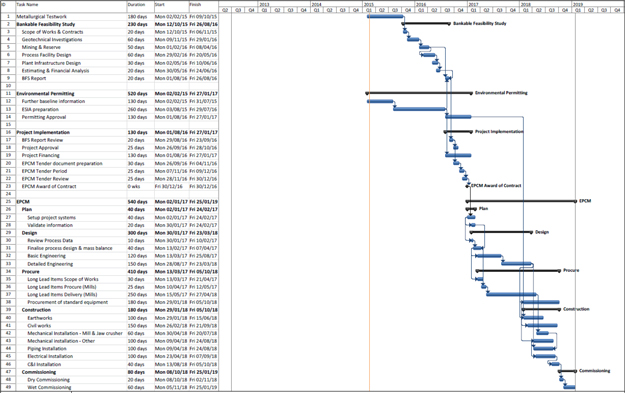
Figure 24-1 Norra Kärr Implementation schedule
 |  |
| | Prefeasibility Study - NI 43-101 - Technical report for the Norra Kärr Rare
Earth Element Deposit - 0465-RPT-014 Rev 0 |
| Section 25 | Interpretation And Conclusions |
GBM considers that the Norra Kärr project has fulfilled its purpose of demonstrating, to a reasonable degree of confidence, the potential to cost effectively and profitably mine and process the REE deposit.
No fatal flaws at this stage of project development have been identified, in terms of mineral resource, process, waste management, logistics and environmental impact.
The DCF model gave a robust result of, a post-tax NPV of USD 312.7 M and an IRR of 20 %. This result reflects a technically and economically feasible project, which should lead to further investment and development.
The Norra Kärr deposit is a zoned agpaitic, peralkaline, nepheline syenite which hosts REO mineralisation in the form of the complex zircon-silicate mineral eudialyte. The Norra Kärr complex outcrops at surface and the intrusive body has a strike length of approximately 1 300 m and a width of 450 m making it potentially an attractive target for open pit mining.
Tasman has carried out an extensive exploration programme comprising geological mapping, geophysical surveys, structural mapping and has drilled 119 surface diamond drill holes totalling 20 420 m. Drill holes have generally been drilled on east-west section lines spaced 50 m apart and inclined approximately 50° to the east. WAI is of the opinion that the spatial distribution of the drilling coupled with the high level of geological logging and mapping has robustly defined the extents, structure and lithologies of the Norra Kärr deposit.
The risk of their being a different interpretation to the geological model or to the morphology of the deposit is low. Drill holes are sufficiently spaced to allow WAI to evaluate spatial continuity of grades through variography, with WAI able to produce defined variogram models.
A robust QA/QC programme has been implemented by Tasman to ensure the integrity of the sample data. WAI has reviewed the QA/QC results and is of the opinion that the sample data is both accurate and precise and the risk of biased samples affecting the Mineral Resource estimate is low.
WAI has produced a Mineral Resource estimate in accordance with the CIM Code (2010 (3)) based on a geological model with the domains defined by geological logging and elemental assay ratios. WAI has undertaken a detailed variographic analysis of the sample data for each element and host lithotype. Based on the variography a QKNA analysis has been undertaken allowing WAI to derive the optimal block sizes and search parameters in the grade estimation. WAI has classified the Mineral Resources at Norra Kärr as “Indicated” reflecting the high confidence in the quality of the sample data and the geological continuity. The limitation of the classification to “Indicated” reflects that whilst
 |  |
| | Prefeasibility Study - NI 43-101 - Technical report for the Norra Kärr Rare
Earth Element Deposit - 0465-RPT-014 Rev 0 |
grade continuity is well demonstrated along strike the spacing of drill holes down dip is only sufficient to correspond to the variogram range.
WAI is of the opinion that the Mineral Resource is robust and based on sound geological and sample data with the grade estimates representative of the sample data.
The result of open pit optimisation and design has shown that the deposit is highly suited to open pit mining. The deposit’s bulk nature, expanse, and favourable geotechnics support the open pit design. Existing drilling has shown a fault zone to the south-east, however this has been taken into account within the geotechnical study and resulting open pit design.
The economics of supporting an open pit design are also favourable, considering the relative low cost of mining and the high USD/tonne value of the ore make open pit mining the favoured choice for extraction.
Through open pit optimisation, geotechnical assessment, loss/dilution study, and mine engineering the project has shown sufficient confidence in the modifying factors to be able to demonstrate the conversion into a mining reserve. It is highlighted that onlyProbable category Mineral Reserves are issued, this is due to available Mineral Resource category rather than confidence of mining modifying factors.
The investigation has shown the deposit generally has a very high rock strength with defined structural jointing, in the form of a broad orthogonal joint pattern and foliation trend, which, due to the high rock strength is a preferential weakness plane.
Owing to the rock strength and geometry of the joint sets, the limiting factor for the pit design has been based on structural failures at the bench level scale of design. Bench geometry in order to minimise kinematic failures has dictated the overall slope angles. The current bench design aimed to use the critical joint plane as the bench face angle resulting in the removal of kinematic failures. Operational this means the bench faces will need to use care when blasting final pit limits, ideally with pre-splits and scaling to engineer the contact with joint dip. This will also mean the bench design will need to follow variations in trend and dip with the joint plane where it migrates.
The investigation also took note of a known fault to the south-east, as part of the investigation, using data supplied from site geologists; a wireframe was generated for a rough fault trend that will be used for further pit design. Reviewing numerical modelling around the fault, WAI recommends benching or
 |  |
| | Prefeasibility Study - NI 43-101 - Technical report for the Norra Kärr Rare
Earth Element Deposit - 0465-RPT-014 Rev 0 |
de-coupling areas of the fault, as the modelling highlighted potential high risk areas associated with proximity to the fault.
The western pit wall was also highlighted by the geotechnical drilling program as having a comparably poorer rock mass quality, with the drilling indicating poor RQD areas that could in interpolated as being isolated or part of large scale structure. The assessment has considered the poor RQD areas only during whole slope analysis. The general trend of the deposit means any structures would be favourably orientated, but this is an area where further work is recommended, ideally with a trial put or slope to confirm on a larger scale
| 25.3 | Environmental and Community |
Some environmental baseline information is available particularly for the area of the exploitation concession. However there are still many information gaps. In preparation for the future environmental permit application, a number of field studies and other investigations such as noise and dust estimation are likely required to be carried out.
Issues and concerns related to water are likely the most important environmental issue. Much of the stakeholder concern is related to fears regarding impacts on water, particularly on Lake Vättern. The watercourses potentially affected by the project are sensitive and have high nature value. The small streams currently located within the footprint flow into Lake Vättern through Natura 2000 sites. The receiving watercourse Adelövån flows away from Lake Vättern, but also on that route there are important and sensitive water bodies, including the next lake downriver of the project site, Lake Noen.
The importance of all these waters cannot be overstated. Strict management measures are likely to be required to be planned and implemented to ensure no significant deterioration of any of these watercourses is caused. Golder considers it most likely that an environmental permit will be granted to the project only after it can be demonstrated that no significant harm will be caused to Lakes Vättern or Noen. The current plan is to discharge all water coming into contact with the mining away from Lake Vättern. The predicted maximum flow rates are very high compared to the natural flow rate in the receiving watercourse, the stream Adelövån. Discharge will be controlled to coincide periods of highest discharge with highest natural flow. Nevertheless based on the current plan the discharge from the project would form a considerable portion of the stream flow.
The exact requirements for treatment of discharged water will be determined in the later design stages of the project. A detailed water management plan will need to be developed in the later design stages of the project, based on sufficient data on all factors affecting water quality as well as quantity.
Biodiversity values related to certain species and habitats have been identified in the area impacted by the project. None of these are strictly protected with the exception of the great crested newt. It is
 |  |
| | Prefeasibility Study - NI 43-101 - Technical report for the Norra Kärr Rare
Earth Element Deposit - 0465-RPT-014 Rev 0 |
expected that a compensation program for the great crested newt is likely to be required in environmental permitting.
There are data gaps. While Golder currently expects that these future investigations are unlikely to reveal such values that would become obstacles to project development altogether, it is possible that further mitigation and management measures may be required based on the results of such investigations.
Should the project go ahead, a considerable number of jobs are expected to be created particularly in the construction phase but also on a more permanent basis during operations. It is expected that the majority of the workforce would likely live in the nearby municipalities, and also pay their taxes there.
Some anti-mining activists have voiced their objections towards the project. Based on experience from other projects, and backed up by surveys undertaken in the local area, it is expected that there is much less opposition among the local people than would seem based on the public discussion only. In the two surveys undertaken during 2014, around 60 % of respondents were positive towards the mine assuming no adverse environmental impact is caused.
 |  |
| | Prefeasibility Study - NI 43-101 - Technical report for the Norra Kärr Rare
Earth Element Deposit - 0465-RPT-014 Rev 0 |
| Section 26 | Recommendations |
Based on the outcomes of the PFS, it is recommended that consideration be given by Tasman to continue with further development and characterisation and optimisation of the process and conduct a more advanced technical and economic study to Feasibility level. This work should include the demonstration and optimisation of the beneficiation, hydrometallurgical and waste treatment systems in a continuous campaign.
The open pit optimisation, using the parameters listed in this report, achieved a maximum optimised pit shell containing 84.5 Mt of ore, at a 0.71 strip ratio. The current designed pit produces 23.6 Mt of ore, which means economic material is still within the optimised pit shell, and therefore there is significant potential beyond the current design. The larger amount of material within the optimised pit shell, out of the design shell, means that the potential for increasing the mine production should be considered.
The mining engineering for the Norra Kärr pit design has been constrained primarily through blasting conditions. The maximum fragmentation size of 600 mm has led to a reduced blasting spacing, with increased drilling, mining drilling and blasting costings may be reduced if a larger fragmentation size could be targeted.
In addition the location of the E4 highway to the west has also constrained the design. WAI is of the opinion that appropriate management and design of blasting can reduce flyrock risk. It is recommended that trial blasting and a study be conducted to optimise the design.
The south-east fault is known to contain water and has significant recharge, the position of the lower benches in the vicinity of the fault are recommended to have drain holes to prevent build-up of ground water pressures in the slope high walls, similar sumps should be located nearby.
It is recommended during excavation a review by bench or domain on the suitability of design to in-situ conditions is completed, with a view to either slope geometry modification or additional support if required i.e. a minor revision to the bench face angle, rather than undercutting the slope and exposing loose blocks. Similarly final pit wall blasting of pre-splitting or cushion blasting is recommended to reduce the rock mass damage into the final slopes and enable a split to a joint plane.
It is recommended that development be conducted using an observational method of design, whereby feedback from monitoring and mapping are incorporated into a review of the design to ensure it is suitable for purpose.
 |  |
| | Prefeasibility Study - NI 43-101 - Technical report for the Norra Kärr Rare
Earth Element Deposit - 0465-RPT-014 Rev 0 |
In the case of the project, a trial slope to test and monitor the effect of the design on a small scale should be undertaken to ensure that the designs are appropriate, even conducting an over steepened trial area that can be used for back analysis could be considered.
Also as highlighted in the conclusions, the effect of small scale faulting has not been considered for whole slope or bench scale stability. Therefore, an appropriate logical search for faults during excavation or further drill investigations is recommended. The search needs to be carried out before and during excavation with suitable procedures and management of implications. Geophysics could be considered as a good remote sensing tool for initial studies.
| 26.1.2 | Mine Waste Material |
Site investigations should also be undertaken to identify the geotechnical and hydrogeological conditions at the proposed waste dump site. The available topographic survey data covering the waste dump footprint should be checked and updated if necessary.
| 26.2 | Tailings Storage Facility |
More technical information is needed to further progress the TSF design. Specifically, testwork should be undertaken on the combined tailings stream for geochemical and geotechnical characterisation purposes. A topographic survey should be undertaken for future engineering modelling and design work. Geotechnical site investigations should be undertaken at key locations – i.e. the main embankment structures, and areas of cut and fill. Hydrogeological site investigations should be undertaken to characterise the aquifers at the tailings site.
| 26.3 | Metallurgy and Process |
A significant amount of the operating costs and land usage is devoted to the treatment and storage of solid waste and effluent streams generated by the process. Ongoing testwork should attempt to address this issue by undertaking the following investigations:
| · | characterisation of the waste streams; |
| · | investigate opportunities to valorise waste streams; and |
| · | investigate opportunities to minimise waste streams. |
The confidence in the process feasibility can be improved with the continuous demonstration and optimisation of the process flowsheet. This process will look to:
| · | confirm the operability of the process; |
| · | confirm mass and energy balance for the process; and |
| · | Optimisation of process variables. |
 |  |
| | Prefeasibility Study - NI 43-101 - Technical report for the Norra Kärr Rare
Earth Element Deposit - 0465-RPT-014 Rev 0 |
The Norra Kärr ore has very low level of uranium and thorium however a detailed radionuclide deportment study on the optimised process is required to determine the fate of all deleterious elements and ensure they are properly managed.
Most of the process development testwork has been conducted on composites. Although this is satisfactory for a PFS domain variability testing should be conducted to confirm the reproducibility of the results generated to date.
| · | Comminution testing to assess work properties and liberation behaviour of the composites employing the planned comminution and classification equipment; and |
| · | Magnetic separation testing to improve the modal mineralogical characteristics of the magnetic concentrate. |
| 26.4 | Environmental and Community |
In order to be able to start construction and operations at the mine, Tasman will need an environmental permit.
| 26.4.1 | Further Studies Expected to be Required |
In order to prepare the environmental permit application, including the required EIA, further studies are needed. Studies that are likely to be required include, but are not necessarily limited to, the following:
Full characterisation of all tailings streams will be needed in addition to the waste rock characterisation already available. Testing of the combined tailings in representative quantities to determine the expected quality of water discharged from the TSF. The results of the above mentioned studies should be utilised to steer design of potentially required management measures in the later design stages of the project. Ultimately the requirements for any water treatment, containment structures etc. will be set by the environmental permitting process.
Baseline data on the flow rate, flow patterns and water level in the upper reaches of the receiving stream Adelövån are currently not available. There is only the modelled flow data for the entire catchment available from VISS (Swedish Water Information System). Data for the stream near the discharge point and downriver from there will be needed in the later stages of the project to ensure the capacity of the channel to take in all discharged water and for the design and permitting of potentially needed channel works.
 |  |
| | Prefeasibility Study - NI 43-101 - Technical report for the Norra Kärr Rare
Earth Element Deposit - 0465-RPT-014 Rev 0 |
The longer the time series, the better baseline data is obtained. A minimum of one years’ data is recommended. Therefore Golder recommends that monitoring of flow rate in the channel and water level in the Gransjön and some of the other small lakes / ponds along the course of the Adelövån stream, as well as in the Narbäcken, Stavabäcken and Gyllingesjön be set up. Continuous measurement would be best, or alternatively several measurement rounds should be spread over all seasons to capture at least some of the seasonal variation.
Based on current information it is estimated that the watercourses in and around the Project area, including the Lake Gyllingesjön, are in continuity with groundwater table. The impact of drawdown resulting from pit drainage has not been investigated in detail in the PFS stage. It is recommended to investigate predicted impacts on water level of the lake, taking into consideration also that some of the precipitation into the lake’s current catchment area is planned to be directed elsewhere.
In order to predict the impacts on surface water at the level required for environmental permitting, it is likely that further studies will be required. Such requirements could be related to:
| · | More detailed estimate of the quality of the seepage water from the open mine pit (acid formation, expected fluoride concentrations, leaching potential, estimated concentrations of explosive residuals); |
| · | Seepage water from mine pit, waste rock dump and surface water runoff: is there need for treatment; |
| · | Estimate on the leaching of metals and fluoride from the open pit and waste rock; |
| · | Based on the expected discharge water quality, it should be ensured that baseline data concerning all key substances concerned is available. If this is not the case, it would be recommended to conduct further sampling; |
| · | Stratification and hydrodynamics of receiving lakes; |
| · | Sediments in all receiving water courses; |
| · | It is recommended that a database be created to store all the raw data from the baseline studies. |
Furthermore risk assessment related to surface water may be required related to the following:
| · | Erosion damage (downstream in channel); |
| · | Flood risk analysis along the Adelövån (taking into account the channel works potentially to be undertaken); and |
| · | Sufficiency of flood storage capacity in more detail. |
 |  |
| | Prefeasibility Study - NI 43-101 - Technical report for the Norra Kärr Rare
Earth Element Deposit - 0465-RPT-014 Rev 0 |
A more detailed hydrogeological study should be performed before the environmental permit application. In particular, the hydraulic properties of the soil cover and potential impact on the groundwater at the proposed location of the TSF needs further assessment. The study should include an inventory of water supply and geoenergy wells in the surroundings of the proposed tailings management facility with clarification ponds and an extended inventory of wells in the area that may be affected by the mining activities that may be missing in the public records. The hydrogeological study should also investigate what protective measures related to groundwater may be needed.
Ecology field studies encompassing the entire project footprint and areas affected by project infrastructure will likely be required for environmental permitting. The areas that have so far only been briefly visited should also be part of a more comprehensive ecology field study.
There are a number of small open water ponds in various parts of the Project area, including e.g. the northern part of the TSF, which appear potentially suitable for the great crested newt (Triturus cristatus). Therefore a newt inventory encompassing all the ponds affected by the project should be carried out to ensure all newt populations in the area are known prior to any works being undertaken.
There are a number of Natura 2000 sites and other protected areas within a few kilometres distance of the project area. Impact studies, particularly Natura 2000 Appropriate Assessments will likely be required to demonstrate that there will be no adverse impact on site integrity caused for any Natura 2000 areas located near the project footprint as well as downstream from the water discharge point.
| 26.4.1.6 | Cultural Heritage |
The archaeology inventory undertaken at and around the exploitation concession area has identified a few targets for which a phase 2 archaeology study is required before actions disturbing the remains can be undertaken.
Furthermore, a baseline archaeology inventory should be carried out for the entire area of the project footprint. This further study may indicate further targets also warranting Phase 2 archaeology studies.
| 26.4.1.7 | Noise, Vibrations and Dust Impacts |
Considering that there are a number of dwellings located close to the project footprint, it is expected that in order to be able to assess impacts at the level required for environmental permitting, dispersal modelling of noise and/or dust emissions may need to be undertaken. Furthermore impact of ground
 |  |
| | Prefeasibility Study - NI 43-101 - Technical report for the Norra Kärr Rare
Earth Element Deposit - 0465-RPT-014 Rev 0 |
vibrations on existing buildings will need to be assessed. Monitoring of all of these impacts will likely to be required.
| 26.4.1.8 | Landscape and Visual |
A landscape study and assessment of visual impacts, possibly including production of photomontages and other visualisation, may be required.
| 26.4.1.9 | Viable Options for Energy Production |
The base case solution for production of required heat energy for the PFS design stage is a diesel boiler plant. However more environmentally friendly options are available in the Swedish market. It is recommended that these options are reviewed to identify potential and then preferable options. Such a study should take into consideration operability, cost and environmental impact and particularly look into combination of various energy sources such as bio fuel, procured electricity and geothermal energy.
| 26.4.2 | Further Needs for Design and Planning |
The further studies briefly described above should be used to steer design and planning of the project in the future stages of development. Based on current knowledge and plans, the following plans and programmes are recommended to be developed, but there may be need for more.
| 26.4.2.1 | Preparation of Environmental Permit Application |
It is recommended to start the preparation of the environmental permit application to be submitted to the Land and Environmental Court in good time. The preparation, including the various studies required, the environmental impact assessment and the public hearing phase can take several years. The permitting of various related infrastructure in addition to the actual mining operation and processing can be included in the same permit application.
The application and the required appendixes, including the Technical Description TD and Environmental Impact Assessment EIA, must be prepared in Swedish language. Certain Swedish requirements such as the impact classification of dams (GruvRidas) should also be included.
A rough cost estimate for the preparation of the permit application including the TD and EIA and the related studies would be about 740 000 USD, divided as follows:
| · | 350 000 USD for required further studies |
| · | 250 000 USD for preparation of the application, including TD and EIA |
| · | 140 000 USD for the refined plans, risk classifications etc. required by Swedish legislation and practice such as waste management plan, refined closure plan, GruvRidas etc. |
 |  |
| | Prefeasibility Study - NI 43-101 - Technical report for the Norra Kärr Rare
Earth Element Deposit - 0465-RPT-014 Rev 0 |
| 26.4.2.2 | Detailed Water Management Plan |
In the later design stages a more detailed water management plan should be developed. The plan should be based on more data on water balances, developed to a higher level of detail than currently (e.g. daily time-step) and flow rates as well as factors affecting water quality, particularly characterisation of all tailings streams. The plan should include consideration of at least:
| o | Flow rates towards Adelövån |
| o | Capacity of the Adelövån system to take in all the water with no aggravation of flood risk |
| o | Ensuring sufficient flow in the other watercourses |
| o | Potential need for treatment of some or all water streams |
| o | Design of a cost-efficient treatment approach (e.g. treatment of certain streams only vs. treatment of the entire volume for environmental discharge) |
| · | Stormwater management plan, including contingency planning for heavy rainfall episodes |
| · | A need for additional water storage capacity for water pumped from the pit has been identified in the PFS-level Site Wide Water Balance. The storage capacity will be provided in the final design based on further information on realistic flow rates on site. The water management plan should include measures to separate potentially contaminated water from clean water to minimise the need for treatment prior to disposal and maximise the potential discharge options such that the impact on the surface water environment will be mitigated |
| · | Considering the high flow rates of discharge water in relation to the receiving watercourse, it is recommended that all options to reduce amount of water that needs to be considered as contact water should be investigated to limit the need of discharge where possible. Technical and management solutions are likely to be available. |
| 26.4.2.3 | Other mitigation measures and/or compensation programs |
In the future design stages of the project, and ultimately in the environmental permit, further needs for mitigation measures and/or compensation may be identified. Such could be related to e.g. compensation of impacts to some other species besides the great crested newt, or mitigation such as noise and visibility screening. Based on current information such requirements are considered unlikely but the need should be revisited when more information is available.
 |  |
| | Prefeasibility Study - NI 43-101 - Technical report for the Norra Kärr Rare
Earth Element Deposit - 0465-RPT-014 Rev 0 |
| 26.4.2.4 | Health and Safety |
Health and safety considerations have been considered in the design at a high level reflecting the preliminary design level suitable for PFS stage of project. In the future stages of design, all relevant health and safety risks and issues should be identified in good time and taken into account in the design and planning of all operations. Various types of risk assessments are likely to be required in the further project development stages. Advance planning to avoid and mitigate risks is usually the safest as well as the most cost-effective option.
 |  |
| | Prefeasibility Study - NI 43-101 - Technical report for the Norra Kärr Rare
Earth Element Deposit - 0465-RPT-014 Rev 0 |
1.Repeal and Replacement of National Instrument 43-101 Standards of Disclosure for Mineral Projects, Form 43-101F1 Technical Report, and Companion Policy 43-101CP, Supplement to the OSC Bulletin.The Ontario Securities Commission. 14 (Supp-2), Toronto : Published under authority of the Commission by Carswell, a Thomson Reuters business., 24 June 2011, Vol. 34. NI 43-101.
2.Canadian Institute of Mining, Metallurgy and Petroleum. CIM Standards for Mineral Resources and Mineral Reserves. [Online] 27 November 2010. http://web.cim.org/standards/.
3. CIM Definition Standards for Mineral Resources and Mineral Reserves [Online].CIM.[Online] 2010. http://web.cim.org/standards/.
4.Wardell Armstrong International.Report on Tailings Storage Facility, Norra Karr Rare Earth Project, Sweden.2014.
5.Pincock, Allen, and Holt (PAH).NI43-101 Technical Report, Norra Kärr REE – Zirconium Deposit, Gränna, Sweden.2011.
6.Erik Jonnson, Nils Jonsson, Karin Högdahl, Ingmar Lundström and Per Nysten (ed).The Norra Kärr REE-Zr Project and the Birth Place of Light REEs. .s.l. : SWE3.
7.Christensson, Ulf.Charactersing the Alteration of the Contact to the Norra Kärr Alkaline Complex, Southern Sweden.s.l. : University of Göteborg, 2013.
8.Appelquist, Karin.Proterozoic Crustal Evolution in Subcentral Fennoscandia.s.l. : Univeristy of Göteborg. , 2010.
9.Andersson, J, et al., et al.The Sveconorwegian orogen of southern Scandinavia: setting, petrology and geochronology of polymetamorphic high-grade terranes.s.l. : 33 IGC excursion No 51, 2008.
10.Development of Nepheline Syenites in Rift Zones - Information from three Rift Complexes.Sørensen, H. s.l. : Geolines, 2003, Vol. 15, pp. 140-146.
11.Christensen, U.Characterising the alteration of the contact to the Norra Karr Alkaline Complex, Southern Sweden, B.Sc Thesis.s.l. : University of Goteborg, 2013.
 |  |
| | Prefeasibility Study - NI 43-101 - Technical report for the Norra Kärr Rare
Earth Element Deposit - 0465-RPT-014 Rev 0 |
12.Three Compositional Varieties of Rare-Earth Element Ore: Eudialyte-Group Minerals from the Norra Kärr Alkaline Complex, Southern Sweden.Sjöqvist, A.S.L., Cornell, D.H., Andersen, T., Erambert, M., Ek, M. and Leijd, M. 1, s.l. : Minerals, 2013, Vol. 3, pp. 94-120.
13.Rankin, L.R.Structural setting of the Nora Kaar Intrusive Complex, Central Sweden. Geointerp Confidential Report 2011/2014 for Tasman Metals Ltd, Vancouver.2011.
14.US Department of Energy. REE Criticality Matrices. [Online] http://energy.gov/sites/prod/files/edg/news/documents/criticalmaterialsstrategy.pdf.
15.Laznicka, P.Giant Metallic Deposits; Future Sources of Industrial Metals.2006. pp. 466,467.
16.Ashley, P.M.Petrographic report of five rock samples from Norra Kärr, Jonkoping region, Sweden.2009.
17.Wardell Armstrong International.Norra Kärr Mining Loss / Dilution Study.2014.
18.J., Roth.A model for the determination of flyrock range as a function of shot conditions.s.l. : Los Altos, CA: Management Science Associates. U.S. Bureau of Mines contract J0387242., 1979.
19.Holman, P.Caterpillar Haul Road Design and Management.s.l. : Caterpillar Global Mining, 2006.
20.Gates, P., Horlacher, C.F. and Reed, G.Amended and Restated Preliminary Economic Assessment NI43-101 Technical Report for the Norra Karr (REE-Y-Zr) Deposit, Gränna, Sweden.s.l. : Runge Pincock Minarco, 2013.
21.Golder Associates AB.Site Localisation Study – Draft.2014.
22.Minarco, Runge Pincock.Amended and Restated Preliminary Economic Assessment NI43-101 Technical Report for the Norra Kärr (REE-Y-Zr) Deposit, Gränna, Sweden.July 2013.
23.GBM Minerals Engineering Consultants Limited .Tailings Composition Memo.23 July 2014.
24.Golder Associates.Acceptability of Raffinate Waste Water Stream as Discharge to Environmental Receptor.22 August 2014.
25.Wardell Armstrong International.Geotechnical and Mining Site Visit Report, Norra Kärr Rare Earth Project, Sweden.June 2014.
26. —.Spillway design, hyrdological analysis report, Norra Kärr Rare Earth Project, Sweden.October 2014.
 |  |
| | Prefeasibility Study - NI 43-101 - Technical report for the Norra Kärr Rare
Earth Element Deposit - 0465-RPT-014 Rev 0 |
27.BSI.Methods of test for soils for civil engineering purposes .1990. BS1377 Part 2 Classification Tests.
28.GBM Minerals Engineering Consultants Limited.Process Design Criteria – 0465-SPC-007 Rev0.31 October 2014.
29.iO global Solutions Ic. .Norra Kärr Regional Environmental Assessment.2012.
30.Naturvatten.Miljötillstånd och naturvärden i Gyllingesjön, Stavabäcken och Narbäcken 2011-2013.2013.
31.Sweco Environment AB.Ytvattenprovtagning för kemisk analys vid Norra Kärr (Results from surface water sampling).2014.
32.VISS), VISS Vatteninformationssystem Sverige (Swedish Water-Information system. [Online] http://www.viss.lansstyrelsen.se/.
33.Pro Natura.Naturvärdesinventering. Underlag inför ansökan om bearbetningskoncession för jordartsmetaller (Inventory of nature values).2012.
34.Ontario Securities Commission. Report on Staff's Review of Technical Reports by Ontario Mining Issuer.OSC Staff Notice 43-705.27 June 2013.
35.Adamson, O. J. The Petrology of the Norra Kärr District. An Occurrence of Alkaline Rocks in Southern Sweden. 1944, Vol. 66, pp. 112-25.
36.(n.d.), Bergsstaten. The Mining Inspectorate of Sweden [Online].Geological Survey of Sweden.[Online] http://www.sgu.se/en/mining-inspectorate/.
37. Mineral Profile - Rare Earth Elements [Online].British Geological Survey.[Online] 2011. http://www.bgs.ac.uk/mineralsUK/statistics/mineralProfiles.html.
38.(n.d.), GeoNord. A Guide to Mineral Legislation and Regulations in Sweden [Online]. [Online] http://www.geonord.org/law/minlageng.html.
39.Seismic hazard assessment for Central, North and Northwest Europe: GSHAP Region 3.G, Grünthal. 6, s.l. : Annali di Geofysica, 1999, Vol. 42, pp. 999-1011.
40.The Transscandinavian Igneous Belt (TIB) in Sweden: a review of its character and evalution. .Högdahl, K., Andersson, U.B. & Eklund, O. (eds.), Andersson, U.B. et al,. Special Paper 37, s.l. : Geological Survey of Finland, 2004.
 |  |
| | Prefeasibility Study - NI 43-101 - Technical report for the Norra Kärr Rare
Earth Element Deposit - 0465-RPT-014 Rev 0 |
41.Sveriges Geologiska Undersökning. Guide to Mineral Legislation and Regulations in Sweden [Online]. [Online] www.sgu.se..
42.(n.d.), World Weather and Climate Information. Average weather and climate in Sweden [Online]. [Online] http://www.weather-and-climate.com/average-monthly-Rainfall-Temperature-Sunshine-in-Sweden..
43.Pelagia Miljökonsult AB. .Naturvärdesinventering och beskrivning av fem alternative sandmagasin vid Norra Kärr / Gränna, 2012.2012.
44.Pelagia Miljökonsult AB.Naturvärden vid Norra Kärr / Gränna med omnejd. .2012.
45.Östra Vätterbranterna. Biosfärområde Östra Vätterbranterna (Biosphere area). [Online] http://www.ostravatterbranterna.se/.
46.Länsstyrelsen. Bevarandeplaner för Natura 2000 områden i Jönköpings län (Conservation plans for Natura 2000 areas in County of Jönköping). [Online] http://www.lansstyrelsen.se/Jonkoping/Sv/djur-och-natur/skyddad-natur/natura-2000/Pages/bevarandeplaner.aspx.
47. —. Naturreservat i Jönköpings län (Nature reserve areas in County of Jönköping). [Online] http://www.lansstyrelsen.se/JONKOPING/SV/DJUR-OCH-NATUR/SKYDDAD-NATUR/NATURRESERVAT/Pages/default.aspx.
48. —. Bevarandeplaner för Natura 2000 områden i Östergötland (Conservation plans for Natura 2000 areas in County of Östergötland). [Online] http://www.lansstyrelsen.se/OSTERGOTLAND/SV/DJUR-OCH-NATUR/SKYDDAD-NATUR/NATURA-2000/BEVARANDEPLANER-KOMMUNVIS/Pages/beva.
49.Golder Associates.Detaljerad beskrivning av de sällsynta jordartsmetallerna, Zn, Pb, U, Th, Y och Sc (Description of REEs).2012.
50.ANSTO Minerals.Technical Note AM_TM_2014_27_03 Norra Kärr Project – Process Development and Radioactivity Deportment.2014.
51.Ödeén, A.Ödeén, A. Arkeologisk utredning etapp 1 inför bearbetningskoncessionsansökan, Gränna och Ödeshög socken i Jönköping och Ödeshög kommun, Jönköping och Östergötlands län (An archaeological survey).s.l. : Jönköpings Läns Museum, 2012.
 |  |
| | Prefeasibility Study - NI 43-101 - Technical report for the Norra Kärr Rare
Earth Element Deposit - 0465-RPT-014 Rev 0 |
52.Tyréns AB.Gruvdrift i Norra Kärr – Effekter på arbetsmarknad och näringsliv (Effects on labour market and economy).2012.
53.NU! Nordiska Undersökningsgruppen AB.Norra Kärr – Tasman Metals AB 2013 Rapport (Survey results).2013.
54.Jönköpings Kommun. Översiktsplan 2002 (Municipal Overview Plan 2002). [Online] 2002.
55.WSP Sverige AB.Combiterminal Hubbarps indutriområde Tranås (Transhipment Terminal for acid trains, Tranås).2014.
56.ITASCA Consultants AB.Utlåtande avseende jordskalv (Mine’s predicted impact on seismic risk), Norra Kärr.2012.
57.Veolia.Water treatment package. ..2014.
58. —.Water Treatment Package.2014.
59.Golder Associates AB. .Miljökonsekvensbeskrivning - Bearbetningskoncession i Norra Kärr.2012.
60.Karlsson, T.Större vattensalamander (Triturus cristatus) i Östergötland. Sammanställning av inventeringar 1994-2005 och övriga fynd I Östergötlands län. .s.l. : Länsstyrelsen Östergötland , 2006.
61.Golder Associates AB.Materialkaraktärisering av gråberg.2013.
62.Ramböll Management Consulting.Undersökning av genomförandetider och framtida resursbehov för project med miljöpåverkan.2012.
63.Jönköpings-Posten. . Jönköpingsborna vill ha gruva i Norra Kärr - Ny opinionsundersökning om gruvan. [Online] [Cited: 5 9 2014.] http://www.jonkopingsposten.se/artikel/31011/jonkopingsborna-vill-ha-gruva-i-norra-karr .
64.Sveriges Radio. Undersökning: Miljön går före gruvdrift. . [Online] 18 8 2014. http://sverigesradio.se/sida/artikel.aspx?programid=91&artikel=5939917.
 |  |
| | Prefeasibility Study - NI 43-101 - Technical report for the Norra Kärr Rare
Earth Element Deposit - 0465-RPT-014 Rev 0 |
| APPENDIX A. | Qualified Persons CERTIFICATES |
CERTIFICATE OF QUALIFIED PERSON
MICHAEL JOHN SHORT
As the individual who has co-authored or supervised the preparation of sections of the Technical Report prepared for Tasman Metals Ltd (Issuer) entitled “Prefeasibility Study - NI 43-101 - Technical report for the Norra Kärr Rare Earth Element Deposit” dated effective 13 January 2015 (Technical Report), I hereby certify that:
| 1. | I am a Chartered Engineer and the Managing Director of GBM Minerals Engineering Consultants Limited (GBM) of Regal House 70 London Road, Twickenham, Middlesex, TW1 3QS, England. |
| 2. | I graduated with a Bachelor of Engineering in Civil Engineering from the University of New South Wales, Australia in 1975. I am a Chartered Engineer (CEng) registered with the Engineering Council UK and a Fellow of the Institute of Materials, Minerals and Mining (FIMMM). I am a Chartered Professional (CP) and a Fellow of the Australasian Institute of Mining and Metallurgy (FAusIMM). I am a Chartered Professional Engineer (CPEng) and Fellow of Engineers Australia (FIEAust). I have been working in the engineering profession continuously since 1975 and have had experience in metallurgy, process design and engineering, plant operations and management. |
| 3. | I have read the definition of “Qualified Person” set out in the National Instrument 43-101 (NI-43-101) and certify that by reason of my education, affiliation with a professional association (as defined in NI 43-101) and past relevant work experience, I fulfil the requirements to be a “Qualified Person” for the purposes of NI 43-101. |
| 4. | GBM professionals have visited the site from 23rd to 26th June 2014. |
| 5. | I have authored or supervised the work carried out by other GBM professionals for GBM’s contribution to the Technical Report, and take responsibility for Sections 1, 2, 3, 4, 6, 13, 17, 18, 19, 21, 22, 23, 24, 25, 26 and 27. |
| 6. | I am independent of the Issuer applying the test set out in Section 1.5 of NI 43-101. |
| 7. | I, and GBM, have had no prior involvement with the project. |
| 8. | I have read NI 43-101, and the sections of the Technical Report for which I am responsible, as stated above, have been prepared in compliance with NI 43-101 and Form 43-101F1. |
| 9. | To the best of my knowledge, information, and belief, as of the date of this certificate, the Technical Report contains all scientific and technical information that is required to be disclosed to make the Technical Report not misleading. |
Dated this February 27, 2015, London, United Kingdom.
| /s/ Michael John Short | |
| Michael John Short, BE (Civil), CEng FIMMM, FAusIMM(CP), FIEAust CPEng | |
Qualified Person
CERTIFICATE OF QUALIFIED PERSON
Mark Robert Burke Mounde
As the individual who has co-authored or supervised the preparation of sections of the Technical Report prepared for Tasman Metals Ltd (Issuer) entitled “Prefeasibility Study - NI 43-101 - Technical report for the Norra Kärr Rare Earth Element Deposit” dated effective 13 January 2015 (Technical Report), I hereby certify that:
| 1. | I am a Chartered Engineer, Technical Director of Wardell Armstrong International, 3rd Floor, 46 Chancery Lane, WC2A 1JE, UK. |
| 2. | I graduated with a Bachelor of Engineering in Mining Engineering from the Camborne School of Mines, Camborne, Cornwall UK 1993. I am a member of the Institute of Materials, Mining and Metallurgy, Associate Member of the Southern Africa Institute of Mining and Metallurgy and Associate Member of Camborne School of Mines. I have practised my profession as a Mining Engineer for the past 23 years with worldwide experience in precious, base, coal and industrial minerals. |
| 3. | I have read the definition of “Qualified Person” set out in the National Instrument 43-101 (NI-43-101) and certify that by reason of my education, affiliation with a professional association (as defined in NI 43-101) and past relevant work experience, I fulfil the requirements to be a “Qualified Person” for the purposes of NI 43-101. |
| 4. | I have personally visited the Norra Kärr site in 23 – 26 June 2014. Additionally Wardell Armstrong International professionals have visited the site in 7 – 13 May 2014. I have authored or supervised the work carried out by other Wardell Armstrong International professionals for Wardell Armstrong International’s contribution to the Technical Report, and take responsibility for Sections 5, 15 and 16. |
| 5. | I am independent of the Issuer applying the test set out in Section 1.5 of NI 43-101. |
| 6. | I, and Wardell Armstrong International, have had no prior involvement with the project. |
| 7. | I have read NI 43-101, and the sections of the Technical Report for which I am responsible, as stated above, have been prepared in compliance with NI 43-101 and Form 43-101F1. |
| 8. | To the best of my knowledge, information, and belief, as of the date of this certificate, the Technical Report contains all scientific and technical information that is required to be disclosed to make the Technical Report not misleading. |
Dated this February 27, 2015, London, United Kingdom.
| /s/Mark Robert Burke Mounde | |
| Mark Robert Burke Mounde BEng (Min Eng), CEng, MIMMM | |
Qualified Person
CERTIFICATE OF QUALIFIED PERSON
Gregory Moseley
As the individual who has co-authored or supervised the preparation of sections of the Technical Report prepared for Tasman Metals Ltd (Issuer) entitled “Prefeasibility Study - NI 43-101 - Technical report for the Norra Kärr Rare Earth Element Deposit” dated effective 13 January 2015 (Technical Report), I hereby certify that:
| 1. | I am a Chartered Engineer and an associate consultant working for Wardell Armstrong International, 3rd Floor, 46 Chancery Lane, London WC2A 1JE, UK. |
| 2. | I graduated with a Bachelor of Science from the University of Cape Town, South Africa 1969 and with a Master of Science and a DIC from the Royal School of Mines, Imperial College of Science and Technology, London University in 1981. I am a member of the Institute of Materials, Mining and Metallurgy. I have practised my profession as a geologist for the past 45 years with worldwide experience in precious, base and the rare metals. |
| 3. | I have read the definition of “Qualified Person” set out in the National Instrument 43-101 (NI-43-101) and certify that by reason of my education, affiliation with a professional association (as defined in NI 43-101) and past relevant work experience, I fulfil the requirements to be a “Qualified Person” for the purposes of NI 43-101. |
| 4. | I have personally visited the Norra Kärr site in 7 – 13 May 2014. Additionally Wardell Armstrong International professionals have visited the site in 23 – 26 June 2014. |
| 5. | I have authored or supervised the work carried out by other Wardell Armstrong International professionals for Wardell Armstrong International’s contribution to the Technical Report, and take responsibility for Sections 6 – 12 and 14. |
| 6. | I am independent of the Issuer applying the test set out in Section 1.5 of NI 43-101. |
| 7. | I, and Wardell Armstrong International, have had no prior involvement with the project. |
| 8. | I have read NI 43-101, and the sections of the Technical Report for which I am responsible, as stated above, have been prepared in compliance with NI 43-101 and Form 43-101F1. |
| 9. | To the best of my knowledge, information, and belief, as of the date of this certificate, the Technical Report contains all scientific and technical information that is required to be disclosed to make the Technical Report not misleading. |
Dated February 27, 2015, London, United Kingdom.
| /s/Gregory Moseley | |
| Gregory Moseley, BSc, MSc, CEng, MIMMM | |
Qualified Person
CERTIFICATEOFQUALIFIEDPERSON
GarethDiggesLaTouche
Astheindividualwhohasco-authoredorsupervisedthepreparationofsectionsoftheTechnicalReportpreparedforTasmanMetalsLtd(Issuer)entitled“Prefeasibility Study-NI43-101-TechnicalreportfortheNorraKärrRare EarthElementDeposit”datedeffective13January 2015 (TechnicalReport), I hereby certify that:
| 1. | IamaCharteredGeologistandSeniorHydrogeologistandAssociateofGolderAssociates (UK)LtdofAttenboroughHouse,BrownsLaneBusinessPark,Stanton-on-Wolds,Nottinghamshire, NG125BL, UnitedKingdom. |
| 2. | Igraduated withaB.Sc.inGeologyandGeographyfromtheUniversityof Keelein1990,anM.Sc.inComputinginEarthSciencefromtheUniveristyof Keelein1991andanM.Sc.inHydrogeology,fromtheUniversityofBirminghamin1995.Ihaveapproximatly20yearsgeoscienceconsultingexperienceofwhichthelast15havebeenspentworkingintheextractive mineralssector |
| 3. | Ihave readthedefinitionof“QualifiedPerson” setoutintheNationalInstrument43-101(NI-43-101)andcertifythatbyreasonofmyeducation,affiliationwithaprofessionalassociation(asdefinedinNI43-101)andpastrelevantworkexperience, Ifulfiltherequirementstobe a“QualifiedPerson” forthepurposesofNI43-101. |
| 4. | IhavepersonallyvisitedtheNorraKärrsitein29and30September2014.AdditionallyGolder Associatesprofessionalshavevisitedthesitein19and20May2014. |
| 5. | IhaveauthoredorsupervisedtheworkcarriedoutbyotherGolder AssociatesprofessionalsforGolderAssociatesOy’scontributiontotheTechnicalReport,andtakeresponsibility forSections5and20. |
| 6. | IamindependentoftheIssuerapplyingthetestsetoutinSection1.5ofNI43-101. |
| 7. | Ihavehadnopriorinvolvementwiththeproject.GolderAssociatesAB(Sweden)havehadpriorinvolvementwiththeprojectonbehalfoftheIssuerasdescribedinthefollowingreports: |
| · | TechnicalReportentitled“AmendedandRestated PreliminaryEconomicAssessmentN143-101TechnicalReportfortheNorraKärr(REE-Y-Zr)DepositGränna,Sweden”,datedeffective:originalreprintdateMay11,2012,amendedandrestatedonJuly9,2013,ReportNo:DE-00215 |
| 8. | Ihave readNI43-101,andthesectionsoftheTechnicalReportforwhichIamresponsible,asstatedabove,havebeenpreparedincompliancewithNI43-101andForm43-101F1. |
| 9. | Tothebestofmyknowledge,information,andbelief,asofthedateofthiscertificate,theTechnical Reportcontainsall scientific and technicalinformationthat isrequiredtobedisclosedtomaketheTechnicalReportnotmisleading. |
Dated this February 27, 2015, London, United Kingdom.
/s/GarethDiggesLaTouche
GarethDiggesLaToucheBSc,MSc,FGS,CGeol,EurGeol
QualifiedPerson
 |  |
| | Prefeasibility Study - NI 43-101 - Technical report for the Norra Kärr Rare
Earth Element Deposit - 0465-RPT-014 Rev 0 |
| APPENDIX B. | WAI tailings DRAWINGS |

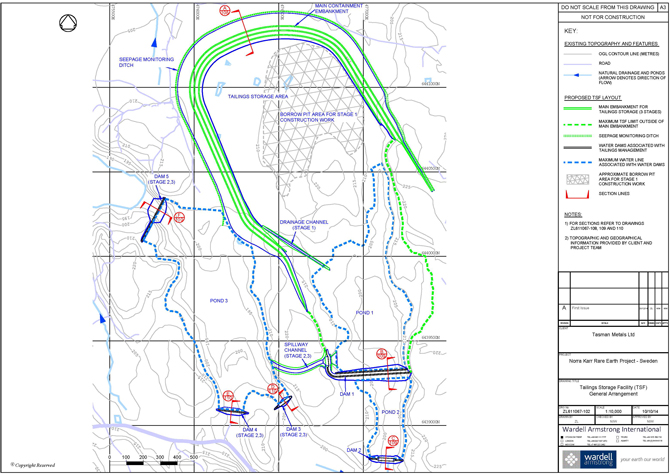
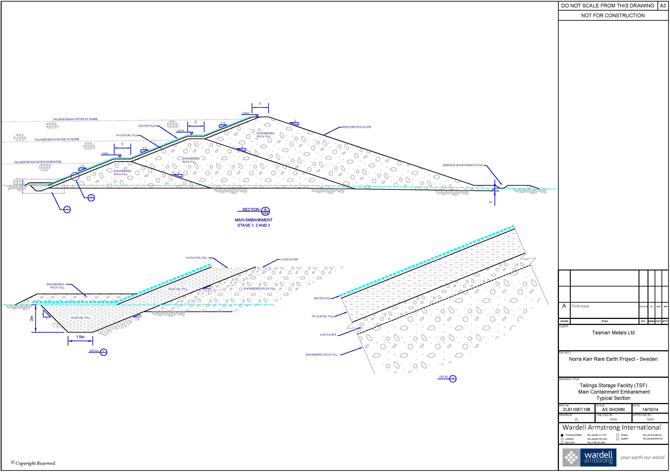
 |  |
| | Prefeasibility Study - NI 43-101 - Technical report for the Norra Kärr Rare
Earth Element Deposit - 0465-RPT-014 Rev 0 |
| APPENDIX C. | GBM LAYOUT DRAWINGS |
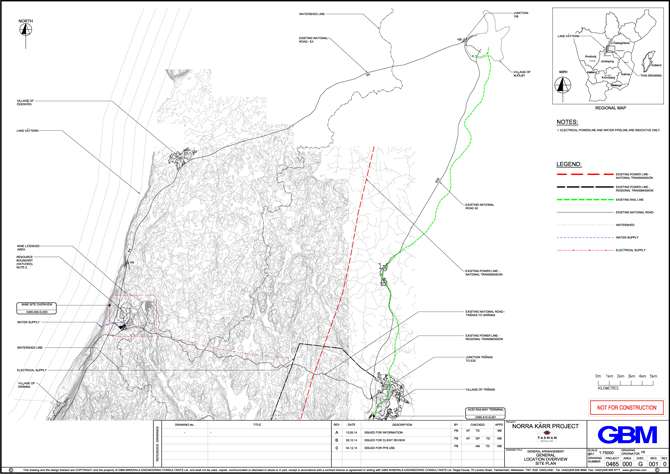
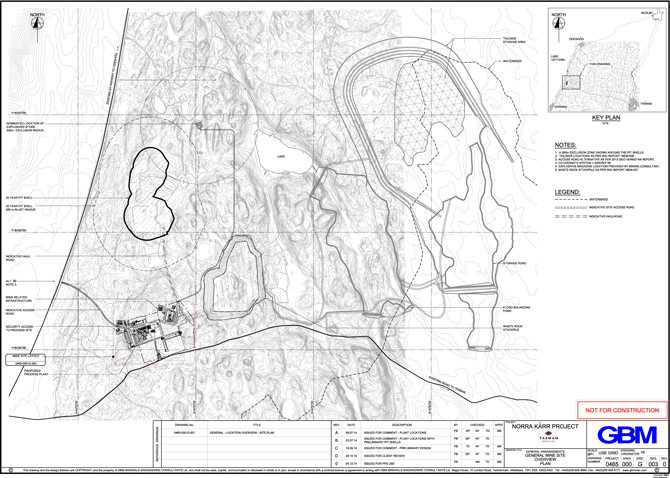
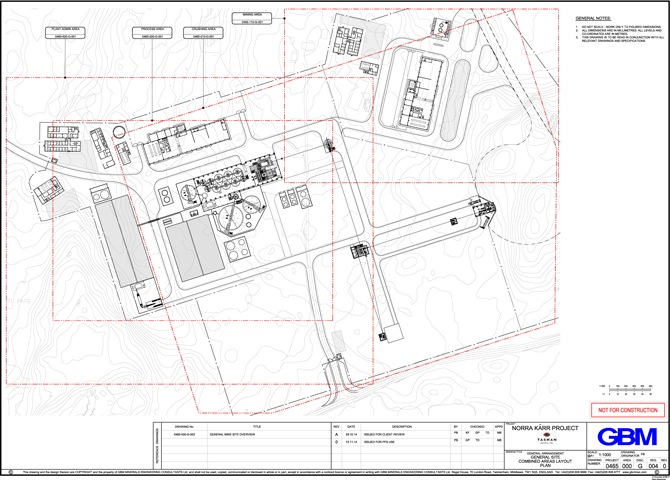












































































































 tpg190a
tpg190a

















































